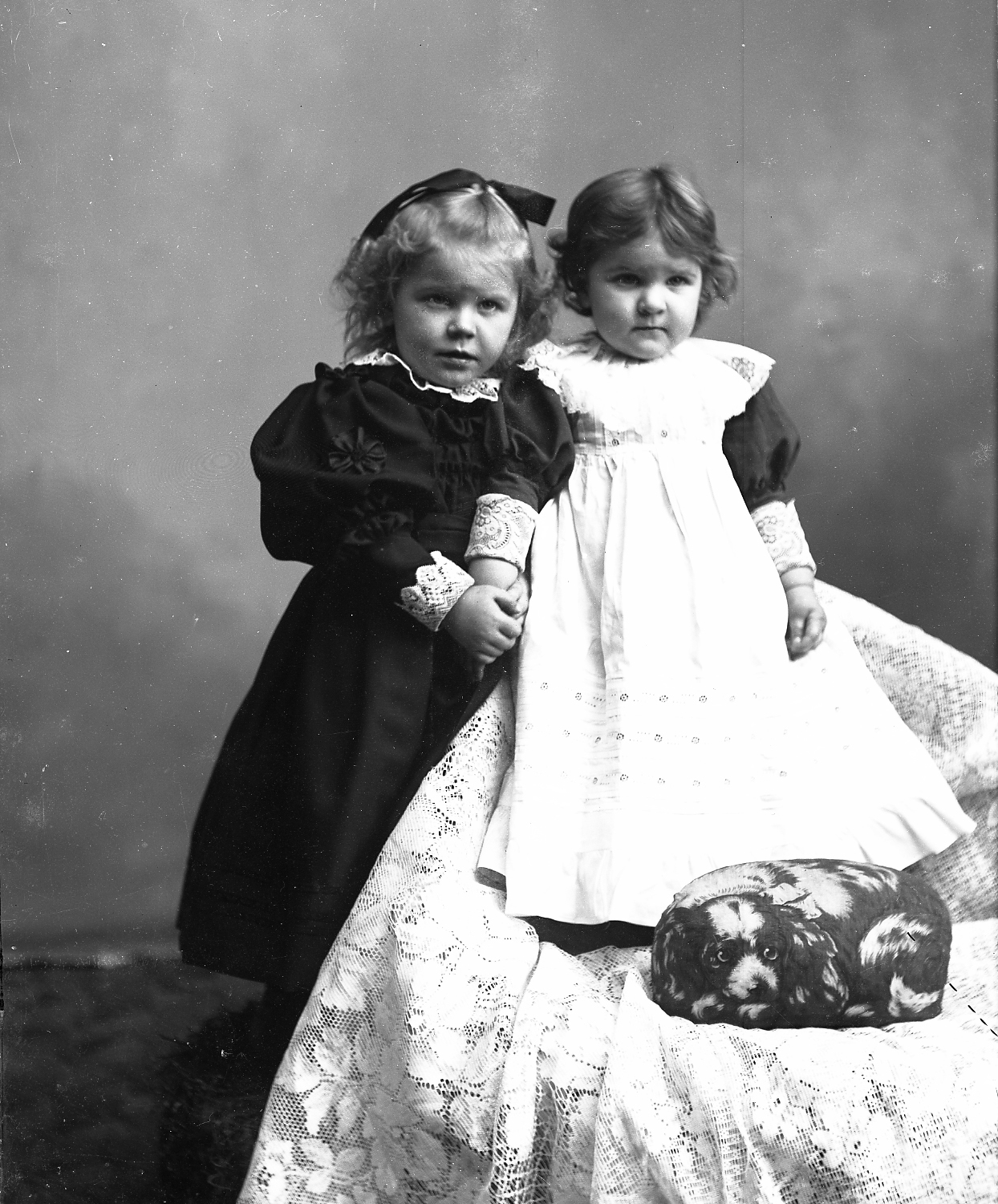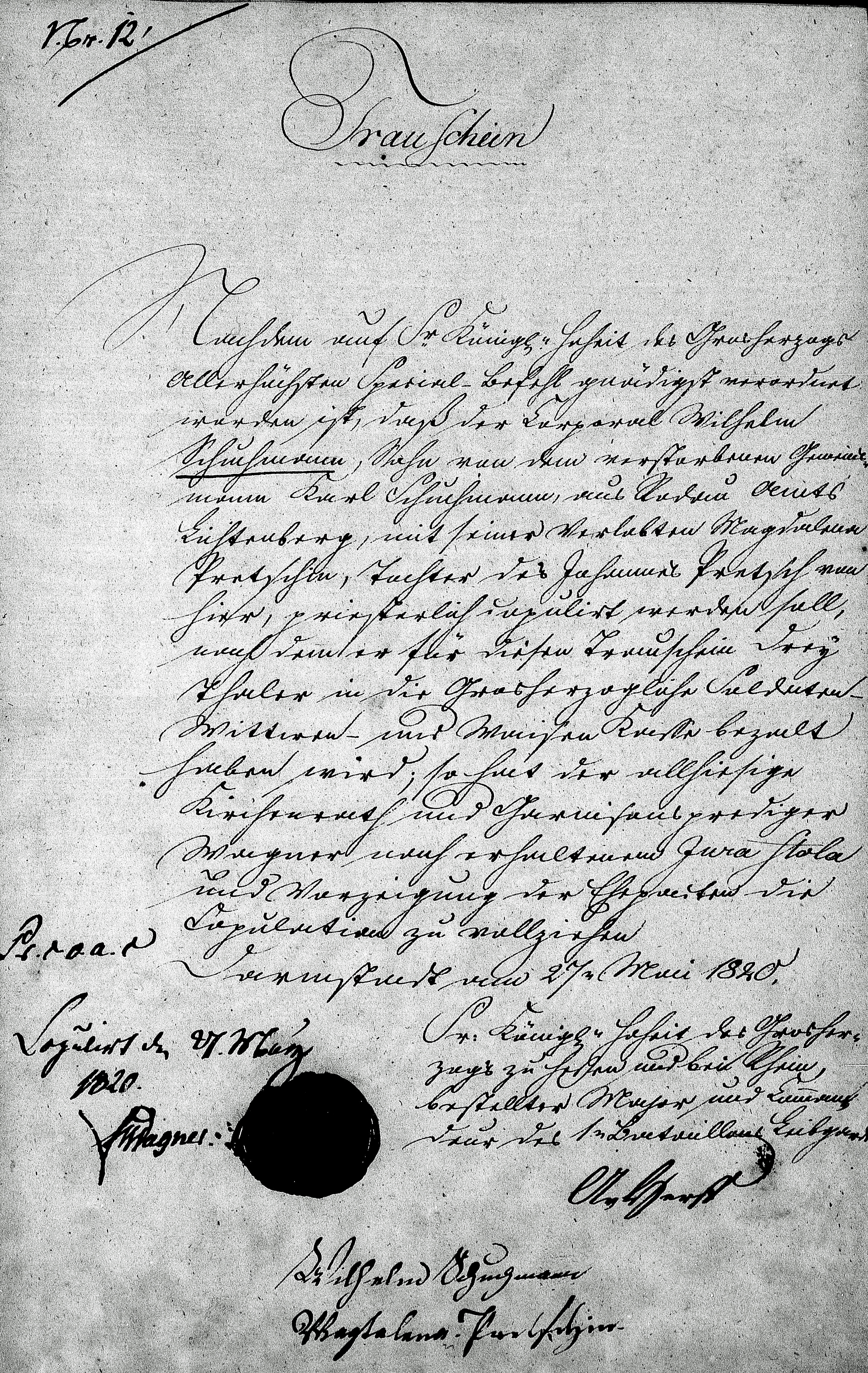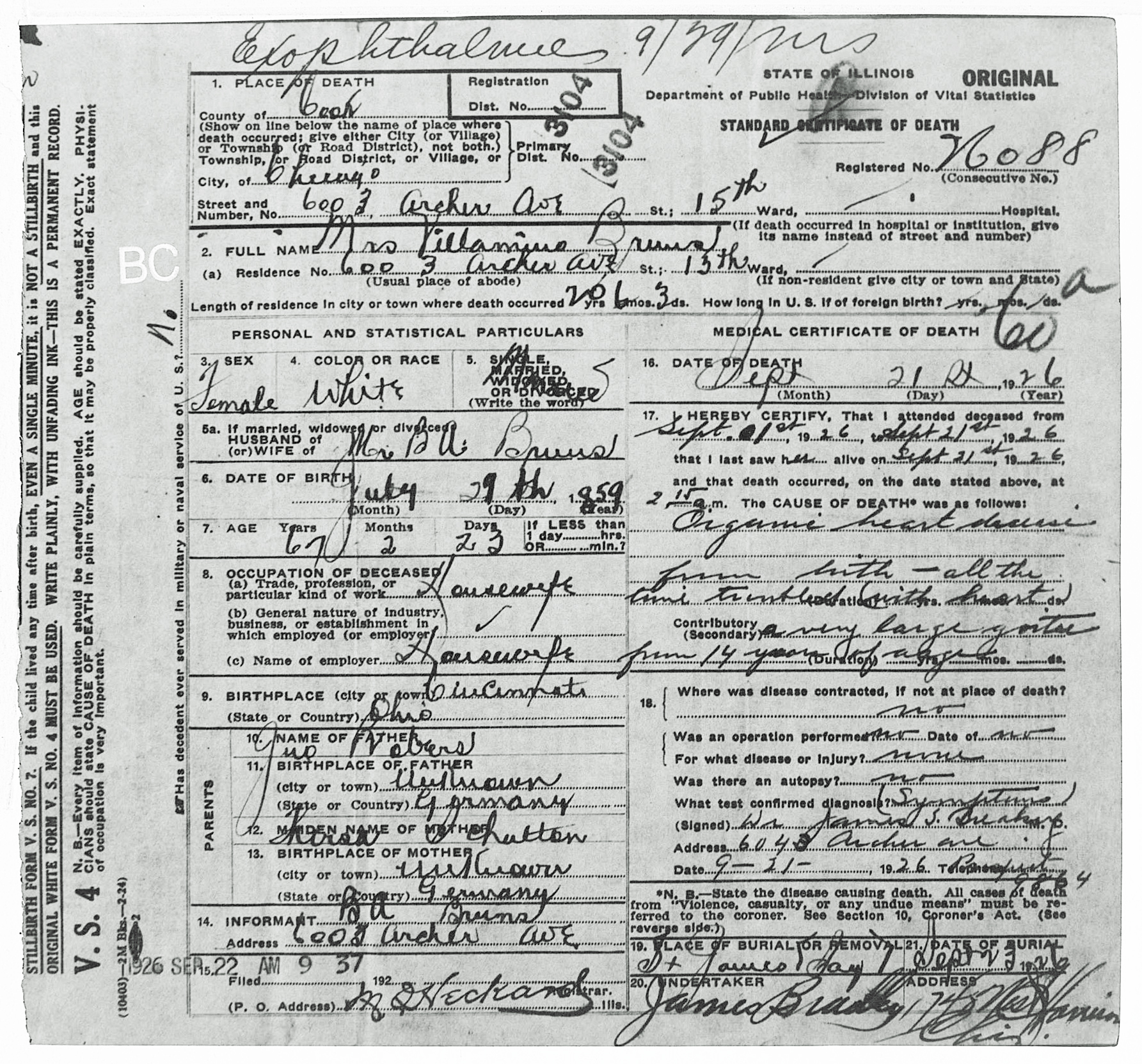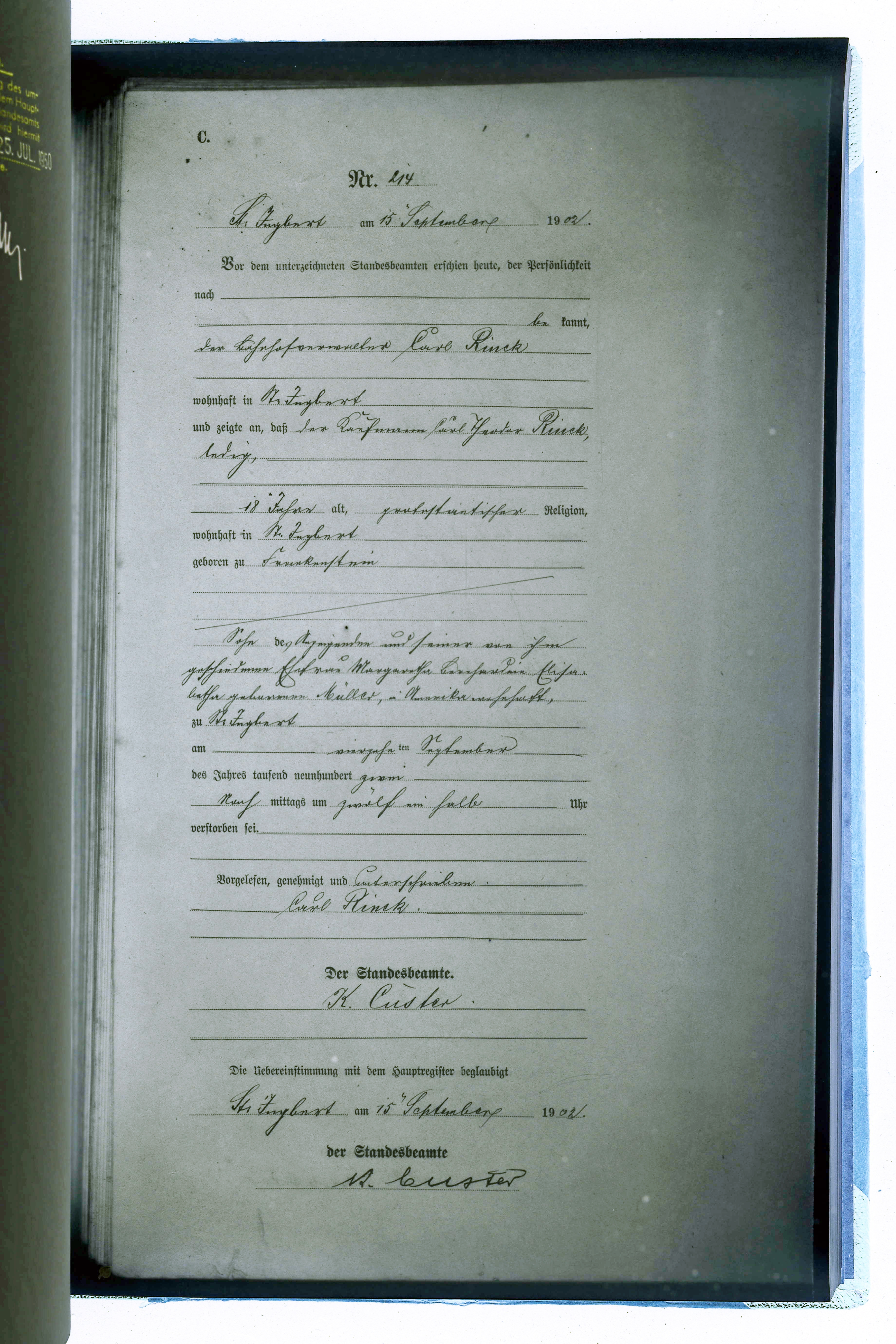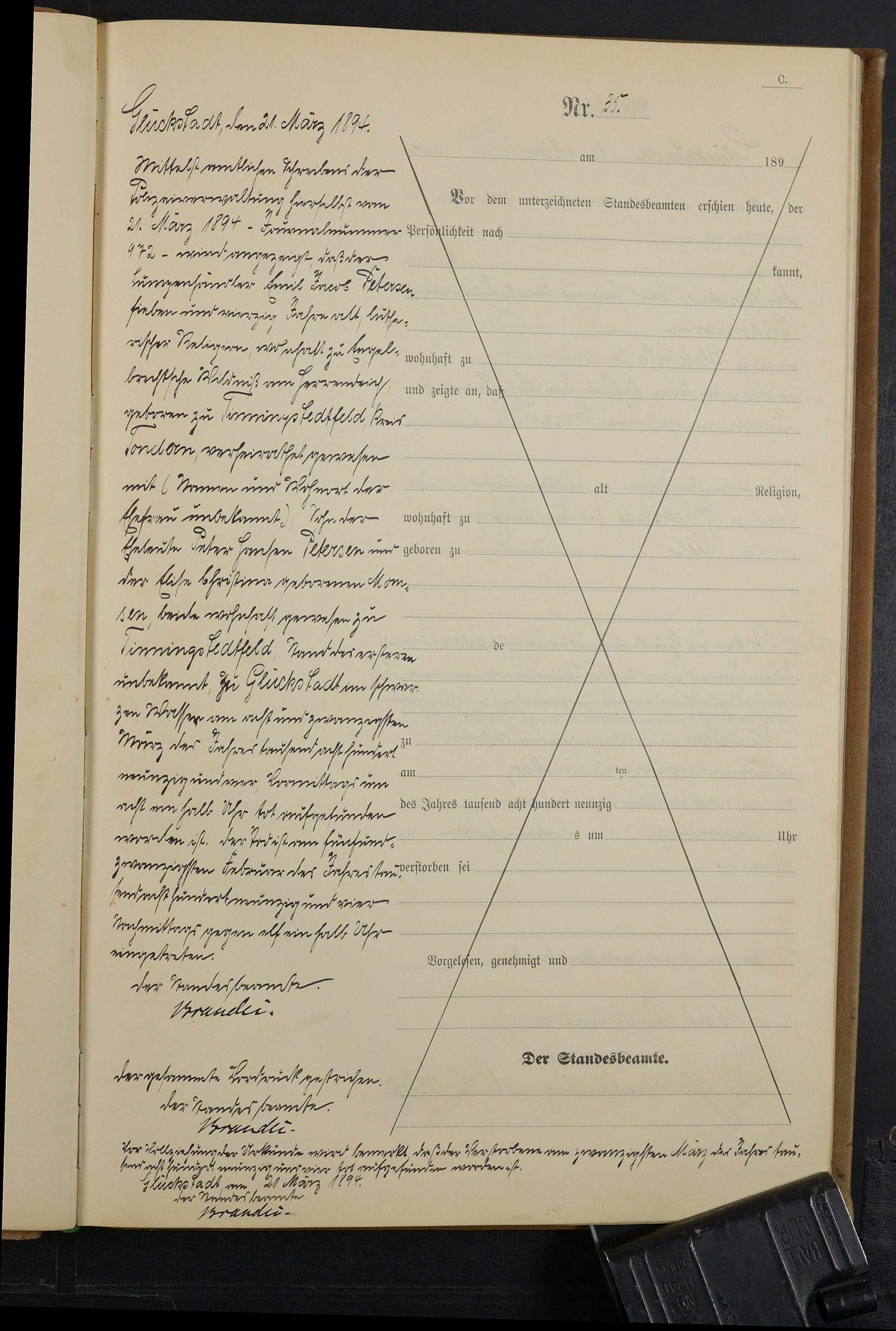Family Folio Blog
“We possess nothing certainly except the past.” - Evelyn Waugh, "Brideshead Revisited"
Marriage or engagement?
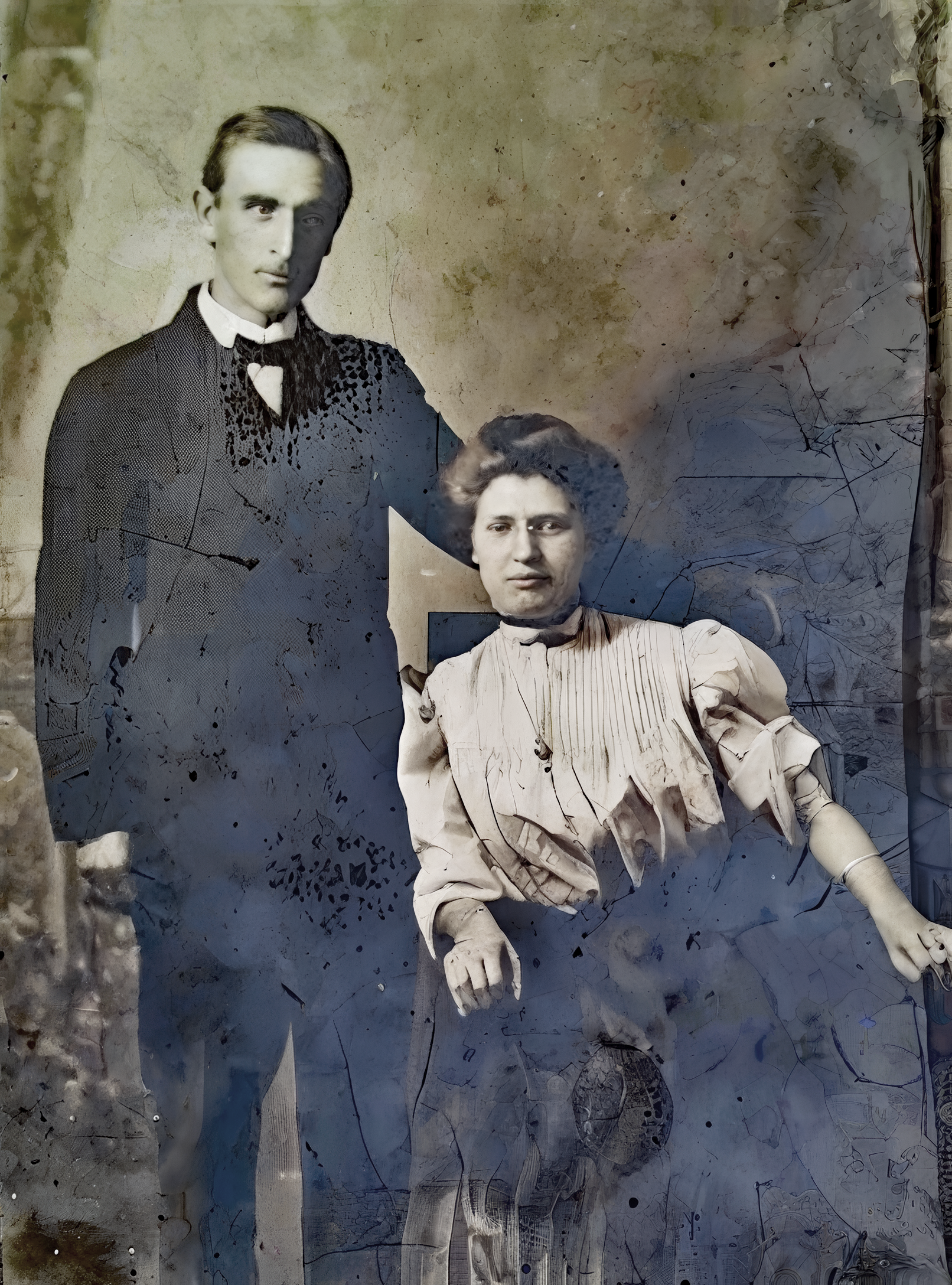
I've seen versions of this photo before from various Ancestry trees and it's previously been described as a wedding portrait. But this version, shared online, is dated. This couple was married on November 21, 1908 in Chicago, but the date here is a month earlier, October 23, 1908. So this is presumed to be an engagement photo.
“""Storrs Family Tree" at Ancestry.com, https://www.ancestry.com/family-tree/tree/38896697?cfpid=19298314556&dtid=100, media gallery created by 2seburns, browsable images, photo of Adolph Willis Riemer and Catherine Bothilde Mikkelsen, accessed 12 May 2025.
Both Adolph and Catherine were in their mid-twenties when they decided to marry in Chicago. Adolph was Wisconsin-born while Catherine had been born in Flensburg, Schleswig-Holstein, where her parents, Thomas Mikkelsen and Helene Sievertsen, lived at the time.
The family emigrated in 1888 and for awhile remained in Chicago until some rift caused Catherine's mother to return to Flensburg with the children. Helene remained in Flensburg but the children gradually returned to Chicago to stay with their father. Adolph and Catherine must have met there and decided to marry.
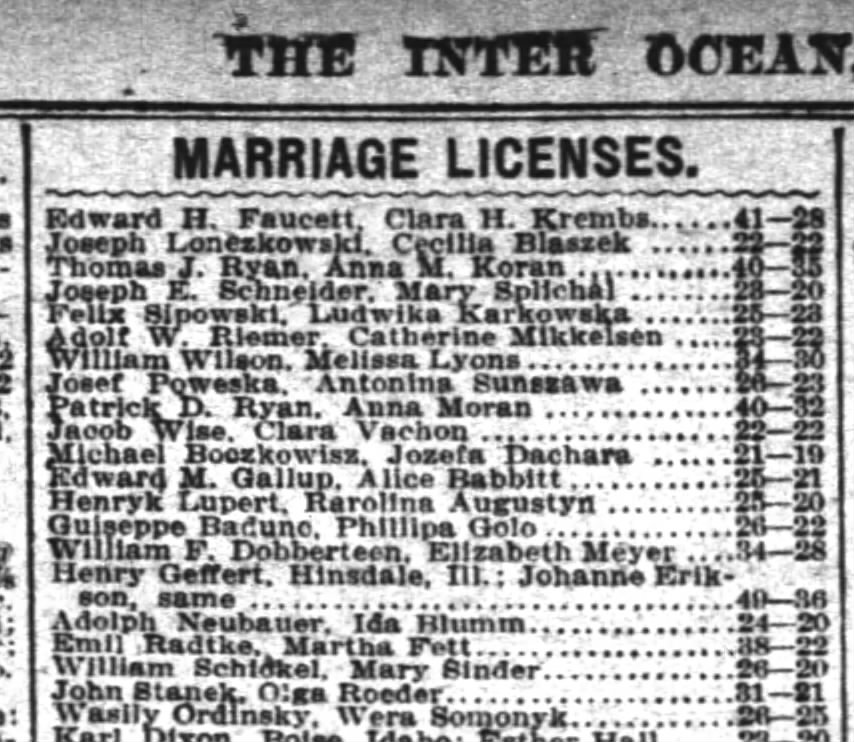
It was common at the time for local newspapers to print the names of couples applying for Cook County marriage licenses, and Adolph and Catherine show up in the November 10, 1908 edition of the whimsically-named Chicago Inter-Ocean newspaper. If the date on the photo is correct, it would tend to clarify the picture as an engagement photo and also explain the lack of wedding finery. Some folks commemorated their engagement, some their wedding, sometimes both, but it's nice to know what category this image belongs to, especially if the wedding itself was a modest affair with minimal ceremonial trappings.
Adolph and Catherine were married for twenty-nine years and had six children.
12 May 2025 | Email your comment.
What's in a name?

It never hurts to go back and inspect records that you already have. You're bound to find out something new. That's the sase with this baptism record for Ellen Jürgensen, my 3x-great-grandmother. As much as I've looked at it, I didn't recognize that there was an anomaly in her surname.
“"Citation: Imaged at Arkivalier Online (https://arkivalieronline.rigsarkivet.dk/en/billedviser?epid=17216188#201171,38101176 : 2 May 2025), 1799 baptism record for Ellen Jürgensen, path: Rigsarkivet/Archives online / Church records from all over the country / County: Burkal Sogn / Hovedministerialbog (1761 - 1826) / Image 119/215, accessed 2 May 2025.
Naming conventions were fairly well set in this region of southern Denmark in the 1700s. The standard protocol was to use patronyms rather than surnames, which were based on the child's father's first name. Ellen, born in 1799, was the daughter of Lorentz Jürgensen and Anna Catharina Jürgensedatter, also called Nissen, her father's surname...that's a clue right there!
Ellen's mother, born in 1772 in Tønder, was already known in the records by her father's patronym, Nissen, so perhaps the protocols were already evolving. Ellen was always listed as Jürgensen. If the patronymic system had been firmly entrenched in the region, she should have been called Ellen Lorentzen, and so should all her siblings. But they were Jürgensen too.
It's not an earth-shattering observation, just a sign that different parishes were beginning to assert their own naming conventions. By 1822 there was a royal decree in Denmark that patronyms should give way to proper surnames that didn't change from one generation to the next, probably adding to the ease of tracking families for census and tax purposes.
Traditions were fluid and could change from one parish to the next. When Ellen married Hans Peter Petersen in 1822 (himself the son of a Peter Hansen), Petersen became his fixed surname and was used by all their nine children. And thus it became the surname that came to America when Hans' and Ellen's children emigrated in the 1870s to Nebraska.
Maybe in Ellen's case it was more convenient (or a sign of prosperity?) to use a surname rather than a patronym.
2 May 2025 | Email your comment.
Frank Peter Meyers, man of mystery
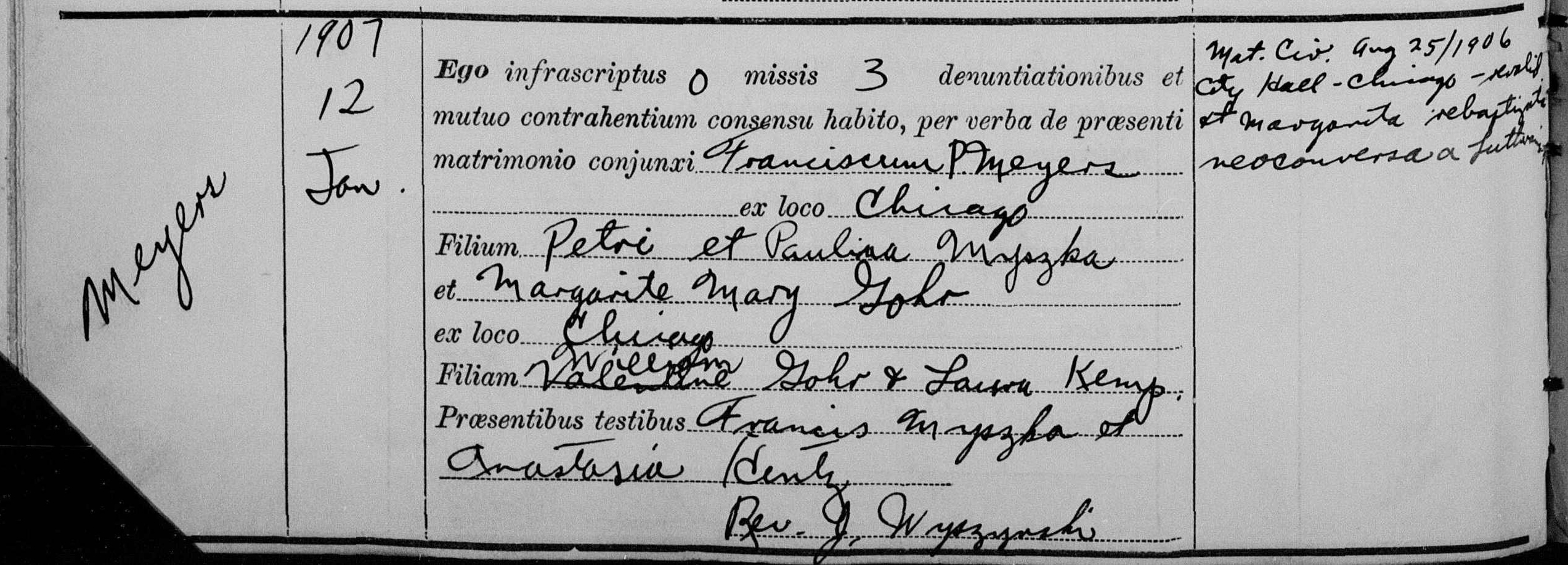
This is a fellow I never met. I don't even have a photo of Frank. He died in 1944 in San Gabriel, California, owner of a local poultry farm with one of his sons. His wife, my great-aunt Alma, remained back in Chicago for reasons unknown but they were still married. THis 1907 marriage record from 1907 makes some things perfectly clear but doesn't answer all my questions.
Frank (here Franciscus) was the son of Peter [Meyers] and Paulina Myszka, while Margaret was the daughter of William Gohr and Laura Kramp (misspelled Kemp here). I have my Gohr ancestry traced back into the 1700s, the Kramps almost as far. But when I try to research Frank P. Meyers, even with those parents, I get nowhere.
“"Citation: Illinois, Chicago, Catholic Church Records, 1833-1925, Ss Peter & Paul Parish (Chicago: Paulina St), Marriages 1896-1914, image 46 of 251, 12 Jan 1907, Franciscus P. Meyers and Margarite Mary Gohr via Familysearch.org (a href="https://www.familysearch.org/ark:/61903/3:1:S3HT-DY43-SD8?cat=421216&i=96&lang=en">https://www.familysearch.org/ark:/61903/3:1:S3HT-DY43-SD8?cat=421216&i=96&lang=en), accessed 24 April 2025.
Records for Frank are also confusing. Some census records say he was born in Germany and emigrated in 1890, others say Illinois. His WWI registration claims that he was a naturalized citizen based on his father's naturalization...but in census records Frank always reported his father was born in Illinois, so presumably no naturalization was required.
Frank wasn't married until 1907 so where was he living before that time? The 1900 census is not helpful. I haven't located any records for Frank's parents Peter Meyers and Pauline Myszka (the Polish spelling of the German surname Mischke). Were they even married? I can't find either parents in any U.S. census records.
A Pauline Myszka, age 18, arrived in Baltimore in 1882 with parents Michael and Pauline, along with younger sisters Julia and Anastasia, bound for Chicago. This may be Frank's mother. Her parents, interestingly, can be found in death records for Cook County, having died a year apart in 1914 (Paulina, Frank's presumed grandmother) and 1915 (Michael). Interestingly Frank applied for a delayed birth certificate in 1942, a record that confirms his parents' names but unleashes more questions than it answers.
The delayed birth certificate is online here. The birthdate is consistent with what we know about Frank and even gives an address where the birth occurred, 1033 31st Place in Chicago. It was a few houses away from the residence of Frank's presumed grandparents, Michael and Paulina, who both resided at 1055 31st Place when they died, suggesting that they were indeed related to Frank. Frank's father Peter Paul Meyers, a butcher, is listed as born in Omaha, Nebraska, although no trace of him is found there. Pauline, Frank's mother, is listed with a Chicago birthplace, not credible if she was born in Poland and emigrated with her family.
Helpfully a cousin of Frank's, John F, Mischka (German spelling apparently), certifies that the information is correct. This is probably John Frank Mischka, son of Frank Mischka and Augustina Hintz, born in Chicago in 1882. This is an interesting coincidence. When Frank and Margaraet/Alma started having children their first two had godparents named Myszka (as expected) and Hinz! And as noted in the marriage record above the two witnesses to Frank's and Margaret's 1907 marriage were also Myszka and Hintz.
It's worth noting that among the witnesses and godparents for Frank's and Margaret's children there is no one named Meyers.
This is an odd puzzle. Were Frank's parents not married? Did they die young and thus don't appear in any census records? Did Frank's mother Pauline return to Poland at some point? These are so far unresolved theories that can't be answered with available records, although I'm hoping something will come to light at some point.
24 Apr 2025 | Email your comment.
Around and around
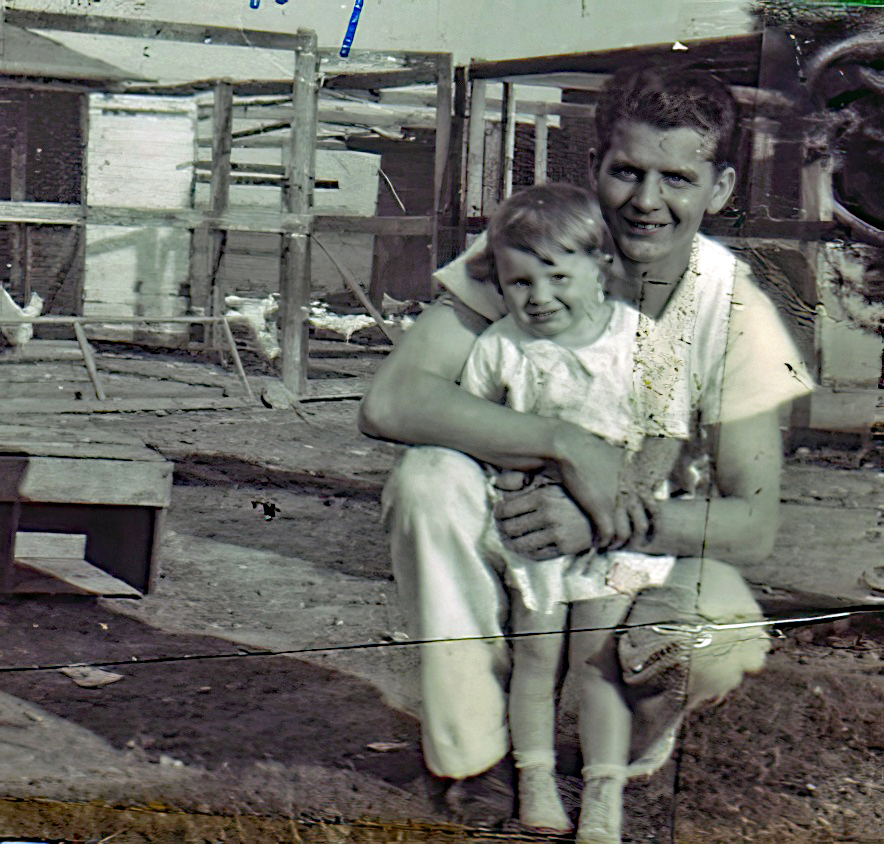
I often mention how my great-grandmother Catherine Petersen Mikkelsen rarely captioned her photos, which has led to some interesting (and sometimes frustrating) suppositions about who is who in a particular image. But it's more common than not. Even my mother did this with her collection. This photo, for instance, was simply labeled "Bill and Mary Katherine," no location, no surnames, no year.
It's been floating around in her photo album with only its proximity to cousins of ours, the Meyers clan, to lead to a guess about who Bill might have been. Meyers, certainly, but which one? The Meyers were my grandmother's sister's family. Margaret Mary Gohr Meyers, popularly called Alma, was the youngest of the Gohr girls. She married Frank Peter Meyers in 1906 (civil marriage) and then again in 1907 after she converted from Lutheranism to Catholicism. She and Frank had five children, four of whom made it to adulthood. This was likely their son William Michael, born in 1912 in Chicago, and he looks a lot like his older brother John Paul, so that further suggests the ID. But then who was the toddler, Mary Katherine?
“"Citation: "Bill and Mary Katherine," identified as William Michael Meyers and his daughter Mary Katherine Meyers, San Gabriel, California about 1938, digital media, scanned from the photo collection of Lorraine Bruns MacLaughlan, accessed 11 April 2025.
I've been able to find William Michael in the 1920 and 1930 U.S. federal census records but not in later census records, and at first no trace of a marriage or a William Meyers with a child called Mary Katherine. Because he doesn't appear in the 1940 census and noting that his brother John Paul named a child Michael William in 1946 (likely honorific), I assumed that William Michael had died sometime before 1946. But no death records came up from Chicago.
The Meyers clan had a California connection too. The 1940 census showed that William's father Frank Meyers and his youngest son Frank Peter Meyers ran a poultry ranch in San Gabriel, a Los Angeles suburb. Alma wasn't with them, she was still likely in Chicago when the census was taken. So were their other grown children, a daughter Eleanor and John Paul. But in 1940 William Michael didn't seem to be in either Illinois or California...except for one Newspapers.com obituary that kept coming up during Ancestry searches for a young professional skater who died of complications from appendicitis in July 1939. That couldn't be him...could it?
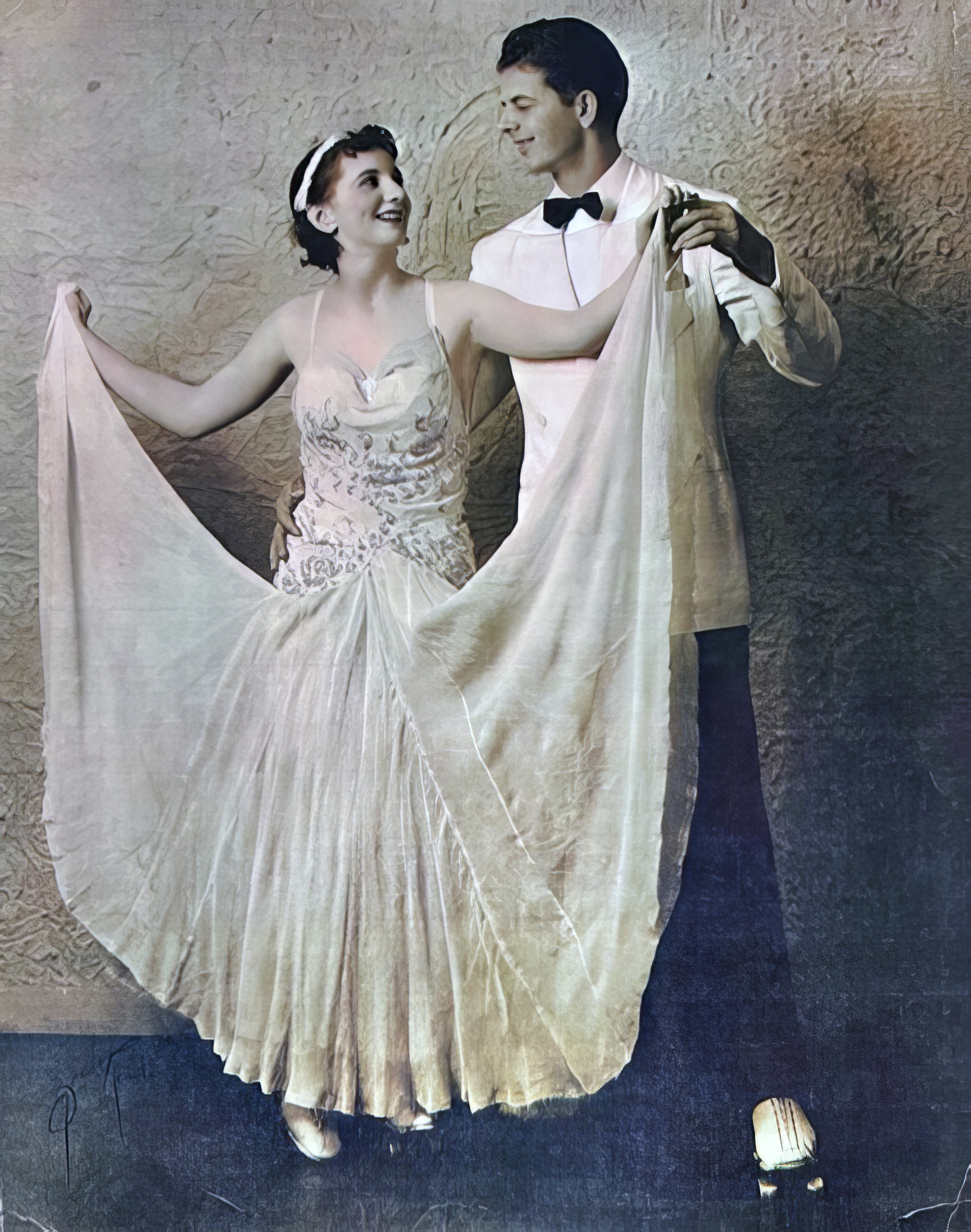
Sometimes whatever Ancestry doesn't have can be found at FamilySearch.org, which is where I found this California death record for William Michael Meyers. The parents' names on the record confirm that Frank and Alma (Gohr) Meyers were his parents and it confirms the death circumstances as well. It also reveals the first name of William Michael's wife, Dorothy. But the obituary mentioned that he was survived only by Dorothy, no parents or children mentioned. Odd indeed.
This is where Ancestry trees can often be handy. This tree for Dorothy Helen Stephens included her first marriage to a William M. Meyers with his death indicated in 1939, and a child (marked Private) was also included. I contacted the tree owner who was descended from Dorothy's second marriage, and she confirmed that the child called Mary Katherine in my mother's photo was the Aunt Katherine she knew from her own family. She even had photos of William and Dorothy performing as professional skaters and shared them.
So armed with the information that a child did exist, and was probably born in California since that's where her parents performed, I found a birth registration for a Mary Katherine Meyers, mother's surname Stephens, born in Los Angeles in 1936. That seems to round out the details of this heretofore family mystery which had kept me going arund in circles before this.
There are still questions. Why didn't my Meyers family ever mention William Michael's existence (too painful a memory, perhaps) and why were his parents not noted in his obituary? Were they estranged? Was Mary Katherine never mentioned by the Meyers clan for the same reason? It's an explanation still missing from the story.
11 Apr 2025 | Email your comment.
Rare photo found
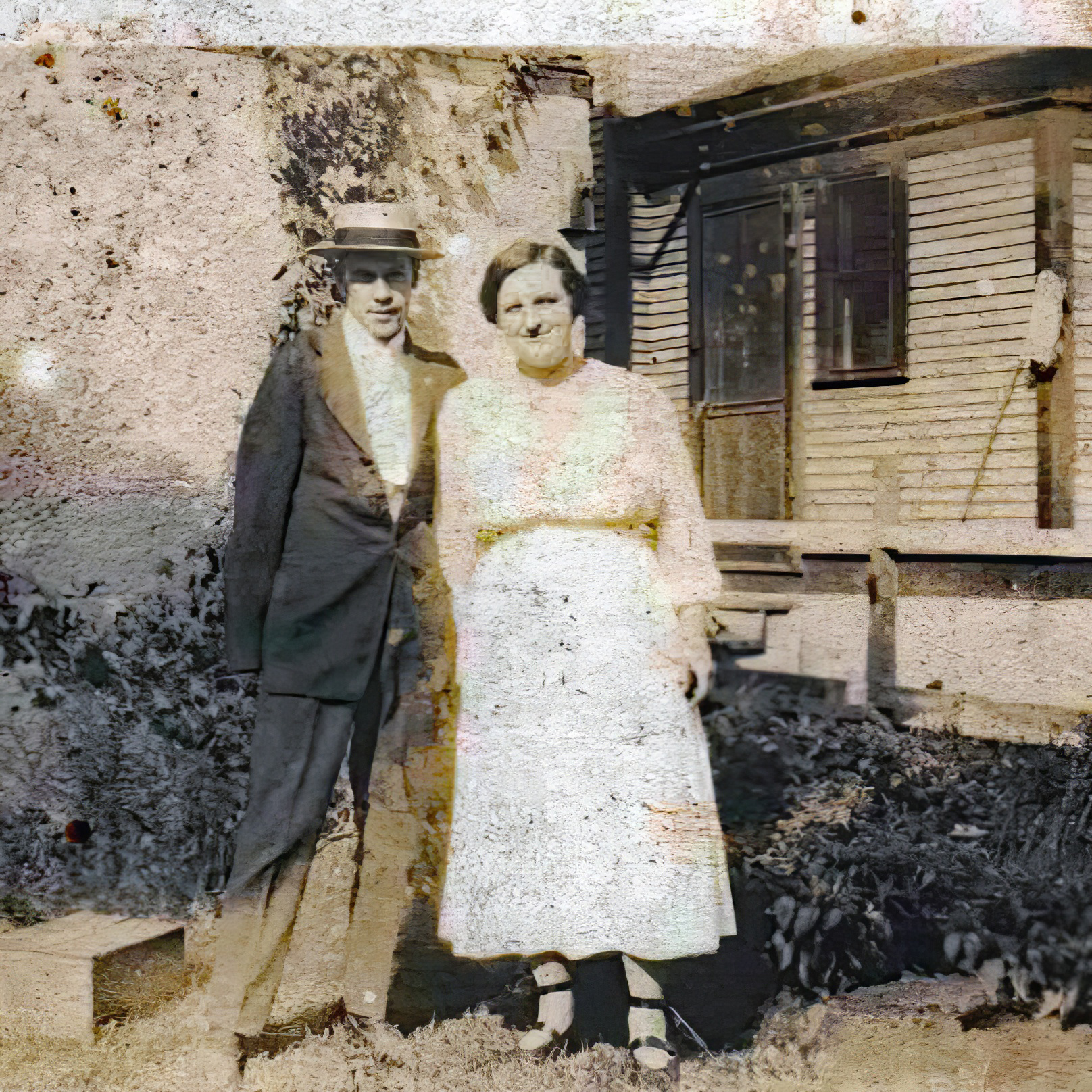
Until now my great-uncle Louis William Jatho was an elusive fellow, picture-wise. We had exactly one photo of Louis and his wife Martha Kruschke at a mid-1930s Kruschke family reunion. Louis and Martha stood off to the right, almost inconspicuous in the large family gathering.
But here's where the reward comes from searching for sideways-situated family trees on Ancestry, families who weren't in a direct line but had a marriage-related relevance to our ancestry. Louis and Martha never had children of their own but there were a passel of Kruschke folks, mostly siblings of Martha. Some of them happened to offer this one slightly damaged photo of Louis and Martha early in their marriage, either in Chicago (where they married in 1917) or perhaps in Eau Claire, Wisconsin, Martha's home town.
“"Citation: "Burkhart-Reysen X Smith-Kruschke Family Tree" https://www.ancestry.com/family-tree/person/tree/117132001/person/390161284601/facts, media gallery created by Elaine Burkhart, browsable images, photo of Louis William Jatho and wife Martha Kruschke Jatho, Ancestry.com, accessed 5 Apr 2025.
Louis was one of four Jatho offspring who relocated to Chicago from Charleston, South Carolina with their mother Jennie Müller Jatho in 1910. Jennie had a sister living in Chicago, which might explain the migration. In addition, there appeared to be an unexpected pregnancy for Ethel Jatho, Jennie's older daughter, and with no marriage documented it might have beene a safe haven for Ethel at the time. Louis was eighteen when they relocated there.
I don't know how he may have met Martha, who seems to have been living in Eau Claire at the time. Martha was the oldest daughter of Friedrich Hermann Kruschke and Elizabeth Wienand, both emigrants from near Brandenburg in Germany. Martha, born in Eau Claire in 1886, lived with her family. A birth record from 1904 records the brief life of an unnamed baby daughter who died after two days. Martha's name is indicated as the mother but the father is listed as unknown.
An ephemeral and undocumented 1905 marriage to an Ernest Green is suggested (but not proven) from some Ancestry.com trees. More reliable is the 1909 marriage toa Charles Johnson in Eau Clair, documented in the 1910 U.S. federal census. This marriage was brief, apparently. Martha and Louis Jatho married in Chicago in 1917 and this was the relationship that persevered.
Louis was a house painter. The couple made their home in St. Paul, Minnesota. Louis died there in 1956. Martha must have returned to Eau Claire, where she died in 1962.
Never give up looking for ancestral images! They often turn up in the most unexpected places.
5 Apr 2025 | Email your comment.
Cousins reunited and rediscovered
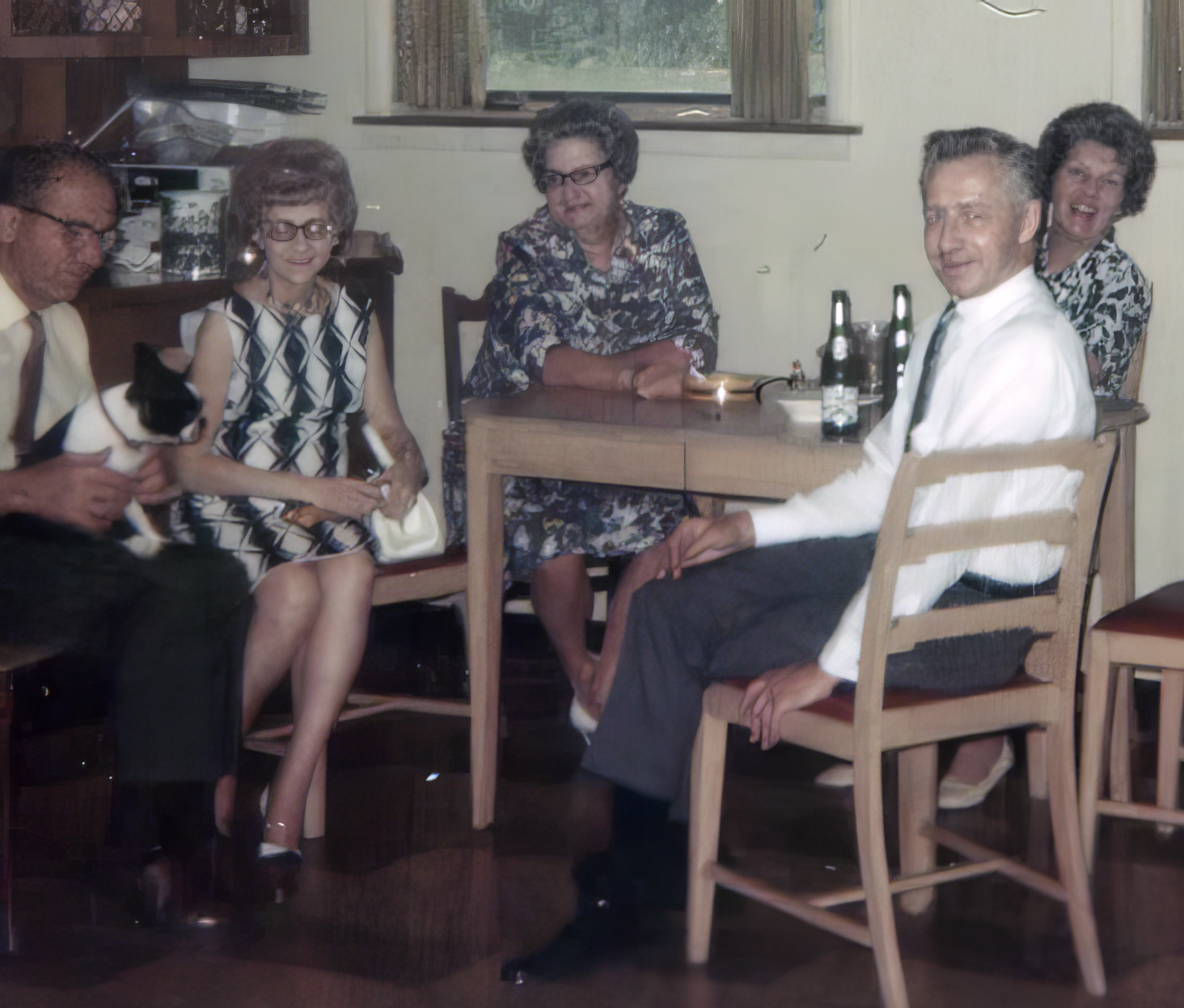
Puzzles are fun. Not only the traditional tabletop puzzles, but also family mystery puzzles. For years I wondered whether any of my mother's immediate family was aware of more distant cousins living right in Chicago. Gradually the pieces are coming into focus for me, while they obviously knew how they were connected.
I remember visiting the lady in the middle of this photo in 1969. Her name was Grace DeTolve and we visited her one afternoon on a family vacation to Chicago. She was a vivid storyteller, as I recall, with a great sense of humor. But all I knew at the time was that she was probaly an old school chum of my mother's. I should have asked but I didn't, and no explanations about who we were visiting and why were forethcoming.
It's turned out to be a much closer relationship than that.
“"Citation: Joe and Loretta Mayhan with Dolly the dog, Grace McNulty DeTolve, Tom and Lorraine MacLaughlan, Chicago 1969, digital media, scanned in March 2025 from the photo collection of Lorraine Bruns MacLaughlan, accessed 30 Mar 2025.
We know now that there was an unanticipated Murphy connection with my mother's cousin Emma Hasse Murphy, daughter of my mother's great-aunt Auguste Caroline Kramp Hasse, which introduced an Irish-by-marriage heritage to our otherwise German/Polish/Pomerania ancestry. Loretta in the photo above was my mother's cousin as well, something I didn't realize at the time -- her parents were Emma Hasse and Owen Murphy. But Owen had a sister, Theresa Murphy, and to my surprise that's where Grace DeTolve fits in: another cousin!
A brief foray through Ancestry.com looking for more Murphy folks brought up Theresa, who married James McNulty in 1902. They had nine children in Chicago, one of whom as Grace Agnes McNulty, born in 1910. Whom did Grace marry? A James DeTolve. That name rang a bell and I rushed to my mother's photo album to see whether she's taken any pictures of Grace during that family trip. She did indeed, labeled "With Grace and Jim, Chicago 1969."
This photo isn't just a document about a reunion of old friends. It actually shows three cousins, a relationship now confirmed by online resources, including the McNulty-Dwyer family tree at Ancestry.
It's a distant connection but it's a verified connection nonetheless.
30 March 2025 | Email your comment.
A photo in decay but a family connection found
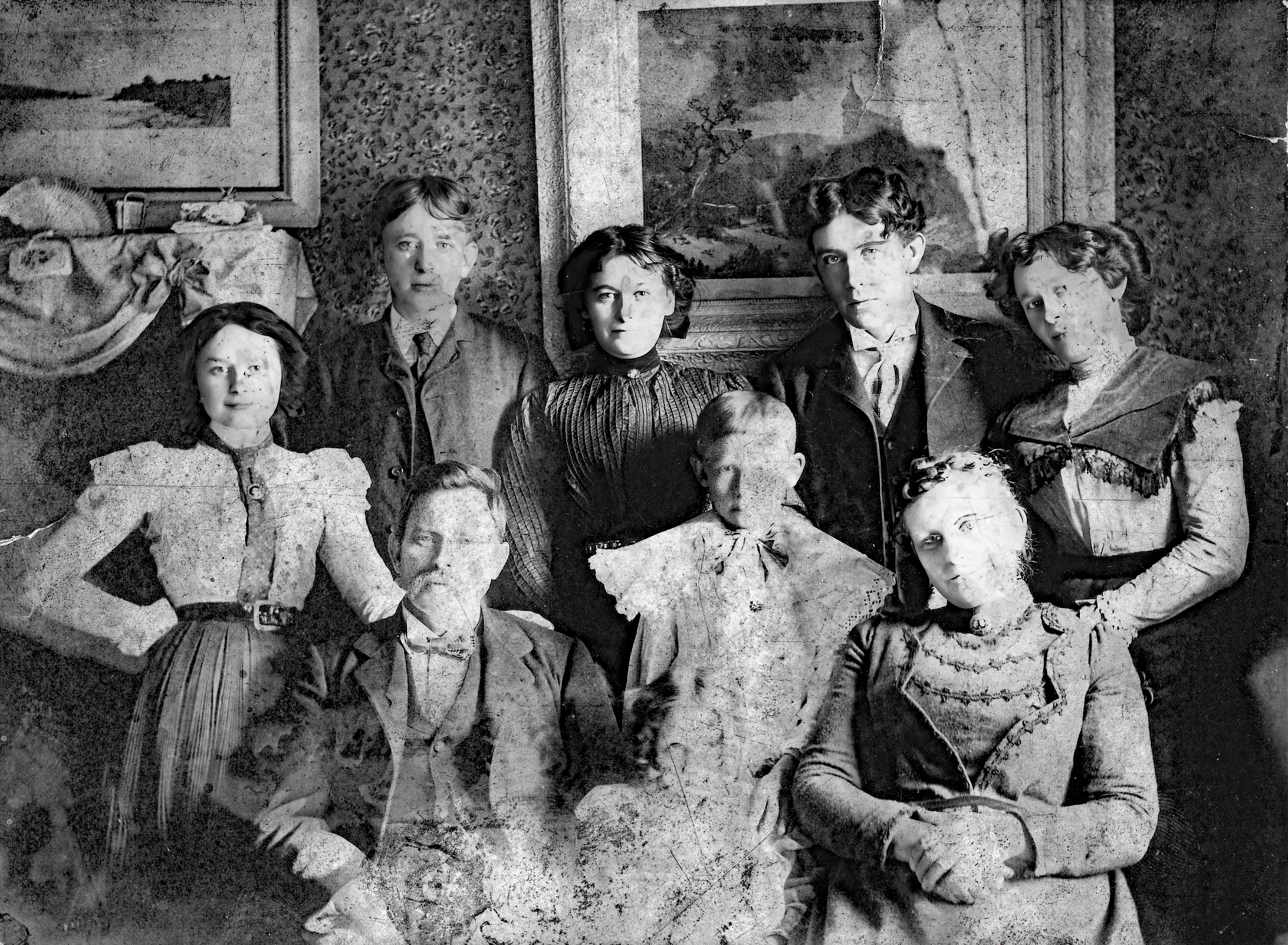
We have a couple of connections by marriage to Irish ancestry, both to families called Murphy from different parts of Ireland. So far as I can tell they're not connected, it's just a coincidental surname. But one of those families has begun to yield valuable research details.
The short version: the family of John D. Murphy and Grace Jamison are related to us via their son Owen Patrick Murphy's marriage to Emma Hasse, daughter of Carl Hasse and Auguste Kramp Hasse. Usually our Pomerania families focus on unions of similar backgrounds but not in the case of Owen and Emma.
This photo includes some image decay and the youngest child, Margaret (between her parents), has almost disappeared into vanishing emulsion. In the back row, L-R: Theresa Murphy, Owen Murphy, Elizabeth Murphy, Will Hurley, Mary Murphy Hurley; front row, L-R: John D. Murphy, David Murphy, Margaret Murphy, Grace Jamieson Murphy. This family portrait was taken to celebrate the Murphy/Hurley engagement in 1898 in Chicago.
“"Citation: the John D. Murphy family, "McNulty-Dwyer Family Tree" https://www.ancestry.com/family-tree/person/tree/26142268/person/1819317038/facts, media gallery created by Patricia G. McNulty Patterson, browsable images, Ancestry.com, photo of the Murphy family, Chicago, 1898, accessed 21 Mar 2025.
I explored the Murphy/Hasse relationship earlier (see "A Drop of the Irish" below) but this is the first time we've been able to look at Owen's entire family, thanks to his descendants who have shared family photos. Owen and Emma wouldn't marry for another eleven years but there was plenty of activity in this immigrant family before that.
Four of the children were born in Ireland before the family emigrated to Chicago around 1886. John held various jobs over the years, including day laborer and saloon keeper, switching to watchman after prohibition came into effect in 1919. John died in 1933, Grace in 1936. We're still learning about this family and its various connections to ours.
21 March 2025 | Email your comment.
The Ithaca Kitty (or puppy) in photography
These two little girls were photographed during a studio setting in 1895 or thereabouts: sisters Antonia and Alvine Hannah Gaul (click the image to enlarge it). While the photo itself is of remarkable quality (the print is from a glass negative, courtesy of the Iosco County Historical Museum), it's the little toy in front that bears some scrutiny. It's not a real dog, clearly, but a toy of some sort.
Toys and other props were common in children's photography from this era and even later, all the better to capture the children's attention and encourage them to follow the photographer's suggestions. Generic toys like dolls and stuffed animals were common. But this little puppy looks curiously non-dimensional. What was it?
“"Citation: Antonia and Alvine Hannah Gaul, Tawas City, Iosco County, Michigan circa 1895, print from a glass negative, via Ancestrylibrary.com, "Iosco County, Michigan Glass Negatives, 1892-1905: East Tawas," order number 1542, accessed 15 Mar 2025.
In the early 1890s there was a popular toy called the Ithaca Kitty, designed by Celia Mattison Smith and Charity Smith. It was configured as a sew-you-own toy, made of three muslin panels painted with the likeness of a cat. People could stuff the panels and sew them together, making the first-ever patented stuffed toy. It was a popular item, even displayed at the 1893 World's Fair in Chicago.

To my eyes the dog displayed in this photo looks a lot like the Ithaca Kitty but a canine version of the toy. It has a painted look and a flat dimensional appearance, probably a perfect photographer's prop that couldn't be broken by rambunctious kids (if there were any!) and easy to display within the frame.
The Internet has lots of references to the Ithaca Kitty but not to puppy versions of the toy. Was this a one-off example or are puppies just not as popular as toy cats? Hard to know for sure, but this photo seems to suggest that this photographer had something unique to mesmerize his subjects.
15 March 2025 | Email your comment.
The glory of glass negatives
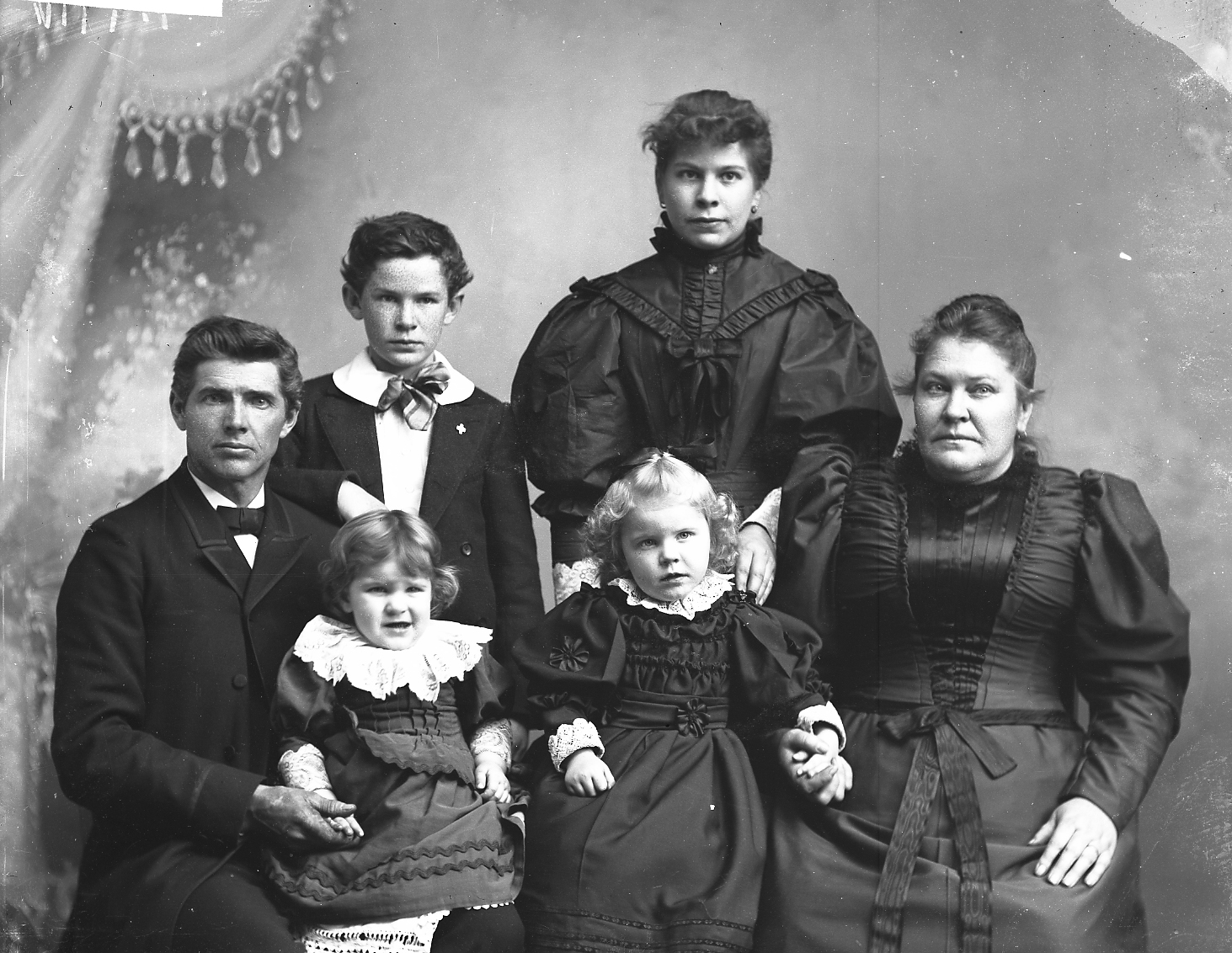
There are some admirable collectors of silver gelatin-coated dry plate glass negatives and I've always admired these folks who preserve such high-quality images. But I never thought our family would have any connection to them.
Ancestry.com surprised me. I was working on our Pomeranian immigrant families from Iosco and Berrien counties in Michigan, and just typed in search terms "Gaul" and "Michigan, USA" and the first thing that popped up was an indexed item, "Gaul, Gustof in the Iosco County, Michigan Glass Negatives, 1892-1905: East Tawas."
That rang a bell. I've recently explored the family of Christian Friedrich Gaul in Tawas City, so two Gaul families in the same town are likely related. But I hadn't heard about Gustav (correcting the spelling). If Gustav is a relative of Chistian, he's also a relative of my 4x-great-grandmother Dorothea Elisabetha Gaul/Gohl from Klein Massowitz, Pomerania.
“"Citation: Family of Gustav Gaul, Tawas City, Iosco County, Michigan circa 1895, print from a glass negative, via Ancestrylibrary.com, "Iosco County, Michigan Glass Negatives, 1892-1905: East Tawas," order number 1541, accessed 10 Mar 2025.
Glass negatives provide pristine prints, and fortunately the Iosco County Historial Museum sells prints from this collection. I ordered three photos: one of the Gaul famuly, one of two younger sisters, and one of the oldest Gaul sister. A little research helped me identify them, and it turns out they are indeed related to Christian Friedrich Gaul of Tawas City, and to our family as well.
THe family above includes Gustav Gaul (born in 1850, emigrated in 1883), his wife Adeline Gaul (possibly a cousin), and children: standing at the back are Reno (born in Michigan in 1883), Helena Pauline (born in Pomerania in 1879), and younger sisters Antonia (1892) and Alvine Hannah (1894). Their poses are a little severe but that was common for the time this portrait was made, about 1895.
Gustav and Christian Gaul, and my ancestor Dorothea Gaul (married to Paul Kramp and who never emigrated) were all cousins. Our common ancestor was a Martin or Martinum Gall (another spelling change), born about 1747 in Kreis Bütow, Pomerania. It's probably no coincidence that Christian and Gustav ended up in the same town in Michigan, although they may not have known another cousin, Leo Frederick Gaul (born in 1856 in Pomerania) in Stevensville, Berrien County, Michigan, about 300 miles to the west on Lake Michigan -- I've been exploring his family too. Leo was the son of August Gotthilff Gaul who was Dorothea Gaul Kramp's younger brother.
These families are becoming so numerous that I think it's time to launch a page just for them.
10 March 2025 | Email your comment.
Using FamilySearch film numbers as stepping stones
Now that we have Ludwig/Louis Schuchmann's baptism record, it should be easy to try to find his parents' marriage, right?
Usually it happens the other way around: parents get married, babies come afterward. But in Louis' case his baptism record made it clear that they weren't married in 1819 when Louis was born. By the birth of their daughter Margaretha in 1821 they were. In that record Helena Pretsch is described as Wilhelm's wife. So the marriage must have occurred after Louis' baptism in 1819 and Margaretha's baptism in 1821. A nice, neat window to explore...but where? These records don't seem to be indexed.
But it would be logical to have baptism and marriage records grouped together if there's more to this collection. That was my reasoning, anyway. And it worked. I plugged in the film number for baptisms and marriages and deaths were included in the collection.
You can see the results here -- click the image to enlarge it. It's a marriage record for Wilhelm Schuchmann and Magdalena Pretschin from 27 May 1820.
Browsing the collection for Heiraten 1814-1822 resulted in the record above. Wilhelm was still part of the military garrison in Darmstadt so it makes sense that his marriage would be recorded in this collection. Interestingly Archion.de has a category for digitized Darmstadt military records but they're not yet online. Perhaps this is a project for the future.
This record is at least partly helpful in identifying the married couple. We don't see their ages but the record does identify their fathers: Karl Schuchmann of Rodau and Johannes Pretsch of Darmstadt. The bride and groom appear to have signed the record and there's a nice official seal affixed to the document.
“"Citation: "Evangelische Kirche. Garnisongemeinde Darmstadt," Kirchenbuchduplikat, 1808-1875, FamilySearch (https://www.familysearch.org/ark:/61903/3:1:3Q9M-CS4V-N9B3-D?cat=76770&i=458&lang=en : March 4, 2025), image 459 of 672, digital film 102177064, accessed 4 Mar 2025.
Worth noting that Magdalena Pretsch is identified as Margaretha Helena Pretsch in her children's baptism records, so Magdalena may be a mistake. If we can find her baptism records we'd know for sure.
As for Wilhelm the son of Karl Schuchmann of Rodau, finding his baptism will not be easy since we don't know his birth year or mother's name. Finding his earlier family members would be helpful in determining whether he's really related to our Schuchmann clan. It's a long-term project.
4 March 2025 | Email your comment.
Finding clues in adjacent states
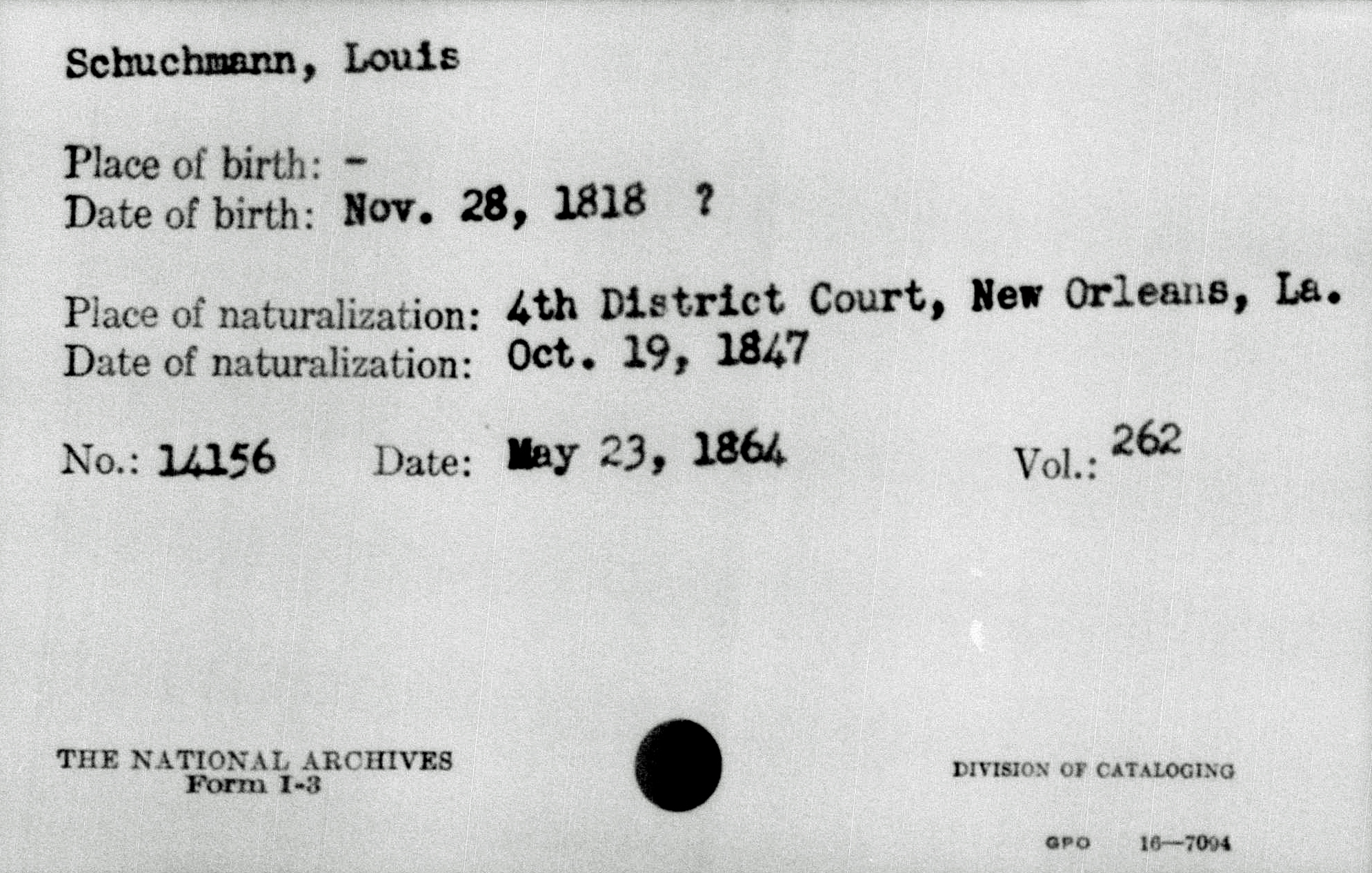
Ever since I discovered that my great-great-grandparents, G.W. Jatho and Elise Schuckmann, married in an unexpected place, Louisville, Kentucky, I was curious why they chose that city. Both were immigrants who came to join the large Charleston, South Carolina German community. G.W. came on his own in 1848 to ply his trade as a jeweler and watchmaker. Elise came with her mother and brother to join her father, Louis Schuckmann, who had established a popular haberdashery in Charleston.
Yet when G.W. and Elise decided to marry in 1853 (and wanted their legal union to be private, as noted in a previous post below), they selected Louisville, over 600 miles away from Charleston. In those days it was probably a two-day trip, maybe three, and from local documents that reveal the marriage we know that Elise's father accompanied them in order to give consent and to co-sign the marriage bond. Did they select Louisville because there was already a possible relative living there?
“"Citation: "United States records," images, FamilySearch (https://www.familysearch.org/ark:/61903/3:1:3QHK-G3Y3-FZ8R?view=fullText : Feb 28, 2025), image 4510 of 5529; United States. National Archives and Records Administration., accessed 28 Feb 2025.
Louis Schuchmann (the original surname spelling), born in 1819 in Darmstadt, lived in Louisville with his family, which included his wife Adeline Fleeger and several children, some of whom were born in Louisiana. That state included the port of entry for Louis, where he disembarked in 1842. Could he have been a relative, a cousin of Elise's father perhaps?
Finding this out wasn't an easy task. Louis never specified his birthplace more explicitly than Darmstadt in any of the available Kentucky records, and even finding out his exact birthdate or baptism date was thus a challenge. He didn't file any documents in Kentucky that indicated a birth year other than 1819. His descendants indicated a month and year at his Find-A-Grave website, but that's as close as I could get...until it occurred to me to check Louisiana in case he had left traces there. And he had!

The naturalization index card revealed a possible complete birthdate (with a question mark) of November 28, 1818, close to the birth year we have from other sources, just one year off. Louis must have applied for naturalization as soon as he arrived in 1842 because it was granted five years later in 1847. Shortly after that time Louis and his family must have relocated to Louisville, Kentucky.
But now that I had a reasonable birthdate for Louis I could check Darmstadt records to see whether I could locate a baptism for him. That would reveal his parents, which might get me closer to finding out whether there was a cousinly (or closer) relationshop between Louis and Elise's father, also called Louis.
Archion.de didn't reveal any relevant baptisms for either 1818 or 1819, but there are a number of Darmstadt parishes and it could be in any one of them, I onlu checked Darmstadt-Land and Darmstadt-Stadt. I could go through every single parish that's available online but I decided to try Ancestry and FamilySearch first.
“"Citation: "Deutschland, ausgewählte evangelische Kirchenbücher 1500-1971," database, FamilySearch (https://familysearch.org/ark:/61903/3:1:3Q9M-CSWP-1J6?cc=3015626 : 17 October 2019), > image 1 of 1; Records extracted and images digitized by Ancestry.com. German Lutheran Collection, various parishes, Germany., accessed 28 Feb 2025.
And FamilySearch came through. The cited record appears to be from a duplicate parish book for Darmstadt, thr "Evangelische Kirche. Garnisongemeinde Darmstadt" specifically serving the local military garrison, which explains why the clerk handwriting is different (and the quality much better, thankfully, than the records at Archion.) Louis (as Ludwig) was born on November 28, 1819. It was an illegitimate birth. The mother was Helena Pretsch, daughter of a deceased invalid Pretsch, no first name. The father was Corporal Wilhelm Schuchmann who was with a local military regiment ("Leibgarde," a bodyguard, presumably) in Darmstadt. The godparent was Ludwig Mohr, a corporal with another regiment, perhaps a friend of the father.
So who was Wilhelm? None of our Schuchmann folks were in the military to my knowledge, but there's no magic genealogical rule that says Wilhelm would not be a relative based on his profession. What about further records for Wilhelm? Luckily these duplicate books have a few.
Wilhelm and Helena must have married within a year or two of Ludwig's birth because another child appears in 1821, Margaretha, and the mother is described here as Wilhelm's wife. There must have been other children as well because an 1841 baptism for Georg Christian Schuchmann described him as the couple's seventh child. And Margaretha's baptism record identifies Wilhelm as from nearby Rodau.
Rodau was one of the locations for another set of Schuchmanns, the families who emigrated to Illinois. And we have documented evidence that those families are related to ours because we can trace them back to our common ancestor, Peter Schuchmann, born in 1604. Does that prove that Wilhelm was related to us? Not quite. I haven't found his birth or parents' names yet. But circumstantially it's beginning to look like a possibility. If so, that might explain why G.W. and Elise chose Kentucky as their marriage place. If Louis was a cousin of theirs, however distant, it might have made sense.
28 February 2025 | Email your comment.
Detail-oriented genealogy
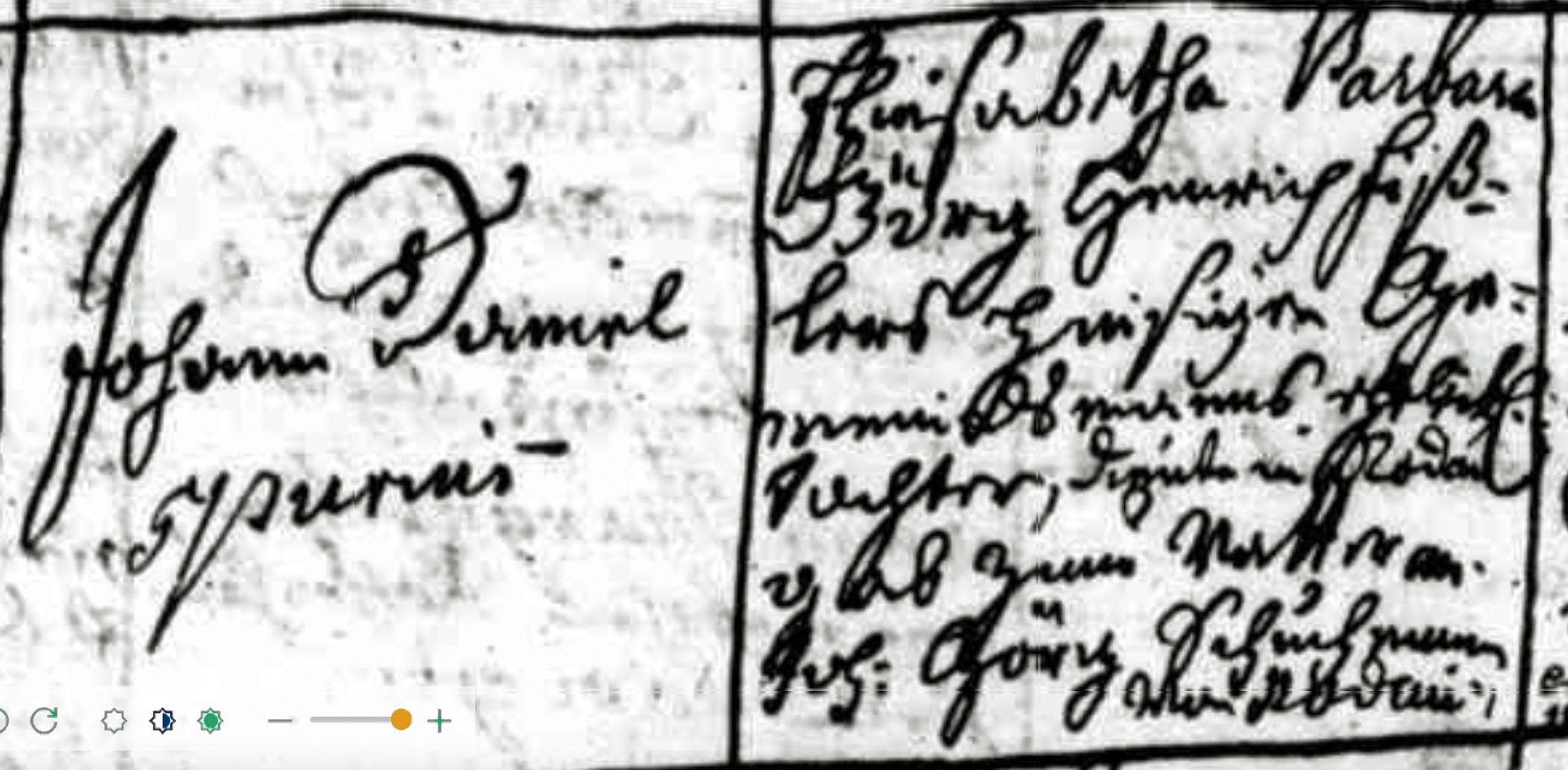
While looking through Schuchmann records the other week, following the line of Charles Schuchmann of St. Clair County in Illinois, I worked his line back to his grandfather, Johann Daniel Schuchmann, who was born in Groß Bieberau in 1781. This is where it sometimes helps to consult other Ancestry family trees to see whether they have records of his life in their documentation.
It's amazing to see how people often copy tree material from other online research without necessarily going back to the actual records. At least two family trees list Johann Carl's parents as Johann Georg Schuchmann and Elisabetha Barbara Fißler and cite a marriage in 1780, the year before the birth. But no such marriage can be found in the actual records.
“"Citation: Imaged at Archion.de, online database: https://www.archion.de/p/0c4147495f/, path: All Archives / Hessen / Zentralarchiv der Evangelischen Kirche in Hessen und Nassau / Dekanat Reinheim / Groß-Bieberau / Taufregister 1763-1799, Trauregister 1763-1799, Beerdigungsregister 1763-1799, Konfirmandenregister 1763-1799, baptisms for Johann Daniel Schuchmann, accessed 26 Feb 2025.
In the case of Johann Carl, born in 1781, there's the Latin notation "spurius" underneath his name. That's one clue that the birth was illegitimate. Another is that the mother's name is listed before the father, usually another indicator that the parents weren't married. In this case the record notes the presumed father, Johann George Schuchmann, who lived in nearby Rodau.
Some parishes had more inventive ways to indicate an illegitimate birth, such as writing the baptism entry upside down or sideways. But the fact that there was no marriage between the parents, at least prior to the infant's birth, is clear from this record. No need to invent a marriage for the parents.
A baby is still a baby, even without the marriage ceremony of its parents, and we're still related to Johann Carl. But it's important to accurately cite records that actually happened rather than ones we may wish had happened.
26 February 2025 | Email your comment.
Illinois connections
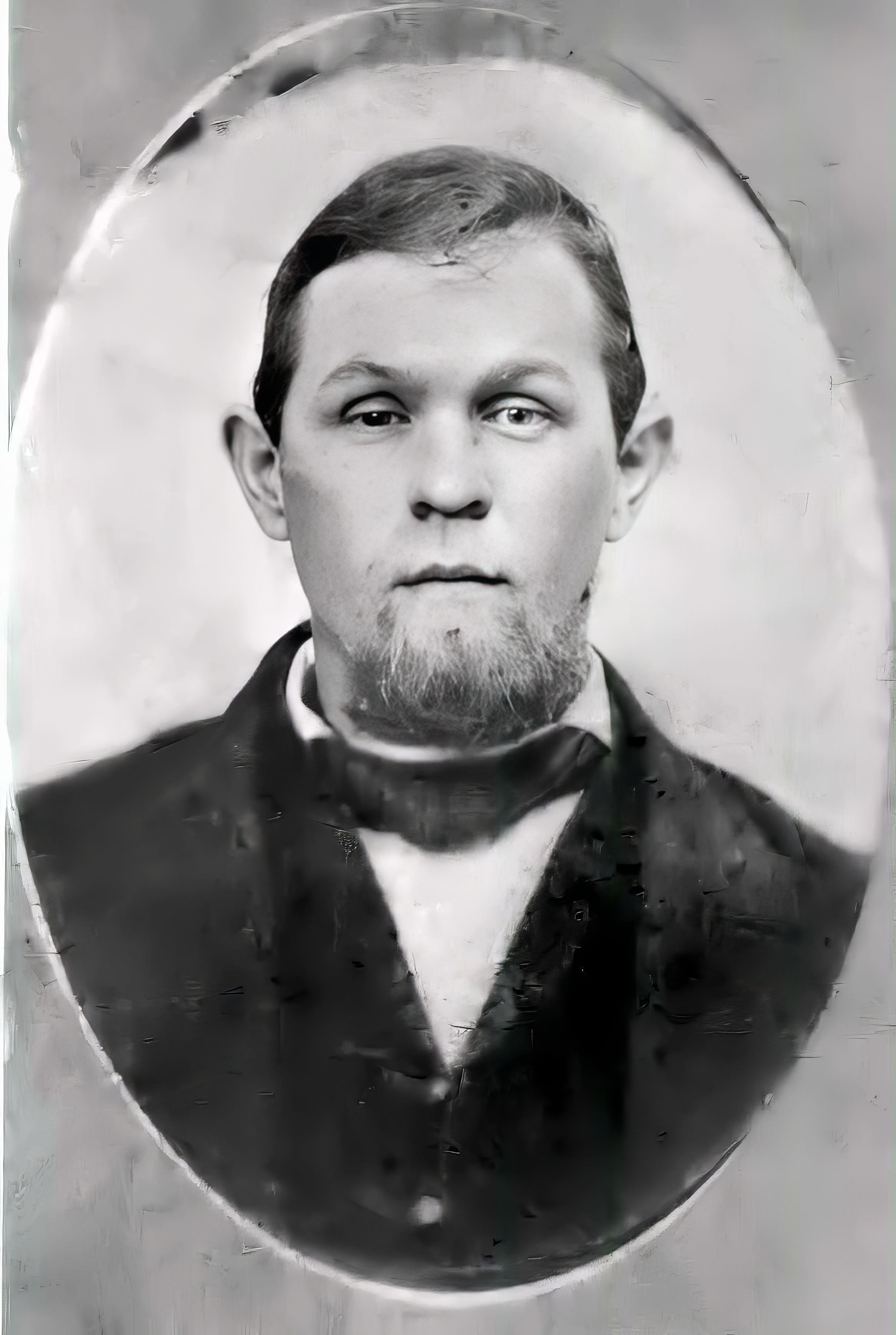
I've known about the Schuchmann clan of St. Clair County, Illinois. They're definite;y related to our Charleston, South Carolina family, who spelled their name Schuckmann once they emigrated to America. And while I knew we had a connection via a seventeenth-century ancestor, this is the first time I've traced it back myself. Archion.de makes it easier these days with its extensive offering of online records.
This photo is of Charles Schuchmann, a stern young man who was probably about thirty years old at the time the portrait was taken. He arrived in the U.S. in 1834 as a four-year-old child with his parents, who disembarked at Baltimore. They settled in St. Clair County, Illinois where his father Carl Friedrich Schuchmann was a cooper, a craftsman who made and repaired wooden barrels, tubs, buckets, and other containers -- a useful craft during an era when barrels could hold a variety of commercial and home goods.
“"Citation: Charles Schuchmann, "Buecher Family Tree" https://www.ancestry.com/family-tree/person/tree/185423583/person/372428589181/facts, media gallery created by Robert Buecher, browsable images, Ancestry.com, photo of Charles Schuchmann circa 1860, accessed 23 Feb 2025.
Our Schuckmanns in Charleston were haberdashers, suggesting that these two families were pursuing independent lines of expertise. Our folks may not have known that they had cousins in Illinois. The desire to emigrate for better opportunities was a strong incentive, however, and the 1830s through the 1880s were a popular time for German immigration to America.
If you follow our two lines back in the region of Groß Bieberau and Reinheim, where our Schuchmann families lived before emigration, you'll see them converge in our common ancestor, Peter Schuchmann (1604-1688), who was born in Hausen (nowadays called Fischbachtal) and was known as "Gerber Peter," a tanner by trade who prepared leather goods. Peter and his wife Margarethe Wasenmüller had eleven children including triplets, not all of whom (sadly) made it to adulthood.
The Schuchmanns of Illinois descend from Wendel Schuchmann, the first-born son (1639), while our Charleston family descends from Johann Georg, the last son born in 1654.
There's a group of Schuchmann folks who emigrated to Louisville, Kentucky as well and may be connected to our mutual families. More research will be needed to establish a connection.
23 February 2025 | Email your comment.
A mysterious misspelling
For years I'd wondered how my great-grandmother's death record from Chicago had ended up reporting her name so indescribably wrong. Was the fault with someone indexing the record at Ancestry? But it was the same way at FamilySearch, so probably not.
Remarkably the record itself was the problem.
I managed to obtain the actual image of Elizabeth Robers' 1926 death certificate, which is available on microfilm at any Family History Library or affiliated library. There's no facility near me anymore but I belong to a Chicago Genealogy group that will volunteer to look up microfilm records and send the image at any member's request. That's when I found that the record itself was the source of the mistake. Click the image above left to see an enlargement.
“"Citation: "Illinois, Cook County Deaths, 1871-1998," digital image, FamilySearch (https://www.familysearch.org/ark:/61903/1:1:QLYT-Z3MB : Feb 19, 2025), entry for Villamino Bruns and Gus Robers, 21 September 1926., accessed 19 Feb 2025.
The indexed records refer to the deceased as Villamino Bruns, which was certainly not Elizabeth's name in any way. There are other mistakes in the record too. Her husband, it's true, was B.A, Bruns, familiarly known as Gus (for Augustus, his middle name). But her father was not Gus Robers, it was Johann (John) Robers. Her mother's first name was Theresia, and her original surname was Schulte, close to Shotten. But Villamino? Where did that come from?
My best guess is that the doctor who originally certified the death submitted incomprehensible handwriting in his notes to the Cook County registrar, who was responsible for transcribing the notes and filling out the official death certificate. Transcribers at Ancestry and FamilySearch reported what they read. It's all there in black and white.
It might be worth contacting both companies to report the error, but mistakes of this nature are hard to correct without some sort of corroborating evidence, which we don't have. No obituary exists for poor Elizabeth Robers Bruns in any of the online newspaper databases, and the original notes for this death are presumably long gone. We're stuck with what we have. The best I can do is note the mistake in my own family database and move on.
19 February 2025 | Email your comment.
A family affair

Some years ago a genealogist I'd hired to help me with research told me that he always paid attention to godparents at baptisms because they could often tell you something about the family, and that's certainly the case with Heinrich Joseph Bruns, my great-great-grandfather, who was born in 1814 and baptized in Langförden parish in Oldenburg.
“"Citation: Matricula Online (https://data.matricula-online.eu/en/deutschland/vechta/langfoerden-st-laurentius/KB06/?pg=14 : 15 Feb 2025), baptism for Heinrich Joseph Bruns, path: Startpage Deutschland Vechta, r.k. Offizialatsarchiv Langförden, St. Laurentius Taufen | KB06, accessed 15 Feb 2025.
I'll admit that the inclusion of Marie Elisabeth Mohlmann (born Stegemann) is a bit of a puzzle. We don't yet know of any surnames such as this in the family. But Heinrich Joseph Oldehues rings a bell. He gave his first and middle names to the infant, and Oldehues is a familiar family name.
The child's grandfather, Fridericus Andreas Bruns, was married to Anna Catharina Oldehues, and having looked at that family our database records a robust passel of Oldehues folks is certainly present. He's probably an uncle or cousin of the father, Johann Bernd Bruns. A little more digging might turn up the exact relationship, which would further explain why he was part of this record. It could also tell us more about the family, particularly whether they also emigrated to the USA, as Heinrich Joseph would do in 1844.
15 February 2025 | Email your comment.
The graduate
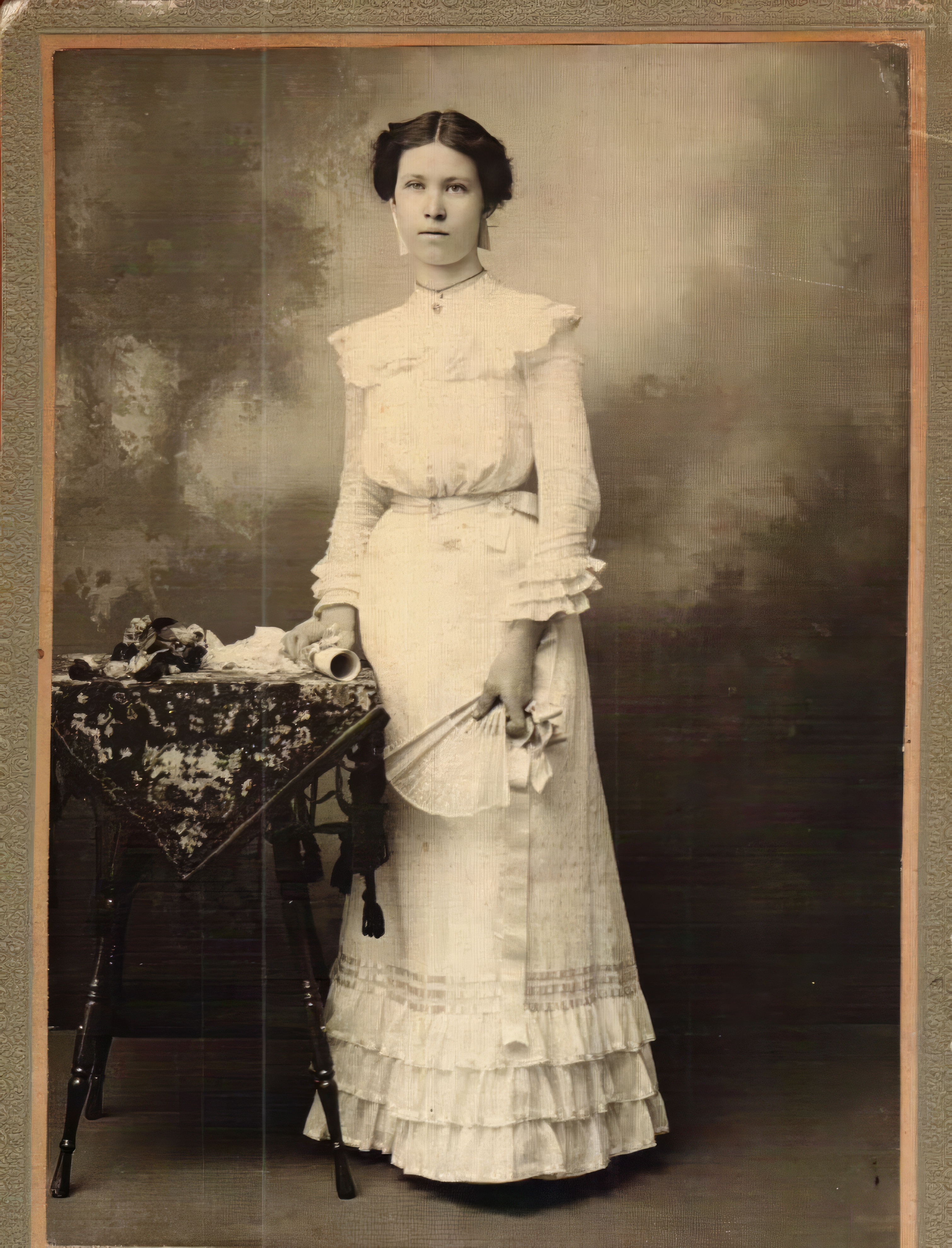
While researching my cousins-by-marriage, the Chicago Breetzke family, I keep encountering their Nebraska cousins and finding their charming photos.
My Breetzkes -- two brothers, Walter and Erich -- were born in Woltersdorf, Pomerania in 1902 and 1906 respectively. They emigrated to Chicago in the 1920s to meet their cousin Harry Breetzke. Walter, like his brother Erich, came from a family of master blacksmiths in Woltersdorf, but in Chicago Walter would learn the new family trade of plumbing with his uncle Julius. Erich, established as a gardener, made that his trade.
Then we have their Nebraska cousins, one of whom was Ida (at right), daughter of William Frederick Breetzke and Auuguste Bertha Melcher. There was a large clan of Breetzkes in Wisner, Cuming County, Nebraska, all from the same region as Walter and Erich. There was a lot of back-and-forth between the families as well
“"Citation: Find A Grave (http://www.findagrave.com), memorial page 91377775, Ida H. Breetzke Emley (1884-1977), maintained by Mrs. Peterson, photo submitted by June Belling-Sullivan; citing Wisner Cemetery, Wisner, Cuming County, Nebraska, USA, accessed 10 Feb 2025.
Find-A-Grave is a treasure trove of possible images, and it's much appreciated when someone from the family contributes to a memorial page. Resources like Newspapers.com can help fill in a little more of family stories. This photo appears to be a high school graduation portrait based on Ida's estimate age and the rolled diploma. It could be a confirmation photo, but Ida appears to be 16-18 years old here and we know it was customary in some communities for women graduates to dress in white. The fan that Ida is holding is a nice touch, although its significance isn't clear, maybe just a photographer's prop.
Stories on local Cuming County newspapers indicate that Ida was regularly on the school honor roll and by 1902, her graduation year, she was president of her school's literary society. In 1907 Ida married Franklin Pierce Emley and they had three daughters: Neola, Dolores, and Mildred.
Local newspapers regularly published the comings and goings of Walter and Erich Breetzke who visited from Chicago. Erich married a local Wisner girl, Anna Rabe, and Walter's 1934 marriage to my cousin Florence Mikkelsen was celebrated with a society notice in 1934. Clearly this was a close-knit family.
10 February 2025 | Email your comment.
The bonds of holy matrimony
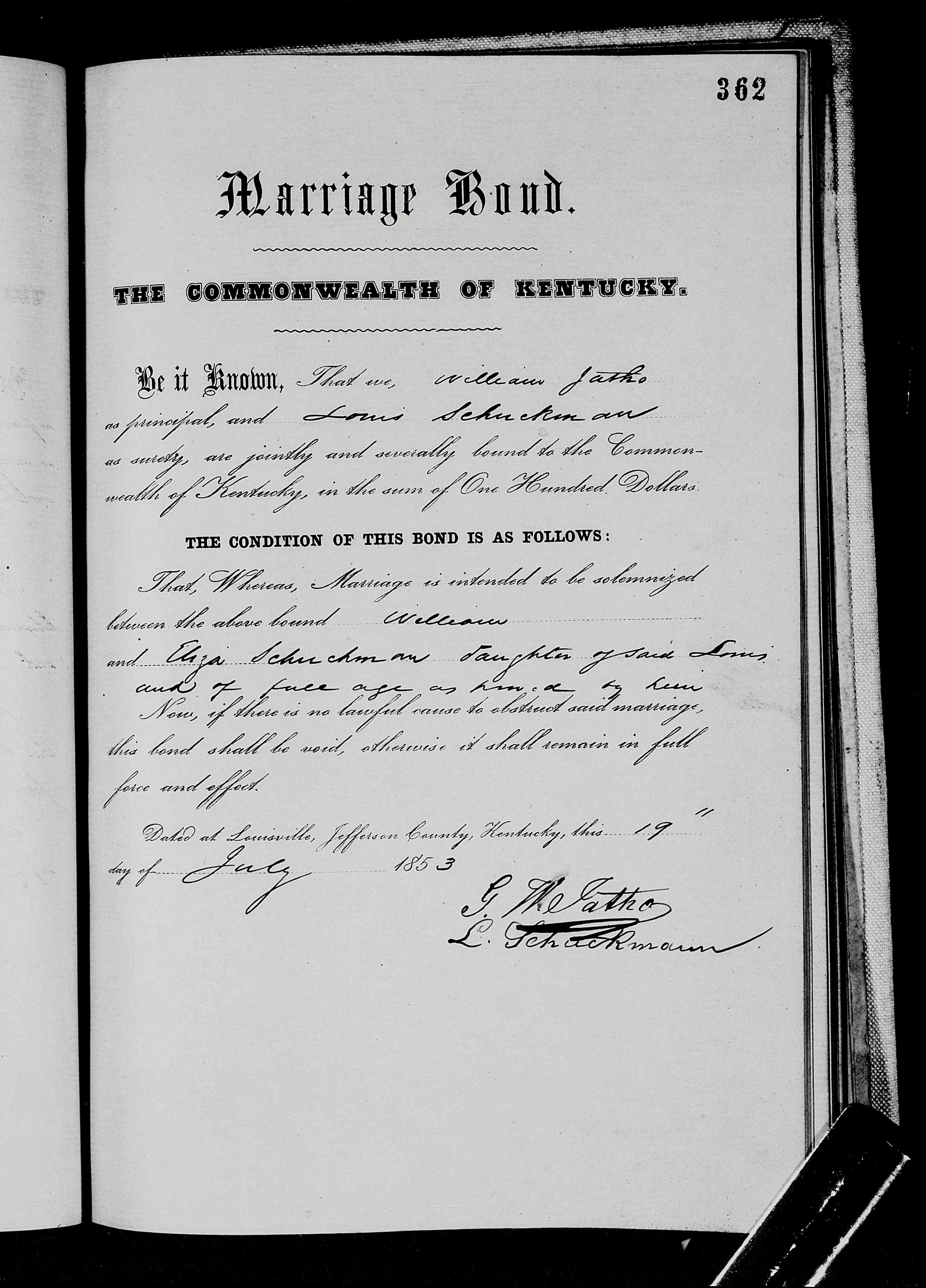
In some states in the nineteenth century those words were actual law. And in Kentucky a marriage bond was equivalent to a marriage license, which is what we see here.
The circumstances of this marriage were a little unusual. The bride and groom actually lived in Charleston, South Carolina. William Jatho, a watchmaker and jeweler, and the bride Elise Schuckmann already had an eight-month-old infant together but for reasons unknown the couple didn't marry in Charleston. They went to Louisville, Kentucky, instead, accompanied by the bride's father Louis Schuckmann, a haberdasher with a popular shop in Charleston.
The $100 bond was a surety, a promise that a marriage would take place or if it didn't whoever prevented the marriage would owe the commonwealth of Kentucky the promised funds. If the marriage occurred, no one owed anything. There's some interesting information about Kentucky marriage bonds at Kentucky Kindred Genealogy that explains the legalities in more detail. The officiant, usually the minister or justice of the peace, brought the bond to the county clerk, who recorded the marriage.
“"Citation:"Jefferson, Kentucky, United States records," images, FamilySearch (https://www.familysearch.org/ark:/61903/3:1:3Q9M-C9BN-2HC5?view=fullText : Feb 6, 2025), image 766 of 805, accessed 6 Feb 2025.
What's nifty about this document is the signatures -- that of the groom and his soon-to-be father-in-law. My great-great-grandfather William signs as G.W. Jatho, his usual designation preference. Louis Schuckmann (my 3x-great-grandfather) signs his full name.

That same day, 19 July 1853, the Jefferson County marriage register recorded the marriage between William Jatho and Elise (here spelled Eliza) Schuckmann, noting that she was the "daughter of Lewis [sic] who consents in person."
Why Louisville though? It was likely sufficiently out of town so that nosy Charlestonians wouldn't be aware that the couple was not already married, but there was also a clan of Schuchmanns (who spelled their name the German way) in Louisville who may have been related to the bridal family. Their patriarch was also called Louis Schuchmann and like his presumed cousin he was also a haberdasher and tailor. If that's true, it was probably a comfort to have other family present and the Jatho-Schuckmann union, not to mention a bit of a relief that the marriage finally occurred.
6 February 2025 | Email your comment.
A drop of the Irish
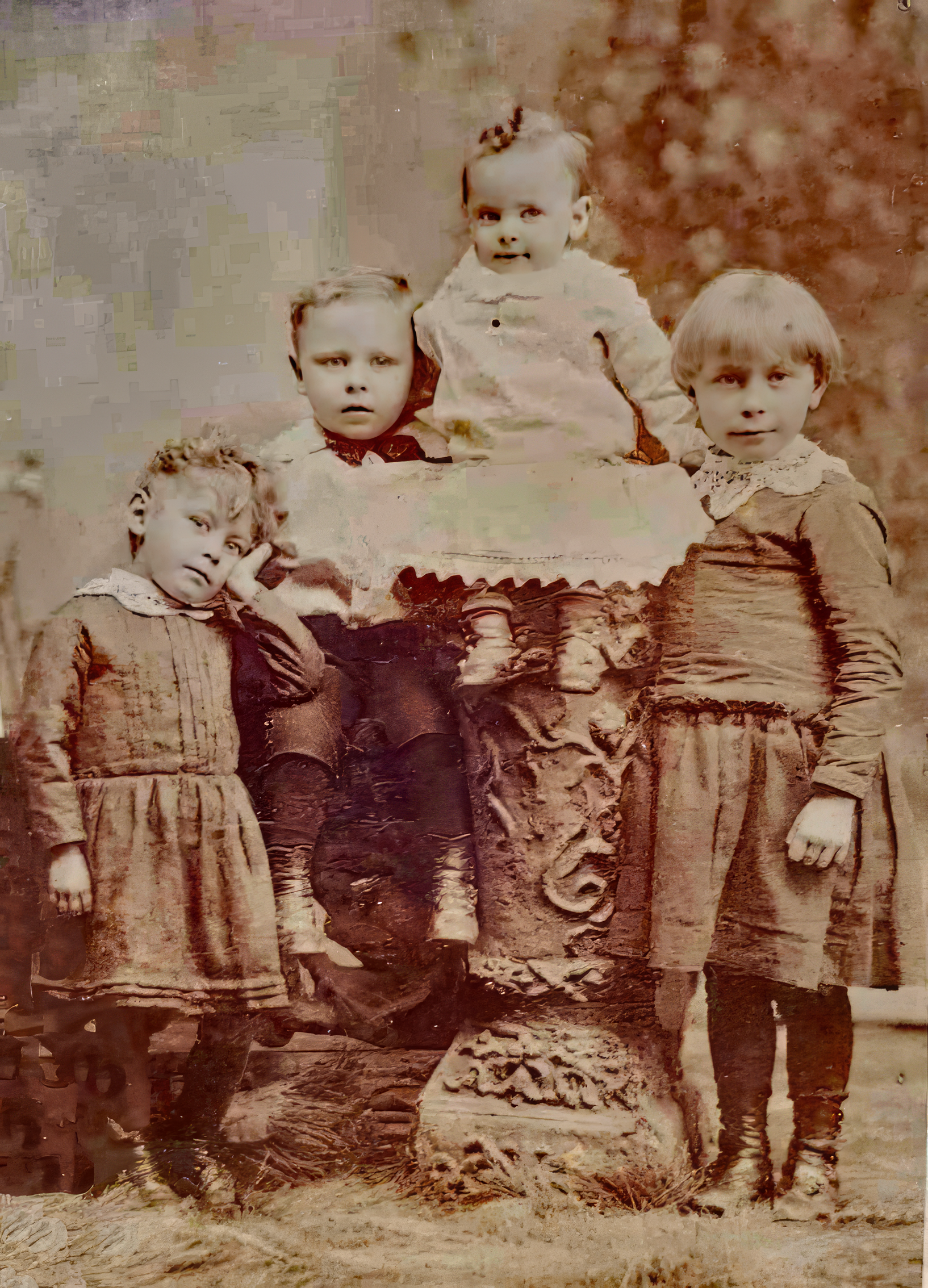
We really do have only a couple drops of Irish influence in our family, both involving families called Murphy from Ireland, though not at this point provably related. Murphy was a common name, although it's notable that two of our ancestral ladies of German heritage both married men called Murphy.
“"Citation: Anni McNulty, "McNulty Family Tree" media gallery created by Anni McNulty, browsable images, Ancestry.com, photo of Theresa, Owen, Lizzie, and Mary Murphy circa 1886, accessed 3 Feb 2025.
This charming photo shows the children of John D. Murphy and Mary Grace Jamison Murphy taken at the Mann photography studio in Bangor, County Down, Northern Ireland about 1886. Charmingly pictured are Theresa, Owen Patrick, baby Lizzie, and Mary Murphy. The family of six emigrated to Chicago a year later and more children were born there.
The question is: how did Emma Hasse, born in Chicago in 1887 to Carl and Augusta (Kramp) Hasse, meet and marry Owen Murphy? Emma was the daughter of immigrant parents as was Owen but presumably they travelled in different ethnic neighborhoods. However they met, the die was cast when Owen and Emma discovered that a baby was on the way and wanted to tie the knot before the baby's arrival. The question was: where could they find a friendly place for marriage?
It's possible that there was some family resistance to the relationship, maybe because of the mix of religions (Owen was Catholic, Emma Protestant) or cultures. The couple availed themselves of one of the "Gretna Green" communities where marriage restrictions were more liberal than those in Chicago: Berrien County, Michigan.
The couple married there on 15 August 1909 (Familysearch.org has a collection called "Michigan Marriages, 1868-1925" with good information on the couple) and back in Chicago two months later they welcomed a daughter, Loretta. As a cousin of the extensive Gohr/Bruns clan Loretta was a treasured niece and cousin to her extended family.
Emma died in 1940 in Chicago while her husband Owen died in 1955 in San Diego. Loretta and her husband Joseph Mayhan lived in Chicago for the rest of their lives.
3 February 2025 | Email your comment.
Using eBay as a genealogical tool
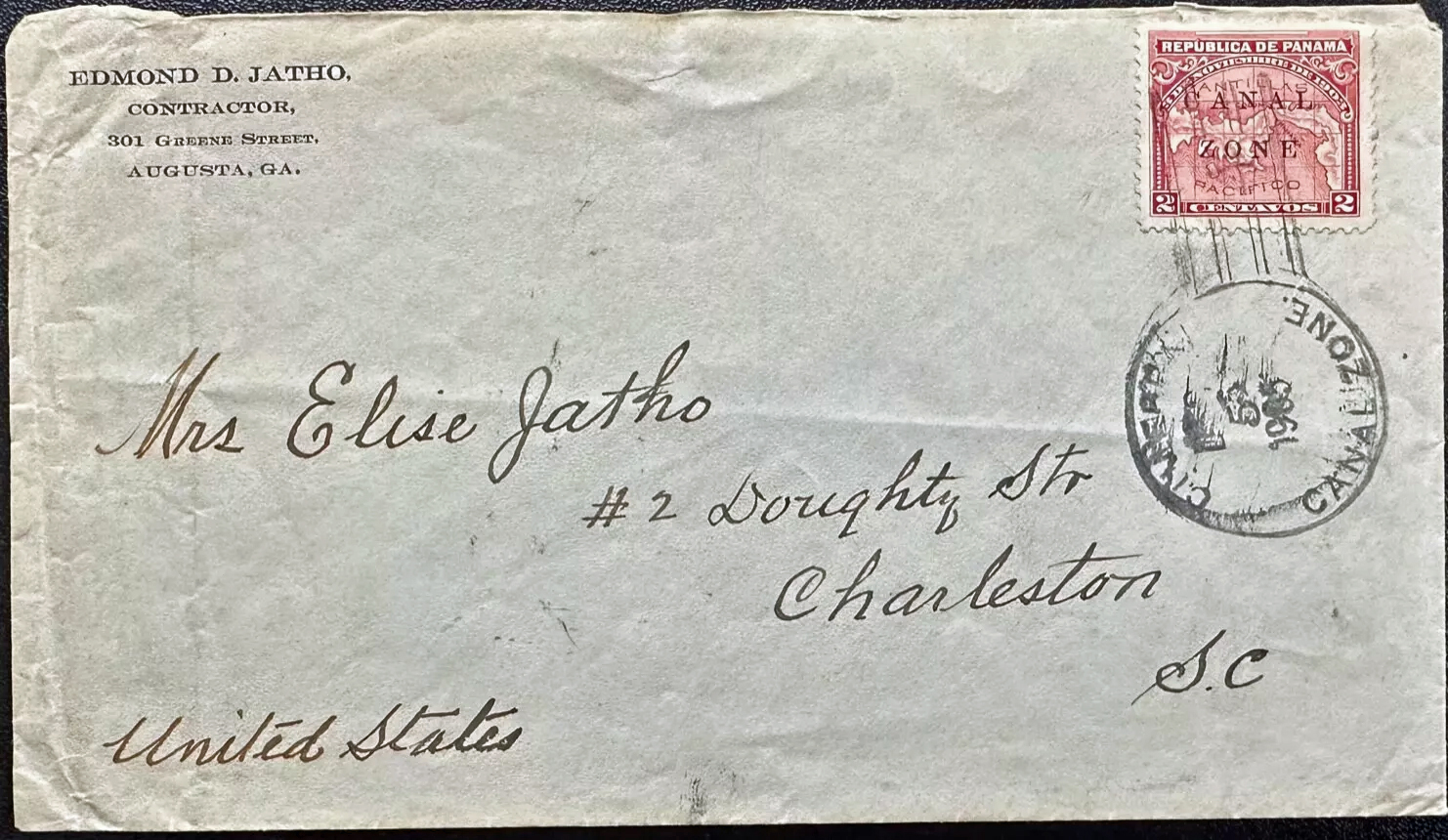
This is another way that family history can be augmented by using image searches to find keywords in unexpected places, such as the online auction site eBay. Here's what turned up: an envelope (sans letter, unfortunately) addressed from Edmond D. Jatho, my great-grandfather's younger brother, to his mother Mrs. Elise Jatho back home in Charleston, South Carolina.
“Citation: Digital image of an envelope, "1905 Canal Zone #10 on cover Calebra to US; map *d" sold by eBay ID philventure98, order number: 17-12600-73095, order date January 21, 2025, delivered and in personal collection, accessed 28 Jan 2025.
I'm not into philately (stamp collecting) although that was the intended target audience for this item. Rather the envelope suggests by its postmark that it was sent from the Panama Canal zone, which several years earlier had taken over construction from the French.
What was Edmond Jatho -- late of Charleston and New Orleans -- doing in Panama? We know that he'd made his home in New Orleans after marrying Edith Ripley and having four children there. But he ran into financial difficulties, wrote bad checks and IOUs, had a judgment placed against him and saw his home furnishings sold by decree to settle debts, and had been divorced by Edith. Edmond tried to reconfigure his life by enrolling in Charleston College to study law, but never graduated.
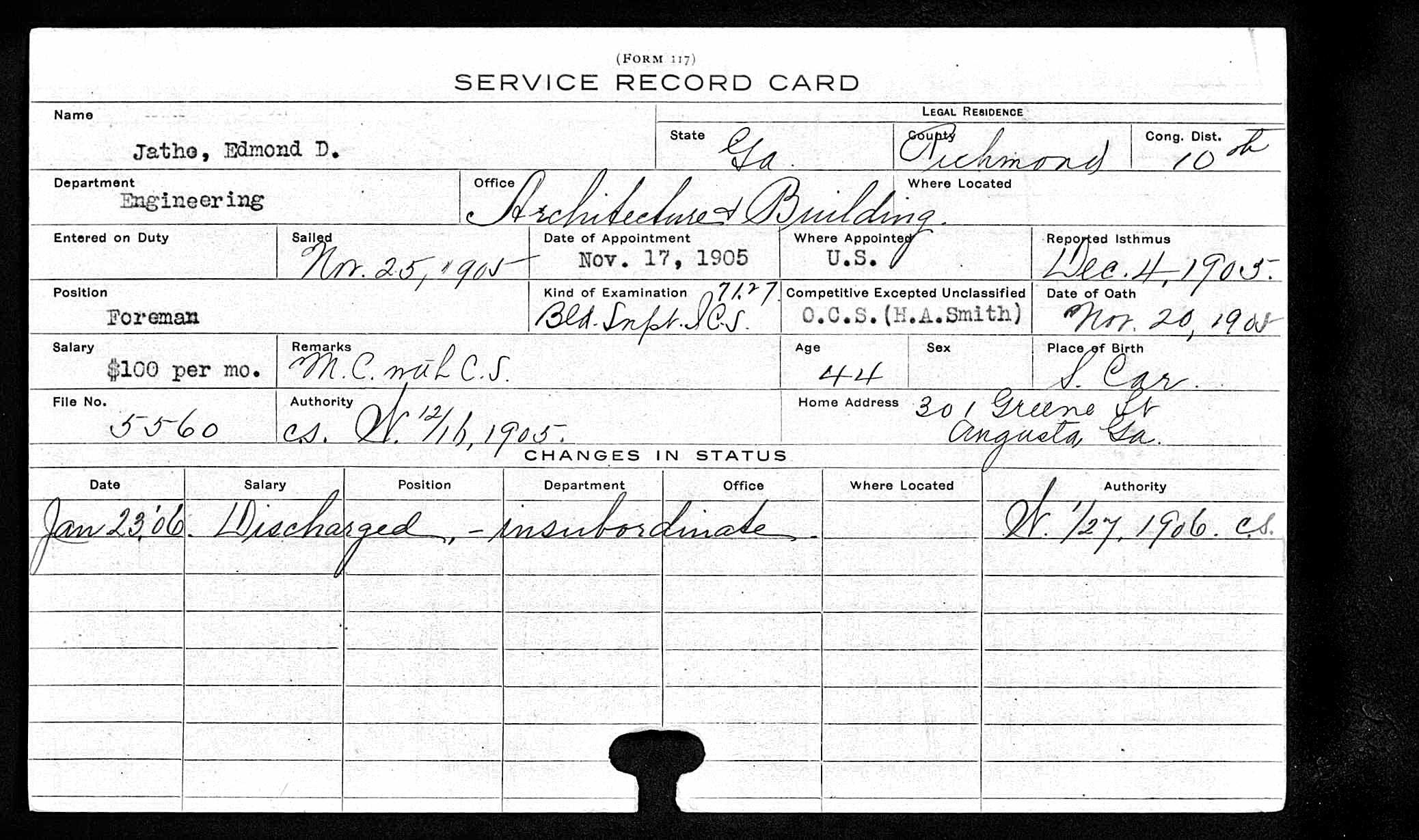
Perhaps that's when the opportunity arose to find employment in Panama working as an engineer on the canal project. Amazingly Ancestrylibrary.com offered an employment record for Edmond, indicating that he'd been hired in November 1905 at a salary of $100 per month in the Architecture and Building Department. But it didn't last long.
By January 1906 Edmond was fired for insubordination. This general category leaves us wondering what the actual infraction might have been. Perhaps the job just wasn't a good fit, or perhaps Edmond didn't have the necessary skills to handle his duties. And the letter that once was included in this envelope (postmarked December 13, 1905) was probably a note to his mother explaining how the job was going, or complaining about it.
Edmond's 1910 obituary (he died in Chicago) referred to him as a civil servant of some years, an inspector with the U.S. Army division of the Department of the Lakes. His time in Panama was only briefly mentioned but thanks to Ancestry we understand bit more of Edmond's employment adventures, and thanks to eBay a nice document in Edmond's own hand.
28 January 2025 | Email your comment.
Images in unexpected places
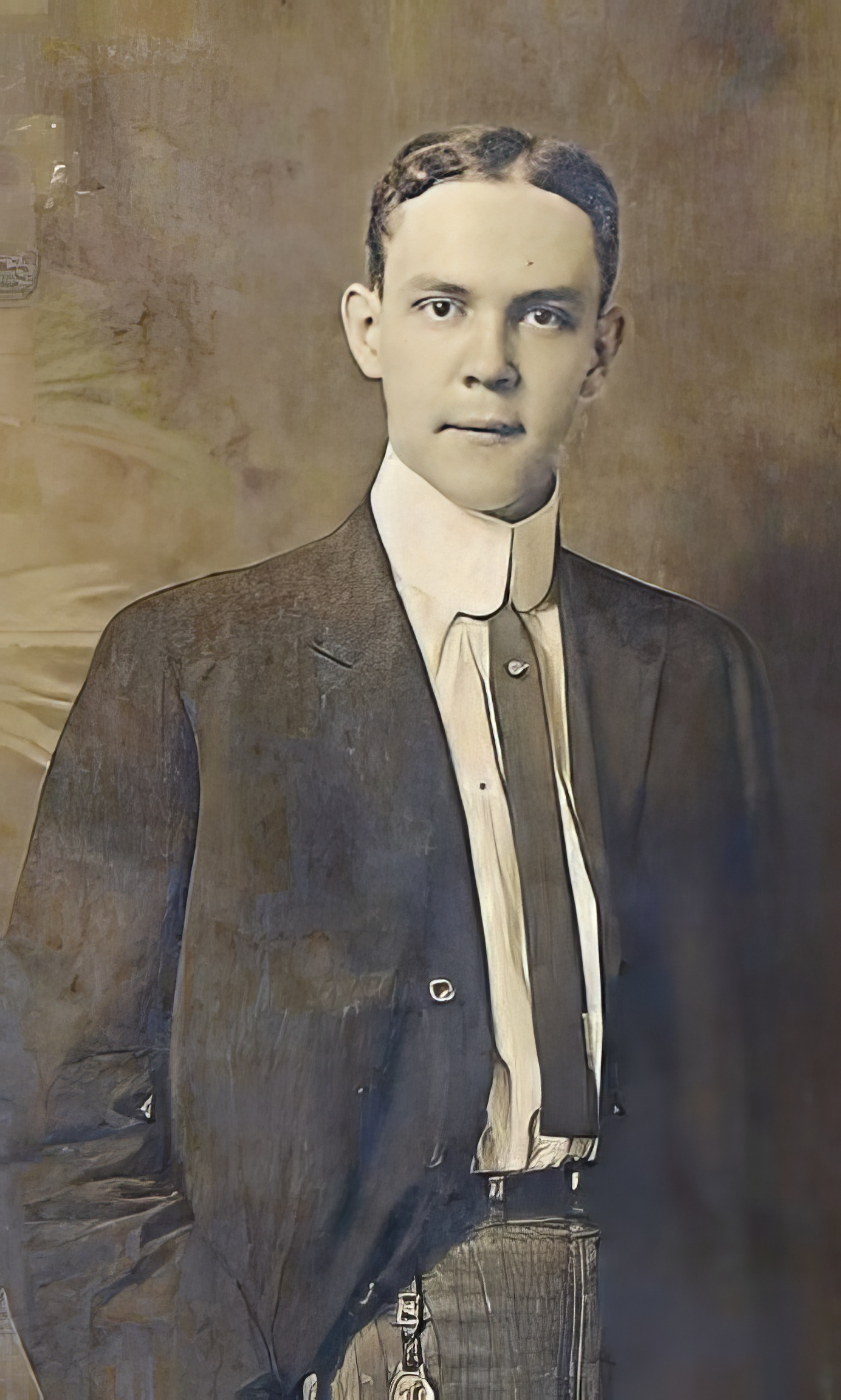
My son, who has greater potential as a genealogist than he realizes, reminded me of a resource I'd been neglecting. He asked whether I'd done what he calls a "reverse lookup" based on images rather than keywords -- basically using a search engine to look for images rather than documents. He was right. I'd been forgetting to do this. Here's the result: a small cache of photos posted in an online memorial by some of my cousins for a deceased family member fifteen years ago.
“Citation: Image at https://www.dignitymemorial.com/, online database: https://www.dignitymemorial.com/obituaries/metairie-la/norwood-jatho-4491070/, memorial page for Norwood "Jack" Jatho Jr. (1919-2010), accessed 24 Jan 2025.
This is Norwood Jatho, born in Charleston, South Carolina in 1887 to Edmond D. Jatho and Edith Ripley. Their home was in New Orleans but for some reason they were in Charleston for Norwood's birth, for reasons unknown. The oft-repeated story of Norwood's first name comes from a family legend that Edith Jatho saw the name "Norwood" on a casket made by a company of the same name. I've been unable to verify this story and can't locate a funerary production company from that era using the name "Norwood," and besides, who names an infant after a coffin? It's a memorable tale nonetheless.
The uploaded photos on this page lack captions, which is a shame, but most of them are identifiable based on others shared by this family. Norwood was the second child and only son of Edmond and Edith. He grew up with his sisters in New Orleans in a home where his father drifted away from the family pretty early in their lives. Edmond had financial issues and was divorced by Edith, who then married Robert Macmurdo, with whom she had two boys.
A salesman of stationery supplies, in 1917 Norwood married Adelaide Gadpaille, whose ancestral roots included New Orleans and Jamaica, and back to Nantes in France if you search hard enough. Norwood and Adelaide or "Addie" had four sons: Norwood Jr., Kenneth, Joseph Charles, and Edgar. Norwood Senior died in 1939.
This is a nice portrait of a young man about to make a name for himself in business and establish a loving family. It's great to be able to add this to the photo gallery. And it's a reminder to me to consider online memorial photos as a resource for images of the past.
24 January 2025 | Email your comment.
When transcribers mis-transcribe

Records in Kirchenskreis Münden are online, thankfully, but can be hard to read, damaged, or missing entirely. I'm grateful that Archion has digitized them, along with some very helpful typescript transcriptions of those records. When my eyes get tired of trying to read faded ink or problematical clerical entries, it helps to have modern-day versions to doublecheck the accuracy of what's there. But sometimes even that's an issue
“Citation: Imaged at Archion.de, online database: https://www.archion.de/p/d74edc6453/, path: All Archives / Niedersachsen / Landeskirchliches Archiv der Evangelisch-lutherischen Landeskirche Hannovers / Kirchenkreis Münden / Lutterberg / Taufen Abschrift 1638-1712, baptisms for Jatho, accessed 20 Jan 2025.
This entry for the parish of Lutterberg organizes baptisms from 1638-1712 in alphabetical order. There are three entries for children of my 8x-great-grandfather, Valentin Jatho, but one of them was misunderstood by the transcriber and it adds an element of confusion. There's a child listed on 8 August 1639 called Valentin, son of a Johan Berndt. The trouble is that there's no corresponding handwritten entry for a Jatho child baptized in 1639, or in any adjacent year. Okay, someone misread an entry, I thought, and documented the anomaly in my research notes.
But now, after encountering another baptism in this family that wasn't part of the transcribed record, I know what must have happened, and here's how I found out.

I decided to look through death records in the parish of Uschlag, where Valentin Jatho was a schoolmaster and a parish clerk after his early days in Lutterberg. Here I found a death record in 1680 for a son I din't know about, not named, age approximately 22 years and 4 days, who died of measles. So my initial approach was to look for a birth about 1658 or 1659 in either Lutterberg or Uschlag so I could properly document this new child.

There wasn't a Jatho birth in 1658 in Lutterberg but there was one in 1659: a child of Valentin Jatho, Johan Berndt. That corresponds roughly to the age of the deceased son in 1680 -- a mistake easily forgiven because the Lutterberg baptism occurred in a different parish from the 1680 Uschlag death record. Cross-checking wasn't available so the reporting party (presumably Valentin) was relying on his own memory to document his son's age at death...a sad business because this was the second son called Johan Berndt to die. The first one, born in 1649, must have died before 1659 because it wasn't correct protocol to name two children the same name. One honored the memory of the other. Even if we can't find a death record for the first Johan Berndt, it's the most likely explanation for two children with the same name.

So how did the error occur in the transcription? The 1659 entry for Johan Berndt Jatho is tucked neatly among other 1659 baptisms on that page with the clear heading of 1659 at the top, but in his enthusiasm to record the baptism (this may have been Valentin writing in his capacity as parish clerk), the entry included the full date: 8 August 1659. But the numeral 5 looks like a 3 here. What's up with that?
This is where my background as a calligrapher came in handy. I compared the 1659 heading and the 5 there has a curious curvature that could have been mistaken for a numeral 3 if the top bar of the 5 weren't there. And that's what I think happened to the entry for Johan Berndt's baptism: either the quill pen ran out of ink when the clerk was creating the pen stroke for the top bar, or the ink had flaked away over time. That left a numeral 5 looking like a 3, and that's why the transcriber, just being helpful, included the baptism date as 8 August 1639 instead of 8 August 1659.
This was a good lesson for me. In parishes where Archion includes the transcribed records it's always essential to compare the modern typed copy to the original. Otherwise I might still be trying to figure out who that child was from 1639...a child who didn't actually exist until later.
20 January 2025 | Email your comment.
Parents missing! Who was Audrey Torpie?
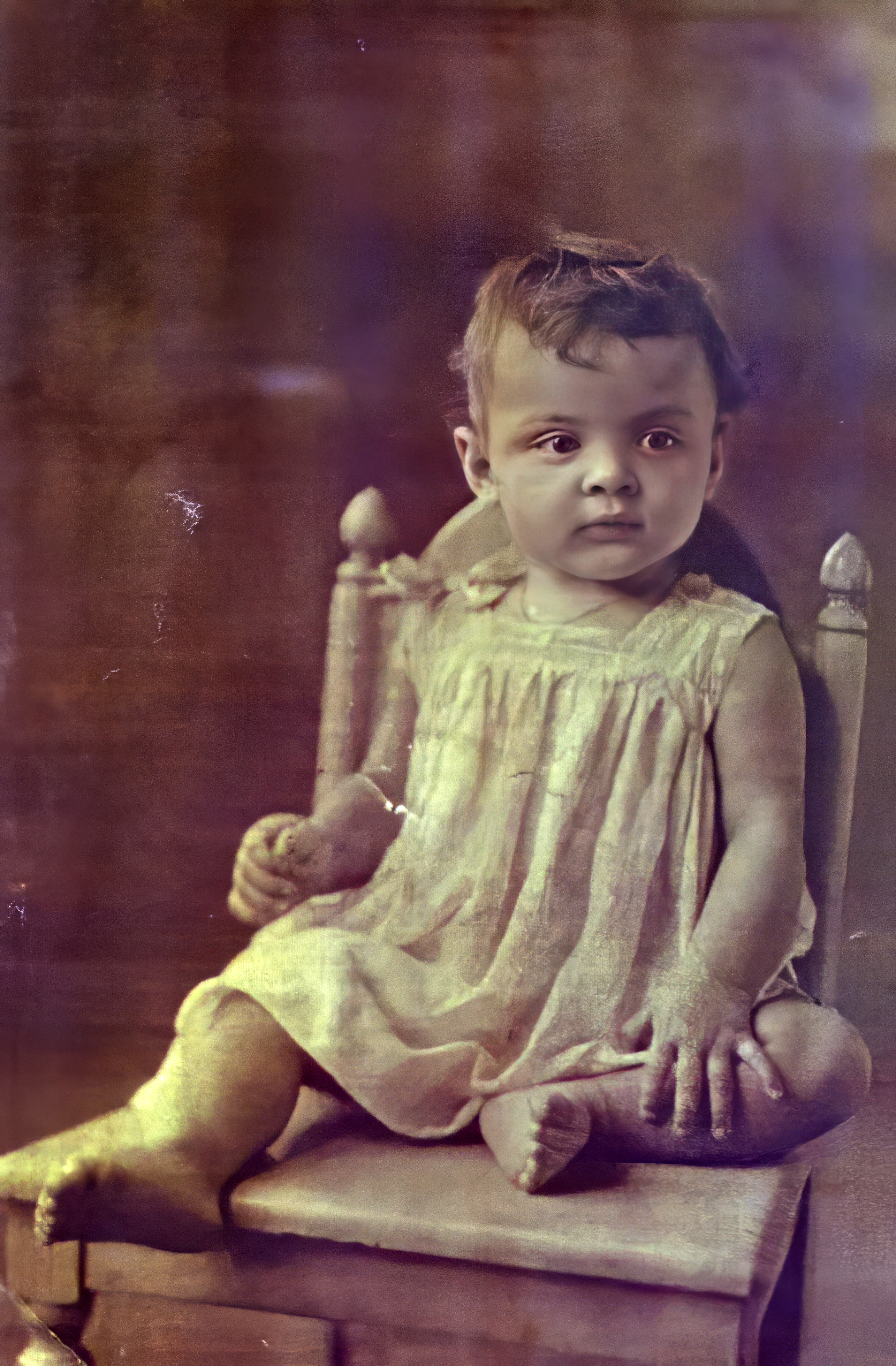
She was an enchanting baby. I was introduced to her as Audrey Lorraine Torpie, born about 1927 in New Orleans. When she grew up she married Joseph Charles Jatho in New Orleans and had four children, some of whom pose nicely on the sofa in the banner above. But no matter how I searched for her I couldn't find any evidence of her existence before 1940, when she was listed in the U.S. federal census for that year with William H. Torpie, listed as her uncle.
“Citation: Digital reproduction of a photograph, front side, collection of Edgar Jatho: Audrey Lorraine Torpie, studio portrait, New Orleans, Louisiana 1925, original photograph from the collection of the owner, scanned in 2008, accessed 14 January 2025.
Ancestry.com has some civil birth records available in their collection "New Orleans, Louisiana, U.S., Birth Records Index, 1790-1915" but only through 1915, and Audrey was born about ten years later. She doesn't appear in the U.S. federal census for 1930, at least under that name, not in Louisiana, not in adjacent states. Her 1940 appearance in the census shows her living with her uncle William Torpie and his wife Nora. Here her birth year suggest that 1927 is an optional date for her birth.
Switching to FamilySearch.org in case of any documents indexed there that are not in Ancestry we have some success. In the collection "Louisiana, Parish Marriages, 1787-1958" there's a detailed transcription of information related to her marriage to Joseph C. Jatho in 1943 (Audrey is pictured with Joseph lower right), but there's a twist. Here she's listed as Audrey Lorraine Young, with parents Sydney D. Young and Nora Green. Interesting -- William Torpie's wife was also called Nora. Is this a clue to Audrey's real parents?
Poking around a bit more reveals the 1920 census where William H. Torpie, son of widowed Ella Torpie with two other siblings Grace and Robert, lived right next door to Sidney [sic] and Nora Young. Further investigation reveals that Sidney died in 1921 and left Nora a widow, although this was at least four to six years before Audrey was allegedly born. So while Nora might be her mother, Sidney was unlikely to have been her father.
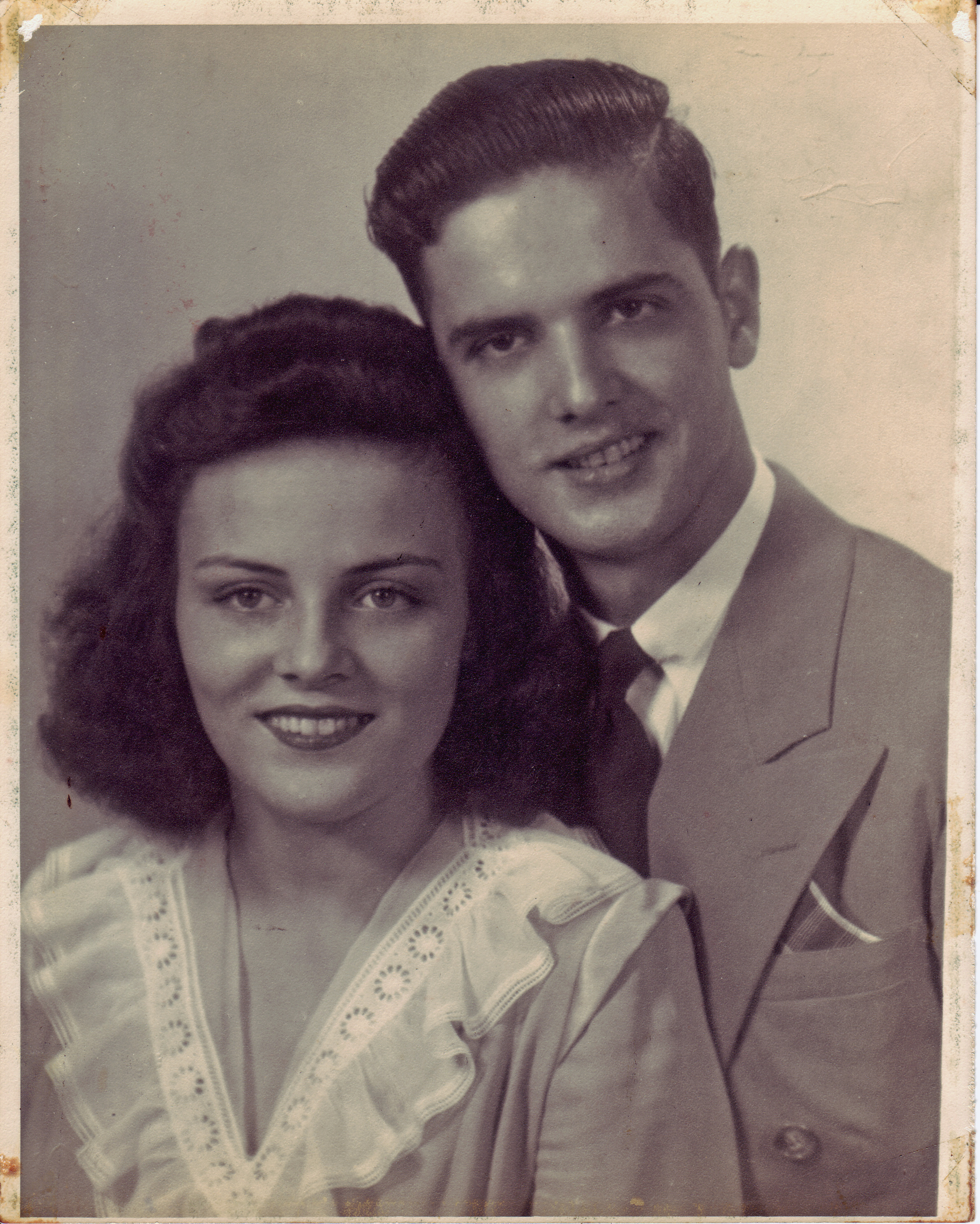
THe only place we see Young as Audrey's surname is on her marriage registry. She's listed as Nora's daughter in Nora's 1975 obituary (Nora's other children Althea and Earl are also included in this obituary). Proof?
Could be, except for a notation in my records when I was busy scanning all the available New Orleans Jatho photos in 2008. Sitting with Edgar Jatho, who generously shared these images with me, I took down his identifications of every picture we scanned. He handed me the photo of baby Audrey together with one of Grace Torpie. "Grace was Audrey's mother," Edgar told me. I duly noted it, although we have no other corroboration for this bit of information. But it would explain why Audrey was listed in the 1940 census as William Torpie's niece. Grace, after all, was William's sister.
To my knowledge and from information available online we have no definitive evidence that this is Audrey's actual mother. Grace Torpie's 1942 obituary doesn't list any surviving children, just an ephemeral Mr. Baker (not identified any further) as Grace's late husband as well as her brothers. I haven't found any evidence of Grace's marriage to a Mr. Baker and Audrey's surname is never listed as Baker.
If Grace was Audrey's mother, it makes sense that she may not have wanted the birth to be identified in any way, especially if she was unmarried at the time. On the other hand, if Nora was Audrey's mother, it makes sense why among William Torpie's survivors, specifically Nora's children, would have been identified in his own 1959 obituary as his step-children.
This is a hard mystery to solve. There are at least two candidates for Audrey's mother and we may never have the necessary documents to prove it either way.
14 January 2025 | Email your comment.
Mystery attendant at a 1906 wedding
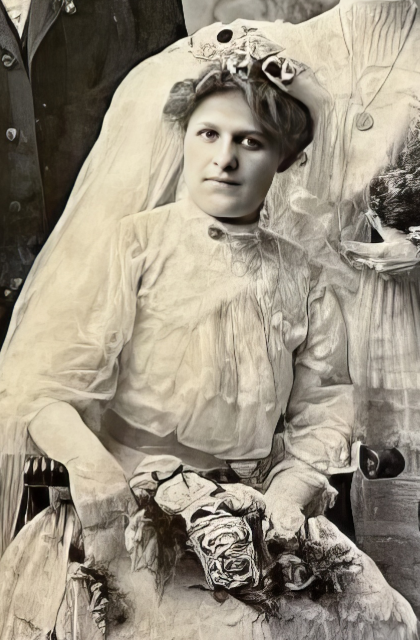

It's always a difficult task to reliably identify someone from photographs when they aren't marked in any way. You can come up with some good theories, but ultimately there's no tool to determine relatedness in images.
In this case we have a known couple at their marriage, John Walter Glawe and Anna Gohr, both seated in a sumptuous studio setting that captured the brilliance of the event. Anna Gohr was the eldest daughter of William and Laura Gohr of Chicago. John Walter Glawe was the son of John Glawe and Augusta Lange. Anna had lots of sisters and one brother. John Walter came from a family of eight. It's entirely possible that some of their siblings would be represented in the wedding party. The lady on the right is of particular interest.
“Citation: Digital reproduction of a photograph, front side, collection of Anna Gohr Glawe and Theodore Maynard: John Walter Glawe and Anna Gohr and attendants, wedding portrait, Chicago, Illinois 1906, original photograph from the collection of the owner, scanned in 2023, accessed 8 January 2025.
The lady at the right-hand side of the full photo (see below) has a distinct facial resemblance to the bride, and indeed to at least one other sister's portrait from around this time (see the c. 1908 portrait of Anna's younger sister Hertha Gohr, later Bertha Bruns). Anna had a twin, Wilhelmine, known as Minnie, but Minnie was deaf and non-verbal and was generally not included in formal photo sessions around this time. Another younger sister, Caroline Gohr Collins, had been married in 1904. We have no known photos of her, but it's possible that the lady on the right of the full portrait is Carrie.
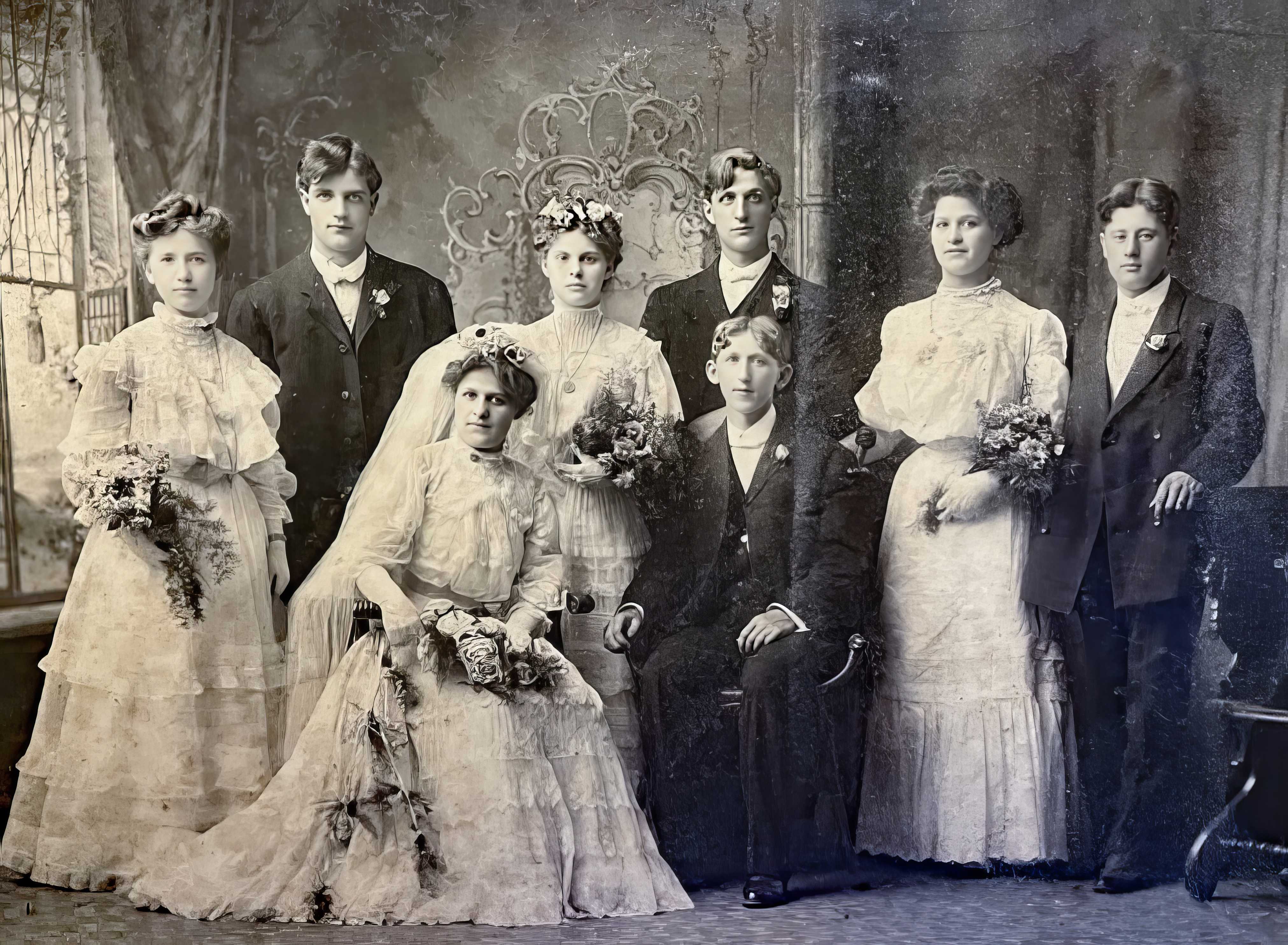
If this is correct, does it mean that the gentleman next to her might be her husband Edward Collins? Not necessarily but it's possible -- we don't know what he looks like either. The rest of the party may have also included Glawe relatives and friends.
The original photo from this event is encased in an elaborate golden frame and carefully matted by A. Heinemann Studios on South Ashland Avenue, a well-known wedding photographer who was still working well into the 1920s. The framing is delicate and I've been reluctant to open up the back to see whether there was any written identification on the back of the print. It's unlikely that there was -- the photographer wouldn't have likely known who was in the wedding party. So for now we'll have to go on family resemblances and suppose that this very well could be the only view of Carrie Gohr Collins that we'll ever have...unless we run into her descendants with a cache of photos that they'd like to share.
8 January 2025 | Email your comment.
DNA strikes again

In a good way! While we've had this photo in our collection for several years, we haven't always had information on the children of Peter Hansen Petersen and his wife Anna Johansen. A recent DNA match, revealing a new third cousin, has cleared up the story of at least one person from this family: the little girl on the right, Katherine Petersen.
“Citation: Public Member Trees, database, Ancestry.com (http://www.ancestry.com : accessed 29 October 2022), “Peter Hans Petersen (Pedersen)” family tree by Thomas Petersen, profile for Peter Hansen Petersen (1860-1945, d. Mason City, Nebraska) undocumented photo shared by Tina Petersen and updated March 2016.
Katherine was born in Florence, Nebraska in 1890. She had six siblings, some of whom were named after her father's siblings. Katherine certainly was, most likely after her aunt Catherina Petersen, who with her husband Hans Petersen had recentlty left Nebraska for Chicago. Catherina was Peter Hansen Petersen's younger sister and my great-grandmother.
The young Katherine was married three times, according to available records: first to William Reising in 1911, with whom she had a child, William; then to William Johansen in 1913 or 1914 (indexes list both years), with whom she had a son called Matthias and a daughter Anna, and then to Roy Leck in 1935. A detailed obituary with survivors listed is available at Find-A-Grave.
It's nice to have the descendants of Katherine Petersen Reising Johansen Leck identified at last.
2 January 2025 | Email your comment.
Wedding mysteries
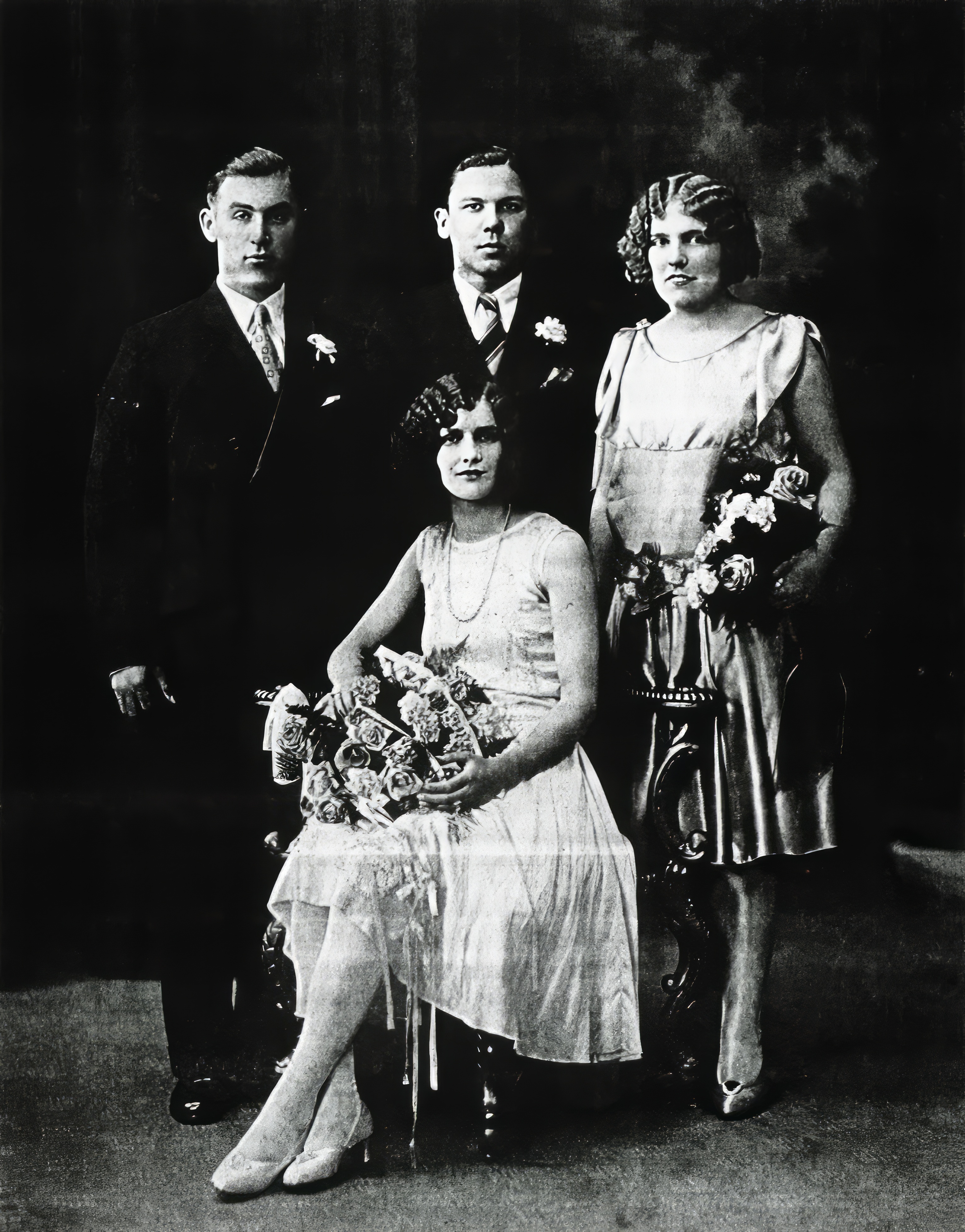
Florence Mikkelsen was my great-grandmother Catherine Petersen Mikkelsen's twelfth and final child, born in 1907 and part of a large blended Petersen/Mikkelsen family. Florence was much involved in the events of her siblings' and cousins' lives, including acting as a maid or matron of honor at this wedding. Florence is at right..
The bride was Florence's niece, technically, although they were born just a year apart. Elizabeth Petersen was the daughter of Louis and Annie Petersen, Florence's half-brother and sister in law. On February 10, 1928 Elizabeth married Stephen Zaher, one of the gentlemen in this photo. The other is unknown but Florence herself married a Louis E. Brown later that year. Was he possibly the best man pictured here?
“Citation: Digital reproduction of a photocopy of a photograph, front side, collection of Cathie Meyer: wedding of Elizabath Petersen and Stephen Zaher with Florence Mikkelsen and unidentified gentleman, Chicago, Illinois 1928, original photograph from the album of the owner, scanned in 2005, accessed 26 Dec 2024.
Louis was a brief member of the Mikkelsen clan. He and Florence married in June 1928 and had a daughter, Catherine Elizabeth, later that year. By the 1930 census Florence is enumerated with her mother Catherine, her daughter Cathie, and is listed as married, but Louis is nowhere to be found. The marriage ended soon afterwards and Florence found a more lasting romance with Walter Breetzke, whom she married in 1934.
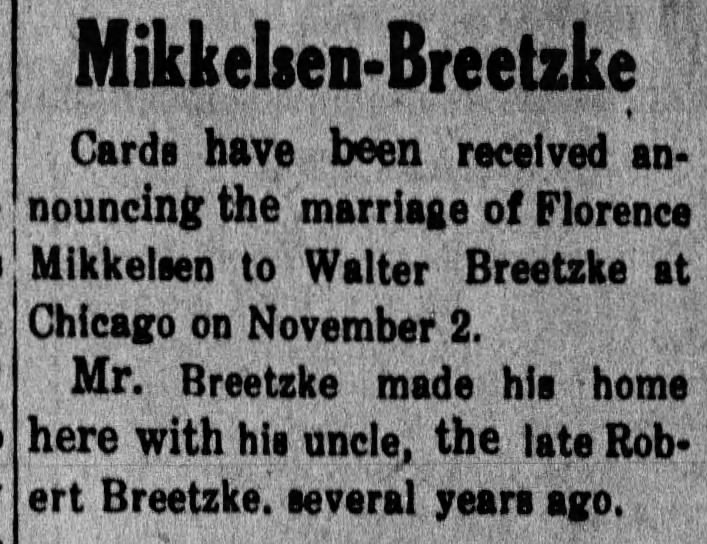
The Breetzkes from the area around Woltersdorf in Pomerania had a string presence in Beemer, Nebraska, where a number of the family settled in the 1870s. Some of the Breetzke clan ended up in Chicago too, and that's where Florence met Walter.
But the local newspaper, the Beemer Times, announced Florence's second marriage using her original maiden name, Mikkelsen, instead of her married name, Brown. Did that have a deeper meaning? Was Florence never actually married to Louis E. Brown? Or was he a figment of her imagination, made up to explain the birth of her daughter in 1928?
I was leaning toward the latter explanation since I couldn't find anything in Ancestry.com documenting the earlier Brown/Mikkelsen marriage, nor could I find Louis in any census records associated with Florence. But finally an alternate source came through: FamilySearch.org, which offers an indexed marriage record for Florence and her first husband. It might be worthwhile to see whether I can order a copy of the actual certificate just to see whether any other information is forthcoming, but this index quells my concerns about whether Louis was real. He may have been ephemeral but he was not imaginary.
26 Dec 2024 | Email your comment.
"I, the schoolmaster Valentin Jatho...."
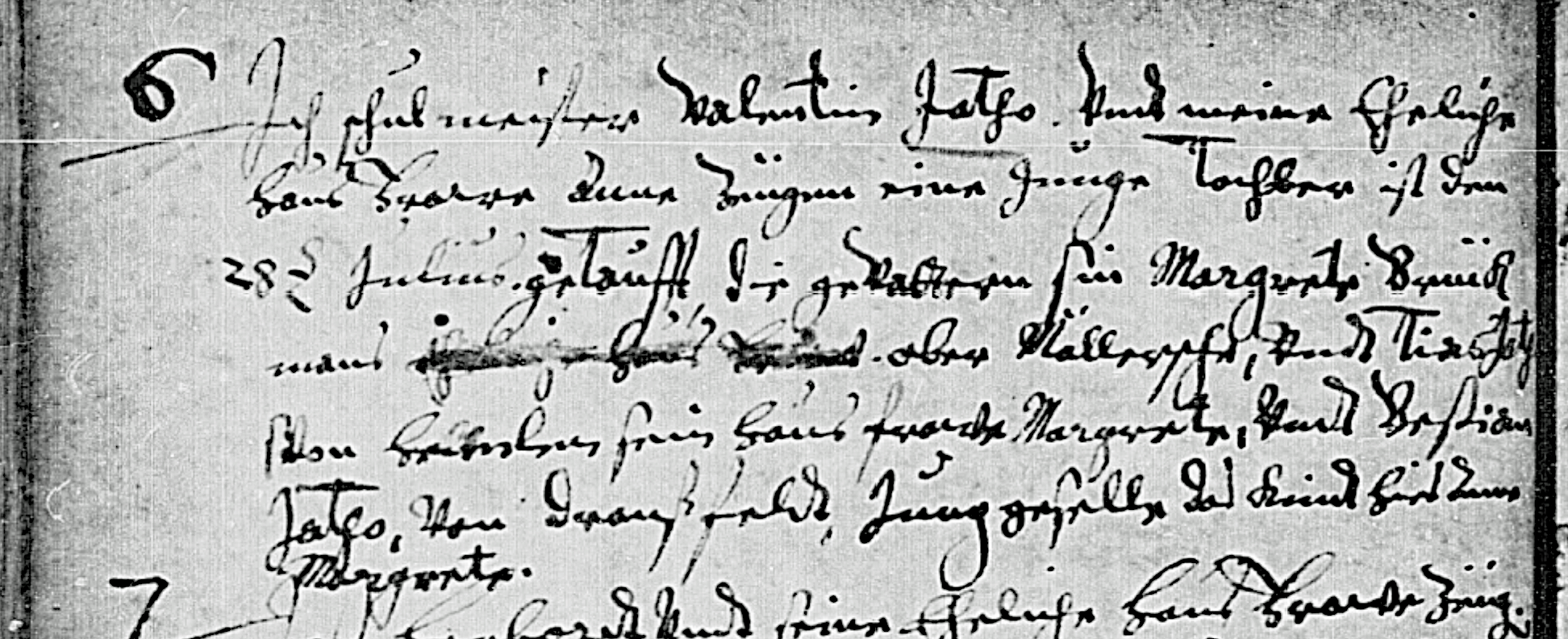
I've marveled many times at the intrepid work of parish clerks, who not only had to enter vital records into local church books, but also had to mix their own ink and cut their own quill pens. As a calligrapher myself I understand those arts. What I didn't expect to see was a record from 1663 in Uschlag, Hannoverische Münden written by my own 8x-great-grandfather.
“Citation: Imaged at Archion.de, online database: https://www.archion.de/p/769ccfbd17/, path: All Archives / Niedersachsen / Landeskirchliches Archiv der Evangelisch-lutherischen Landeskirche Hannovers / Kirchenkreis Münden / Uschlag / Kirchenbuch 1636-1766, baptism for Margrete Jatho, 28 July 1663, accessed 20 Dec 2024.
It begins "Ich Schulmeister Valentin Jatho..." or “I, Schoolmaster Valentin Jatho...” and then follows through with the father's name (Valentin of course), the date and godparents' names, and the child's name, Anna Margreta. It's possible that the mother's name is mentioned (Anna?) although conventionally for the time this wasn't specified. We know for a fact that Valentin had married Anna Schäffer the year before in Uschlag so this makes sense.
Valentin had been married previously to an unknown lady and had three children in the village of Lutterberg near Uschlag. Presumably she died sometime before 1663. Anna Schäffer was Valentin's second of three marriages.
One of the godparents was Margrete, daughter of Hans Christian Jatho of Dransfeld. We don't yet know who Hans Christian was, very likely a relative of Valentin, but it's an interesting bit of information, because the nearby town of Dransfeld was the birthplace of Georg Wilhelm Jatho in 1824. Jathos abound here so the connection goes back well beyond G.W.'s own birth.
Schoolmasters at the time, so our researcher Peter Schräder has told us, were the second-most important people in the town, just behind the pastor himself. In fact, schoolmasters often supplemented their income by handling the church books too. They were literate, had good handwriting (presumably), and were available when needed. Other entries on this page use the same calligraphy so they're probably Valentin's entries too.
To me this is truly an astonishing entry written in my ancestor's own hand, a treasure of unexpected happenstance.
20 Dec 2024 | Email your comment.
Exploring the databases on Nantes
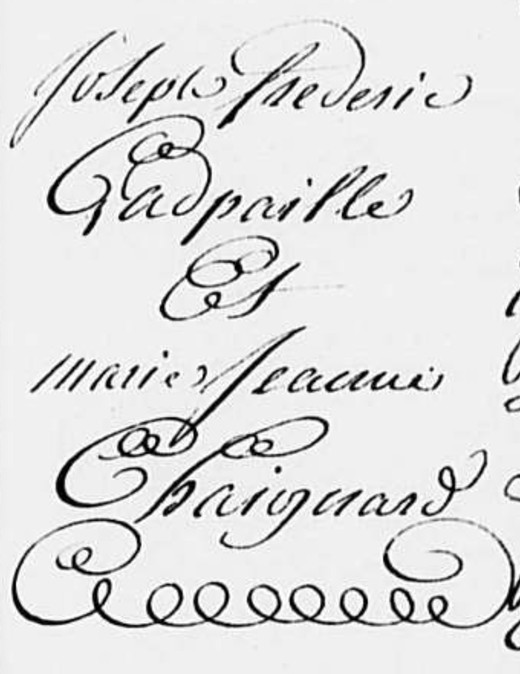
Navigating an entirely new database, especially one so nicely organized, can be a real pleasure. I'd just started looking into the records for my Gadpaille ancestors in New Orleans and Jamaica when I found that they were telling the truth about their origins in France. These origins were centered in the region of Nantes.
“Citation: Nantes, "Département de la Loire Inférieure, Mairie de la Ville de Nantes, Actes de Mariages," database & digital images, https://archives-numerisees.nantes.fr/v2/am441/visualiseur/etatcivil.html?id=451003043 image 39 of 87, accessed 12 Dec 2024.
Neither FamilySearch nor Ancestry has images of these records although the do index some of them. So I posted my discoveries on Blusky (a most remarkable substitute for the devalued and devolving Twitter social media platform) and found a response within hours. A genealogist in Nantes who is familiar with the online records in France told me just how to view them.

This is a marriage record from 1805 between Joseph Frédéric Gadpaille and Marie Jeanne Chaignard. Joseph was born in 1785 and Marie in 1783. By my cursory calculation they had six children, one of whom was Joseph Charles, born in 1819. That combination of names shows up over nad over in records for our Gadpaille relatives in Jamaica and New Orleans, even appearing in children from the New Orleans Jatho line.
Joseph Charles and his wife Lilia Louise Vendryes were in Jamaica when they died in the late nineteenth century, so I'll need to locate some emigration records for them if I can, or at least an indication of when and where they married. Their son, also called Joseph Charles, married Evadne Adelaide Garsia in Kingston, Jamaica in 1883, so that's how the Gadpaille/Garsia line came together. Their daughter Adelaide Lilia Gadpaile married Norwood Jatho in 1917 in New Orleans, and that's where our Jatho/Gadpaille line begins.
I have to say that the Blusky genealogical community has been most helpful during the month that I've been active on that platform, and that alone suggests that if your interests in genealogy are as profound as mine are, it might be useful for anyone in a similar circumstance to check them out.
12 Dec 2024 | Email your comment.
The Garsias of Jamaica have entered the building
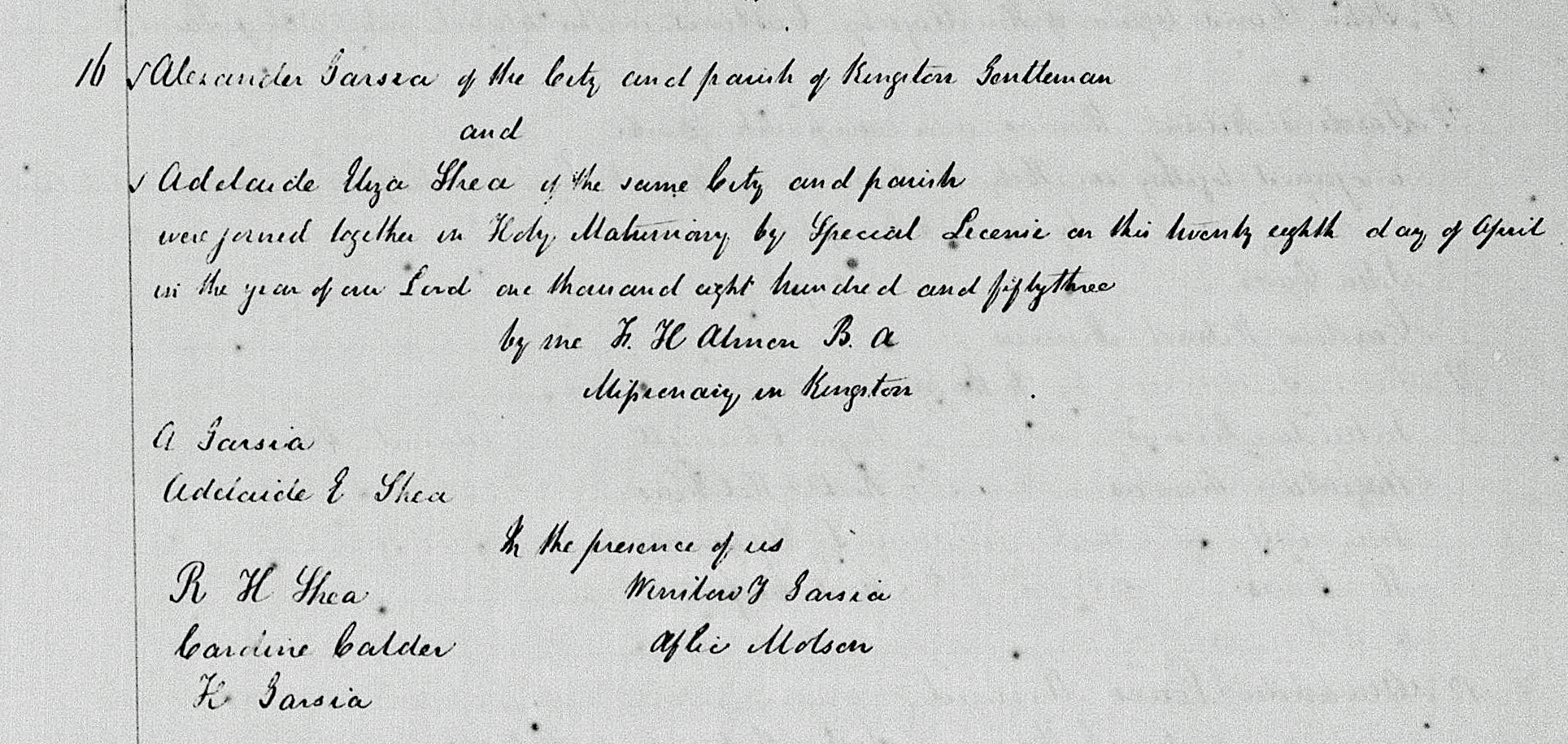
My cousin from New Orleans has Jamaican ancestry, although just how far back he never really knew. Some of their New Orleans records showed the Jamaica origin clearly noted in the U.S. federal census records from the early twentieth century. But how far back did these family connections there go? This marriage record starts us on that journey.
“Citation: "Jamaica records," database & digital image, FamilySearch.org (https://www.familysearch.org/ark:/61903/3:1:939N-JF3H-G?view=index), image 152 of 230; Jamaica, Registrar General's Dept. 004620489, accessed 6 Dec 2024.
In fact, once I started looking at these records it became immediately apparent why certain names were likely to show up in subsequent generations. Adelaide, for instance, appears in the bride's granddaughter's name in 1892. Here the 1853 marriage is between Alexander Garsia or Garcia and Adelaide Eliza Shea. The requirement for noting the special license is a mystery. Everyone on that page required a special license so maybe it was something required in Kingston for people who had citizenship or ancestry elsewhere.
Alexander's background was in Jamaica at least one generation back. His father was Aaron Garsia de Paz, and his mother was Ann Galley, both of whom appear to have been Jamaica natives themselves, but with a twist: Aaron was a well-known surgeon in Kingston, educated at the Royal College of Surgery in London (he's listed there in the roster of 1811). But he was also the son of jewish parents -- a complete surprise to me.
And the healthy list of witnesses to the marriage may help us fill out more of these families' histories. There's at least one Shea, R.H. Shea, and several Garsias. More to research, for certain.
A Record of the Jews in Jamaica written in 1941 by Jacob A.P.M. Andrade includes transcriptions of grave markers that have since been removed as the cemetery was repurposed (a sad circumstance but not so uncommon). For Dr. Aaron Garsia it said: "Sacred to the memory of Doctor Aaron Garsia - Born the 23rd October, 1785; died the 3rd July, 1848. He was a good Samaritan; the poor man's friend; and the sick man's comforter."
That actually holds valuable information and leads us back to his parents, Jacob Garsia de Paz and Esther Brandon. The question of how Jews ended up in Jamaica is one that requires more exploring, but it's fascinating enough at this stage to know about the Garsias of Kingston, and how they eventually fit in to our Gadpaille and Jatho families of New Orleans.
6 Dec 2024 | Email your comment.
A Nebraska surprise
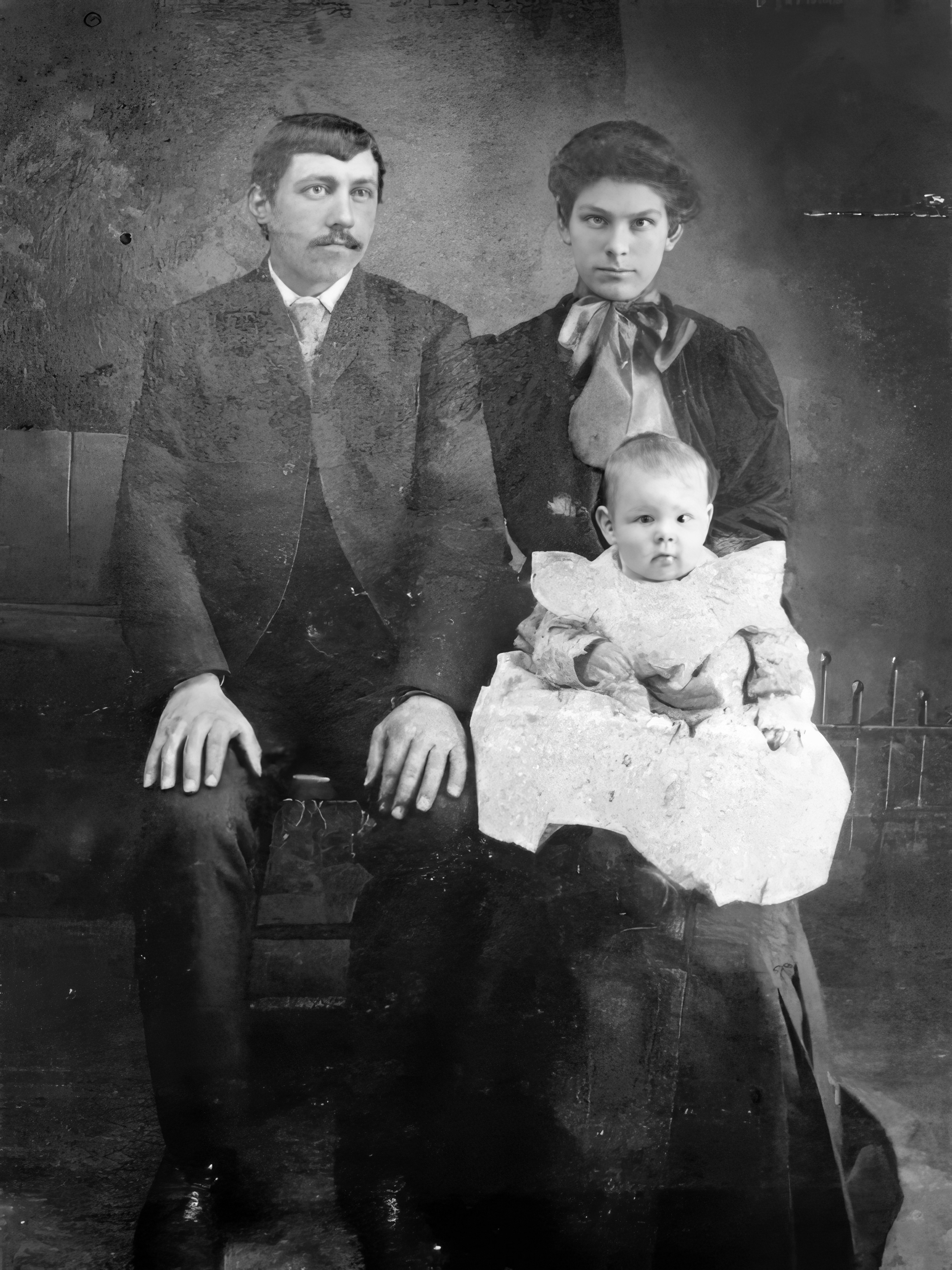
This photo proves that it's always possible to find new genealogical material on the Internet. I happened across this family portrait while searching Ancestry.com for information about Helena (Lena) Petersen, daughter of my ancestors Peter Hansen Petersen and Anna Christina Johansen in Nebraska. I had no idea that this photo existed but I'm glad to have found it.
“Citation: Digital reproduction of a photograph, front side, collection of Liisa Small: Niels Petersen, Lena Petersen, and Margaret Petersen, original photograph shared on Ancestry.com by the owner, accessed 1 Dec 2024.
Peter Hansen Petersen, born in 1860, came from Leck, Schleswig-Holstein with his parents and siblings in 1878 and traveled to Nebraska, where his younger sister Catharina (my great-grandmother) was to marry their first cousin Hans Petersen in November of that year.
Peter married Anna C. Johansen, herself an immigrant, in Friend, Nebraska in September 1887. Together they had seven children, of whom Lena was the eldest. I didn't know much about Lena's adult life and decided to find out more. Good thing I did. Otherwise we'd never have seen this image.
Some descendants of Lena posted it on Ancestry.com and I decided to research who these people were. A Nebraska marriage record turned up in the Ancestry collection "Nebraska, U.S., Select County Marriage Records, 1855-1908" which identified Lena's husband as Niels Petersen, presumably no relation, an immigrant from Denmark whose parents were Peter Petersen and Margaret Jensen. The marriage produced a daughter, Margaret, born in 1905.
The marriage didn't last long. I've been unable to find Lena in the 1910 U.S. federal census but another online tree suggests that Lena married Charles Frederick Stanford in Wisconsin in 1917. I may be able to find a marriage record for Lena and Charles at some point.
Margaret Petersen didn't have a storybook marriage either. In 1923 she married Edgar Aaron Fiscus in Mt. Pleasant, Iowa. A mere four years later Edgar relocated to Idaho where he persuaded a school teacher that he was single, and they married in 1927. Edgar was caught in a bigamous trap, originally claiming that Margaret had divorced him but later admitting that he married again without obtaining a divorce. He was jailed in the state penitentiary for three years as a result, then died in 1933 in a mine cave-in. Such drama!
Lena, meanwhile, led a quiet life with Charles Stanford in Indiana and died in Terre Haute in 1961. But it's wonderful to have her photo to add to our image gallery. I'm always surprised at what our families kept and treasured -- the better for us to treasure them too.
1 Dec 2024 | Email your comment.
Who are those guys?

In this record from 1578 there are two baptisms listed for fellows called Hans Schuchmann. They're not the same person and in fact are distinguished by the essential designations "der Eltern" and "der Junge." Both were active in Niendernhausen (today Fischbachtal near Lichtenberg). With the name Schuchmann it's likely they're related to each other...but how?
“Citation: Imaged at Archion , online database https://www.archion.de/p/d39a28d939/, baptisms in 1578, path: All Archives / Hessen / Zentralarchiv der Evangelischen Kirche in Hessen und Nassau / Dekanat Reinheim / Groß-Bieberau / Taufregister 1576-1679, Trauregister 1576-1679, Beerdigungsregister 1576-1679, Konfirmandenregister 1576-1679 for Philip Schuchmann and Joist Schuchmann, accessed 29 Nov 2024.
Two brothers in one family both named Hans isn't a likely theory. When you see two identical names in a family it usually if not always suggests that an older one died and the second one was named after the departed sibling. That leaves father and son or uncle and son. But here's why I think the latter is more likely than the former.
In German naming conventions -- in fact common to many European societies -- a son is more likely to be named after a grandfather or uncle than a father. If Hans and Hans are uncle and nephew it makes sense that they might be having children during the same year, less so a grandfather and grandson. Linear generational age brackets were predictably about twenty-five to thirty years between generations, but an uncle and nephew could be much closer, depending on the family composition. That's a good argument in favor of Hans and Hans being uncle and nephew.
.In the case of our family we descend from Hans Schuchmann der Junge, the younger, and the naming conventions of the time hold firm. Hans the Younger's son was Philip, and Hans' wife's name was Anna Funck, daughter of Philip Funck -- that's a relationship established in a marriage record from 1576. So this son (maybe their first) is named after the maternal grandfather.
Can we go back further? Of course we can but it depends on how comfortable you feel with non-standard sources. The Niedernhausen church books are preserved from about 1576 onward but not before, and the only way to document someone's existence officially is to use church records, tax rolls (if they exist), or other local documents that may not be online. In Germany some local researchers use an Ahnenliste, an ancestral list of names compiled from sources not available online. How accurate these resources are is anyone's guess.
A fellow called Matthias Stetter has put together a suggested Ahnenliste for Hans Schuchmann the Younger and it suggests that Hans' father was a Leonhard Schuchmann, whose estimated dates range from about 1520 to 1576 or 1577. I've been unable to corroborate the connection to Leonhard because the Niedernhausen church records are too fragmentary. If Hans the Younger had had a child called Leonhard and we could find it, that would be helpful. But no such child turns up in the records.
Leonhard Schuchmann is one of those fellows whose name is found in non-standard records. Mr. Stetter tells is that Leonhard "is mentioned in winery invoices in the Lichtenberg office from 1544 to 1575; he is dead in 1577; he has a wife Barbara." Not sure how the death year is determined, I certainly can't find anything, nor a wife called Barbara. But Ahnenliste fans have shared this information and have even built extensive trees based upon estimated dates and names for Leonhard and his father, allegedly Nikolaus, and grandfather Peter. If we are to accept these trees as gospel, so to speak, we break through the fifteenth-century wall.
Of course we do anyway, even if we can't verify names and dates, but it's very tempting to accept that Hans the Younger had a father Leonhard who had a brother called Hans the Elder, and they both had a father called Nikolaus born in the late 1400s, and Nikolaus had a father called Peter born even earlier. My kingdom for a horse, wailed Richard III. I'd give mine for a reliable sourcebook of Schuchmann ancestors.
29 Nov 2024 | Email your comment.
Gratz to Gatz, Chicago, 1925
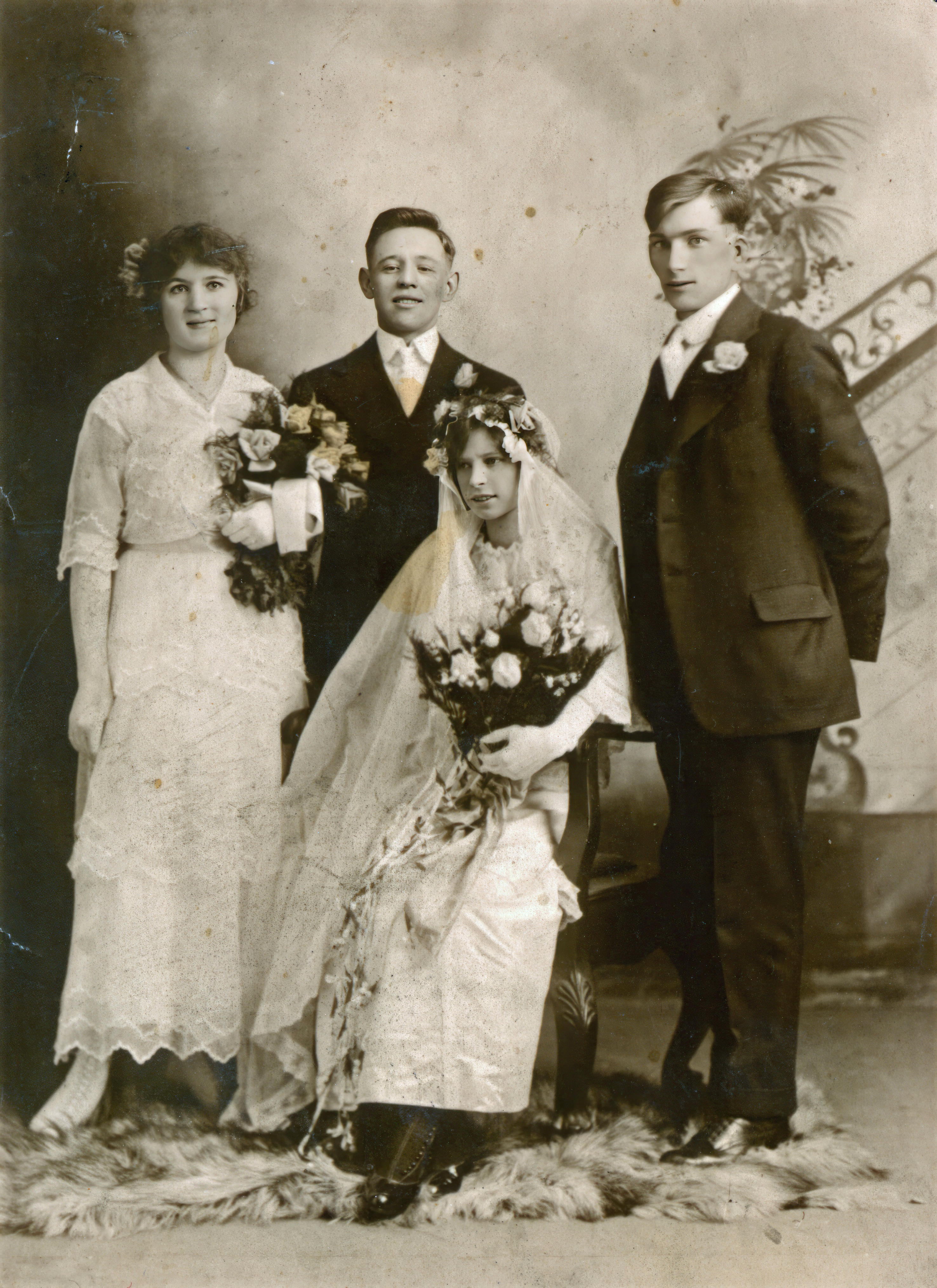
My cousin, who provided this picture, had mentioned that the lovely bride had a visual impairment, perhaps blindness, and that's a reason she didn't look at the camera on her wedding day. She makes a beautiful bride nonetheless.
I'd been interested in identifying the principals in this picture because I thought I recognized her ancestor, Peter Gratz, in the center. He had a kind of self-determined air that was unmistakable, and it turns out I was right. The bride was his sister, Celia Gratz. Accompanied by his wife Sadie Cunningham, Peter posed proudly behind Celia with her new brother-in-law William Henry Gatz on the right.
“Citation: Digital reproduction of a photograph, front side, collection of Judi Jatho Weber: Sadie Cunningham Gratz, Peter Gratz, Celia Gratz Gatz, and William Henry Gatz, 17 Jun 1925 in Chicago, Illinois, original photograph scanned from the collection of the owner, accessed 23 Nov 2024.
Gratz to Gatz could be rather confusing but at least Celia didn't have to change the monogram on her linens! Peter and Celia were the children of cigar maker John Gratz, who emigrated from Germany in 1866 at the age of six, and Elizabeth M.J. Daniels, an immigrant from England. I couldn't find any indication of Celia's disability in any of the U.S. federal census records over the years but she and William seemed to share a normal life in Chicago and had two children, William and Dolores.
Perusing my cousin's collection of Gratz photos should be easier after this and I'm hoping to identify more as time goes on. It's always helpful to attach names to images.
23 Nov 2024 | Email your comment.
Though she be but little, she is fierce!
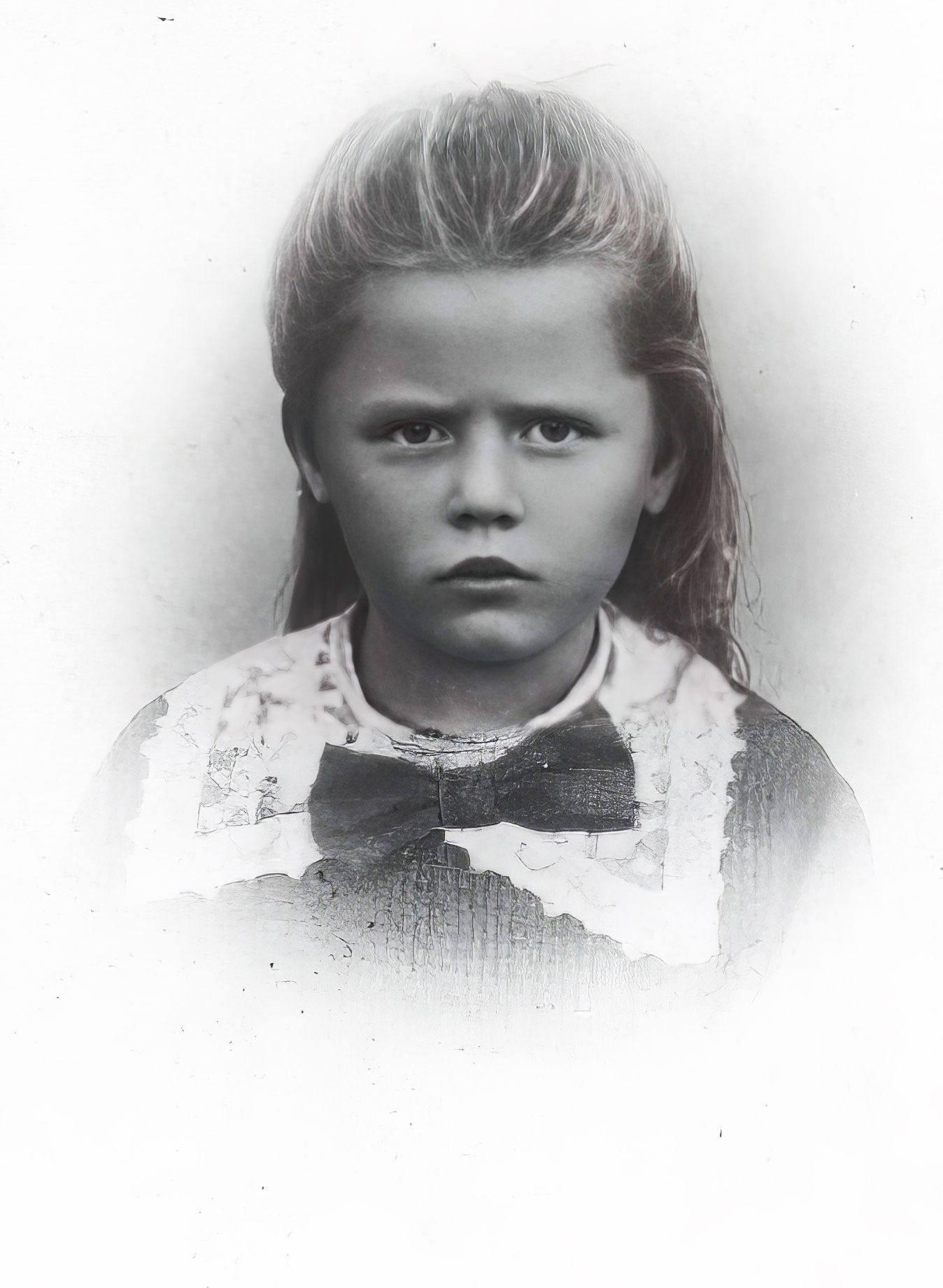
People didn't smile much for photos in olden days. Whether it had to do with longer exposure times or the antiquated idea that people who smiled were not bright, it affected the way people behaved in the photography studios at the time. Babies and toddlers often smiled in spite of themselves. There's plenty of evidence for that in our photo gallery.
Our subject today is Luise Petersen, daughter of Matthias Petersen and his wife Esther Möller Petersen in Dithmarschen, Sch;eswig-Holstein. Luise, one of seven children born to the couple, lived a very short time, from 1907 to 1914, but she definitely makes an impression in this portrait.
“Citation: Digital reproduction of a photograph, front side, collection of Mario Petersen: Luise Petersen, Dithmarschen, Schleswig-Holstein c. 1914, original photograph scanned from the album of the owner, accessed 12 Nov 2024.
Luise's five older siblings were also from Schleswig, although baptism records can only be found for the first four: Helene Marie, Botilla, Fritz Peter, and Hans Adolph. They were baptized in nearby Karlum. But starting with Fanny, Luise, and Anna, it's unclear which parish the parents attended for the younger children's baptisms. Family details suggest that it was the parish of Marne but Luise certainly wasn't found there, which is a shame.
The other children grew to adulthood and had families of their own but little Luise is known to us only for this stern but strong expression.
12 Nov 2024 | Email your comment.
No "scarlet letter" here
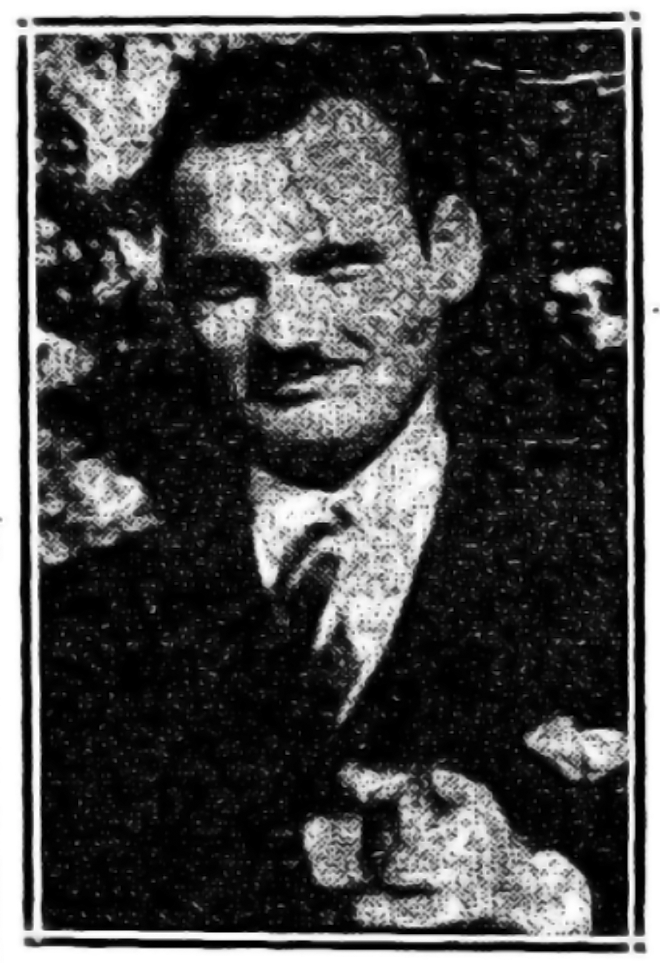
How did we end up with such a colorful character in our ancestry? I thought the Jatho clan had that category all sewn up, but then George A. Dressel (shown at right) stepped into the picture.
George was one of two sons of Frederick Dressel, a preeminent florist and collector of exotic orchids and ferns in Weehawken Heights, New Jersey, and his wife Emma Schmidt. Frederick was a scion (no pun intended) of our Dressel clan. George, born in 1897, was apprenticed to his father and made one crossing back to Frederick's homeland in Germany, presumably to study his father's trade. George had married Florence Kingsmore in 1917 and when that marriage soured he found romance with Ruth Otten Robertson, whose own marriage was about to end. George and Ruth were married in 1925 but it wasn't long before there was trouble in paradise.
“Citation: Genealogybank.com, online database, The Jersey Journal, Friday, May 20, 1932, Jersey City, New Jersey, page 2, photo and article obout George A. Dressel, accessed 2 Nov 2024.
You can read details of George's divorce suit against Ruth here. For most of 1932 the salacious stories enraptured New Jersey newspapers: how George and Ruth lived together before marriage because (as Ruth testified) she was "naive"; how George allegedly hired a bootlegger friend to be a pretend correspondent and then neglected to pay his friend for the service; how Ruth detailed their contentious life together; and how the bootlegger called George's lawyer a liar in court.
While this was going on, Ancestry.com records reveal that in 1931 George and a woman called Emily (listed on the ship manifest as Emily Dressel, although no marriage has been found for them) sailed on a trip to and from Havana, Cuba. Clearly George wasn't inclined to forego pleasure while his second marriage was on the rocks. In fact in one news story Ruth Dressel mentioned a woman called Emily who she felt was canoodling with her husband.
It wasn't a pretty picture. Neither is the one at the top of this post, although it's all we have of George, alas.
Eventually the divorce was granted. George abandoned the florist/nursery trade and became a car dealer for a time, but by the late 1930s he was involved in suits against those he felt had wronged him, including one for $25,000 damages involving a car crash.
Things quieted down in the 1940s. George found love (or something akin to it) with Louise M. Hatt, the daughter of James F. Hatt and Johanna H. Kollert, both from New Jersey. No record is found for a marriage between George Dressel and Louise Hatt, which may exist somewhere in the New Jersey archives. But they did have two children, Patricia Louise, born in 1941, and George A. Dressel Junior, born in 1947.
George's controversial life came to a quiet end when died on August 28, 1950. Louise Hatt appears in the New Jersey press after that time as Mrs. Louise Bach, usually mentioned as a plaintiff in various lawsuits alleging that her German shepherd dog attacked various people.
Her children appeared in the press as well. Young George Junior, a student of Eastern religions, according to his sister, went missing briefly in 1970 while in the midst of signing up for the draft, but he was found and resumed a more pacific existence. Patricia, a talented drama student at Wesleyan College, married a Grant Carroll in 1963 whose mother was a Mrs. William VanDevere. As Trish VanDevere Patricia made a career for herself on stage and in films, and after a divorce from Grant Caroll Patricia married the renowned actor George C. Scott. This is our family's closest brush with fame, according to available evidence, although there's still plenty of time for more memorable stories to emerge.
2 Nov 2024 | Email your comment.
A ring around Rose
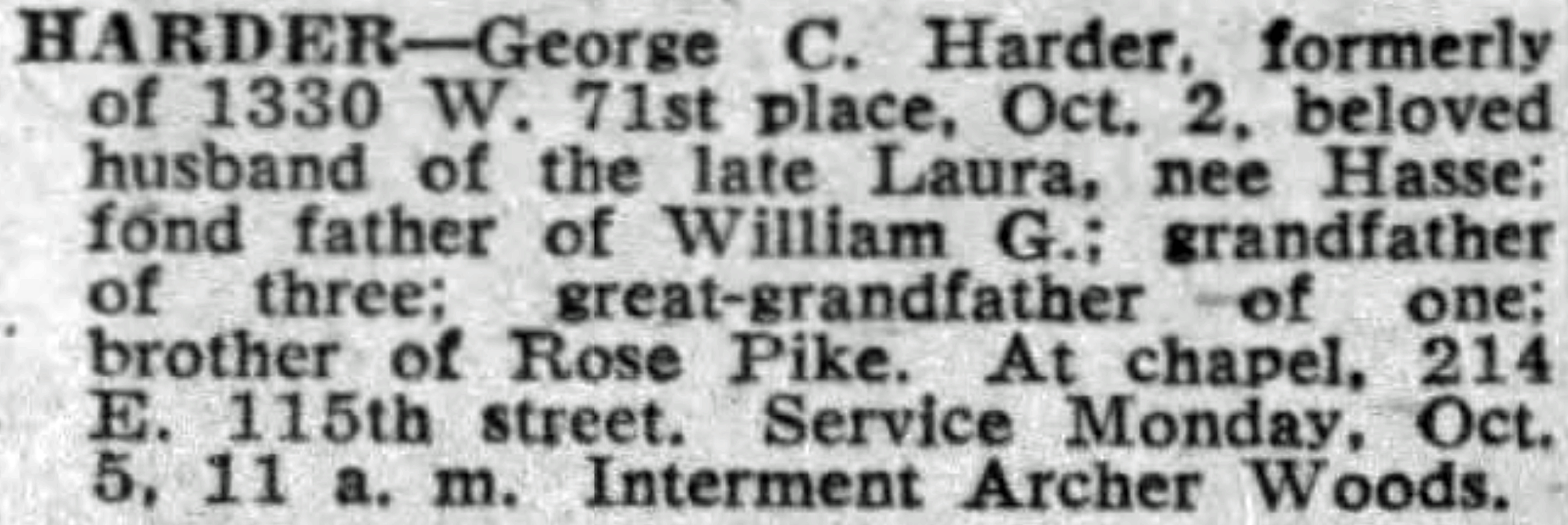
George Harder is a bit peripheral to our family, but I'm always bothered when I know someone's name and can't verify his or her parents to include them my database. Even if they're in-laws, the story deserves to be documented and told, as much as we can assemble the facts.
What we do know is that George Harder, who was born in 1873 in Chicago, was married briefly to our ancestor Laura Hasse, daughter of Carl or Charles Hasse and Augusta Kramp Hasse. Laura was born in Hygendorf, Kreis Stolp. Pomerania in 1876 and made the voyage over to Chicago in 1881 with her mother Augusta, aunt Laura Kramp, and brother Emil, joining their father Carl who was already in Chicago.
George Harder and Laura Hasse married in October 1895 in Chicago when he was 21 and she was 19. Their first and only child, William, had been born about a week before. Perhaps there was some reluctance to marry, or possibly some family objection, but it did occur in Cook County, finally, and George lived with his wife's family in Chicago, as the 1900 U.S. federal census tells us. Laura Hasse Harder died in 1903 and was buried in the Gohr family plot at Concordia Cemetery in Chicago.
“Citation: Newspapers.com, online database, Chicago Tribune, Sunday, Oct 04, 1959, page 98, obituary for George C. Harder, accessed 23 Oct 2024.
George continued to reside with the extended Hasse family for the next several decades and lived to the hearty age of 84. His 1959 obituary gives us the first clue about his birth family, which until now we didn't know at all. But now we have the first indication of a sister, listed in the Chicago Tribune as Rose Pike. It's a start because without knowing something about his family members we run the risk of associating him with several other George Harder fellows, all of whom were born in 1873 but not in Illinois. It's essential to get the right family, and at first the census records weren't being helpful.
One of the difficulties was finding George (born 1873) and Rose (born who knows when) in the same family. This constellation wasn't revealing itself in the 1880 census, and there was no 1890 U.S. census to help us. George was married in 1895 so he wasn't with his birth family in the 1900 census.
Looking for a Rose Pike whose maiden name was Harder also wasn't turning up any candidates. Was Pike a misspelling of her surname? There's a Cook County marriage in 1909 for a Rose C. Harder married to a fellow called Piske. Any chance that might be it?
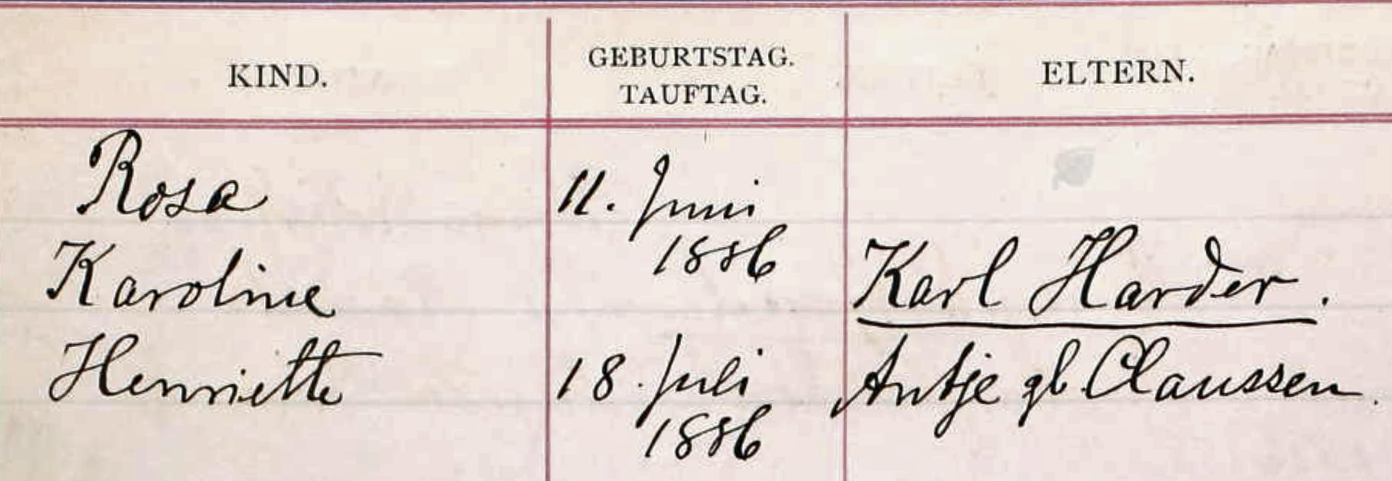
Circling back through the 1880 census records there was a George Harder living with a father called Charles and a mother called Anna, and he was about the right age to be our George. There were siblings too: Andrew, Dora, and Anna...but no Rose.
So did a Charles/Chas/Carl Harder and his wife Anna have a child called Rose at any point? It appears they did, Rosa Karoline Henriette Harder, born in 1886 and listed via Ancestrylibrary.com in the "Missouri Synod, U.S., Lutheran Church records, 1851-1973" collection, where the parents are listed as Karl Harder and Antje (a version of Anna) Claussen. That's beginning to look hopeful. Our possible George in the 1880 census had parents called Charles and Anna.
What about the other children in the 1880 census? Andrew, Dora, and Anna appear in the Missouri Synod collection as well with the same parents, and having the mother's surname, Claussen, spelled out is helpful. In fact, two folks from Germany were married in Cook County in 1870 sporting very similar surnames: Karl Harder, born in 1843 in Lotz, Prussia, and Anna Claus (close enough!) from Erfde, Holstein ("Illinois Marriages, 1815-1935," database, FamilySearch (https://familysearch.org/ark:/61903/1:1:HS6M-1CZM : 23 Oct 2024), Karl Harder, 1870.) If we want to research them further, having their towns of origin will be very useful.
Then even more exciting is a birth index for an unnamed child with the surname Harder, born in 1873 to Charles Harder and Anna Clouzon (must be a mis-transcription) on the exact date -- 15 December 1873 -- that we have for our George Harder (from "Cook County, Illinois, U.S., Birth Certificates Index, 1871-1922" via Ancestrylibrary.com). George's birthdate is available from his WWI registration. There we go: George Harder's family is in place, at last. His parents had nine children total, seven still living by the time of the 1900 census. And with Antje's surname and month/year of birth, we can find her in the baptism records for Erfde, Holstein. It's always fun to move back another generation.
23 Oct 2024 | Email your comment.
Keep away from the fellow who owns an automobile

It's not a database I expected to see but it's a window into the past, nevertheless. Ancestry has a limited list of early automobile registrations from Florida, where we happened to have an ancestor living. And it turns out he was partial to the Maxwell model.
“Citation: Ancestrylibrary.com, "Florida, US, Early Auto Registrations, 1905-1917," 17 March 1913, registration number 7744 for C.j. Jatho, Ancestrylibrary Operations, Inc., accessed 17 Oct 2024.
Carl Julius Jatho was a native of Charleston, South Carolina but by the early 1900s had been living and working in various cities in Florida: Tampa, Gainesville, Winter Park, where he listed himself as a salesperson for Colgate and worked as a bookkeeper for various automotive concerns. Here we get a look at this motor vehicle of choice, a 12-horsepower two cylinder Maxwell Runabout, which at the time retailed for about $350.

It would have made it easy for him to maneuver from city to city as required by his job. He appears frequently in the local press of the time, usually listed as a businessman visiting various hotels during his travels. C.J. was married to fellow Charlestonian Mary Elizabeth Linn at the time and is listed with her father James Betts Linn in the 1910 U.S. federal census.
Sometime around the middle of the decade the marriage ended. Mary and her father returned to Charleston while C.J. remained in Florida, taking a new wife, Mary Smoot, where they settled and had three children. C.J. died in 1929, leaving his family in Bartow and Polk counties. No one knows what happened to the Maxwell.
The title of this entry, by the say, is the name of an Irving Berlin song published in 1912. He must have known a thing or two about automobile travel as well.
17 Oct 2024 | Email your comment.
Families that play together
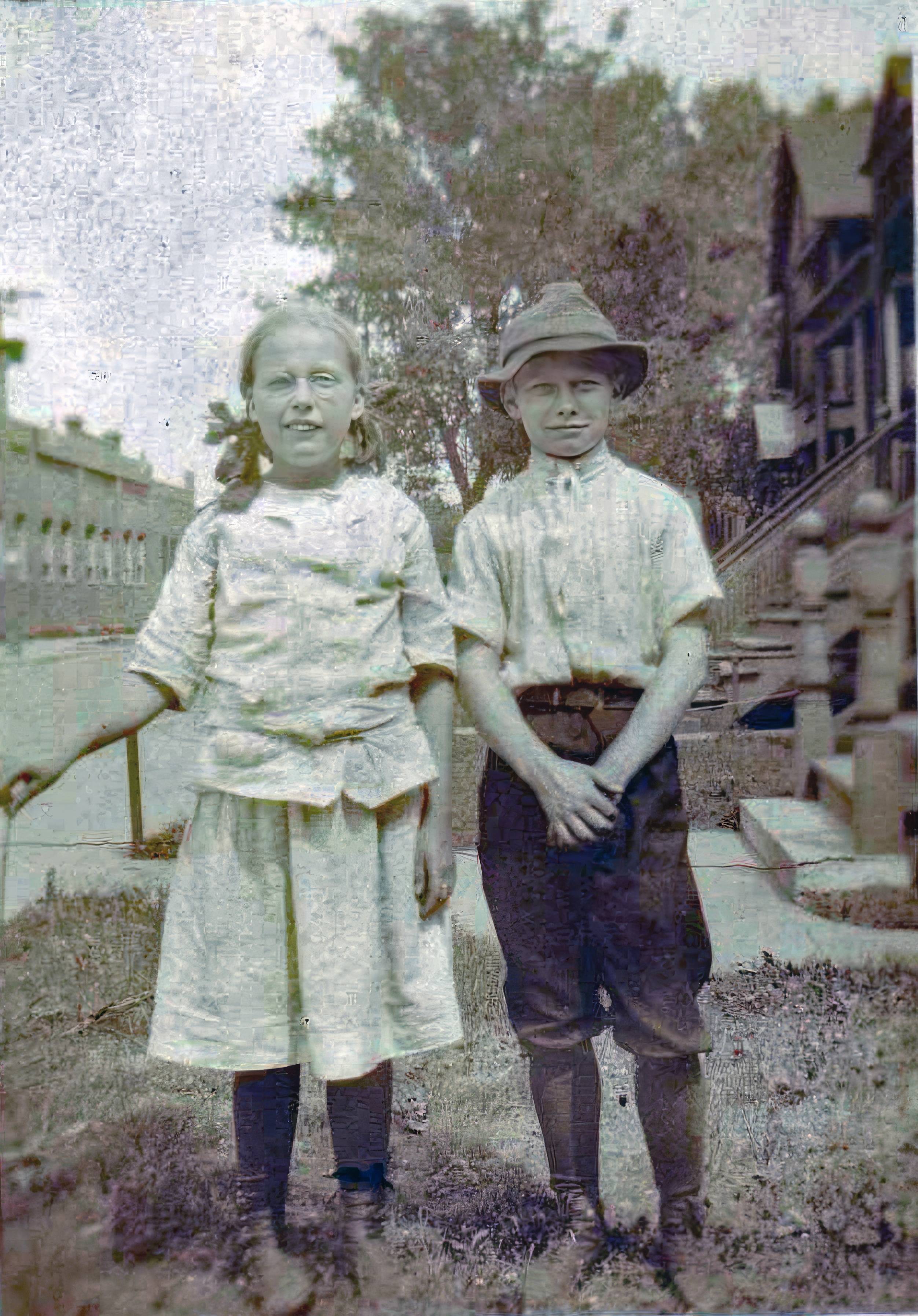
When I go through the Archion.de records for Nordfriesland in towns like Ladelund and Leck I'm always amazed at how many ancestors I end up finding, like the story of baby Thomas Mikkelsen below.
Our Petersens and Mikkelsens all lived in adjacent villages and without a doubt knew each other. In the case of Thomas and his first wife, Helene Sievertsen Mikkelsen there was a family connection as well. Helene's mother was Anna Catharina Botilla Petersen. Some years later, after Thomas and Helene divorced, Thomas married Anna's niece, Catharina Petersen.
These two children, photographed one pleasant day on Loomis Street in Chicago, were half-siblings as well as cousins in a roundabout way. Florence, at left, was the only daughter of Thomas and Catharina, born in 1907. Clarence Petersen, at right, was Florence's half-brother, born in 1904.
“Citation: Digital reproduction of a photograph, front side, collection of Cathie Meyer: Florence Mikkelsen and Clarence Petersen, Chicago, Illinois c. 1916, original photograph from the album of the owner, scanned in 2005, accessed 4 Oct 2024.
In Chicago this pair grew up together. Clarence was born a year before the death of his father, Hans Petersen, so he never knew him properly. Thomas Mikkelsen, who married Catharina in 1906, was the only father Clarence knew. And of course Florence had both parents in her family until she was fourteen, when Thomas died at age 70.
Both children grew up in Chicago in the blended family, which also consisted of Clarence's older Petersen siblings. Until the mid-1940s the families stayed in regular contact, and even after the Petersen brothers (Alfred/Alva, George, and Clarence) scattered to the western United States, Florence was close to her half-sister Marie Petersen, as well as to Thomas' older children from his first marriage.
4 Oct 2024 | Email your comment.
A missing child: missing no longer

Until my father was born in Chicago in 1916 there appeared to be no child named Thomas after Thomas Mikkelsen (1850-1921), but this record sugests otherwise.
Thomas Mikkelsen, the son of Niels Michelsen and his wife Anna Sofia Sörensen, emigrated to Chicago in 1887 with his wife Helene Sievertsen and their five children. But Helene and the children didn't stay very long and returned to Flensburg, while Thomas remained in Chicago. Eventually four of the five children returned to Chicago and Helene, who divorced Thomas, remained in Flensburg. Thomas, too, restructured his life and married twice more. But this record suggests that he left a deceased namesake in Nordfiesland.
“Citation: Imaged at Archion (https://www.archion.de/p/33f7dec58a/ : 20 Sep 2024), 1869 baptism record for Thomas Mikkelsenl, path: All Archives / Schleswig-Holstein / Landeskirchliches Archiv der Evangelisch-Lutherischen Kirche in Norddeutschland / Kirchenkreis Nordfriesland / Leck / Taufen 1855-1878 Image 110 via https://www.archion.de/, accessed 20 Sep 2024.
This was something of a surprise. Thomas was only nineteen when this baby was born to Anna Margaretha Nommensen, daughter of Johann Nommensen of Stadum and I could find no marriage or betrothal record for the couple. Stadum was about 18 kilometers from Osterby, where Thomas lived with his parents and where had been confirmed at age sixteen just a few years before. Baby Thomas himself didn't survive long, as the marginal notation tells us, dying at the age of eight months.
Perhaps there was a family objection to a marriage.Nineteen was early for men to marry in Nordfriesland at this time. They were usually precluded from marriage until they'd reached majority and had a proper job to support a family. So we don't know exactly the circumstances of this early and brief relationship, only that the parish records duly recorded the brief life of baby Thomas and his godparents, all of whom were from Stadum and were probably associated in some way with the child's mother.
It's a sad and beautiful world -- sad when any child dies at such a young age but beautiful to have his brief appearance commemorated here.
20 Sep 2024 | Email your comment.
Getting creative with old Danish records
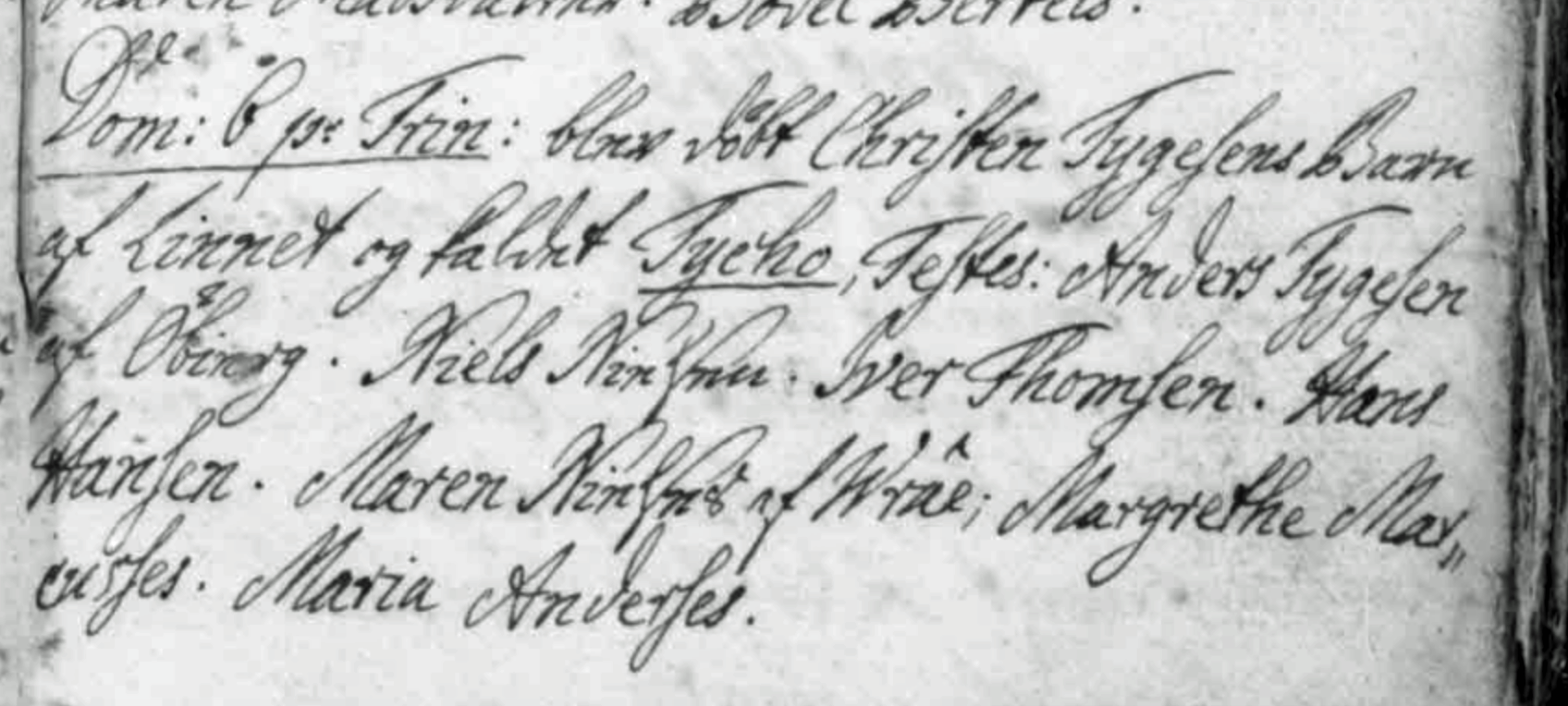
We've visited here before and it's a sad case: the church records we need to further investigate my earliest paternal Danish line are just not there. They skip from 1679 to 1729, and the gentleman I'm looking for -- my 6x-great-grandfather Christen Tygesen -- was born sometime between 1700 and 1710. So we can't know for certain who his parents were.
What we know: his birth name was Christen or Christian, so probably named after someone with that name. His father was Tycho or Tygge because his patronym makes that clear. Christen, who married in 1736 in his bride Magrete Hansdatter's parist of Øster Lindet, was from the nearby town of Øbjerg in Arrild parish. Their marriage record gives no more information than that. No indication of their ages, parents' names (other than what we can glean from their patronyms), and no witnesses to the marriage, which might have helped.
So we turn to the godparents' names on the baptism records for their children.
“Citation: Imaged at Arkivalier Online (https://www.sa.dk/ao-soegesider/da/billedviser?epid=17217530#203054,38510559 : 25 August 2024), 1744 baptism record for Tycho Christiansen, path: Rigsarkivet/Archives online / Church records from all over the country / County: Haderslev county / File: Øster Lindet parish / Main ministerial book (1735 - 2003) / Image 13/186, accessed 25 August 2024.
The best clues come from their sons' baptism records. Their first two sons were born in 1739 and 1744 respectively. The first, Hans Christian, was presumably named after the mother's father (she's Hansdatter so her father was called Hans Somebody). The second, Tycho, was clearly named after his paternal grandfather. And wonder of wonders, one of the godparents was an Anders Tygesen from Øbjerg. This is likely the father's brother, so the child's uncle.
This helps a little but not much. Anders himself married in Øbjerg in 1741 and died in 1745 at the age of 27 1/2, putting his birthdate at around 1718. It's possible that he was a much younger brother of Christen but we can't find his baptism either. From the look of those scanned records before the Great Disappearance there's a noticeable amount of water damage to the pages, so something like a flood probably occurred and carried off the fragile records.

At some point the Danish archives decided to create a modern-day typescript index to these Øster Lindet records, and this resource is worth a look, because it gives us a little more information about Christen Tygesen...not much but a snippet. The only record it notes for him was his 20 January 1736 marriage to Magrete Hansdatter, but it also notes the variations of patronym spellings in the records (spelling was more or less fluid until the early 20th century): "Tøgersen, Thøggersen, Tychsen. Tygesen, etc." as they indicate, so his patronym could be spelled any of these ways. Also interesting: he was sometimes referred to (where? Maybe in records the indexers had access to but we don't) as "Christen Tøgesen Øberg," surely a parish clarification of his town of origin.
The Arrild parish records also have a typed index of surnames and entries. A future research project could involve creating a map of everyone recorded in this index from Øbjerg who shares a patronym with Christen to see whether we can put together a list of possible relatives. There may be no way to confirm any connections, but it doesn't hurt to try. It might lead to information that we can use with other records, if they ever come to light.
25 Aug 2024 | Email your comment.
A death in Darmstadt 1855

Until recently I didn't bother to research much about the life of my 4x-great-grandmother Elisabetha Mess, who married Johann Philipp Dressel in 1811. One of the difficulties was that I couldn't find out much about her father (still can't as a matter of fact). He was Johannes Mess, a soldier, and that's all we know about him, no wife, no other children. So it was rather a dead end, and still is, going backward. But going forward there's a little more to learn.
“Citation: Imaged at Archion (https://www.archion.de/p/146b756ba3/ : 14 August 2024), 1855 death record for Anna Elisabetha Dressel, path: All Archives / Hessen / Zentralarchiv der Evangelischen Kirche in Hessen und Nassau / Dekanat Darmstadt-Stadt / Darmstadt / Beerdigungsregister 1847-1855 Image 400 via https://www.archion.de/, accessed 14 August 2024.
My interest was piqued because of a recurring DNA match with another descendant of Anna Elisabetha and it occurred to me that I should really look into her life a little more closely. Her early years did have some drama. Her marriage to Johann Philipp Dressel was delayed by a year because the groom's father objected to the marriage, on what grounds it's hard to say. Nevertheless she and Johann Philipp had their first child in 1810 in Darmstadt and were not only unable to marry but could not baptize the child, either.
After a year and a petition to "the Konsistorium," an official entity of some kind, the baptism and marriage took place in 1811. At that point we can see her deceased father's name, the fact that she was one of three daughters born to Johannes Mess, and that the groom's father Heinrich Philipp Dressel, a prominent master butcher, was still not involved as a witness or godparent to their first child.
Johann Philipp and Elisabetha had six children all together from 1810 through 1822. The marriage record helpfully indicated in a marginal note that Johann Philipp died in 1842 and Elisabetha died in 1855, so I thought it was worthwhile to look up her death record in case there was anything interesting in it. And there was -- see the image above.
Elisabetha Dressel was 67 years old, 10 months, and 12 days old when she died, so that allows us to determine her birthdate as 28 February 1787. She was born in a military compound ("Militargemeinde") presumably where her soldier father was stationed. Darmstadt kept those records separate from the main Lutheran records, and unfortunately they're not yet digitized and online, so we can't look up her birth record to see who her mother was. The death entry says that she "left children" but it doesn't name them. We know their names and that two of them had already emigrated to America.
Interestingly in addition to the priest's signature at the right side of the entry, the grave diggers Schaller and Winter also signed the book on the left, an interesting addition to the story. Were her children not present at her burial? Or was this merely a formal requirement of burials at this time?
Whatever the circumstance, I'm looking forward to finding out more about Elisabetha, perhaps when those missing military records are released. It would be nice to fill in more of her story.
14 Aug 2024 | Email your comment.
Plenty of surnames for all

Somehow I missed this record the last time I was exploring Bruns/Grave/Oldhues ancestry, maybe because I was new to Matricula Online and was too excited to find records back this far and was focusing on Bruns rather than Oldhues.
Several generations down the line Fridericus Andreas Bruns would marry the decendant of this couple, Anna Catharina Oldhues. Back in the 1600s though there was some uncertainty about the spelling of the Oldhues surname, which could be Aldenhus (and that tells us something about the derivation of the surname, probably something to do with the place on the farm where this family originated when surnames were established).
“Citation: Matricula Online (https://data.matricula-online.eu/en/deutschland/vechta/emstek-st-margaretha/KB01_02/?pg=6 : 5 Aug 2024), betrothal for Henrich Oldhues and Anna Meyers, path: Startpage Deutschland Vechta, r.k. Offizialatsarchiv Emstek, St. Margaretha Trauungen | KB01_02 via https://data.matricula-online.eu/en/ accessed 5 Aug 2024.
This is a betrothal between Henrich Oldhues and Anna Meyers, by my calculation my eighth great-grandparents. It was the last one in 1672 in the parish of Emsteck. The notation “sponsalibus veronciliati conjuges facti” in record means “betrothed to be married.” At this point the records were as likely to be in Latin as in German, and sometimes the protocols of the parish mixed the two.
At this early stage the parish clerk was cutting his own quill pens and mixing his own ink, so we're fortunate that he had a good calligraphic hand and that the ink had the staying power to last all these centuries. Beautiful handwriting makes a difference when examining records of this antiquity. You find yourself appreciating the technique it took to produce good penmanship. A clerk like this was worth his weight in gold.
5 Aug 2024 | Email your comment.
New region: Vorpommern

Ancestry and Ancestrylibrary have lately been very generous with their relatively new collection "Missouri Synod, U.S., Lutheran Church records," which includes records from all over the midwest and eastern U.S., not just Missouri, where the Synod collected a variety of Lutheran baptism, marriage, and death records. Some of our Gohr families were part of these parishes in and around Chicago in the nineteenth and early twentieth centuries. How fortunate for us -- we can find out details that might otherwise be unavailable without a visit to the Synod headquarters.
“Citation: Ancestrylibrary.com, "Missouri Synod, U.S., Lutheran Church records," 1851-1972 for Friedrich Ebert, Saint Matthew Lutheran Church, 1880-1926, Burials: Ancestry.com Operations, Inc., accessed 27 July 2024.
In this case we have a new area to research, Vorpommern, an area of West Pomerania in the north of the German region. Ella Gohr, my grandmother's sister, married Chicago-born William Charles Schultz in 1909. Her in-laws Karl Schulz and Maria Ebert had emigrated in 1866 to Chicago. To complete the family Maria's father also joined them in 1868, where he lived until his 1901 death, as the record above shows, leaving his son-in-law Karl Schultz, one son and three daughters..
The difficulty with this record is trying to read it through the scratched-out clerical correction. It took some sleuthing to figure it out. In fact it required looking at karl Schultz' death record in this same collection to get a clue.
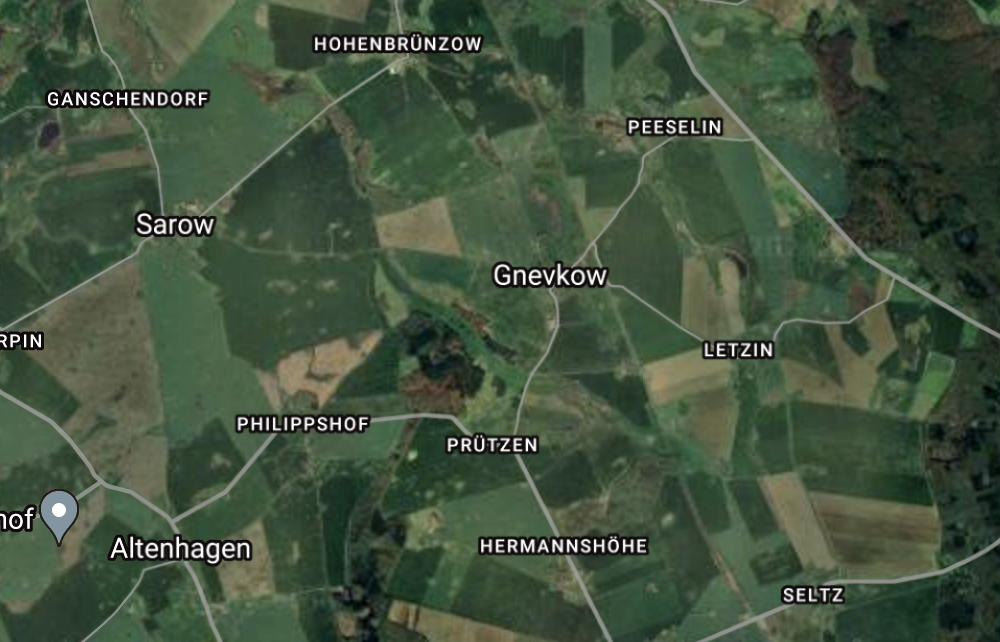
Karl Schultz died in 1907 in Chicago, leaving his widow, Maria Ebert, two sons and four daughters. His Missouri Synod record says that he was from "Seltz, V. Pommern." That translates to Vorpommern, and there is indeed a village called Seltz there. A Google map of Seltz showed the villages around Seltz, and we know (from looking through the clerk's cross-hatching) that the crossed-out village was "____hagen" and the corrected village was something like "P___selin." That's a start. If this couple married in Vorpommern they probably lived close to each other.
Amazingly there are a couple villages that fit the bill, as the Google map shows. Seltz is a few miles from Altenhagen, which looks like the crossed-out village, and there's a town called Peeselin a few more miles to the north. That's it!
Seltz records have not yet been digitized at my favorite German genealogical database, Archion.de, but Archion records from Peeselin (sometimes spelled Peselin) are available by following this path: All Archives / Schleswig-Holstein / Landeskirchliches Archiv der Evangelisch-Lutherischen Kirche in Norddeutschland / Kirchenkreis Pommern / Hohenmocker.
Hohenmocker it is. Fred Ebert (who we know was born about 1820 according to his age at death) can be found there as Joachim Friderich Theodor Ebert, the son of Martin Christian Ebert and Catharina Maria Müller. Fred's daughter Maria's baptism record has proven to be elusive. She may have been baptized in an adjacent parish. More work is needed, but this is an excellent start to researching a new region.
27 July 2024 | Email your comment.
A mystery no more
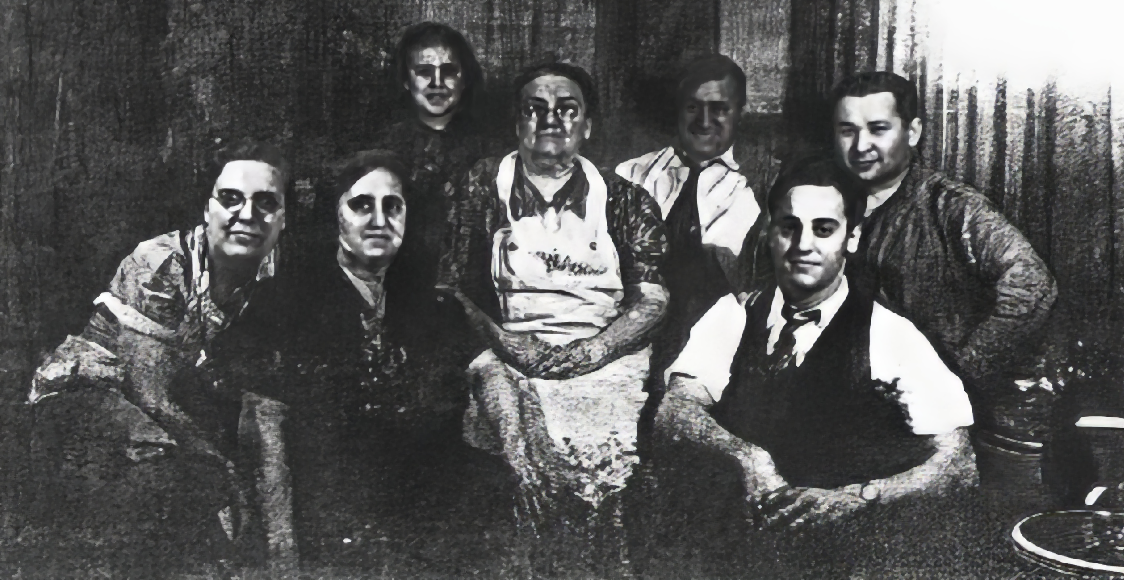
This isn't the best image we have of some of the Mikkelsen family but in the case of Walter Breetzke, far right, this photocopied picture is the only one we have of him...so it'll have to do.
The Mikkelsens were a major part of the Petersen clan in our family. Catherine Petersen Mikkelsen, at the center of this portrait, was the matriarch. After her husband of many years, Hans Petersen, died in 1905, she married family friend Thomas Mikkelsen, who had already had his own children with his ex-wife Helene Sievertsen. With Catherine, Thomas had another daughter, Florence, at far left. Florence married Walter Breetzke in 1934 and he was a steady presence in the family.
But his own relatives were a surprisingly profound influence in their own right and we're learning more about them every day, in particular how helpful they were to Walter when he was a new immigrant.
“Citation: Digital reproduction of a photocopy of a photograph, collection of Cathie Meyer: Mikkelsen family, Chicago, Illinois c. 1940, scanned in 2004, accessed 16 July 2024.
Walter and Florence Breetzke had no children of their own, although he informally adopted Florence's daughter Cathie Brown. There seemed to be no other Breetzke folks in Cathie's extensive photo collection but a perusal of Walter's 1923 passenger manifest tells us that his father's name was Hermann and he was born in Woltersdorf, Germany. But which one? There were twelve villages of that name scattered across Germany.
Walter seems to have declared his intention to become a U.S. citizen when he arrived in 1923 but traveled back and forth to Germany at least twice, returning in 1929 and again in 1933. From those manifests we learn that his mother was Mathilde and he was joining a cousin in Chicago, Harry, and was a plumber's helper by profession (you can see Harry with his father Julius Senior and brother Julius Junior in their wagon here, thanks to Julius' Find-A-Grave entry). In his first manifest from 1923 he mentioned traveling to his uncle, Robert Breetzke, in Chicago. More family names to consider!
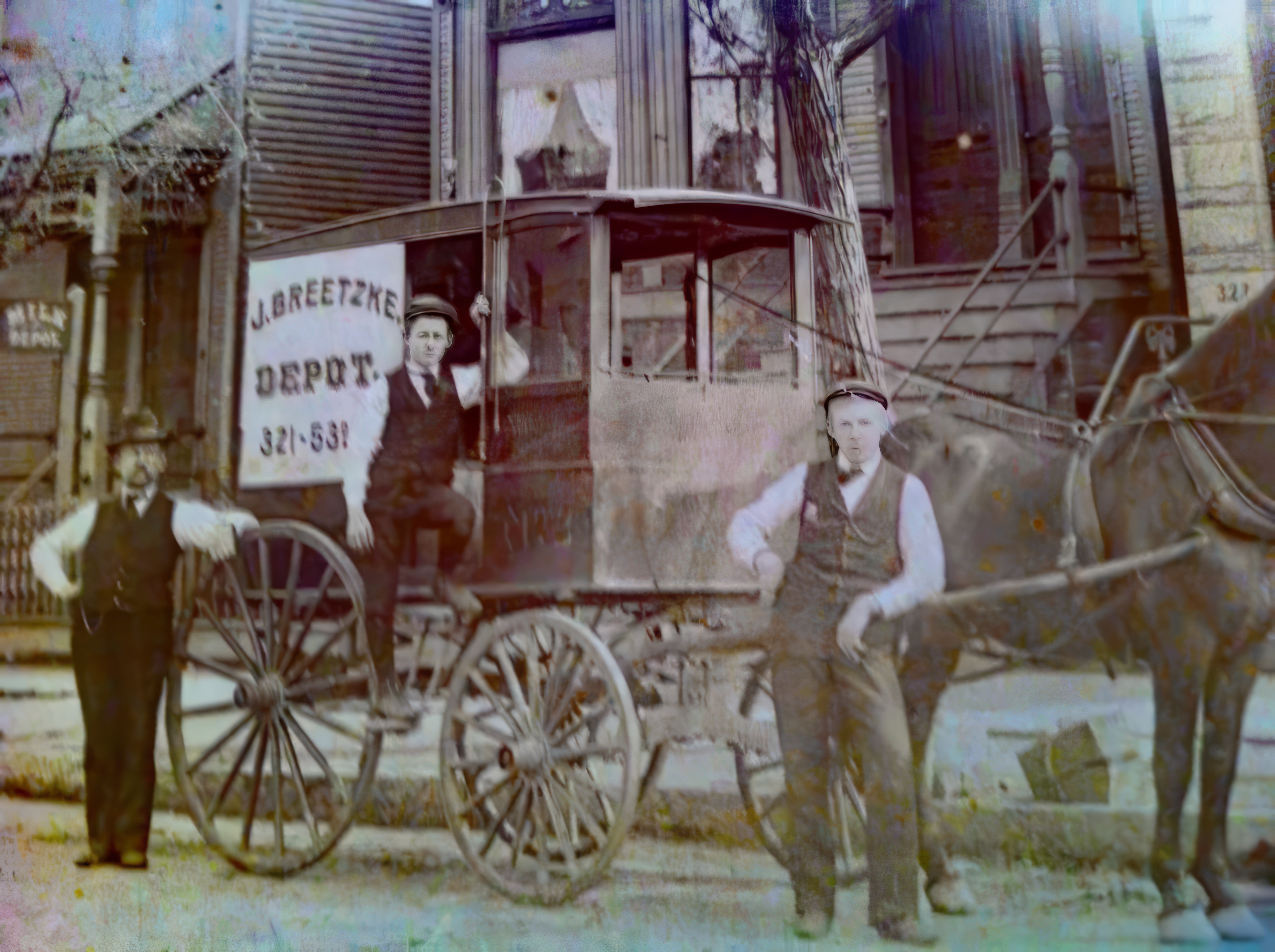
Then in 1929 his brother Erich emigrated, a connection made clear from Erich's own manifest, where his mother was Mathilde Breetzke in "Woltersdorf, Pommern" and he was traveling to join his brother Walter in Chicago. So here we have the parents' names and at least two children, plus a bonus: clear identification of their town of origin.
So now: who was Harry? A U.S.-born cousin who lives in Chicago, so a quick look at census records reveals Harry living with his father Julius Breetzke, a German immigrant who came to the USA in 1871. The family business was plumbing and they seemed to have excelled at it (Walter may have worked for them). Above Julius Senior poses with his sons Harry and Julius Jr. But I found myself wondering: was Julius a brother of Walter's father Hermann? Was Robert another brother?
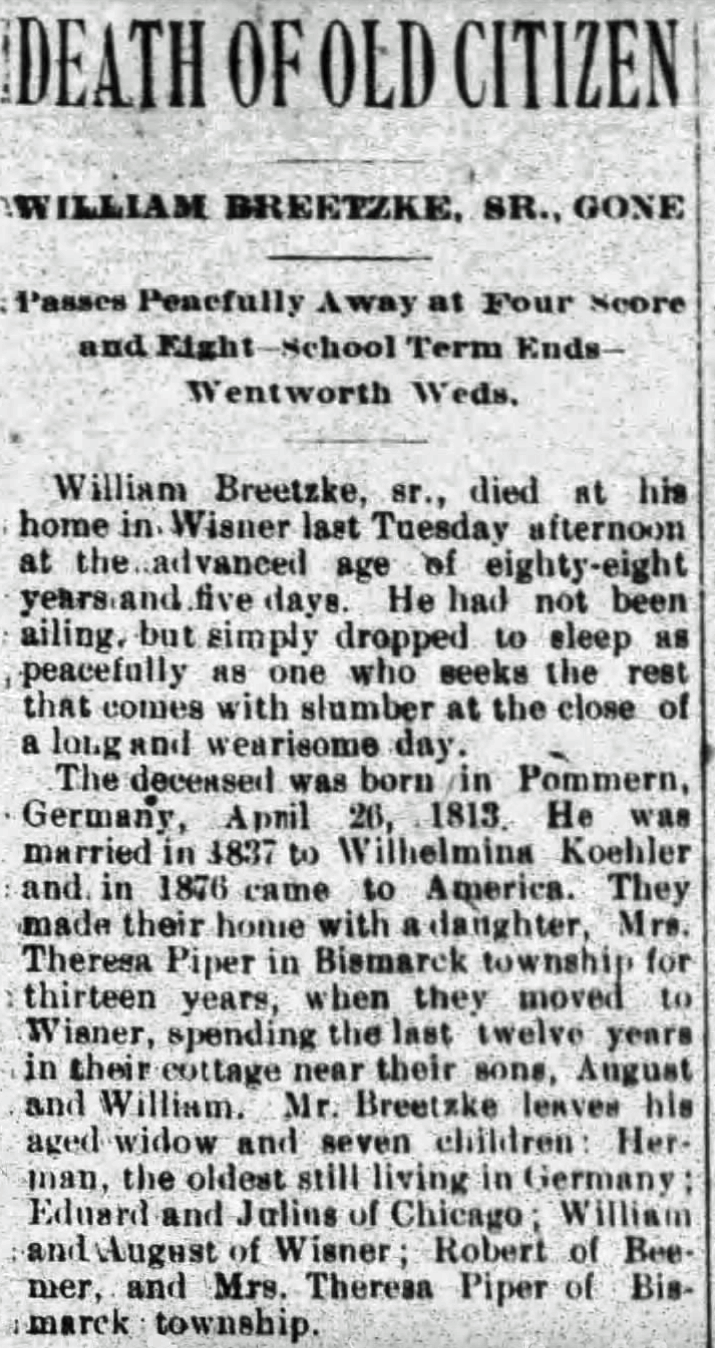
According to the Find-A-Grave entry Julius (and his sons) were plumbers in Chicago, and Julius was the son of Johann Wilhelm Friedrich Breetzke and Dorothea Wilhelmine Köhler, a couple who, as it turns out, lived in the town of Wisner, Cuming County, Nebraska. Wisner is full of Breetzkes, the older ones having emigrated in 1876.
The Wisner News-Chronicle, Wisner, Nebraska, Saturday, May 04, 1901 includes a nice obituary for the patriarch William Breetzke, and practically gives us a complete family tree, with details galore:
- William was born in Pommern on April 26, 1813 and died at 88 years old.
- William and his family emigrated to the USA in 1876.
- William was survived by his widow, Wilhelmine neé Koehler (Köhler in German spelling) whom he married in 1837 and numerous children.
- William's children included a married daughter, Theresa Piper of Bismark, Nebraska; sons William and August in Wisner; Eduard and Julius in Chicago (we already know that Robert was in Chicago too); and Hermann, the eldest, who remained in Germany.
So we may be able to conclude that Hermann was Walter Breetzke's father, who never left Germany and died before 1929 (a conclusion based in Walter's manifests, which mention Hermann in 1923 but not in 1929). It's possible that there was yet another generation including a Hermann who was actually Walter's father, but more research is needed to prove this theory.
That's quite a family constellation, and a welcome new addition to our tree now that we know Walter's deeper roots.
16 July 2024 | Email your comment.
Using DNA to solve a mystery
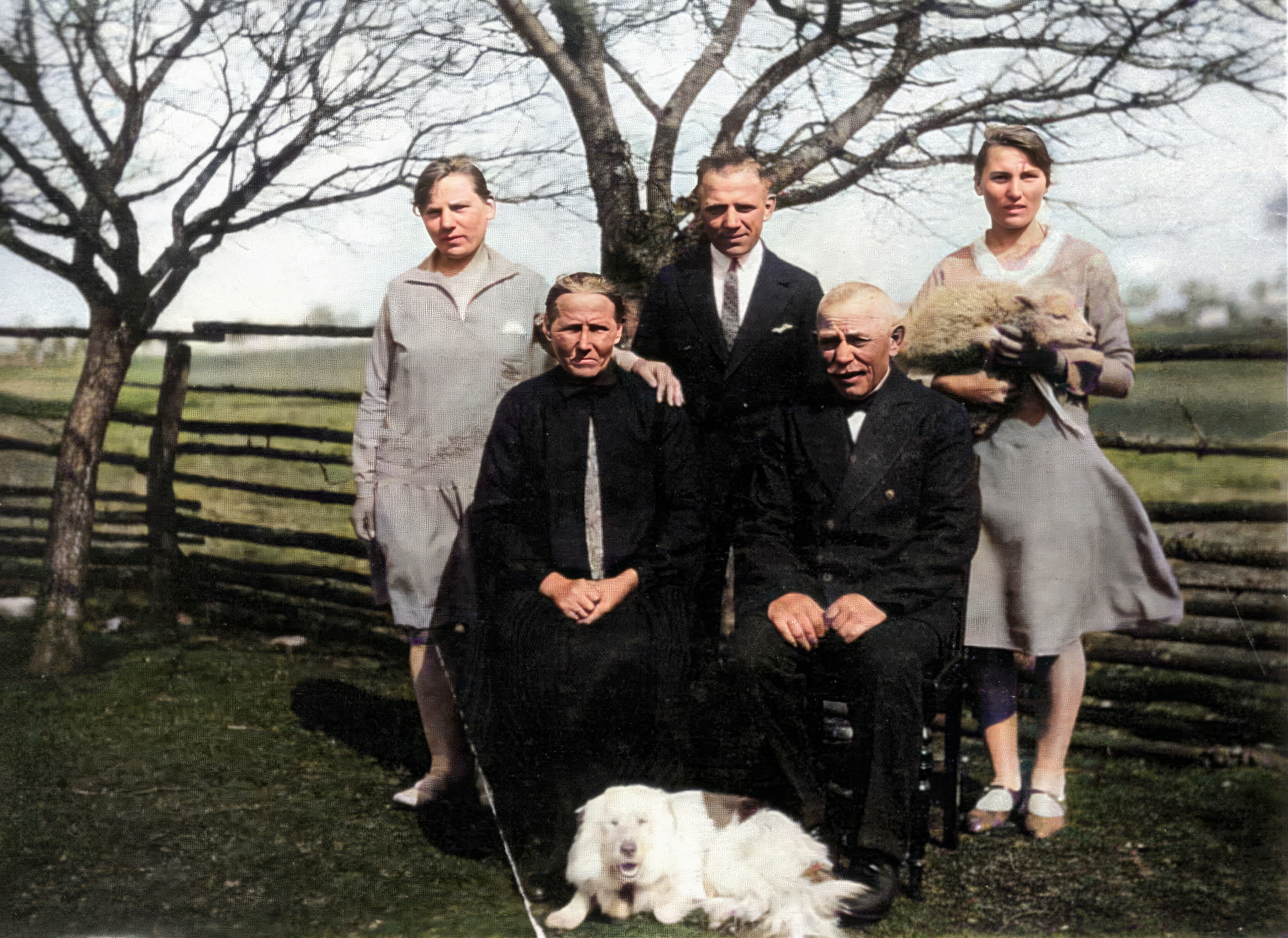
Citing the results of a DNA test is no different from providing a citation to any other evidence we have of a genealogical connection, but it comes with special requirements, specifically the issue of privacy.
In this instance I have a DNA match with someone who has an Alwine Gohr Marzusch (born 1832 in Schwartz Damerkow) in their tree, and that's worth following up because of our family connection with folks named Gohr. But while I can use a general citation to indicate where I found the evidence for this connection, I have to be aware of how I can publicly use this information.
“Citation: Ancestry.com, DNA match with a descendant of Alwine Gohr Marzusch of Schwartz Damerkow (1832-1920), predicted 4th – 6th Cousin < 1% shared DNA: 25 cM across 1 segments: Ancestry.com Operations, Inc., accessed 29 June 2024.
I can't cite the kit number or other identifying information without permission from the owner of the tree that includes Alwine and her husband Albert Marzusch, but his tree is publicly available. While it's helpful up to a point it doesn't include information that explains how Alwine fits into our family.
The DNA match suggests that she was a distant family member at some point in time, and her birth year (circa 1832) is close to the timeframe where my great-great-grandfather Wilhelm Heinrich Gohr was married Emilie Luise Lübeck and started having children of his own, beginning in 1838. Wilhlem's birth, marriage, and death information is completely missing from the records of this region in what was then Kreis Stolp, Pomerania. If Alwine could be proved to be Wilhelm's sibling or cousin, we'd have more clues about his family origins.
There are some existing records for Alwine that provide useful information:
- Alwine's death record from 1920, which gives her parents' names as Martin Gohr and Karoline Steinhardt
- Albert Marzusch's death record from 1889, which suggests that they had a son Hermann, who was the informant.
The Marzusch family also included a daughter, Auguste Marzusch, who was born in June 1876 in Schwartz Damerkow, a village in Kreis Stolp, once part of Pomerania but now in Poland. She's pictured above with her family: husband Karl Neumann and children, standing; Emma Neumann, Ernst Neumann, Anna Neumann. Anna hold a little lamb and the family dog (of course) is included in the portrait.
The DNA match to one of Alwine's descendants is worth exploring. Our best estimate is that our mystery man Wilhelm Heinrich Gohr was born about 1805-1810. That's not too far off the birth estimate for Alwine's father Martin Gohr. Martin would have been about twenty-five to thirty years old when Alwine was born, assuming she was his first child. Martin's estimated birth year and Wilhelm's were thus pretty close. Were they brothers? Cousins? It's a tantalizing theory. Ultimately it may not be solvable due to the precarious existence of available records from this region, but we can hope to find out more in the future, perhaps with future DNA matches.
29 June 2024 | Email your comment.
Chicago is getting crowded

The more I look into our Lübeck ancestry the more astonishing facts emerge. First was the fact that my great-great-grandmother's older sister, Johanne Caroline Lübeck, born in 1809 in Gaffert, Kreis Stolp, Pomerania, married Christina Körlin and had fifteen children. Fifteen. Even for my ancestors that's a lot of children.
The next realization: one of those children came to the USA in 1894 and lived in Chicago, where her cousin Wilhelm Gohr had settled in 1881. Did they know about each other or was it a situation where Chicago was attracting German immigrants of all sorts at the time?
“Citation: Ancestry.com, 1900 United States Federal Census for Bertha Greinke: Illinois > Cook > Chicago Ward 30 > District 0919: Ancestry.com Operations, Inc., accessed 20 June 2024.
Johanne Caroline Lübeck married Christian Körlin (sometimes Koerlin or Kerlin) around 1838, probably in Malenz, a village near Klein Nossin, and it appears that Bertha Emilie was the couple's first child. Born on February 7, 1839, Bertha was baptized on February 17 with the customary three godparents listed: Wilhelmine Barteln married to a Schneider, Emilie Frocheln, and Ferdinand Lübeck (the child's maternal uncle).


Bertha's baptism record, shown in two parts, is about as detailed as it gets.
Bertha's initial foray into matrimony and motherhood was fraught with tragedy. Her first husband, whom she married in 1858 when she was nineteen, was Carl Dietrich Pett, and their child Carl Friedrich was born five months later. Both father and son died on the same day, November 28, 1858, the baby just ten days old.
Bertha's second marriage was more permanent. She married Wilhelm Ernst Gottlieb Greinke in 1862, who was probably a cousin -- Bertha's aunt, Mathilde Ulrike Ottilie Lübeck, was married to a Christian Friedrich Greinke and she was a godparent to Wilhelm when he was born in 1834.
Greinke was an old name in the region, traceable back into the 1700s in the nearby community of Lupow, which encompassed the village of Neu Jugelow where Wilhelm was born. They had eight children before emigrating in 1894 with two apparent grandchildren, Hermann and Theresa. In Chicago they lived with their daughter Bertha Greinke Diesing on Justine Street. Wilhelm was usually enumerated with some form of Gottlieb (the 1910 U.S. federal census mangled his name as "Gutliep").
Was Wilhelm Gohr, himself a son of Emilie Lübeck Gohr and Bertha's first cousin, aware that she and her family members had emigrated to Chicago? Possibly, but we have no proof. There are no images of any of the Greinke folks in Gohr photo collections, no references to Greinke relatives, no cousinly marriages, so the families may not have been in touch after they emigrated separately. It's not that different from the situation involving Otto Carl Kebschull, whose mother was Ernestine Charlotte Lübeck (another Lübeck sister) but who appeared to not be close to his own Chicago relatives, having settled in a Montana homestead. The lure of America was very strong, perhaps even stronger than family connections.
21 June 2024 | Email your comment.
The marriage that wasn't
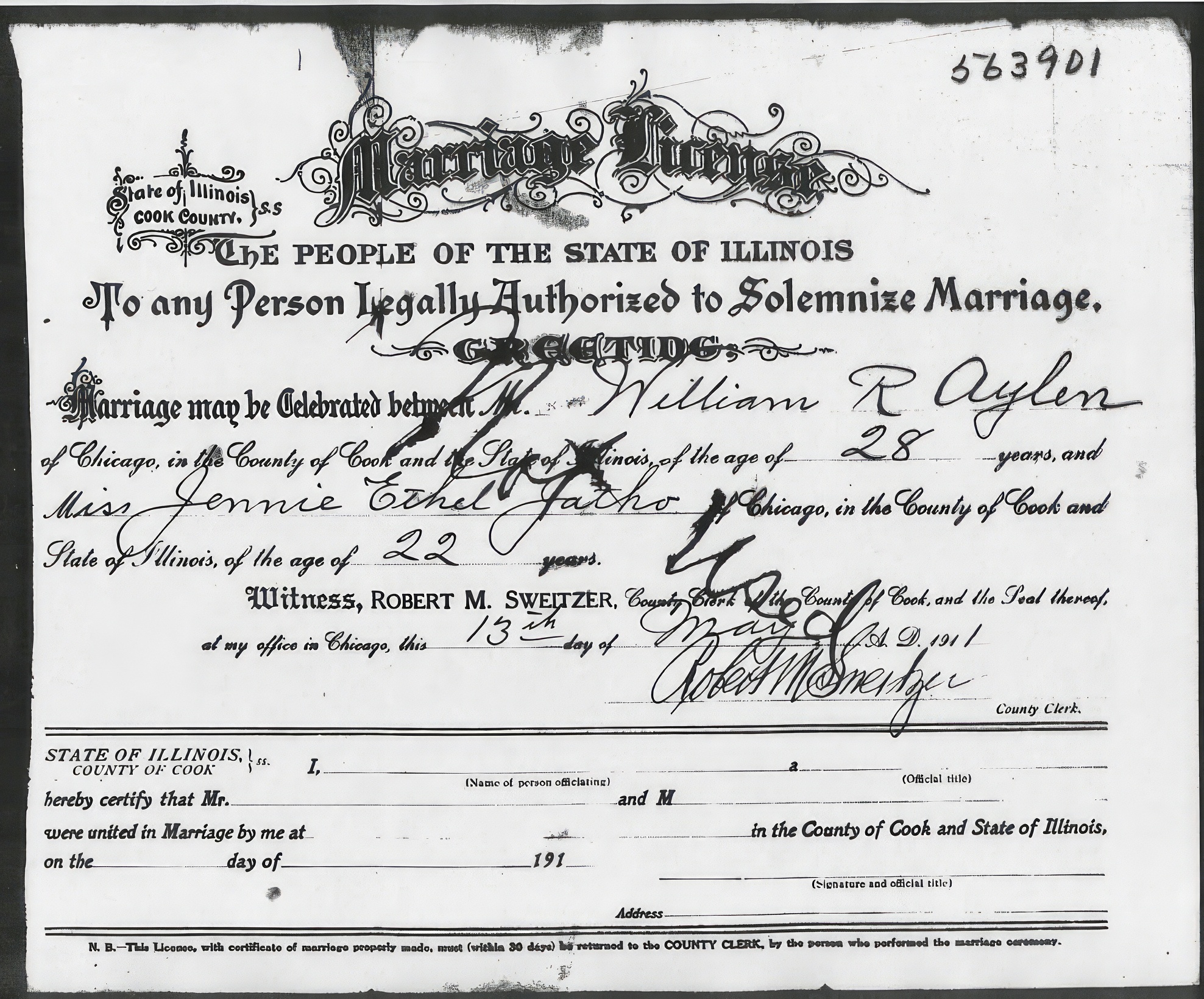
Here's something you don't see everyday: a marriage license that was never used but which became a part of the Cook County archives nevertheless. The license even has the notation "Not used" written in bold letters across the form. What was going on? Why did it end up back in the Cook County Clerk's office?
“Citation: "Illinois, Cook County Marriages, 1871-1968," FamilySearch (https://www.familysearch.org/), license number 563901, entry for William R. Aylen and Jennie Ethel Jatho, 1911, license dated 13 May 1911, no return, notation indicates "Not Used," image provided by Cynthia Richardson at Genlighten.com, accessed 22 Sep 2005.
Under normal circumstances a Cook County license would be applied for by one or both of the affianced couple, with the date of application in the upper portion of the license and the completed information (marriage place, date, officiant) noted in the bottom half, which would be returned to the county clerk's office. In this case, something interrupted the actual marriage. Dutifully the license was returned incomplete to the clerk and "Not Used" was written across the preliminary infromation.
Why does this interest us? Normally it wouldn't. A marriage that didn't happen isn't as interesting as one that did, usually, but in this case there's a backstory around this event that fills in some details of a preexisting family story.
We know who Jennie Ethel Jatho was. Usually referred to as Ethel, she was my grandmother Marie's older sister, born in Charleston, South Carolina in 1889. All Ethel's siblings were born there but for reasons unverified the family moved from Charleston to Chicago in 1910. Ethel's father, William George Jatho, had died in 1904 and mother Jennie Jatho and her four children remained in Charleston for another six years until their relocation, where the widow Jatho had a sister.
That's a good enough reason for the move but likely not the whole story. Toward the end of 1910 Jennie Ethel became pregnant and had a daughter, Mary Jane Campbell, in Chicago in July 1911. The father was listed as Leonard Campbell, although no trace of Leonard can be found, either in Chicago or Charleston. No sign of a marriage either. It may be that the family relocated to Chicago to hide Ethel's condition from family and friends in Charleston, who were numerous and (one imagines) curious.
So in May 1911, when this license was issued, Ethel was seven or eight months pregnant and was referring to herself as Mrs. Campbell. But the name on the license says Jatho, her maiden name. That's not consistent with what we know about Ethel's use of the name Campbell, which she was still using in 1914 when she married Orrie Edward Crossey in Chicago.
We also know from family anecdotes that Ethel's younger sister Marie (born in 1897 in Charleston) attempted to elope at the age of thirteen. Marie herself confessed this to her own daughter many years later, so although anecdotal the source is fairly dependable. Marie was thirteen years old in 1911. This license is dated 1911. Interesting coincidence -- did Marie use her older sister's baptism document to appear to be old enough to marry? Is that the reason the license refers to the bride as Jatho, not Campbell?
Reading between the lines it's possible to form a theory based on this unused document. The license was obtained but the marriage didn't occur -- maybe someone discovered that the bride was only thirteen or maybe someone checked into William's marital status (see below). Being a thorough person the officiant, whoever he was, returned the license to the Cook County clerk's office, where it was filed away and duly microfilmed for the collection of Chicago marriages. Officiousness is sometimes a blessing.
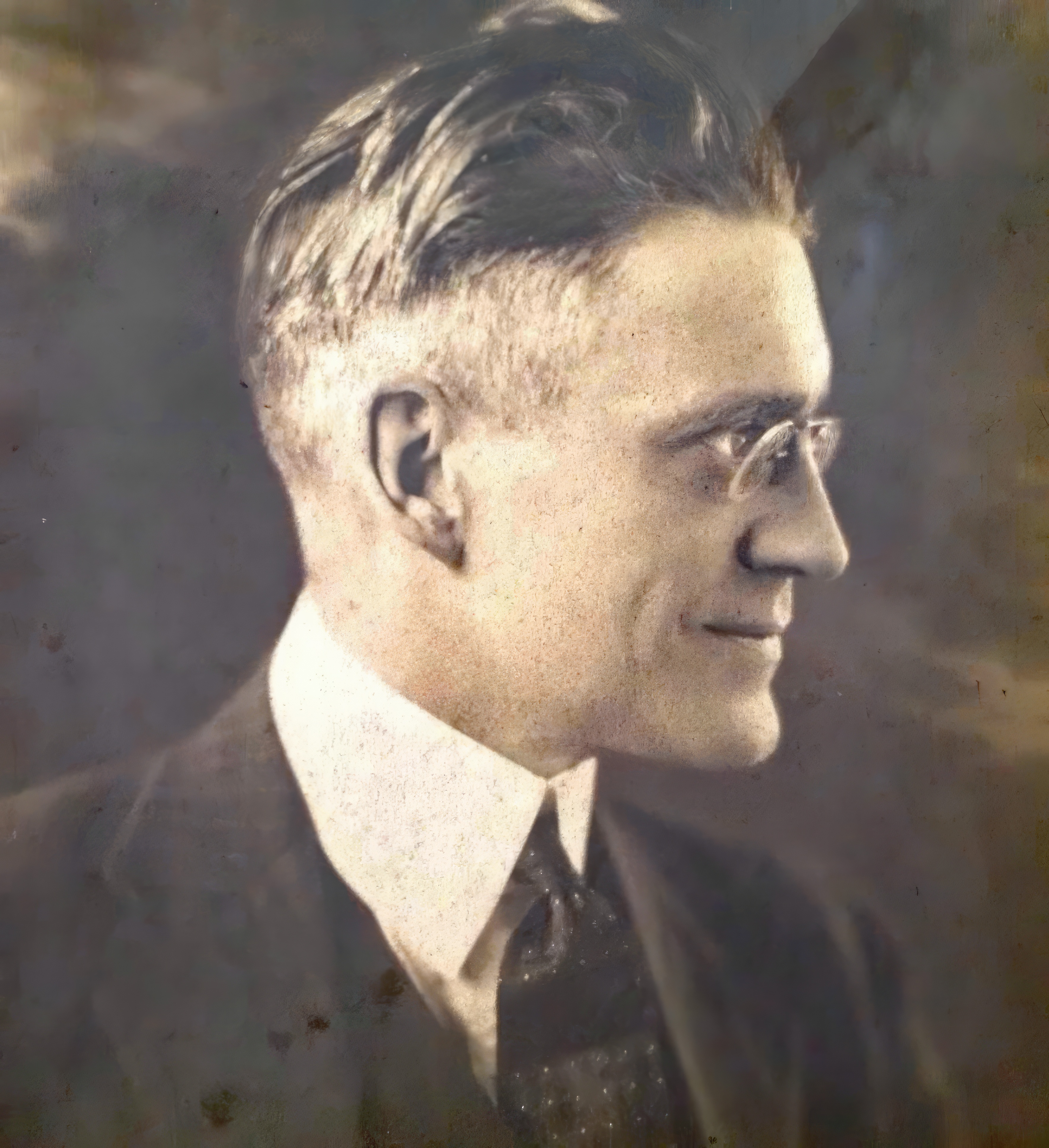
Who was the groom, William R. Aylen, pictured at left? He was a character, no question about it. An insurance salesman, he was born in 1883 in North Dakota and made his way to Chicago. In 1907 William was married to Mabel Walker, then was married to or lived with a Gertrude Lillian Baillieuil, who the 1910 census lists as his wife, with whom he had two daughters. William then married Florence O. Brandon in 1912 and remarried (or married for the first time) Lillian in 1913. He was back with Mabel by 1930. It's unclear whether any divorces were part of his complicated love life. He may have been married simultaneously to more than one woman at the same time.
What's likely is that the near-marriage to Marie Jatho would have been a disaster for her and possibly for William. Fortunately the episode left no lasting traces of despair. On June 4, 1914, when Marie was fifteen, she married twenty-year-old Alva E. McLaughlin (as his name was then spelled). They had four children and survived in a steady (but not necessarily happy) marriage until 1956, when Marie died of a heart attack at the age of 58.
4 June 2024 | Email your comment.
Finding your Gretna Green
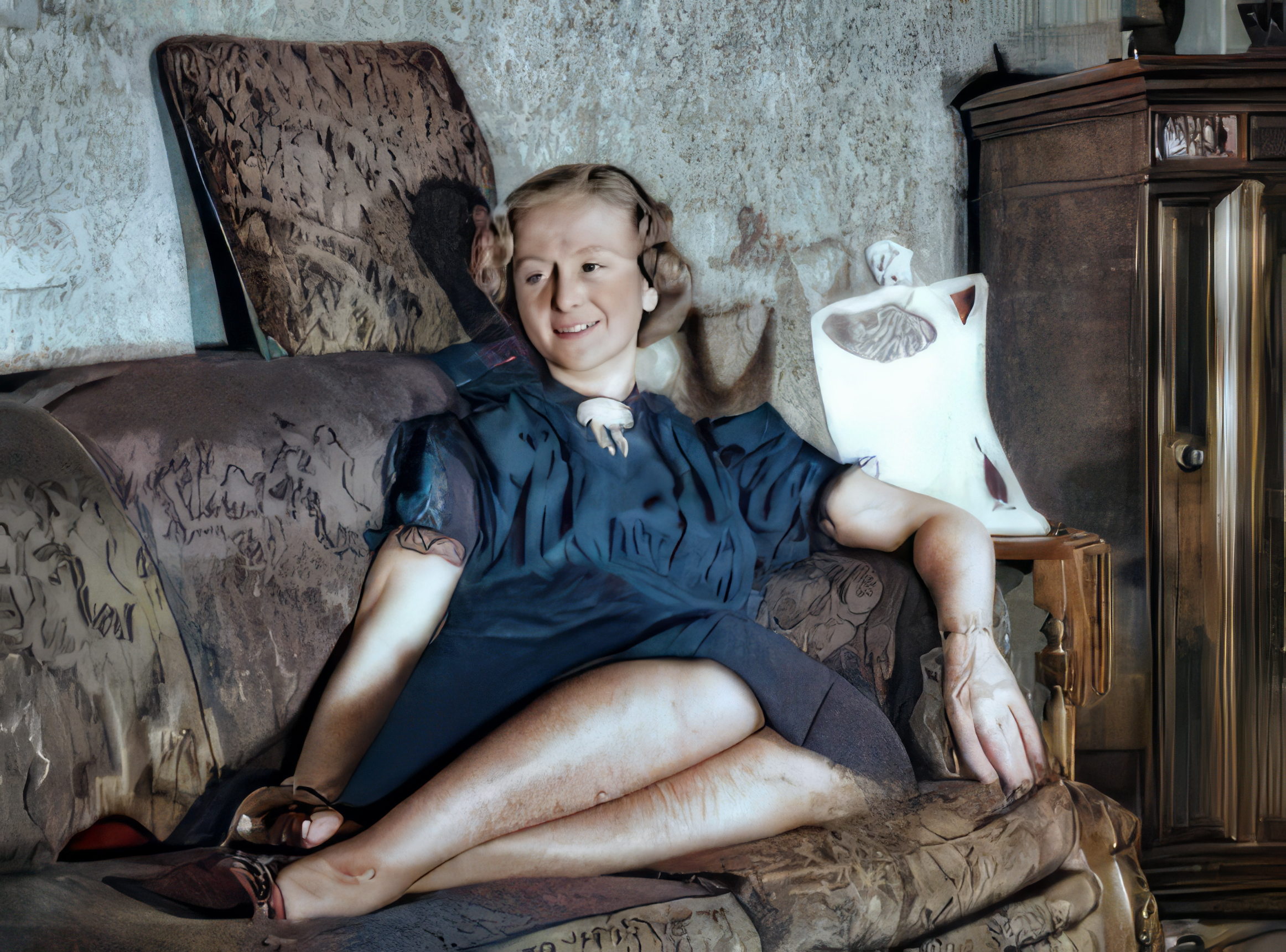
If you wanted to get married but circumstances made it difficult -- parental objections, lack of documentation, ages -- there were always places you could go to make it possible. Loretta Murphy (pictured at right) had parents who handled their nuptials in just this way. In fact, it appears they almost didn't get married at all save for the handy option of their own "Gretna Green" in St. Joseph, Berrien County, Michigan.
“Citation: Digital reproduction of a photograph, front side, collection of Anna Gohr Glawe: Loretta Murphy Mayhan, Chicago, Illinois c. 1942, original photograph from the album of the owner, scanned in 2023, accessed 26 May 2024.
Gretna Green was a real location in Scotland just over the border from England. It was famous for providing a welcoming haven for marriage-minded folks who were denied a legitimate, official marriage in England. In the United States there were a number of cities that were known to extend a welcoming hand to couples who wanted to marry despite legal or parental objections. It appears that Loretta's parents took advantage of the relaxed, non-religious opportunity in St. Joseph.
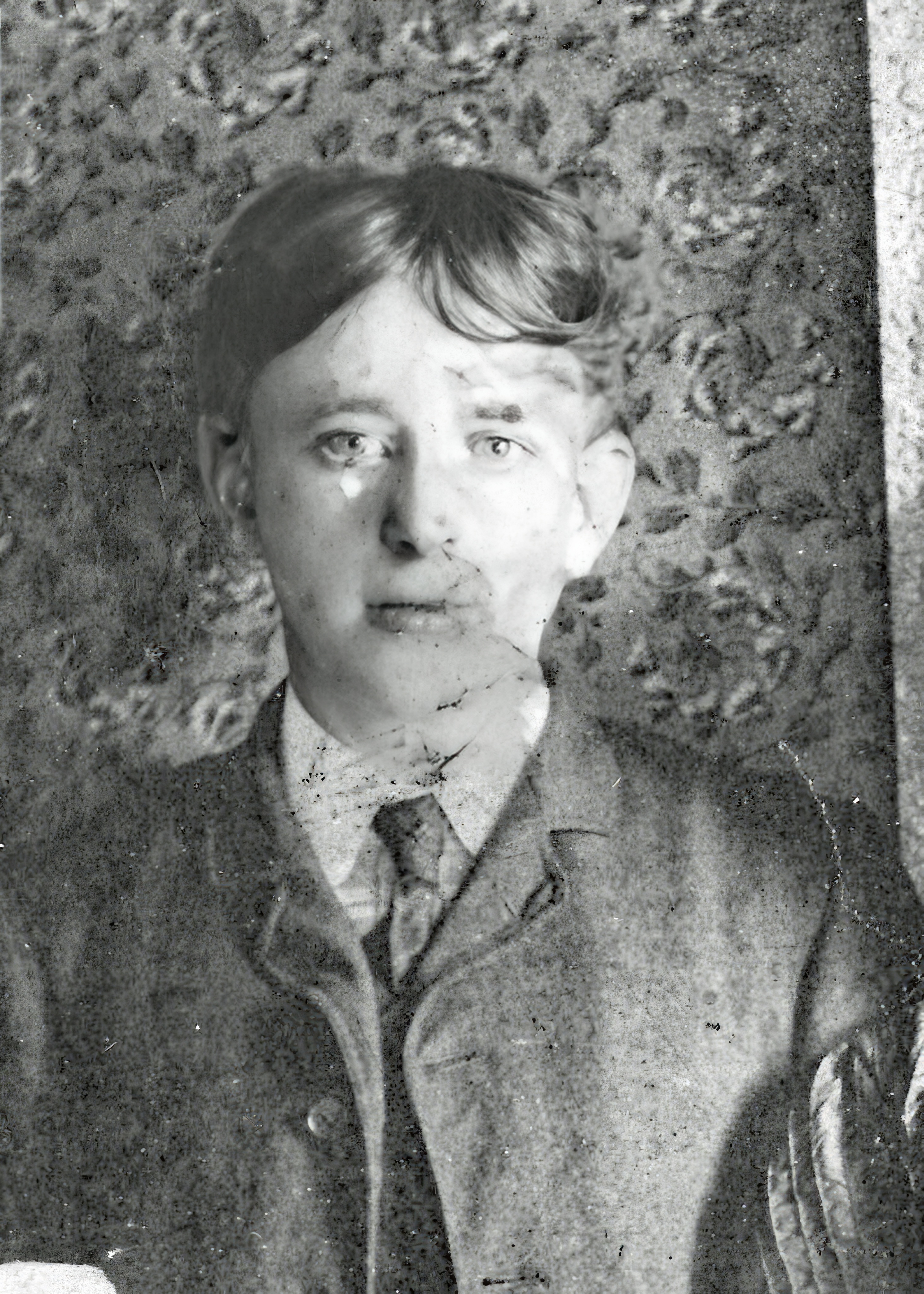
“Citation: Public Member Trees, database, Ancestrylibrary.com (http://www.ancestrylibrary.com), digital reproduction of a photograph, front side, "McNulty family tree," Owen Patrick Murphy (1882-1955, d. San Diego, California), undocumented photographic data, accessed 26 May 2024.
We don't have any photos of Emma Hasse, Loretta's mother, but we do have one of her father, Owen Patrick Murphy (left in an undated family photo), who was born in 1882 in Donaghadee, Down, Northern Ireland and emigrated to Chicago with his parents, John D. Murphy and Mary Grace Jamison, in the mid-1880s. Emma Hasse was the daughter of Carl August Hasse and Augusta Caroline Kramp, who emigrated to the U.S. in 1881 from Kreis Bütow, Pomerania and settled in Chicago. Already we can see a possible impediment to the marriage of Owen and Emma: religion. The Murphys were Catholic, the Hasse/Kramp family was decidedly Lutheran.
Nevertheless there was a blessed event on the way, necessitating a certain amount of hurry-up. Emma was seven months pregnant when she and Owen married in St. Joseph on 15 August 1909. Loretta was born in Chicago in October 1909. The civil marriage was performed by the clergyman William C. Swink. Owen listed his occupation as a carpenter, Emma was a baker, both were from Chicago, and their witnesses (family cousins, also from Chicago) represented both sides of their families: James McNulty for Owen and Olga M. Korn for Emma.
It's possible that Owen and Emma chose St. Joseph because they had other relatives living there (certainly for Emma there were Gohl/Gaul and Kebschull relatives in Berrien County, but she may not have known them). Crown Point in Lake County, Indiana was also a Gretna Green location but for Owen and Emma St. Joseph was definitely closer to Chicago, thus more convenient.
Loretta, pictured at the top of this post, was the only child of Owen and Emma. She ended up marrying a fellow with Irish roots of his own, Joseph Mayhan, in 1939. They had no children but were a welcomed part of Loretta's extended family in Chicago.
When looking for marriages, even in large metropolitan areas such as Chicago, and if nothing is found, it's worth looking in adjacent communities for the most probable Gretna Green.
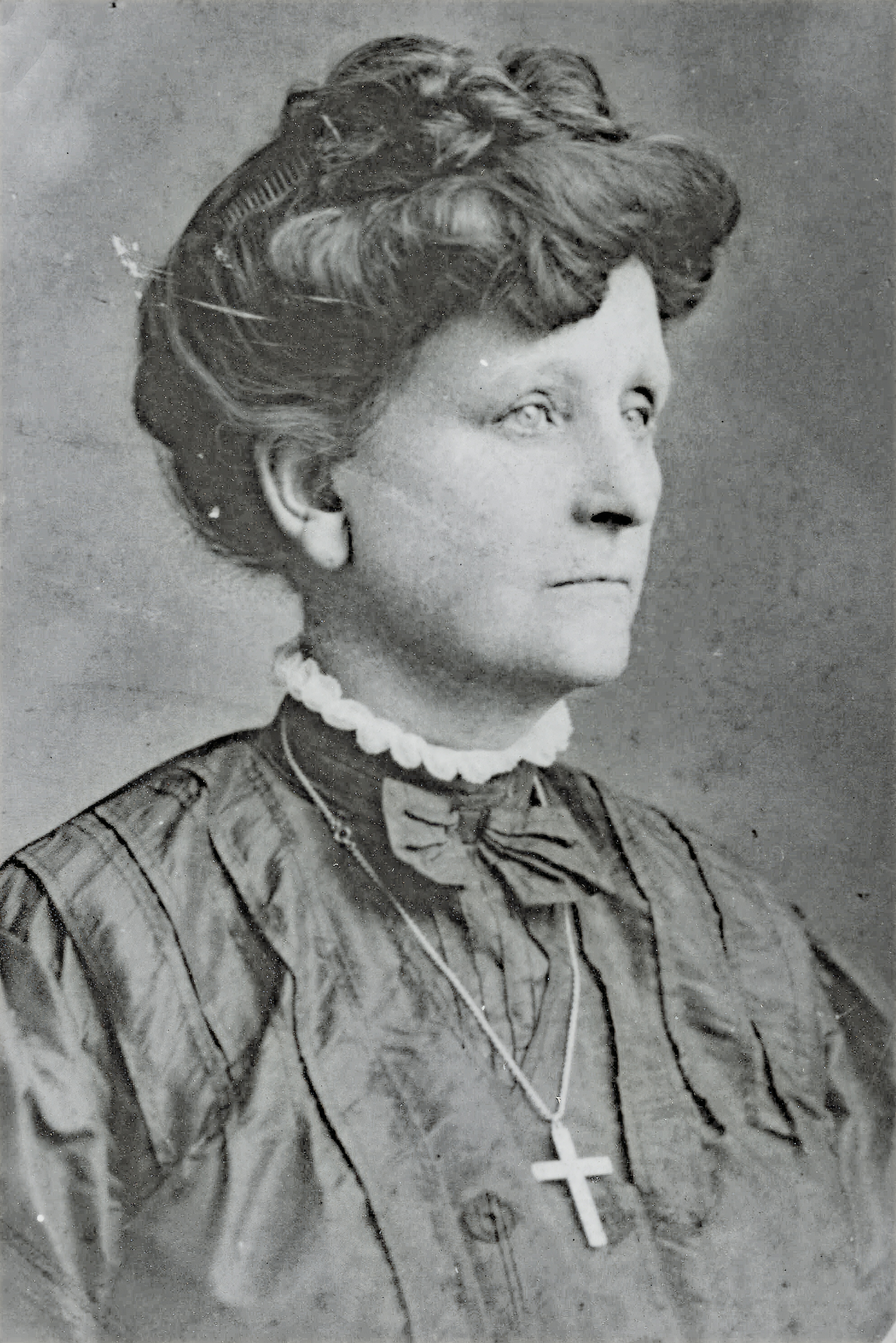
Update: Unexpectedly I ran across a photo of Owen Murphy's mother and Loretta's paternal grandmother, Mary Grace Jamison Murphy (left), thanks to the McNulty family tree. There's an interesting notation in the tree itself, suggesting that Mary Grace was not a Catholic by birth but converted upon her marriage.
Her upbringing in a different religion (not sure what, Church of England or some other denomination?) might have made her more sympathetic, you would think, to the situation her son and his fiancée found themselves in during 1909 -- especially since she confessed to her granddaughter, Grace McNulty, that she was actually a non-believer. But we don't know where the family impediment originated, nor who objected to the marriage between the Catholic Owen Murphy and the Lutheran Emma Hasse, assuming that this was the reason for the elopement to St. Joseph. All we can do is suggest that this was indeed the most likely reason for a marriage performed far afield from their Chicago home town.
26 May 2024 | Email your comment.
Twenty years of genealogy
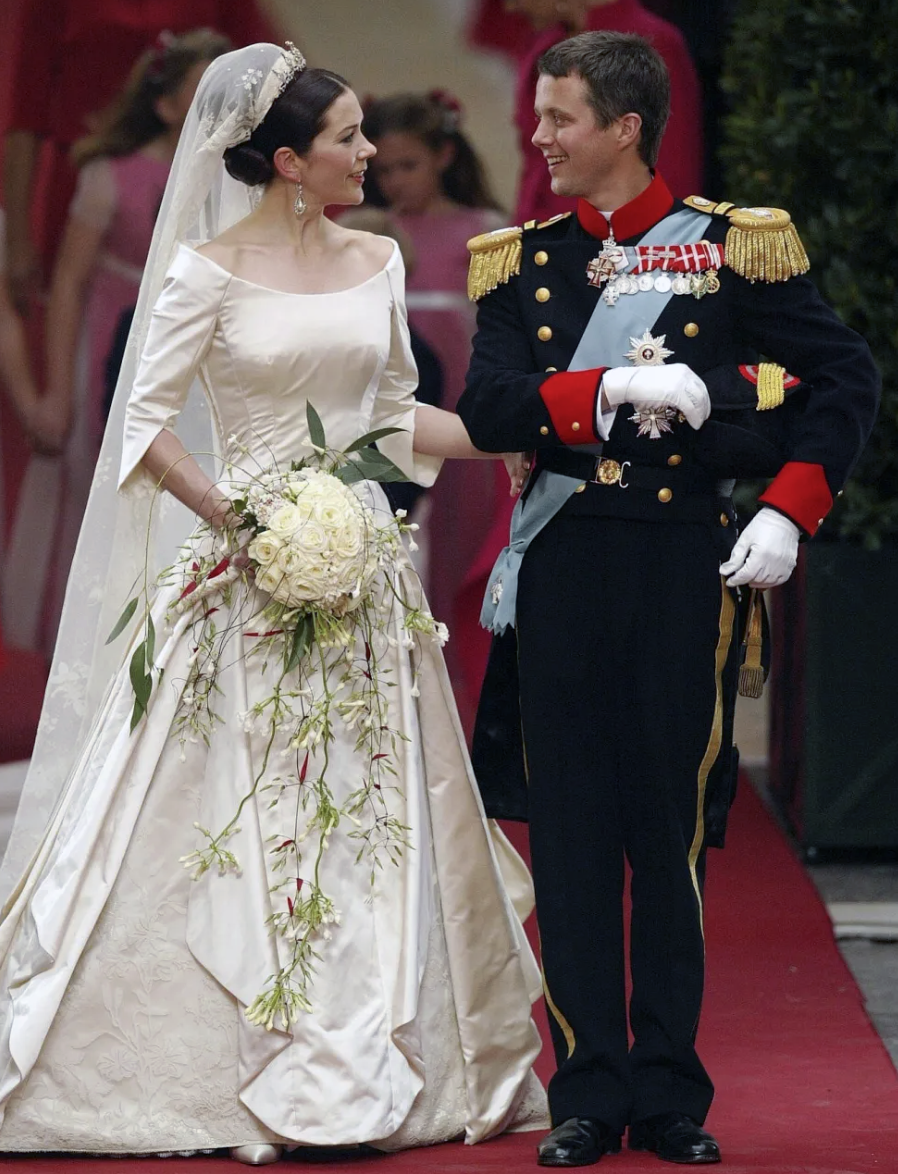
Technically it's been more than that. I was asking questions when I was seven years old but got no sensible answers. In 1993 I wrote to the Cook County Clerk to ask about my paternal grandfather's birth certificate, but also got nowhere. They couldn't find anyone born as Alva Elwood MacLaughlan. But I persisted in searching for my Scottish roots.
“Citation: Digital reproduction of a photograph, Crown Prince Frederick and Crown Princess Mary of Denmark, The U.S. Sun, online edition, 31 December 2023 (original photo credit: AFP), https://www.the-sun.com/royals/9981932/prince-frederik-mary-denmark-royals-australia-kate-middleton/ accessed 14 May 2024.
That's the reason I watched the royal wedding of Crown Prince Frederick of Denmark and his bride Mary Donaldson, a lass of Scottish ancestry. At least my heritage could intermix with the royal house of one of the oldest families in Europe.
The wedding was held on May 14, 2004. It stirred up my past forays into family research. Meanwhile my husband was having excellent results from his own investigations into his Latvian heritage. If he could do it, why not me? So several days later I gave him my grandfather's full name, birthdate, and place of origin. Minutes later he sent me Alva's social security record via a subscription service called Ancestry.com. How did he do that? I wondered. I soon found out.
Within a week I was posting on the Usenet message board alt.genealogy asking for further help because predictably nothing deeper was coming up on Alva. All I had was the baptism record for my father Thomas William MacLaughlan, where godparents with surnames Petersen, Mikkelsen, and Jatho were listed.
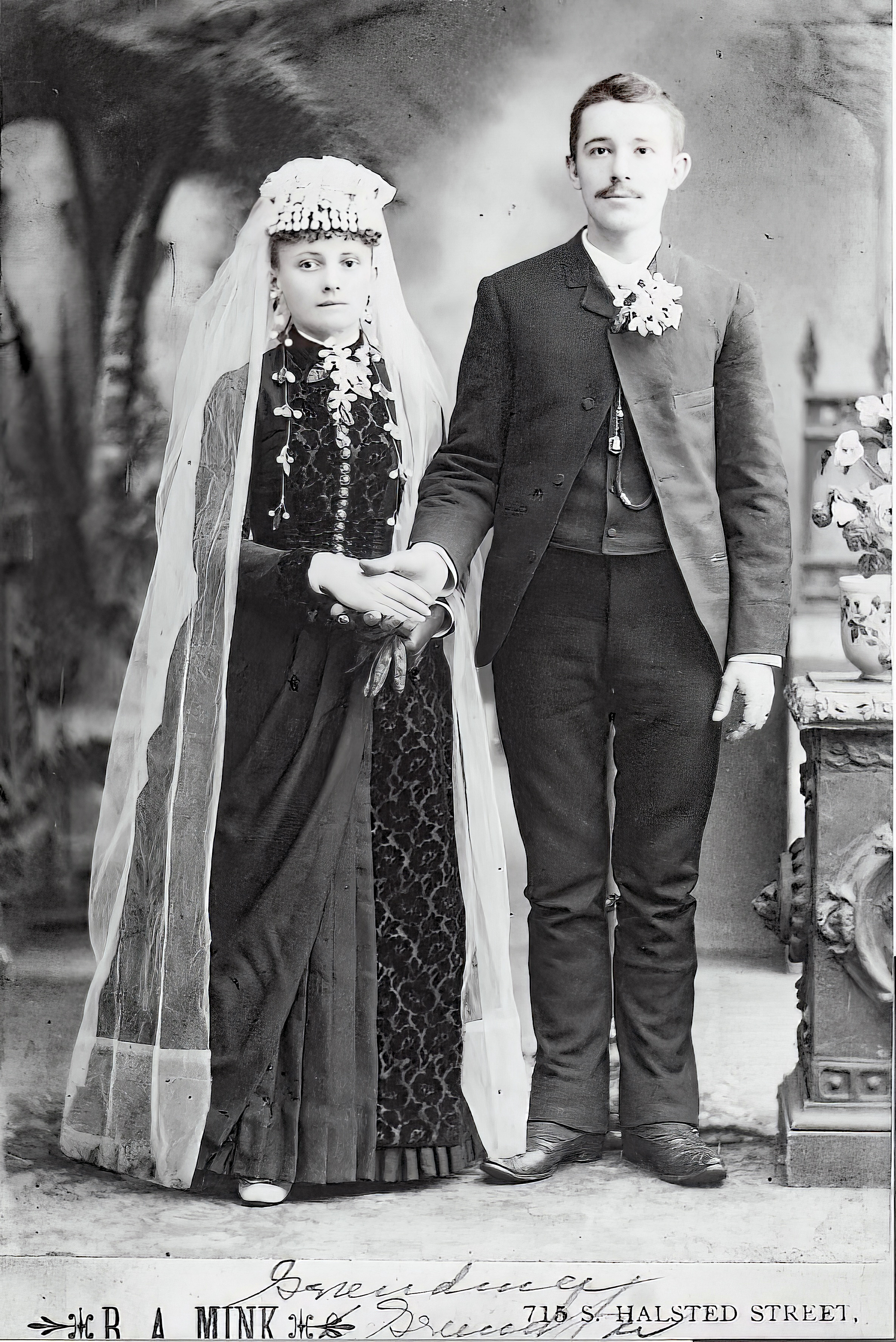
That was enough for some of the intrepid folks in that group to find Alva in the 1930 census and, even more astoundingly, in the 1910 census where he was listed with his stepfather Thomas Mikkelsen, mother Catherine Mikkelsen, and siblings, all of whom had the surname Petersen (misspelled on the census as Petterson -- those pesky enumerators!)...but no one called MacLaughlan.
I was beginning to sense a trend.
“Citation: Digital reproduction of a photograph, front side, collection of Cathie Meyer: Hans and Catharina Petersen, Chicago, Illinois 1878, original photograph from the album of the owner, scanned in 2004, accessed 14 May 2024.
It took a few more weeks to discover that I wasn't the only person looking for these Petersens and Mikkelsens. Someone pointed out a lady who descended from the Mikkelsen side and was seeking information about the Petersen family. I contacted her and she, in turn, put me in touch with a mutual cousin in Chicago who shared a wealth of information: photos like the wedding photo of Alva's (born Alfred Emil Petersen) parents, Hans and Catharina Petersen (above), stories, memories, and best of all, she confirmed that the MacLaughlan surname existed only in my grandfather's revisionist imagination. An unofficial name change about 1914 and a shroud of secrecy had prevented me from finding out our true ancestry. Traced back properly it led me to Schleswig-Holstein and eventually to Denmark.
So I had been focused on the wrong family in that royal wedding from twenty years ago. We weren't royal, but follow our family origins back far enough and we were Danish. Goodbye Mary my erstwhile cousin, and hello cousin Fred! It's been twenty years of accelerated research and what I've discovered via various research avenues has been a never-ending source of wonder to me.
14 May 2024 | Email your comment.
New Gohr baptism


It's great to have Groß Nossin records but it can also be frustrating to find out what's missing. It's not a deliberate act on the part of the parish clerks. You can see what's happening when you encounter earlier records from Bütow and you see fragmentary pages, water damage, crumbling paper -- it's not surprising that creating a full family history is compromised as a result.
“Citation: Digital images, Archiwum Państwowe w Szczecine (Staatsarchiv Stettin), baptism record for Johanne Friederike Krüger, 24 Nov 1833 in Nakel, Groß Nossin. Kreis Bütow, https://www.szczecin.ap.gov.pl/media/arch/65/147/0/09/6025/65_147_0_09_6025_0025.jpg and godparents https://www.szczecin.ap.gov.pl/media/arch/65/147/0/09/6025/65_147_0_09_6025_0025.jpg , accessed 8 May 2024.).
One of the enduring mysteries involved my great-great-grandfather Wilhelm Heinrich Gohr. His baptism, marriage, and death recods don't seem to exist anywhere. He appears in the Groß Nossin records from 1838 onward once his children are born and baptised, and these are helpful in their own way. His wife, Emilie Lübeck, is identifiable, and his home town of Nakel in the parish is happily included. After the first three children his town shifts to Nippoglense nearby, but the identification with Nakel is an interesting one.
Looking back at earlier records I was surprised to see Wilhelm appearing as a godparent to a child born in 1833. This was prior to his marriage to Emilie Lübeck, as far as we know, because none of their children appear until 1838. But five years earlier here's Wilhelm!
Notably the mother of this child is Ernestine Gohr. She was married to Georg Krüger, a new character in our family constellation. Another godparent was Dorothea Gohr, all from Nakel. Three Gohrs in one record -- clearly this is a family unit. But what are the relationships?
That's something that the records don't tell us. It's tempting to sugest that Wilhelm was a brother to Ernestine, and I think that makes the most sense, but I can't prove it. He could have been a cousin. Dorothea could have been the child's grandmother, aunt, cousin, almost any relative of at least eighteen years old, which was the common age when family members started to act as godparents in this region.
The records from Archiwum Państwowe w Szczecine (Staatsarchiv Stettin) are preserved from 1832 onward in various configurations, but Ancestry.com also has some Bütow records from 1824-1832. In those we find earlier children born to Ernestine Gohr and Georg Krüger in the town of Mankwitz. These include godparent August Gohr (godparent to Albertine Jacobine Ludowike born in 1831), with Dorothee Gohr from Nakel near Büdow again listed as a a godparent to an earlier child, Albert Friedrich born 11 [?] August 1829 and listed as the first child of this couple. Also included is a Jacob Krüger, who is clearly related to the child's father Georg.
So now we have an even bigger Gohr family, but how are they related? August, Dorothee/Dorothea, Ernestine, Wilhelm are present in these earlier records. Wilhelm's first child in 1838 includes a godparent called Carl Gohr -- brother, cousin, grandfather? Some records from this region specify the relationship of the baptismal sponsor but these records don't include that information.
If I had to map out a strategy I'd look for a marriage for Ernestine Gohr and Georg Krüger (if it exists) because that could list the bride's father. But so far, after a look through the Ancestry records, nothing turns up. Death records for any of these people? That might work too. If known the parents of the deceased are often mentioned. So there's more to do and more to explore. Maybe at some point the mystery will be resolved.
8 May 2024 | Email your comment.
Contemplating Kebschulls
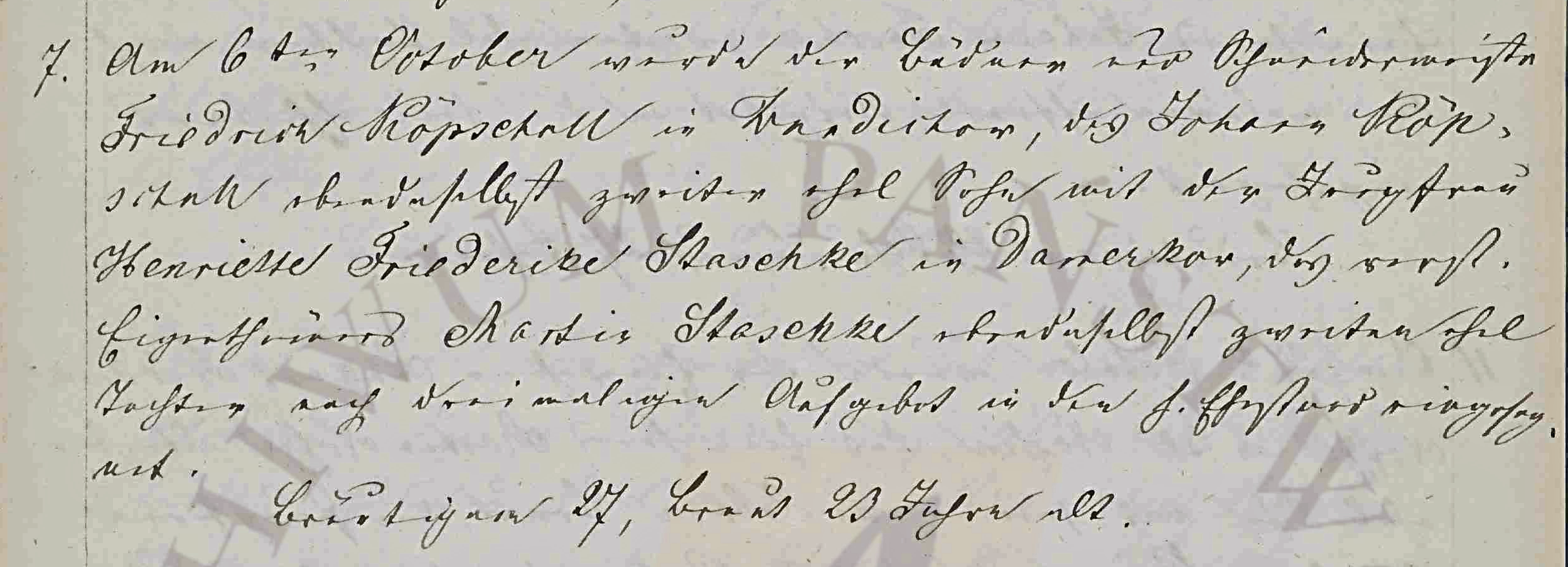
I keep revisiting this Kebschull/Kopscholl line (spelling is fluid at this time) because I'd really like to connect them to our own family of Kebschull folks if at all possible. It would neaten things up nicely and it would allow us to add in a lovely family portrait from Chicago of Gustav Kebschull, son of the two in the marriage record above.
“Citation: Digital images, Archiwum Państwowe w Szczecine (Staatsarchiv Stettin), marriage record for Friedrich Kopscholl and Henriette Friederike Staschke, 6 Oct 1854 in Groß Nossin. Kreis Bütow, https://www.szczecin.ap.gov.pl/media/arch/65/147/0/09/5888/65_147_0_09_5888_0087.jpg , accessed 27 April 2024.).
So far the connection is unproven, although it seems that all the Kebschull families (no matter how it was spelled) from Kreis Bütow must have connections with each other. Several of them are connected and documented through our Lübeck family, and they keep showing up as godparents to various Lübeck-related offspring. But this record (above) is helpful only up to a point.
Friedrich, born in Wundichow and son of a Johann Kebschull, married Henriette Friederike Staschke (daughter of Martin Staschke) from Damerkow on 6 October 1854. The bridegroom was 27 years old, so born about 1827; the bride was 23 years old, so born about 1830. This is a little early to find Groß Nossin records, the parish generally used by these families. Those records date from about 1832 onward.
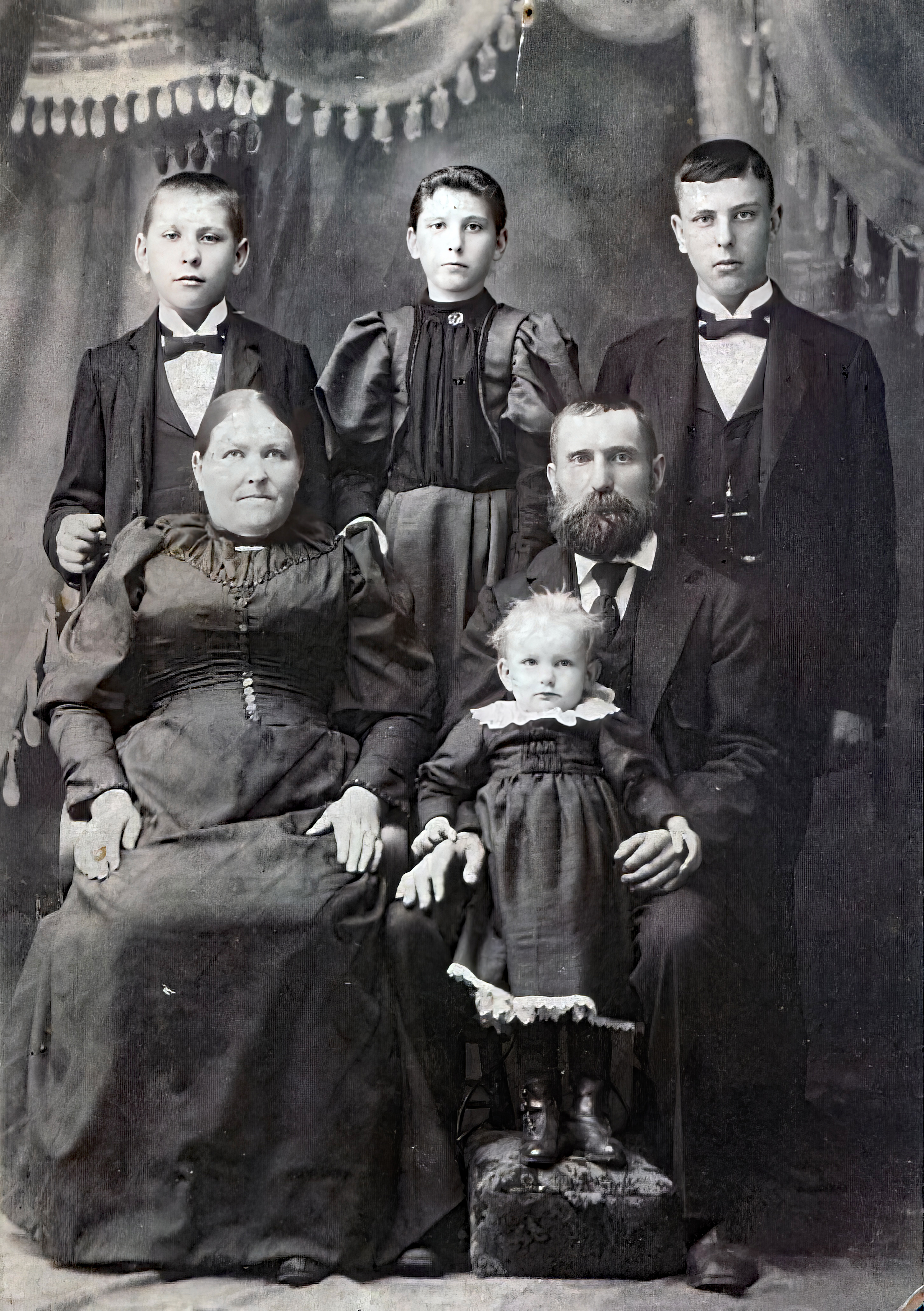
We do know that several of the Kebschull men who emigrated to America in the 1880s through 1923 listed their home town as Wundichow, so that's helpful. Some went to Bridger, Montana, another family to St. Joseph, Berrien County, Michigan (ironically where our Gaul family from Kreis Bütow ended up...any influence on emigration patterns, I wonder?). The Montana Kebschulls wanted to homestead, so that was a good place for them. The St. Joseph Kebschulls were machinists and police officers, so that was likely a sensible place for them.
Friedrich and Henriette had at least one child, probably more. Gustav Gottlieb Edward Kebschull, born in 1858, who married Adeline Misch. They're the parents in this portrait from Chicago about 1897.
In the back row: children Leo, Alma, and Otto Kebschull. Seated: Adeline Misch Kebschull and Gustav Kebschull. In front their daughter Lena Kebschull. Are they relatives of ours or just sharing the surname?
We know that Friedrich Kebschull, Gustav's father from Wundichow, died on 5 February 1892 at age 64 years and 20 days, which matches closely to the birth year we have for Friederich, who is listed as the son of Johann Kebschull and Christine Baldt. The informant was Wilhelm Kebschull and the death record can be seen here: https://metryki.genbaza.pl/genbaza,detail,371916,165, so that's helpful.
But the currently available parish records don't go back far enough to tell us about Johann Kebschull's parents, which would be essential in any attempt to connect him to the Kebschull family we already know via research in the parish records. A marriage record might help, a baptism would be better. But unless a new cache of records is found we're unlikely to find anything useful.
The next step will be to look for siblings of Gustav Kebschull in the 1850s. If Gustav is listed in the Groß Nossin records, it's likely that other children (assuming there were others) will be there too. Maybe some godparents' names will point to a link between these families, if we're lucky.
27 April 2024 | Email your comment.
A family affair: two Gohl baptisms, 1816

This portion of the Groß Tuchen records for 1816 shows two notable baptisms for July 1816. First is the baptism of August Gotthilff Gohl, son of Johann Christian Gohl and his wife Maria Grulich, followed by Ernst Albert Kramp, son-in-law of the couple above, his wife Dorothea Gohl, and their son Ernst Albert. August was techically the uncle of Ernst Albert although they were only three days apart.
“Citation: Digital images, Archiwum Państwowe w Szczecine (Staatsarchiv Stettin), baptisms for August Gotthilff Gohl and Ernst Albert Kramp, July 1816 in Piaschen. Kreis Bütow, https://www.szczecin.ap.gov.pl/media/arch/65/147/0/09/5884/65_147_0_09_5884_0045.jpg and https://www.szczecin.ap.gov.pl/media/arch/65/147/0/09/5884/65_147_0_09_5884_0046.jpg, accessed 19 April 2024.).
You can view the entire pages by clicking on the citation links. The families lived in different villages: the Gohls in Trzebiatkow, Bütow, Pomerania and the Kramps in Gross Massowitz nearby. What's interesting in particular is the godparent Martin Ernst Gohl, who is listed for baby Ernst Albert's record as "Bruder das Mutter," brother of the child's mother. So we have another family member in the Gohl constellation.
Dorothea had other siblings, so where does Martin Ernst Gohl fit in? To find that out we have to use the helpful Globalindex from the Stolper Heimatkreise e.V. website. The Globalindex won't take you directly to the information you need but it will tell you how to get there, more or less. And there are two interesting records around this same period that give us a clue about the Gohl family.
The Groß Tuchen records for baptisms in this period are photographed in two parts: introduction on the left-hand side of the page and details on the right. Knit them together and you have the whole story. Martin Ernst Gohl appears in 1815 and 1817 as a godparent to a child and the notation helps us figure out who he was.
- https://www.szczecin.ap.gov.pl/media/arch/65/147/0/09/5884/65_147_0_09_5884_0037.jpg and https://www.szczecin.ap.gov.pl/media/arch/65/147/0/09/5884/65_147_0_09_5884_0038.jpg
- https://www.szczecin.ap.gov.pl/media/arch/65/147/0/09/5884/65_147_0_09_5884_0057.jpg and https://www.szczecin.ap.gov.pl/media/arch/65/147/0/09/5884/65_147_0_09_5884_0058.jpg
In both cases Martin Ernst is listed as the "Altester Sohn," eldest of the "Pachter" or tenant Johann Gohl. We're lucky too that we already know the birth year of the mother Dorothea Gohl from her 1815 marriage record -- some kind clerk was nice enough to note it in the margin of the record. Dorothea was born in 1795, before we have access to Groß Tuchen records. Was Dorothea the oldest child of Johann Christian and Maria? Maybe, maybe not, but at least we know now that Martin Ernst was their oldest son. To perform as a godparent required the candidate to be at least eighteen years old. So this suggests that Martin Ernst was born in the 1790s just like his sister Dorothea.
This is admittedly an indirect way of determining how Martin Ernst fits into his own family, and we may not be able to tie this down further. The Globalindex doesn't include a death record for Martin Ernst, so we can't verify his birth year based on his age at death. At least not yet. The Globalindex isn't comprehensive. It may take some traipsing through the Groß Tuchen records page by page to locate records relevant to him. But sometimes that's what a reasonably exhaustive search requires.
19 April 2024 | Email your comment.
Gohl/Gaul: new families, new facts

While I've known for a month or two about this new family name, I'm still working through the Groß Tuchen archival records to find out what I can. It's led, interestingly, to another immigrant family in St. Joseph, Berrien County, Michigan. A combination of autosomal DNA testing and plain old documentation provided exciting new results.
“Citation: Digital images, Archiwum Państwowe w Szczecine (Staatsarchiv Stettin), death record for Johann Christian Gaul, 22 July 1830 in Piaschen. Kreis Bütow, https://www.szczecin.ap.gov.pl/media/arch/65/147/0/09/5884/65_147_0_09_5884_0452.jpg, accessed 12 April 2024.).
Surnames can transform over time due to the whims of orthography. Before about 1900 you simply can't rely on any concept of "correct" spelling because there isn't one. That's why the surname I'm researching, Gohl, has to include searches for Gaul as well. The family name was spelled both ways.
Groß Tuchen records have not been preserved prior to 1800 so any members of this family born before that year require more creative approaches in research. Sometimes we're lucky. When Dorothea Gohl married Paul Kramp in 1815, some enterprising clerk noted her birthdate in a marginal aside. It s the little things that help us along.
So do death records, like the one above for Johann Christian Gohl/Gaul, who died in 1830 in Piaschen, a southern village in Kreis Bütow. The record gives his age, 63 years old, so we can calculate his birth year as 1767 or 1768. We can see his widow's name, Maria Grulich, so that's helpful. So is the indication that he left nine children. Now we have a goal to fill in the family tree for this group...and maybe we can locate some cousins who descend from the Michigan Gaul families who don't yet know of our connection. Connections can lead to more information and that's always a plus!
12 April 2024 | Email your comment.
Focus on the details
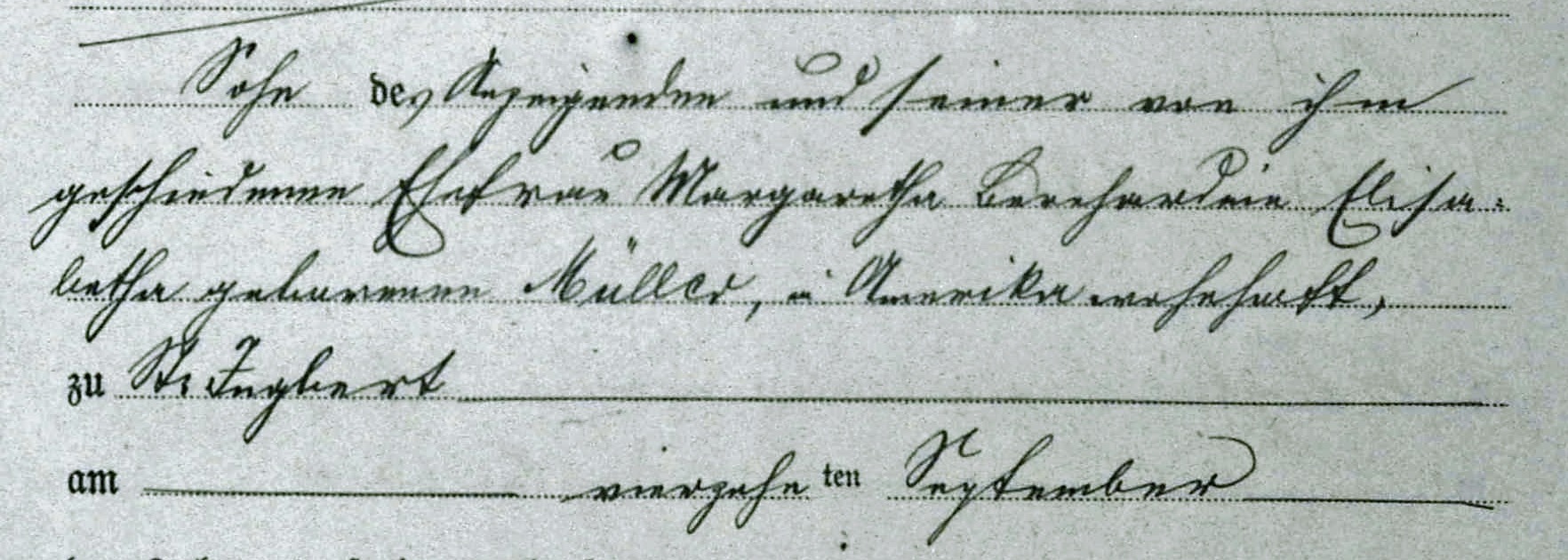
That's a corollary to my favorite quotation from genealogist Elizabeth Shown Mills, "Focus on the documents." There are details hidden in plain sight in the whole document. Focusing on the description of the deceased's mother tells us something we didn't know -- a fact that's vital to this family story.
So what was Margaret doing all that time?
“Citation: Ancestrylibrary.com, California, U.S., Carl Theodor Rinck in the Saarland, Germany, Deaths, 1876-1933, St. Ingbert parish, database and digital images, (https://www.ancestrylibrary.com/: accessed 7 April 2024).
The father, Carl Rinck, was the informant in the death of his son Carl Theodor, who died at the age of eighteen in 1902 in Germany. Carl Theodor is identified as a "Kaufmann," a merchant, but he was not yet married. Carl's father was a railway station official. What about Carl Theodor's mother?
Margaret Müller Rinck is identified as the divorced wife ("Geschiedene") of Carl who was in 1902 living in America. This was a surprise to me. Divorce was unusual at the time, and probably more involved considering that Carl Rinck was a German citizen and his ex-wife Margaret was American. Who knows how it was accomplished?
But it does explain why Margaret is never enumerated in any U.S census with Carl, nor with most of her children. If we dig a little deeper we can find Margaret as a housekeeper or matron of the Lancaster General Hospital in Lancaster, Pennsylvania beginning in 1901, working along side her sister Adeline Katherine Müller, who was the head nurse of the facility.
Two of Margaret's daughters lived in the U.S., Jennie, who was born in Germany and emigrated to the U.S. in 1902, and Julia, who according to the census records was born in Charleston in 1889. This complicates the story. Was Margaret back in the U.S. permanently when Julia was born? Or did she go back to Germany and return sometime in the 1890s?
Margaret died in 1923 after a career at the hospital and later as a music teacher in Chicago, where she was living with her daughter Jennie at least as early as 1910. Margaret's obituary says she had two daughters and three sons still living when she died. We have to assume that the sons stayed in Germany but there's no way to determine it.
Margaret left more mysteries than we can solve from the available records. But that doesn't stop our questions.
7 April 2024 | Email your comment.
Rebuilding a family
This is a tough research project because many of the essential records have not yet been digitized. Some exist in online repositories, so we have a partial reconstruction of the family of Carl Rinck (1847-about 1902) and his wife Margaret Müller Rinck (1853-1923). But it's complicated by the fact that some of the family was born and remained in Germany and some emigrated to the United States.
Margaret (Margaretha Louisa Berhardine Müller) was the fifth child and second daughter of my great-great-grandparents the Rev. Ludwig Müller and Caroline Laurent. All these children were born in New York or Charleston, South Carolina, the latter city where their father was a Lutheran minister for fifty years from 1848 to 1898. Two of the daughters were musical -- Margaret and her younger sister Jennie (my great-grandmother). As a result, as teenagers they were sent to Germany for their musical education, and to presumably return at some point. Margaret did not return for years, having married in St. Ingbert parish in Zweibrücken in 1872. Jennie did come back and married merchant William G. Jatho in Charleston in 1887.
So what was Margaret doing all that time?
“Citation: Ancestrylibrary.com, California, U.S., Carl Theodor Rinck in the Saarland, Germany, Deaths, 1876-1933, St. Ingbert parish, database and digital images, (https://www.ancestrylibrary.com/: accessed 3 April 2024).
Margaret was establishing a family of her own in Germany. Carl Rinck was a railroad station official, son of a doctor, Johann Jacob Rinck and his wife Carolina Friederike Lindemann. There are no census records from this time in Germany and it appears that all the children, with one exception, were born in the region around Zweibrücken. The couple's last daughter, Julia, was born in Charleston.
It's unclear who the other children were. We only know of two others: Carl Theodor, born in 1884 and died in 1902, whose death record is available as an image on this page (and which can be enlarged with a click of your mouse), and Jennie Elenor (1882-1945), who returned to America around 1902 and lived with her mother Margaret until marrying James P. Christensen in 1912.
Margaret's 1923 obituary in the Charleston Evening Post clearly indicated that the couple had six children, five of whom were still alive in 1923, three sons and two daughters, according to the extensive write-up of Margaret's life. So we know of the two daughters, Jennie and Julia, plus the deceased son Carl Theodor. We're missing three sons who probably stayed in Germany, and we're likely to miss them until more records from St. Ingbert parish are digitized.
Interesting to note that Margaret and her sister Jennie twice had their lives revolving around each other. Jennie didn't need to travel abroad into the unknown in the 1880s to study music in Zweibrücken, because her sister was already there with her own family. And when widowed Jennie Jatho moved with her own brood of four children from Charleston to Chicago in 1910 (a relocation likely required by the family's need to hide a daughter's illegitimate pregnancy), Margaret was there too with her own daughter Jennie and a passel of music students.
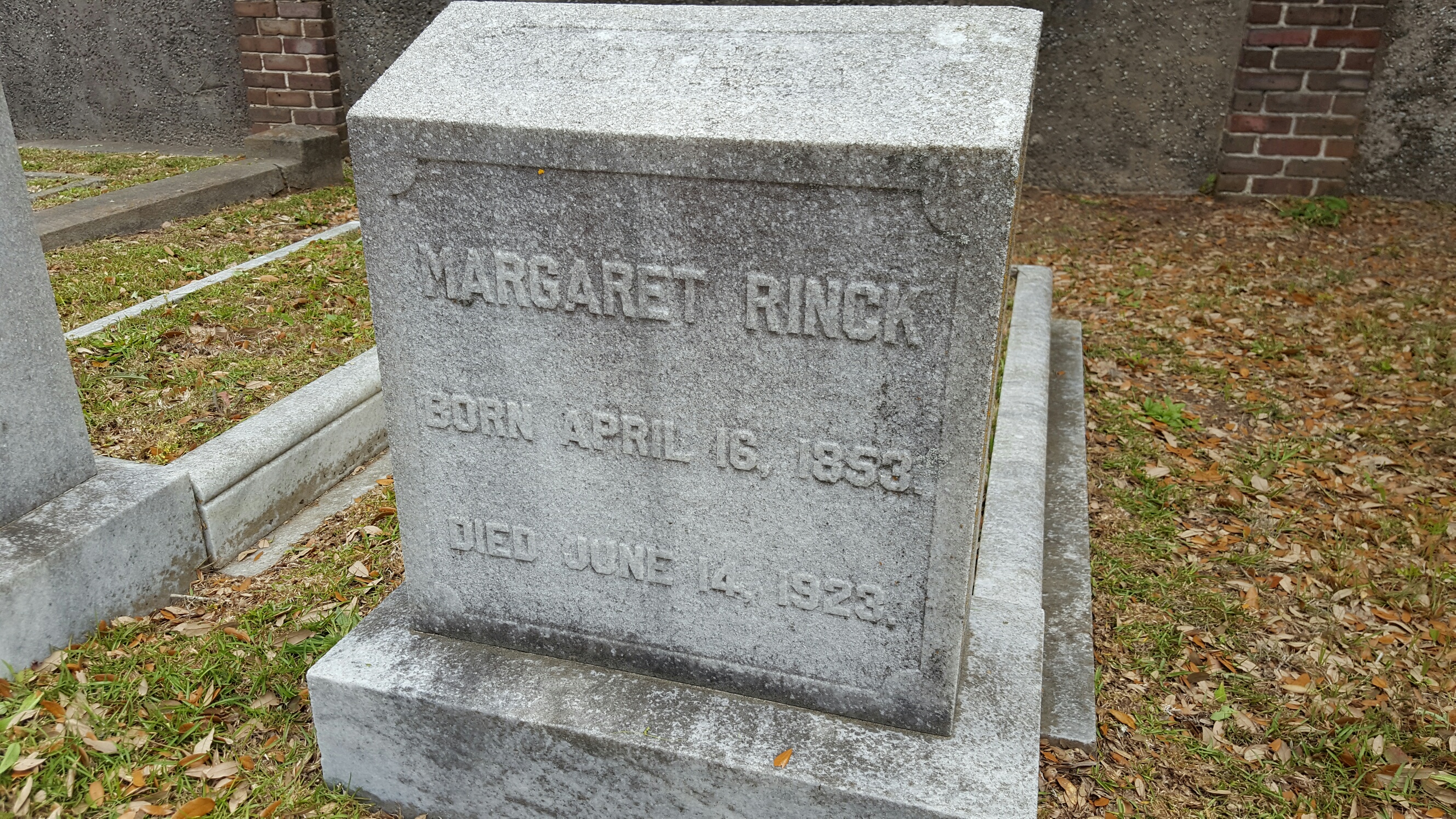
Margaret died in 1923 in Chicago, where she had already lived as a widow on North Avenue for some years. Daughter Jennie was in Spring City, Utah with her husband and family, while Julia had married Samuel Beckley and settled in Charleston.
But Margaret's obituary indicated that her wish was to be buried with her own parents in the Müller family plot back in Charleston's Bethany Cemetery, and that's where her headstone rests. At some point we hope to have Margaret's family properly researched and completed.
3 April 2024 | Email your comment.
An unexpected surname

My Bruns ancestors emigrated from Oldenburg to Cincinnati in 1844. Reasons for the emigration are unknown but Cincinnati had a large German immigrant population so it was a likely community where they could feel comfortable. There were a plethora of German neighborhoods and publications so their children might feel at home marrying into other German immigrant families.
One daughter of Heinrich Joseph Bruns and his wife Elisabeth Grave was Caroline Frances, born in Cincinnati in 1861. She married Henry H. Sutkamp in 1881. One of their daughters, Monica, married dentist from Ohio, Chester Wood Dorsey, who was also a mayor and magistrate of Bellevue, Kentucky, where they lived for a time. It's Chester's parents that interest me, in particular because of the unexpected surname of his mother: McLachlan.
“Citation: Ancestrylibrary.com, California, U.S., San Francisco Area Funeral Home Records, 1895-1985 for Chester Wood Dorsey, Funeral Home N. Gray and Company, 1951 July, database and digital images, (https://www.ancestrylibrary.com/: accessed 18 March 2024).
My grandfather adopted a form of that surname for his own around 1914 in Chicago but this is merely a coincidental surname. Alva MacLaughlan (formerly Alfred Petersen) probably patterned his new identity after a well-known Presbyterian minister, James MacLaughlan, whose parish was located in Chicago. McLachlan was the ancestral spelling of that surname, most commonly seen in the Argyll region of Scotland. Alva had no legitimate connections to the name -- he was entirely Danish and northern German by descent. But Chester Dorsey did.
Chester's mother was Julia Ann McLachlan, daughter of Robert McLachlan and Mary Slater of Ohio. Robert is listed in various databases as a Union soldier during the Civil War, although I haven't found him in any census records for that period. Julia, his daughter, was born about 1847 and married Alonzo Avery Dorsey. Their son was Chester.
It's fun to have someone in the family tree who came by that name legitimately. So if a DNA match ever turns up with the surname McLachlan associated with it I won't get too excited. It just the past playing tricks!
18 March 2024 | Email your comment.
New surnames in the mix

The preservation of some early records from the Lupow region of Pomerania has resulted in some helpful discoveries, particularly in the small villages in the vicinity that didn't have parishes of their own but used Lupow as a convenient resource.
The record above is one example. We were fortunate to have a death record for Christina Reddel in Ruhleben, married to Christoph Lübeck and the mother of a passel of children whom we've documented, because it gave her exact age at death: 70 years, 5 months.
“Citation: Lupow Parish (Łupawa-Lupow), "Arckiwum Panstwowe w Koszalinie" Baptisms, 1778, https://metryki.genbaza.pl/genbaza,detail,60037,51, GenBaza / AP_Koszalin-26 / Łupawa-Lupow / Łupawa_ew-Lupow / 01_1743-1786_ / _050.jpg baptism number 41, Christina Lübeck, 27 Nov 1778; imaged in Metryki Genbaza PL, database and digital images, (https://metryki.genbaza.pl/genbaza,detail,314992,69: accessed 4 March 2024).
We have to forgive the fact that she's listed as "Ernestine Lübeck geb. Reddel." According to a cousin who has researched these records extensively, the names Ernestine, Christina, and Albertine were frequently substituted for each other in these church books for reasons unknown. But doing our own due dilligence we find no other likely candidates for a Christine born Reddel who married a Lübeck -- it has to be our Christina. All her surviving children match the children known to be hers, and intriguingly the parish clerk lists her late husband as "Michael" Lübeck when we know he was Christoph. A happy accident? A clue to a new direction?
In any case that pinpoints her birthdate to sometime around November 1778, and if we're lucky we may find that curious name Michael involved in her birth. And we do! There's a Christina Reddel baptized 27 Nov 1778 in Neu Jugelow, Kreis Stolp to a Michael Reddel and a Dorothea Gowitzschen.
What I didn't notice was the record above Christina's. The very rare surname Gowitzschen appears there too, a feminine spelling of the surname Gowitzke (feminine form also spelled Gowitzken in other records). Marie Gowitzschen, married to a man named Chronst, appears as a godparent to a child born to Hans Chronst and Catharina Krzessken. Clearly Marie was a relative by marriage to this child's father. Was she also related to Dorothea Gowitzschen? Or maybe an aunt or mother of Dorothea?

Looking ahead a few years we do find an interesting circumstance. In 1780 Marie Gowisken [sic] is married to a Hans Chronst, either the same one as the one two years earlier or another Chronst also called Hans, we can't tell. But one of the godparents is Michael Reddel, Dorothea's husband. That suggests a close relationship between the two couples. And since Marie and Dorothea are having children around the same time and having them baptized in the same parish, it suggests that the two are sisters.
These are surnames that don't seem to persist in our family after the latter part of the eighteenth century, but their appearance is distinctive enough that more research is warranted to figure out who's related to whom.
4 March 2024 | Email your comment.
The disappearance of Henry Petersen
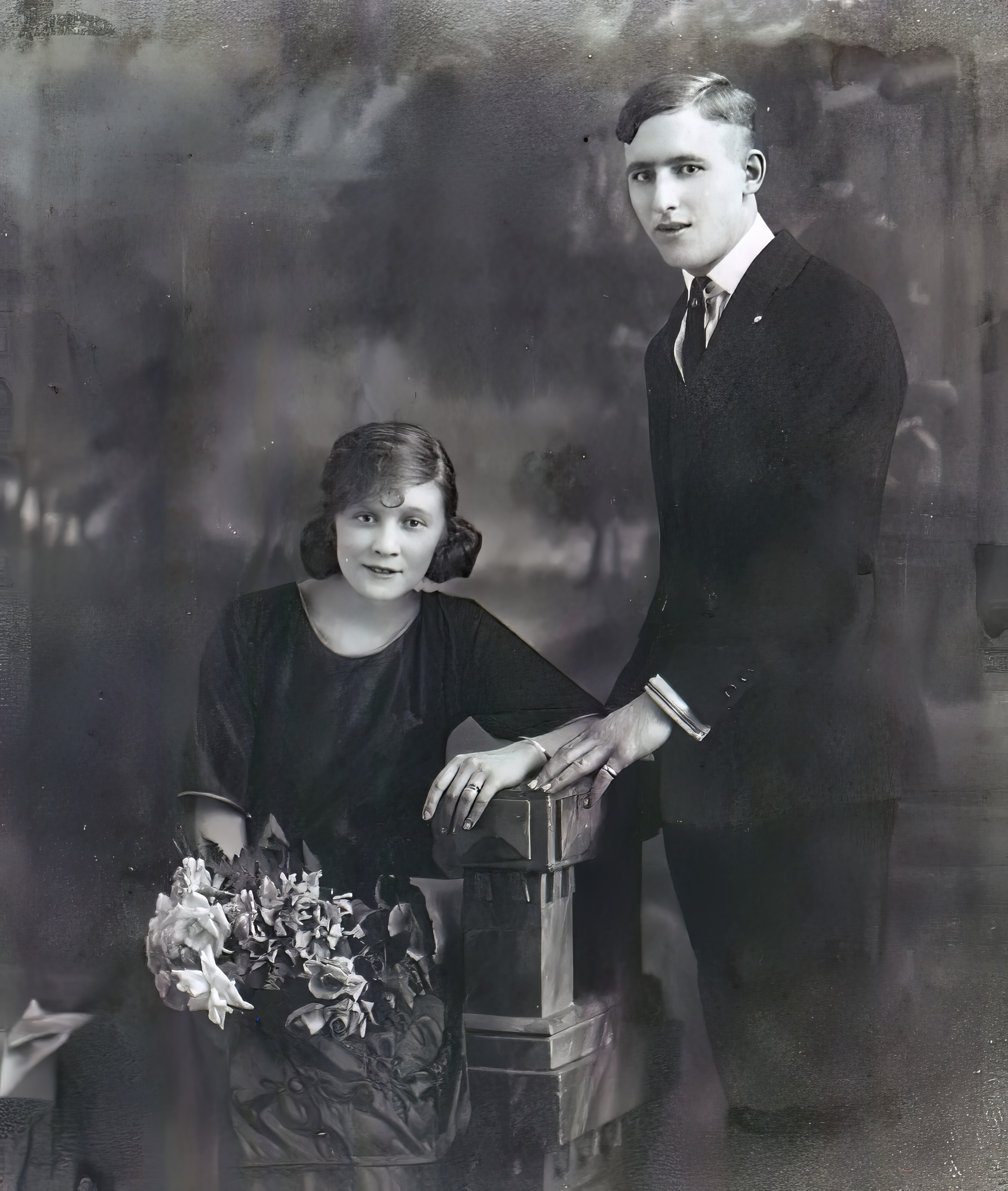
Louis Petersen and his wife Anna Majoros married in 1900 and had ten children, some born in Wisconsin where Louis worked on a farm, some born in Chicago where Louis was a laborer. Their eldest, Henry Alfred, was born in Wauwatosa in 1901. He had a younger brother, born in 1902, called Alfred Henry. This sometimes resulted in census mix-ups, but situations like that sometimes just happen and we have to keep our wits sharp and figure out who's who.
Henry Petersen and Marie Malatinka were married on March 10, 1921 in Chicago and this photo captures the after-event where the couple, dressed in current but non-wedding fashions, pose for a portrait. Marie, seated, displays her wedding ring. Henry looks nervous.
“Citation: Digital reproduction of a photograph, front side, collection of Cathie Meyer: Marie Malatinka and Henry Peteren, Chicago, Illinois 1921, original photograph from the album of the owner, scanned in 2006, accessed 25 February 2024.
Marie and her family lived in Blue Island, a suburb of Chicago, very near the Petersen home. Marie's parents, Joseph and Anna Malatinka, were enumerated twice in the 1920 U.S. federal census, perhaps caught mid-move from one location to another. The family was variously noted to be Slovak, Polish, or Austrian, probably due as much to the family's confusion about where they were from as to the changing borders of Europe. Marie came from a big family of eight children plus several lodgers.
With such family backgrounds it's surprising that Henry and Marie had only one son, Leonard Albert, born in 1922. The family was listed in the 1930 U.S. federal census with Henry listed as a Yellow Cab taxi driver.
Then Henry disappears.
Interestingly there were no further resources listing Henry after 1930: no death records, no directories, no newspaper articles. After this marriage portrait of the couple there were no other photos of Henry or his family in the Catherine Petersen Mikkelsen collection where Henry's sibling and their offspring were regularly represented throughout the 1930s through the 1950s. We don't have a clue what happened to Henry.
But Marie Petersen turns up in the 1940 census remarried to a Charles Twombly, a drugstore cook, living with Leonard Alfred Petersen in Blue Island. By the 1950 census Marie was divorced, still living at 87th Place with her son Leonard, who by this time was a milk truck driver married to a woman called Lillian. Marie was a pickle packer, a humble situation for a lady approaching her fiftieth year.
At some point Leonard and his mother Marie relocated to Florida where Marie died in 1985, Leonard in 1988. Leonard left some Petersen survivors in Chicago...but not a sign of his father Henry, whose disappearance remains a mystery for now.
25 February 2024 | Email your comment.
The case of the missing father
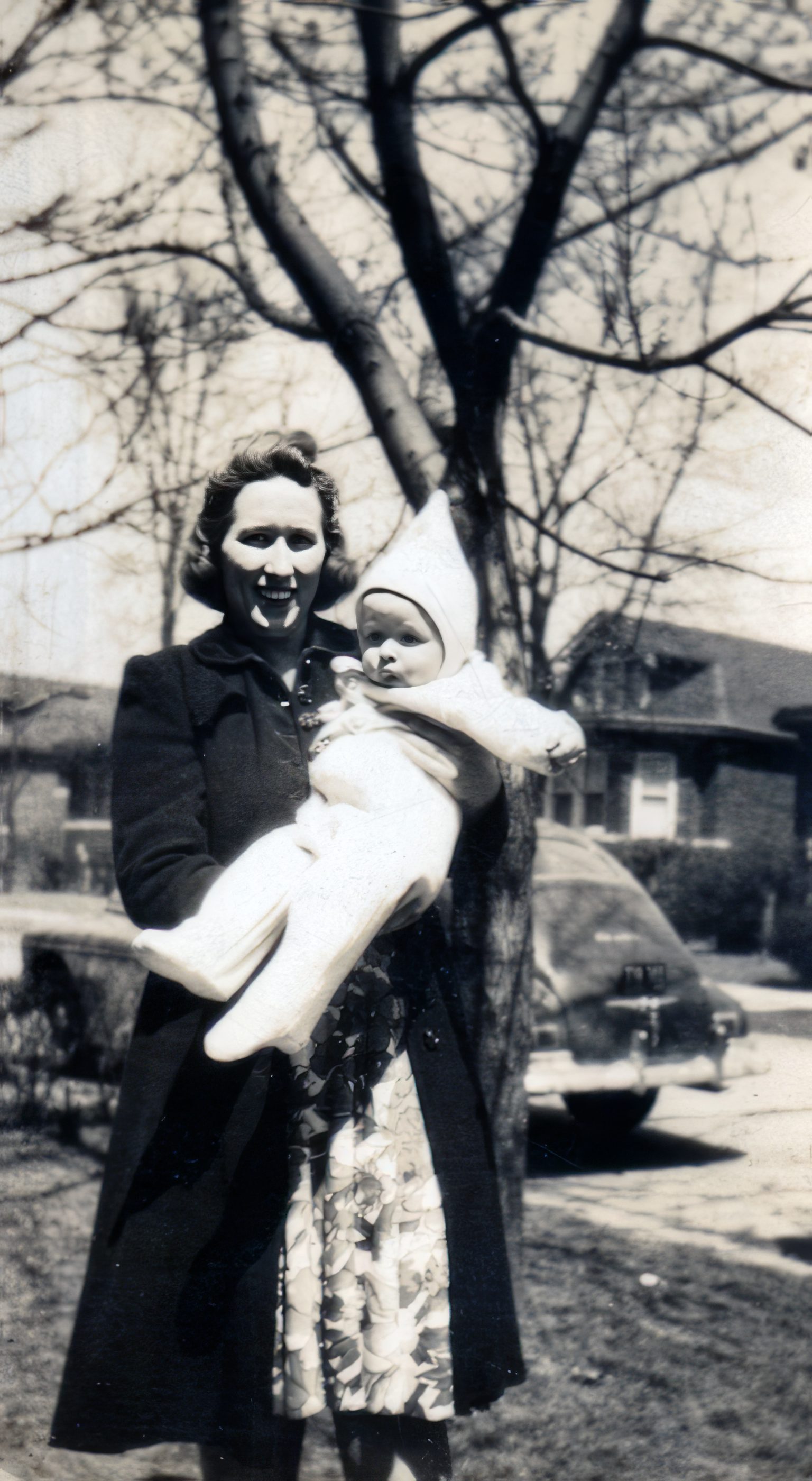
It's not that the father is missing, exactly, we just can't find him.
It's a real puzzle. Dorothy Glawe is pictured with her son Theodore John Zeltes, pictured near 83rd and Sangamon, Chicago. Ted, as he was known, was born in September 1941. That November baby Ted was baptized at the Faith Evangelical Church, his maternal family's parish. The father was listed as Theodore Aloysius Zeltes, the mother as Dorothea neé Glawe. Godparents were the infant's maternal relatives: Mildred Glawe, the mother's sister, and Harold Schultz, the mother's cousin. No Zeltes relatives appear on this document, just the father's name.
“Citation: Digital reproduction of a photograph, front side, collection of Anna Gohr Glawe: Dorothy Glawe and Ted Zeltes, Chicago, Illinois c. 1942, original photograph from the album of the owner, scanned in 2023, accessed 18 February 2024.
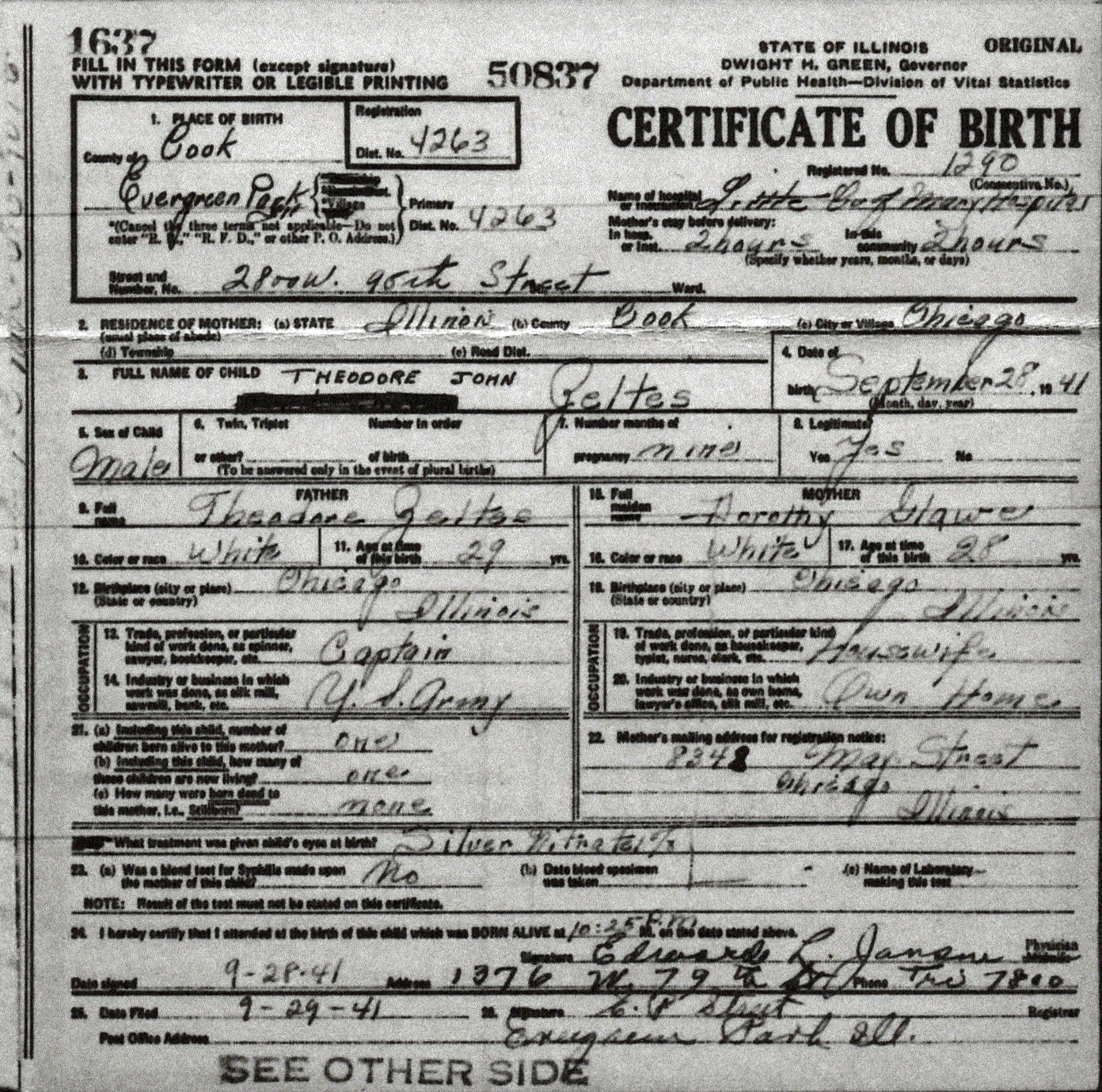
Of interest is the fact that the father's name does not appear anywhere in any online resource. There's no Theodore Aloysius Zeltes in the census for any year, in any Chicago vital records, military records, newspaper articles, city directories, or burial records. We don't even know whether Theodore Senior was present at the baptism. The baptism record doesn't tell us this and signatures of the parents were not required.
The baby's birth certificate, filed with the State of Illinois in 1941 and amended in 1950 to include baby Ted's first and middle names, identifies the father as a captain in the U.S. Army, age 29. One would expect that some database, such as the "U.S. Department of Veterans Affairs BIRLS Death File" from Ancestry.com, would have enlistment or discharge information, but nothing appears with the spelling Zeltes or any variation of that name. No Social Security information for Captain Zeltes either, a peculiar omission for someone allegedly born about 1912 and in military service in 1941.
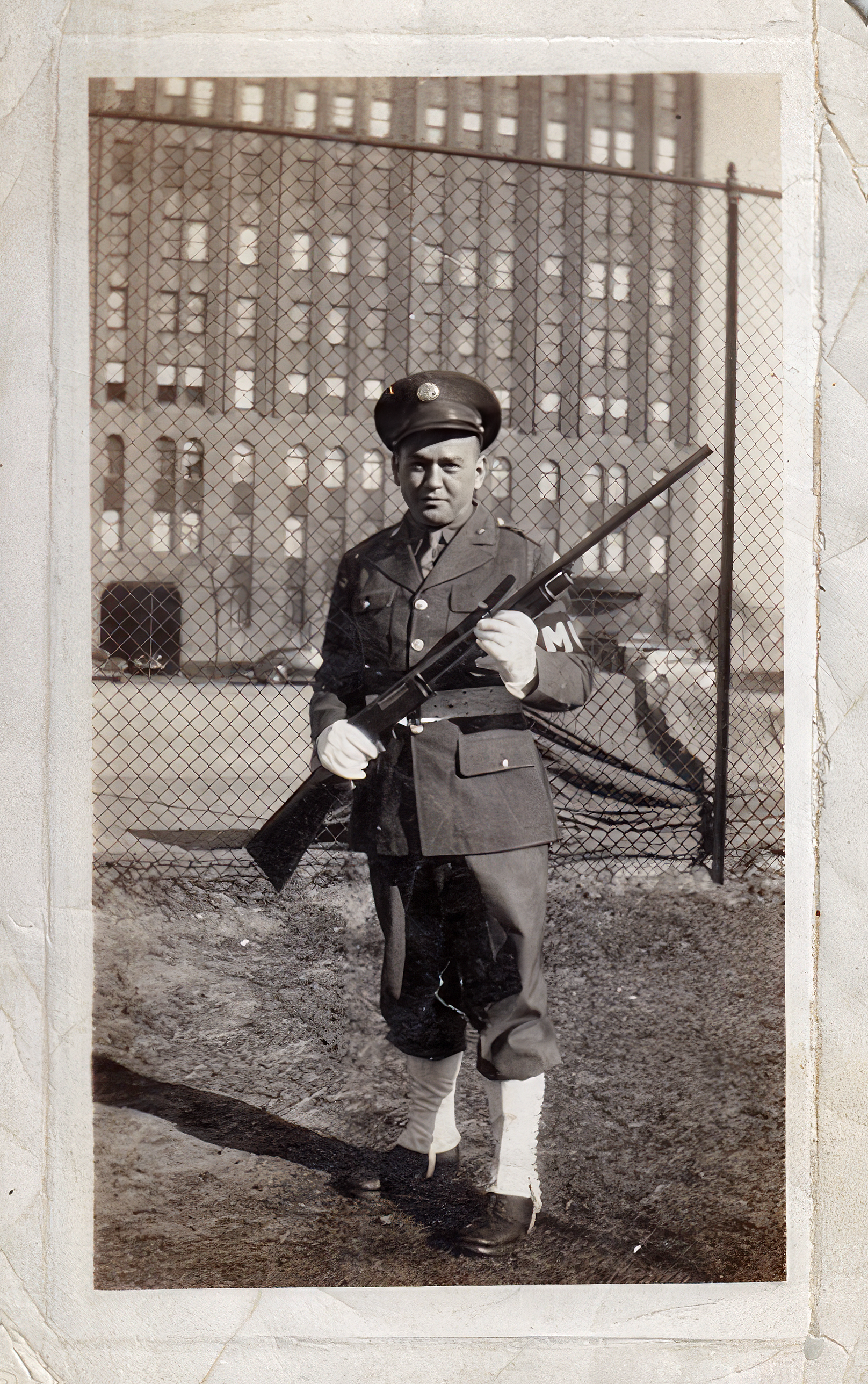
There are also no photos of the elusive Theodore Aloysius Zeltes in the voluminous Glawe photo collection: none of him with Dorothy, with the baby, or with any of the Glawe family. The only gentleman we have in the military is a photo of Andrew Bunnel Maynard (at left), who by curious coincidence was also born in 1912 and was in the U.S. Army -- not a captain but a private first class MP stationed in Chicago. Andrew was Dorothy's husband, eventually. They married in 1949 and after that young Ted Zeltes was known as Ted Maynard. A new Illinois birth certificate was issued in 1977 declaring that Andrew was baby Ted's father. Whether this was the result of a formal adoption or an attempt to correct the record we don't know.
So what's the likely story? We can find Andrew Maynard easily enough. He was born in Michigan to Romie Maynard, formerly a teacher and later a potato farmer, and Maude Harrideen. Andrew was one of nine children. He appears in census records, military records, Michigan vital records where his 1949 marriage to Dorothy Glawe is recorded, Social Security -- it's all there, just where you'd expect it to be.
The conclusion that seems most likely is that Theodore Aloysius Zeltes didn't really exist. The only two places his name appears is on baby Ted's first birth certificate from 1941 and on the baptism certificate from later that same year, both of which are official and original documents (of which we have scans) but both requiring input from a reliable reporting source.
Birth certificates issued by a city or state entity, as this one is, are considered primary sources of information, according to genealogist and historian Elizabeth Shown Mills, and are among the very best evidence available. The state of Illinois certified the information, but someone had to provide it to begin with. The physician, Edward L. Jansen, certified that he attended the birth, and a clerk, E.P. Streit, affirmed the filing of the document. But the state couldn't certify the actual father, just who he was reported to be.
Baby Ted Zeltes appeared in the 1950 U.S. federal census as an eight year old boy, Theodore Zeltes, living with his grandparents in Chicago and his unmarried aunts Mildred and Jeanete. His mother Dorothy, newly married to Andrew Maynard, lived with Andrew in Michigan when this census was enumerated. The 1950 census tells us where Ted was born, Illinois, but not the state where his parents were born. If it had provided that information it might have given us a more informative clue about young Ted's paternal origins.
I'm leaning toward the theory that Andrew Maynard was really Ted's father but for whatever reason Andrew and Dorothy couldn't marry when Ted was born, for any number of reasons: religious, social, who can say? They did officially marry in 1949 and new documents issued years later point to Andrew as the father, whether adoptive or actual. The mystery may not be solvable with the material we have available, but a good DNA test could clear up the mystery, if any of Ted's descendants were willing.
18 February 2024 | Email your comment.
Filling in the gaps
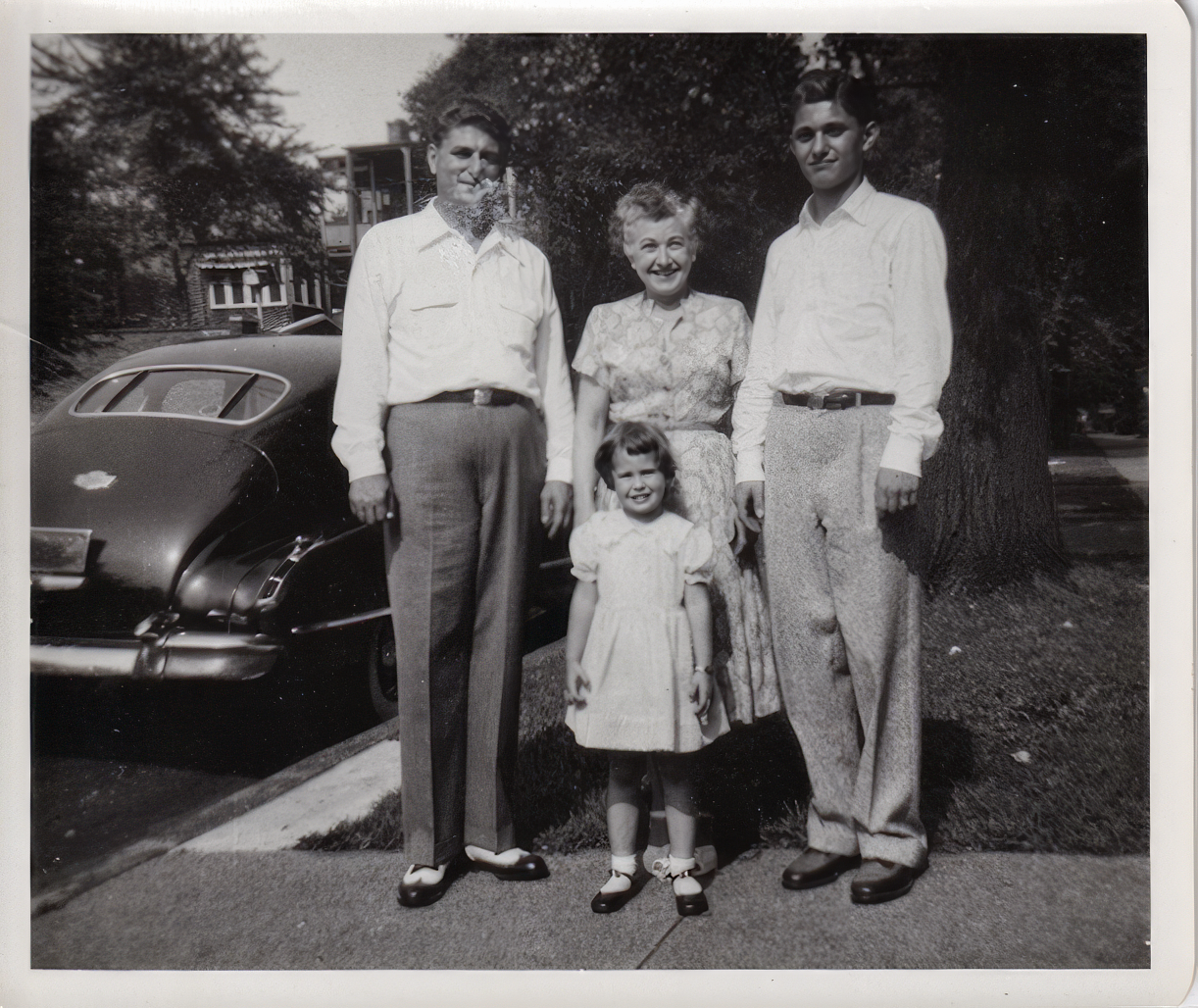
Everyone came out for the confirmation party of Ted Maynard, held in Northside, a Chicago suburb, in 1952. The family of Anna Gohr Glawe, Ted's grandmother, kept a number of photos commemorating the event as well as the after-party, which was considerably more relaxed than the official ceremony.
Sometimes a stray snapshot leads to more family research, allowing us to fill in missing information about this extended family.
“Citation: Digital reproduction of a photograph, front and reverse side, collection of Anna Gohr Glawe: Bill and Sylvia Schultz, children Wayne and Vickie, Chicago, Illinois 1 Jul 1952, original photograph from the album of the owner, scanned in 2023, accessed 11 February 2024.
Until I saw the inscription on the back of this photo I didn't know about Bill and Sylvia or their children. Bill was the son of William Charles Schultz and Ella Gohr, which puts him squarely in the Gohr lineage. Ella was the younger sister of Anna Gohr, and there's a photo from this day of Anna and Ella together.
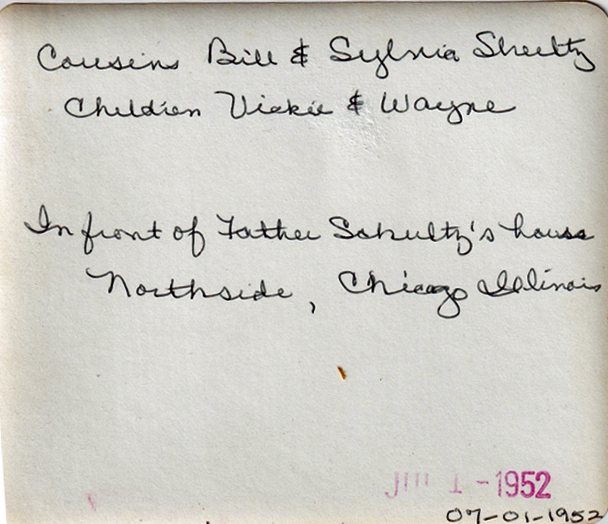
It's amazing what a carefully inscribed caption can tell those of us who inherit these old photos. Bill Schultz is on the left, his wife Sylvia in the middle, son Wayne on the right (a tall fellow for fourteen years old), and daughter Vickie in front. The caption also tells us that the photo was taken outside the home of Bill's parents' home in Northside, Chicago.
A few lookups helped us complete the tree for this family: Bill was born in 1910, his wife Sylvia Skupa Schultz (born in Chicago the same year) had a mother born in Czechoslovakia, and the children (both now deceased) were born in 1938 and 1949.
Somewhere Wayne and Vickie probably had offspring of their own who may, one day, be interested in their extensive family history for both the Gohr and Kramp families. We certainly hope they find us one day.
11 February 2024 | Email your comment.
Who knew whom?

Sometimes a baptism record reveals more than you'd expect. In this case, Maria Catharina Petersen, born in Chicago in 1899, had a very interesting godparent. And we all know what focusing on godparents can do to augment family history.
Maria Michelson, Marren Larsen, Peter Jannsen, and Clara May are all listed as godparents in this baptism record. Maria Michelson is the one we want to focus on because her presence suggests a long-term relationship with the Petersen family
“Citation: Ancestry.com, Missouri Synod, U.S., Lutheran Church records, 1851-1972 [database on-line]. Lehi, UT, USA: Ancestry.com Operations, Inc., record for Maria Catharina Petersen 31 October 1899, Saint Martini Lutheran Church [Chicago IL], 1891-1922 Baptisms, accessed 29 January 2024.
Spelling was still in flux at this time, particularly when the clerk was used to Americanized spellings of names. Maria, for whom the child was named, was Maria Hansen Mikkelsen, second wife of Thomas Mikkelsen, a name that looms large in our legend. Thomas later married the mother of this child after both of them had been widowed in the first few years of the twentieth century -- Thomas's wife Maria died in 1902, Catharina's husband Hans in 1905. It's been tempting to speculate that Hans, Catharina, Thomas, and Maria all knew each other once they were living in Chicago, and this record proves it.
We don't know where Maria Hansen was born but we do know that Hans, Catharina, and Thomas were all from the same general area of northern Schleswig, customarily known as Nordfriesland, and had been born within about twenty miles of each other. Thomas' first wife, Helene Sievertsen, was in fact a cousin of Hans and Catharina. But Helene, after a brief time in Chicago, returned to Flensburg around 1887 and her marriage to Thomas was dissolved, either officially or less so.
Thomas then married Maria Hansen in 1889 in Chicago, around the same time that Hans and Catharina relocated there from Nebraska. Thomas and Maria may also have been part of the Saint Martini parish in Chicago or perhaps made a special sojourn there to sponsor Hans and Catharina's newest daughter Maria.
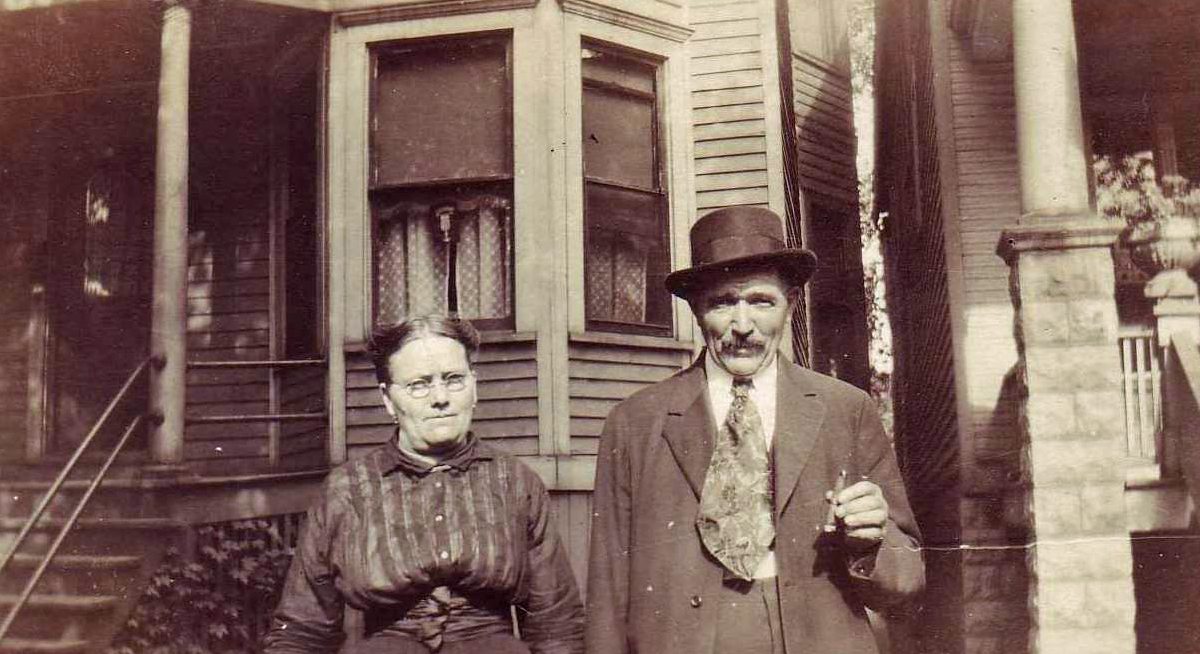
Well into middle age, Catherine and Thomas (right) married in Chicago in 1906, and wonder of wonders, they had a child of their own, Florence, in 1907, Catherine's twelfth (counting her children from her first marriage to Hans) and Thomas' seventh (after six children with former wife Helene). Thomas (divorced once and widowed once) was a mainstay of his blended family, a streetcar mechanic with a penchant for automobiles and cigars, interests that his stepsons inherited from him. Thomas even lent his name and became godparent to his stepson Alva's firstborn son, Thomas William, born in 1916.
But the question of whether Thomas was a close friend of the family seems to have been answered with this particular record. He probably knew the Petersens in Nordfriesland but certainly knew them in Chicago.
29 January 2024 | Email your comment.
A thirty-one year search

That's how long I've been looking for this record.
There were lots of things I didn't know in 1993 when I first started researching to find my grandfather's birth record. I figured that something, somewhere would reveal his background. The names of his parents would be nice. I had no idea who they were. I asked my parents and they had no information (or pretended they didn't know...that's another story!)
And for some time I'd go on not knowing who Alva's parents were. I was searching for Alva Elwood MacLaughlan, born on 24 March 1894 in Chicago, because that was the name I had and it was all I knew. I wrote to the Cook County clerk's office in Chicago with the information I had and they responded that they could find no one with that name.
This was well before online databases or even genealogical websites, so everything was conducted by regular USPS mail, and that was slow. In fact, the answer was so discouraging that I gave up for a number of years.
“Citation: Ancestry.com, Missouri Synod, U.S., Lutheran Church records, 1851-1972 [database on-line]. Lehi, UT, USA: Ancestry.com Operations, Inc., record for Alfred Emil Petersen 24 March 1894, Saint Martini Lutheran Church [Chicago IL], 1891-1922 Baptisms, accessed 21 January 2024.
Then in 2004, when I became aware of Ancestry.com, I tried again, looking for that elusive surname, but no luck then either. The one thing that set me on the right track was posting to a Genealogy.net bulletin board, and that led me to a lady who was also searching for Alva's family. Only, as we discovered, his name wasn't Alva at birth, nor was his surname MacLaughlan. A mutual cousin set us on the right track: his parents names, Hans and Catherine Petersen, and his many siblings (eleven in all, every one of them called Petersen). No wonder I'd had trouble locating him!
Our mutual cousin had his name inscribed in the family bible and she gave us a copy. The birthdate matches. She had photos of my grandfather with his siblings and his mother. She had stories about Alva wanting to change his ancestral identity. It seemed an open and shut case.
But I still dreamed about having an official document with Alva/Alfred's birth and baptism information. Primary resources are always best if you can get them, such as some official documentation affirming an event. This is firsthand knowledge proving that an event took place. Anything else (even a family bible inscription) is technically hearsay or secondhand knowledge, although such documents can be helpful in leading you in the right direction.
At this time Chicago didn't require birth certificates, although families could register a birth with Cook County if they wanted. The Petersens did not register their Chicago-born children with Cook County, but they did with their chosen parish, Saint Martini Lutheran Church. A verifiable church record is thus primary information, and that's what we've got, finally, after all these years of searching. Thanks to my cousin from my maternal side, who alerted me to this collection, and thanks to Ancestry.com for putting it online!
21 January 2024 | Email your comment.
A newly available online database yields results

The Missouri Synod, U.S., Lutheran Church records have been available for decades via repositories such as the Concordia Historical Institute, but those records have not been available online nor were they easily searchable. Finding a relevant record required contacting the Institute and requesting a lookup, which may or may not have yielded results depending on the workload of the Institute.
But Ancestry.com has recently acquired the database, fully searchable, and that's a plus. It helps to know that these records are not necessarily only available for events that took place in Missouri. Any Lutheran church that belonged to the Synod could have records in this database. It's worth a try to see what you can find.
“Citation: Ancestry.com, Missouri Synod, U.S., Lutheran Church records, 1851-1972 [database on-line]. Lehi, UT, USA: Ancestry.com Operations, Inc., record for William Schulz and Ella Gohr 20 June 1909, Saint Matthew Lutheran Church [Chicago IL], 1884-1952 Marriages, accessed 9 January 2024.
In our case a cousin who is also researching Gohr surnames ran across this record, which records the marriage between William Schultz and Ella Gohr. Ella is our direct ancestor, one of the daughters of the late Wilhelm and Laura Gohr of Chicago. This record gives us information we didn't have previously.
The record gives William's father's name (Karl, deceased), his exact birthdate and place of birth, as well as Ella's birthdate and the confirmation of her late father's name. The witnesses are mostly unknown at this point although they must have some connection to the family. Sarah Schultz may be a mother or sister of the bridegroom.
For Ella the notable witness is Hertha (later Bertha) Gohr, her older sister. The church clerk also included the marriage certificate number, a helpful detail in case we want to order the license from Cook County at some point. Familysearch.org also has a record of this marriage but it's an index rather than an image. The image itself allows us to see that the entry (like all entries on this page) is partly in German, not so surprising for a church that catered to German immigrants or first-generation families.
If your ancestor was married in a Catholic church then those records won't be found here, of course. These records are strictly Lutheran (for Catholic records try the database "Birth, Marriage, & Death, Illinois, Chicago, Catholic Church Records, 1833-1925" at Familysearch.org). But if you have Lutherans in your family, this database could prove useful.
9 January 2024 | Email your comment.
Who was Aunt Lizzie?
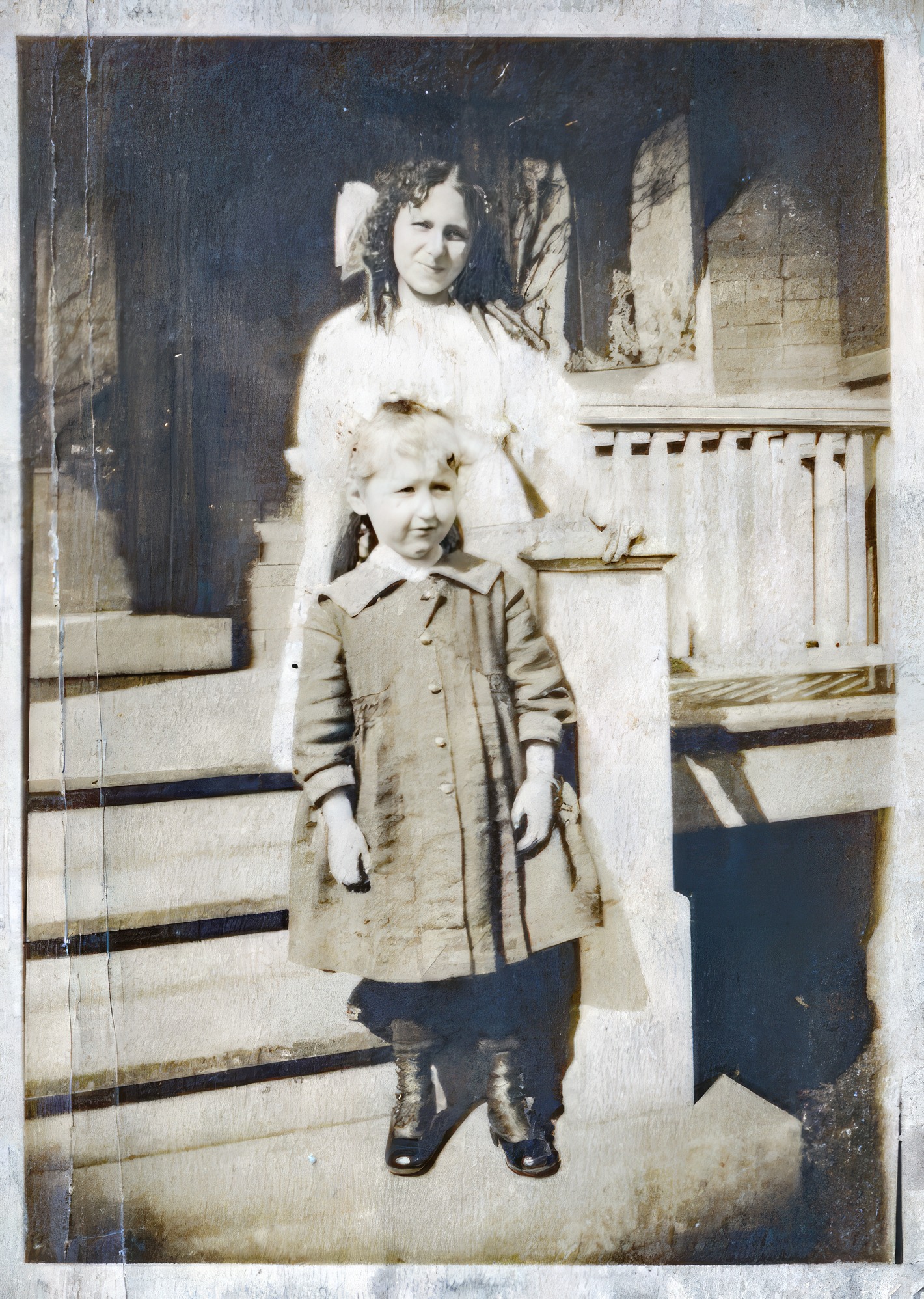
When people started taking snapshots of family members with their own cameras it provided some interesting backdrops for the image, rather than the more stiff and formal studio shots. This family photo demonstrates it: sisters Dorothy and Mildred Glawe were photographed on a front porch in Chicago about 1922.
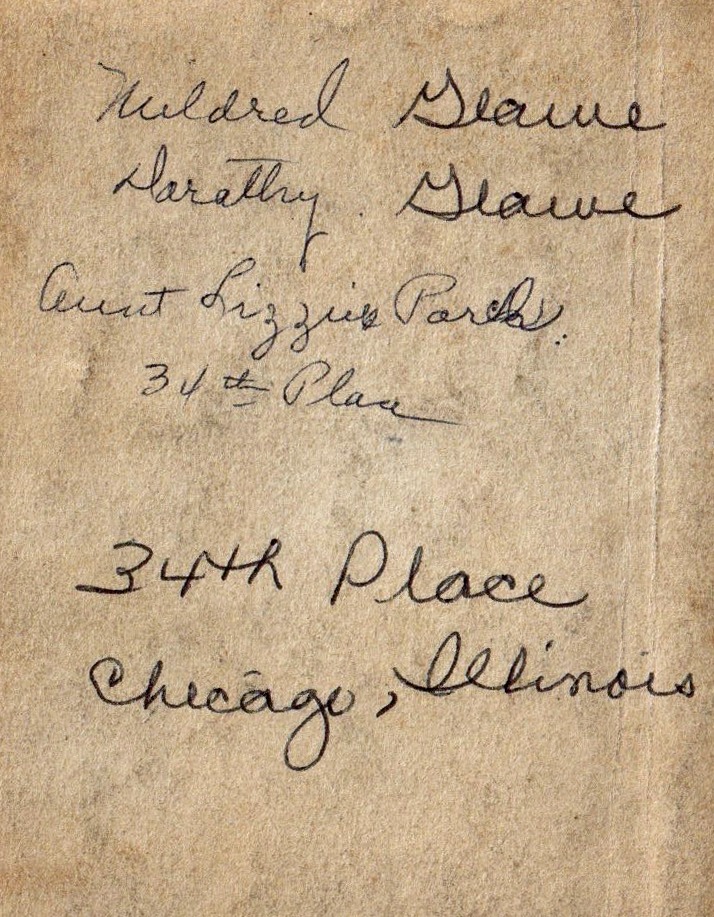
The Glawe family was remarkably keen to properly caption their photos in a helpful way. I'm not sure whether this was Dorothy's effort or her son Ted Maynard, who inherited the collection, but it's most welcome. Here we're told that the location is 34th Place on Aunt Lizzie's porch.
But who was Aunt Lizzie?
Answering this question requires going back through the database to find a good candidate. The aunt was probably related to the two girls, so likely a sister of their mother Anna Gohr Glawe or of their father John Glawe. What pops up when we look into it?
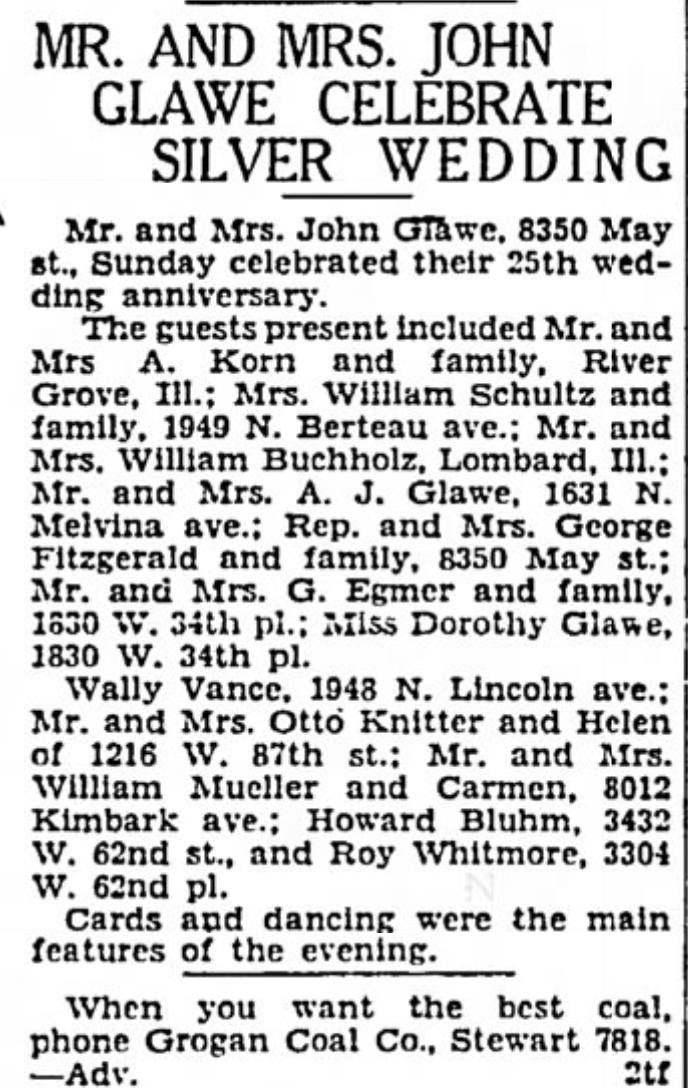
The Chicago Suburbanite Economist, Friday 14 Aug 1931 on page 7 provides an answer. The article tells us that John and Anna Glawe celebrated their 25th anniversary and hosted a large party. We know from census research that John Glawe had a sister, Elizabeth Wilhelmina Henriette Glawe, born in 1877 in Winnebago County, Wisconsin.
“Citation: Digital reproduction of a photograph, front and reverse side, collection of Anna Gohr Glawe: Dorothy and Mildred Glawe, Chicago, circa 1922, original photograph from the album of the owner, scanned in 2023, accessed 4 January 2024.
A possible clue: the Egmers. They are included in the list of party-goers as Mr. and Mrs G. Egmer of 1830 34th Place, and interestingly the anniversary couple's daughter Dorothy lived there too. So this seems a good candidate for Aunt Lizzie, assuming that Elizabeth married a man called Egmer.
And another newspaper article confirms this. Elizabeth was married to an August Egmer in Chicago in 1900, according to the Chicago Tribune for Sunday 22 Jul 1900 on page 7, which reported their marriage license application. Very helpful indeed. As a result of this discovery we can add in Elizabeth's husband and daughter to our database.
Sounds like a lovely event, and thanks to these newspaper articles we have a confirmed identification of the Egmers, how they were related to the family, and Aunt Lizzie's identify revealed.
4 January 2024 | Email your comment.
Family history in a box
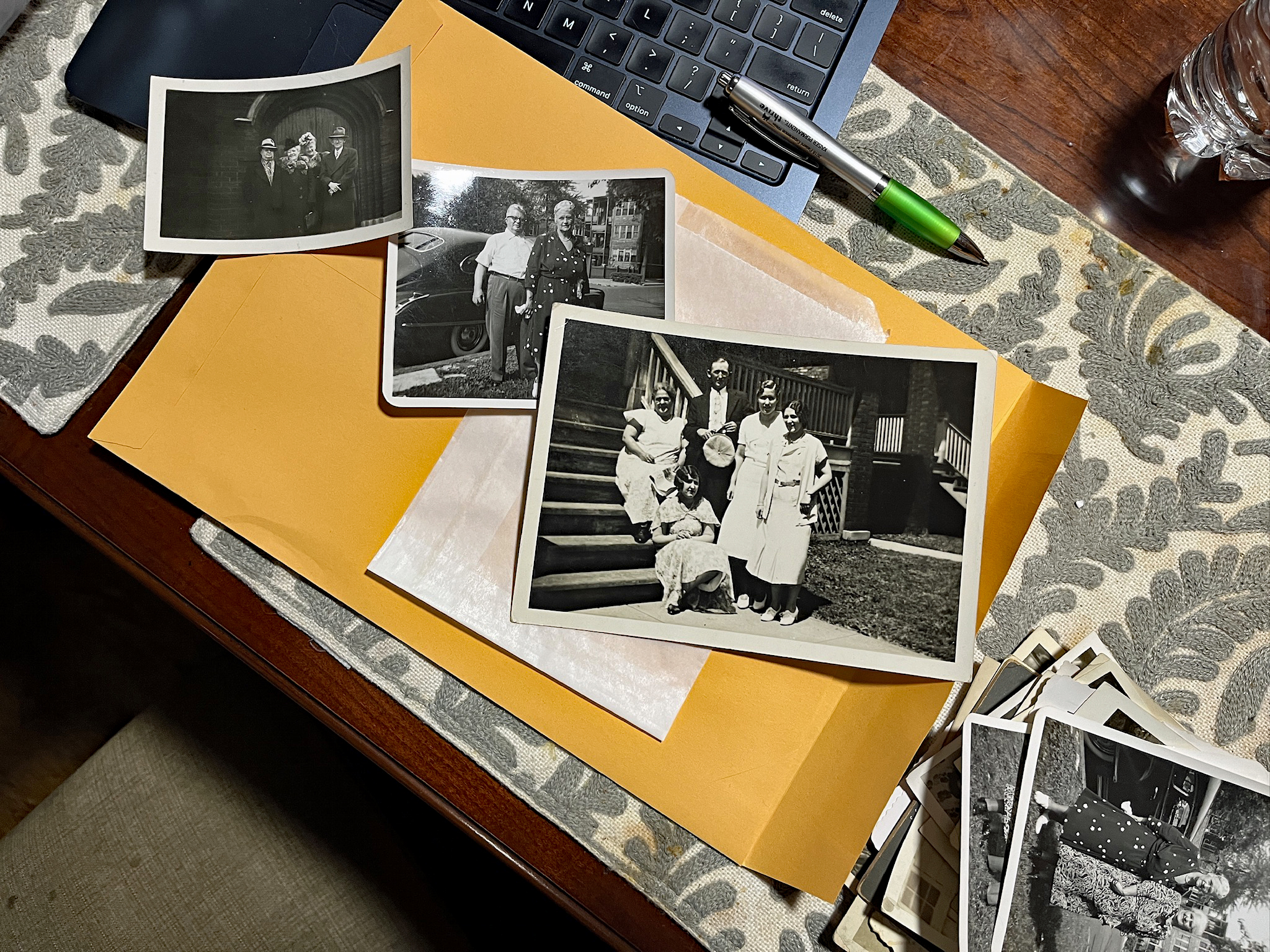
For the first time I have access to a photo archive belonging to a late cousin from my mother's side of the family. His widow kindly packaged up the images and documents and sent them on to me for processing, and there's a lot of processing involved!
“Citation: Digital reproduction of photographs, from the collection of Anna Gohr Glawe, Chicago, 1900-1970, original photographs from the album of the owner, scanned in 2023, accessed 30 December 2023.
I've been going through the collection and scanning each image, but now moving on to proper archiving, using ph-neutral glassine envelopes for proper storage, and checking to make sure that the dates and captions are correct. Remarkably whoever identified these photos has done a wonderful job.
The original owner, my grandmother's sister Anna Gohr Glawe, inscribed most of the earliest 20th century photos in her own handwriting. Her daughter Dorothy Glawe Maynard took over this detailed task over the years, and her son may have contributed. It makes my job a lot easier. In rare cases where there's a discrepancy I can use Ancestry.com to double-check surname spellings and approximate eras for the photos.
What a difference compared to other collections I've dealt with, where the owner assumed that she or some other family member would always know the identity of the photographic subject. That was probably the norm at the turn of the last century and we can't fault anyone for their assumptions. But without reliable IDs it makes sorting through family photos a lot more like an archaeological dig. This task is a pleasure!
30 December, 2023 | Email your comment.
Photographers: finding clues in the details
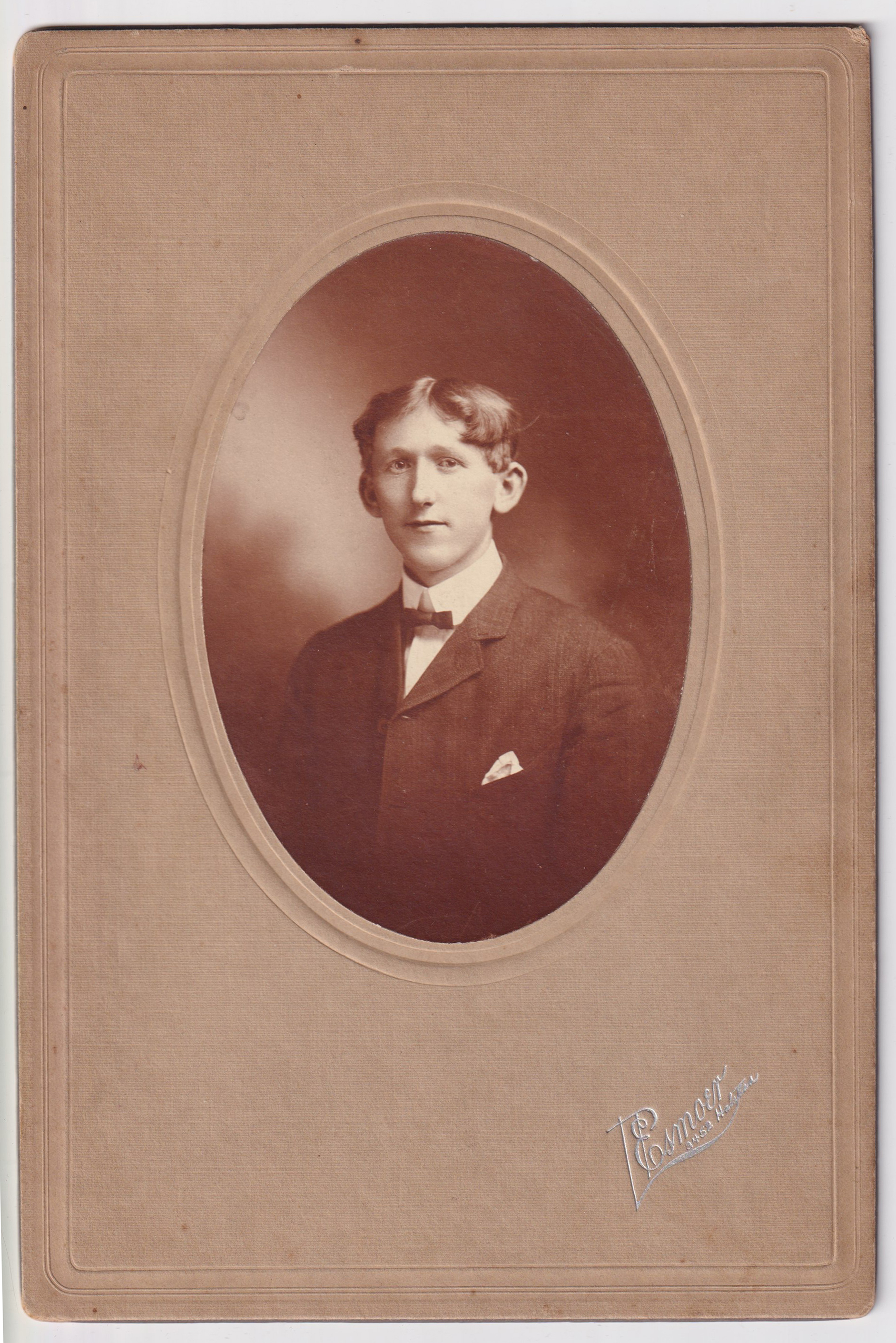
John Walter Glawe, born in 1881 in Neenah, Wisconsin, spent most of his life in Chicago, where he married one of the eldest Gohr girls, Anna, who was born in 1882 in Chicago. This nice portrait was produced in Chicago about 1900 when he was twenty...at least that's the best estimate we can give this portrait based on the apparent age of the subject and the career of the photographer who produced it.
“Citation: Digital reproduction of a photograph, front side, collection of Anna Gohr Glawe: John Walter Glawe, Chicago, circa 1900, original photograph from the album of the owner, scanned in 2023, accessed 20 November 2023.
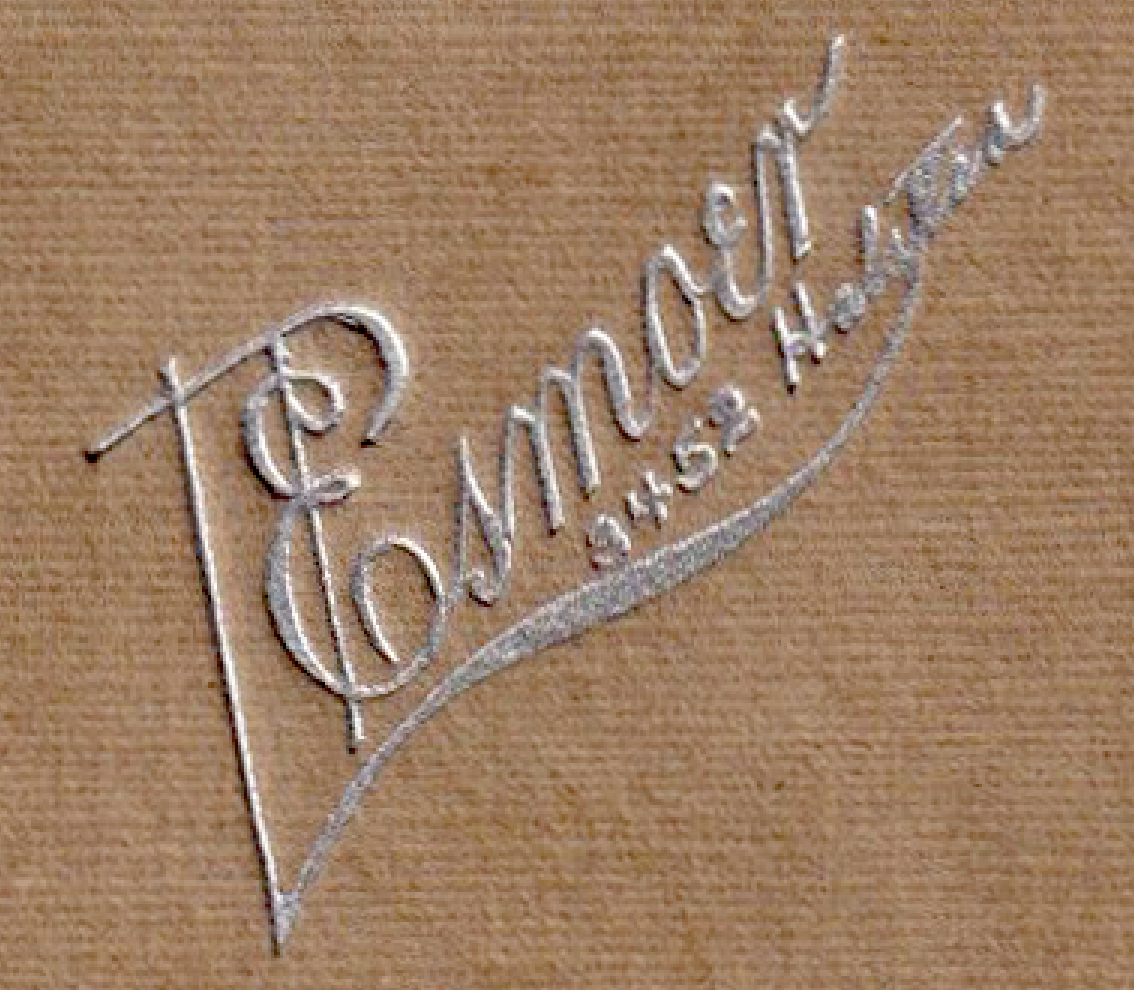
The studio was Esmoer Studios at 3452 Halsted in Chicago. According to the online directory "Chicago Photographers 1847 through 1900, as listed in Chicago City Directories" Lawrie P. Esmoer was active only in the year 1900 on Shields Street, although we find newspaper advertisements for the studio offering discounted photo prints through 1912. This logo shows the studio at the Halsted address with an impressive silver-embossed emblem on the cardboard frame. That's the address where he was listed in the 1906 Chicago city directory.
What made John Glawe's family choose Esmoer Studios? It could have been convenient pricing, or possibly the fact that Mr. Esmoer was an imigrant, like John's father Johann Glawe, who was born in Anklam, Pomerania in 1847. Was Esmoer from there too?
Interestingly not! Lawrie Esmoer was born Lars Peter Nielsen in Præstø District, Magleby Parish in 1867, with the extra surname "Esmår" noted in the baptism record. His parents were listed as Nielsen, not Esmår, which was likely added later to distinguish Lars Peter Nielsen from all the other young boys born with the same name in that parish. When Lars emigrated in 1890, he changed Lars to Lawrie and Esmår to Esmoer.
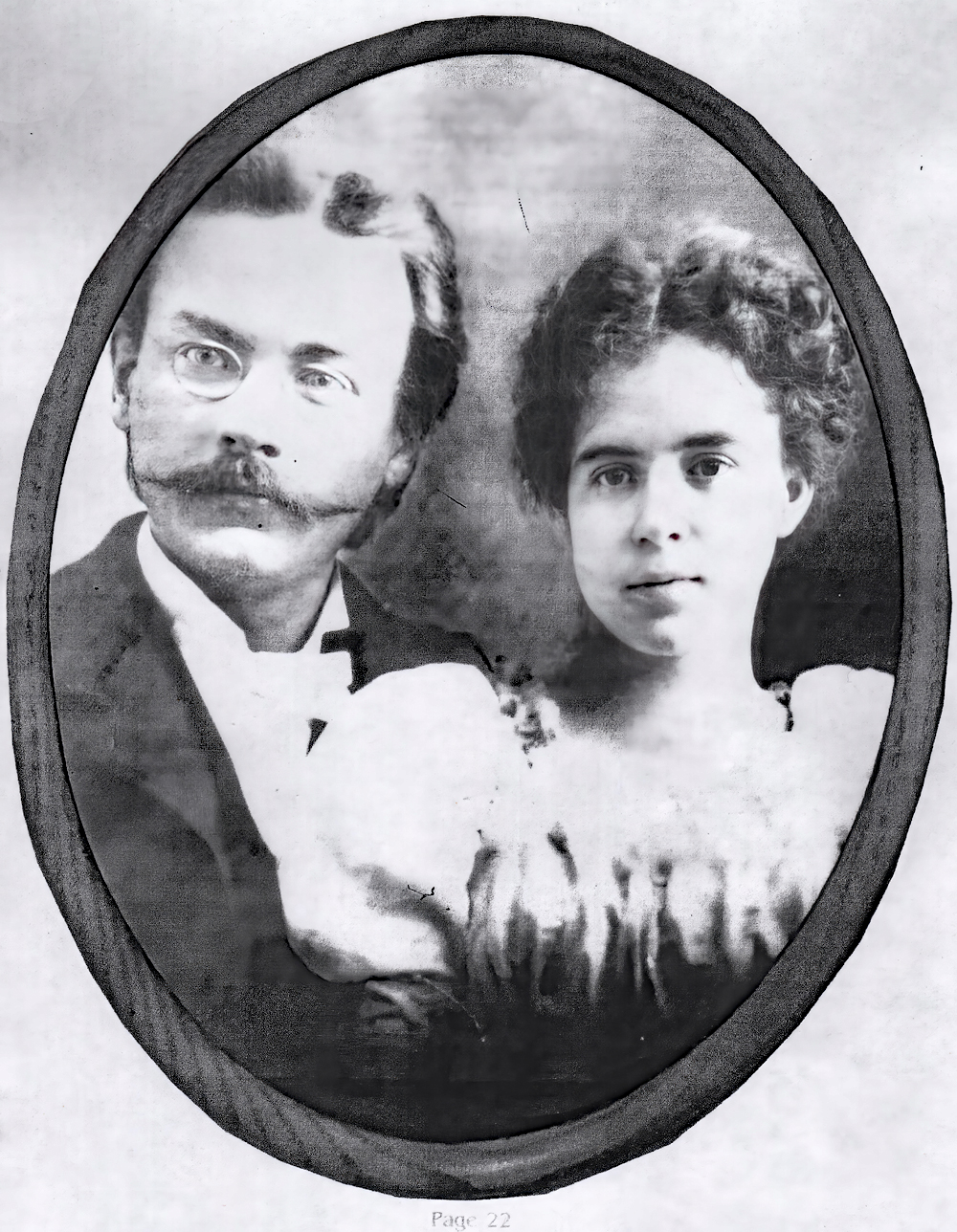
We don't normally get to see an image of the photographer himself, but in this case we're lucky. Lawrie probably took this self-portrait himself, and he looks suitably determined and professional. But while photography was an easy way for an immigrant of artistic sensibility to support himself, it may not have been sufficient to support an entire family.
Lawrie established a business in Omaha, Nebraska in 1895 but by 1898 he married Maude Patey in Chicago, with whom he had six children. He was still listed as a photographer in the 1910 census but by the 1920 census he had relocated to Indiana where he was variously listed as a farmer or a security guard. He died there in 1947, probably unaware that his earlier portraits were part of a multitude of family archives, just like the Glawes.'
20 December, 2023 | Email your comment.
Building the tree: more clues about the Kramp family


To fill out the Kramp family tree we have to apply some of the same research plans used in our previous hunt. It's like working on a puzzle sideways. Nothing exists to give us a comprehensive map of all the children of George Kramp and his wife Dorothea Gohl. If they were born after 1799 we're in luck. The Groß Tuchen books show us Christian, born in 1800 and Carl Ludwig, who was born in 1807. How about other children?
“Citation: Digital images, Archiwum Państwowe w Szczecine (Staatsarchiv Stettin), baptism for Ernst Albert Kramp, 13 July 1816 in Klein Massowitz, https://www.szczecin.ap.gov.pl/media/arch/65/147/0/09/5884/65_147_0_09_5884_0045.jpg and https://www.szczecin.ap.gov.pl/media/arch/65/147/0/09/5884/65_147_0_09_5884_0046.jpg, accessed 7 December 2023.
Well, we know about the one in the record above. George Kramp's son Paul was married to Dorothea Gohl in 1815 and their first child was born in 1816, Ernst Albert. Pieces of the family puzzle fall into place: godparents include Martin Kramp, "brother of the father" and Martin Ernst Gohl, "brother of the mother." This is much appreciated: one brother for each side of the family.
The third godparent is Dorothea Trabant, daughter of the property owner Michael Trabant. The Trabant family shows up regularly (as do the Kramp family on their registries). The Trabants were either relatives from some point in antiquity or business associates, it's hard to say. In 1853 Michael Trabant's daughter Emilie Pauline would marry Paul's son Friedrich...but that liaison would be in the future.
In any case we know that Martin Kramp was a brother of Paul, one born presumably before 1800. Can we narrow this down?
Possibly. A Martin Kramp, married to a Dorothea Grahlin and with two sons of his own (Traugott and Carl Ludwig) died in 1823, age 32 years, four months, twenty-one days, which puts his birthdate at August 15, 1790. That's reasonable. If Paul (as we suspect) was born about 1787 and was George and Anna Christina's first-born, Martin could easily have followed about three years later. And if Martin was Paul's brother, as this baptism record says, he was definitely George's son. Do we have the right Martin's death record to properly calculate is birthdate? All we can do is hope we do.
7 December, 2023 | Email your comment.
Finding clues in unexpected places


Normally it's customary to focus on records that reveal details about your own family, but sometimes clues are hidden in the neighbor's entry.
That's the case here. We know who Friedrich Kramp's parents are now, thanks to the discovery of his 1824 baptism certificate, but now we'd like to move a genration earlier. However in the Groß Tuchen parish that's not always easy. Records before 1800 may exist somewhere but they're not online and it's not clear where (if anywhere) they could be accessed. Some records are simply not in existence anymore due to fires, floods, or losses of other kinds.
“Citation: Digital images, Archiwum Państwowe w Szczecine (Staatsarchiv Stettin), baptism for Carl Christoph Meisner, 1 November 1808 in Klein Massowitz, https://www.szczecin.ap.gov.pl/media/arch/65/147/0/09/5885/65_147_0_09_5885_0133.jpg and https://www.szczecin.ap.gov.pl/media/arch/65/147/0/09/5885/65_147_0_09_5885_0134.jpg, accessed 1 December 2023.
Carl Christoph Meisner was the son of Friedrich Meisner and his wife Chatarina Jantz, with three godparents listed as was customary for this parish. Paul Kramp was one of them. He was not yet married. In this region it was common to include a godparent who had reached the age of eighteen and who had some connection to the family, such as a relative or associate, or someone who was of good standing in the community. Paul was at least eighteen and likely older, since this was not his first time acting as a godparent (his first appearance was in 1805). But this inscription is special.
It lists Paul as the "altester Sohn des Eigenthümer Georg Kramp," the eldest son of the property owner George Kramp. So George Kramp had some important standing in the community and by association so did his son Paul.
Best of all, we have a direct indication of who Paul's father was. There are no census records for Groß Tuchen, and for Paul no other records (including any death record, which is entirely missing) indicating his father's name. This is it!
We know that George Kramp the property owner (referred to this way because there were other George Kramps of other professions in the area) was married to an Anna Christina Dummerin. They were still baptizing children during the first two decades of the 1800s. Anna Christina may have been Paul's mother, unless she was a second wife of George, but we have no way to know. Paul was born about 1787 and without a baptism record we can't verify his mother. But at least we know his father now, and that moves us back another generation.
1 December, 2023 | Email your comment.
Groß Tuchen: a new landscape


This search required diving into a new realm because the Archiwum Państwowe w Szczecine (Staatsarchiv Stettin) doesn't offer indexes or search opportunities the way more popular genealogy sites have, such as Ancestry.com. Here you're on your own, and the only clues you may have are the names of the people your looking for and their relevant dates.
That's the case with Friederich Kramp, who was know for years (by me at least) only through his daughter Emilie's marriage record, and then via his own death record in 1878 in Klein Massowitz. But there are some church books online that include records for folks from this region and all it takes is the resolve to sit down and peruse them page by page.
“Citation: Digital images, Archiwum Państwowe w Szczecine (Staatsarchiv Stettin), baptism for Friedrich Heinrich Gottlieb Kramp, 12 November 1824 in Klein Massowitz, https://www.szczecin.ap.gov.pl/media/arch/65/147/0/09/5884/65_147_0_09_5884_0135 and https://www.szczecin.ap.gov.pl/media/arch/65/147/0/09/5884/65_147_0_09_5884_0136.jpg, accessed 25 November 2023.
It's right where it should be, though it's not easy to read. The books in this parish have each record written across the open pages straddling the middle binding, so the first part of the record is on the left while the continuation is on the right.
It's a nice informative entry. For the first time we have Friedrich's parents' names, Paul Kramp and his wife Dorothea (spelled "Dorath" here, the clerk's quirky rendition) Gohl, with a set of godparents: Gottlieb Sander, Gottlieb Pysall, and Anna Louisa Nehler. Godparents are often family members so it's worth remembering those names for future searches. We may run into them again.
Now we have a starting point for moving back in time. If Paul Kramp and Dorothea Gohl registered Friederich in Groß Tuchen, maybe they did so for other children. Moving back and forth through the records should give us a clue about how many children they had and when they married.
25 November, 2023 | Email your comment.
Eyes on the prize
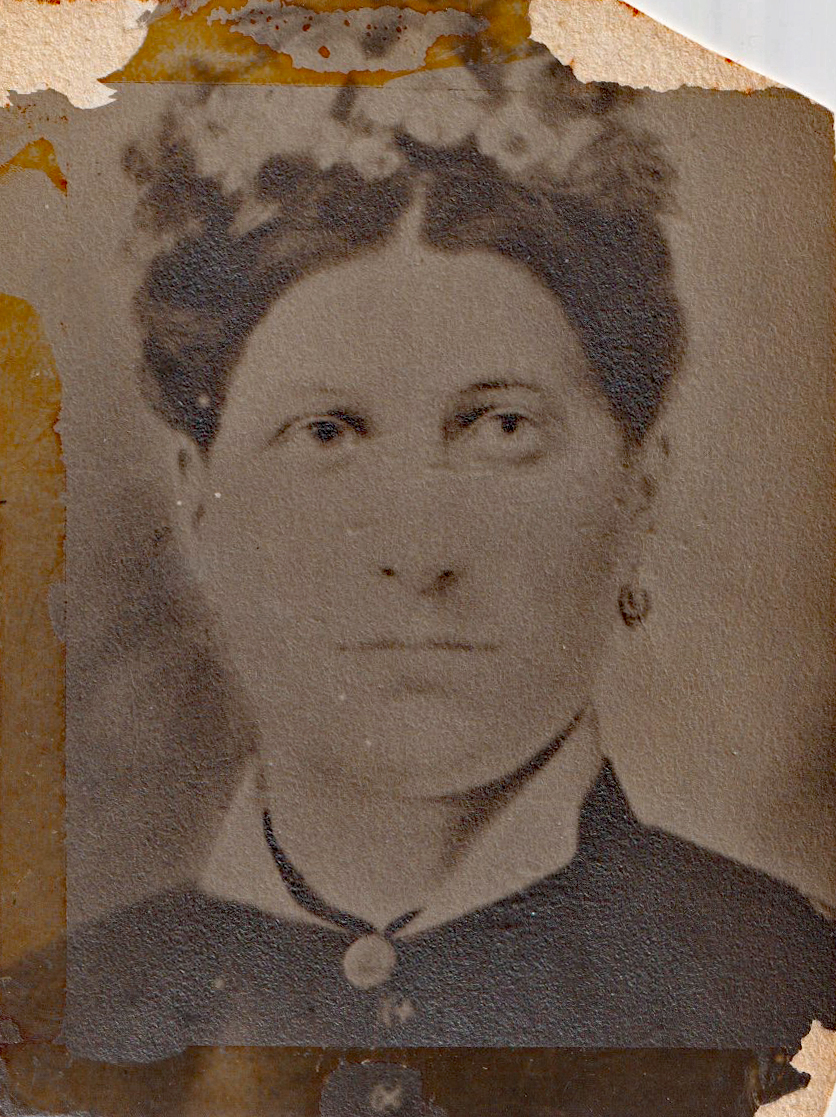
This lady is Laurette Albertine Henriette Kramp who was born in 1856 in Klein Massowitz, Pomerania. I never saw her face before. I didn’t even know that this photo existed. She’s my maternal great-grandmother who came to Chicago in 1881 to marry her fiancé Wilhelm Gohr, who had already made the crossing. Laura (as she was called) had eight children before she died in 1893 from complications of childbirth. Her latest baby, Elsa, had died six days earlier.
“Citation: Digital reproduction of a photograph, front side, collection of Anna Gohr Glawe: Laura Kramp Gohr, Chicago, circa 1885, original photograph from the album of the owner, scanned in 2023, accessed 18 November 2023.
My grandmother had no photo of her mother. None of my other relatives had one. But earlier this year I was looking around for a cousin of mine who was also Laura’s great-grandchild. He had just died a few days before I went looking for him. So I emailed his widow via his online obituary to express my condolences and to offer any information I could about his family connections.
It took her awhile to respond but finally she did, telling me that I was the only relative to reach out to her and she was very grateful. She asked whether I wanted the family collection of photos and documents. I said yes (of course!) and she eventually packed them all up in a big box and mailed them to me. Got it last week.
I daydreamed that there might be a photo of Laura (maybe of Wilhelm too), at least some interesting photos of their children from the early 1900s. Well, I got lucky. Nothing of Wilhelm, but this photo was tucked into a pile of other family photos, clearly labeled “My Mom Laura Gohr” on the reverse side by Laura’s oldest daughter Anna, my grandmother’s older sister.
It’s damaged and faded, has marks from the use of cellophane tape and other discoloration, but it’s a treasure for sure. I estimate that it was taken about 1885, hard to tell because there aren’t many hair or clothing details, but I think that’s about right.
I feel like I won the lottery.
Now -- inspired by this photo -- I'm pivoting from Nordfriesland and reorienting myself to do some research on Laura's ancestry. I have the names of her parents and siblings but nothing beforehand. So that's the next research plan.
18 November, 2023 | Email your comment.
Read the fine print
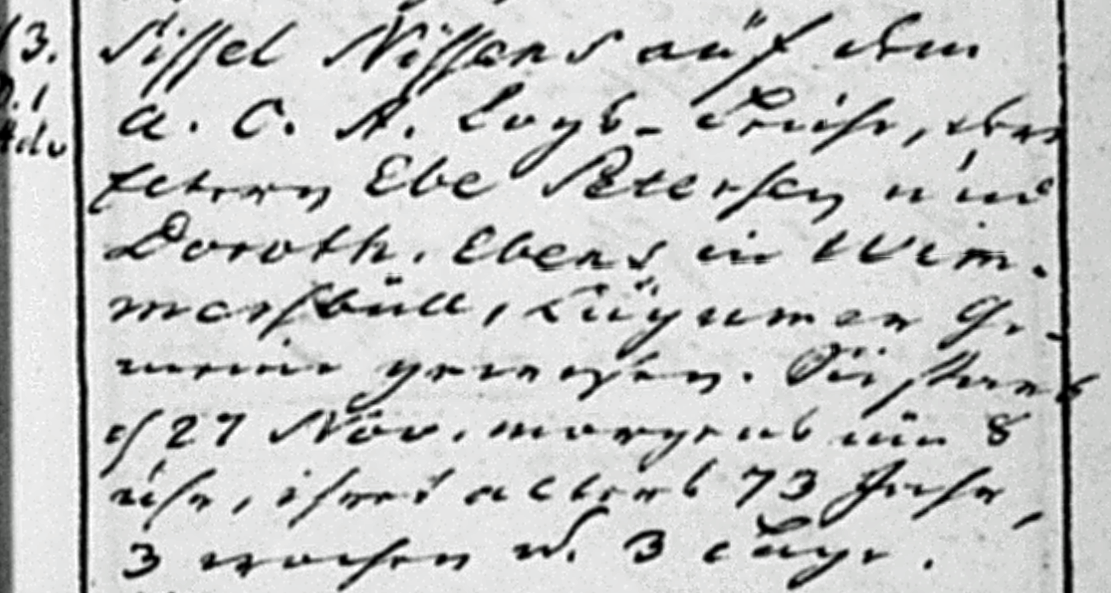
Looking at this death record for Sissel Ebsen I was so excited by the primary details (her parents' names and her age) that I failed to pay attention to another important detail. It's where her parents were from that mattered, not just their identities.
“Citation: Imaged at Archion (https://www.archion.de/p/475e0e1333// : 12 November 2023), 1752 death record for Sissel Ebsen, path: All Archives / Schleswig-Holstein / Landeskirchliches Archiv der Evangelisch-Lutherischen Kirche in Norddeutschland / Kirchenkreis Nordfriesland / Deezbüll / Bestattungen 1721-1763 Image 155 via https://www.archion.de/, accessed 12 November 2023.
It's interesting enough, and certainly noteworthy, that Sissel (a version of the name Cicilia) was 73 years old when she died, which helps us calculate her close-enough baptism date of 24 August 1679 (and you can calculate dates for your own ancestors as long as you have their exact age via http://www.searchforancestors.com/utility/birthday.html). Getting back to the seventeenth century is always a treat, especially in Nordfriesland parishes where early church books can be missing or damaged.
But I failed to notice that Sissel's parents were from an entirely different parish: not Deezbüll where Sissel's life events were registered during her married life, but a town called Wimmersbüll near Lügum (today Süderlügum). That meant that her parents would have had their own life events recorded there.


Sissel's parents' death records document their death dates but not their exact ages. We have to estimate when they were born based on Sissel's birth, usually about 20-30 years before the birth of their first child. And there may have been children born earlier than Sissel, we just don't know.
So for our purposes, assuming that Sissel was their first child, we assign a tentative birth date to Ebbe of about 1640 and to Dorothea (who is listed in her death record not by her name but as "Ebbe Petersens uxor," Ebbe Petern's wife) about 1645. Like many records from this era, ancestral patronyms are sometimes missing. Dorothea could be the daughter of a man called Ebbe (same name as her husband's) or the Ebsen patronym may be used her to identify her as her husband's wife, rather like a modern married surname. This isn't clear.
Early records like these can be cryptic, also often leave out the mother's name in a baptism record -- someone obviously thought the person who carried the child for nine months didn't need to be identified! So the Lügum parish records identify a few other children of Ebbe Petersen but not who the mother was, we assume Dorothea.
A child called Peter died in 1686, a daughter Marina was born that same year, and another Peter was born in 1690, all identified as the offspring of Ebbe Petersen. These children would have carried the patronym Ebsen after their father's first name, so if we wanted to research them further that's what we should look for, not Petersen. All we know from Ebbe is that his father was called Peter [Patronym], and we won't find him in these records. Anything earlier than 1684 just isn't going to be there. But we can be grateful for what we have. The mid-1600s is a pretty tenuous time for Nordfriesland records. The fact that these exist at all is something of a wonderful event.
12 November, 2023 | Email your comment.
History in a paragraph

When you get lucky like this, give a moment of thanks to the parish clerks who assembled a handlful of facts such as this one. Did they know future generations would be reading their church books or were they more like the Egyptian priests who considered their Pyramid Texts to be sacred writings only for the eyes of the gods?
We're fortunate. Going back in time from the 1822 birth of Elise Christina Momsen in the parish of Deezbüll, Nordfriesland, there's a wealth of material to explore. Elise didn't even know her father -- he died when she was an infant. But the richness of these archives never fails to astonish.
“Citation: Imaged at Archion (https://www.archion.de/p/92d0b00f1d/ : 6 November 2023), 1786 death record for Ebe Nissen, path: All Archives / Schleswig-Holstein / Landeskirchliches Archiv der Evangelisch-Lutherischen Kirche in Norddeutschland / Kirchenkreis Nordfriesland / Deezbüll / Bestattungen 1764-1804 Image 191 via https://www.archion.de/, accessed 6 November 2023.
It's a complete family history all packed up and ready to go: Ebe's name, his town of origin (Christian-Albrechts-Koog), parents' names. his late wife's name, his son's name and son's wife's name too (plus their children!), his second and third wives' names and where they were from (nearby Niebüll) and his exact age in years, months, and days so you can work out when he was born.
Ebe was born in January 1709, according to that calculation, and although we can't find him in the baptism records for Deezbüll, he does show up in the confirmation records in 1726 at the exact right age for his birth in 1709...wherever that may have been probably in an adjacent parish.
Thanks to a handy pointer from someone on a German genealogy mail list we know that the old parish at Christian-Albrects-Koog was closed for ninety years due to flooding and new land-reclamation plans for the region, so parishioners were directed to other town archives such as Dagebüll and Emmelsbüll. Ebe's parents seem to have chosen Deezbüll for their records, although some poking around may reveal more family history details if we're lucky.
6 November, 2023 | Email your comment.
A long-lost family connection phones home
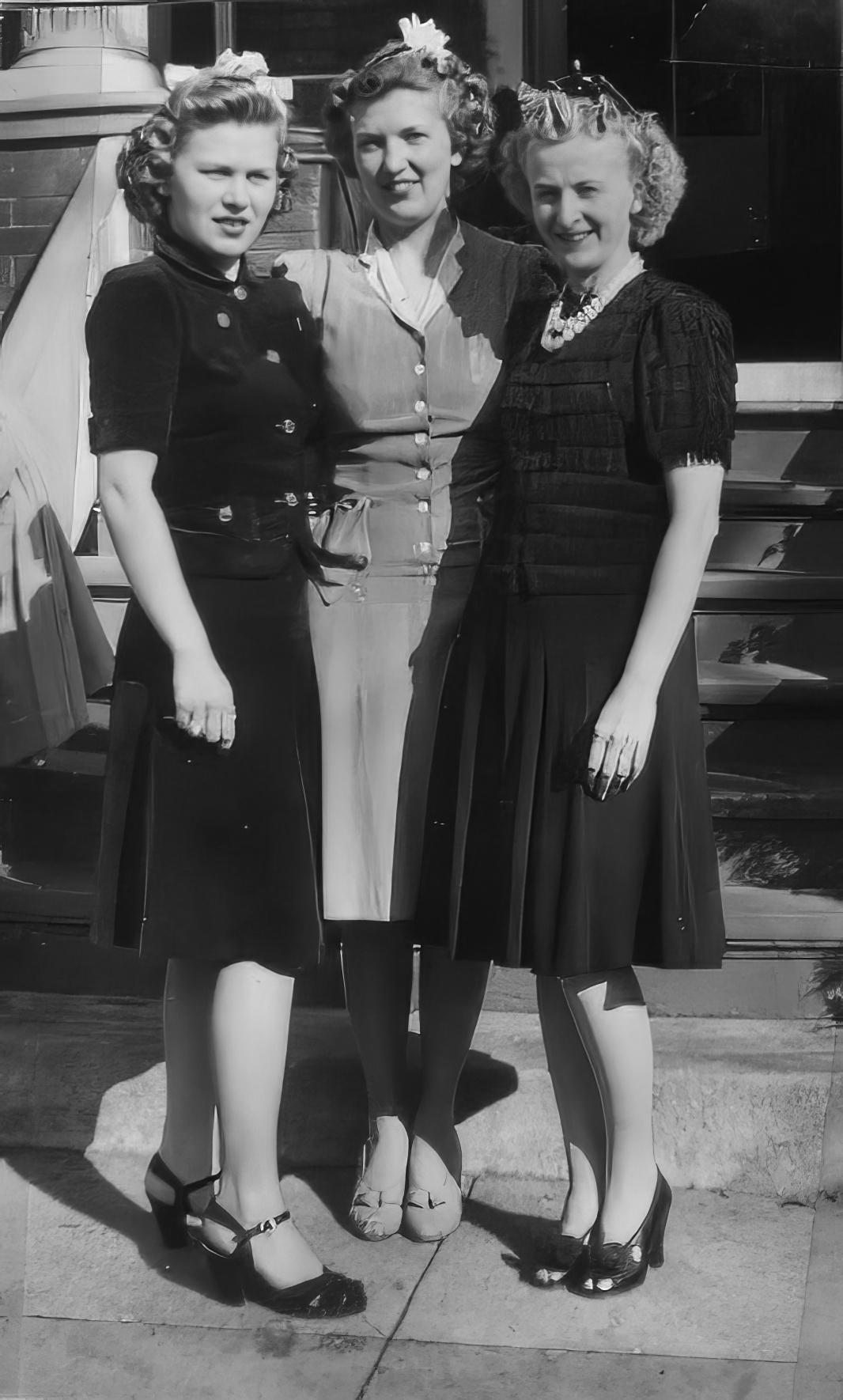
Our Chicago family included some cousins whose connections go back to a pair of sisters, Augusta Caroline Kramp (1854-1938) and Laura (Laurette Albertine Henriette) Kramp (1856-1893). The sisters emigrated in 1881, Augusta with her two children joining her husband Carl August Hasse (1832-1903), who was already in Chicago, and Laura was traveling to marry her fiancé Wilhelm Gohr (1857-1905), who had come over with Carl earlier that year.
Buried in my mother's photo album was this image of her sister, Lolus Bruns, then Lorraine, and their cosuin Loretta Murphy, standing near the family front steps on Winchester Avenue in Chicago. Loretta, I suspect, was named for her grandmother's sister Laura. It's clear evidence that the family kept in close contact with the children of Augusta Kramp Hasse, as well as Augusta. But this image and a few others of Loretta are the only photographic evidence we have of that connection.
Recently a DNA autosomal match put me in touch with another descendant of this family and I'm hoping that it leads to more family stories and photos.
“Citation: Digital reproduction of a photograph, front side, collection of Bertha Bruns Gohr, from left to right: Lolus Bruns, Lorraine Bruns, Loretta Murphy Mayhan, ca. 1942, original photograph from the album of the owner, scanned in 2015, accessed 24 October 2023.
It's an interesting family the more I look into it, with roots in and around Kreis Bütow in what was formerly Pomerania. Augusta was the oldest child of Friedrich Kramp and Emilie Pauline Trabant of Massowitz. Two of her children were born in Hygendorf, sometimes spelled Hyendorff, now called Udorpie in Poland. The other two were born in Chicago.
Loretta, pictured above, was the daughter of Emma B. Hasse, who married Irish immigrant Owen Patrick Murphy in 1909. But Emma's other siblings included Laura Hasse (1875-1903), who married George Charles Harder; Emil Albert Richard (1879-1961), who never married; and Ewald (Edward) (1890-1972), who married Elizabeth Blekeley. Our DNA match is with the family of Ewald.
How much of our family history our new cousin knows is still uncertain. On the Kramp side (a surname perhaps derived from a local village called Krampe) we have our earliest known fellow, Friedrich Kramp, who was born in 1824. On the Hasse side, Carl Hasse's father was Martin Wilhelm Hasse, born about 1803. We don't have photos of any of these folks, of course, but we do have baptism and marriage records for a lot of them, and I'm hoping that our newly-discovered cousin is eager to know more. At least some of the fun of genealogy is sharing.
24 October, 2023 | Email your comment.
Tracking a marriage

For some time I've been puzzled about a Petersen cousin, Elizabeth, who was born Wilhelmina Elizabeth Petersen in 1891 in Omaha, Nebraska but who shows up in the 1930 federal census, with her father Louis and mother Marie. But here she's called Elizabeth Miller and listed as married, although no husband appears with her. Elizabeth was an elevator operator in a public building, while her father Louis (on the previous page), formerly a saloon keeper, was a laborer doing odd jobs. It was still prohibition after all.
“Citation: "1930 U.S. Census, Omaha City, Douglas County, Nebraska, Population Schedule, Enumeration District No. 28-6, Dwelling Number 366, Family Number 372, Louis Petersen; digital image, https://www.ancestrylibrary.com/, accessed 19 October 2023.
But who was Elizabeth's husband? Nebraska doesn't have cross-referenced marriage records or indexes online from this period, so for some time I was at a loss. The census records the person's age at marriage, so we know she was 35 years old, putting her marriage at 1925 or 1926. But she's elusive in the 1940 census after both her parents had died, and there are no likely death records for Elizabeth Miller in Nebraska that match the details we know about.
Here's where newspapers can be helpful. Sometimes if you're lucky you'll find an obituary. Not this time...but the Omaha Morning World Herald did have a marriage record for Elizabeth.
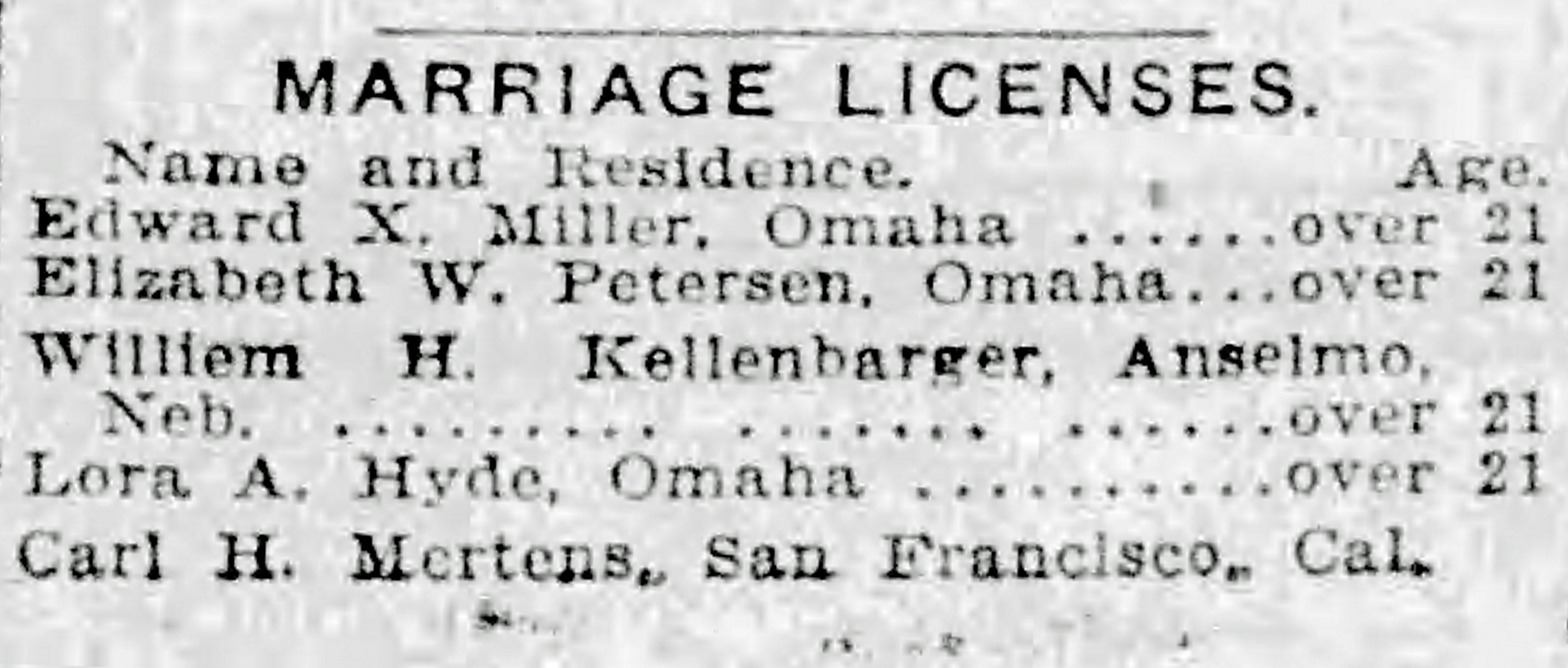
The newspaper carried applications for marriage licenses in the 1920s. Not all newspapers publish this information, but when they do it can be your only source of information. The May 11, 1926 issue of the Morning World Herald included an entry for Edward X. Miller, about whom we know nothing, and his bride Elizabeth W. Petersen. They're both over 21, but the 1930 census for Elizabeth Miller suggest that this is our Elizabeth. The ages match.
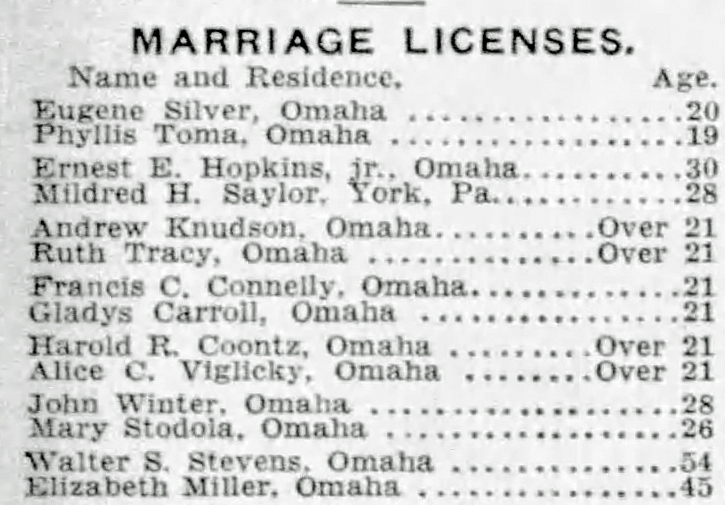
But she didn't remain Elizabeth Miller. A Find-A-Grave entry for her parents includes Elizabeth, this time as Elizabeth Stevens, married to a Walter C. Stevens. Can we find out when she married Walter? The Morning World herald comes to our rescue again.
The June 16, 1936 issue indicated that Walter and Elizabeth had applied for a marriage license, although here Walter is referred to as Walter S. Stevens (census records seem to indicate that the middle initial was 'C'). The age is correct for Elizabeth and the groom's name corresponds to the Find-A-Grave record. Elizabeth and Walter were married a month before her mother, Marie Cavalin Petersen, died.
Neither of Elizabeth's marriages included children. The brief obituary included with the Find-A-Grave entry suggest that Elizabeth was survived by cousins, none of whom are named. But that completes the book on the family of Louis Petersen of Omaha, his wife Marie Cavalin, and daughter Elizabeth. It's nice to have closure.
19 October, 2023 | Email your comment.
Saloon stories


Two of our Petersens made an appearance in the 1913 Omaha city directory, and this indicates an unexpected connection between them. Unexpected because Walter, the son of Andrew Petersen and Karen Marie Johansen Petersen, was born in Chicago and brought up in Kenosha, Wisconsin where his family had settled. Why was he in Omaha?
These entries show that Walter was living with his uncle Louis Petersen, who owned a saloon at 2024 Cuming Street, and shared living arrangements with Louis' family as well. Walter, just twenty-one years old, was working as a bartender. To appear in this directory Walter was probably already living in Omaha by 1912, when information was gathered for the following year.
“Citation: "U.S., City Directories, 1822-1995 for Louis Peterson, Nebraska, Omaha, 1913, Omaha, Nebraska, City Directory, 1913," directoru=y entries for Louis Peterson and Walt Peterson, via Ancestrylibrary.com https://www.ancestrylibrary.com/, accessed 12 October 2023.
What was Walter doing in Omaha? It was a gathering point for several other uncles, including Alfred, Peter (in nearby Mason City), and Hans, all of whom worked as farmers or laborers in the area and raised families there. Perhaps it was a place to learn a viable trade. When Walter left several years later to return home to Kenosha, where he married Celestia Bray and raises a family, he still listed his occupation as bartender on his WWI Registration Card, working for an Oscar August Petersen (Swedish and no relation but a friendly name nonetheless).
Walter didn't remain a bartender for very long, perhaps because of prohibition. By the 1920s he was a knitter in a textile factory and eventually a laborer in an automobile manufacturer, probably more lucrative forms of employment. But it's interesting that Omaha remained an alluring destination for our Petersen family even when they had settled in other regions of the USA.
12 October, 2023 | Email your comment.
Elusive clues in unexpected places
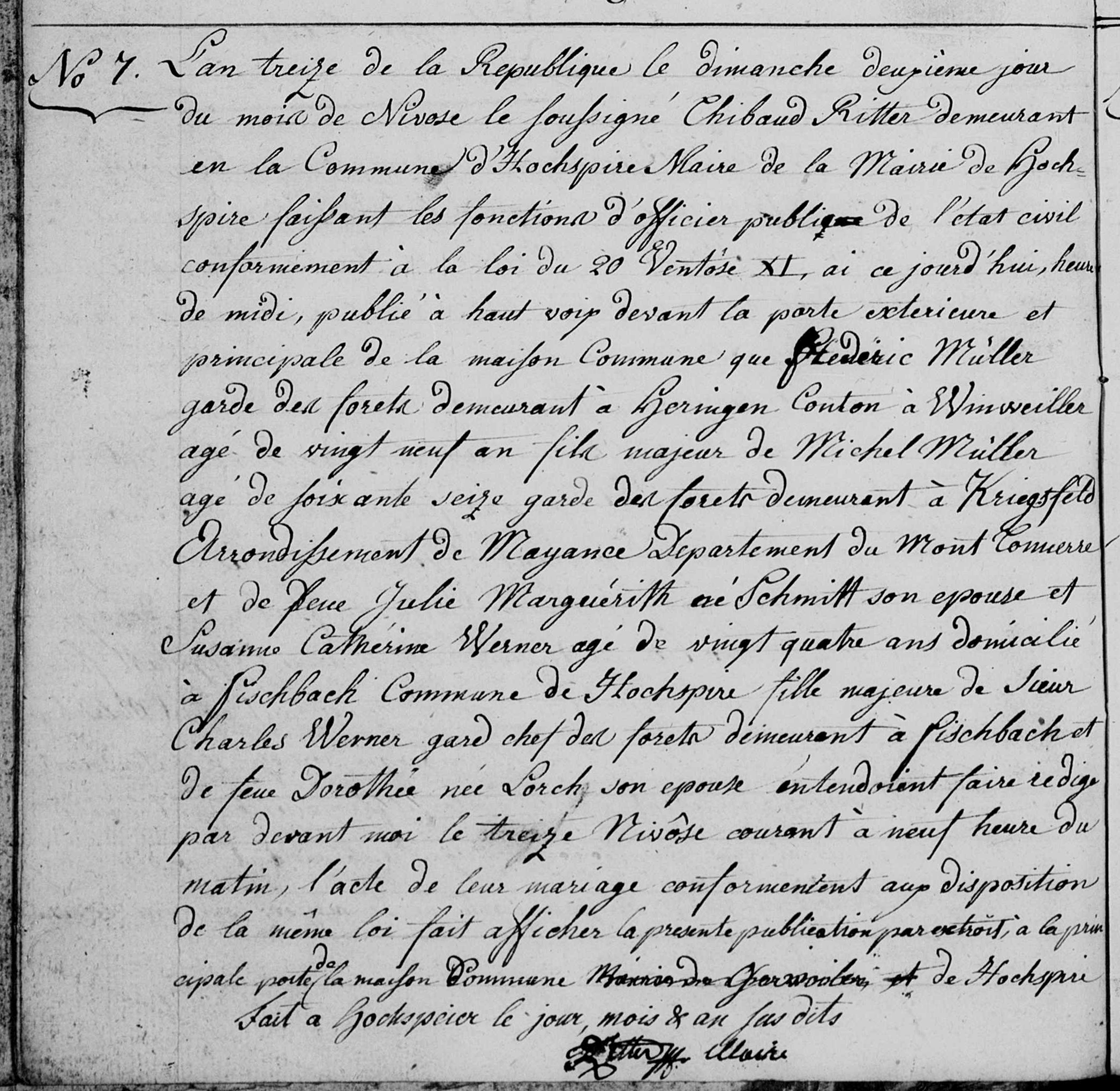
It's a decade since I tried to find out a definitive birth year for the oldest known patriarch of our Müller clan, Johann Michael Müller. We know he was married in 1765 in St. Matthäus Parish, Kriegsfeld, but that record doesn't identify his parents or his age. We don't know the bride's parents or age either. Maybe it had something to do with the fact that this was a marriage between a Catholic (groom) and a Lutheran (bride). Or perhaps it simply wasn't part of the record-keeping protocol. We know that Michael was from Flörsheim am Main and the bride from Wendelsheim, but that's it.
If we can't find anyone's birth year or parents' names it's hard to work back to a previous generation. And that's the case here. This couple had six children between 1766-1781 and then Michael remarried in 1784, presumably after Juliana Margarethe Schmitt had died. That marriage, to Sophia Lenz, doesn't tell us the groom's vital statistics either except to confirm that he was a venator, a forester, so we know we have the right fellow. But no dice on his origins.
“Citation: Zivilstandsregister, Eheverkündigungen, Heiratsbelege 1801-1806," marriage record for Frederic Müller and Susanne Catherine Werner, 3 January 1805, Hochspeyer, via Familysearch https://www.familysearch.org/ark:/61903/3:1:3Q9M-CSZR-XS4X-J?cat=255694, accessed 2 October 2023.
Remarkably Michael's age shows up on his son Frederick's 1805 marriage, a place I hadn't thought to look for it -- because why would it be there? But someone must have thought that the gentleman, now a forest guard in Kriegsfeld, was esteemed enough to have his age mentioned: seventy-six years old.
The groom's mother is of course deceased and the record reflects this. The bride's parents are mentioned, her father Charles Werner listed as a chief guard of the forest at nearby Fischbach, but no age for him is given. We can live with this. It's Michael we've been researching, and this information helps.
It might not get us where we want to go. Ten years ago I received a friendly note from an academic researcher who is familiar with the records of Flörsheim am Main and he reported that he could find no people who matched our Müller ancestors there. This might mean the records are missing or that Michael and his family were from Flörsheim but not born there. Already a cursory search for a Johann Michael Müller born in 1729 turns up nothing, not even for a presumed brother Henricus Jacobus Müller, also from that town, who was a godparent to one of Michael's children.
But we have something more than a clue that may help us locate Michael in adjacent parishes. Even more, it suggests that looking for information outside the box -- in records not otherwise presumed to hold vital information -- may yield unexpected and worthwhile results.
2 October, 2023 | Email your comment.
Famous Jathos
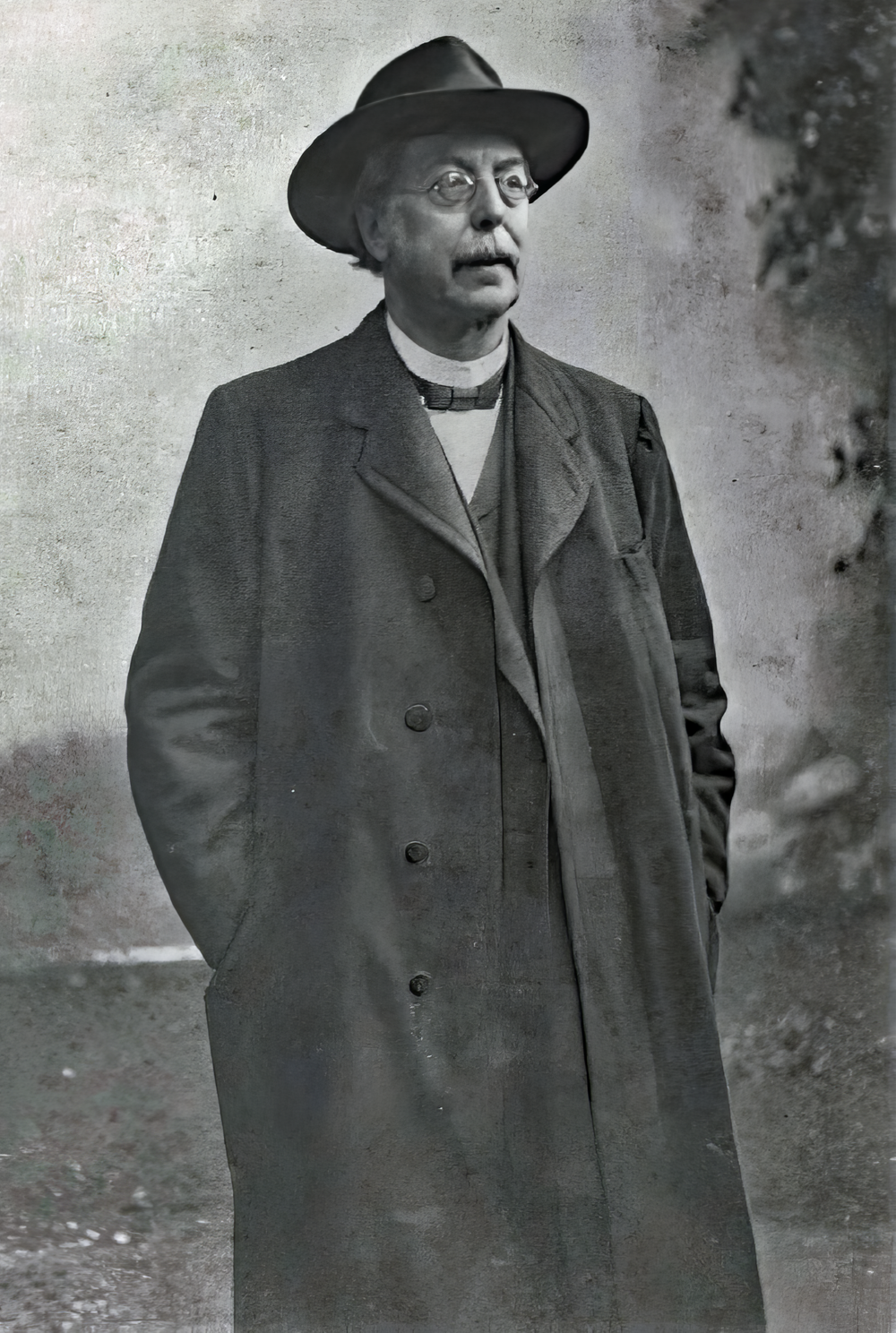
I've been asked whether our Jatho clan of Charleston, South Carolina is related to the famous aviator Karl Jatho (1873-1933), who may have actually flown in a vehicle prior to the American Wright Brothers. The sticking point seems to be the definition of flight: it has to be "sustained" or consisting of a prescribed number of minutes, not just a hop-up-and-down.
Was Karl's flight sustained in 1903? That's up for debate. And we can't prove that he's part of our Jatho clan anyway. Although he was born in Dransfeld, the same parish where our G.W. Jatho was born in 1824, the records online don't go back far enough to prove a connection, alas. Maybe some day.
“Citation: Digital image online from the publication by Leber, Christoffer, (2022), 5 Conflicting Narratives of Blasphemy, Heresy and Religious Reform: The Jatho Affair in Wilhelmine Germany, 10.1515/9783110713091-007, via researchgate.net, accessed 27 September 2023.
But we are related to another famous Jatho, Carl Wilhelm Jatho, if that's of any comfort. Born in 1851 in Kassel, Carl Wilhelm was the son of Pastor Jacob Ludwig Victor Oscar Jatho and his wife Auguste Katharine Louise Klingelhofer and like his father became a Lutheran pastor. Carl was the grandson of Johann Georg Jatho (1785-1829) and the great-grandson of Ulrich Wilhelm Jatho (1738-1833) and his wife Marie Madeleine Keppel. That's a familiar set of names. Our G.W. Jatho, the watchmaker from Dransfeld, Kassel, and later Charleston, was the grandson of Ulrich and Madeleine.
Like his own father Cal Wilhelm Jatho became a Lutheran pastor but with a twist. His personal belief, originally fairly orthodox in nature, became more radical over time as he studied the classics and philosophy, attempting to reconcile modern thought with the nature of Lutheranism. His sermons evolved, tinged with with a soupçon of pantheism. His emphasis on individual development of religious consciousness and the subjective feeling detached from church institutions were not universally embraced by the Lutheran community as a whole, although the congregations of Cologne in Germany appear to have practiced his theories.
Jatho was removed from his pastoral office in 1911 although he remained popular in Cologne and continued to preach and hold bible studies, albeit without a pulpit. He died in 1913, much mourned by his followers.
There's a hint that his cousin (and our ancestor) G.W Jatho was also of an independent religious spirit. After leaving Kassel in 1848 during a time of political upheaval, G.W. settled as a watchmaker and jeweler in Charleston, where he appeared to remain unaffiliated with any local church. His marriage to Elise Schuchmann Jatho in 1853 (performed discretely out of state in nearby Kentucky near some Schuchmann relatives) followed the birth of their first son Philip in 1852. None of G.W.'s and Elise's other children appear to have been baptized at all, at least not until after G.W.'s death in 1870. After that event Elise hauled her progeny to St. Matthew's German Lutheran Church on King Street in Charleston where there was a mass baptism of all her children, from 21-year-old Philip on down to little Carl Julius, age seven.
We have no idea whether G.W. knew anything about his famous cousin or followed his independent spirit, but it's definitely a possibility. And if you want a famous ancestor, Pastor Carl Wilhelm Jatho is your man.
27 September, 2023 | Email your comment.
Family trees from the 1570s
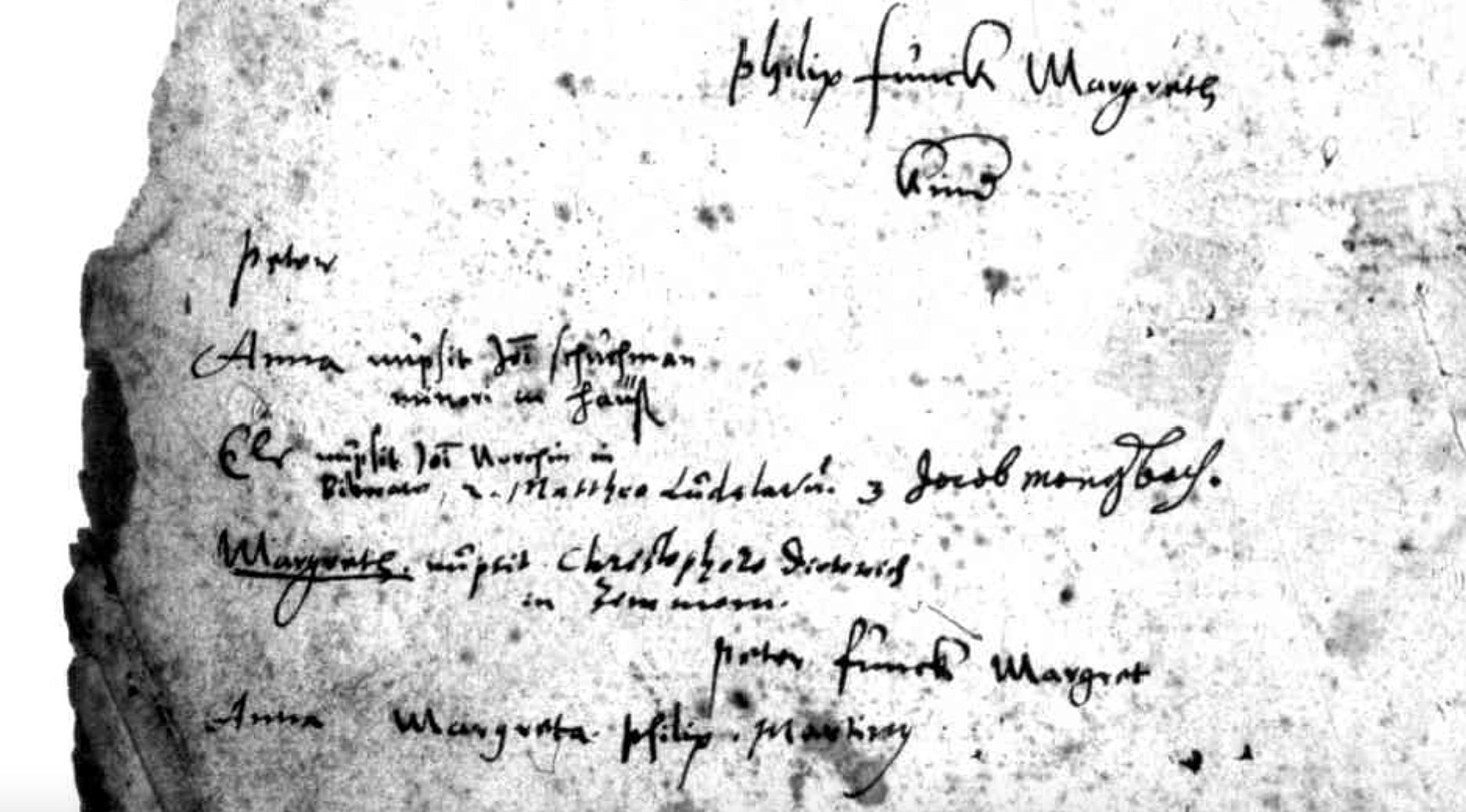
Hard to tell precisely what's going on but it looks like the beginnings of a family history page from the 1570s.
There are Groß Bieberau records available from this era via archion.de that cover standard categories such as baptism, confirmation, marriage, and death or burial. But this is the first time I've seen what appears to be a page-by-page attempt to list families in the parish. And one of them includes our ancestor.
“Citation: Imaged at Archion (https://www.archion.de/p/33a3cc3dfd/ : 20 September 2023), genealogy page for the family of Philip Funck and his wife Margareth, path: Hessen-Nassau: Zentralarchiv der Evang. Kirche > Dekanat Reinheim > Groß-Bieberau > Taufregister 1576-1679 Image 10 via https://www.archion.de/, accessed 20 September 2023.
This page was created in 1576! If I'm reading it right Philip Funck and Margareth have four children: Peter, Anna, Elv[a?], and Margareth, plus their children's spouses.
Daughter Anna Funck was married to Hans Schuchmann in 1576 and they had a son in 1579 who was also called Hans, so these folks are our ancestors too. Also included: Peter; Elv[a?] who also lived in Bieberau and was apparently married twice, once to Matthea Ludslavu [?] and then Jacob Mangbach; and Margareth married to Christophel Diekmans in the nearby town of Zimmern.
Son Peter has his own entry, married to a Margareth with children apparently too young to be married and likely still at home: Anna, Margareta, Philip, and Martinus. But the proximity to his parents' record suggests that they lived in a family unit in Bieberau near his parents.
The collection isn't comprehensive, of course, and the condition of the pages should help us to understand why. There were probably other pages in this collection that succumbed to dry or wet rot, vermin, or fire, we just don't know. It's remarkable that these few pages have survived at all. Even more remarkable: the interest in family history is clearly not a recent one!
20 September, 2023 | Email your comment.
A Melchers discovery
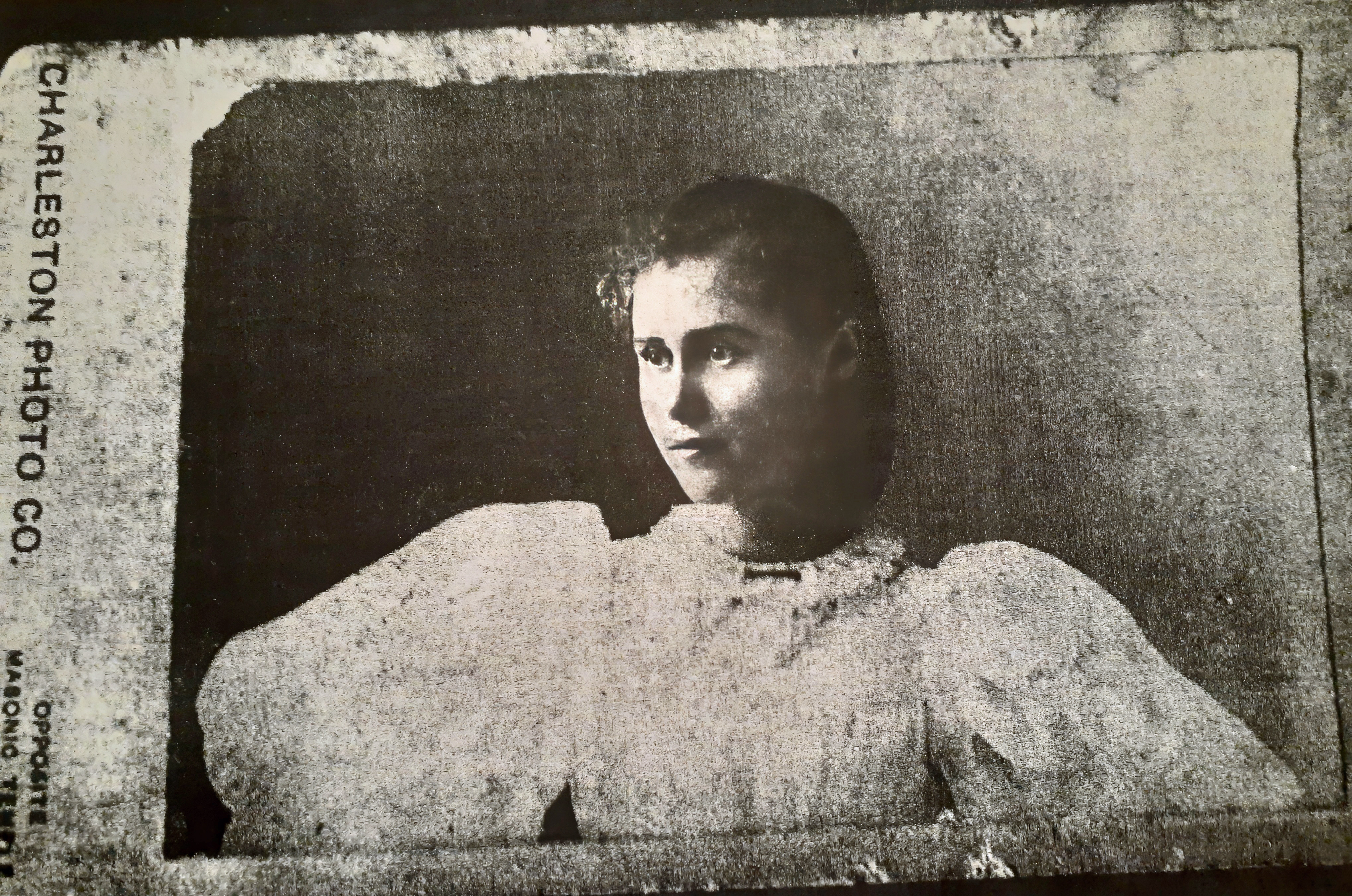
People are becoming very generous about sharing photos of family members. Someone associated with the Melchers family of Charleston, South Carolina uploaded this image of Marie Emelia "Mame" or "Mamie" Melchers to Find-A-Grave. We're grateful for this. Otherwise we'd have no photo of her, and she is part of the family.
“Citation: Find a Grave, database and images (https://www.findagrave.com/memorial/39865316/marie-emelia-messervy: accessed 10 September 2023), memorial page for Marie Emelia “Mamie” Melchers Messervy (22 Aug 1881–20 Feb 1975), Find a Grave Memorial ID 39865316, citing Bethany Cemetery, Charleston, Charleston County, South Carolina, USA; Maintained by Jessica Claxton (contributor 48465659).
Her parents were Theodore Melchers and Helena Müller Melchers. Helena was the eldest child of Rev. Ludwig Müller and Caroline Laurent Müller, so Mamie was their granddaughter. Theodore was a German immigrant who, with his brothers, managed grocery stores in Charleston. Out of seven children, Mamie was Theodore's and Helena's youngest child, born in 1881.
This portrait probably dates from about 1896-1898 if we consider the voluminous sleeves of the young lady, much in fashion around that time. She married William Hummel Messervy on January 6, 1904 in a ceremony performed by her uncle, the Rev. W.A.C. Müller and attended by her Atlanta cousin Maud Müller (later Nehemias). William and Mamie had six children, including a pair of twins.
10 September, 2023 | Email your comment.
A second bride for Lorenz Petersen
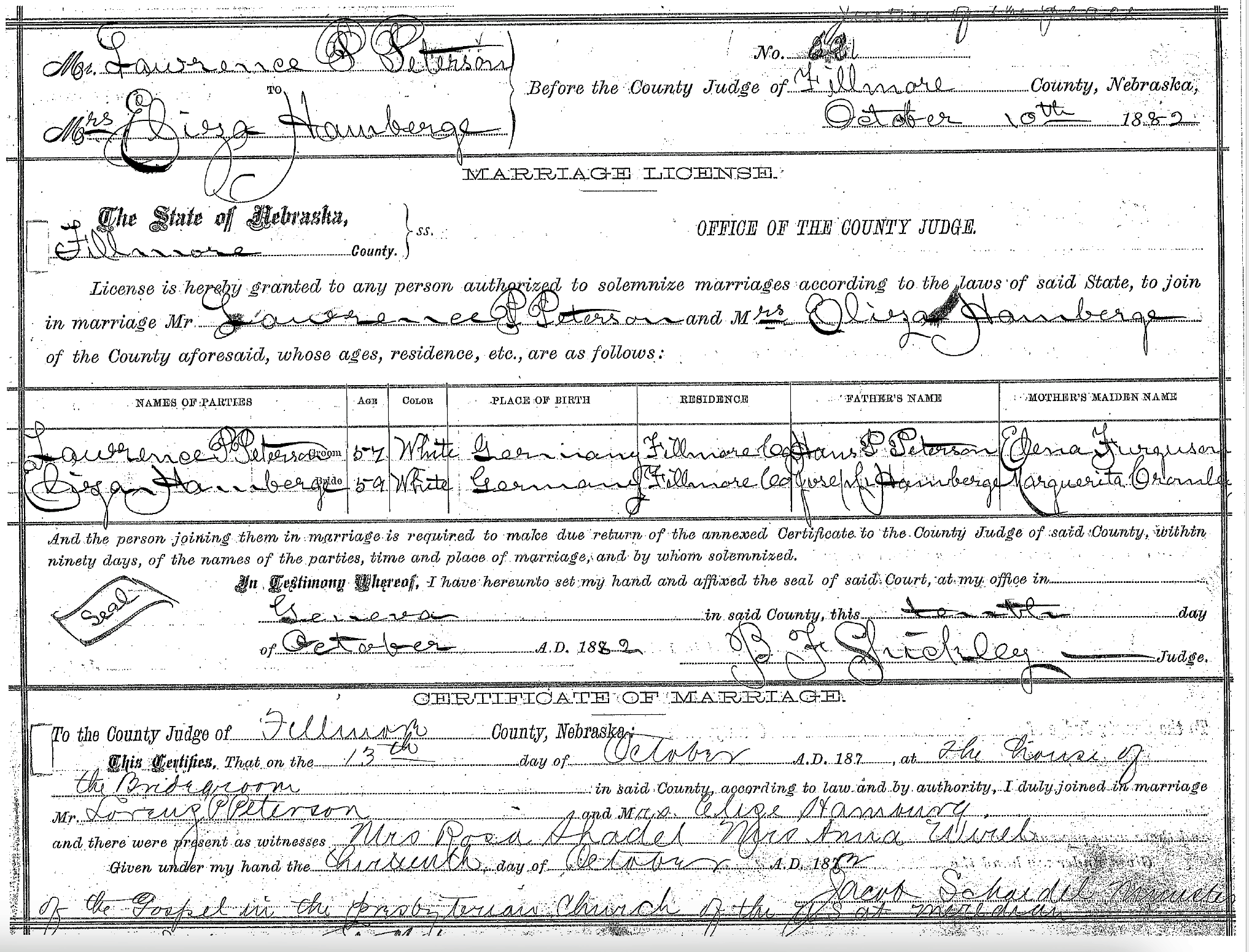
Back in the day it was common for a widower to marry again after his wife had died, especially if he was an older gentleman. That was the case with Lorenz Peter Petersen, whose first wife Margarethe "Magretta" Petersen had died in March 1882, and at the age of fifty-seven married Eliza Hamberge in Fillmore County, Nebraska in October 1882.
This record exists as an index only at FamilySearch.org in the collection "Nebraska Marriages 1855-1995," and for that we're grateful. But in cases where it's possible to find the original or original transcription, it's worth trying to see the handwritten document itself.
“Citation: Fillmore County, Nebraska, marriage registration number 621 (1882), Petersen-Hamberge, certificate created and signed 10 October 1882 by B.F. Shickley, IT3, p. 227-621, items 2-4, photoscan obtained from Deputy Clerk Carol Hoarty, Fillmore County Nebraska County Clerk's Office https://fillmorecountyne.gov/webpages/clerk/clerk.html, accessed 24 August 2023.
Why is it important to search for the original or original transcription? There may be more information on the image file than you'll find on the index of the document (which in the case of this document exists in three different index entries, thanks to the perspicacity of the FamilySearch folks). With this marriage it's worth a closer look.
I've tried this before and it worked out so I thought I'd call the Fillmore County Clerk's office and see whether they could pull up the image file...and to my surprise, they did, just by searching the bride's and groom's surnames and year of the marriage. In person it would have cost twenty-five cents. Over the phone with a credit card payment it was two dollars, but still a bargain.
Lorenz Petersen is listed in the upper half as Lawrence P. Petersen (he may have anglicized his name or the original clerk may have assumed it) while the bride is Eliza Hamberge. The minister's certification at the bottom of the form lists Lorenz Petersen and Eliza Hamburg (is that the correct spelling of her surname or is this an error? Its not clear).
The parents of the groom are listed correctly as we know from his 1825 baptism entry in the church books of Burkal Parish in Denmark (though the FamilySearch transcription misreads Jürgensen as Ferguson). Eliza's parents are transcribed as Joseph Hamberge and Marguerita Cromley (the reading isn't clear, it could be Cramler or some other surname).
None of the parents were listed as witnesses to the marriage. Witnesses are listed as Mrs. Rosa Shadel [sic], wife of the Presbyterian minister Rev. Jacob Schadel, and Mrs. Anna Wirel. Other than the wife of the minister, whose connection to the couple we can derive from her husband's involvement, we don't know what connection Anna Wirel might have had, if any. The handwritten document helpfully tells us that the ceremony took place in the house of the bridegroom.
Questions arise. Were the parents of the bride no longer living? We know that Lorenz' parents were living in Fillmore County at this time, according to the State of Nebraska 1885 census (helpful to have) and we also know from that same source that that Eliza's origins were listed there as Baden -- it would have been nice to have an actual town. Had Eliza been married before? She was two years older than the groom. Likely not, since her surname was still the same as her parents, but's it's hard to be sure if she resumed her original name for some reason.
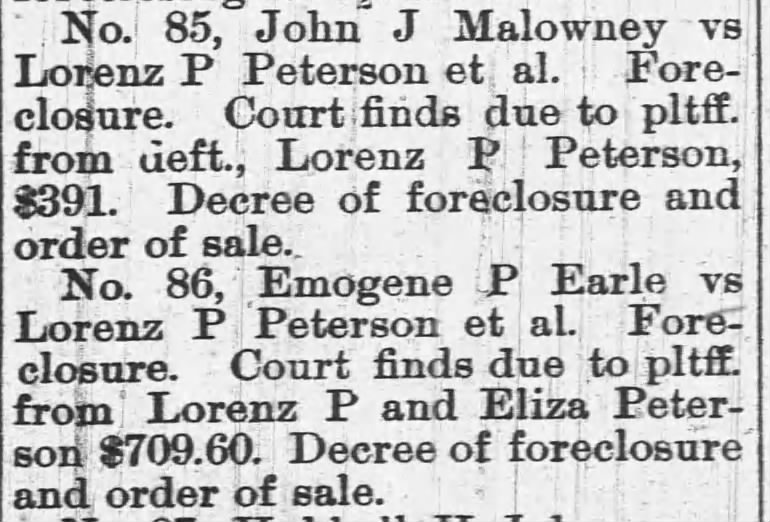
Lorenz had a son, Hans, also living in Fillmore County, and several nephews in the area. None of them were witnesses to the marriage, interestingly. We also know that every other official religious event in Lorenz' life occurred in the Lutheran church. A Presbyterian minister is a bit of a surprise. Was there some family resistance to the marriage? It's not possible to tell but there could have been something afloat.
We also know, courtesy of a news item from the Hebron Journal newspaper in 1889, than things weren't smooth sailing for Lorenz and Eliza. Financial difficulties loomed for Lorenz, a farmer, and the couple ended up owing over one thousand dollars to two fellow citizens in Thayer County, Nebraska, which was a lot of money in those days. We also know that Lorenz, Eliza, his son Hans and Hans' family all relocated to Chicago, Illinois some time in 1889, perhaps as a result of these financial reversals. Lorenz worked as a house painter in Chicago and died in 1891, still married to Eliza. We know a lot about Lorenz' son Hans and his family though. You can read about their life here.
24 August, 2023 | Email your comment.
Two Laurents, both alike in dignity
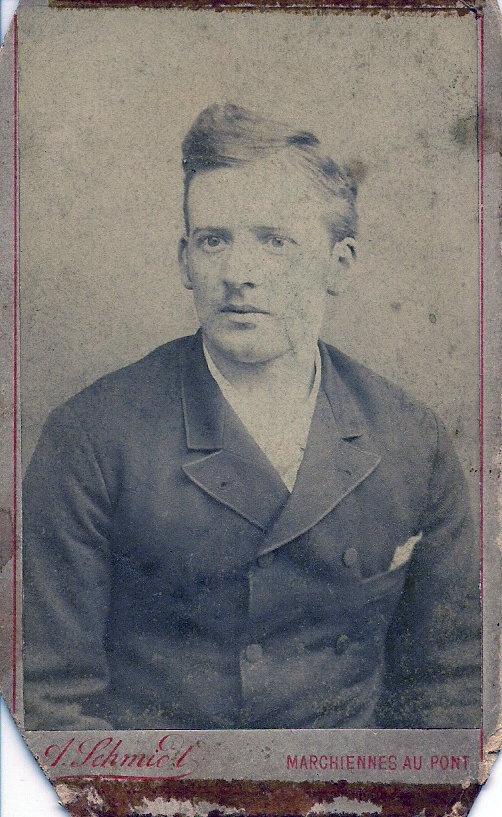
Can you believe that there were two fellows in Philadelphia called Emil Laurent, both born in 1866, both married to a lady called Anna, but who were surprisingly not the same person?
It's easy to get confused when names, however rare, appear to be the same. I would dearly love to have this photo be my Emil Laurent, who was born to Frederick C. Laurent and Marianna Demme, but it's not.
“Citation: Find A Grave (http://www.findagrave.com : accessed 10 August 2023), memorial page 58315091, Emil Laurent (1866–1942), created by "Marianne"; citing Circle Hill Cemetery, Punxsutawney, Jefferson County, Pennsylvania, USA, accessed 10 August 2023.
First way we know there's something funny: The photo was processed at the L. Schmidt gallery in Marchienne au Pont, Belgium. Sometimes our family members have sent their children back to the old country for whatever reason (musical training, religious education, and so on), but in this case our Laurent family has nothing to do with Belgium. Their ancestral origins are in Zweibrücken, Rheinland-Pfalz and Alsace. But our Emil was born in Philadelphia, not in Belgium, according to the census records.
Another issue: our Emil was married to Anna, but Anna Florence Pearson Watson. The Find-A-Grave entry for the other email shows that his wife was Anna Nameche. The family children were also different. Thus: this is another Emil Laurent.
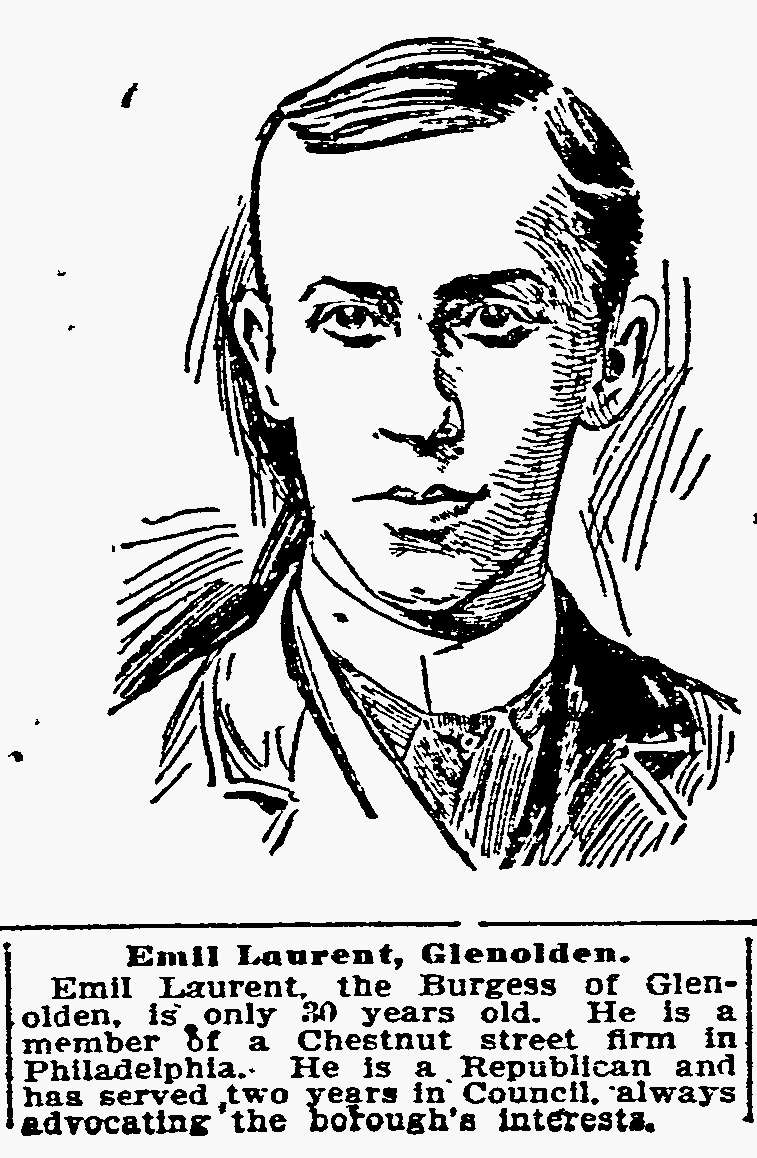
This Emil was a manager of a glass factory, while our Emil Laurent was one of F. Laurent & Sons, a confectioners business on Chestnut Street in Philadelphia. Different wives, different children, different professions!
Our Emil Laurent was actually profiled in the Philadelphia Inquirer on March 7, 1897 when he was running for local office. Only thirty years old he was representing Glenolden Borough in Philadelphia and was clearly identified as a member of the Chestnut Street business.
A newspaper line drawing of him accompanies the article so we have a vague ide of what he looked like. So far, other than his aunt Caroline Laurent Müller of Charleston, South Carolina, he's the only Laurent whose visage we can see. That's better than nothing. But it's worth remembering that it's very easy to end up on the wrong road as we research. Take your time, examine the facts, and make sure it all adds up to what makes sense.
10 August, 2023 | Email your comment.
An obituary clue
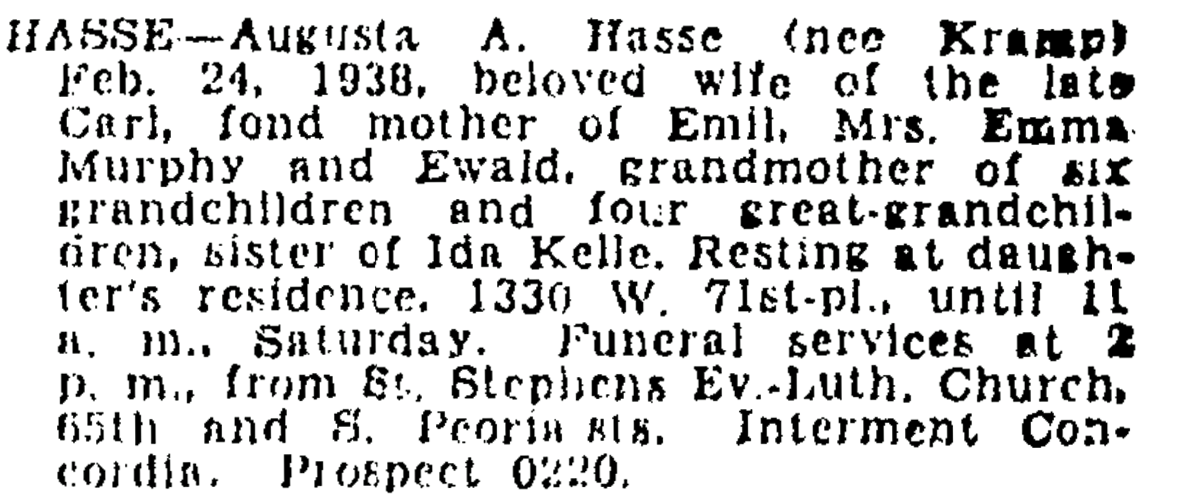
I've run across obituaries for my great-grandmother's sister before, but this one gave me pause. In addition to her surviving children, Augusta's sister was also listed -- and not Laura Kramp Hasse, my great-grandmother, who died in Chicago in 1893. This is Ida Kelle...a new name. Who was she?
“Citation: The Chicago Daily News, 25 Feb 1938, obituaries, “HASSE - Augusta A. Hasse”; digital images, Newspapers.com, (https://www.newspapers.com/) accessed 31 July 2023.
Luckily I've had some luck finding family members in Klein Massowitz, Kreis Bütow, Pomerania where the family was born. My database tells me that there was an Alwine Ida Kramp, born in 1877, the last child of Richard Kramp and Emilie Trabant. This is likely our Ida.
Augusta and her sister Laurette/Laura emigrated to Chicago in 1881. Augusta was already married to Carl Hasse, while Laurette was joining her fiance Wilhelm Gohr, who had emigrated to Chicago earlier that year. But according to emigration records Ida didn't come over until 1912, still unmarried, to join her sister Augusta.
Ida married Frederick Kelle, also from Germany (not known what part) in Chicago in 1916, where they lived together until Ida's death in 1948. They had no children but were likely part of the extended Kramp/Hasse/Gohr family circle in Chicago.
31 July, 2023 | Email your comment.
Hans Petersen: one in a million

Maybe there weren't exactly a million fellows called Hans Petersen in the United States, but there were a lot, and particularly a good handful of them in Nebraska.
But we're looking for a particular family constellation here: Hans, a wife called Christina, and two children, Peter and Lina. What do you know? Here they are in Thayer County -- same place where Hans' parents, siblings, and cousins live!
“Citation: “Nebraska, State Census Collection, 1860-1885," database with images, 1885, Thayer and Valley, Ancestry Library (https://www.ancestrylibrary.com), entry for Hans Petersen and family; provided in association with National Archives and Records Administration, accessed 18 July 2023.
Landing on this record was somewhat circuitous. I first found Christina and her children on a passenger manifest for October 1883, but Hans wasn't with them. In cases like this it's common for the father to emigrate first and set up a home for the rest of his family, and in this situation that's exactly what happened: Hans emigrated in March 1883.
It's no surprise that he would have settled first where his parents were living. His cousin (also called Hans Petersen) came over in 1872, and Hans' younger siblings and parents in 1878. They were all in Thayer County, Nebraska by the 1885 state census, a handy document to have since the 1890 census is missing. Not all states offered their own census records, but luckily Nebraska did.
Where Hans and his family went after this time is a new topic to pursue.It appears that son Peter married at least twice, but research is still ongoing. No trace of Hans, Christina, or Lina has been found after 1885, but hopefully something will turn up in the future.
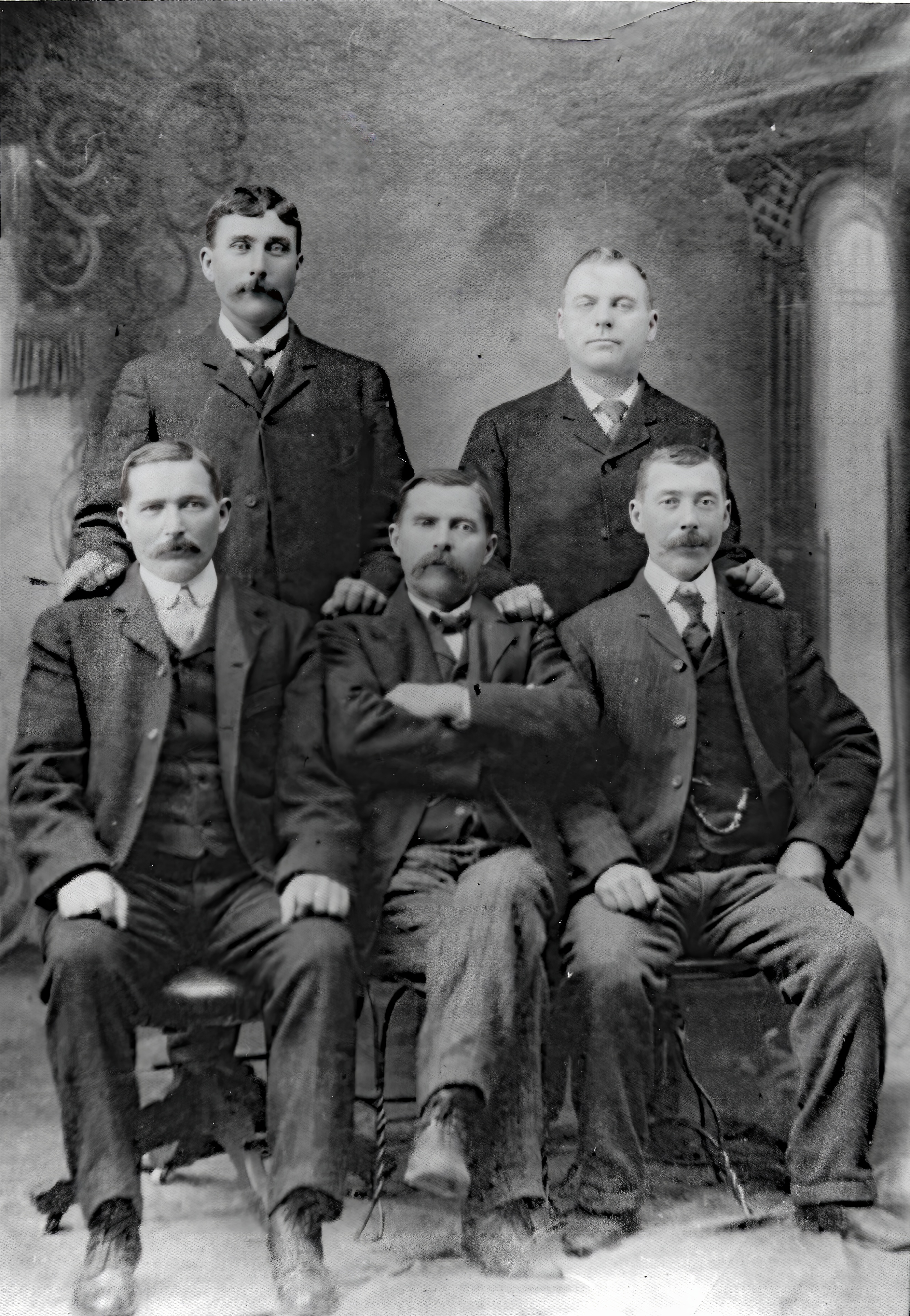
Why is this an important discovery? It helps us verify that the five men in this photo at right are indeed the five Petersen brothers, sons of Peter Hansen Petersen and Elise Christina Momsen, and that they all emigrated to the United States. Hans wasn't just here for a flying visit, nor did the other four brothers make it back to Nordfriesland for a family reunion. The simplest, most direct explanation is the best one. The five got together, probably somewhere in Omaha, where most of them lived by the end of the nineteenth century, for this portrait.
The back row shows Peter Hansen Petersen the younger (born in 1860), Hans Peter Petersen (1854), while the seated brothers are (from left) Andrew, Louis, and Alfred. Andrew had already relocated to Kenosha, Wisconsin after his marriage in 1889. The other brothers all remained in Nebraska, as far as we know. At least we have three of the four remaining brothers documented there well into the twentieth century. Their sister, Catharina, who married their first cousin (also called Hans Petersen), had moved to Chicago around 1890. Since this was a brothers' portrait we assume that Catharina wasn't able to join the rest of the family.
Next project: find out how long Hans lived, and what happened to his wife and children.
18 July, 2023 | Email your comment.
The second Matilda

It wasn't unusual for a child to be named after a deceased sibling in German and Danish families. It happened multiple times with our Petersens of Nordfriesland. That's the case in this record.
The first child of Georg Petersen and his wife Christiane Gÿldenzoph was Mathilde Botrea Petersen, born in 1867 and died at age three in 1870. It's not clear where the name Mathilde came from. None of the godparents were named Mathilde, and the child's grandparents didn't have that name in their ancestry. But it appears to have been a sentimental name when the couple's second daughter was born in 1873.
“Citation: Imaged at Archion (http://www.archion.de/p/e8d0fd8157/ : 2 July 2023), baptism of Mathilde Petrea Christina Petersen 1 November 1873, path: Norddeutschland: Landeskirchliches Archiv der Evang.-Luth. Kirche > Kirchenkreis Schleswig-Flensburg > Flensburg-St.Johannis > Taufen 1869-1887 Image 82 via https://www.archion.de/, accessed 2 July 2023.
This time the child is Mathilde Petrea Christine, Petrea probably in honor of someone called Peter, Christine for the godfather, perhaps. But except for Christine these names don't appear in the list of godparents.
Interestingly one of the godparents is Cecilia Petersen of Jundewandt, just over the border into Denmark in the parish of Burkal. Cecilia was Georg's older sister, born in 1830, so it's nice to have confirmation that she was still alive in 1873. We know nothing about her otherwise. The second godparent is Anna, no surname listed, from Flensburg-St. Nikolai parish; her connection to the family is unknown. The third is a Christian Christiansen from a village that looks like Medelby in Nordfriesland, where lots of our Petersens were born and raised.
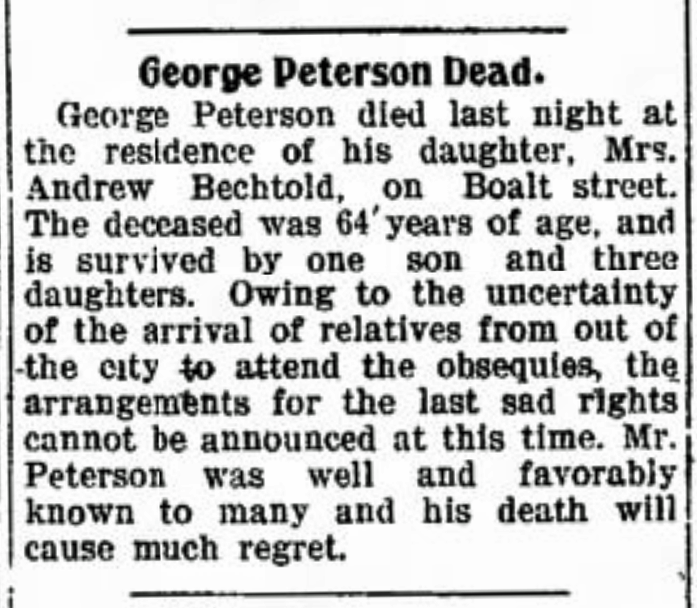
Mathilde ended up in Sandusky County, Ohio, with her parents, where she married Andrew Bechtold in 1899. This helped us locate her, Andrew, and her father George in the 1900 census. George died in 1901, according to the Sandusky Star-Journal. Andrew and Matilda had one daughter, Alverna, before divorcing before 1910. Both Alverna and her mother ended up in Worland, Wyoming, where Matilda's brother Gustav had resettled.
But there's an unanswered question. The obituary mentions that George was survived by three daughters and one son -- presumably George's wife Christiane had died earlier. We can account for one son, Gustav, and two daughters, Matilda and her younger sister Anna Catharina Christina, who had married Jan Martin Eschels, who also lived in Sandusky County. Who was the third daughter who came to America?
DNA matches helped us find this family in Ohio and Wyoming. Perhaps another match will lead us to the missing Petersen daughter.
2 July, 2023 | Email your comment.
A clue within a marriage
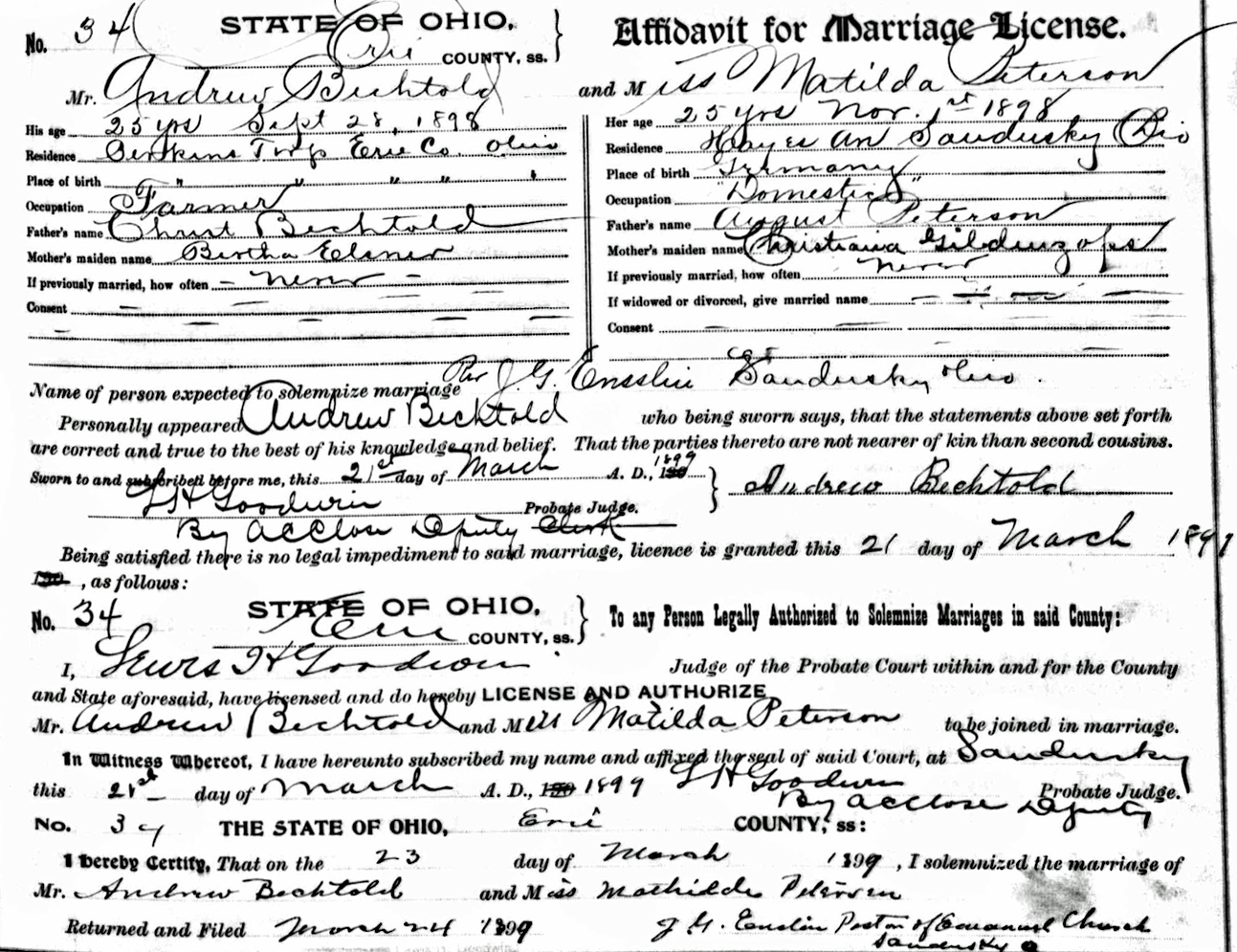
Sometimes inverting a search brings the results you'd been looking for with a straightforward approach.
“Citation: Ancestrylibrary.com, State of Ohio, Affidavit for Marriage License, No. 34 [database on-line]. Lehi, UT, USA: Ancestry.com Operations, Inc., 2014,, accessed 22 June 2023.
I'd been beating my head against a wall looking for a death record for Georg Petersen, my great-great-grandparents' younger brother. I assumed that he died in Flensburg, where he was married, had children, and worked. But scrolling page by page through the Flensburg church books at Archion wasn't getting me anywhere. First of all, there are at least three different parishes in Flensburg where the record could be. Secondly, none of the records are indexed. You have to search record by record. And you still might not find anything. Georg might haev relocated to another parish with his family. I'd never know, if that was the case.
I couldn't find anything searching for Georg Petersen so I decided to try a search using just his wife's name, no location, just Christiana Gÿldenzoph (or Güldenzoph) who was born in 1839.
Ancestry Library politely ignored the birth year and gave me a link to a record in Sandusky County, Ohio, where a young lady indicated her parents names on her affidavit for a marriage license in 1899. She was marrying Andrew Bechtold. Her parents were listed as August Petersen and Christiane Güldenzoph. That's pretty close! Her brother was Gustav, close to August. Sometimes folks get things mixed up on official documents, especially when a wedding is involved.
So how is this record revealing anything new about our Petersens? Easy -- it suggests that Georg and his wife had a daughter called Matilda. Which they did...but the one I knew about died in 1870 at age three in Flensburg and never emigrated. Was there perhaps a second Matilda?
There was, and thanks to the bride indicating her birthdate I was able to find her baptism record in Flensburg, which confirmed her parents' names: Georg Petersen and Christiane Botilla Gÿldenzoph.
The 1900 U.S. federal census revealed Andrew Bechtold and his wife Mathilda living with Matilda's father George. So that's the key! George was the third Petersen brother to emigrate to the USA. We don't yet know what happened to George's wife Christiane. Did she die in Flensburg before he came over, or in Ohio where a record has not yet revealed it? More to explore, clearly.
22 June, 2023 | Email your comment.
A chatty death record
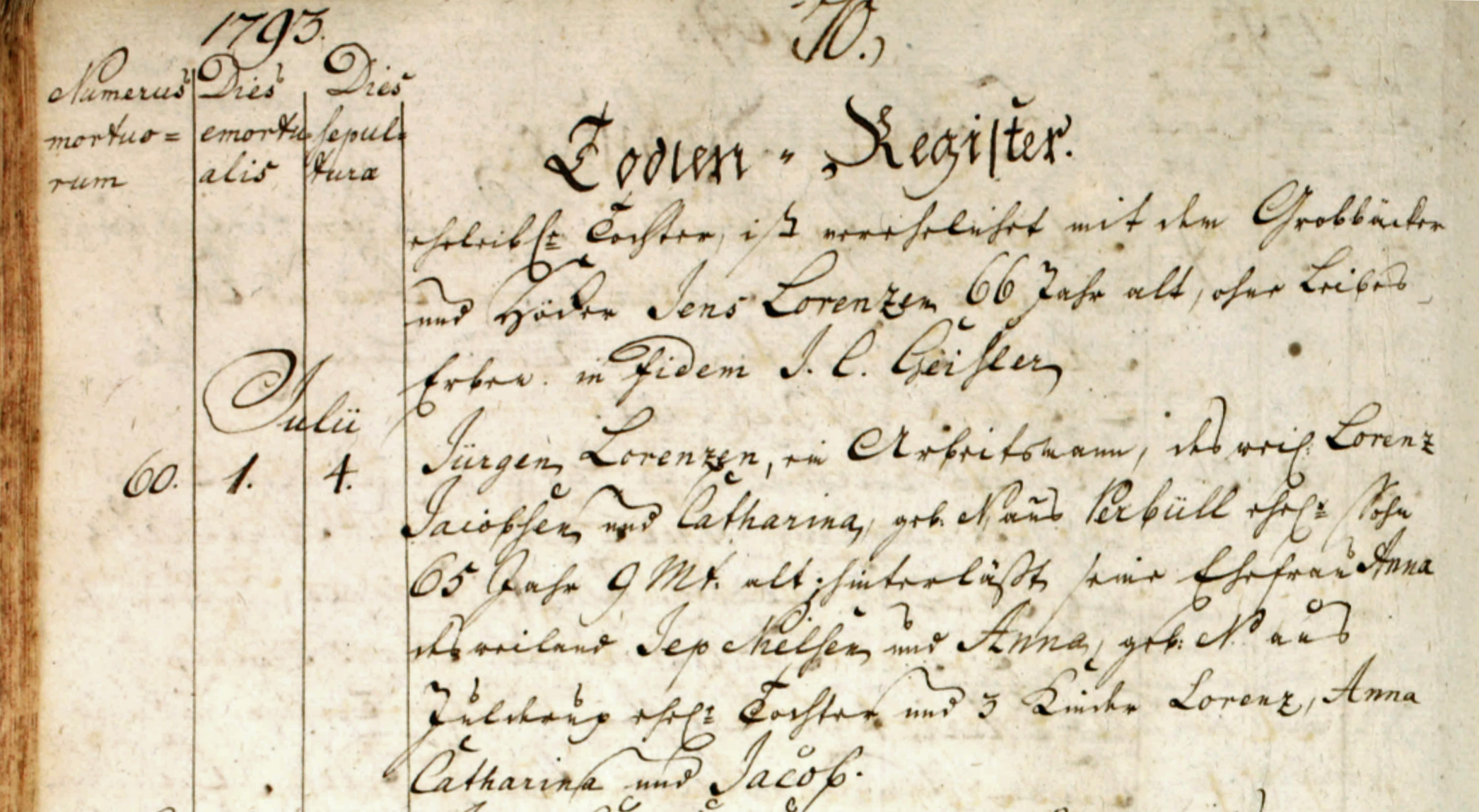
There's so much information in this death record that it feels like a special gift. It really depends on the protocols of the parish. Sometimes you get just a line of details -- a name, age of deceased, and date. In other circumstances, like this one, you get a story.
“Citation: Danish National Archives (Arkivalieronline), Tønder Sogn, Kontraministerialbog, Døde mænd og kinder 1788 - Døde mænd og kinder 1847, death of Jürgen Lorenzen 1 Jul 1793, image 40/383, Rigsarkivet, Copenhagen (National Archives, Copenhagen, (https://www.sa.dk/ao-soegesider/en/billedviser?epid=22045410#455265,81457742) accessed 8 June 2023.
For context, Jürgen Lorenzen is the grandfather of Ellen Jürgensen who married Hans Peter Petersen in 1822 and established a rich line of Petersen children from 1822 through 1839 in Nordfriesland. Jürgen's name could be inferred from his son's name, Lorenz Jürgensen (father of Ellen Jürgensen if you're keeping score); by convention it makes sense that Lorenz' father must have been named Jürgen. Luckily for us his father's name was also specified in Lorenz' 1799 marriage record. So was his mother, Anna Jeppes[datter]. So we had some clues prior to finding this document.
But here in the 1793 death record we have:
- The date of death (July 1) and date of burial (July 4)
- Jürgen's occupation ("Arbeitsmann," laborer)
- Jürgen's parents' names, Lorenz Jacobsen and his wife Catharina (no name) and their village of origin. Perbüll (now Perbøl), Denmark
- Jürgen's age: 65 years, 9 months!
- Jürgen's wife's name, Anna, and her parents' names: Jepe Nilsen and his wife Anna of Jolderup
- The names of Jürgen's living children: Lorenz, Anna, [Anna] Catharina, and Jacob.
Where do we go from here? The most tempting direction is to find Jürgen's baptism in October 1727, but if he was from Perbüll like his parents, that town in the parish of Bjolderup started keeping records in 1740 and we won't find a baptism that early. He may have been registered in another parish nearby, such as Burkal or Tønder, worth checking out.
We may also want to look for a marriage record for Jürgen's parents around 1760, approximately when their first son Lorenz was born. But that too requires some sleuthing. Where did it take place? In Jolderup (the bride's parish) or some other local parish? It's worth exploring to see how far back we can go.
Nevertheless this is an excellent starting point to fill in the blanks in our family research.
8 June, 2023 | Email your comment.
Names don't change...until they do
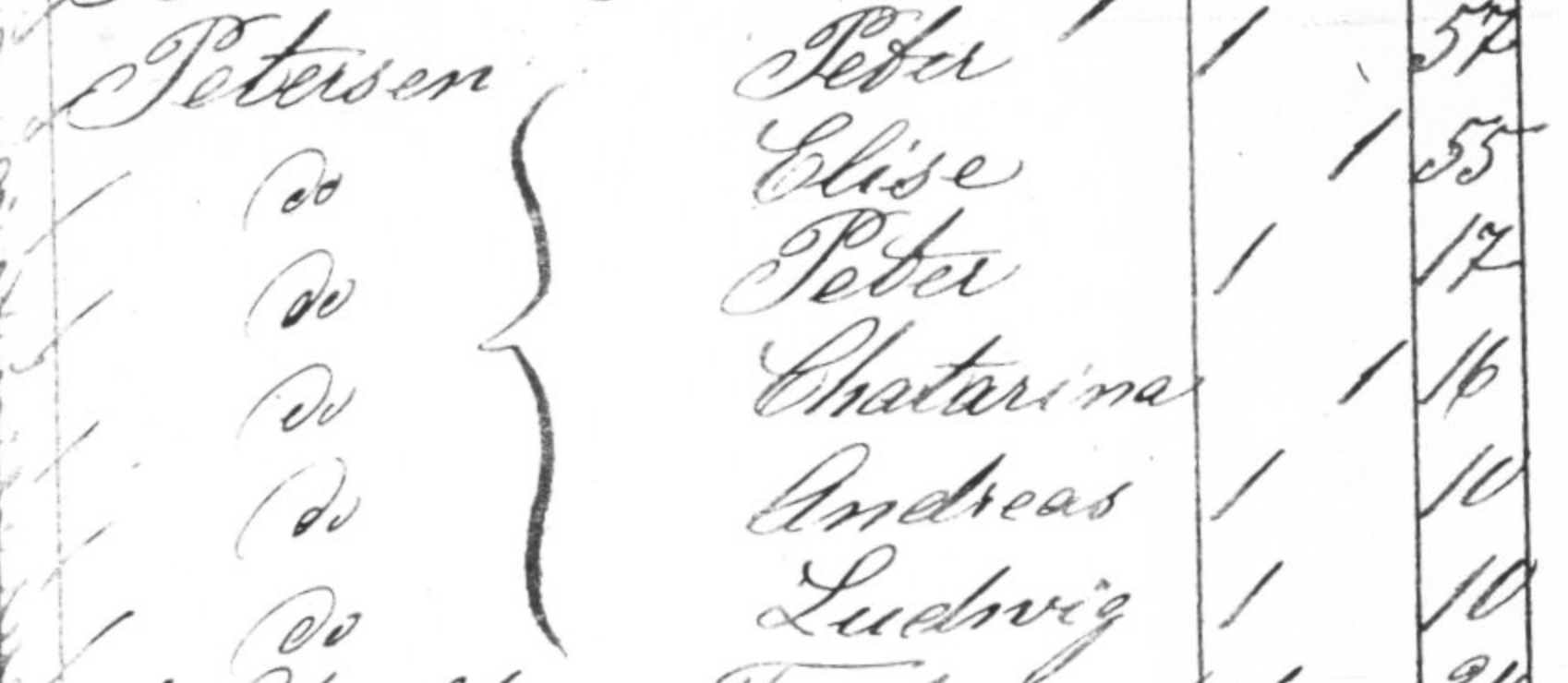
Genealogist Jennifer Mendelsohn has a video presentation that neatly debunks the persistent myth of name changes at Ellis Island. You've heard it. Your ancestor came to America with one name and when being processed at the famous emigration station in New York he or she emerged with a new "Americanized" name.
“Citation: Jennifer Mendelsohn, "No Names Were Changed at Ellis Island: Debunking a Persistent Myth," Rootstech presentation via FamilySearch, September 27, 2021, available online at https://www.familysearch.org/rootstech/session/no-names-were-changed-at-ellis-island-debunking-a-persistent-myth, accessed 21 May 2023.
It didn't really happen. In our case it looks like it did, in a way. The Petersen family from Leck, Schleswig-Holstein, left Hamburg on an indirect passage bound for Liverpool, England. One child is correctly listed on this manifest as Ludwig Petersen, one of twin boys born to Peter Hansen Petersen and his wife Elise Christina Momsen. He and his brother Andreas are listed correctly as ten years old. But when the family arrived in New York at Castle Garden, the precursor of Ellis Island, mysteriously Ludwig had become Ludorinetti, now age nine!

As Mendelsohn notes in the video presentation, immigration inspectors had to check family names agains the departure manifest from the point of departure. The names had to match. This was a requirement of the immigration process. So how did this happen to little Ludwig?
Well, the surname stayed the same, Petersen. Where did Ludorinetti come from? Possibly a misreading of the child's first name from some intermediate document, or maybe a joke originating with Ludwig himself. What's clear is that his name remained Ludwig, though sometimes ludicrously misspelled, as in the 1880 census for Fillmore County, Nebraska, where the family settled. Here Ludwig comes out as "Rodewig." Orthography was an unpredictable science until the early twentieth century when it became de rigueur to have spelling correctly written in documents of all kinds.
Nothing says that an imigrant couldn't change his or her name after settling in the new world. Ludwig was the name he used as a teenager and young adult, but in the family he was also known by the name Louis. His nephew was named Louis after him.
But Ludorinetti vanished after its one appearance on the New York ship manifest, probably forgotten by the whole family and left as a curious footnote to the now-debunked myth about name change.
21 May, 2023 | Email your comment.
A brief betrothal

In Nordfriesland (and perhaps other regions) a public betrothal preceded a marriage, requiring a public declaration of the couple's intent to marry. That's what this record from Karlum records.
“Citation: Imaged at Archion (http://www.archion.de/p/833be0f4a9/ : 7 May 2023), betrothal of Thomas Lorenzen and Margarethe Jensen 8 Oct 1837, path: Norddeutschland: Landeskirchliches Archiv der Evang.-Luth. Kirche > Kirchenkreis Nordfriesland > Karlum > Aufgebote-Verlobungen 1763-1873 Image 57 via Archion.de.accessed 7 May 2023.
Normally a marriage would follow, also to be duly recorded in the Karlum church books. But for whatever reason that didn't happen. A child was born to this couple, Paul Christian Lorenzen, who was baptised on 25 April 1838, but no marriage is found. The betrothal was a legal document, however, and it remained in place until 1846, when the document was annulled.
Thomas presumably went on his way and Margarethe Jensen remained with her parents, stepfather Chresten Hansen and mother Catharina Maria Nissen along with her son Paul Christian. They're enumerated in the 1840 census in Karlum.
In 1848 Margarethe married Lorenz Peter Petersen, son of Hans Peter Petersen and Ellen Jürgensen. They had three children together: a stillborn son in 1848, Hans Peter in 1850, and Christian Hansen in 1852. Christian died in 1858 but Hans, along with his parents, emigrated to Belle Prairie, Nebraska in 1872, becoming successful farmers. Hans eventually married his first cousin Catharina Petersen when she and her family came to Nebraska in 1878.
We don't yet know what became of Margarethe's older son Paul Christian. It would be nice to complete the puzzle someday.
7 May, 2023 | Email your comment.
Petersen by marriage

The nice thing about Schleswig-Holstein records is the plethora of information that may be included. It depends on the parish, of course, but Flensburg records are very chatty, and in the case of Eduard Petersen's widow we have some family updates.
I'll admit to using Ancestrylibrary.com (Ancestry.com may work for you) to research clues for this family. In both the case of Eduard's and Maria's death records it worked: Ancestry has Flensburg death index cards and those can provide a date or date range for further research in Archion. Use helper records wherever you can.
“Citation: Imaged at Archion (http://www.archion.de/p/5b3771e8cc/ : 30 April 2023), death of Maria Catharina Rotz Petersen 31 March 1909, path: Norddeutschland: Landeskirchliches Archiv der Evang.-Luth. Kirche > Kirchenkreis Schleswig-Flensburg > Flensburg-St.Marien > Bestattungen 1907-1913 Image 112 via Archion.de.accessed 30 April 2023.
This record gives us a plethora of details: Maria's full name, per parents' names, her birthdate and birth place, updated names for her children including their married names (where relevant) and their ages. The only thing we don't see here is who her husband was. We know she was a widow and from other records we know she was married to Eduard Petersen, so all in all it's a nice collection of information to add into our database.
One thing to note: her elder daughter Elena was married to an Asmus Christian Clausen in 1888 (Eduard's death record confirms Elena's married name in 1892), but here in 1909 Elena is married to a person called Koschke, who we'll have to look up to see what we can find.
A second daughter, Maria Catharina, is married to a fellow called Kempfer. Heinrich, the only son, doesn't have a married name, of course, but there are other resources to find out whom he married and where he lived. More to come!
April 30, 2023 | Email your comment.
The elusive Eduard Petersen

Among the many children of Hans Peter Petersen and Elle Jürgensen was Eduard, their youngest, born in 1839 in Weesby, Nordfriesland. Until now we didn't know whether he lived a long life or emigrated to America, or just what happened. Archion comes through again with its excellent collection of Nordfriesland records.
Flensburg seemed to be an attractive city for the younger Petersens. Eduard's older brother Georg lived there along with his wife and children, and so far as we can tell Eduard did too. The Flensburg death index card for him lists Eduard as a tonarbeiter, a clay worker. He was 53 years old at his death.
“Citation: Imaged at Archion (http://www.archion.de/p/8ba9b973e1/ : 24 April 2023), death of Eduard Petersen 29 July 1892, path: Norddeutschland: Landeskirchliches Archiv der Evang.-Luth. Kirche > Kirchenkreis Schleswig-Flensburg > Flensburg-St.Marien > Bestattungen 1881-1899 Image 246 via Archion.de.accessed 24 April 2023.
The record does give us some detailed information that we didn't have before this. His wife is listed as Maria Rotz and his surviving children are listed as Elena Maria married to a Clausen, Maria Catharina, and Heinrich Carl.
We don't yet know when he and Maria were married, but we may find out with the records in Flensburg or close by. It probably depends on where Maria was born because the parish selected was usually the bride's, but it's worth casting a net further afield in case tradition doesn't hold in this case.
April 24, 2023 | Email your comment.
A life ended too soon

Peter Hansen Petersen and Elise Christina Momsen had eleven children from 1844 through 1867, nine boys and two girls. At least four of the brothers died fairly young, from age 8 to age 47.
This was the couple's fourth child and third son, Christian Nicolai. We'd been able to find records of his marriage in 1874 to Ingeborg Catharina Jensen, as well as the births of their four children. But this death record explains why there were no more children and no emigration for Christian or his wife. Christian died in 1886 at the age of thirty-six, very young for that time.
“Citation: Imaged at Archion (http://www.archion.de/p/14fad2eca5/ : 18 April 2023), death of Christian Nicolai Petersen 9 September 1886, path: Norddeutschland: Landeskirchliches Archiv der Evang.-Luth. Kirche > Kirchenkreis Nordfriesland > Leck > Bestattungen 1879-1961 Image 42 via Archion.de.accessed 18 April 2023.
Christian and Ingeborg had four children during their marriage and at least one of them, Lina Christina Petersen, actually did emigrate on her own, not to Nebraska where so many other Petersen siblings ended up, but to Spokane, Washington, where she married a Max Carl Passler from Limbach, Bavaria. It's not yet known what happened to her mother and brothers, who may or may not have journeyed to America. More research will be needed to explore what happened to the family. It's a process and it seems it never ends.
Lina and her husband Max had three children in Spokane: Amalie "Mollie" Passler, Max Junior, and Margaret. It would be interesting to see whether any of them come our way via a web search and help us fill in the blanks about their own family history.
April 18, 2023 | Email your comment.
A picture of you
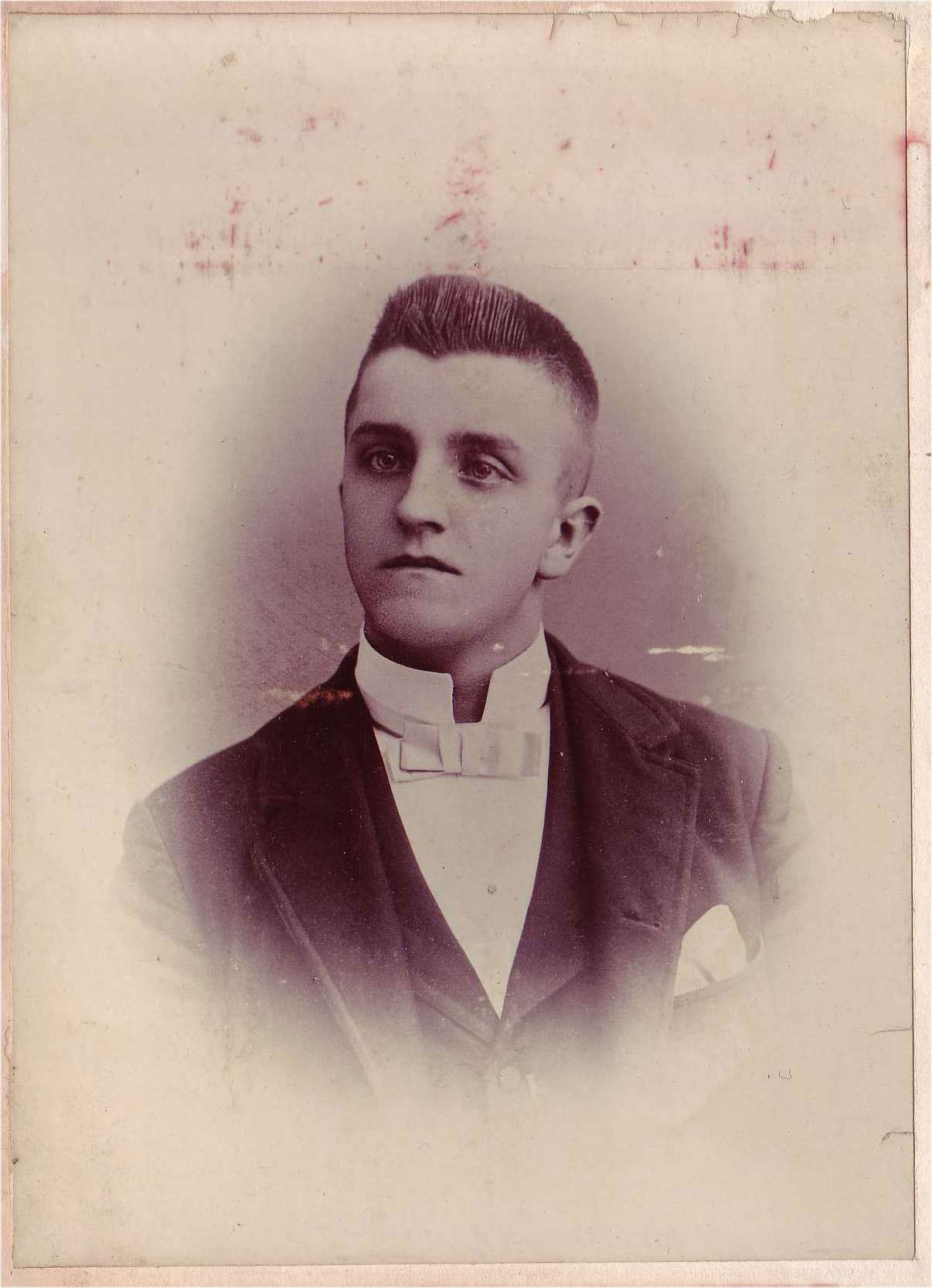
This image has remained unidentified for years and may never be definitively determined. But with the help of a Facebook page dedicated to helping us understand the date and context of a photo, we're a little closer to a theory.
This image comes from the collection of Catherine Petersen Mikkelsen, who rarely inscribed her photos because she probably assumed she'd always know who they were. We don't, of course, but she may not have anticipated the interest that future generations might have in her collection. It's likely a Petersen photo...but which Petersen?
“Citation: Digital reproduction of a photograph, front side, collection of Cathie Meyer, unidentified Petersen youth, original image undated and without photo studio imprint, cabinet card; original copy scanned in 2005, Chicago, Illinois.
The Facebook group "Genealogy CLUES- Dating Old Photographs" has been helpful in narrowing down the timeframe for this photo to the late 1890s, possibly even 1900-1902 based on the young man's collar, tie, and dress. His hairstyle is unusual for any timeframe, however. In fact, in the entire pantheon of Petersen families for whom we have pictures, there's only one fellow who has a similar look and hairstyle.
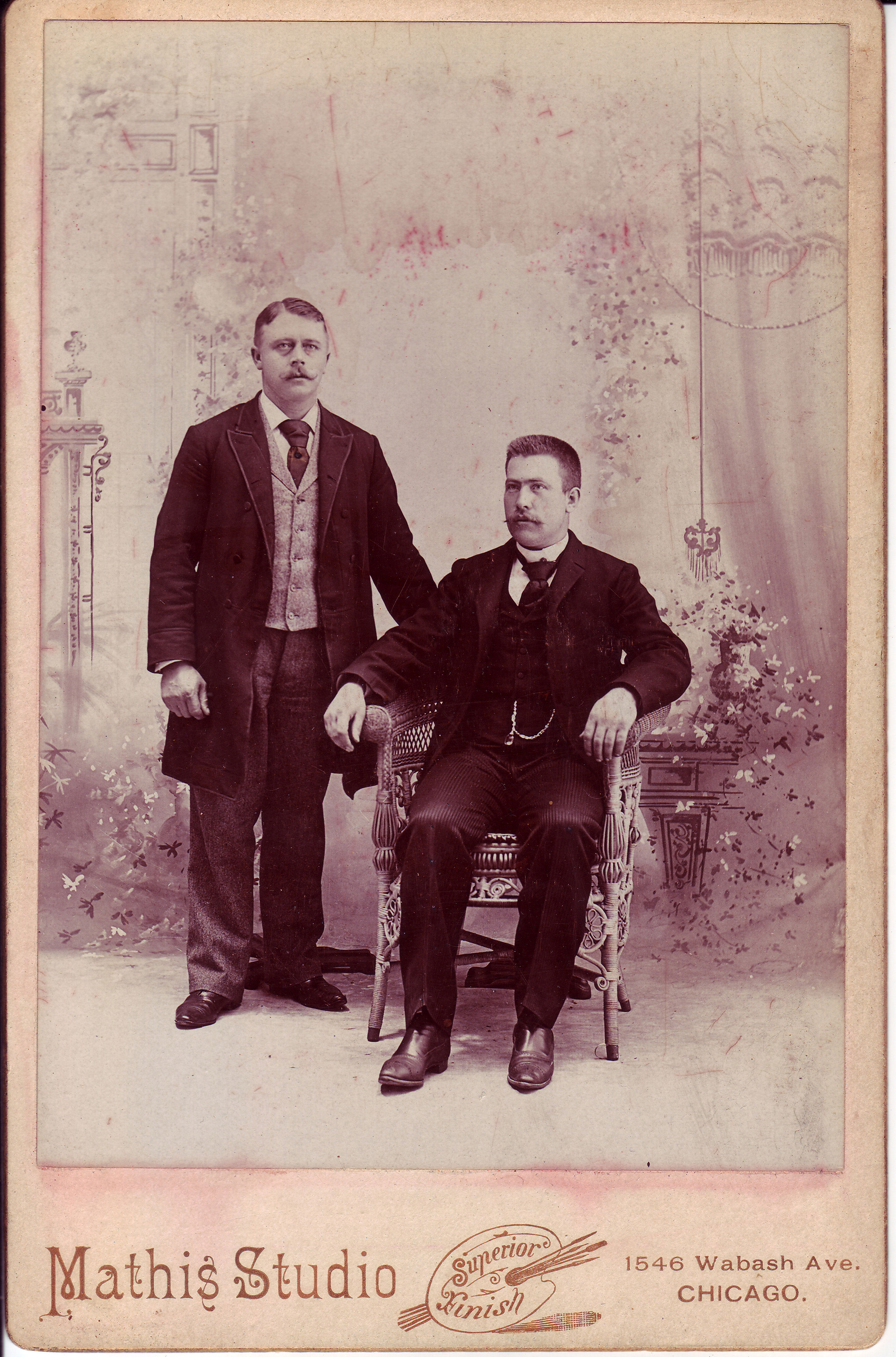
It's a spikey almost long crew-cut style that was unusual for the time, but the man on the right side of this photo had it as well, and we know who he is: Peter Edlef "Alfred" Petersen, one of the five Petersen brothers who emigrated to Nebraska from Nordfriesland in the late 1870s. The man on the left is Alfred's brother Ludwig, later Louis. The rounder face and soft hairstyle was common to the other four brothers, but Alfred's look was distinct. It resembles the young unidentified man very strongly.
If the young fellow can be dated to the late 1890s or early 1900s, there's only one candidate who this could be. Alfred had a son, Henry Peter Petersen, who was born in Hebron, Nebraska in 1885. If this is his image, he was about fifteen or sixteen. The formality of the photo suggests that it's a confirmation portrait -- the Petersens were big on confirmations.
We have photos of Catherine's own children, one of whom is the right age for this photo, but none of them look at all like this young man. Their faces are more round, their hairstyles dark and soft. We also have photos of Alfred's brother's family and none of them are old enough to match the age of this teenager. It also doesn't look like any of the relatives who remained in Nordfriesland.
Dare we give it a tentative identification of Henry, Alfred's son? It's tempting to do so, and it makes the most sense to me unless something more compelling explains who it is.
April 12, 2023 | Email your comment.
The Burmeisters of Sillerup
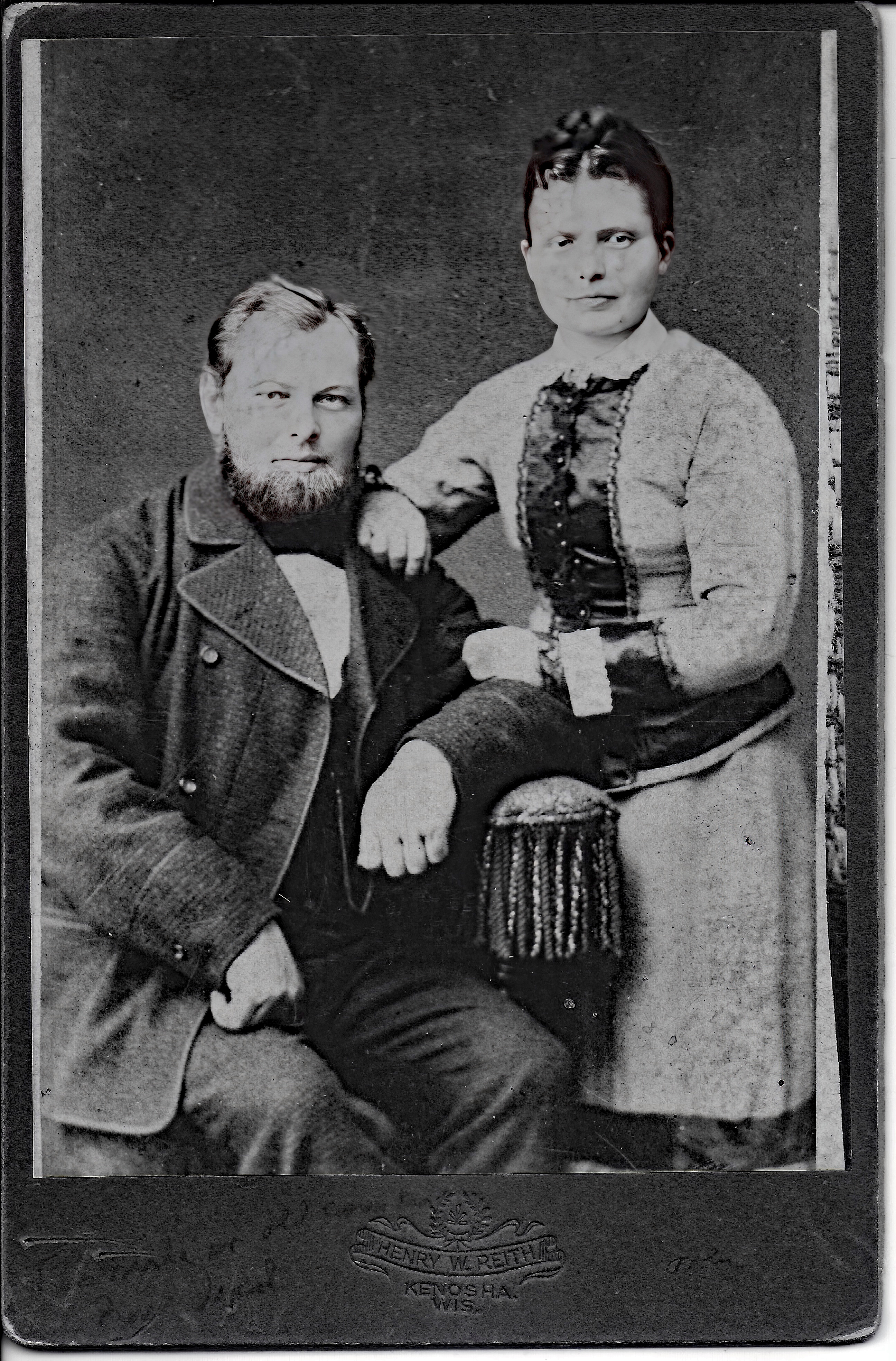
When I first saw this image in Catherine Petersen Mikkelsen's photo collection I had no identity for this couple. As a placeholder I called this photo "Danish Couple" because there was literally no information about them, not a caption or date or anything to suggest who they were.
In fact, Catherine's copy of this photo was slightly damaged with a prominent fingerprint on the left side of the emulsion and veering toward a reddish color where, predictably, Catherine's red-colored cardboard frame likely damaged the print. A second cabinet card, like its twin manufactured in Kenosha by the Henry W. Reith photography studio, emerged from the photo collection of another Petersen relative in Omaha, Nebraska, where Catherine's brothers lived. This version had a faint pencil notation indicating that it was Fritz and Helen Burmeister who had stayed in the "old country" and died there.
“Citation: Digital reproduction of a photograph, front side, collection of Donald Leu, Carl Friedrich (Fritz) Heinrich Burmeister and his wife Helena Petersen Burmeister, original image created in Nordfriesland and copied at the Henry W. Reith studio in Kenosha, Wisconsin circa 1885; original copy scanned and digitally enhanced by Topaz Photo AI version 2023.
The copy process likely took place in Kenosha because Catherine's brother Andrew Petersen lived there, and clearly he shared a copy with his sister in Chicago and his brothers in Omaha. The date on the Omaha version may be off by a few years. I suspect that this was actually take around the time of Fritz and Helena's marriage in Leck, Nordfriesland in 1874. The clothing style and Helena's hair fashion suggest it, but it could equally be from the later part of that decade. What's remarkable is that it turned up in two different family collections, and that the Omaha print had the all-important identifying caption.
Lately, thanks to our Nordfriesland cousin Mario Petersen, who is a direct descendant of Helena, we know a lot more about this peaceful-looking couple. After Fritz and Helena married in 1874 they ran a guest house in the town of Sillerup near Lindewitt -- in fact there's a photo of the guest house itself and Helena dressed in a hostess uniform ready to serve their customers.
What we didn't have was any concluding information about this couple, whether they lived anywhere else and when they died. We knew that Helena was a godmother to her granddaughter, also named Helena Marie Petersen, who was born in 1896 to Matthias Petersen (the elder Helena's son) and his wife Esther Louise Moller Petersen. That gave a statring point to researching the burial records in the parish of Leck, where all the primary events of their lives were documented. So starting from 1896 I searched through the records via Archion.de, which has excellent digital copies of every birth, marriage, and death in Leck for this time period.

It's a deliberate process. These records aren't indexed so it's essential to go through them page by page to find what you need. But the handwriting is clear and methodical, so that's a plus. I found Fritz' death record first in 1902, just after his fiftieth birthday. The clerk transposed his two middle names (close enough), he's listed as married, his profession is "Gastwirt" or guest house manager, and he's fifty years old. That's what we needed to know. Fritz had a brother, Adolf Burmeister, who lived in the region too, having relocated from their home village of Dodow in Camin-Wittenberg, Mecklenburg-Vorpommern. We don't know what happened to Adolf, but that's a separate research issue.

What about Helena? Working onward through the burial records resulted in her death in 1922 at the age of 73 -- 74, it's listed here, although the clerk may have been rounding his numbers up. She's listed as Helena Burmeister, no birth surname (usually the records indicated "geboren [surname]" when the clerk was being more informative), and is listed as a widow. She had no profession in this record so it's likely that she was living in retirement with her son Matthias, although the lack of census records for this region at this time make it difficult to confirm.
We know from ship manifests that Catherine Petersen and her second husband Thomas Mikkelsen visited Nordfriesland via Copenhagen in 1914 because we have a passenger list showing their return from the trip. It makes sense that Catherine would have wanted to visit her remaining brothers in Schleswig, the ones who never emigrated, and Thomas probably had relatives of his own in Ladelund, his birthplace. Catherine probably also visited Helena while on this trip, but we have no identifiable photos of such a reunion. Perhaps they'll turn up someday in someone's collection.
April 5, 2023 | Email your comment.
More about Teke/Teken/Deecke

When you examine the list of Teke/Teken/Deecken births from the 1700s in Visbeck, there's really only one candidate for the elusive Maria Gertrud, and that's the one in the image above, baptised on 23 April 1751. If she's the bride who married Joann Alardus Grave in 1781 and needed the dispensation to do so, one of our questions has been answered...but not all of them, alas.
“Citation: Imaged at Matricula Online (https://data.matricula-online.eu/en/deutschland/vechta/visbek-st-vitus/KB02_01/?pg=30 : 31 March 2023), baptism for Maria Gertrud Deecken, path: Startpage Deutschland Vechta, r.k. Offizialatsarchiv Visbek, St. Vitus Taufen | KB02_01 Image TA_030 via https://data.matricula-online.eu/en/ accessed 31 March 2023.
One of my favorite genealogists once said, speaking of documents prior to the 1900s, "Othography didn't exist --forget it." He was pretty much right! "Accurate" spelling simply wasn't a part of the mix. Clerks did the best they could to identify people based on the pronunciation of their names. In German, "t" and "d" might be pronounced the same, which probably explains the transcribed variations of the Teke/Teken/Deecken surname. That and the fact that women's names had the "-en" suffix tacked on to indicate the feminine ending of the name, which often became a part of the male version of the surname too.
So the father of Maria Gertud was Herman Heinrich Deeke, or Deeken, or Deecken...not much of a variation, actually. The mother of Herman Heinrich's children, Herman's wife, is pretty consistently spelled Anna Elisabeth Averbecke. An oddity: when this couple married on 26 Nov 1748 there were no witnesses to the marriage. Both were from Visbeck. Either they really had no witnesses or the clerk failed to list them, for whatever reason. That's a bother. We could have used the clues about those witnesses to draw more conclusions about who their relatives might have been.
As it is, from the godparents that are listed for their five children, it's a mix of Averbecke relatives (expected), people married to Deecke spouses (again, expected), or apparently unrelated folks such as Reineke, Grote, and Muckerheyde. If we dig deeper we might find a connection there as well. Then again, sometimes baptisms honored people who were not related to the child but who were associated with the parents in other ways. It's a puzzle that sometimes defies a clear solution.
We're dealing with a lot of "ifs" then, and that may be the best we can do. If this is the correct Maria Gertrud and if her father was Herman Heinrich Deecke, then possibly Herman was born 2 Feb 1723 to Johan Henrich Deke (another spelling change) and Geseke Dreß, with godparents for this child being Herman Deke and Marga Gert. Dreß, whose connection to the family is as yet unknown.
So far this doesn't tell us how Maria Gertrud Teke and Joann Alardus Grave were related to the point where they required a dispensation to marry. Was the close relationship on the Averbecke side? If so, that's not clear either. It's frustrating that the Visbeck parish priest knew about it and didn't leave us the details. But they probably never imagined that people almost three hundred years later would be trying to figure it all out.
March 31, 2023 | Email your comment.
The mysterious Miss Teken

If there was ever a controversy about a marriage, this is surely a prize-winner. When Joan Alardus Grave and Maria Gertrudis Teken married in 1781, the parish clerks and everyone else in it probably knew a dispensation would be required. The question is why was this required and who this conundrum involved.
Dispensations weren't that unusual in Visbeck. It was a smallish community and after a time nearly everyone was related to each other in some way. The local Catholic priests were more invested in making sure that whatever relationship the bride and groom had, it was distant enough not to be a problem. Here it appears that the couple had a fourth degree of consanguinity, most likely meaning that they shared an ancestor, maybe a great-great-grandparent, maybe a closer relative.
“Citation: Imaged at Matricula Online (https://data.matricula-online.eu/en/deutschland/vechta/visbek-st-vitus/KB04_01/?pg=10 : 25 March 2023), marriage dispensation record for Joan Alardus Grave and Maria Gertrudis Teken, path: Startpage Deutschland Vechta, r.k. Offizialatsarchiv Visbek, St. Vitus Trauungen | KB04_01 Image TR_056 via https://data.matricula-online.eu/en/ accessed 25 March 2023.
The problem is that we don't know what relative they shared, and for Maria Gertrud the church records are not revealing their secret. Clearly the clerks knew. The dispensation doesn't spell out who in their background was at issue. We can actually trace Joan (Joannes) Alardus Grave's ancestry back a few more generations, but not Maria Gertrud's. It appears that she's one of those elusive characters whose baptism and death records can't be found, despite relatives and ancestors waltzing in and out of the picture at stated intervals. We have the marriage record and the births of their five children. We have Joan Alardus' death record. But that doesn't help us find Maria Gertrudis.
One complicating factor: the spelling of her surname goes through transformations. Teken seems to be the exception. That's the way it's spelled in this marriage record, and her relative's surname appears that way too. But in earlier and later records it appears as Deeke, Decke, Decken, even Teckman. I made a list of everyone with that surname and its variants from 1739 through 1765, the likely timeframe for her birth (considering that she wasn't likely to have married younger than fifteen years old). The infant's name is first, then the parents, then the godparents, which may or may not reveal a connection clue. All spellings and abbreviations are original.
- 1739 Mar 18 Catharina Margaretha to Gerhard Henrich Deeke and Maria Free: Anna Margaretha Free and Wilkinus Deeke
- 1740 May 19 Maria to Johan Deke and Catharina Borgers: Johan Henrich Deke and Maria Borgers
- 1742 May 10 Catharina Maria to Gerhard Henrich Deecken and Maria Angela Meyer: Maria Nordtman and Johan Henrich Meiners
- 1748 Nov 26 Herman Heinrich Deeke to Johan Henrich Deke and Geseke Dreß: Herman Deke and Marga Gert. Dreß
- 1749 Gesina Maria to Herman Henrich Deecke and Anna Elis. Averbeke: Anna Marg. Deeke and Caspar Reineke
- 1750 Feb 15 Anna Catharina to Johan Decke and Marg. Maria Meyer: An. Cat. Deeken from Holtrup and J.H. Meyer
- 1749 Oct 3 Gesina Maria to Herman Henrich Deeke and Anna Elis. Averbecke: Anna Marg. Deeke and Caspar Reineke [Caspar was married to Maria Gertrud Averbecke]
- 1751 Apr 23 Maria Gertrud to Herman Heinrich Deeken and Elisabeth Averbecke: Maria Gertr. Averbecke and Gerd Heinrich Grote
- 1754 Jan 27 Johann Henrich Deeke to Herman Henrich Deeke and Elisabeth Averbecke: Johann Poelman (married to a Maria Deeke) and Gesina Averbecke
- 1756 Aug 9 Maria Elisabeth to Herman Henrich Deeke and Marg. [sic] Elisabeth Averbecke: Maria Deeken and Herman Muckerheyde
- 1757 May 15 Joan Bernard to Joan Deeke and Marg. Maria Meyer: Bernard Albers and A.C. Pulsfoert u. Meyer
- 1758 Mar 9 Twins: Herm. Henr. and Joes. Gerh. to Hermannus Henricus Deeke and Elisabeth Averbecke: 1. Henricus Siever c. [condictus = known as] Averbecke and Marg. El. Grote 2. Wilkinus Deeke and Catharina Averbecke
- 1764 Nov 24 Maria Gertr. to Joann Deecke and Marg. Maria Meyer: Maria Gertrud Meyer, Berendt Dobbeler
- 1765 Apr 14 Maria Cath. to Herm Henrich Deecke and Anna Maria Ostendorff: Cath. Gertr. Ostendorff, Joann Henr. Grothe
- 1765 Oct 15 Joann Gerdt to Gerdt Henrich Deeken and Maria Zumdorff: Joann Buschelmann, Maria Gertr. Deeken
- 1766 Oct 25 Anna Maria to Joann Henrich Deecke and Maria Ostendorff: A.M. Timmermann c. Grothe, J.H. Schillmoller
There's only one Maria Gertrud born in 1751, but there's no way to know whether that's her from this information. The constellations of surnames don't show up in the marriage record except for one, Schillemöller, probably Johann Henrich here, Fridericus in the marriage record. Other than that, Averbeck surnames abound. But none of them in the list above have any concordance to the marriage record, so none of them tell us about the birth/baptism of Maria Gertrud.
Where do we go from here? That's a next step.
March 25, 2023 | Email your comment.
Found! Right where she ought to be...in Oythe

A little detail such as the lady's town of origin would have made this search a lot easier, but I didn't have that information. None of Maria Pulsfort's available documents -- birth of her first child in 1817 or death in 1846 -- mentioned where she'd bee born. And because I didn't have any clue about that, I couldn't find her marriage either, since it's common that women were married in their own home parish.
Next step: I figured that Maria had to have been born in the region. People didn't stray far from their home territories as a rule, especially unmarried girls. And this lady had four first names. How hard was that going to be?
The Matricula Online database has a plethora of parishes and I figured that if all else failed I could just go through each one and look at the exact date where her baptism was supposed to have been recorded. After all, I had her death record from 1846 and that included her exact age: 53 years, five months, ten days. There are some helpful calculators online, my favorited being the Tombstone Birthday Calculator. So her birth/baptism date ought to be February 8, 1793 or thereabout. She wasn't in Visbeck so she had to be in one of the surrounding parishes.
“Citation: Imaged at Matricula Online (https://data.matricula-online.eu/en/deutschland/vechta/oythe-st-marien/KB02_01/?pg=64 : 15 March 2023), death and burial record for Maria Anna Ludovica Catharina Pulsfort, path: Startpage Deutschland Vechta, r.k. Offizialatsarchiv Oythe, St. Marien Taufen | KB02_01 Image TA_066 via https://data.matricula-online.eu/en/ accessed 15 March 2023.
I got through about twenty parishes up through those starting with "L" but then got discouraged. No indexes exist for these records, but wasn't there a better way? Maybe someone else had looked her up elsewhere. Ancestry? Nothing there. How about Geneanet?
Geneanet offers free and subscription options for searching records that other researchers have put online, mostly from their own trees. That can be a dangerous route if the researcher's information isn't well sourced, but there might just be enough for a clue. I decided to look for Maria by her full name, but nothing was there. Then I decided to look for Bernd Pulsfort, who had been a godparent at her first child's baptism in 1817 in Visbeck. Who was Bernd? A brother or father of the mother? No matter, something did come up: there was a Bernard Pulsfort born before 1799 in Oythe.
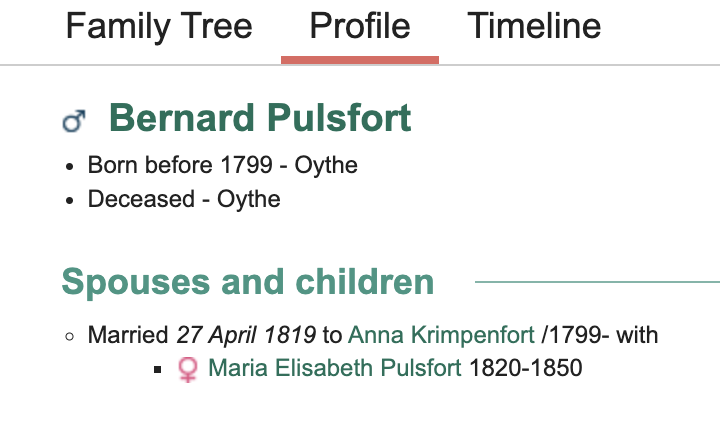
Oythe! It was a parish just a few kilometers from Visbeck, could be an option. So I looked for a Maria Pulsfort born around February 8, 1793...and there she was, right on the dot for her correct baptism date. The Geneanet entry didn't have exactly what I wanted but what it did have was enough of a clue to help me find Maria.
And now that I knew Maria's parish, I could search around for her marriage, which should be within a few years of the birth of her child Maria Elisabeth Grave in 1817. Sure enough, there was the marriage in 1816, also in Oythe as expected, to Johann Heinrich Grave. This marriage record confirmed Maria's parents' names, clarified her father's occupation (a tenant farmer on an Oythe estate). Not surprisingly Bernd Pulsfort was a witness to the marriage -- almost certainly a brother of the bride -- and a Johann Heinrich Fernhorn, about whom we know nothing.
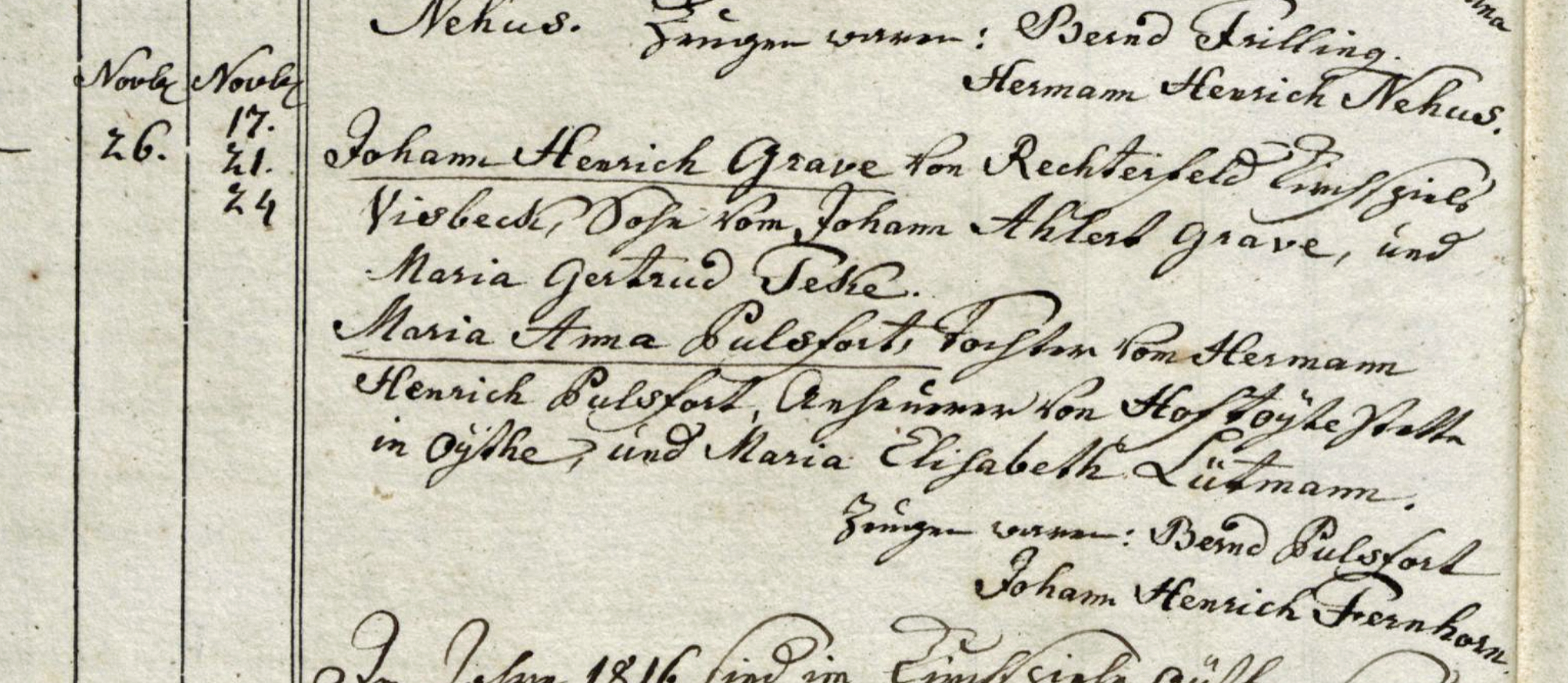
Maria's baptism record also points out the use of an alternative surname in the family. Maria's mother is identified in the baptism record from 1793 as Maria Elisabeth Altehoff, whereas in the marriage record from 1816 she's Maria Elisabeth Lüttman. A brief foray through the Oythe baptism records reveals that the daughter Maria was the last (or one of the last) children born to this couple and that the parents used an alternate surname of Altehoff.
Maria's father is listed as "Pulsfort sive Altenhoff" or "Pulsfort disctus Altehoff", called Altehoff, probably taking the name of the farm estate where he worked. Maria's mother was born Lüttman but also used Altehoff has her surname in the baptism records of some of her children. This made it easier for the parish officials to identify the person in question, for instance if there were too many other families called Pulsfort. You knew you had the right one this way.
Now it should be possible to work our way back to see whether we can identify the origins of Maria's parents.
March 15, 2023 | Email your comment.
On the hunt for an elusive multi-named lady
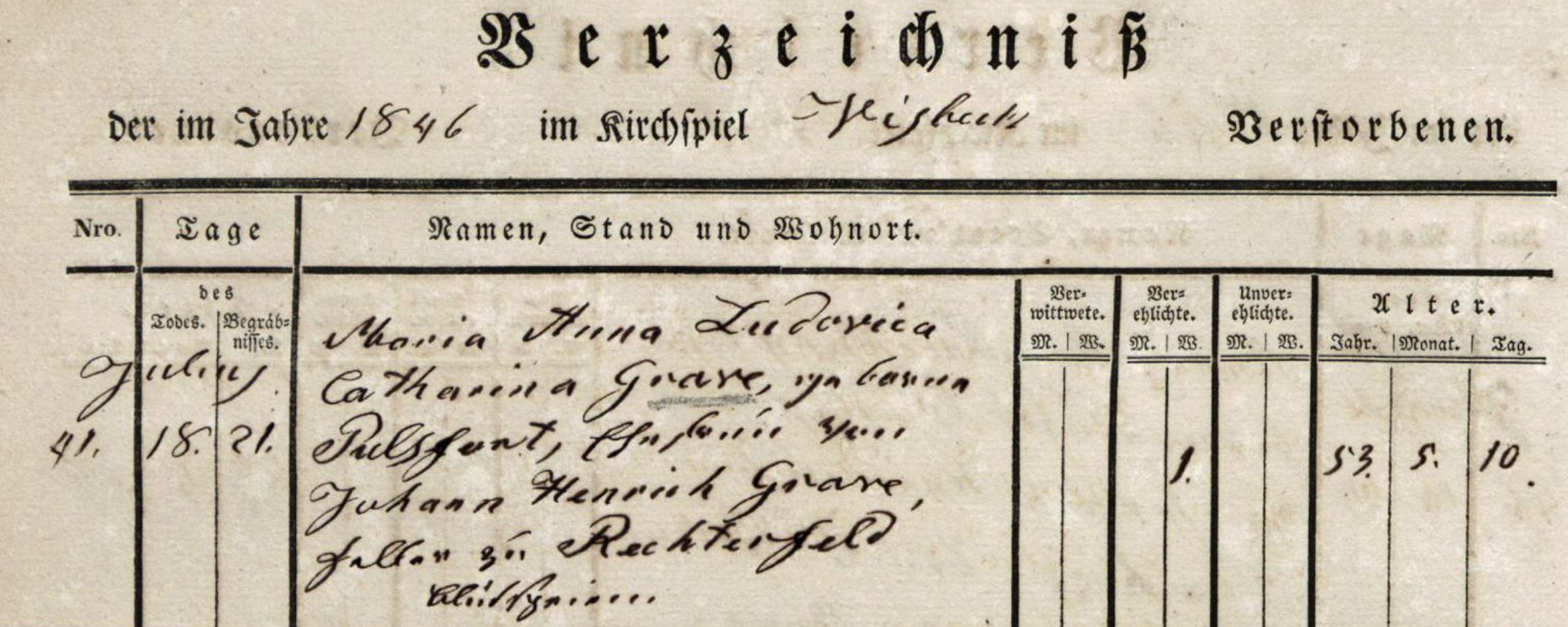
When I found Maria Elisabeth Grave's baptism record, I was happy to see her parents' names listed so clearly. This was something we'd lacked in the records she left in the United States. Not one other record -- marriage, death, emigration, naturalization -- mentioned who her parents were, so this line was more or less quiescent until the Matricula Online records helped us clear the mist from the past.
“Citation: Imaged at Matricula Online (https://data.matricula-online.eu/en/deutschland/vechta/visbek-st-vitus/KB10/?pg=31 : 10 March 2023), death and burial record for Maria Anna Ludovica Catharina Pulsfort, path: Startpage Deutschland Vechta, r.k. Offizialatsarchiv Visbek, St. Vitus Beerdigungen | KB10 Image B_030 via https://data.matricula-online.eu/en/ accessed 10 March 2023.
Pulsfort is not a common name in the region. There are a handful of Pulsfort surnames in the Vechta region as early as the seventeenth century. There's a 1652 marriage of a Willhelmus Pulsfort in Vechta St Georg. Is this fellow related to the Maria Pulsfort who married Joannes Hinrich Grave sometime around 1817? We don't know, mainly because our Maria Pulsfort is an elusive lady. We don't know where she married (marriages usually occurred in the bride's parish) so we can't follow her family back in time.
Nor was Maria Anna Ludovica Catharina Pulsfort born in her current partsh of Visbeck. The exact age of 53 years, 5 months, 10 days is extremely useful, but looking back at the records for 1793, where her birth ought to be, she's not in Visbeck. Neither is she in a handful of other close local villages. Where's she hiding? With all those names she ought to be prominent.
There's a clue in the birth/baptism record for her presumed firstborn daughter. A Bernd Pulsfort is one of the godparents to the child born in 1817. Is this the child's grandfather or uncle? Good questions, but at the moment we don't know. He's not identified according to his village of origin.
There are Pulsfort families in neighboring villages such as Dinklage and Emsteck. The research plan could involve a systematic review of every parish in Vechta to see whether we can locate Maria in and around the year 1793, give or take a few years on either side -- remembering that clerks made mistakes and could have miscalculated her age at death. It'll take some time but eventually we hope to find her birth and discover more about her own ancestral line.
March 10, 2023 | Email your comment.
Brick wall: gone with the wind
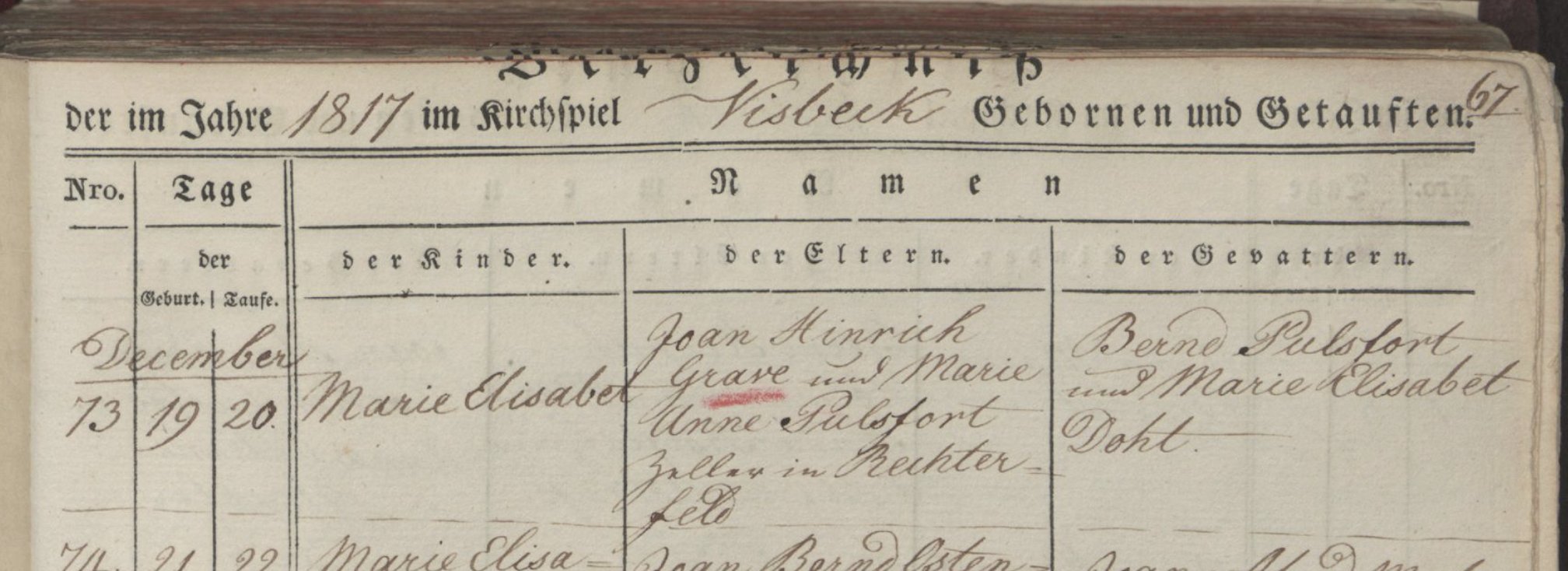
Finding a new online database is always an exciting prospect, and this is no exception. Recently someone on an email mail list I subscribe to mentioned Matricula Online, a compendium of various Catholic records. Why had I never paid attention to this before? No one knows...but this time I sat up straight and took notice.
I have only a few ancestral lines that involve Catholic records, and one of those regions is represented by a Matricula Online collection: Vechta in the region of Oldenburg. Here I have a plethora of folks who have surnames such as Bruns and (as I used to believe) Grewe. Turns out Bruns was right, more or less, but Grewe is actually Grave, and they're pronounced almost identically. No wonder our emigrant family in Cincinnati had trouble figuring out what it was.
“Citation: Imaged at Matricula Online (https://data.matricula-online.eu/en/deutschland/vechta/visbek-st-vitus/KB05/?pg=38 : 7 March 2023), baptism of Maria Elisabet Grave, path: Startpage Deutschland Vechta, r.k. Offizialatsarchiv Visbek, St. Vitus Taufen | KB05 Image TA_037 via https://data.matricula-online.eu/en/.accessed 7 March 2023.
The name in the past was spelled Grawe on Mary Elisabeth's daughter Mary Robben’s death certificate in Cincinnati, spelled Graweba on her son George H. Bruns’ 1916 death certificate in Chicago, and in the Cincinnati Freie Presse her maiden name was listed as Grewe, as well as Greve in her son Augustus Bruns’ marriage record from Cincinnati. Who could make sense of it?
We also had the birth and baptism date wrong, somehow reported as November 27, 1817. The year was right but the date was a month off. Looking at the 1900 U.S. federal census we can see that Mary Elisabeth reported her birth month to be December 1817. And that's what her baptism record confirms, as shown in the image above.
For the first time after nineteen years of searching we have her parents' names, Joannes Hinrich Grave and Marie Elisabet Pulsfort, with godparents listed as Berndt Pulsfort and Marie Elisabet Doht. The first is likely a close relative (mother's father or brother, perhaps?) but no clue about Elisabet Doht. More research is needed to find out.
And that's something we can look forward to performing! The records for St. Vitus Parish in Visbek go back to 1651, so there's a lot to explore once we get started. What's really remarkable is how -- if you wait long enough -- the resources online often reveal secrets that have been hidden for decades. All that's required is patience.
March 7, 2023 | Email your comment.
The ephemeral Barbara Hartkorn

Anytime you find records that are more than one hundred years old you're bound to encounter issues with reliability. It's not necessarily the fault of the people in charge. Mistakes are made, transcriptions are misspelled, clerks are distracted. It happens.
The image above is particularly extraordinary. If you have surnames such as Jatho, Schuckmann or Schuchmann, Dressel, or Künzel/Kientzle, you descend from this family. The very existence of this document is a miracle. Considering what can happen to old church books -- lost portions, damaged pages, total destruction -- having a document that details our ancestor from the time of Shakespeare's birth is a wonder. Only the clerk appears to have mis-transcribed the child's name.
“Citation: Imaged at Archion (http://www.archion.de/p/896416b465/ : 3 March 2023), baptism of Barbara [sic]/Maria Hartkorn 8 February 1562, path: Browse > Württemberg: Landeskirchliches Archiv Stuttgart > Dekanat Tübingen > Remmingsheim > Mischbuch 1558-1719 Band 1 Image 7 via Archion.de.accessed 3 March 2023.
From other records in this collection we know that there were two if not more men called Martin Kientzle, one of them (perhaps this one) the son of a mayor of the local village of Nellingsheim. We don't have this one's marriage record, which would have taken place within a few years of this baptismal event. Martin was probably born around 1535-1540, his wife Barbara around the same time. Their child listed here is Barbara, same name as the mother, baptised February 8, 1562. A year later this same couple had a son, Johannes. Those are the only two children we can find for this couple.

The trouble is that Barbara never turns up again. She didn't marry in the parish of Remmingsheim, she didn't show up as a godparent to anyone's children, and she doesn't appear in the list of deaths for Remminsgheim. She disappears.
But a Maria, daughter of Hans Hartkorn, does appear in 1589 as the bride of Martin Kientzle of Nellingsheim. Martin and Maria have eight children from 1590 through 1606. A Martin Kientzle's death is recorded in 1612 in Remmingsheim -- might be the one married to Maria or might be an older one married to Anna Trüberin. Maria's death is recorded on January 19, 1633. If you calculate her birth year from her age, listed here as 70 years old, it works out perfectly to 1562, the year where the ephemeral Barbara Hartkorn's baptism is recorded.
Clearly Hans Hartkorn and his wife Barbara didn't have twins in 1562 or both names would have been indicated. Maria couldn't have been born in 1561 because the records don't indicate any such birth. Neither is one recorded from 1559-1560. And in 1563 the son Johannes was born. From 1563 onward there's no record of a child Maria being born to Hans and Barbara Hartkorn. In fact no further children of this couple are recorded.
The pages for these years appear to be intact with no apparent interruption in sequence. The only likely scenario: the clerk wrote down the wrong name in 1562, accidentally indicating the mother's name as the infant's name. Maria Hartkorn's presence is established. There appears to be no Barbara except for this questionable entry in a church book almost five hundred years old. And no one went back to correct the record or make an explanatory notation suggesting what may have happened.
Conducting a reasonably exhaustive search for alternatives is our only option, and turning to Occam's Razor, the most likely explanation is a clerical error. No one will ever tell us for certain. This makes the most sense, and sometimes the most sense is the best we can do.
March 3, 2023 | Email your comment.
Afternoon in the garden
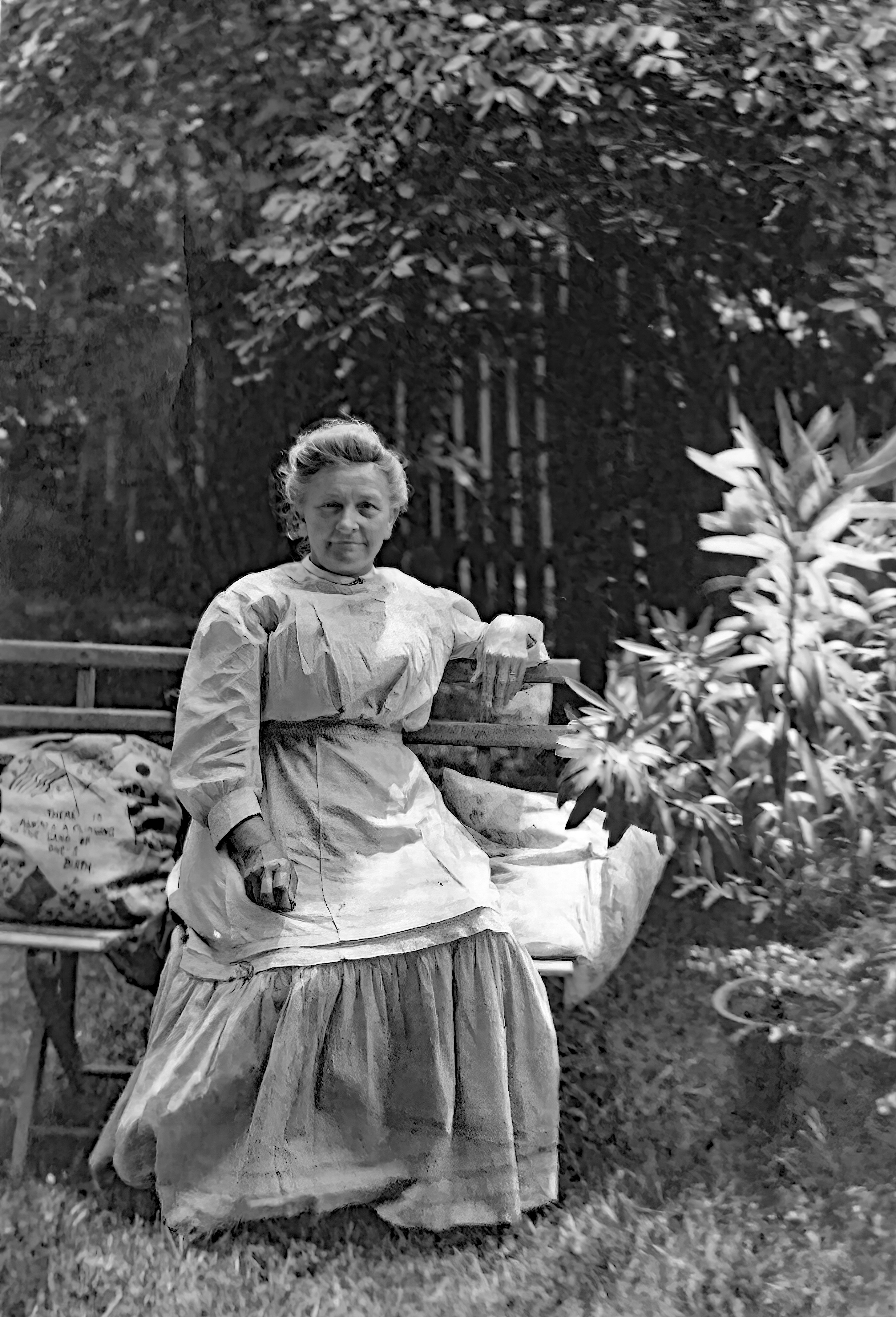
There's some uncertainty about the identity of this lady. My Mikkelsen cousin has it identified as Anna Sofia Mikkelsen Jensen, who was born in 1876 in Ladelund, Nordfriesland to Thomas Mikkelsen and his wife Helene Sievertsen. But there are elements that suggest this could be someone else. We just don't know who.
“Citation: Digital reproduction of a photograph, front side, collection of Rosemary Douglas Alewine, Anna Sofia Mikkelsen Jensen, Chicago, Illinois about 1925; original copy scanned and digitally enhanced by Topaz Photo AI version 2023.
Anna came to America originally in 1887 with her mother and siblings to join Thomas, who had emigrated to Chicago. Something happened, we don't know what, and Helene and the children returned to Ladelund. One by one, as the children were older and could travel, they returned to Chicago to be with their father. Anna came back to Chicago in 1892. She was only sixteen but decided to marry a fellow immigrant, Neils Jensen, that same year. She and Niels raised four children in Chicago.
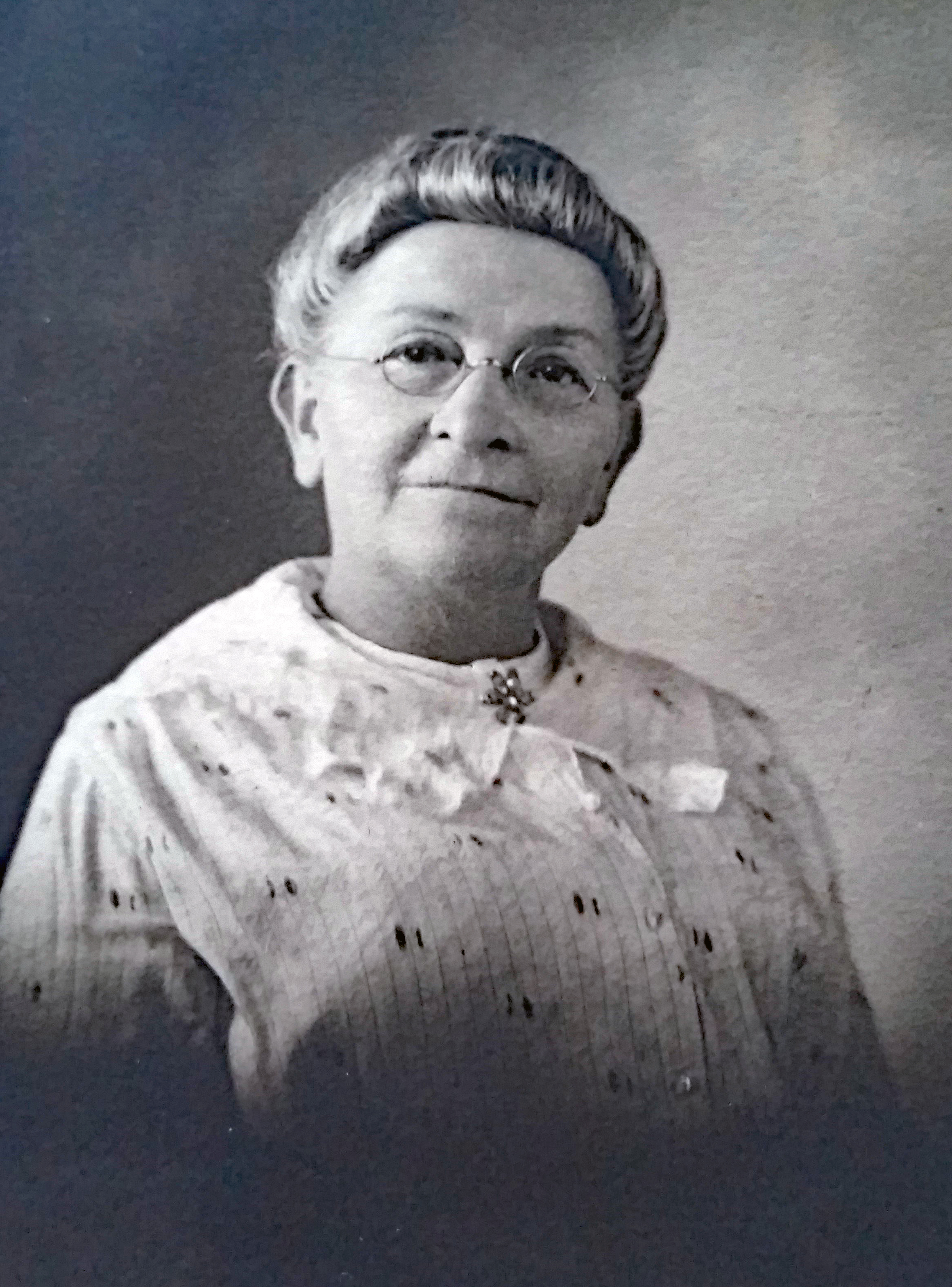
The thing with Annie's photos: she always was pictured wearing wire-rimmed glasses. We can't find a portrait where she didn't wear glasses...except for this photo above. She may actually be holding them in her right hand as she relaxes in the garden on this warm afternoon.
In terms of age, this woman in the garden also looks older than someone would look who was born in 1876, and her style of dress looks more common for the era from about 1910-1920. But this is another trap of identifying old photos. Depending on one's family genes, any person could age beyond what was common for their era, and anyone (particularly older folks) could cling to dress styles that they'd grown used to in younger days. This might be the case with Annie. Was it taken in 1920, 1925, or even 1930? We can only guess.
And we can be fairly certain that this photo was taken in Chicago. The pillow to Annie's right has a bit of embroidery on it in English, perhaps done by one of her daughters, Marie or Alma.
We'll continue to explore options to successfully date identify and date this photo. It's possible that other Mikkelsen cousins may want to weigh in too.
February 25, 2023 | Email your comment.
Tiny spark
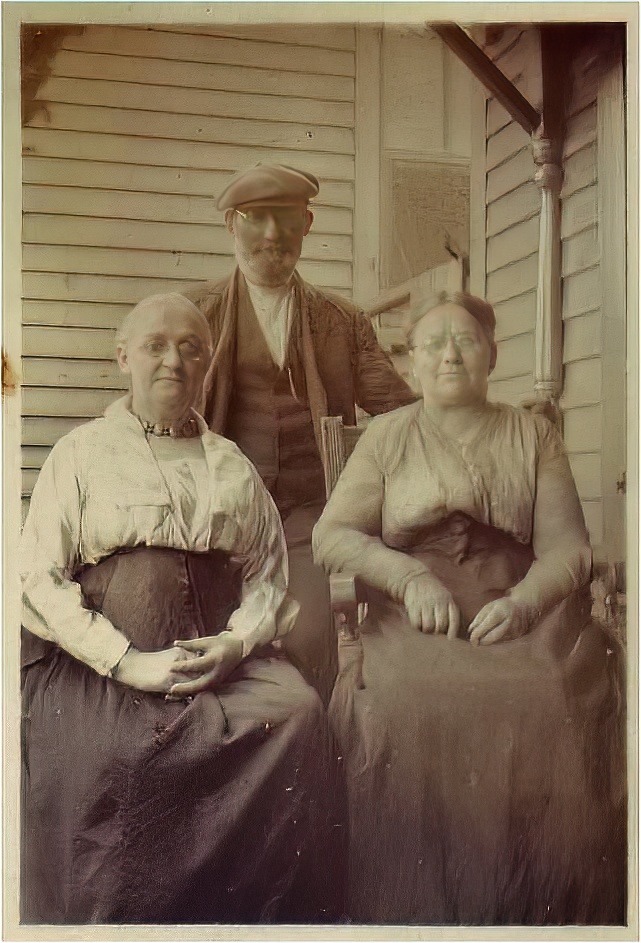
Sometimes it takes years for the obvious answer to pop up. And when it does, you wonder why it took so long.
This is a nice snapshot taken about 1910 on the front porch of the home of the Mikkelsens. Thomas is standing. His wife Catherine Petersen Mikkelsen is seated at the right. We don't know who the lady is at left wearing the remarkably intricate necklace. A neighbor, a good friend, a relative? That's typical of Catherine, who rarely marked her photos so later generations could know who was in the portrait. And that's not the point of this post.
Thomas and Catherine were old friends when they courted and married in 1906. That much is obvious. Thomas had been married twice already, once to Helena Cecilia Sievertsen of Leck, who followed him briefly to Chicago but divorced him in 1887 and went back to Schleswig; and once to a Maria Hansen, about whom we know nothing, who was born in 1842 in Germany and was probably little more than a housekeeper for Thomas until she died in 1902.
“Citation: Digital reproduction of a photograph, front side, collection of Catherine Meyer, Thomas Mikkelsen, Catherine Petersen Mikkelsen, and unknown lady, Chicago, Illinois; original copy scanned in 2006, enhanced Topaz Photo AI version 2023.
Catherine Petersen was also born in Leck in 1962 and married her first cousin Hans Petersen in Nebraska in 1878. He died in 1905 in an unfortunate drowning in Brookfield, Wisconsin. Catherine and Hans had eleven children together, six of whom were still alive in 1906. Catherine and Thomas presumably had kept in touch over time. I'd wondered whether Thomas and Hans were old pals from the old country, having grown up in neighboring villages. Thomas' first mother-in-law was a Petersen, Anna Catharina Botilla, who married Jacob Broder Sievertsen. Helena's mother was Anna, sister of Catherine's father Peter Hansen. That means that Catherine and Helena were first cousins.
There it is! That's the connection. It might not seem entirely sensible to choose a wife who was a cousin of the lady who divorced you. But maybe Helena and Catherine were as different as a night and day. Who knows what the attraction was? It seems obvious now. Of course Thomas knew Catherine. Maybe there was always a tiny spark between them ready to be nurtured into love.
These were small towns and people felt a kinship with their neighbors, even after they emigrated and resettled elsewhere. It was certainly the case that Catherine welcomed Thomas' children from his first marriage and there are plenty of photos showing their get-togethers. And Thomas must have been a friendly influence in the home they shared as a stepfather to her children. One of Catherine's sons even named his firstborn son after Thomas.
Nothing happens in a vacuum. There's always a clue about relationships in the details of our relatives' lives, and it pays to attend to them. At least now I won't be endlessly ruminating about how the romance got its start.
February 19, 2023 | Email your comment.
Four brides and their foliage
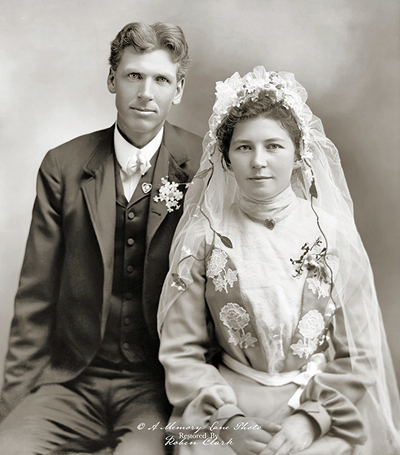
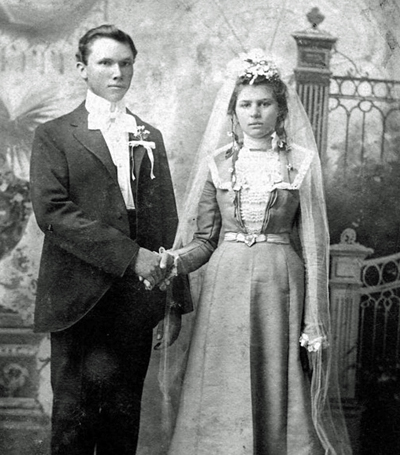
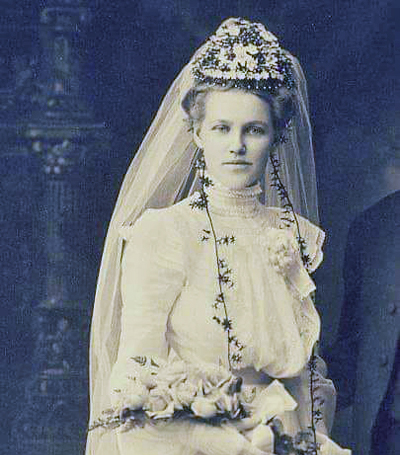
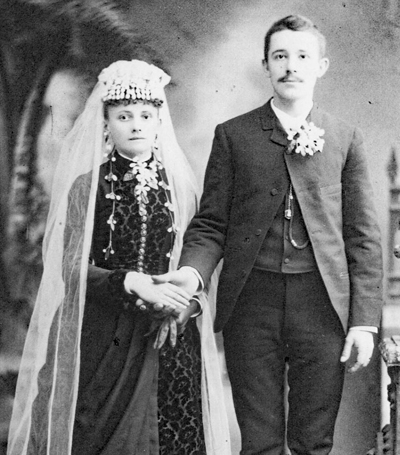
Apparently wedding bouquets were only popularly introduced in the 19th century, but I noticed a unique custom among some brides who usually had a Germanic or Scandinavian background: a strand of leaves or flowers! What did it mean?
I noticed it in some posed photos from the 19th and early 20th centuries. A strand of greenery and/or flowers appears to be draped around the back of the bride's head and around the ears and over the shoulders down the front of the bodice. Sometimes the strand appears to be just leaves, sometimes blossoms, and sometimes both.
The handsome couple in photo 1 shows a strand of leaves wending its way around the bride's veil. In photo 4 we know more about the couple, who are Catharina and Hans Petersen, both of Leck and Tinningstedt in Nordfriesland. Catharina's strand appears to include lily-like florets as part of the veil, trailing down her velveteen dress.
“Citation for image 1: Digital image from a glass negative, studio of John (Jno) Johnson of Centerville, South Dakota, circa early 1900s, Mary Jane Dunkin and August (Gus) Hartig, collection of Robin Clark at Memory Lane Photo Restoration, https://memorylanepr.com/, accessed 14 February 2023.
These brides sometimes carry bouquets as well but the flower/leaf strands appear to be unique to a style seen only in northern Europe. We know that in ancient times some cultures used strands of herbs to protect the bride against evil spirits, and ivy was a popular choice in ancient Greek ceremonies because it symbolized eternal love.
But what did it mean for these brides? Perhaps a sweet-scented addition to the dress? There were also "garland dances" where the bride and groom would be linked by a garland of flowers as they danced together. Perhaps this decorative element was a remnant of that tradition.
These brides also seem to wear a unique floral crown or cap, not a wreath per se but a floral addition woven into the top of the veil, probably made of lace. In three of the examples the bride also wears a non-white dress of pastel or deeper colored fabric. White was popularized by Queen Victoria in England when she wore a white gown for her marriage to Prince Albert. Less opulent marriages required the bride to repurpose her gown for special occasions after the wedding, and the more decorative the color, the easier it would be to clean and preserve. The brides of yore were practical.
February 14, 2023 | Email your comment.
Lina Christina Petersen and the New World

Sometimes you have a spare moment on your hands and perform a genealogical palate cleanser by looking at something other than what you're looking for. And sometimes you find a clue completely unrelated to your search but intriguing in its own right.
That's what happened here, when a completely random search for Petersens not in Nebraska resulted in a 1963 social security claim from a family called Passler for a lady called Lina Christina Passler, whose maiden name was Petersen and whose parents were Christian N. Petersen and Ingeborg Jensen and who apparently lived in Spokane, Washington.
For good measure, the deceased Mrs. Passler shared the same birthday, July 24, as our Lina Christina, although the year was off by a couple of digits. That's not unusual. People forgot or didn't know their own birth year, or had reason to pretend that it was something else. It's not enough to reject a coincidence out of hand.
“Citation: Imaged at Archion (https://www.archion.de/en/viewer/?no_cache=1&type=churchRegister&uid=264287 : 5 Februrary 2023), baptism of Lina Christina Petersen 12 October 1879, path: Browse > Norddeutschland: Landeskirchliches Archiv der Evang.-Luth. Kirche > Kirchenkreis Nordfriesland > Leck > Taufen 1879-1907 Image 10 via Archion.de.accessed 5 February 2023.
Godparents of the child were interesting. They included a Hans Johnsen (or possibly Johansen originally) and Elena Petersen Burmeister, the child's paternal aunt and for whom Lina was named. But this record doesn't tell us anything -- or confirm anything -- about Lina's later peregrinations across the pond.
Our Petersens did emigrate to America but until now we know it was to Nebraska and later to Chicago and Kenosha, all in the midwest. This would be a first: a Petersen going to the West Coast. What was there?
Lina's 1906 passenger manifest shows her traveling with friends or relatives called Johnson and Petersen from regions near Leck, where Lina was born, headed to a friend's home in Almira, Washington, a Julius Johnson. Interestingly, a Julius Christian Johnson had settled in Almira and had become a prosperous banker, an attractive destination for any family looking for a start in the New World. Was Julius Johnson related to the Hans Johnson who was Lina Christina's godparent? It's very likely.
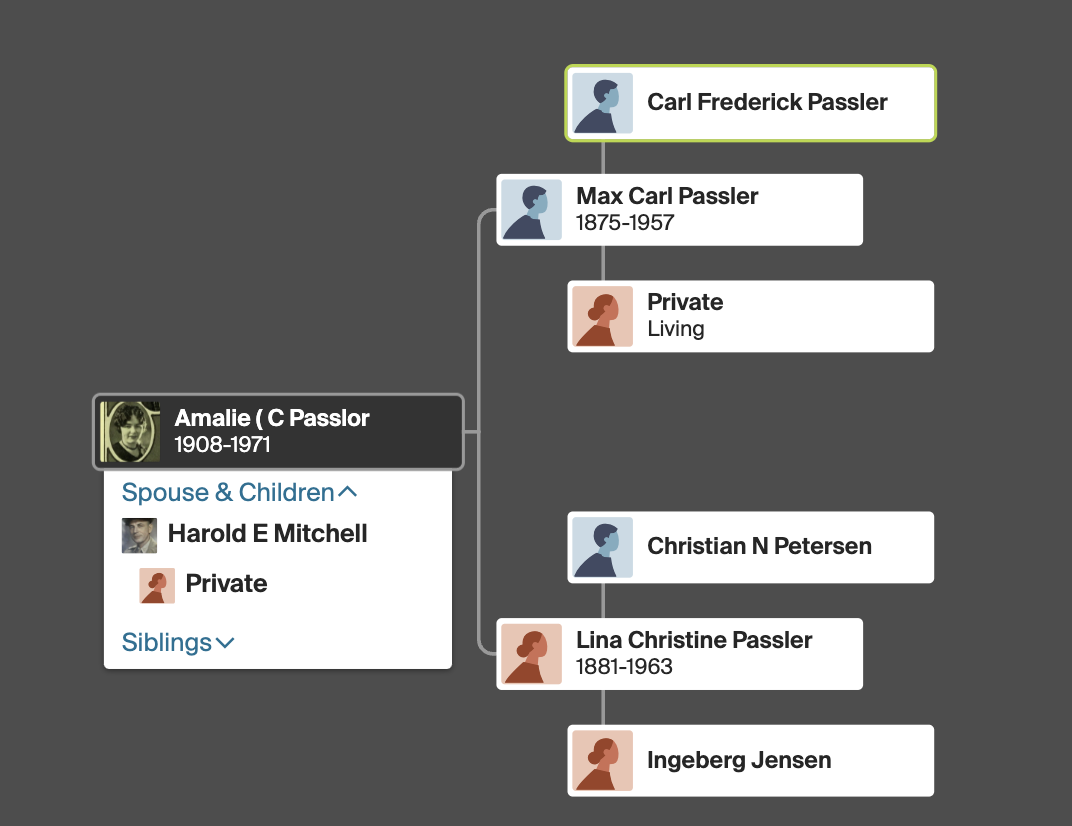
This is where autosomal DNA can clear the air. I had a match with a lady whose tree includes Lina Passler, her husband Max, and daughter Amalie. The match is distant but definitive. It's one of the useful tools that a genealogist has at his or her disposal and it can verify a connection where other documentation can only provide strong hints.
I've written to the lady with whom I match to see whether she'd like to share Petersen information. Goodness knows we have a treasure-full of documents to provide!
February 6, 2023 | Email your comment.
A family portrait: who's really who?
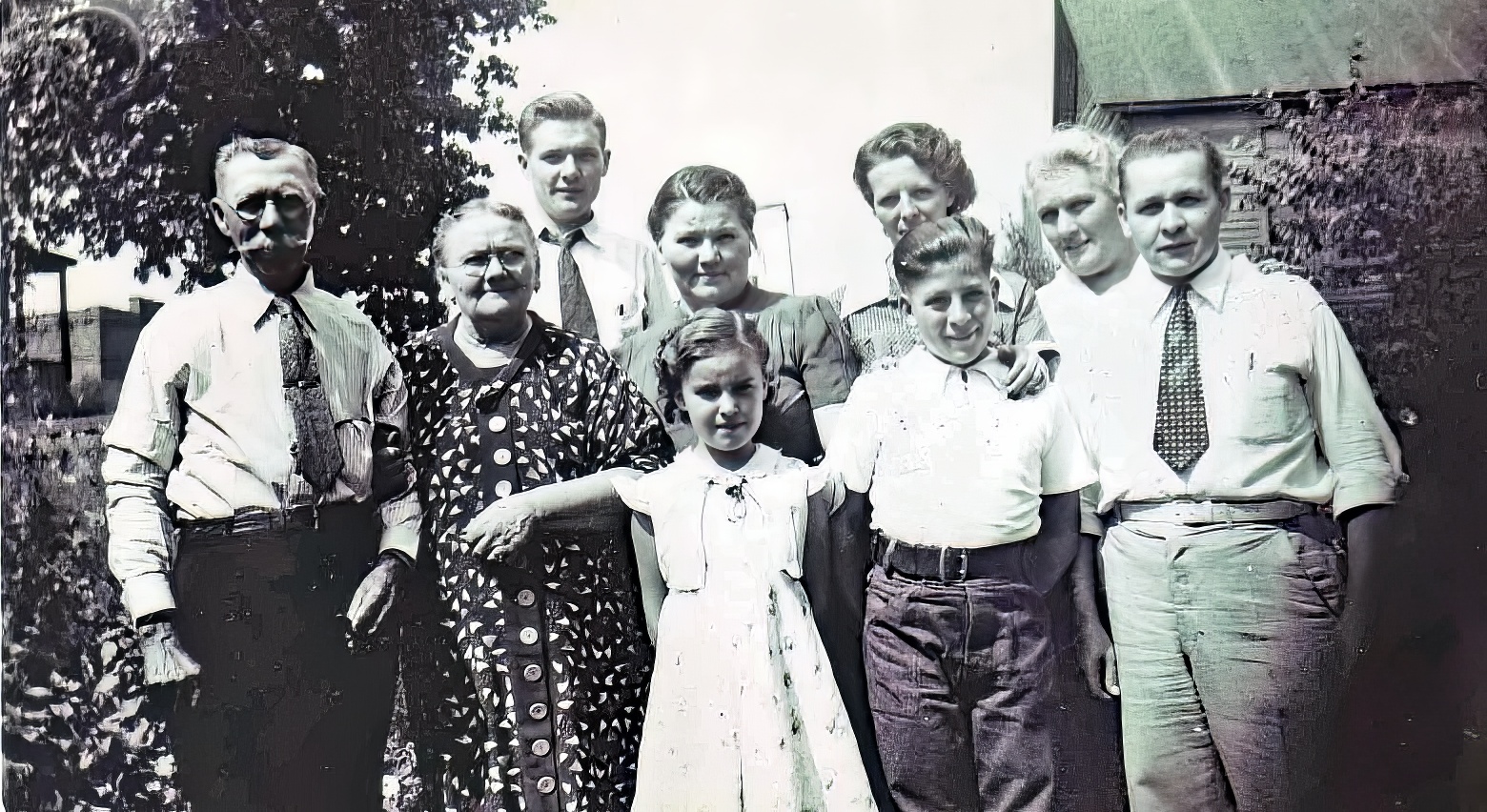
It's hard enough to identify photos in a collection where the photos don't have an inscription. But it's even harder when family members look alike.
For years I thought that this portrait was Alfred Petersen of Omaha and his extended family. It made sense. All the male Petersen brothers had that distinctive heavy mustache, and only a couple of the brothers had a close-cropped hairstyle. Alfred did, and so did his brother Peter. But when you compare the ages of some of the folks in this picture with documents about Alfred, there's something off.
“Citation: Digital reproduction of a photograph, front side, collection of Catherine Meyer, Peter Hansen Petersen and family members, Omaha, Nebraska circa 1936; original copy scanned in 2005, enhanced Topaz Photo AI version 2023.
It's true that Alfred (born Peter Edlef) Petersen and his family lived in Omaha after he emigrated from Nordfriesland in 1878 and spent a few years in Hebron, Thayer County, but he lived most of his life in Omaha, where his children were born, married to Mary Thomsen until her death in 1893, then possibly (or not) married to his former housekeeper Hannah Andersen.
His obituary in the August 26, 1933 issue of the Omaha World-Herald doesn't mention Hannah as one of his survivors, but it does mention his sister, Catherine Mikkelsen of Chicago, brother Peter Hansen Petersen of Mason City, son Henry, daughters Ann Davis and Elizabeth Hoffmann, as well as eight grandchildren and three great-grandchildren -- a considerable legacy. But if Alfred died in 1933, he can't be in this photograph. The youngest children's ages give us a clue. And if so, that man with the mustache must be a different brother.
Catherine Petersen Mikkelsen in the flowered dress at the left of the photo is actually standing next to Peter Hansen Petersen, Alfred's brother, along with Alfred's family. From left we have Peter Hansen Petersen, Catherine Mikkelsen, in the back wearing a white shirt and tie probably John Hoffmann, Elisabeth's son, then Elizabeth, in front of her Cathie Breetske (Catherine's granddaughter), Ann Petersen Davis, Albert Hoffmann in front next to Cathie (another of Elizabeth's sons), Hannah Andersen, and Walter Breetzke, husband of the photographer Florence Mikkelsen Breetzke.
This is the best we can do. Dating the photo is easier because we know that Cathie was born in 1928 and Albert Hoffmann in 1922. She looks eight years old, he looks fourteen. If that's the case, we have a date for the photo of 1936, when Catherine and her Chicago relatives decided to visit her Omaha family.
There are other photos from this visit, although none with any other unidentified family members. So this date and place seem reasonable in a case where we only have circumstantial details to help us tell who's who in family snapshots.
February 1, 2023 | Email your comment.
A deadly storm

Genealogy sometimes reveals the sadder side of life. The excerpt above can be read in full here. It's the first time I've ever seen a death record for two people on the same day who perished in the same calamity.
Jens Sørensen and his friend Jens Bakkensen Jensen apparently went out fishing on the sea when a storm blew in that wrought havoc with their plans. The notation at the end of each entry is almost identical: "On June 3rd [1840] he sailed out for fishing, and he died the same day at sea because of severe stormy weather. His body was not found."
“Citation: Kirkebøger, Ribe Amt, Oksby Sogn, Døde Maend 1837-1847, Opslag 4, Rigsarkivet (Danish National Archives https://www.sa.dk/ao-soegesider) accessed 28 Jan 2023.
Jens Sørensen was the son of Søren Jørgensen and Inger Jensdatter, born in Sielborg (now Sjaelborg), Hostrup, Ribe in 1770. He was the older brother of Barbara Sørensdatter who married Peter Hansen and began a line of Petersen ancestors in our family. Jens was married too, at least twice according to the 1801 Danish census, with a second wife, Mette Simonsdatter, who was ten years older than he was.
The family included a foster daughter, Inger Madsdatter, who lived with him at least long enough to be confirmed in 1815. That's pretty much all we know about Jens except that he was also a soldier for a time and mostly a day laborer.
Tragedy was lurking around the corner for Jens' sister as well. Barbara Sørensdatter married Peter Hansen, a tailor, in 1797 and their son Hans Peter Petersen was born a month after their marriage. They had one more son, the poetically named Adam Lauzen Lange Petersen, in 1806. Adam never married. Hans married Ellen Jürgensen from Jundewandt in 1822 and his line flourished, although curiously none of his daughters were named after his mother.
Almost two years after Jens' untimely death, Barbara died in May 1842 at the side of a road north of Varde and was found by a Mr. Windfeldt. Permission was sought from the county to bury Barbara, who had lived her last few years in an alms house with several other women. We can't imagine what was going on, why neither of her sons were able to take her in. Was she mentally ill or otherwise unable to live with them? Adam was a farm laborer who never owned his own property, so that may explain it somewhat. Why Hans and his wife Ellen couldn't accommodate Barbara is another issue unexplained by the records. Some family tragedies remain unsaid and unknowable.
January 28, 2023 | Email your comment.
Burmeister's Gasthof
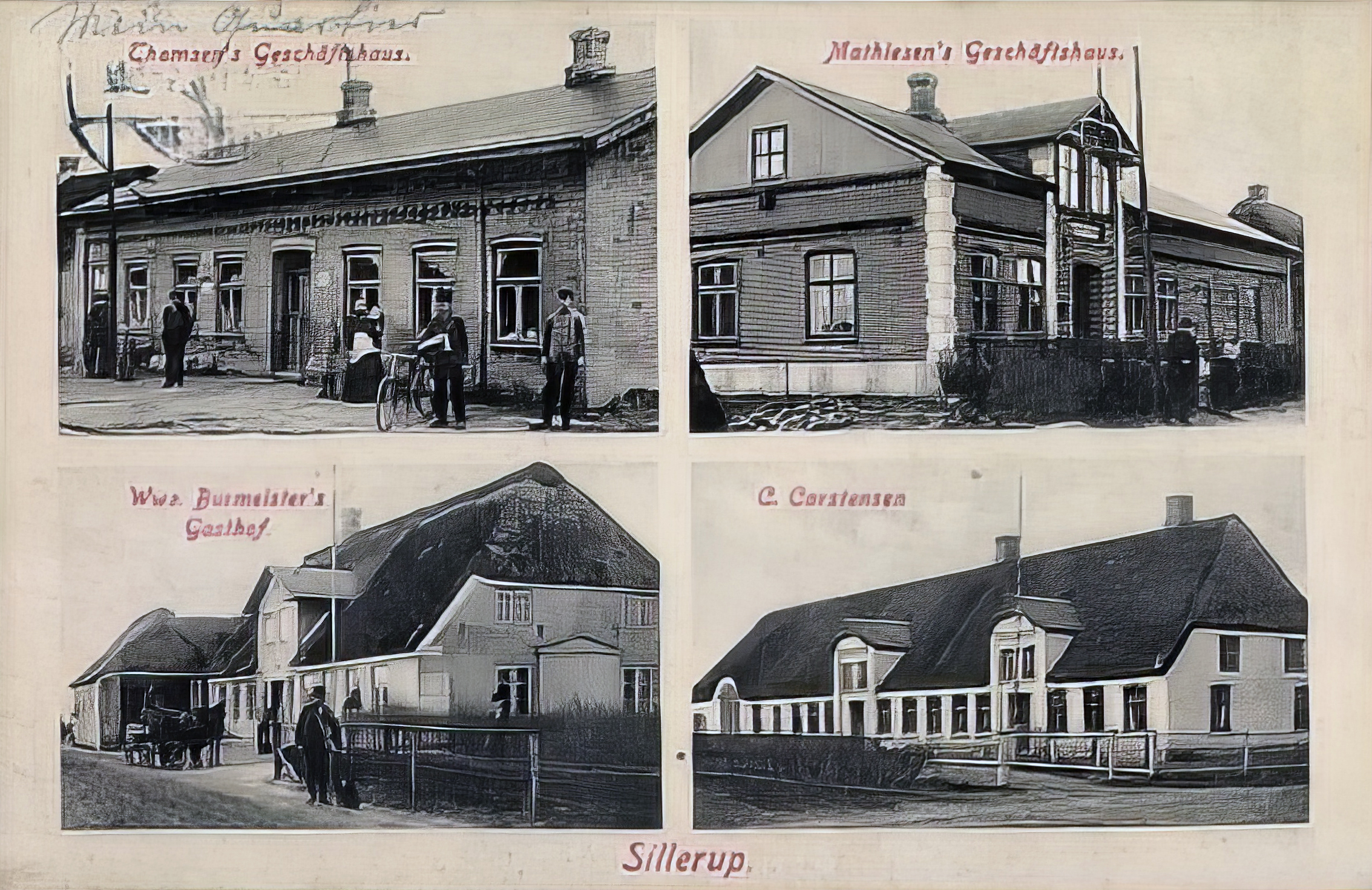
Our cousin in Germany had a note on his tree for Elena Maria Petersen who married Fritz Burmeister and at first it was puzzling: "Eltern hatten eine Gastwirtschaft in Sülerup bei Lindewitt," it said.
I wasn't sure whether this meant that Elena's parents had a guest house in the town of Sülerup (now Sillerup) near Lindwitt in Schleswig-Holstein, or that she and her husband did. Turns out it was the latter. As this postcard clearly shows, the place was called "Burmeister's Gasthof" and it was, indeed, located in Sillerup. So Elena and Fritz were hoteliers!
“Citation: Digital reproduction of a photograph, front side of a postcard, auctioned and sold at https://www.akpool. co.uk, Postcard Sillerup Lindewitt in Schleswig Holstein, Thomsen's Geschäftshaus, Burmeister's Gasthof, Mathiesen, accessed 23 Jan 2023.
This was an occupation I hadn't considered for the couple. Most of her family members were laborers, cottage farmers, or in the case of her father and grandfather, glaziers. But this was a new one for the family.
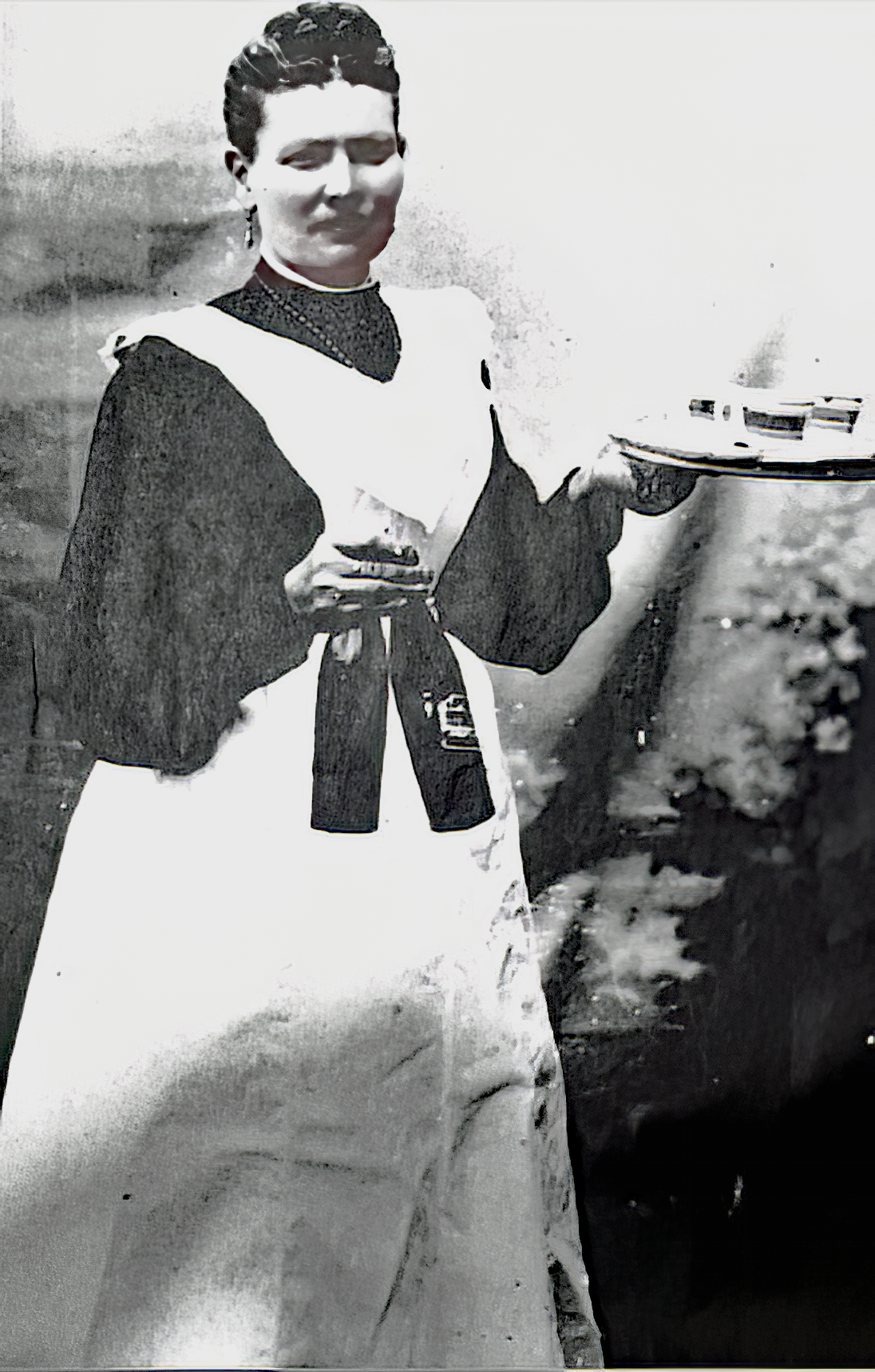
Another cousin has provided a photo of Elena herself in her hostess uniform at work in the Gasthof, so undoubtedly it's true. She and her husband Fritz ran Burmeister's, and it was popular enough at the time to be advertised on a postcard from the region.
Elena and Fritz acted as godparents to several of her siblings' children when they were born in and around Leck, but I noticed that she didn't appear there after about 1885. Maybe the place to look for her in the parish records is near Sillerup? It may be in the Lindewitt parish, located about ten miles southeast of Leck. Worth a look in any case.
Did any of Elena's family work here? we haven't heard about it. Her son Matthias Peter Petersen, so we're told, worked with his brother-in-law Nikolas Möller in Friedrichskoog, and they were responsible for the development of the Kaiser Wilhelm Koog, an area of reclaimed land situated along the North Sea coast in the district of Dithmarschen in Schleswig-Holstein. So more than likely Elena and Fritz worked in their Gasthof themselves in what was then (as now) a picturesque part of the country.
January 23, 2023 | Email your comment.
Andreas Ludwig Petersen: a mystery solved

A couple days ago I had a hunch and followed it through. Turns out that I was on the right road.
I've known about these twin boys for a long time: Andreas and Ludwig Petersen, the last two boys born to Peter Hansen Petersen and his wife Elise Momsen in January 1867. But I also found that there was an older brother, Andreas Ludwig Petersen, born to the same couple in 1852. What happened to him?
“Citation: Imaged at Archion (https://www.archion.de/en/viewer/?no_cache=1&type=churchRegister&uid=274624 : 19 January 2023), baptism of Andreas and Ludwig Petersen, path: Browse > Norddeutschland: Landeskirchliches Archiv der Evang.-Luth. Kirche > Kirchenkreis Nordfriesland > Leck > Taufen 1855-1878 Image 87 via Archion.de.accessed 19 Jan 2023.
It's customary in German and Danish families (maybe in other cultures as well) to name children after an ancestor, but not to repeat names within the same family at the same time. Mostly this custom was observed in the records I'm familiar with, and it suddenly occurred to me that perhaps this was a clue: maybe it explained why I couldn't find a confirmation or marriage record for the older Andreas Ludwig. Did he die early?
If so, it would have to have occurred during a narrow frame of time. Andreas Ludwig was listed as part of his family in the 1860 Danish Census, which also included Nordfriesland and their town of Leck, part of Denmark at the time. The twins were born in January 1867. So if there was a death, it occurred between 1860 and 1867 in any of the towns where the Petersens were known to live. That means Medelby, Karlum, and Leck.
I tried Karlum first. No trace of a death record there during those years. How about Leck, where the family also lived in the 1860s? I scrolled through 1860-1867 page by page and was not very surprised to find exactly what I was looking for. Less than a year before the twins were born was the record for Andreas Ludwig Petersen, who had died at age 13 in 1866.

This explains a lot. It also confirms that Andreas Ludwig never had a chance to grow to manhood and travel to the United States with his family in 1878. Nor could a mysterious photo, labeled by our Nebraska cousins as "Andrew and Mathilda Petersen," be attributed to him -- he never married. This must be someone otherwise connected to our family of Petersens, maybe cousins, maybe friends.
It's always sad to come across evidence of a family tragedy, however distant. Parents and siblings grieved just the same as we might if it had happened to us. But it does give a bit of closure to an otherwise curious part of our ancestors' past.
January 19, 2023 | Email your comment.
Eighteen years in search of a marriage
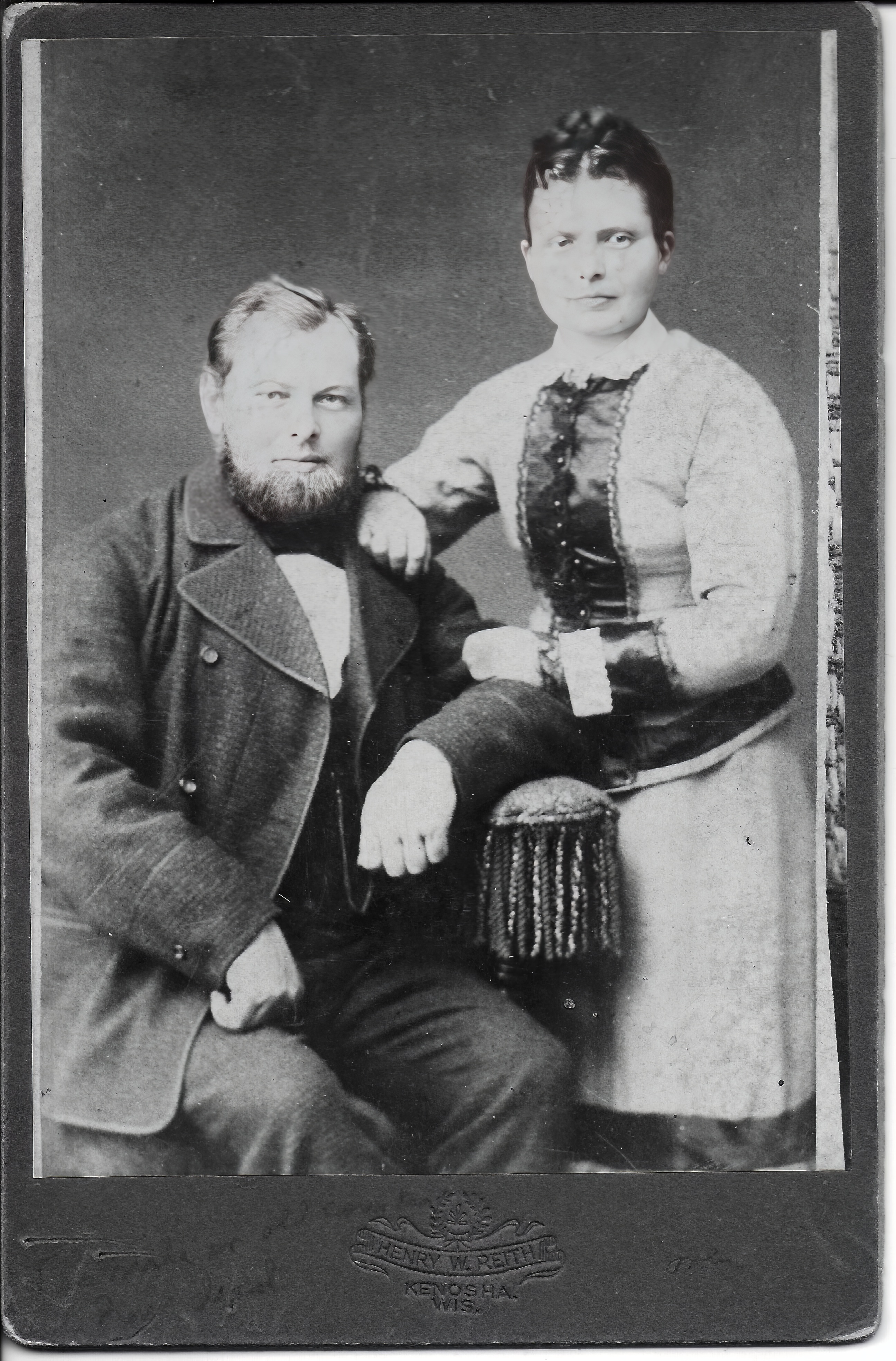
We knew about her and we knew about him. Two different Petersen families had this photo in their collection, one family in Omaha, one in Chicago. Another family member probably had a copy in Kenosha where these copies were made, according to the cardboard frame: Henry W. Reith Studios. An online list of Wisconsin photography studios places his years of operation from 1893-1904.
“Citation: Digital reproduction of a photograph, front side, collection of Donald Leu, Omaha, Nebraska: labelled "Helena + Fritz Burmaster, Alfred Petersen's sister + husband"; original copy scanned in 2014, enhanced for clarity by Topaz Photo AI program 2023.
The inscription on the reverse identifies the couple as the sister and brother-in-law of Alfred Petersen of Omaha: "Helena and Fritz Burmaster". It also indicates that the couple "stayed and died in the old country" and dates the photo to 1885. Their clothing styles confirm the date, more or less.
If they never left Schleswig-Holstein, what kind of life did they have there? Those stories didn't migrate with Helena's brothers, alas. But parish records in and around the town of Leck tell a tale. I've been searching for their records for eighteen years. I hired an intrepid researcher to find family records in the archives at Kiel, and he did a bang-up job. But there was only so much he could do with available funds and when the money ran out we had to terminate the search.
Little did I know when I subscribed to Archion late last year that these records would be part of the online collection. It's been a welcome flood of information since then. At first I searched in vain for Helena and her husband Fritz. Before I found them, I ran across an unexpected record: a baptism record for Helena's child, Matthias Peter in 1872, who was born in December 1871. She wasn't married at the time. The record states that the father was alleged to be Matthias Tÿchsen from the nearby farm village of Boverstedfeld, just four or five kilometers from Leck. Godparents to the child were Helena's father Peter Hansen Petersen and her cousins Hans Peter Petersen and Maria Sievertsen.
But this didn't solve the mystery of Helena's marriage to her husband Fritz. When did that happen?
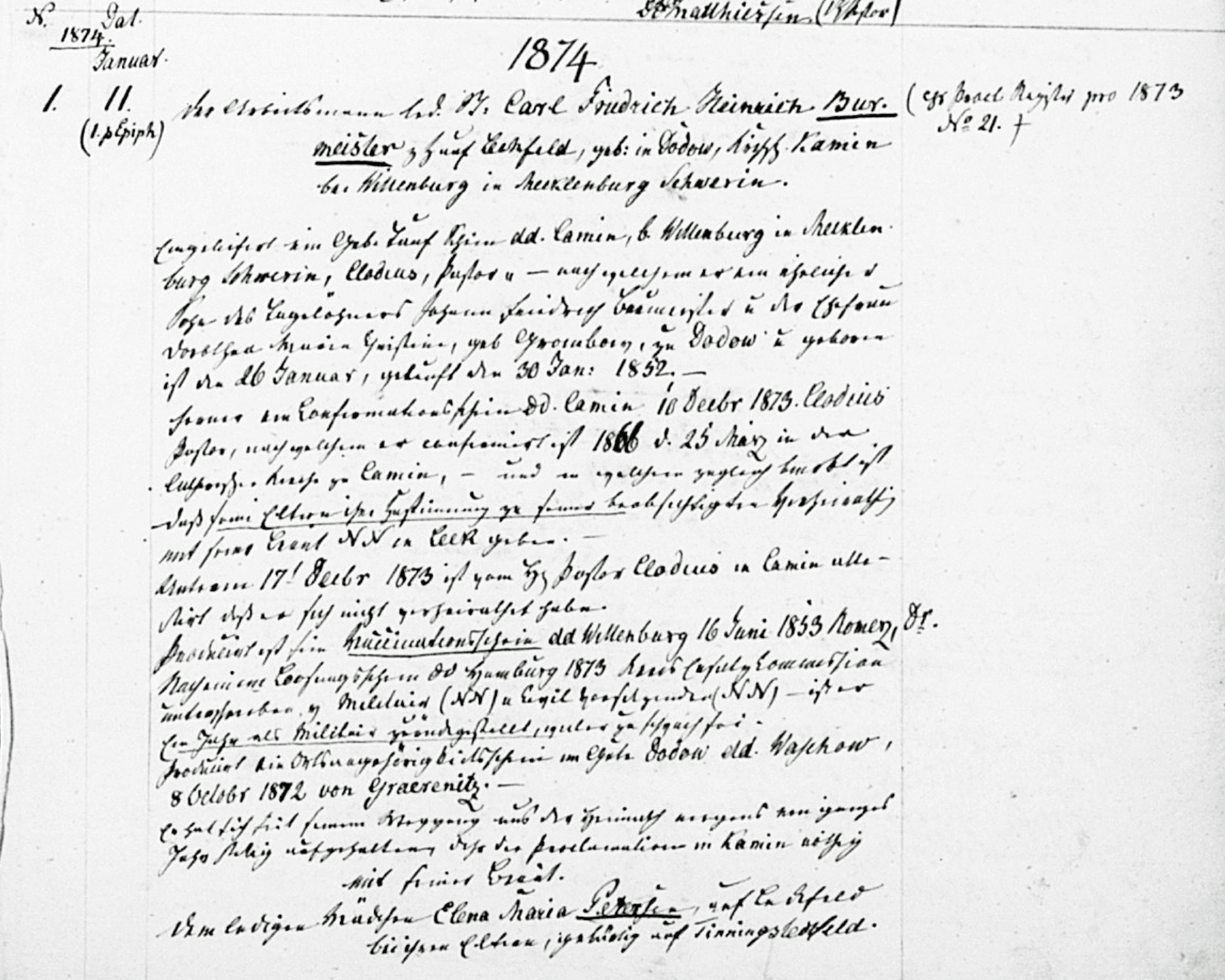
Remarkably it was pretty soon afterwards. Click to enlarge the image (it's part 1 only, there's a part 2 which I'll upload if you want to see it). Elena Maria (as she was always referred to in the parish records of Leck, not Helene as we know her) married Carl Friedrich Heinrich Burmeister [not Burmaster] just two years later in 1874. The marriage record is remarkably chatty, partly because Fritz (as he was called) was born miles away in a small village called Dudow in the principality of Wittenburg, Mecklenburg-Schwerin. What he was doing in Leck is anyone's guess, but at least the marriage gives us the groom's correct and full name, his parents' names, his birth and baptism date, confirmation date, and a plethora of other information telling us about the groom's past.
“Citation: Imaged at Archion (https://www.archion.de/en/viewer/?no_cache=1&type=churchRegister&uid=274624 : 15 January 2023), marriage of Carl Friedrich Heinrich Burmeister and Elena Maria Petersen, path: Browse > Norddeutschland: Landeskirchliches Archiv der Evang.-Luth. Kirche > Kirchenkreis Nordfriesland > Leck > Trauungen 1873-1899 images 11 and 12 via Archion.de, accessed 15 Jan 2023.
For Elena Maria, she's referred to as a Madchen (because she hadn't yet been married), daughter of Peter Hansen Petersen and Elise Momsen, correct birth and baptism date, confirmation, vaccination, and all the other details required by the parish in Leck. No mention of Elena Maria's child Matthias Peter Petersen, who retained her surname rather than his father's, Tÿchsen. Did Elena and Fritz raise him together? Did the happy couple have children of their own?
The answer to the first question may be obvious, because the records indicate that Matthias grew up, married, and had children of his own, whoever and wherever he was raised.
Whether Elena and Fritz had their own chidlren? We'll need to do some more exploring to find out. Maybe some of our "orphaned" photos of little children -- those without an inscription or indication who they might have been -- will be identified in time.
January 15, 2023 | Email your comment.
A DNA mystery starring Georg Petersen
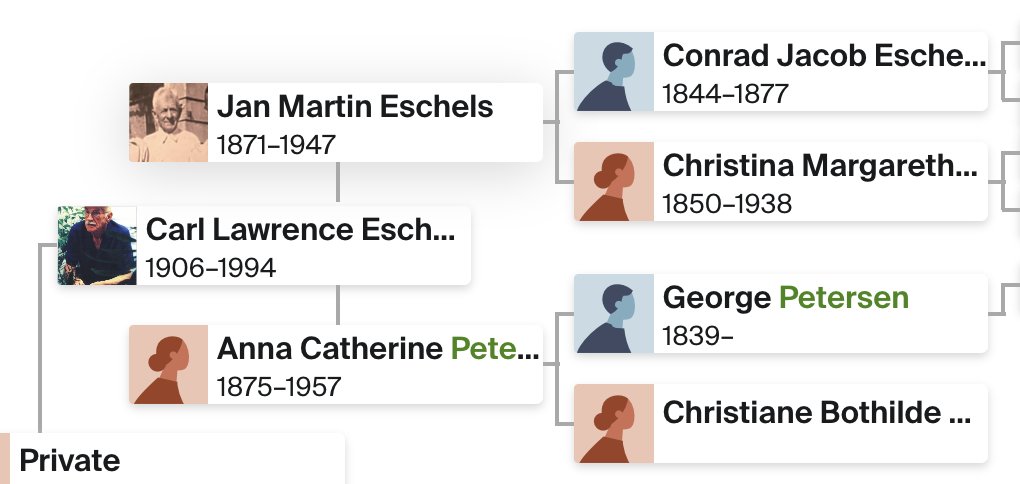
I have an autosomal DNA match to a lady who has this tree on her page. The only possible connection that I can see would be the person she lists as George Petersen, born in 1839.
I have one of those, a Georg Petersen, son of Hans Peter Petersen and Ellen Jürgensen, but he was born in 1837, not 1839. Oh well, maybe her calculations are off (mine are verified by several sources so I know we're all right there). A few years here and there can't be too big an impediment in history this old. It's worth exploring.
“Citation: Public Member Trees, database, Ancestry.com (http://www.ancestry.com : accessed 11 January 2023), “Cottey Family Tree” managed by ewhitson08, profile for Barbara Payne, undocumented data.
A few days ago, coincidentally, I ran across a marriage record for my own Georg Petersen via Archion.de and a baptism record for their son Martin. That led to the baptism of a second child, Anna Catharina Christine, from 1875. I checked the exact baptism date for the child in Barbara Payne's tree: it matches to my Georg's child, 11 January 1875. The mother's surname is unusual and I noted it at the time: Gÿldenzoph. The tree doesn't have this surname but the details match the mother: Christiane Bothilde, who was born 1839 in North Kiesum, Schleswig-Holstein.
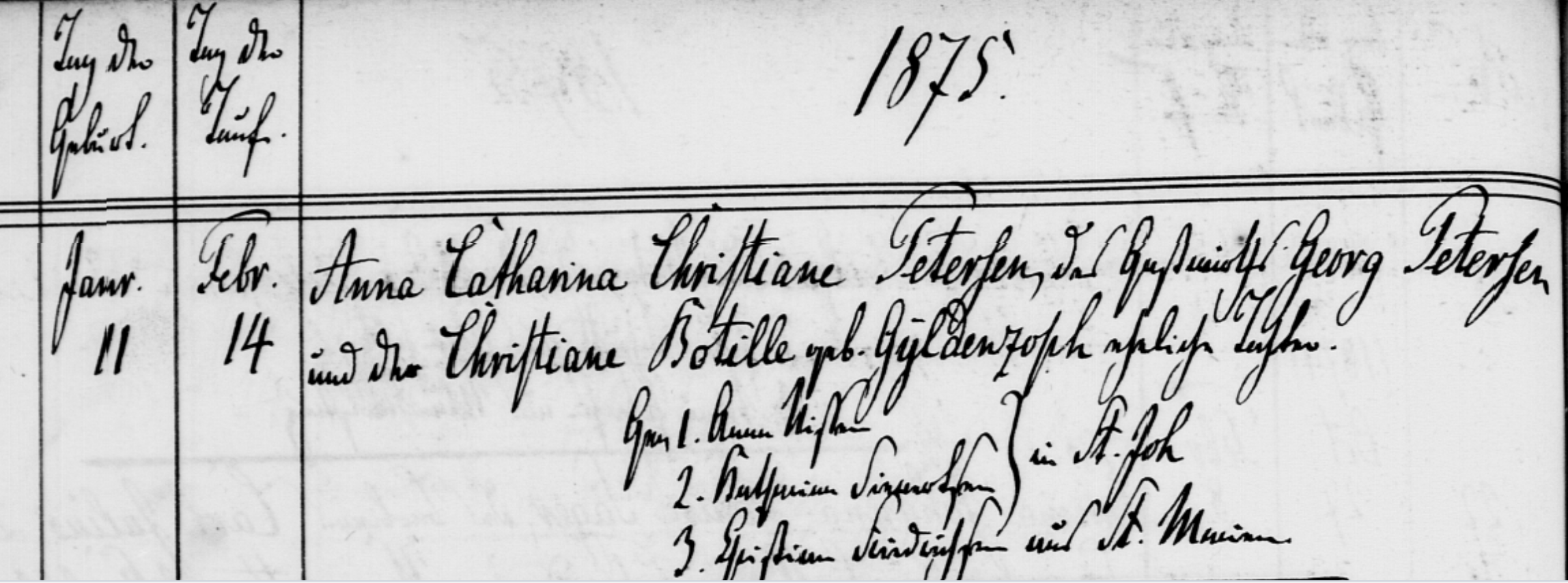
So this explains the match. Georg Petersen is indeed our common ancestor.
“Citation: Imaged at Archion (https://www.archion.de/en/viewer/?no_cache=1&type=churchRegister&uid=274624 : 12 January 2023), baptism of Anna Catharina Petersen, path: Browse > Norddeutschland: Landeskirchliches Archiv der Evang.-Luth. Kirche > Kirchenkreis Schleswig-Flensburg > Flensburg-St.Johannis > Taufen 1869-1887 image 104 via Archion.de, accessed 11 Jan 2023.
What we know about Georg: he was the penultimate child of Hans Peter Petersem a glazier in the area near Weesby, Schleswig-Holstein, and his wife Ellen Jürgensen from Jundewandt just over the border in Denmark. Hans and Ellen had nine children. Only two of them, the eldest brothers Peter and Lorenz, emigrated to the United States. Georg and his wife Christine did not. But their daughter did.
Anna Catharina Petersen married Jan Martin Eschels in Erie, Ohio, according to the collection Ohio, U.S., County Marriage Records, 1774-1993 via Ancestrylibrrary.com, so she must have emigrated shortly before that time. Jan became John in the U.S., so look for him with that name. Except for a brief foray into Louisiana, where their first son was born, John and Anna settled in Sandusky, Ohio. John died in 1947, Anna in 1957.
If you have connections to this Petersen family, don't forget to research the Eschels surname when looking for descendants.
January 12, 2023 | Email your comment.
Not related? A Michelsen investigation

When I started looking into this particular conundrum I knew there was very little likelihood that harpsichordist Rafael Puyana and I were related. As it turns out, we're not, but that's not the end of the story. Click the image to enlarge it.
“Citation: Ancestry.com. Denmark, Church Records, 1812-1924 [database on-line]. Lehi, UT, USA: Ancestry.com Operations, Inc, 2019, Rigsarkivet; Danmark; Kontraministerialbog; Reference: 8027680591, Denmark, Church Records, 1812-1924 for Carl Michelsen, Odense Amt, Odense Mosaiske Menighed, 1814-1896.
In Danish genealogy (in fact, in almost any genealogy) having the same surname isn't proof of anything. What surprised me was reading in his liner notes on the back of a harpsichord album that his full name was actually Rafael Puyana Michelsen. Michelsen! We have some of those, spelled alternatively Michelsen or Mikkelsen (same name either way). In my family it was a patronym adopted as a surname by my step-great-grandfather's family. Thomas Mikkelsen (born 1850 in Schleswig-Holstein) was the son of Niels Michelsen, who was himself the son of Caspar Michelsen. And just to spice the mix, some of Caspar's children from his second marriage were called Casparsen, showing that the patronym/surname custom wasn't yet cast in stone.
The spelling of Rafael's second surname with the sen tag suggested a Danish connection, and the Colombian custom of including a child's parental names in father/mother order suggested that Rafael's mother was the Michelsen, part of an immigrant family from Denmark to Bogota sometime in the 19th century. But interestingly none of his LPs, nor his online obituaries, mention anything about parents, just that he started playing piano when he was six years old.
Where to turn in such a situation? To Ancestry.com, which might have some information on the family somewhere.
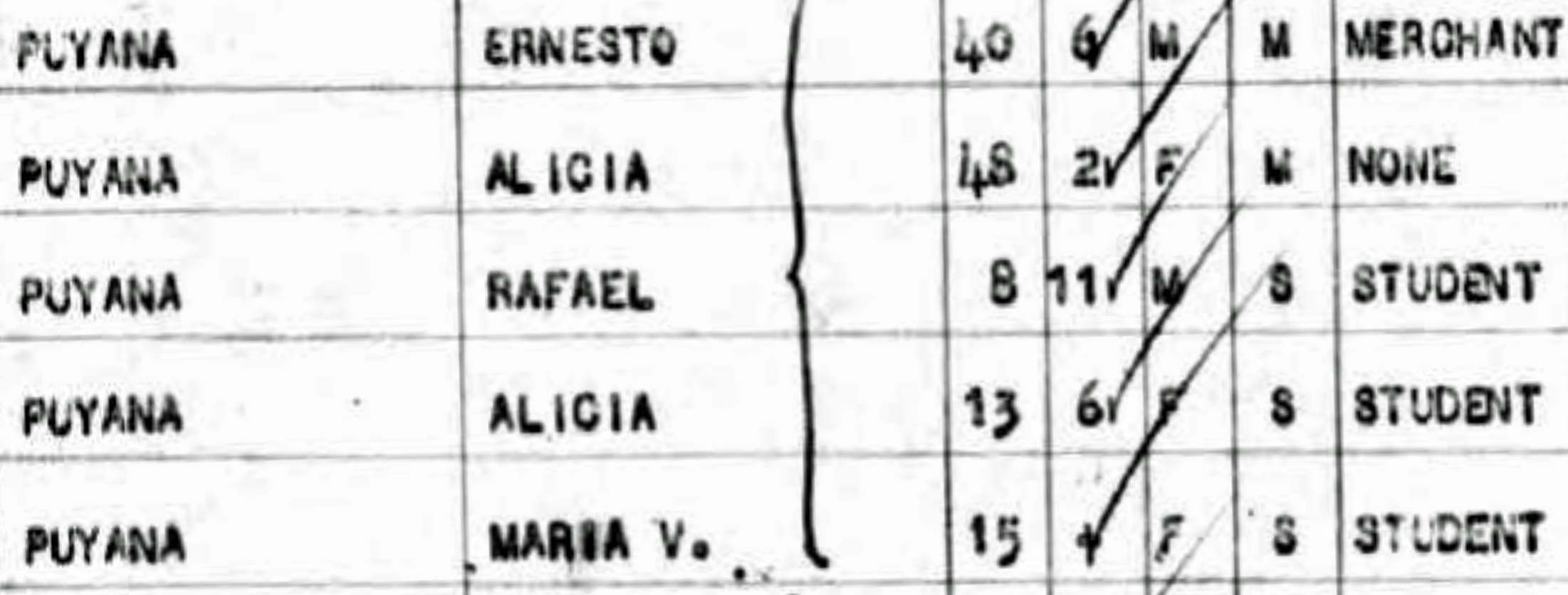
Plugging in "Rafael Puyana" as a name brought up this passenger manifest from 1940, where eight year old Rafael's parents and sisters are named. Ernesto was a merchant, traveling from Bogota to New York to his brother David Carrera (not sure where that name came from, but let's not worry about it right now). Rafael's mother was Alicia...Michelsen? At least that was her family's surname at some point, and she passed it on to her son Rafael.
“Citation: Ancestry.com. New York, U.S., Arriving Passenger and Crew Lists (including Castle Garden and Ellis Island), 1820-1957 [database on-line]. Lehi, UT, USA: Ancestry.com Operations, Inc., 2010, year: 1940; arrival: New York, New York, USA; Microfilm Serial: T715, 1897-1957; Line: 11; Page Number: 186.
Some kind soul has assembled a family tree at Geni which you can use with caution since it isn't sourced, but it may give some clues. And it does! Alicia was born Alicia Michelsen Mantilla in 1892, daughter of Ernesto Michelsen Uribe. Her grandfather was Karl Michelsen Koppel, whose confirmation record is at the top of this post.
Whoever put this tree together uses the Hispanic custom of listing the person's paternal and then maternal surnames, even if this wasn't the Danish custom. But it's helpful. It tells us that Carl Michelsen was the son of a Michelsen and a mother Koppel. That leads to the record in Nÿborg, Denmark, where we find out that Carl's father was Isaac Michelsen and his mother Rosine Koppel. In fact, Carl's fifteen-and-a-half year old sister Helene were confirmed on the same day, same parents. But there's an interesting detail in the confirmation place. It was a Jewish congregation...in Denmark!
Specifically it was the Odense Mosaiske Menighed, the Odense Jewish congregation. In 1814 the Danish government decreed that Jews in Denmark were to have the same civil rights as other Danish citizens. As a result, Jewish congregations shared their parish records with the government, which included them in the general Danish archives. Lucky for us!
While we know that our Michelsen clan of Ladelund was Lutheran and Rafael's maternal ancestry was not, this information certainly lights up an otherwise hidden part of Puyana's ancestry. Did he know about this part of his family story before he died in 2013? Possibly not, but we know it now. And while you're contemplating this discovery, feel free to listen to Rafael Puyana in action playing Padre Antonio Soler's "Fandango." This is the LP that lists Rafael's name as Puyana Michelsen!
January 8, 2023 | Email your comment.
As long as we're in a marriage-record mood....
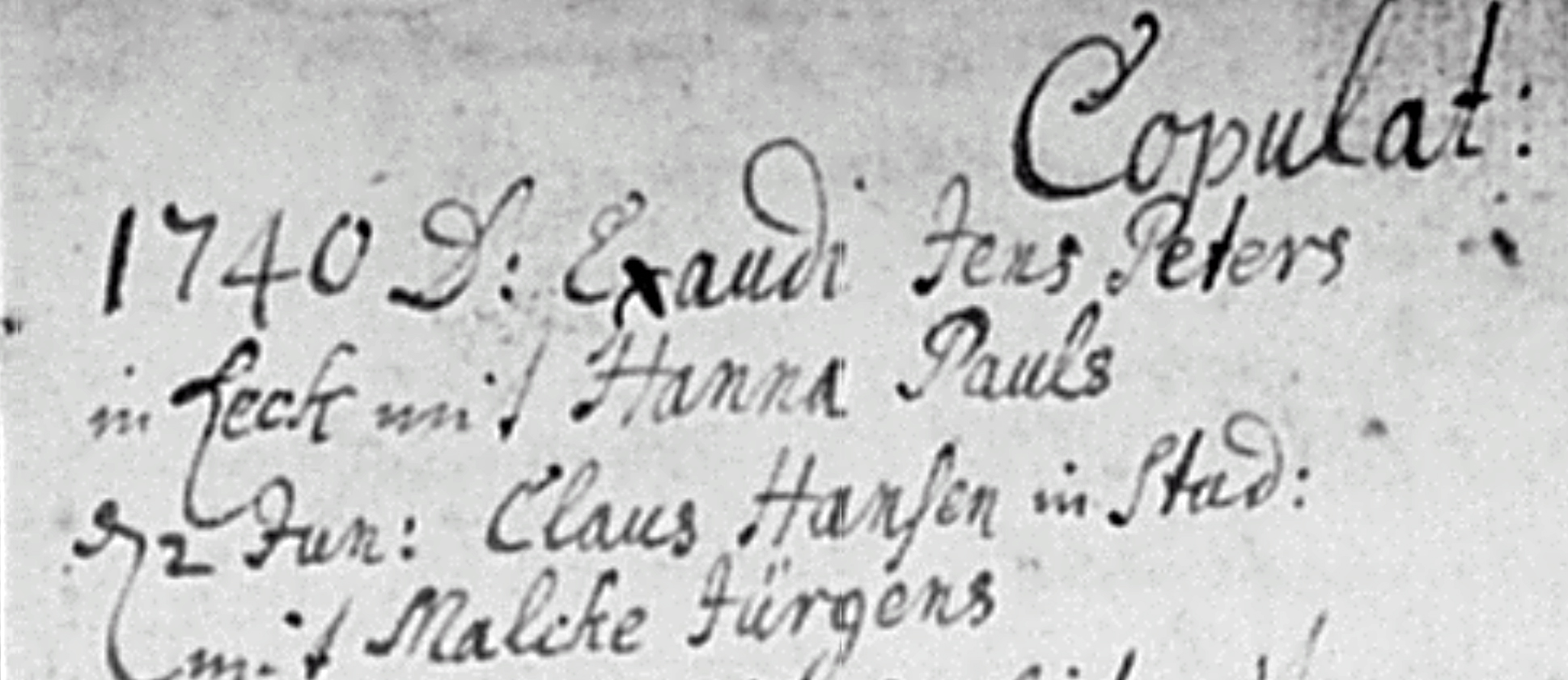
For marriage records this is probably as early as we're going to find in and around Leck, Schleswig-Holstein. Click the image to enlarge it.
We have other marriages from other regions of Germany that were earlier, e.g. our Schuchmann clan of Hausen and Reinheim, where marriages are recorded as early as 1576 (Hans Schuchmann and Anna Funck, for instance). In Leck in Nordfriesland (Schleswig-Holstein today) available records are not quite as old, but that's what makes this one interesting: its antiquity for the region.
“Citation: Imaged at Archion (https://www.archion.de/en/viewer/?no_cache=1&type=churchRegister&uid=274624 : 29 December 2022), Jens Peters marriage to Hanna Pauls, 2 June 1740, path: Browse > Norddeutschland: Landeskirchliches Archiv der Evang.-Luth. Kirche > Kirchenkreis Nordfriesland > Leck > Trauungen 1740-1763 image 88.
This is a marriage for Jens Peters[en] and Hanna Pauls[en]. Later on in Leck and in neighboring villages marriage records became very chatty, with the bride's and groom's dates of birth, confirmation, vaccination record (yes, really, children in this region were vaccinated for smallpox starting in the 1820s), parents' names, certificates of celibacy in some cases (though how this could be confirmed I can't imagine, or maybe I don't want to imagine), and witnesses.
Here not even the marital couple's entire names are spelled out. They're using patronyms at this point anyway so we're expected to understand that Hanna was either known as Paulsen or Paulsdatter, and of course that indicated that her father's name was Paul [patronym]. Same with Jens, his father's name was Peter, so he's Jens Petersen. Their son will be Jensen...but we're getting ahead of ourselves here -- all in good time.
Later on, around 1822, the king of Denmark (who was nominally ruler over this area) decided that it would be easier to keep track of people if they had an actual surname, so he decreed that folks should pick one and stick with it. But at this point that wasn't the case.
Jens and Hanna had two witnesses to their marriage, which was common at the time: Claus Hansen and Malcke Jürgens[en]. It's probably a female name, e.g. Malka, although rare in these records it does occur. The marriage occurred on June 2, 1740 and all the participants, witnesses included, were from Leck, a town so close to the Danish border that you could walk there.
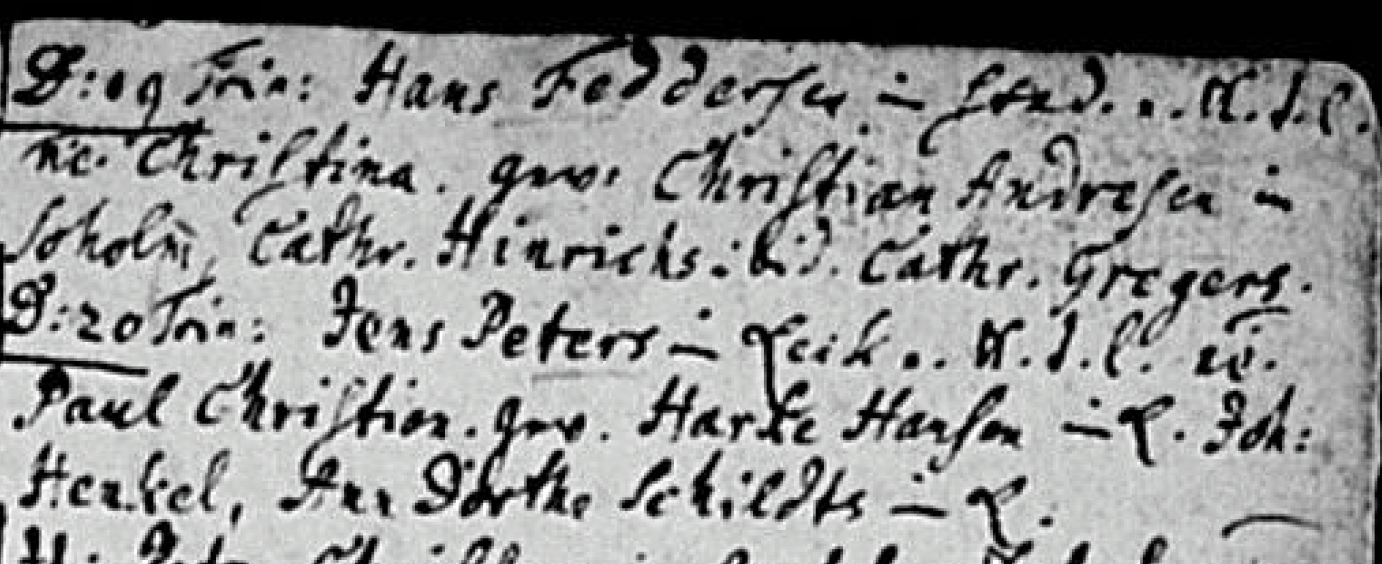
Ten years later this couple (we assume it's the right couple, the mother's name isn't mentioned) had a child, Paul Christian, baptised on the 20th Sunday after Trinity, which works out to 28 October 1750. Godparents are three here: Hartke Hansen, Joh. [Johann] Henkel, and Ane Dorthe Schildts, all of Leck.
Paul Christian Jensen, a cottage farmer, grew up in the area and had a late marriage (he was sixty-five!) in 1815 to Catharina Maria Nissen, with whom he had a daughter, Margarethe, who was born in 1816. We know "Magretta" well. We even have her phtoograph. She was the wife of Lorenz Peter Petersen, and with their son Hans they emigrated to Nebraska in 1872.
January 3, 2023 | Email your comment.
A Gohr marriage in Chicago
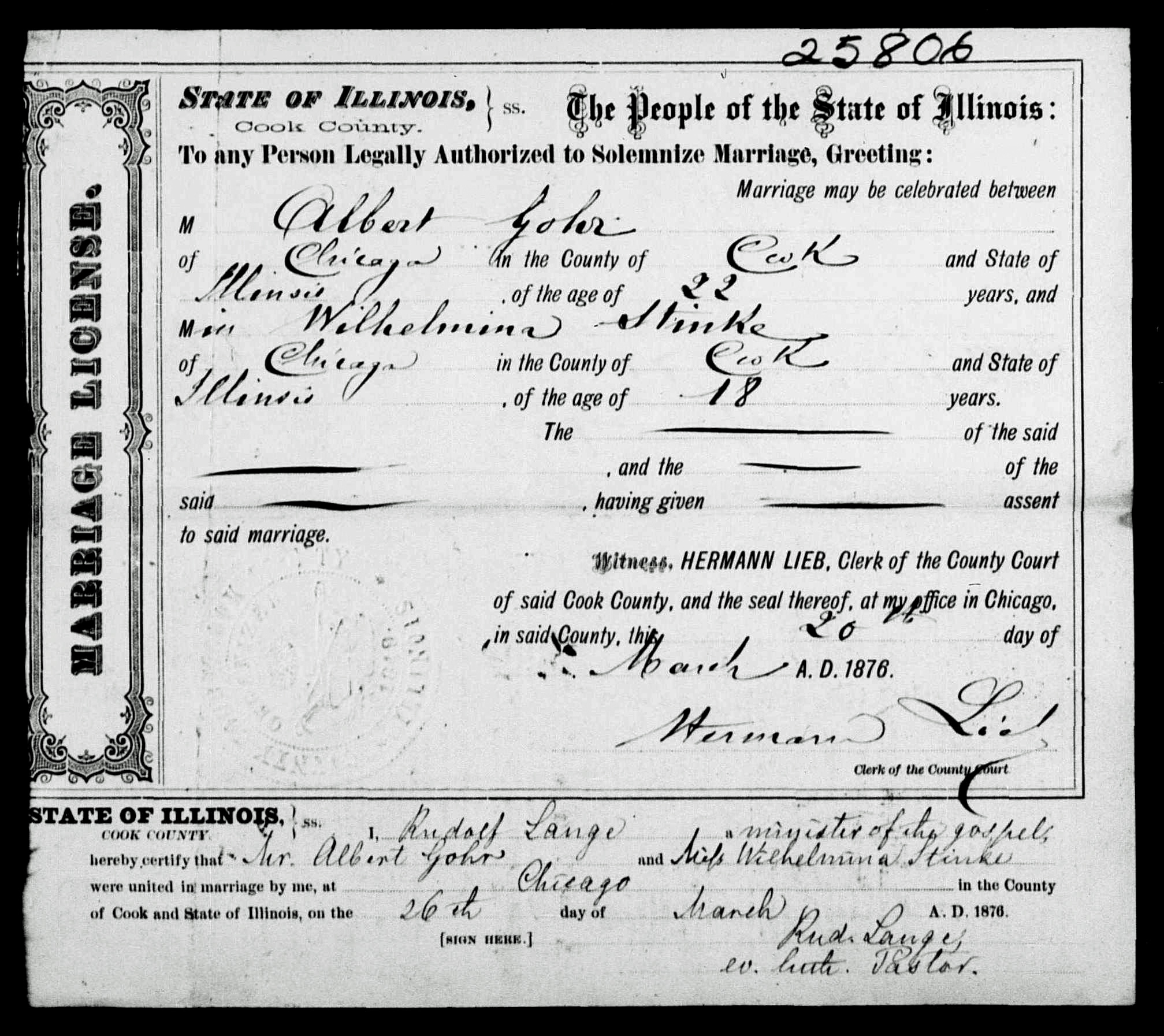
When you think about it, this marriage took place only six years after the Great Chicago Fire. Had it taken place prior to that, we might not have the record to review.
Why is it important to have this record? Albert Gohr, it appears, is a relative of our Gohr family, or so an autosomal DNA match indicates. He was born in 1855 in the town of Zetzenow, near Nippoglense where our other Gohr ancestors were from, and emigrated to America in 1874. Another Albert Gohr, some ten years older, had emigrated to Chicago and married theer as well in 1874. We now know that the Alberts were cousins.
Was the younger Gohr joining a cousin whom he knew to be there? It seems likely. Both Albert Gohrs must have known about each other, although the younger Albert Gohr and his bride Wilhelmine Stenke moved to Kimball, Jackson Township, Minnesota and established their home base there, whereas the other Albert Gohr (1844-1989) remained in Chicago with his wife Wilhelmine Paulina Möwes and family.
“Citation: "Illinois, Cook County Marriages, 1871-1968", database, FamilySearch (https://familysearch.org/ark:/61903/1:1:N78Y-B5S : 24 December 2022, Albert Gohr and Wilhelmina Stinke, 26 Mar 1876; image obtained from Familysearch.org look-up service online.
The younger Albert's wife's maiden name was transcribed variously as Stinke, Stenke, and even Steinke, so that should be considered when doing a search on these folks. Does the actual marriage record give us any further information about the couple, perhaps by examining witnesses to the marriage? It appears that this is the case.

The first thing to track down was the parish affiliation of the officiant, if possible. Rudolph Lange. One of the nice folks from the Facebook Chicago Genealogy page provided a selection of Chicago directories from 1875, which is helpful because Rudolph lange was only in the Chicago area from 1872-1878. This comes from the Chicago Ancestors website. Rudolph Lange was at Emanuel Church on Brown Street at the corner of Taylor. It was a German-language congregation, which makes sense for the Gohrs, who would have felt comfortable in that environment.
Are the parish records of Emmanuel Church available online? They are: in this format as a PDF collection. Image #108 will show us the actual marriage record, including the witnesses. While those names don't tell us ow the two Alberts are related, they do show a Theodor Nagel, Johann Gohr, and Maria Stinke.
We can assume that Johann Gohr is a brother or cousin of Albert. Maria Stinke is probably a sister of the bride. Who is Theodor Nagel? Find-A-Grave tells us that Theodor was married to Wilhelmine's sister Caroline Stenke. As a bonus, this page gives Wilhelmine's parents' names too.
So we have more connections to pursue!
December 30, 2022 | Email your comment.
An engagement party
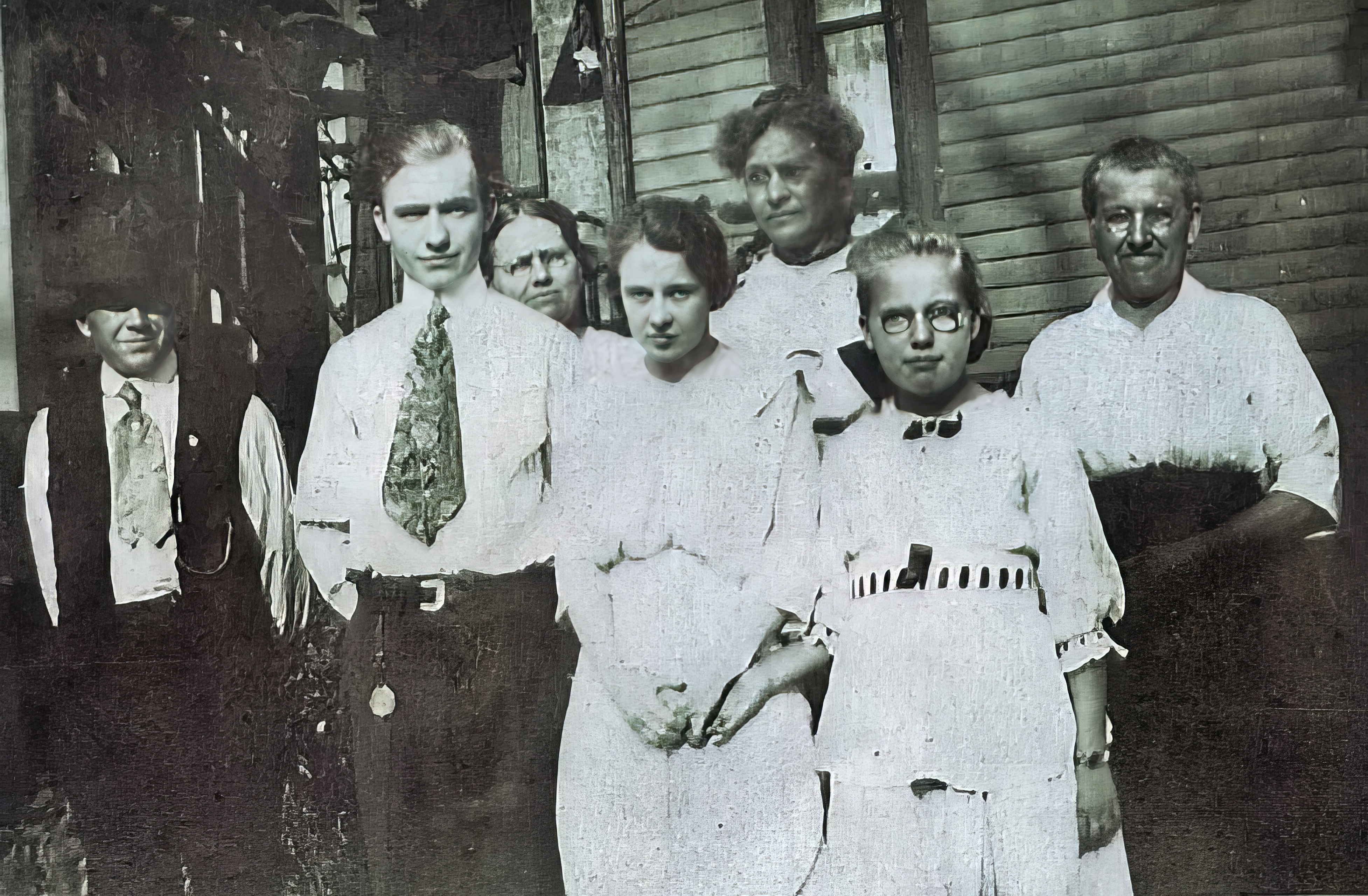
It doesn't look very festive, but nevertheless it was a cause for capturing on film. George Petersen, the fellow with the fancy watch and chain, had just become engaged to Agnes Majoros, the serious young lady holding her sister-in-law-to-be's hand. The family gathered on a day in 1917 to commemorate the occasion -- not all of the family, but every one who could be rounded up.
“Citation: Digital reproduction of a photograph, front side, collection of Catherine Meyer, George Petersen, Agnes Majoros and family, Chicago, Illinois; original copy scanned in 2006, enhanced Topaz Photo AI version 2022.
George Petersen was the penultimate son of Hans and Catherine Petersen, born in 1897 in Chicago. Hans had died in 1905 and George's mother remarried Thomas Mikkelsen in 1906 so this is a mixed conglomeration of folks.
George's younger brother Clarence Petersen is at left, then George, his mother Catherine nearly hidden behind George, then George's fiancee Agnes Majoros, a tall and rather confused lady behind her whom we can't identify, Florence Mikkelsen, George's half-sister holding Agnes' hand, and Mary Majoros at the right, Agnes' mother.
The Majoros clan already had a daughter in the family. Annie Majoros married Catherine's and Hans' eldest son Louis in 1900, so Agnes was the second Majoros girl to be welcomed into the Petersen/Mikkelsen clan.
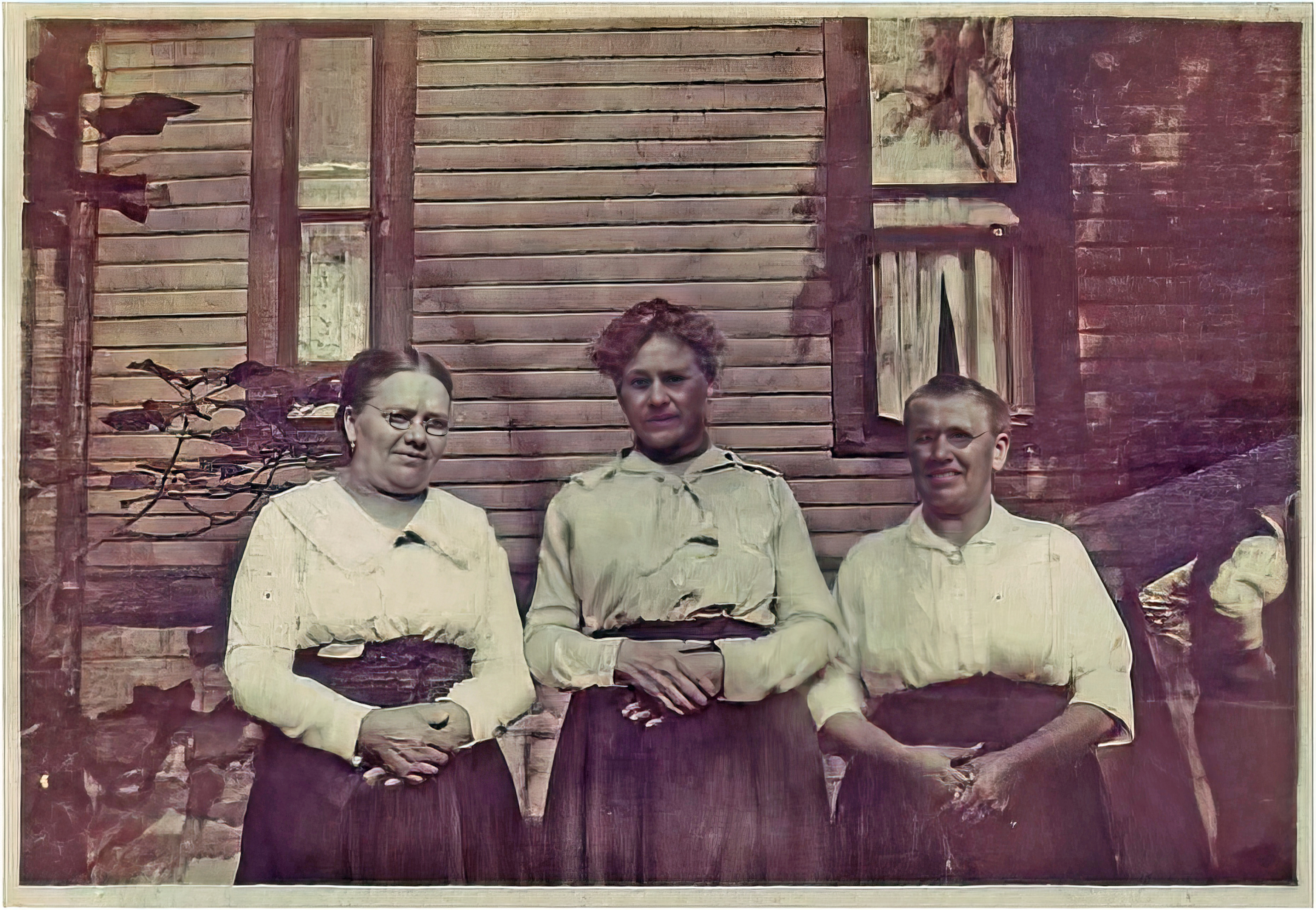
The unidentified tall lady appears in this snapshot too. Catherine is at left, the lady in the middle, and Mary Majoros on the right, apparently taken the same day outside Catherine's home on Loomis Street in Chicago. She must be someone related to the happy couple, but who?
It would be so nice if people labelled their photos on the back, but Catherine must have assumed that she'd always know who everyone was, or that she'd always be around to answer questions if anyone asked. A lot of guess-work has gone into curating Catherine's photograph collection as a result.
The marriage between George and Agnes took place on September 7, 1917 in Maywood near Chicago and produced two daughters, Violet Catherine Laverne (1919-2001) and Georgia Christine (1933-2003). We don't have any photos of the wedding itself, so this will have to do...a snapshot that sparks questions as well as answers.
December 23, 2022 | Email your comment.
A missing child is found

It's not strictly true that this child was missing. I knew that he existed, first-born son of my great-great-grandparents Peter Hansen Petersen and Elise Christina Momsen. But prior to this record I could only see Hans Peter Petersen in the Danish census records. In 1845 he was listed as a one-year-old child in the newlywed couple's home. By the 1860 census he was gone.
What I was missing was his actual baptism record and any indication of what happened to him in the meantime. I assumed that he had died at some point but I had no evidence. On a whim I decided to take advantage of Archion's holiday priicing and bought myself a year's subscription. What a surprise: their home village of Medelby in Schleswig-Holstein was part of the archive!
“Citation: Imaged at Archion (https://www.archion.de/en/viewer/?no_cache=1&type=churchRegister&uid=274624 : 18 December 2022), path: Browse > Norddeutschland: Landeskirchliches Archiv der Evang.-Luth. Kirche > Kirchenkreis Schleswig-Flensburg > Medelby > Bestattungen 1847-1898 > image 83 of 162.
The record above (click the image to enlarge it) shows the child's birth and baptism dates. I know it's the right family because the parents are properly identified by name as well as by place, as are the family members who act as Taufpaten, or godparents. It's always exciting to see who was selected because usually (especially with the first child) these are recognizable close family members. That's the case here.
Hans was born on September 17, 1844 and baptized a few weeks later in October. His godparents were his paternal grandfather and namesake, Hans Peter Petersen, his paternal uncle Lorenz Petersen, and his maternal aunt, Christina Momsen. That paints a nice picture of the family unit as it was in 1844.

But the pathway to discovering this record was a sad one. I first found Hans' death record from 1853 (see the image at left and click to enlarge). He was eight years and four months old. No cause of death was given. But the parents are named, so we know we have the right child.
Just a year later there was a new Hans Peter Petersen in the family, born in June 1854, the sixth child of an eventual eleven. No doubt the name was chosen once again to commemorate the deceased firstborn child as well as (perhaps by this time) the also deceased grandfather. This Hans grew to adulthood and made it to Nebraska to join the rest of his immigrant family, where he no doubt encountered a first cousin with the same name: Hans Peter Petersen, son of his uncle Lorenz Petersen.
My cousin Albert Esser reminds us eloquently: "All of us who are still alive today are lucky. We're the champions of evolution. We’ve been in it since the beginning of all lives. We should not forget this and treat our fellow human beings and our world a little more humbly."
We're so lucky to find out -- and record -- the history of our ancestors, even those who were almost lost to time.
December 18, 2022 | Email your comment.
Kebschull mysteries
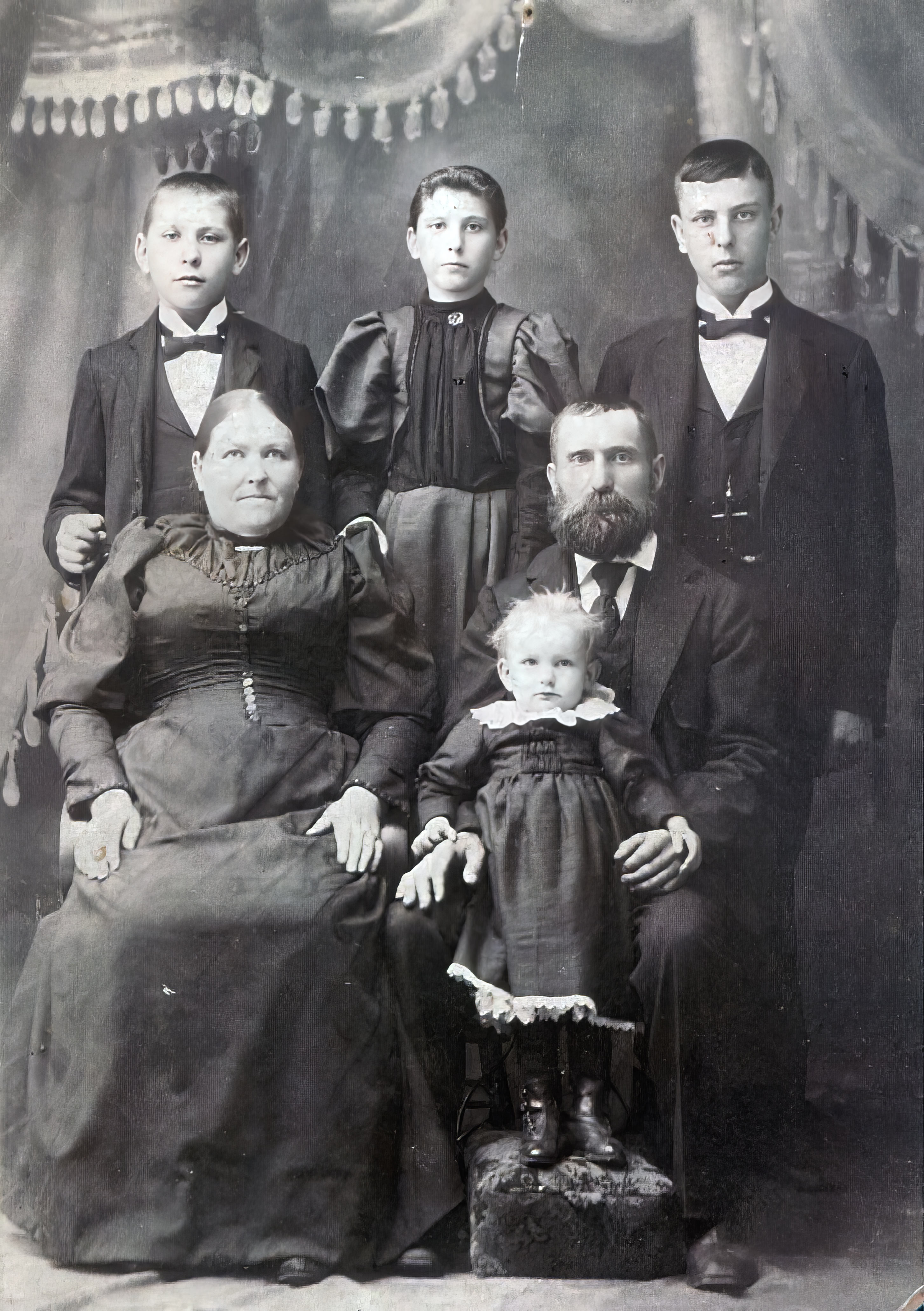
In the area around Kreis Stolp in what was once Pomerania there are a plethora of Kebschull families, one of which shows a match with my autosomal DNA test. People who submit autosomal tests via Ancestry.com aren't always enthusiastic about contacting people with whom they match, or (on the other side of the coin) responding to queries from people who match their line. It's one of the hazards of participating in these testing services. You can't get your hopes up. You may have to research the old-fashioned way: moving from one generation back to the next, using available online records.
This family pictured at right may be part of our Kebschull clan, or they may not be. The easy way to tell would be convincing one of their descendents to take a test. The harder way is tracing back from their submitted tree...if there is one. Pictured are Gustav Kebschull, his wife Adeline Misch Kebschull, and their children. Gustav was born Gustav Gottlieb Eduard, 28 Feb 1858 in Wundichow. His parents were Friedrich Kebschull and Henriette Friederike Staschke.
“Citation: Autosomal DNA test, database, Ancestry.com (https://www.ancestry.com/ : accessed 15 December 2022), using the "DNA Matches" option to query for Kebschull; results from this dynamic database require the private passcode and kit number of this individual.
But so far Gustav and his family don't show up as matches in my autosomal results. A different Kebschull family does, however, and it's reliably traceable back to a Kebschull who definitely married into our family.
The DNA match that is presented in this tree involves William Kebschull, born 01 May 1897 in Wundichow, and who died 29 Oct 1964 in St Joseph, Berrien, Michigan, USA, emigrating 1923. William was married to Auguste Marie Zordel and they had a family in St. Joseph, Michigan.
From the records that we can see, William is apparently the descendant of Ernestine Charlotte Lübeck, an illegitimate daughter born 1825 to Carl Kebschull (1803-1877) and Friederike Henriette Lübeck (1803-1853). This couple married in 1835 and legitimized Ernestine Charlotte. Ernestine Charlotte married Friedrich Wilhelm Kebschull (1823-1906), son of Johann Jakob Kebschull (1790-1866) and Ephrosine Meyer (1791-1867), all in Klein Nossin. This deviates from the online tree presented from our matching test-taker, but this may be the result of incomplete research on her part. It's the Lübeck line that provides the link to me. Ernestine Charlotte was the niece of my great-great grandmother Emilie Louise Lübeck (1814-1890). That solves that conundrum.
But what about Gustav and his family? At the moment none of my research suggests a confirmed connection. But there are so many Kebschull families in this region -- and so many of them who married into the Lübeck clan -- that we may see something definitive at some point. "It does not matter how slowly you go as long as you do not stop," said Confucius. Perhape he knew something about genealogy too.
December 15, 2022 | Email your comment.
Out of the mist
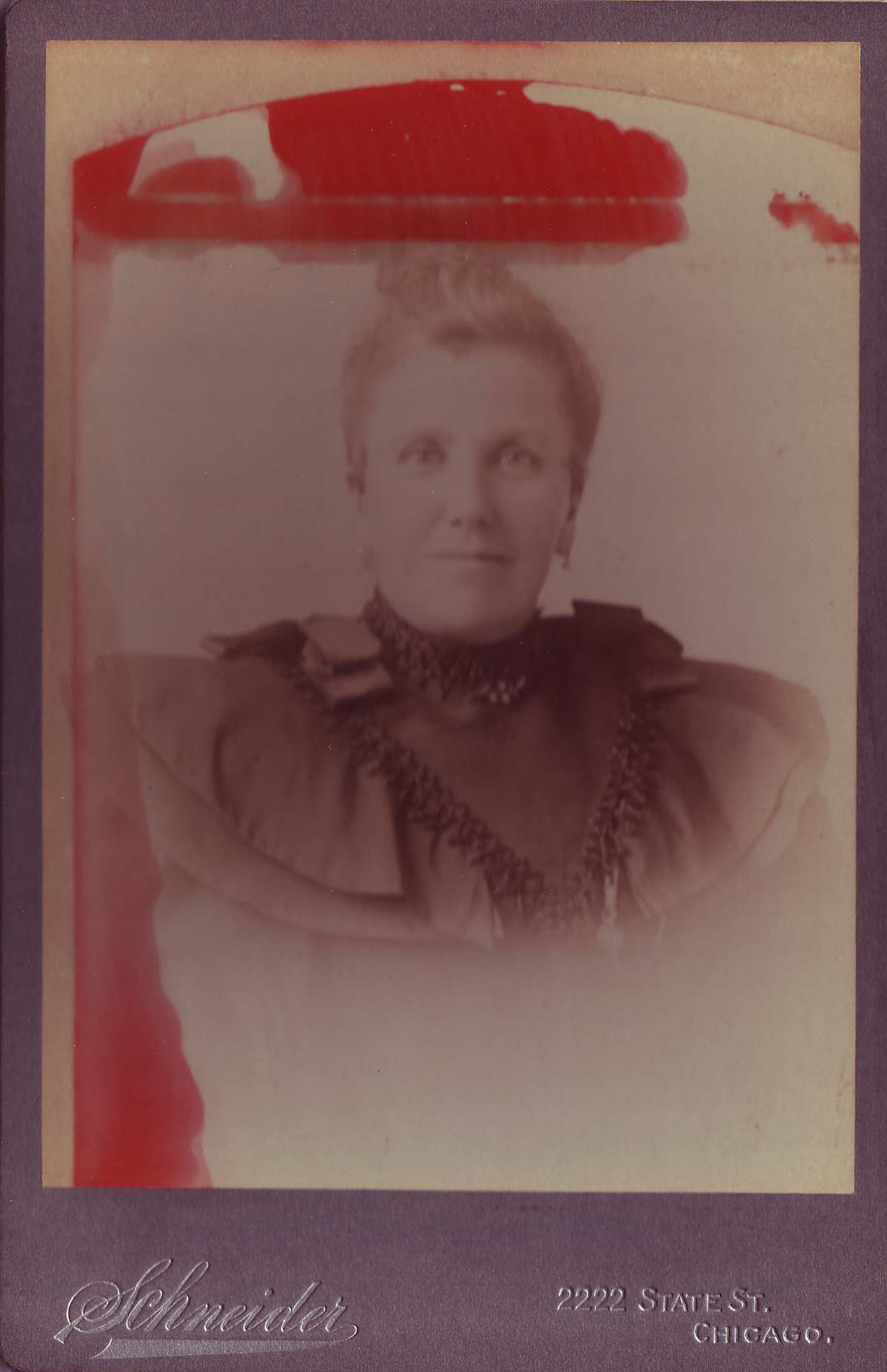
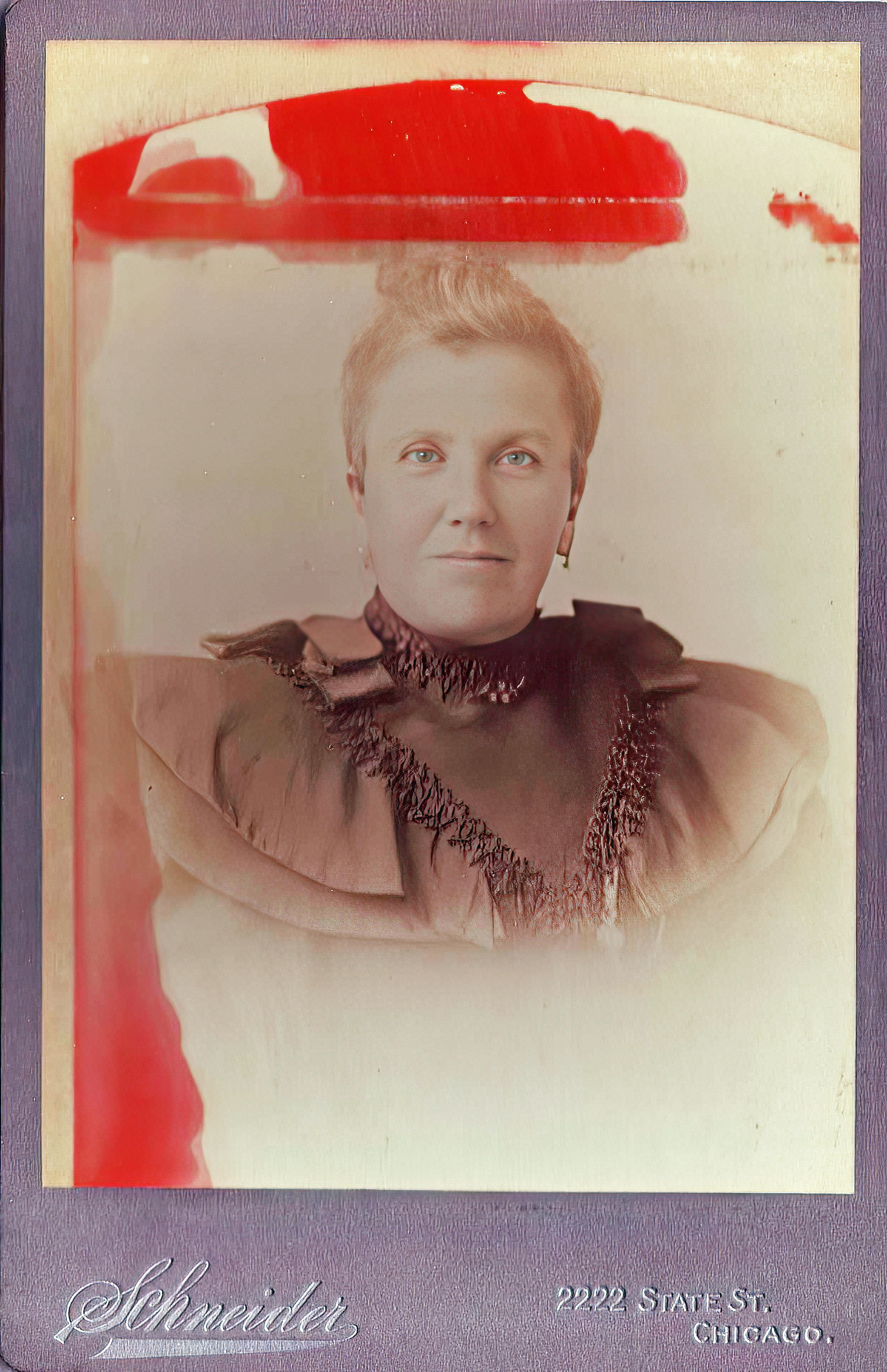
Technology is a wonderful thing. It can help us see into the far reaches of space (thanks, James Webb Space Telescope!) as well as view the past with renewed eyes. This example shows us what a software package can do to improve an old photo in our collection. Click either photo to see an enlargement.
The identity of this lady is unknown, unfortunately. She was part of Catherine Petersen Mikkelsen's collection and was one of the more damaged examples. This cabinet card was probably a copy of an original, perhaps showing one of Catherine's relatives or friends from Schleswig. It was produced at Schneider Studios at 2222 State Street in Chicago. Peter Schneider ran a studio at that location from 1894-1900, as we know from this Internet resource (see page 132 for details).
The original photo shows a lady in her early fifties, a widow in black if her dress is any indication, with a sartorial style dating this fashion to the mid-1890s. Catherine had a habit of encasing her favorite photos in a red cardboard frame, which under the duress of time bled into the print. This happened regularly to photos in her collection. The original has also suffered from some sort of fog over the image. However, by applying a software package that cleans up old photos, we can have a fresh look at the Unknown Lady.
“Citation: Digital reproduction of a photograph, front side, collection of Catherine Meyer, unknown lady, ca. 1895, Scheider Studios, Chicago, Illinois; original copy scanned in 2006, enhanced Topaz Photo AI version 2022.
The Topaz Photo AI program cleans up "noise" consisting of scratches and dust on the original image plus applying a facial improvement aLgorithm to the photo. The result includes the program's interpretation of some original tinting, present in the depths of the image. As a result, the eyes appear to be hazel/blue and the hair blonde, details we couldn't see in the original. We can also now see details of the elaborate embroidery on the shoulders of the dress, and a botanical diamond pin or brooch at her collar, something that was completely hidden in the shadows of the original print.
Nothing new has been added. Closed eyes are not opened (something that some modern photo software can actually accomplish!) nor are elements or people added to the enhanced photo. But like modern recording and film engineers who can pull previously-unseen details out of existing but flawed source material (e.g. the Beatles' "Get Back" video restoration by Peter Jackson), this software package can help us see what was likely there when the photo was new.
And the more details we can see for ourselves, the better possibility of someday identifying this lady based on other photos in Catherine's collection. We can hope, anyway!
December 10, 2022 | Email your comment.
Thinking of linking
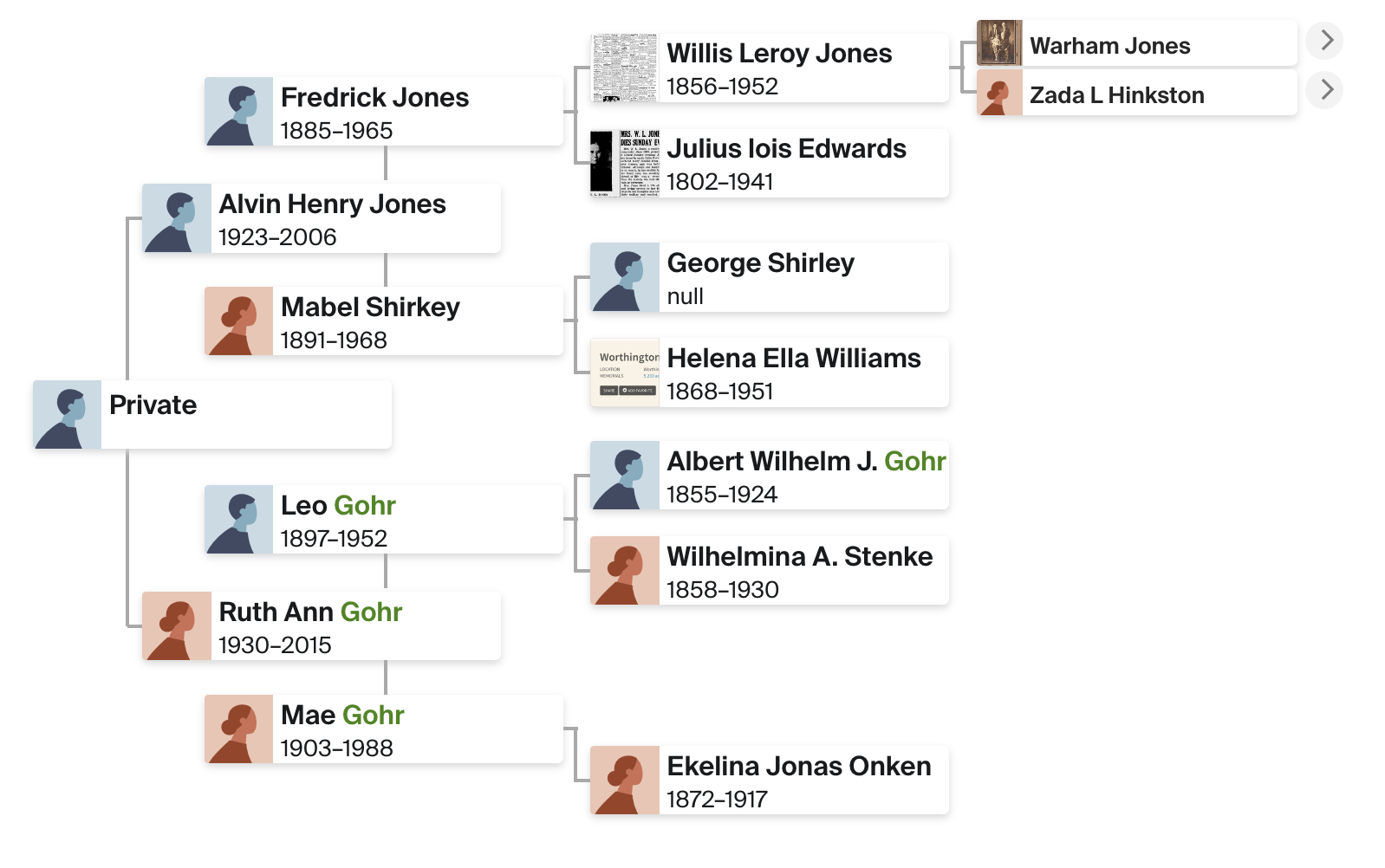
Sometimes you can't find genealogical records that prove a relationship. We can guess that a name like Gohr, from the region Kreis Stolp in what was once Pomerania and is now Poland, had some related Gohrs. It makes sense. But without complete local records, how do we prove it?
That's where DNA comes in, specifically autosomal DNA. Today's tests can help link families with the same surname even if we can't plot a records-based ancestry. In this particular region there are entire villages where documentation is either tenuous or non-existent. All we can know is what DNA tests tell us...and this test tells us that an ancestor of Lyle Jones, Albert Wilhelm J. Gohr, was a relative of my ancestors Albert and Wilhelm Gohr.
“Citation: Public Member Trees, database, Ancestry.com (http://www.ancestry.com : accessed 6 December 2022), Lyle Jones family tree by Lyle Jones, profile for Albert Wilhelm J. Gohr (1855-1924, d. Kimball Twp., Jackson County, Minnesota) undocumented data updated 2019.
More interestingly, another researcher and I who both have Gohr families in our tree match with Mr. Jones too. That confirms a link between us as well, one that we may not be able to prove any other way.
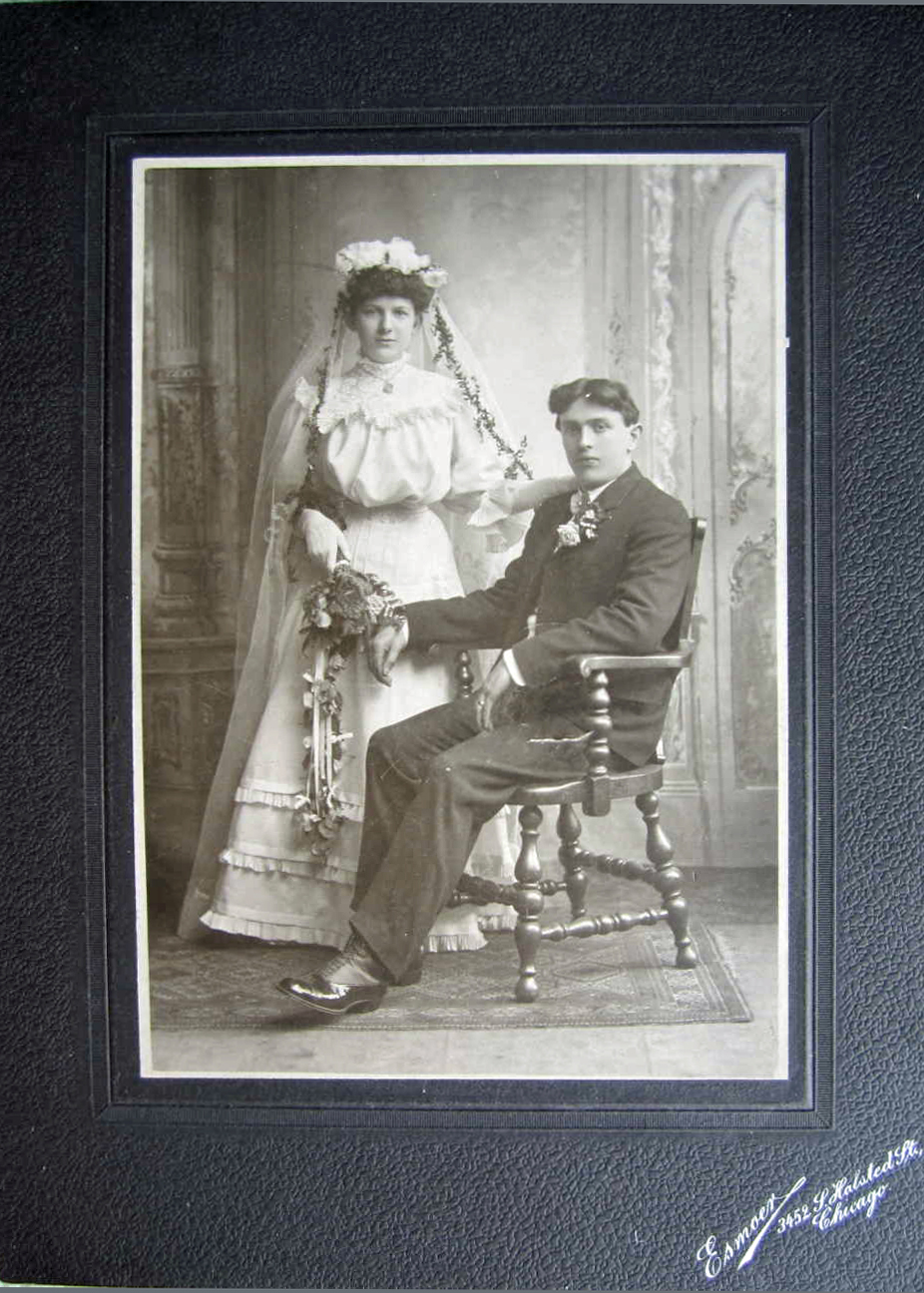
Our Gohr ancestors came to Chicago, Illinois in the 1870s and early 1880s. We don't have photos of the oldest Gohrs, alas, just a trail of documents from the region and this one photo of Paul Conrad Gohr (son of Albert Julius Reinhold Gohr and Wilhelmine Paulina Mews) and Paul's bride Franziska Schmude on their wedding day in 1906.
All three immigrant Gohrs -- Albert Julius Reinhold (1844-1895), Albert Wilhelm (1855-1924), and Wilhelm Robert Otto (1857-1905) -- were married in Chicago. The elder Albert and his younger brother Wilhelm remained there and worked as laborers for the rest of their lives. Albert Wilhelm traveled to Kimball Township in Jackson County, Minnesota and farmed, establishing a family there.
We know that Albert's parents were Wilhelm Gohr and Caroline Jaffke, who remained in Kreis Stolp, so it would seem. But the local records from the villages of Prebendow and Zetzenow are missing or destroyed. Does Mr. Jones know anything more about his Gohr ancestry than is posted online? We hope to find out.
December 6, 2022 | Email your comment.
Erin go Bragh
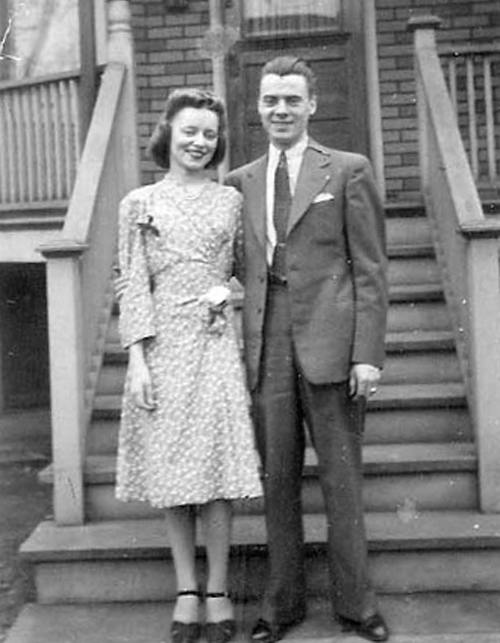
Usually I don't get to work with English/Irish/Scottish records but my uncle Walter is an exception. Walter Miller Ronchitti, born in Glasgow, Scotland in 1914 and married to Marie MacLaughlan in 1941 in Chicago (pictured at left), dropped his second surname and used Miller exclusively. This made it hard to search for him or his family until my cousin told me about his original name. It was Ronchetti or Ronchetti, more or less. There were a number of spelling variations, some based on the pronunciation of the surname, and that made it tricky to research.
Walter's emigration records when he was fourteen years old show him with the Ronchitti surname. Sometime before his marriage he decided to streamline his identity and became known as Walter Milller. However his earlier family bounced around from Manchester to Liverpool to Dublin to Glasgow, and the name was variously spelled. Even more entertaining are the other Ronchetti people who show up all over England in the nineteenth century, from Devon, Cornwall, London, Lancashire, and Yorkshire. Are they related? It's hard to tell.

Occupations don't give us any clues. Italy must have been the country of origin for members of this family if you go back far enough. Many of the London-based folks were manufacturers of scientific instruments like barometers and thermometers. One was a jeweler and watchmaker. But Walter's ancestors were craftsmen of a different sort. The earliest ancestor we've found for Walter was his great-great-grandfather, Joseph "Ranketty" as it was spelled, who was a master carver and gilder (gold-worker). Joseph was born about 1780 in Dublin, married Maria Rogers in 1813, and, among other offspring, had a son Joseph in October 1823.
“Citation: Ancestrylibrary.com. Ireland, Select Catholic Birth and Baptism Registers, 1763-1917 [database on-line]. Lehi, UT, USA: Ancestry.com Operations, Inc., 2014, for Joseph Ranketty, 1 October 1823. Original data: Celtic Catholic Registers, digitized images, Dublin, Ireland: E-Celtic, Limited, accessed 3 December 2022
Joseph Junior married Mary Ann Preston in 1946 in Manchester, England, and the publication of the marriage banns helps us identify this Joseph as ours, despite the existence of others with the same name (including a thermometer maker in Dublin). The banns clearly identify our Joseph as a carriage-maker whose father was a carver and gilder.
The family seemed to spend time in both Dublin (where at least one of their children was born) and Liverpool, where Joseph Junior died at the age of 87 in 1910. A son, William, born in Lincolnshire in 1851, was listed as a sea cook in the English census records. Helpfully, his own son William, born in Glasgow, listed his father as a sea cook and was himself a millwright. It was in Glasgow that Walter Miller Ronchitte was born in 1914. It's unclear where the middle name Miller was from, perhaps from Walter's grandmother Barbara who appears both as Barbara Miller and Barbara Wallace. Perhaps someday we'll find out more about Barbara.
December 3, 2022 | Email your comment.
Baby Olga and her legacy
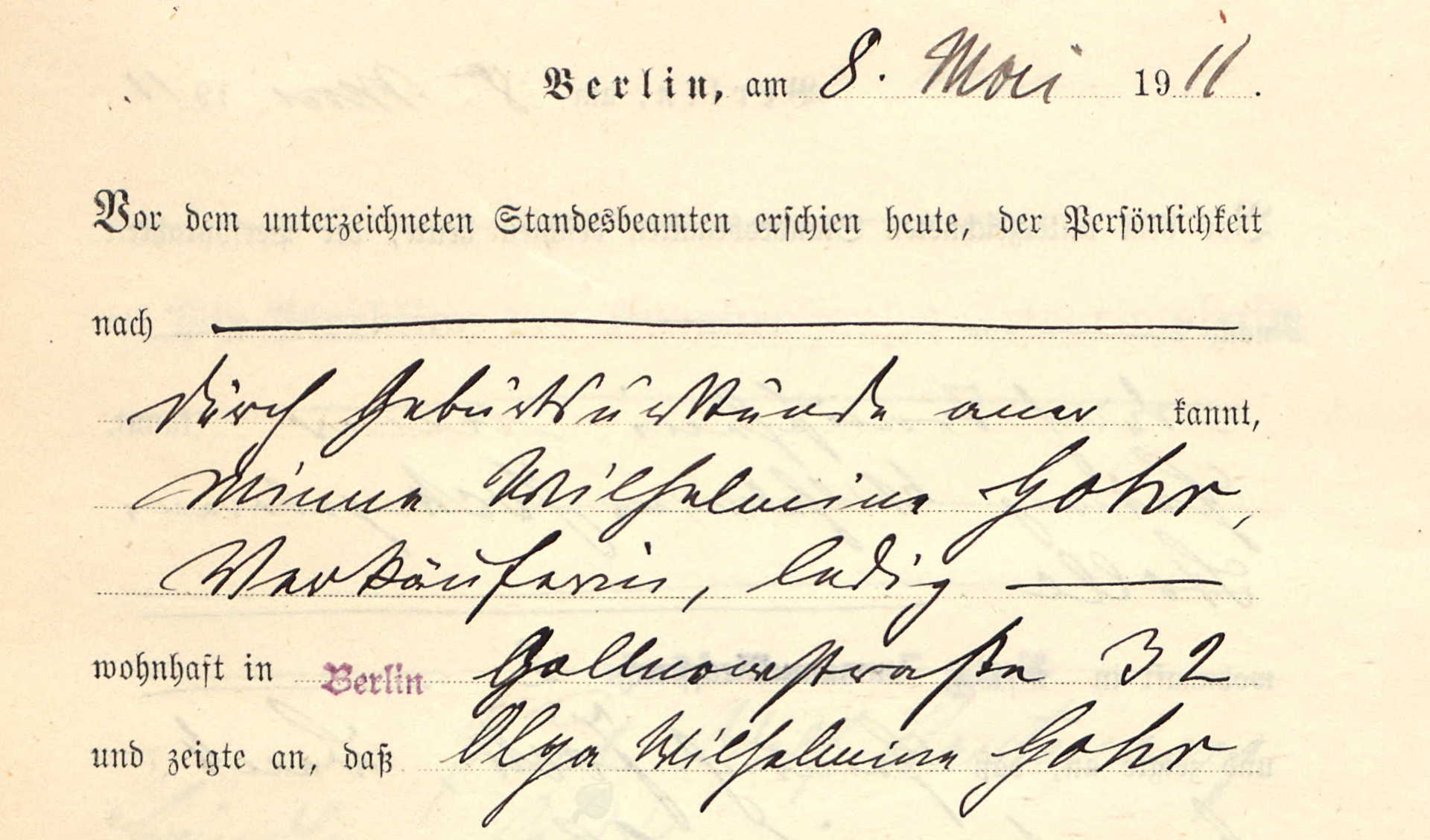
DNA testing is very popular these days, particularly autosomal, which can match cousins to each other, both distant and close. Autosomal tests can match DNA segments in a way that helps us connect to people we might otherwise not know. That's the case here. This record at right indicated the death of Olga Wilhelmnina Gohr, age three months, in Charlottenburg, Berlin. Her mother was Minna Wilhelmina Gohr but no father is listed.
“Citation: Ancestrylibrary.com, Berlin, Germany, Deaths, 1874-1955 [database on-line]. Provo, UT, USA: Ancestry.com Operations, Inc., 2014. Original data: Sterberegister der Berliner Standesämter 1874-1955 digital images, Landesarchiv, Berlin, Deutschland, accessed 27 Nov 2022.
My own autosomal test suggested a 4th-6th cousin connection to a lady whose public tree had only twelve people listed, one of them Baby Olga, who lived and died in 1911. Presumably the private version of the tree lists Olga's mother, but the hint of illegitimacy may have made the tree owner a bit shy about sharing documentation. I'm not shy, however. Knowing that Gohr is a surname from my own tree, I plugged in Minna Wilhelmina Gohr into the wonderfully helpful search engine at https://pomorskie.indeksy.net/ and up popped a record. Click the image below to see the entire page up close.

This seemed like a really exciting connection at first. Minna's father was Ferdinand Gohr -- new fellow? A clue to the elusive Wilhelm Heinrich Gohr, whose birth and death date can't be found? Nope, we have Ferdinand already. He's Wilhelm Heinrich's son, born in 1846, and in this record married to Therese Quetschke. How do we know this is likely the son? Because Ferdinand's mother, the widow Emilie Lübeck Gohr, is a godparent, and although she was 65 years old in this record (and perhaps too old to be a really effective godparent should the need ever arise) it indicates a close family connection to the new infant, Minna.
“Citation: Budow Parish (Budowo-Budow), "Arckiwum Panstwowe w Koszalinie" Baptisms, 1879, Geborne und Getaufte 1865-1895, GenBaza/GenBaza/AP_Słupsk-27/Budowo_276-Budow/Parafia Budowo/1865-1895 U/185.jpg, image 185 [186] birth number 64, Minna Wilhelmina Gohr, Geburt 23 April 1879/Tag der Taufe 4 May 1879; imaged in Metryki Genbaza PL, database and digital images, (https://metryki.genbaza.pl/genbaza,detail,480246,186: accessed 27 Nov 2022).
It also explains the new autosomal DNA match. Baby Olga didn't live long enough to grow up and leave descendants, and none of Minna's numerous illegitimate children did either, from what I can tell, but if one of Minna's siblings did provide traceable descendants, that's likely the connection here.
Minna had at least three sisters whose children, grandchildren, or great-grandchildren may have provided the link. In any case, my link to Ferdinand Gohr's family isn't the least bit surprising. Our DNA reflects it, and now our documentation does too. Perhaps at some point I'll hear back from this new cousin and we can compare notes.
November 27, 2022 | Email your comment.
A restored monument
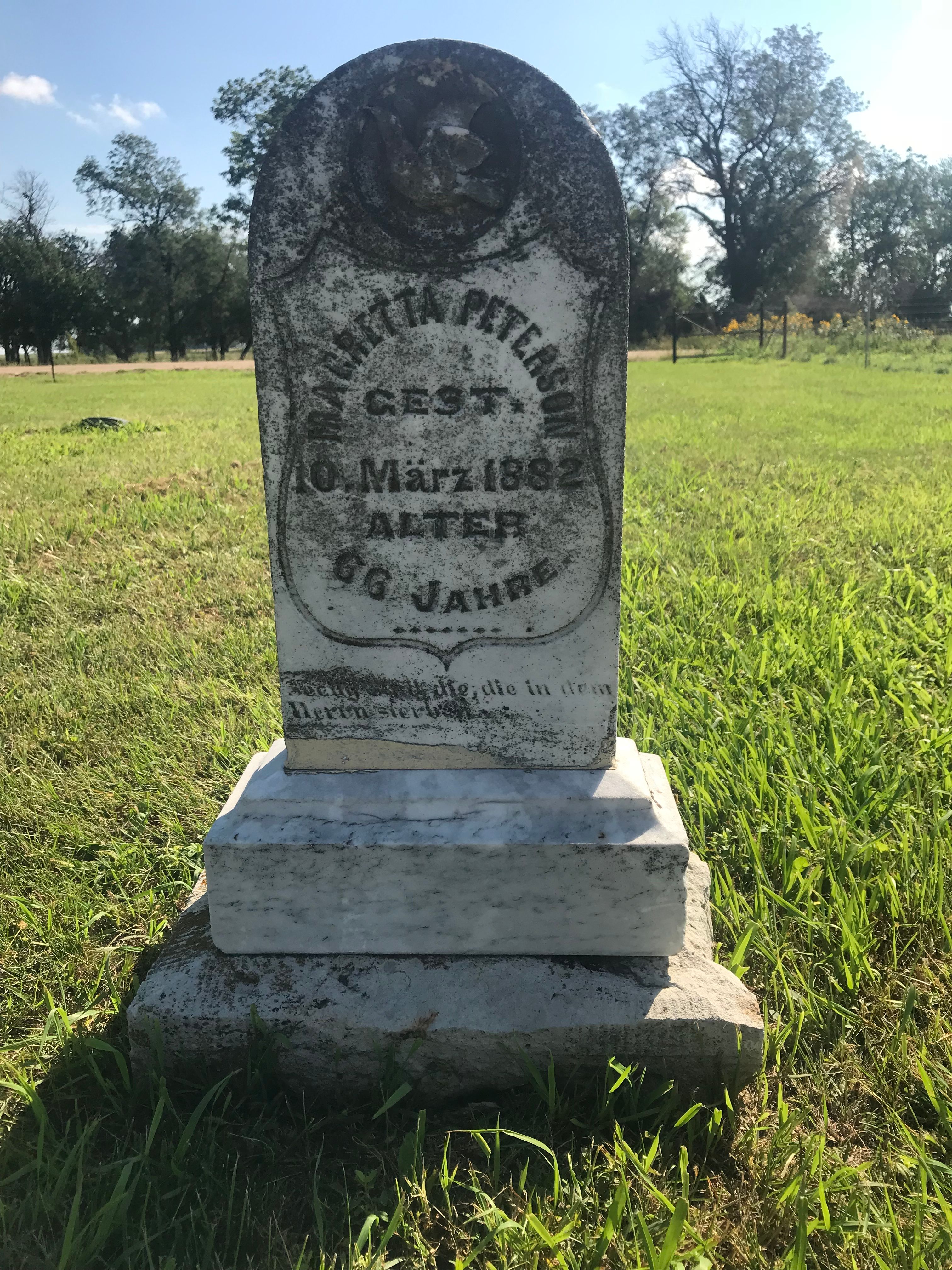
Margarethe "Magretta" Petersen was able to spend just ten years in her new country before she died in 1882 at the age of 66. Her husband Lorenz Petersen and son Hans lived in Belle Prairie, Nebraska where they owned a farm -- a prosperous one too, according to census records.
The region was sparsely populated, mostly with immigrants from other German and Scandinavian countries, all taking advantage of the free land that Nebraska gave out to encourage incoming populations. When Magretta died her family was part of the St. John's Lutheran Church congregation in the tiny town of Ohiowa. That's where the cemetery was located that became Magretta's sinal resting place.
“Citation: Find a Grave, database and images (https://www.findagrave.com/memorial/119247716/margaretta-peterson: accessed 20 November 2022), memorial page for Margaretta Peterson (1816–3 Oct 1882), Find a Grave Memorial ID 119247716, citing Saint Johns Lutheran Church Cemetery South, Ohiowa, Fillmore County, Nebraska, USA; Maintained by Ruth Ellen Bartels (contributor 47315485).
Over the years time (and climate, probably) were cruel to the headstones in the cemetery. Magretta's was at some point knocked off its marble pedestal, as you can see in Darlene Most's photo from about twenty years ago.
Thankfully someone has recently repaired it, as you can see from Karody Robbins' newer image. The headstone is back on its pedestal again and the lower inscription is now readable: "Selig sind die, die in dem Herrn sterben," in English "Blessed are the dead who die in the Lord."
We're grateful to Karody for uploading this photo to Find-A-Grave. It's a reminder too that we should be revisiting Find-A-Grave sites to see whether any updates have been made to relevant pages for our ancestors. There may be surprises in store.
November 20, 2022 | Email your comment.
Two sisters, two marriages
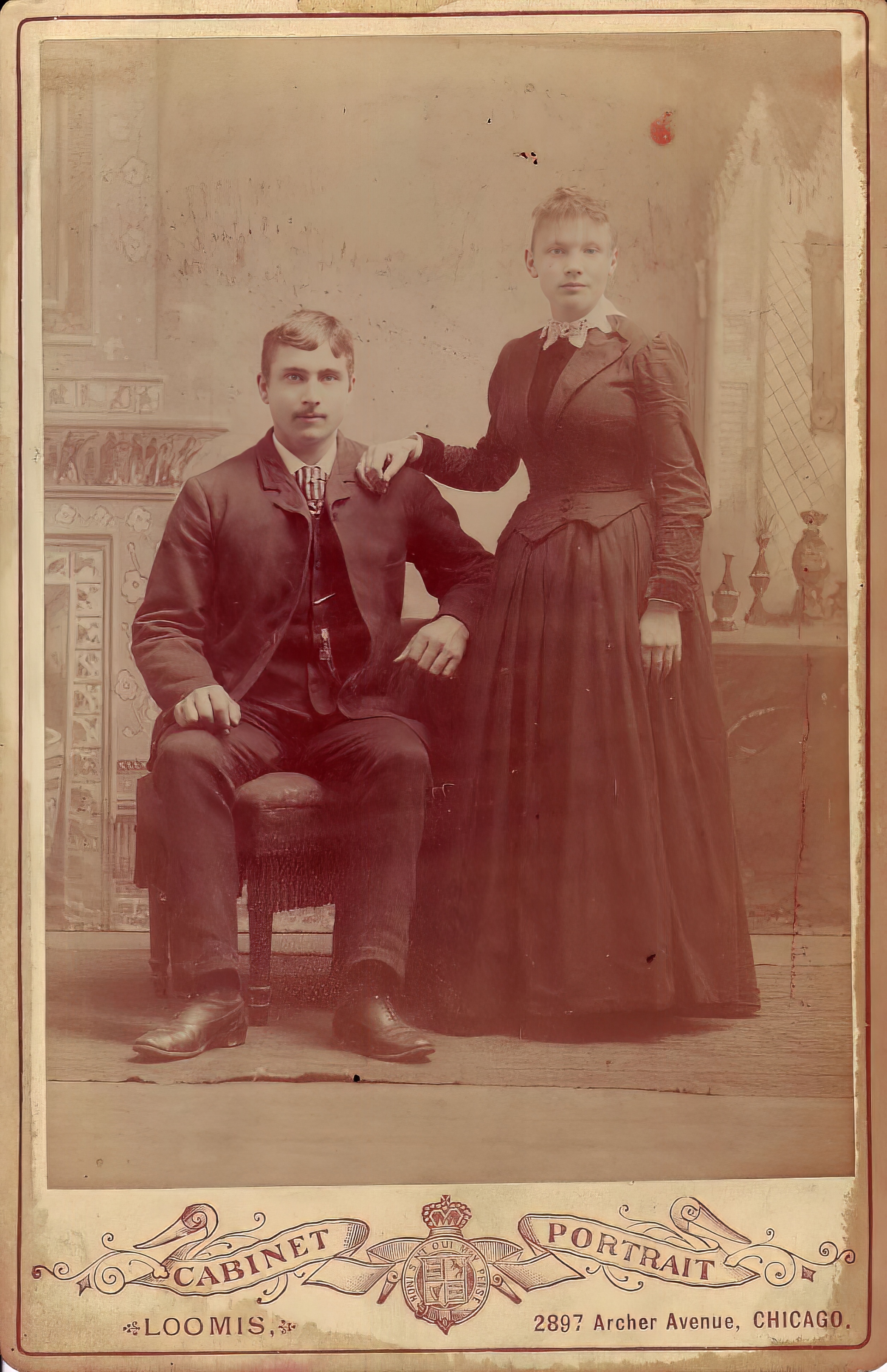
Two Petersen brother in Nebraska pooled their funds to bring over two sisters from Falkerslev parish in Sjaelland, Denmark in the late 1880s. How did they find out about these marriageable ladies? Not known! Perhaps the local Lutheran church kept a list of potential brides for church members.
“Citation: Digital reproduction of a photograph, front side, collection of Catherine Meyer, Andrew Petersen and Karen Marie Johansen, ca. 1889, Loomis studio, Chicago, Illinois; original copy scanned in August 2005 by D.L. MacLaughlan Dumes.
Anna Kirstine Johansen (born in 1859) and her sister Karen Marie Johansen (born in 1870) emigrated to America around 1887. Anna married Peter Hansen Petersen (see the posting below) that year in Friend, Nebraska and Karen married Peter's younger brother, Andrew, in York County, Nebraska two years later. The latter bride was just nineteen. You can view the happy couple in their engagement photo at right.
Karen was the last child of her parents, who were married in 1852 in Maribo Amt, Aastrup Sogn, Denmark. How do we know? We're lucky enough to have Karen's exact birth/baptism date, which allowed us to locate her baptism record in Danish records as well as her parents' marriage record. But more interestingly it also revealed a curious naming convention in her family.

Her mother was Kristin Maren Nielsen and her father was Johan Carl Semelin. Local conventions apparently persuaded the parents to use patronyms for all their children. The male children were Johansen, the female children Johansen or Johansdatter. But why not Semelin, their father's actual surname as it was recorded in his 1818 baptism record above?
“Citation: Danmark Kirkebøger, 1484-1941, database with images, FamilySearch (https://familysearch.org/ark:/61903/3:1:3QSQ-G94W-X7CR?cc=2078555&wc=M5K4-161%3A357518001%2C359966001%2C360199801%2C360210501 : 10 November 2022), Maribo > Falster Nørre > Maglebrænde > 13 (1811-1835) Fødte, Konfirmerede, Trolovelse, Viede, Døde, Register > image 77 of 131; Rigsarkivet, København (The Danish National Archives), Copenhagen.
Some areas of Denmark still clung to the patronymic naming conventions that had been in place for hundreds of years prior to the births in this family, but some families, for unknown reasons, used an actual surname. It's possible that this surname had some sort of presence in the community that encouraged Johan Carl to use it for himself -- interestingly his father was also Johan Carl Semelin, born in 1789. In the citation at right you can click on the link to view the elder Johan Carl Semelin's marriage record to Dorothe Mortensdatter in 1816.
Perhaps the family name originated elsewhere and it distinguished them from the locals; there's some indication that the family name may have come from Sweden. In any case it's a bonus for researchers looking for traces of Johan Carl in the Danish records. He's easy to find and he's everywhere. He married at least twice, while his father married three times. And all nine of his children are easy to look up with the use of that surname.
November 10, 2022 | Email your comment.
Petersens in Nebraska: a new photo
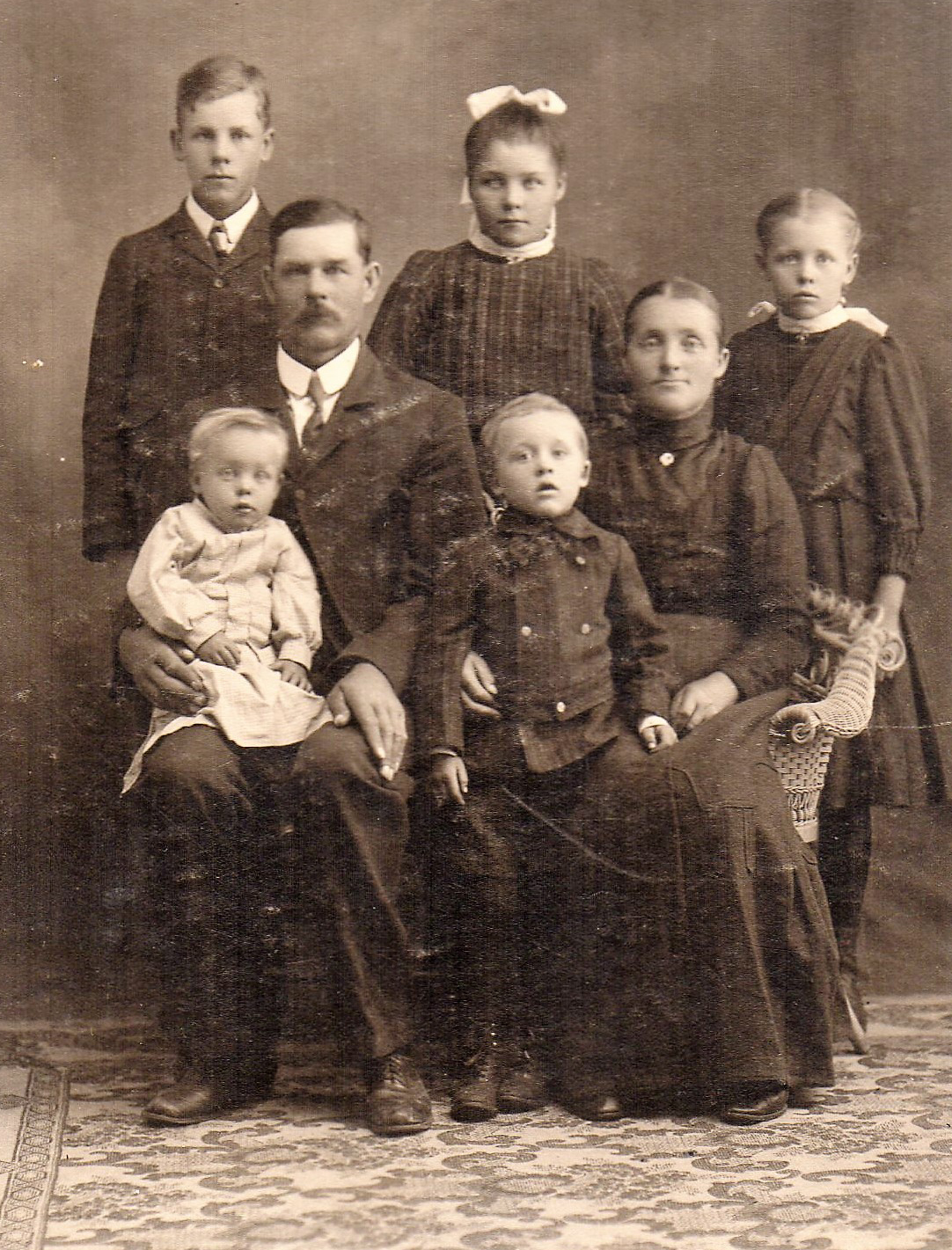
When the family of Peter Hansen Petersen emigrated to the United States in 1878, they chose Nebraska as their new home. It wasn't merely a random choice. Nebraska had a generous land give-away program at the time for determined homesteaders. And the family already had a couple of relatives living there: cousins Lorentz Petersen and his son Hans, who had begun a prosperous farm in 1872.
Peter Hansen Petersen the younger, his father's namesake, married Anna Christina Johansen from Falster, Sjaelland, Denmark and established his own farm in Fillmore and York Counties in Nebraska. Until now we've only seen photos of this couple in their older age, but thanks to a cousin who has shared an earlier image on his Ancestry.com website we can have a look at the couple's growing family circa 1897. It's interesting to note that Anna Christina's sister Karen Marie Johansen married a younger Petersen brother, Andrew, and they established a home in Kenosha, Wisconsin.
“Citation: Public Member Trees, database, Ancestry.com (http://www.ancestry.com : accessed 29 October 2022), “Peter Hans Petersen (Pedersen)” family tree by Thomas Petersen, profile for Peter Hansen Petersen (1860-1945, d. Mason City, Nebraska) undocumented photo shared by Tina Petersen and updated March 2016.
The children are Helena (wearing a ribbon in her hair), Charles next to Helena, Katherine or Ada (unsure which one standing next to her mother Anna), Christian in front of Anna, and Peter on his father's lap. Other children (Anna, Elizabeth, and Alfred) were yet to be born.
The parents named their children after close relatives. Helena was named for her father's sister Helene Petersen Burmaster, who remained in Schleswig. Charles was named for his maternal grandfather. If Katherine is the next child, she was named for her aunt Catherine Petersen, Peter's younger sister (if this is Ada, we don't know where that name originated). Christian Nicolai was named for his father's older brother who also remained in Schleswig. And Peter shared a name with his father and paternal grandfather. Everyone, it appears, was well commemorated.
The photo is a cabinet card without a studio imprint, so we don't know where it was taken, but it was likely produced in Omaha where other family members lived. Peter looks a lot like his other brothers, most of whom emigrated to Nebraska and sported similar hairstyles and moustaches.
October 30, 2022 | Email your comment.
Three cousins
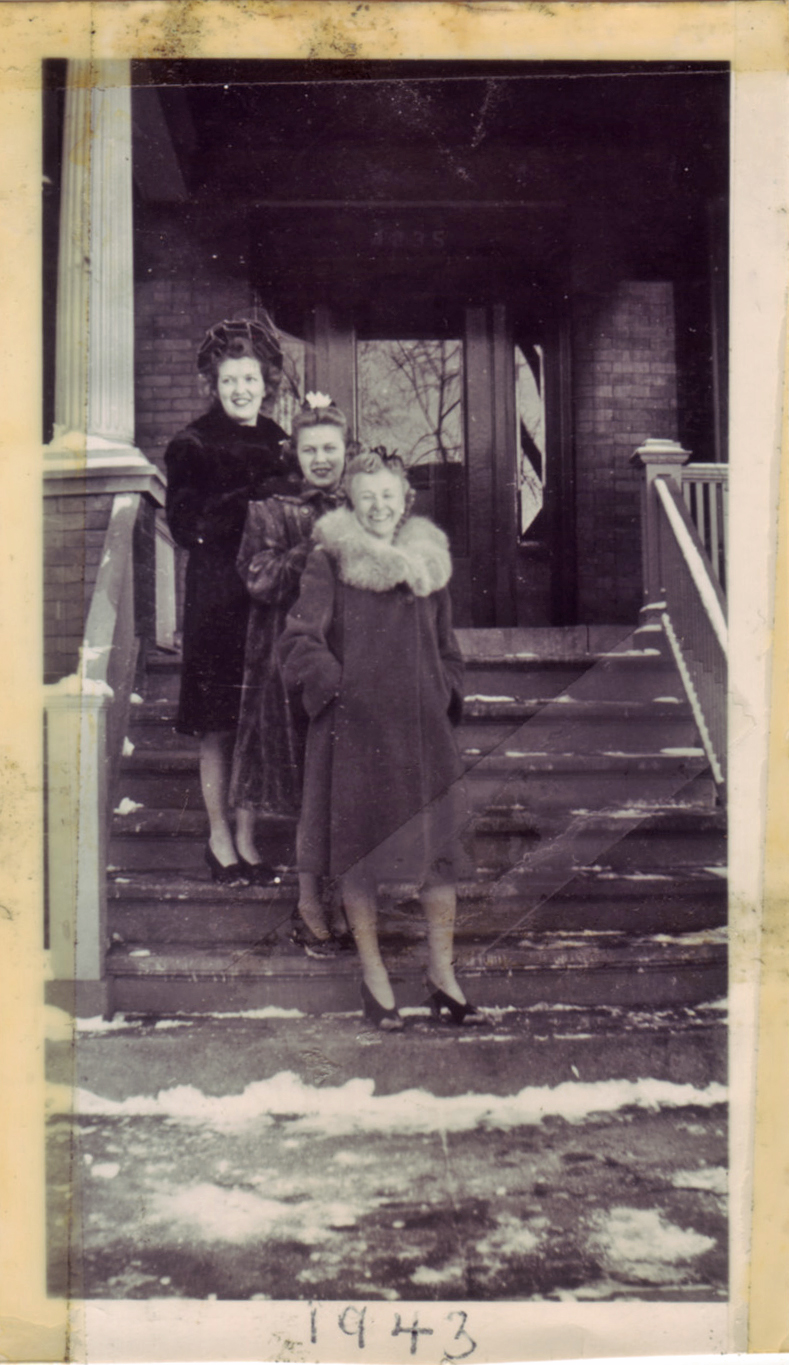
Sometimes there's no family documentation on how various branches are in contact. We may not know without some form of evidence, and it may not be written down: no family letters, no trees, no stories.
In this case, how do we prove that sisters from the old country, both of whom emigrated to Chicago, had family members who knew about each other down through the generations? The answer lies in a photograph. But we didn't know for sure that the descendants knew about each other until we proved who was in the photo and how they were related...if they were related.
In this case, it was a cold day in winter 1943 when three stylish ladies met at the Bruns home at 4235 Winchester Avenue in Chicago. The ladies are bundled up for the weather although apparently not willing to dispense with open-toed shoes. Fashion comes first!
“Citation: Digital reproduction of a photograph, front side, collection of Bertha Bruns Gohr, from the top: Lorraine Bruns, Lolus Bruns, Loretta Murphy Mayhan, ca. 1943, original photograph from the album of the owner, scanned in 2015.
Research tells us that the ladies are second cousins from an interesting line, and we had to do some research to tell us how they were connected. Here's what we found: their grandmothers were sisters. Augusta Kramp Hasse, born in 1854 in Klein Massowitz, Pomerania, and Laurette Albertine Henriette Kramp, her younger sister born in 1856. Both Augusta and Laurette (or Laura as she was known in Chicago) emigrated in 1881, Augusta with two of her children to join her husband Carl Hasse, who was already in Chicago, and Laura to marry her fiancé Wilhelm Gohr, an emigrant from Nippoglense, Kreis Stolp, Pomerania, who had already arrived with Carl Hasse. It appears that other members of the Kramp family remained in Massowitz.
Wilhelm and Laura had eight children in Chicago. Laura died in 1893 of puerperal fever along with her infant daughter Elsa. Carl and Augusta had four children, two born in Germany and two in Chicago. Carl died in 1903. But it's clear that both sides of the family, the Gohrs and the Hasse clans, were close.
Loretta was born in 1909, the daughter of Augusta's daughter Emma and her husband Owen Patrick Murphy. As far as we know Loretta was the only child of the couple. Lorraine and Lolus were the daughters of George Bruns and Bertha Gohr Bruns, granddaughters of Laura Kramp Gohr. While they never had a chance to know her, the sisters did grow up around Augusta, who lived with her children in Chicago until 1938 when she died at the age of 83.
Loretta was a part of their families even after Lorraine and Lolus relocated to Southern California in the 1940s. Loretta had married Joe Mayhan, a native of Wenona, Illinois, in 1939. They had no children. However the photograph serves as documentation that the family connection was maintained over the decades.
October 17, 2022 | Email your comment.
Two weddings?

It's a little surprising that Joseph Bruns and Elizabeth Bruns are listed with the same surname in this 1844 emigration record. Headed for Baltimore and ultimately for Cincinnati, where a large German populace awaited them, the assumption is that they were already married.
But were they?
Both are listed on this manifest as originating in Knetsen, Germany, probably Großknetsen near both of their home towns (both from Oldenburg, Joseph from Deindrup, Elizabeth from an unknown village in Oldenburg). However, upon arriving in Cincinnati, they appear in the Old St, Mary's Catholic Church registry as an unmarried couple, Heinrich Joseph Bruns and Maria Elizabeth Grewe or Grawe (her surname could be spelled both ways depending on the clerk's predilections). This marriage took place on October 24, 1844 with Clemens Dodt and Wilhelmina Diess or Dietz as witnesses. It's the second entry in the image below.
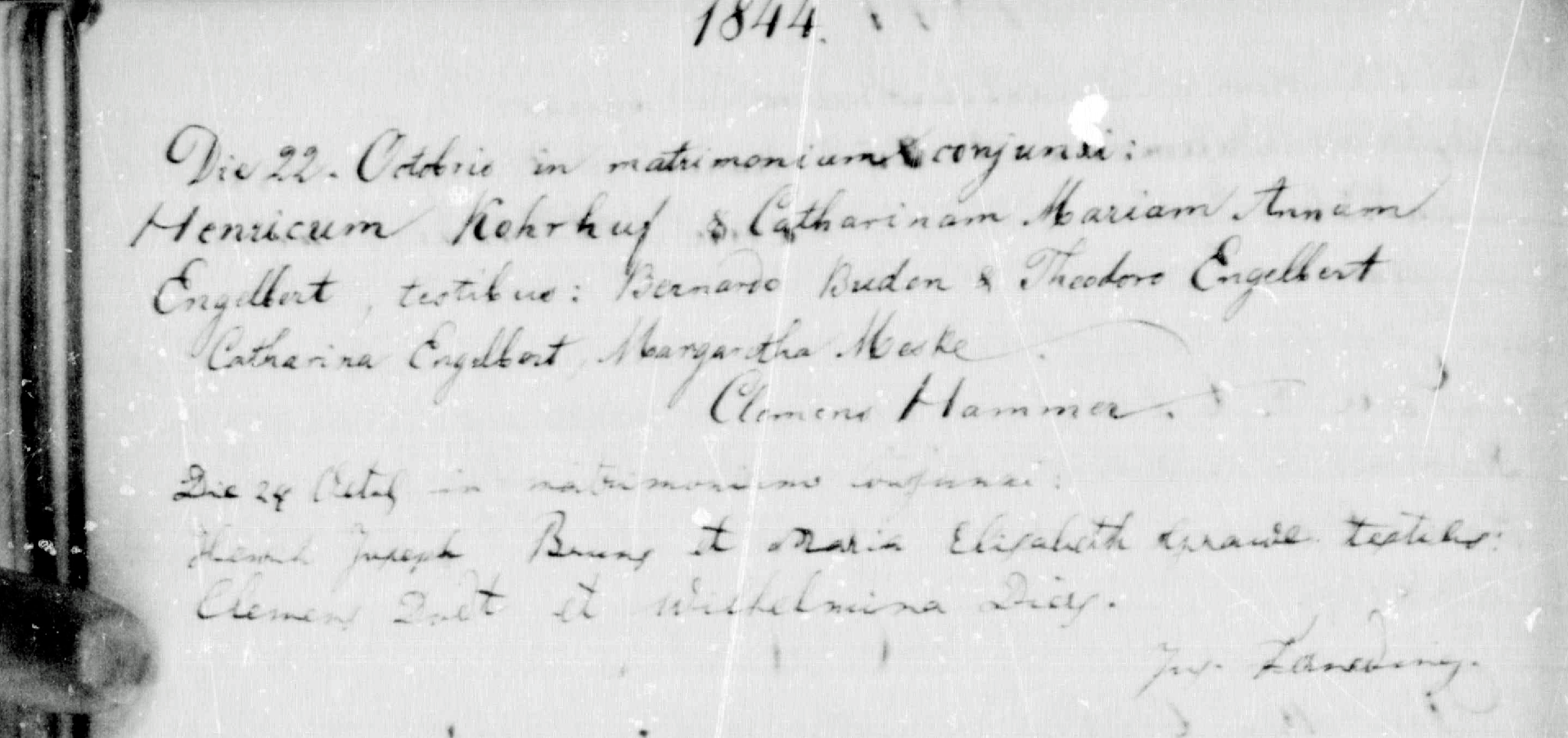
Find My Past transcribed the bride's name erroneously as Leraude but with sufficient magnification you can read that it's Grawe or Grewe. Other helpful information, such as the bride's and groom's parents names, ages, or town of origin, are missing. These are cryptic records. Maybe a more complete one exists in the depths of Old St. Mary's Church. In any case, the sames are the ones we're looking for, and what remains is some sensible explanation of why this couple appears to be marrying twice.
“Citation: Cincinnati Roman Catholic Parish Marriages, Old St. Mary’s Catholic Church, page 40 via FindMyPast, database and digital images, (https://search.findmypast.com/record?id=US%2FCINCINNATI%2FD1%2FB04%2FOLDSTMARY-13THCLAY%2FMAR%2F1842-1845%2F00040&parentid=US%2FCINC%2FCATH%2FPR%2FMAR%2F0002050%2FG9: accessed 02 Oct 2022).
There are a few possibilities. Perhaps they weren't really married on the ship manifest but were just listed that way, either for expediency or due to a deliberate subterfuge on the part of the couple. But we know that clerks in U.S. ports were obligated to scrutinize immigration documents to match them up with the passenger -- the urban legend about names changing at Ellis Island (which didn't yet exist) or any other port was simply untrue. Elizabeth Bruns had to have documents identifying her by that name when she arrived.
Were Joseph and Elisabeth married in Großknetsen, perhaps in a civil ceremony for some reason? Were they of different religions, thus necessitating a civil marriage? We don't have any marriage record for them from Oldenburg, so this may have been the best explanation for Elizabeth's identity as Bruns rather than Grewe on the ship manifest. The Cincinnati marriage may have been the first option for this couple to have a proper church wedding. All we can do is speculate. There are no available notations explaining the issue.
October 02, 2022 | Email your comment.
Back to the past

A cousin kindly sent this death record from 1849 for our mutual ancestor, which you can click to enlarge for easier reading. Yes, it lists her name as Ernestine Lübeck born (geb. = geboren) Reddel, but there's a good reason for interpreting this as the death record for Christina Lübeck, born Reddel, the matriarch of this clan.
“Citation: Lupow Parish (Łupawa-Lupow), "Arckiwum Panstwowe w Koszalinie" Deaths, 1849, Verstorbenen und Beerdigten: 1831-1870, GenBaza/AP_Koszalin-26/Łupawa-Lupow/Łupawa_ew-Lupow/04_1831-1870/_068.jpg, image 68 death number 33, Ernestine [sic] Lübeck born Reddel, 27 April 1849; imaged in Metryki Genbaza PL, database and digital images, (https://metryki.genbaza.pl/genbaza,detail,314992,69: accessed 20 Sep 2022).
First of all the lady is listed as a widow (Wittwe). There was an Ernestine Lübeck in the family background, but Ernestine was Christina's daughter, which we know from other records, such as Ernestine's death record.
Furthermore in 1849 Ernestine was married to Christian Fruggel and was not a widow. Ernestine was born in 1801 and thus was not 70 years old, as the record indicated.
Taking those facts into consideration, what we seem to have here is Ernestine's mother, Christina Reddel Lübeck, whose age would have fit the record much more comfortably and whose birth surname was indeed Reddel. But wait, there's more!

These records from Lupow, the parish nearest Ruhleben where the death took place, were very detailed when the deceased had living children, as Christina did at the time of her death. The record lists the children we know she had, in German: "9 [Kinder] mit ihr verstorbenen Mann Michael Lübeck - Ernestine, Friederike. August, Caroline, Mathilde, Emilie, Ludowike, Ferdinand und Juliane." So this part of the death record confirms that it's the mother, Christina, and not her daughter Ernestina whose death is transcribed here.
But hold on -- Christina was the widow of Christoph Lübeck who died a few years before she did. Another error? Who is Michael? Was Michael another clerical mistake for Christina's late husband Christoph? If so, where did the name Michael come from...perhaps from Christina's past?
That's a theory worth following up.
Everywhere that we see Christoph Lübeck's name in these records, whether he's listed as Taufpate (godparent) to a relative's child or as the father of any of his children in their much-later death records, he's listed as Christoph, sometimes Christoff, never as Michael. But Michael somehow crept in here.
In my experience, there's a good chance that the name Michael didn't appear at random. It was a mistake, of course, but it may well have some connection to Christina's family, perhaps when she was born.
“Citation: Lupow Parish (Łupawa-Lupow), "Arckiwum Panstwowe w Koszalinie" Akta Parafii ewangelickiej w Lupowie, pow. Słupsk, Księga metrykalna, Chrzty, śluby, zgony, 1743-1786, GenBaza/AP_Koszalin-26/Łupawa-Lupow/Łupawa_ew-Lupow/01_1743-1786_/_050.jpg, image 51 birth number 17, Christina Reddel, 27 November 1778; imaged in Metryki Genbaza PL, database and digital images, (https://metryki.genbaza.pl/genbaza,detail,60037,51: accessed 23 Sep 2022).

Luckily for us we know exactly when she was born because this death record tells us: in April 1849 Christina was 70 years and 5 months old at her death. This gives us a pretty good target for locating her birth record, if it still exists. If it does, it may be in the Lupow records around November 1778.
So here's what we're looking for: a child called Christina who was born around November 1778 in or near Lupow whose father's surname was Reddel, first name unknown but could be Michael, and a mother whose name is entirely unknown to us.
Remarkably, such a record exists. You can click it to see it better.
The early Lupow records are hard to read but we can just make out for 1778: 27 9br [an early form of writing November in the 17th and 18th centuries, see this explanation for details], "ist Michael [partially obscured by the binding] Reddel's und Dorothea Gowitzschen Tochter Christina getauft" -- 27 November 1778 Michael Reddel's and Dorothea Gowitzschen'[s] daughter is baptised." Taufpaten (godparents) are Hans Georg Jawke, Hewig Maria Bjike, and Dor. [Dorothea] Jawke.
In several ways this seems to fit our theory. The birthdate/baptism date is bang-on accurate for a woman who died at exactly 70 years and 5 months old in 1849. It accounts for the name Michael in Christina's death record -- the clerk mistranscribed her father's name for her husband's -- and it suggests that the mother's name Dorothea made its way down the family line to one of Ernestine's daughters, Christina's granddaughter Ernestina Dorothea, who was born in 1832.
It's still a tenuous theory -- there's only so much we can do to prove it absolutely using available records from the region. But it's a strong possibility that this is Christina Reddel's baptism record and if correct it moves us back to a new and earlier generation.
September 23, 2022 | Email your comment.
A naming mystery cleared up?

Okay, I've changed my mind. We talked about Ludowike Lübeck Kebschull being mislabeled as Albertine in her 1879 death record and how this was likely a problem borne from the clerk's misunderstanding of the deceased's name vs. the informant's, i.e. her son-in-law Albert.
But this record suggests otherwise. It's from the parish of Lupow in the town of Neu Jugelow. Christian Greinke and his wife Mathilde Ottile Ulricke Lübeck (whose name is mangled here it's worth noting) have a new daughter, Caroline Albertine, who was baptised in 1835. One of the godparents or Taufpaten was an Albertine Lübeck.
“Citation: Lupow Parish (Łupawa-Lupow), "Arckiwum Panstwowe w Koszalinie" Baptisms, 1835, Geborene und Getaufte: 1831-1869, GenBaza/AP_Koszalin-26/Łupawa-Lupow/Łupawa_ew-Lupow/03_1831-1869/_025.jpg, image 26 baptism number 63, Caroline Albertine Greinke, 15 May 1835; imaged in Metryki Genbaza PL, database and digital images, (https://metryki.genbaza.pl/genbaza,detail,314993,26: accessed 20 Sep 2022).
If we understand this record correctly the child was the niece of Ludowike Albertine Lübeck, the mother's sister. Ludowike, born in 1817, was the younger sister of Mathilde. While I don't have an encyclopedic knowledge of the parish, to me it seems most likely that the Albertine listed as a Taufpate was a close relative of the child.
This is also the earliest time in these records that I've seen Ludowike listed as Albertine -- there may be others, and it's worth a perusal of other baptisms to see what we can uncover. Nevertheless, it suggests to me that Albertine was actually one of Ludowike's names and that her death record name wasn't a mistake, but rather one of the names by which the family knew her.
The other two Taufpaten were family at least in one case: Ernestine Lübeck, another sister, and we can assume that Michael Greinke was a close relative of the child's father.
But it does cast a new light on Ludowike Albertine, assuming that this is her full name. We're unlikely to know -- her baptism record from 1817 is missing from the church books. But it's a strong argument, I think, for Ludowike and Albertine being the same person, and for us to list her with both names in our database.
September 20, 2022 | Email your comment.
For sale: an exceptional opportunity
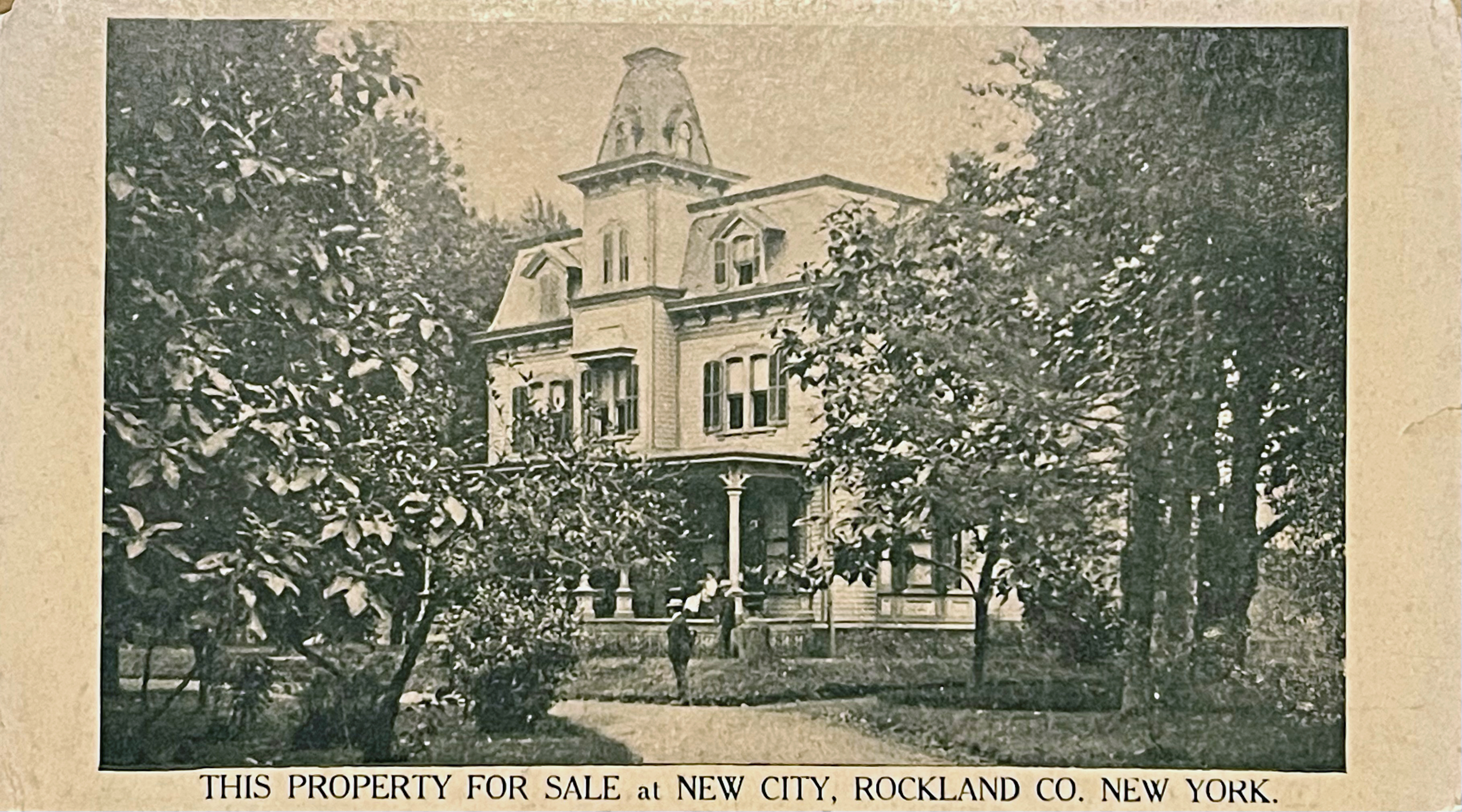
It was a beautiful house with all the modern conveniences, and it was for sale shortly after the death of Julius Stohlmann, a German immigrant in New York who made a nice living for himself and his family, selling religious books to those seeking enlightenment. Click these images to enlarge them.
A Rockland County historian and preservationist forwarded this postcard. The front has a nice photo of the opulent establishment in New City, Rockland County, New York. How does it fit into our history?
“Citation: Digital image of a postcard, front and reverse, "Estate of Julius E. Stohlmann," real estate sale of a home owned by the late Julius Stohlmann, Rockland County Historical Society, New York, issued circa 1910, accessed 8 Sep 2022.
Julius Eduard Stohlmann was born in 1821 in Kleinbremen, Nordrhein-Westfalen, Kreis Minden-Lübbecke. His parents were Friedrich Christian Stohlmann and Auguste Mariane Gritznerin. At least two Stohlmann brothers, Julius and his older brother Charles (Carl F.E.) Stohlmann, emigrated to the USA in 1834. Charles was a Lutheran pastor at the Brooklyn St. Matthew's church on Walker Street. Julius was a publisher of German religious books.
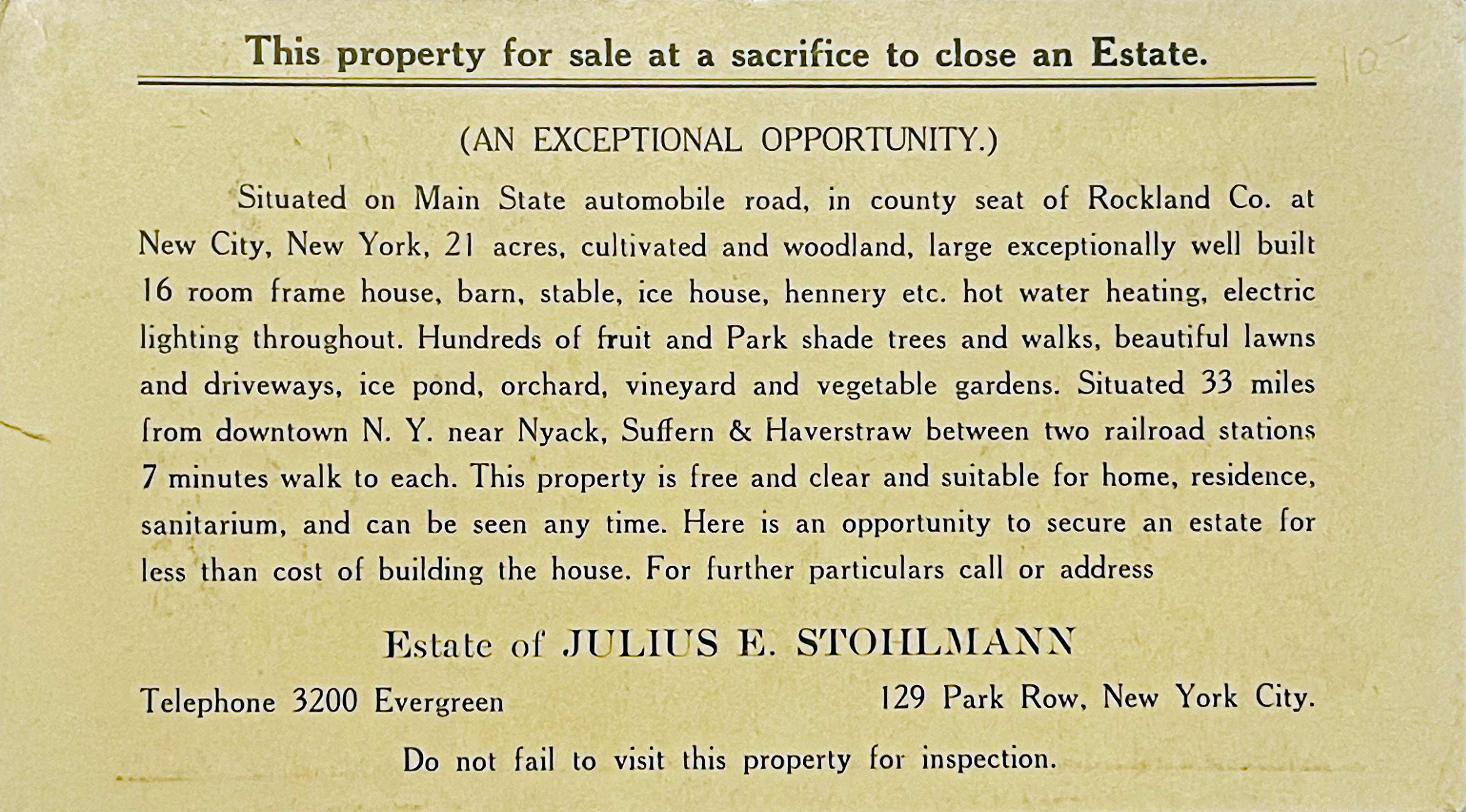
Julius' wife was Louisa Laurent, who emigrated to America in 1847. Louisa's sister, Caroline Laurent, was already in Brooklyn, the wife of pastor Ludwig Müller. Ludwig's and Caroline's first child, Helene, was born in Brooklyn and was baptized by Rev. Charles Stohlmann at St. Matthew's, and this was likely the avenue for an introduction between Louisa and Julius. They were married in New York in 1853 and had eight children together.
Louisa, Julius, and their family remained in New York while Louisa's sister Caroline Müller and her husband Ludwig established themselves in Charleston, South Carolina, where Ludwig was a pastor at the southern location of St. Matthew's German Lutheran Church for fifty years. Julius Stohlmann died in 1910, Louisa in 1915. Their magnificent house exists only in history.
September 8, 2022 | Email your comment.
Who is Albertine?
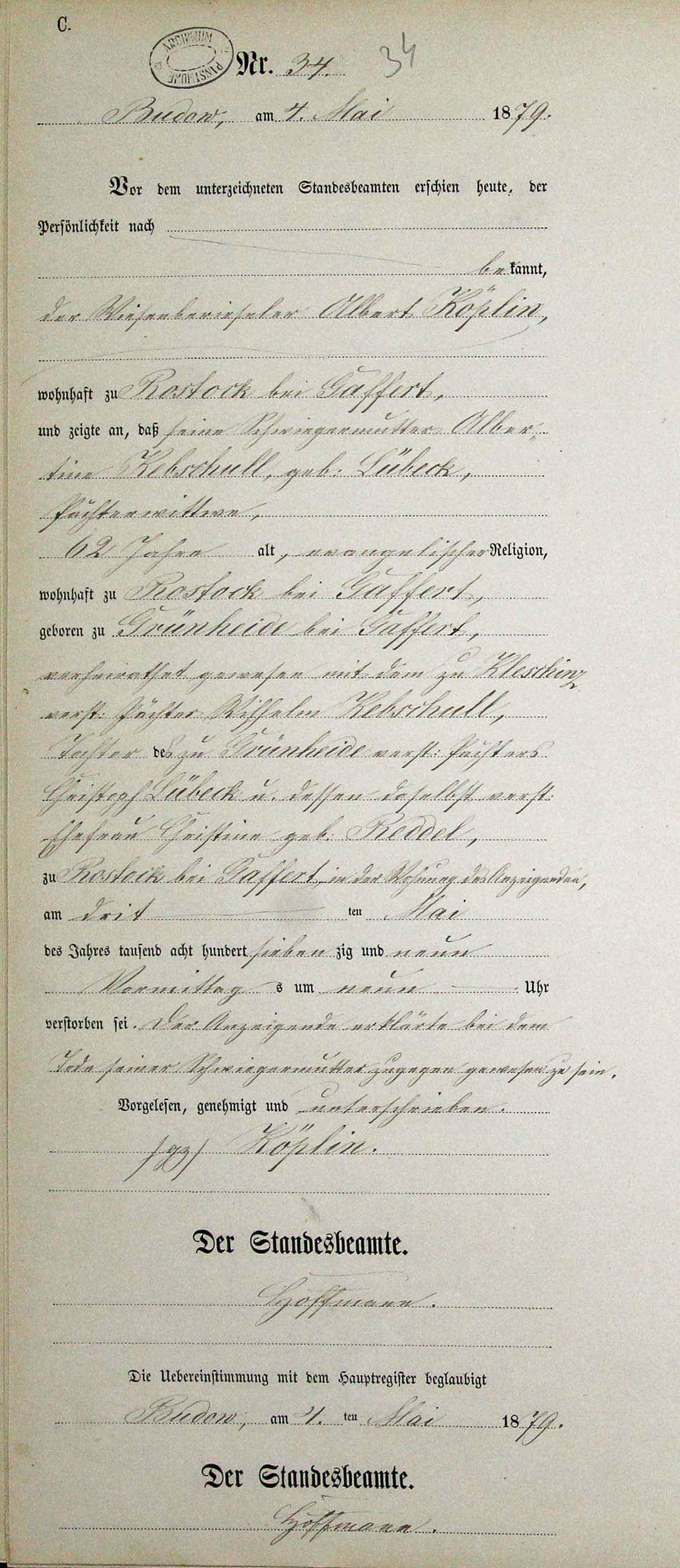
A group of us who research in the Kreis Stolp area have been building a family tree for the children of Christoph Lübeck and Christina Reddel. From a start with three daughters we now have nine verified offspring of this couple.
One of the puzzles of this family is a death record from 1879 detailing the death of an Albertine Kebschull, widow of William Friedrich Kebschull -- click the image at right to see an enlargement.
The details of the record verify that she was the daughter of Christoph and Christina, born in Rostock near Gaffert, and the informant was (as we know) Albert Köplin, her son-in-law.
But why is she called Albertine? We know that she was born in 1817 (her age at her death agrees with this), and the only daughter born to Christoph and Christina in that year was Ludowike. We know Ludowike's history very well. She had two children before her marriage to Wilhelm Kebschull and five children after that. Albert Köplin was married to her daughter Hulda. Ludowike appears in numerous baptism records for her siblings and relatives in the area, always as Ludowike Lübeck or Ludowike Kebschull -- never as Albertine.
So what's the deal? Was her middle name Albertine? We don't have her baptism record from 1817. They're missing from the archive and will likely never be found.
Did she change her name at one point? That was unlikely. People didn't tend to change their names in this region at this time and there was no legal document trail to chart such a change.
“Citation: Büdow Parish (Budowo, Słupsku), "Arckiwum Panstwowe, Słupsku, Budowo Parafia" Deaths, 1879, Sterbe- Neben-Register im Jahr 1879, GenBaza/AP_Słupsk-27/Budowo_276-Budow/0018_1879_zg/_27_0276_0_18_0018.jpg image 19 death number 34, Albertine Kebschull, 4 May 1879; imaged in Metryki Genbaza PL, database and digital images, (https://metryki.genbaza.pl/genbaza,detail,365453,19: accessed 29 Aug 2022).
Was it a mistake by the parish priest or clerk? Oddly, that's the most likely explanation. Every other piece of evidence identifies this lady as Ludowike Lübeck Kebschull, widow of Wilhelm Kebschull and mother of many. Maybe the clerk heard the name of the informant, Albert, and assumed the name of the deceased was Albertine.
There are times when the document itself can be trusted up to a point. But mistaken entries by the man generating the document must be considered when nothing else makes sense. And in the case of this particular death, we have to assume that Ludowike is the correct name of the deceased.
August 29, 2022 | Email your comment.
Gohr-Lübeck: First child

Johanne Ludewika Henriette Gohr didn't have a long life, just a year as a matter of fact. But she was the first child of Wilhelm Heinrich Gohr of Nippoglense and his wife Emilie Lübeck, born in the town of Nakel in 1838 and registered in the parish of Gross Nossin. Her birth record includes a number of clues about her family and it's worth perusing those clues to see what we can discover. Click the images at left and below right to see the records in detail.
These records from Gross Nossin are found in an online database housed in what is now Poland, the Archiwum Państwowe w Szczecinie. Not everything can be found in Ancestry.com, although their collection of Eastern Prussian Provinces German records, such as these from the former region of Pomerania, is growing.
“Citation: Digital reproduction of an online civil registry, page 0083 and 0084, Archiwum Państwowe w Szczecinie, Gross Nossin [Nożyno, pow. sł.] 1840-1850 und 1832 bis 1844, https://www.szczecin.ap.gov.pl/, accessed August 20, 2022.
What does this record tell us? First, ponder what we're missing. Wilhelm Heinrich Gohr, the father, doesn't show up in these records until this one in 1838. We don't know who his parents were, what year he was born, or when and where he was married to Emilie Lübeck. This child being the first to show up in the records for this era, and the fact that she's the legitimate offspring of Wilhelm and Emilie, we can assume they were married within a year or two of 1838 when this child was born, but that's as much as we're likely to know. The note in the database tells us "Die Kirchenbücher bis 1831 sind verbrannt" -- The church books up to 1831 have been burned. Not deliberately, of course, but an unfortunate accident.

We're more fortunate with records for the mother, Emilie Lübeck. We have her 1890 death record so we know that her parents were Christoff Lübeck and Christina Reddel. Due to some diligent research with some cousins also investigating this region, we know that Emilie had five sisters and two brothers, many of whom show up as godparents to the children born to this couple.
For instance, in this case Emilie's unmarried sister Ludowike Lübeck is one of the Taufpaten or godparents. So is a man called Carl Gohr -- a brother or other relative of the father? We have yet to figure out who is Henriette Koschnick, married to a fellow called Bedenke, but this is likely a close relative as well.
In each case when we run across a baptism record like this we're likely to find peripheral clues. Almost every birth in this region has two or three godparents and they're almost always related to the parents in some way. Through those connections we can build a case for relationships: prove the existence of a parent still alive, a brother or sister in the region, or even how many children the parents have already had. Notations such as "3rd daughter of 6 daughters" left helpfully by the parish clerk or priest is an example of this -- we know we're missing family members and we can start looking for them.
It's all part of a puzzle, and if you like genealogical puzzles, this database is the place to be.
August 20, 2022 | Email your comment.
160 years young
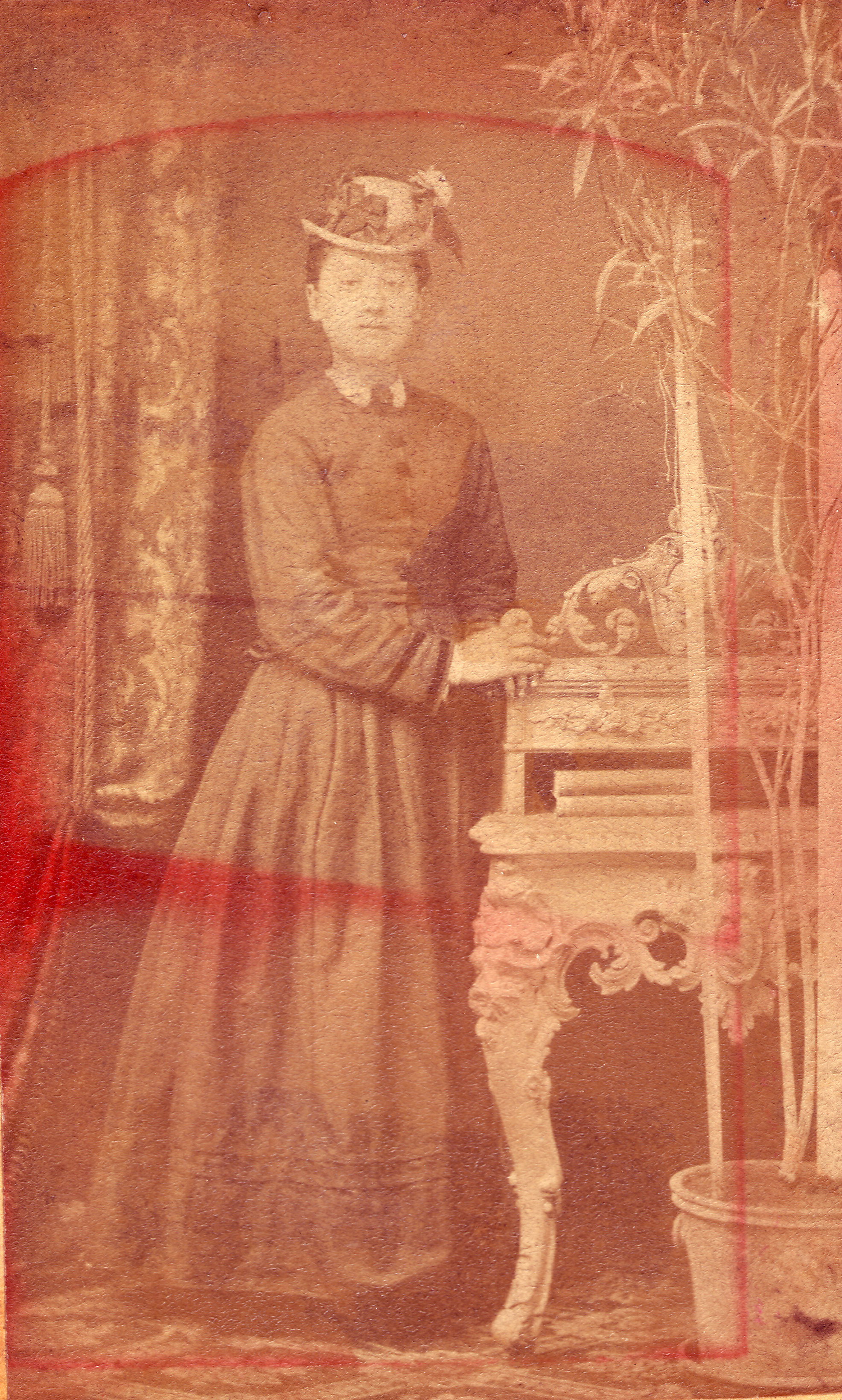
She hardly looks a day past fourteen!
And that's true because Catharina Maria Petersen was about fourteen years old here. She was born August 10, 1862 in Leckfeld, a suburb of the town of Leck, in northern Schleswig-Holstein.
When she was born her town still belonged to Denmark, although by 1920 it was German territory. Catharina was long gone by then but she retained the dual identity of her homeland, speaking German when she wanted to be discrete and speaking Danish when she wanted to be even more private.
“Citation: Digital reproduction of a photograph, reverse and front side, collection of Catherine Meyer, Catharina Maria Petersen, ca. 1876, H.P. Petersen studio, Niebüll, Schleswig-Holstein; original copy scanned in August 2005 by D.L. MacLaughlan Dumes, great-granddaughter of the portrait subject.
It was common in those days to have a commemorative portrait done of the confirmation subject, almost always in a studio because home cameras didn't really exist yet. Because of the long exposure necessary the subject couldn't smile or risk any movement, which would blur the product. So Catharina, second daughter of Peter Hansen Petersen and Elise Momsen Petersen, had to keep perfectly still for the phootgrapher.
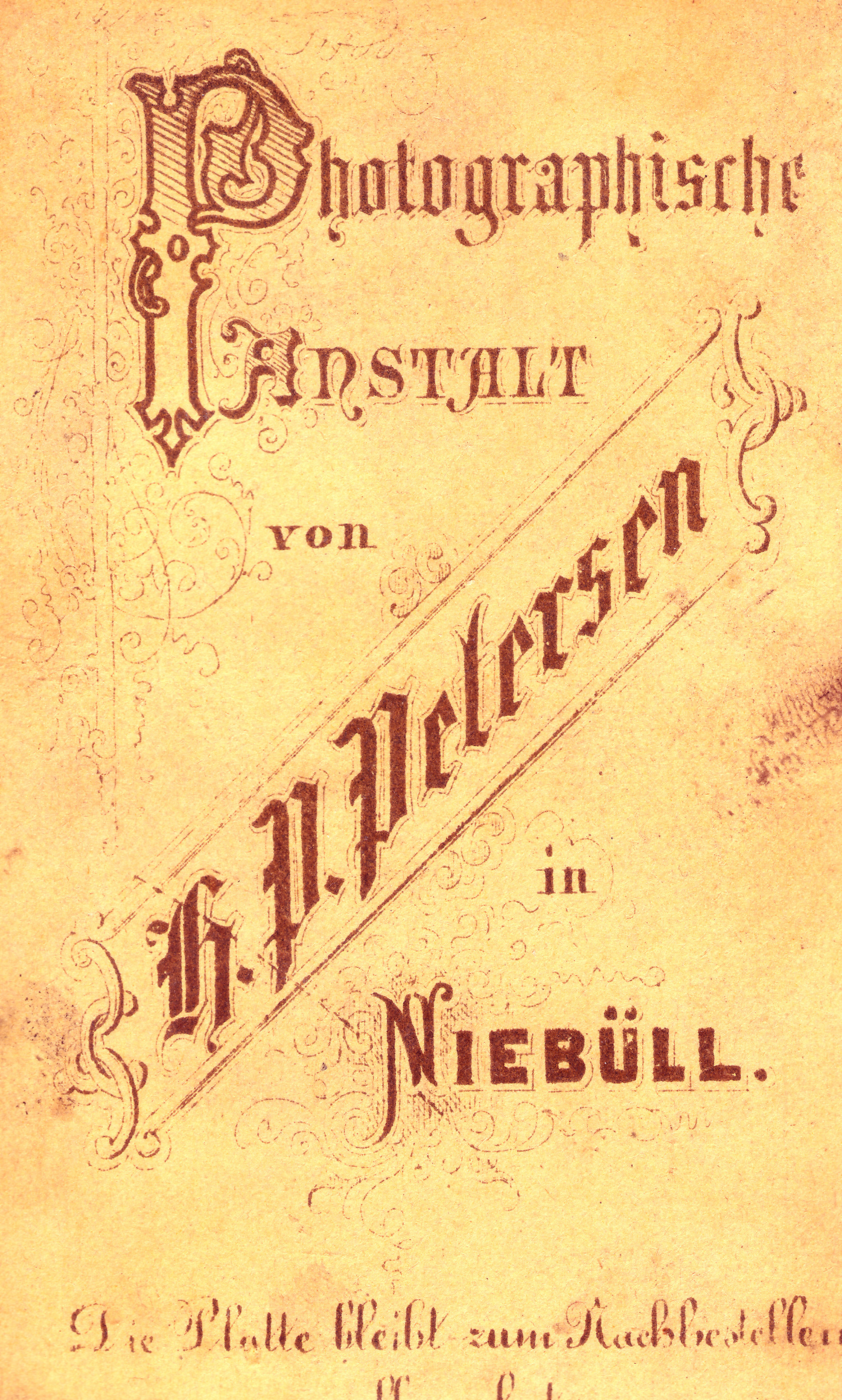
This portrait studio was located in Niebüll, a town close to Leck. You can find out more about the H.P. Petersen studio here. Was the photographer a relative of the family? Not necessarily. Petersen was one of the most common surnames in Schleswig, so the best answer is...could be, or maybe not.
The reverse of the image shows the identity of the studio. Catharina trimmed the cabinet card at some point to fit it into a frame so the bottom inscription is missing. In full it says "Die Platte bleibt zum Nechsbestellen aufbewahrt" or "The record is kept for future orders." A nice business practice! In this case, though, the family brought the photo with them to Nebraska when they emigrated in 1878.
It's remarkable that the photos lasted this long, but cabinet cards were fairly robust. We're particularly lucky to have a scan of this one to mark a rite of passage in the life of a young lady who brought her collection with her to Nebraska and later to Chicago, where her photos reside today.
August 10, 2022 | Email your comment.
An 1857 marriage...and an answer to a riddle
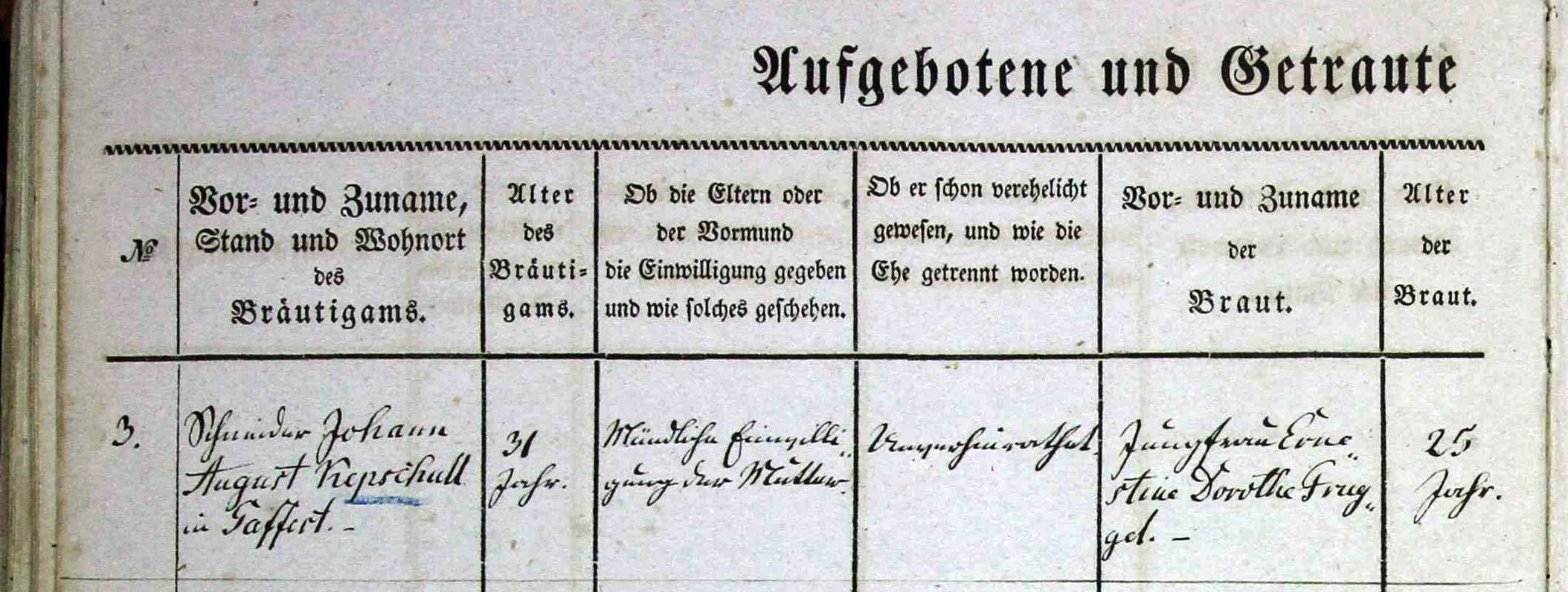
If it seems as though I'm obsessed lately with records from Genbaza, the repository for Pomeranian records, it's true. A happy conflagration of free time and free availability of these records has made some aspects of our ancestry in Kreis Büdow and Kreis Stolp explosive. We're finding out all kinds of connections to the past.
If you want to see the whole page, click the image above.
“Citation: Büdow Parish (Budowo, Słupsku), "Arckiwum Panstwowe, Słupsku, Budowo Parafia" Małżeństw [Marriages], 1857, Aufgebotene und Getraute im Jahr 1857, image 39 marriage number 3, Johann August Kebschull and Ernestine Dorothea Fruggel, 23 Jan 1857; imaged in Metryki Genbaza PL, database and digital images, (https://metryki.genbaza.pl/genbaza,detail,480244,39: accessed 27 July 2022).
The principle reason for this flurry of research: my autosomal DNA test matched with a couple of people called Kebschull. This is a surname otherwise unknown in our family, although there are a plethora of Kebschulls in the Kreis Stolp region where our Gohr, Kramp, Lübeck, and Trabant ancestors lived. It seems logical that there would be a connection through a marriage of something similar.
Naturally the DNA match folks don't answer messages at Ancestry.com (a curious situation but one that's very common) so the only way forward to solve the riddle is to plunge into researching the local records via Genbaza. It requires a fair amount of resolve. A working knowledge of genealogical German is necessary. Familiarity with as bit of Polish (the database now resides in Poland) is helpful. So what do we find?
Working back from some American Kebschulls was a starting point but it appeared to be a dead end, resulting in a path back to a Carl Kebschull and Friederike Lübecke...enticing but no direct connection to our Lübeck family in Röstock near Gaffert. However, there does seem to be a connection to Christoph Lübeck and his wife Christina Reddel, who are the earliest ancestral line that we know of in this region.
Their daughter Emilie Louise Lübeck, born in 1814, married Wilhelm Heinrich Gohr in 1853. Emilie had two sisters, Ernestine (born 1801) and Juliane (born 1822). There were probably more siblings too, but we don't know about them yet.
Ernestine married a Christian Friedrich Fruggel around 1820. One of her daughters, Ernestine Dorothea Fruggel, married Johann August Kebschull in 1857. Their marriage record is at the top of this post. The record doesn't list August's parents' names, alas, but we did find six children born to this couple. It's a good bet that the DNA match comes from the descendants of this Kebschull connection. And it's entirely possible that we'll find some further matches in the near future. Stay tuned!
July 27, 2022 | Email your comment.
Friedrich Kramp, 1824-1878
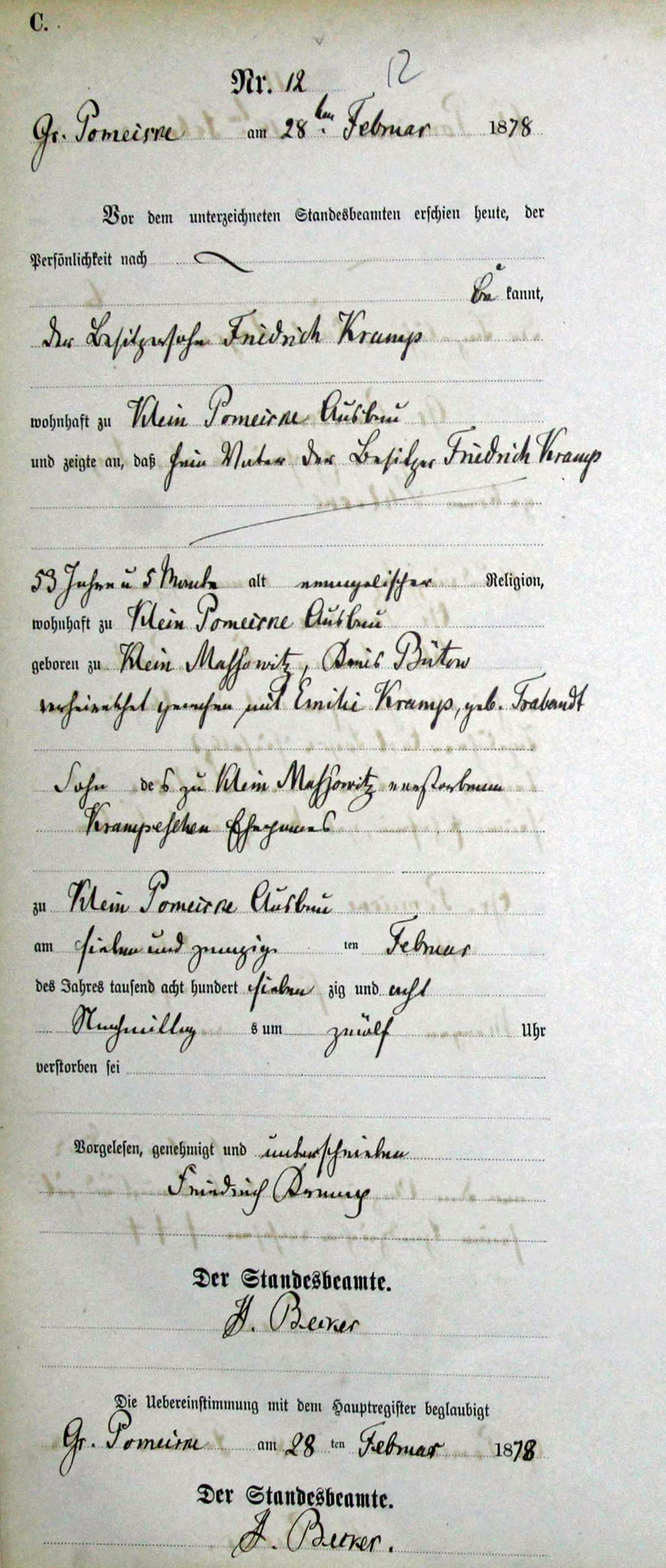
Miroslav Bronakowski has put together a helpful genealogical search index for a variety of parishes and districts in the former region of Pomerania. It's good news for anyone who has ancestors in this region because it will lead to to Genbaza, otherwise known as https://metryki.genbaza.pl/, the database that has preserved vital record registers of the Pomeranian region. Click the image at left to see an enlargement.
Although these parishes are now in current-day Poland they were originally a part of Germany, and the records are in German as well, with mostly wonderfully legible handwriting.
“Citation: Pomeiskie Parish (Klein Pomeiskie, Słupsku), "Arckiwum Panstwowe, Słupsku, Gross Pomeiskie (Pomysk Kielki)" Zgony [Deaths], 1878, Pomysk Wielki/Pomeiskie, image 8, Friedrich Kramp, 28 Feb 1878; imaged in Metryki Genbaza PL, database and digital images, (https://metryki.genbaza.pl/genbaza,detail,61293,8 : accessed 20 July 2022).
The index result will summarize the person you're searching for: name, spouse if relevant, birthplace and residence if known, age, and scan category. It also references the page number in the registry book so you can find it accurately.
In this case, we've found the death record for Friedrich Kramp, husband of Emilie Pauline Trabant and father of at least ten children in and around Klein Massowitz and Klein Pomeiske. This record helps us determine his accurate birth date (28 September 1824), though not his parents' names, alas. Because of missing years in the records we may never know their names.
We already have his widow's death record from this same database (1887), so Genbaza is helping us fill in the details of the Kramp family who remained in Pomerania and didn't emigrate to America. So far we know that two older daughters, Auguste and Laurette, came to Chicago via Baltimore in 1881. Are there any others? We may yet discover them!
July 20, 2022 | Email your comment.
Lawrence Petersen, 1915-1928
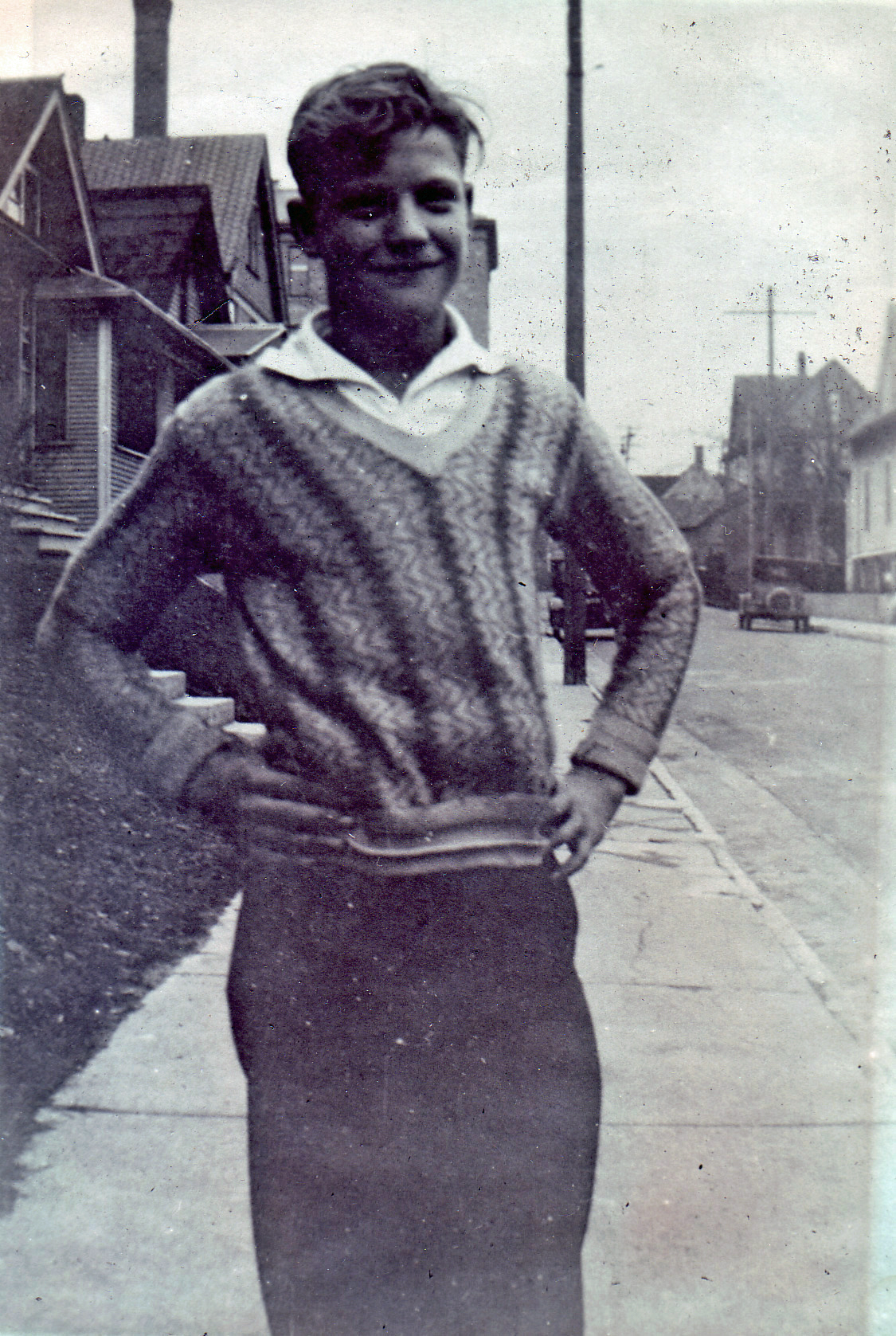
It was a short life, and until today I didn't know why.
Lawrence Petersen was born in Chicago a year before his father's death. Peter Heinrich Petersen was married to Martha Krohn in Chicago, where they had six children. Peter and Martha seemed to have been very close to Peter's mother, Catherine Petersen Mikkelsen, because even after the widowed Martha moved to Milwaukee, where her sister lived, Catherine traveled to see them regularly. Catherine's photo collection is a big clue here. She collected photos of the family growing up over the years, and they sent her regular updates about how they were progressing. At left is Lawrence, about 1928, likely taken in his neighborhood on Odell Street in Milwaukee.
“Citation: "Wisconsin, Milwaukee, Pilgrim's Rest Cemetery, Interment Records, 1880-1979," database, FamilySearch (https://familysearch.org/ark:/61903/1:2:WMMF-R2PZ : 9 July 2022), entry for Lawrence Petersen, 1928.
Lawrence, the eldest son, was named after Peter Peteren's great-grandfather, Lorenz Petersen. Lorenz, his wife Magretta, and son Hans emigrated to Nebraska in 1872 and established a prosperous farm there. Lorenz and Hans eventually moved to Chicago, where Lorenz died in 1891. His memory was still fresh in his grandson's mind when Lawrence was born in 1915. Alas, Peter died a year later of nephritis, and Martha Krohn Petersen was left with five children to bring up, with another son on the way.
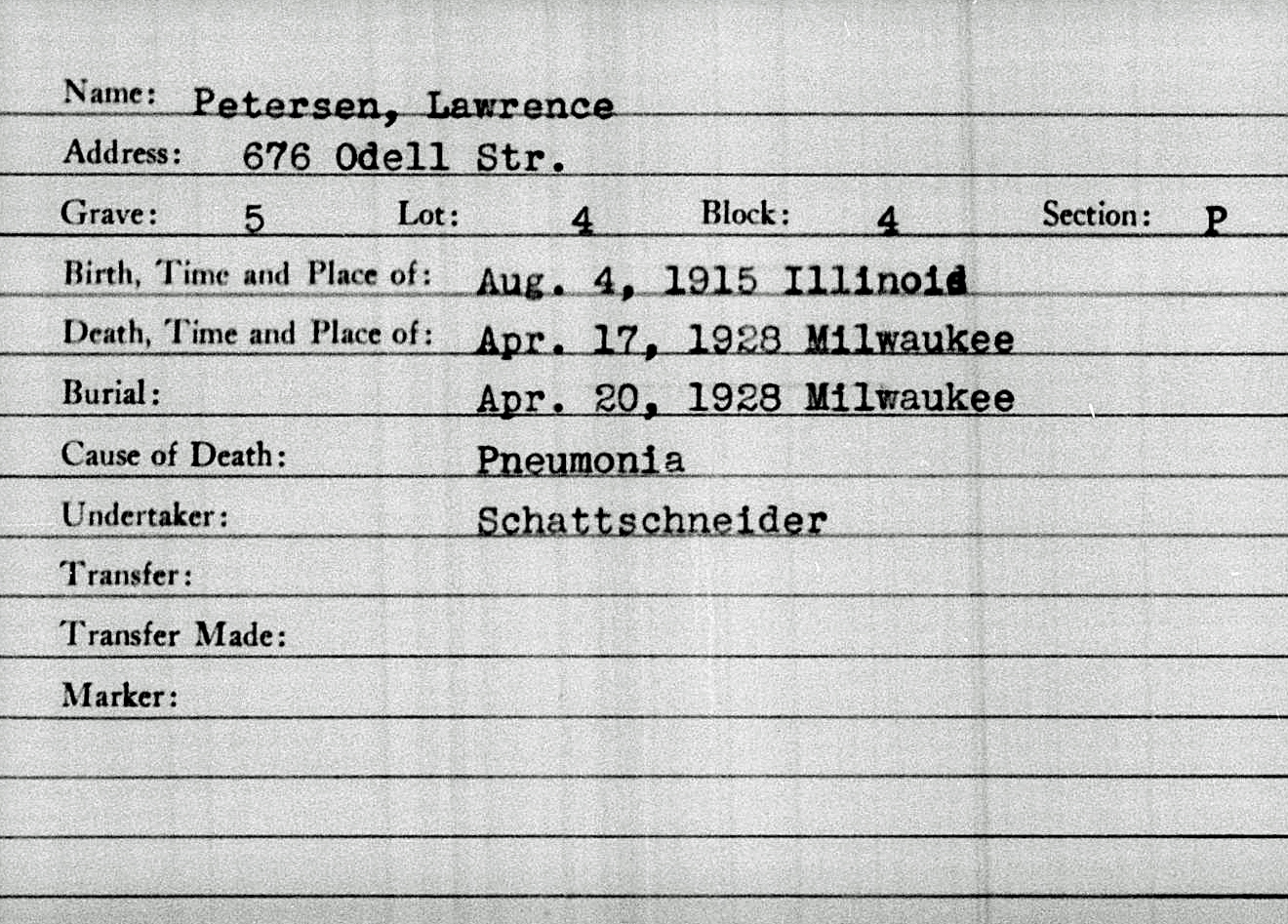
I wish we knew more about Lawrence, who succumbed to pneumonia in 1928. He's buried in the same cemetery, Pilgrim's Rest, in Milwaukee where his grandfather Hans is buried, with a curiously ephemeral grave marker. Perhaps one of his surviving siblings or his siblings' decendants put it there as a temporary memorial.
July 9, 2022 | Email your comment.
More from Genbaza

From what I understand we very nearly lost access to this invaluable database. It was due to shut down a few months ago due to the increased cost and effort necessary to keep it online. But it was rescued by a group of volunteers and moved to a new server, where its records remain online and accessible to all.
You can read the original entry here or you can click the image at right to see the enlargement.
In the parish of Pomeiskie, one Richard Kramp reported the death of his widowed mother, Emilie Trabant Kramp, on December 31, 1887. As with so many of these records, earlier entries are lost, so we particularly cherish the wealth of information in this entry.
A brief digression for orientation, as needed: Richard Kramp was one of at least eight children of Friedrich Kramp, who died before this entry was recorded, and Emilie Pauline Trabant. Richard's sister, Laurette (Laura) Kramp, my great-grandmother, emigrated to the United States in 1881 with her older sister Augusta Kramp Hasse, who both settled in Chicago where Augusta's husband Carl Hasse and Laura's fiancé Wilhelm Gohr had emigrated earlier that year.
“Citation: Pomeiskie Parish (Klein Pomeiskie, Słupsku), "Arckiwum Panstwowe, Słupsku, Gross Pomeiskie (Pomysk Kielki)" Zgony [Deaths], 1887, Klein Pomeiskie, image 37, Emilie Trabant Kramp, 31 Dec 1887; imaged in Metryki Genbaza PL, database and digital images, (https://metryki.genbaza.pl/genbaza,detail,463842,37 : accessed 18 June 2022).
The record states that Emilie was born in Massowitz but lived in the outskirts of Klein Pomsiskie at the time of her death. Helpfully, we're give her exact age: 51 years, three months, two days. Using an online birthdate calculator this gives her exact birthdate: September 29, 1936. This fits nicely with her age at the time of her marriage in 1853, a document that we do have, fortunately.
Her late husband was Friedrich Kramp, and she was the daughter of Carl Trabant and his wife, Henriette Knuth. Richard even signed the bottom of the document to verify his presence as informant; note that his handwriting is different from the parish clerk's hand.
This is another record that we're lucky to have!
June 19, 2022 | Email your comment.
Diving into the archives
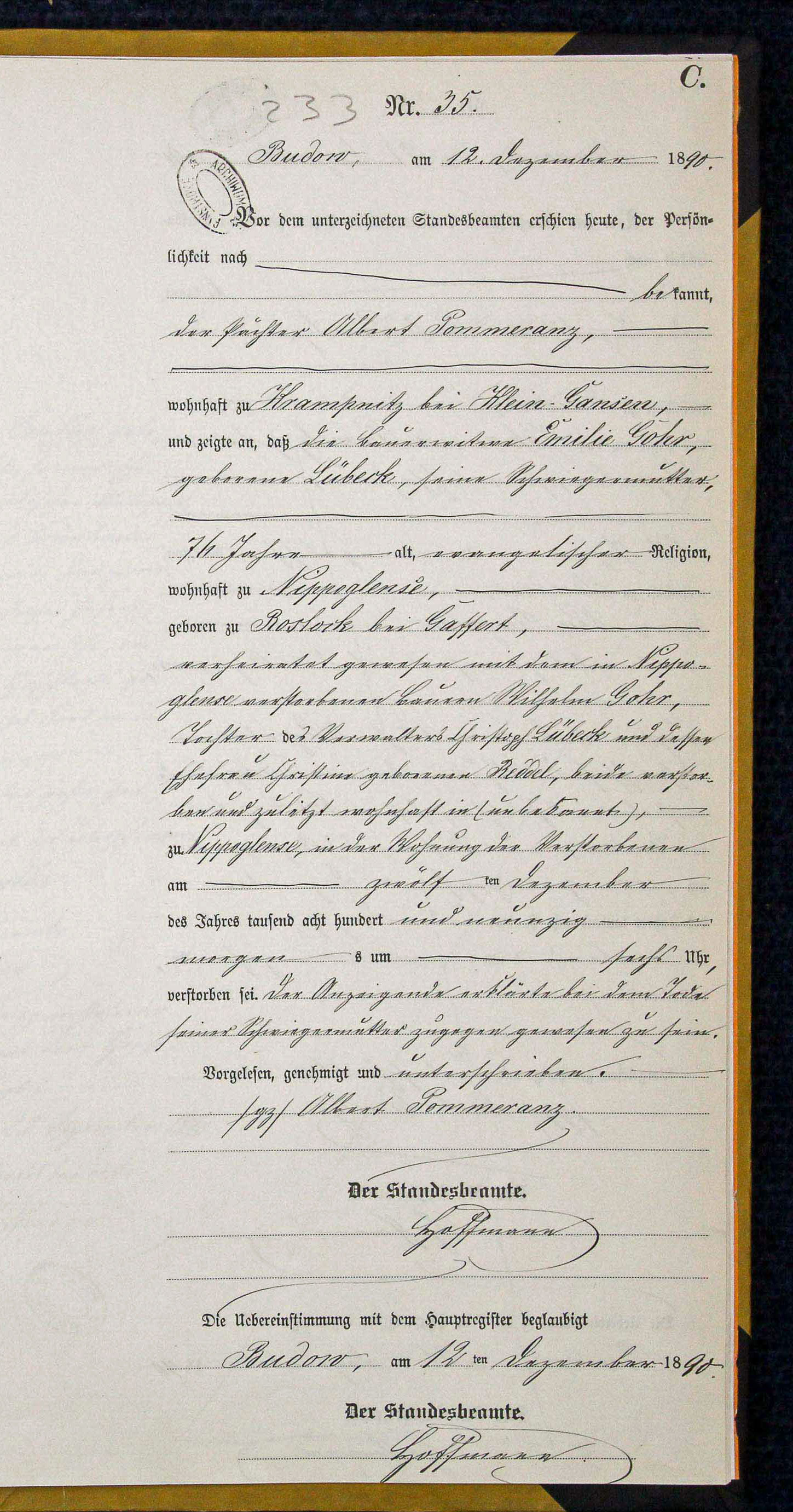
Some very intrepid folks have assembled a free website including records from what was once Pomerania but is now Poland. If you have ancestors from the Kreis Stolp region of northern Germany, this is the database for you.
This death record has a plethora of information for us because our ancestors from this region were influenced by Polish as well as German administration, although the records themselves are in German.
First some orientation: the informant was Albert Pommeranz, the son-in-law of Emilie Louise Lübeck Gohr. Emilie was married to Wilhelm Heinrich Gohr, a farmer in Nippoglense, Kreis Stolp, and was the mother of Albert's wife Hulda Alwine Blandina Gohr. Emilie was also the mother of Hulda's brother Wilhelm Robert Otto Gohr (born in 1857), who emigrated to Chicago via Baltimore in 1881 and married fellow immigrant Laurette (Laura) Kramp in one of the German/Polish churches in Chicago.
“Citation: Büdow Parish (Nippoglense, Kreis Büdow), "Arckiwum Panstwowe, Słupsku, Gress Pomeiskie (Pomysk Kielki)" Zgony [Deaths], 1890, Nippoglense, image 37, Emilie Lübeck Gohr, 12 Dec 1890; imaged in Metryki Genbaza PL, database and digital images, (https://metryki.genbaza.pl/genbaza,detail,463842,37 : accessed 04 June 2022).
Emilie, born in September 1814, died on December 12, 1890. You can see the full-sized record itself at this link. You can also click the image above left to see an enlargement.
The record says that Emilie was born in Rostock near Gaffert, a village so small that today it no longer exists. It also lists her parents: the administrator or manager (probably of a local farm) Christoph Lübeck and his wife Christina Reddel. This is very helpful information! Church and civil records for this area of what's now Poland are few and far between dues to archives being destroyed, abandoned, or lost, so the more details we can read on these records the better off we are.
Unfortunately we'll likely never find Emilie's marriage record to Wilhelm Gohr, and certainly not her birth or baptism record. The existing records from Büdow, where Nippoglense was located, start in 1874 and end in 1919. So our best efforts will include looking at death record like this one that may mention the deceased's parents' names and a little bit about occupations where available.
June 4, 2022 | Email your comment.
More Gohrs
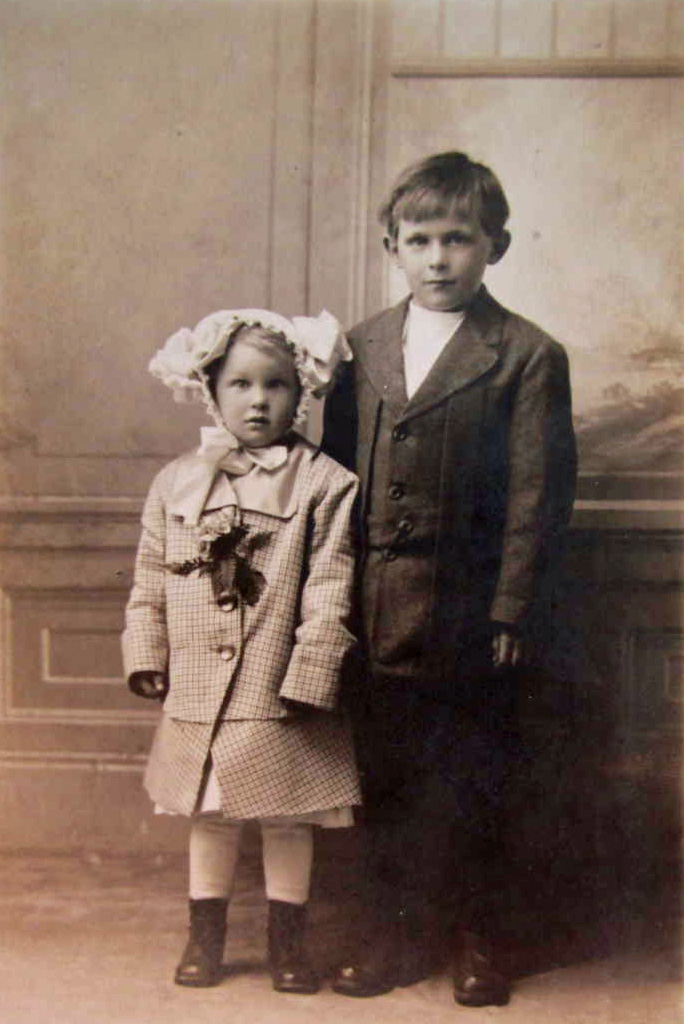
Another fortunate circumstance! Albert Gohr and his wife Franciska (Frances) had children in Chicago, and we're fortunate that one of their descendants uploaded a photo of two of them.
In fact, this helps us fill in the family line. Albert was born in 1907, Valeira in 1910. We can confirm this by looking up Cook County birth records for the children, but someone called D. Godfrey has already uploaded some family information to his Ancestry.com tree.
Generally it's not sufficient to cite non-official documentation in genealogical research, but as long as you back it up with other corroborating evidence, you've got some good clues at your fingertips.
“Citation: “Public Member Trees,” database, Ancestry.com (https://www.ancestry.com/ : accessed 24 May 2022), Godfrey/McNeilly family tree by D. Godfrey, profile for Alfred Richard Gohr Krause (1907-1974, d. Elgin, Kane, Illinois), documented data.
It's curious that Alfred's surname is listed as "Krause" in this family tree, which was never part of his name according to official documents (census, military, vital records, etc.) Apparently his mother Frances was remarried after her husband's death to a man called Krause. Perhaps the family thought that Alfred took on his mother's new surname. That doesn't appear to be correct from available evidence.
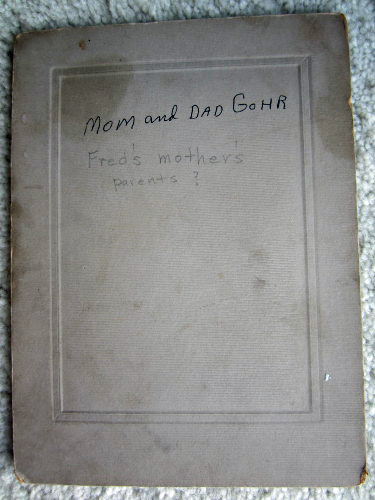
What about Albert's sister Valeira? She married a Fred Ledebuhr on April 29, 1931, so there's the answer to that question in our previous post. In fact, we can correct it. Fred's mother would have been called Ledebuhr, not Gohr. So the identification on the reverse side of the Gohr wedding photo in the previous post should have read "Valeira's parents."
Valeira and Fred Ledebuhr moved to California at some point where she died in 1983 in the city of Garden Grove.
May 24, 2022 | Email your comment.
A plethora of Albert Gohrs
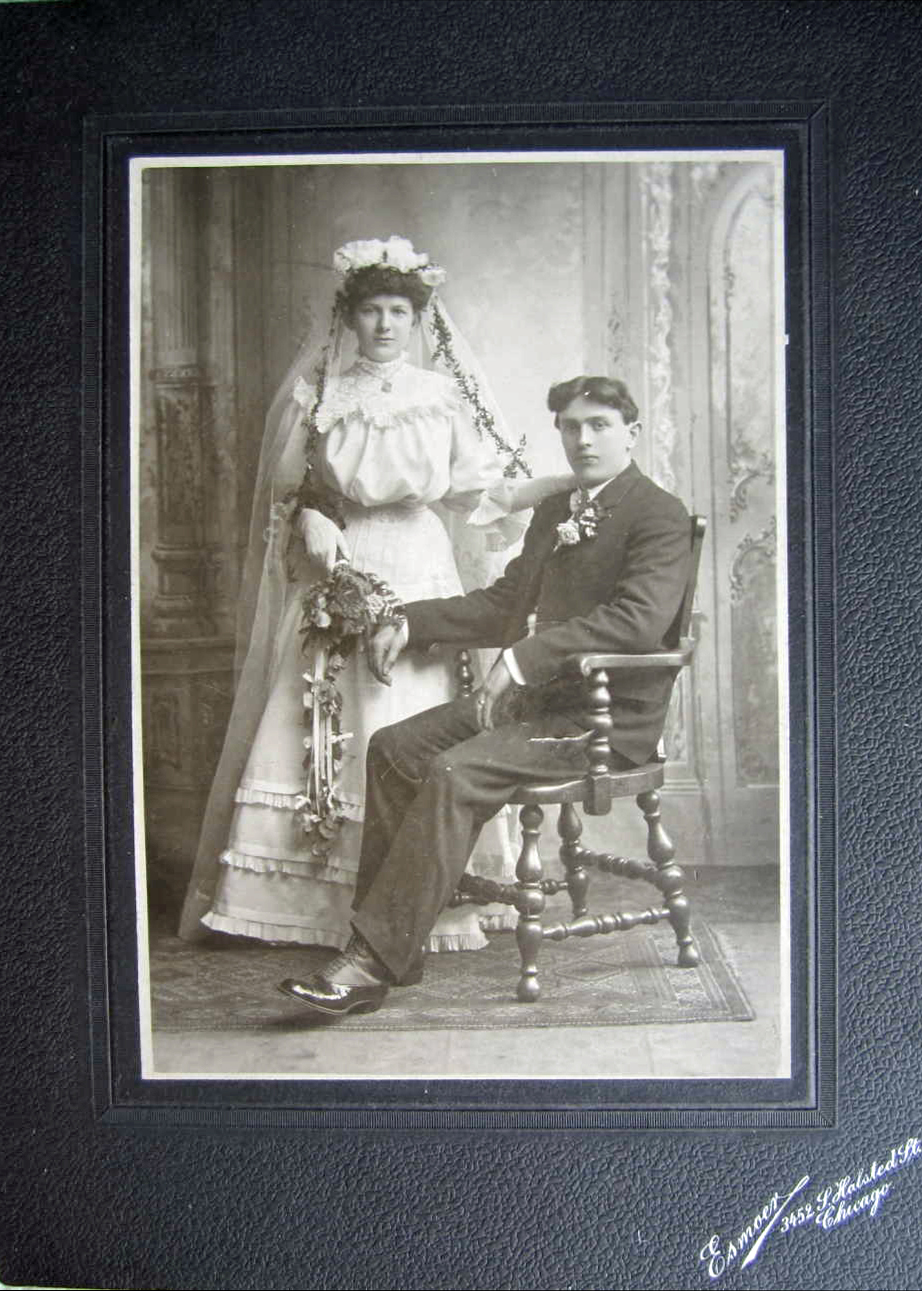
Of course we only want one. And for a long time he was difficult to connect to our family.
We know that our great-grandfather Wilhelm Otto Robert Gohr had an older brother, born in 1844 as Albert Julius Reinhold Gohr, according to the Kreis Büdow church books in what was then Pomerania. At least eleven children were born to Wilhelm Heinrich Gohr and Emilie Lübeck, Albert being the fourth child born to the couple, Wilhelm Otto Robert the eleventh. The photo at left shows one of Albert's sons, Paul Conrad F. Gohr, born in 1882 in Chicago, at his marriage to Franciska (Frances) Ida Schmude in 1906.
It looked likely that Albert (who emigrated in 1872) and Wilhelm (who emigrated in 1881) were likely related. Both ended up in Chicago, and both lived in apartments next to each other on South Wood Street (3832 and 3830, respectively.)
“Citation: U.S. City Directory of Chicago, Illinois, 1888, p. 663, image 337; digital image, Ancestrylibrary.com (https://www.ancestrylibrary.com/: accessed 12 May 2022).
But until an autosomal DNA test provided a "cousin" link with an individual descended from Albert, we didn't have absolute proof that Albert and Wilhelm were brothers. We do now! Albert married a Wilhelmina Pauline Mews (or Maos, Moes, Mavs, Mewes, or Meves as it's spelled in a variety of Cook County documents). Albert himself played around with his age, showing up with an 1844 birth year in some Chicago documents, 1854 in others. This didn't make it any easier to pin him down. There were other Albert Gohrs in Chicago too, at least three. So sifting through clues was essential to verify which one was our Albert.
So far as I know none of the other eleven siblings emigrated to the United States, although it's possible that some connection will turn up in the future. As it is, it's nice to have a photo of Paul and Frances Gohr, supplied by an H.R. Ledebuhr and labelled on the reverse "Mom and Dad Gohr Fred's mother's parents?" (we'll have to look up Fred's mother now). We have no photos of Wilhelm or his wife Laura, both of whom died in Chicago before 1906. So this image is as close as we'll get to our earliest Gohr family.
May 12, 2022 | Email your comment.
The Luther Beene mystery
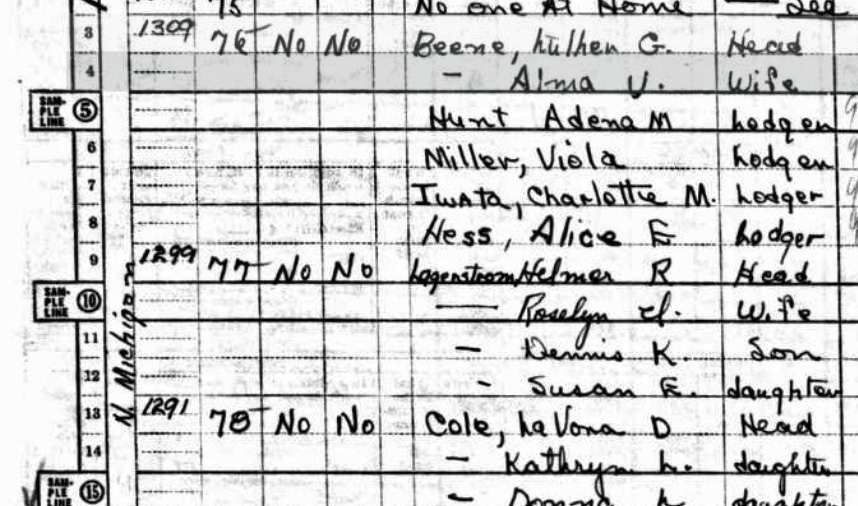
According to Alva Elwood MacLaughlan's voter registration information in 1950 he lived at 1309 N. Michigan Avenue in Pasadena, California. But according to the 1950 census, he did not.
Instead, the head of household was Luther G. Beene and his wife Alma. They had several lodgers but none of them was named MacLaughlan.
To make things more complicated, Luther Beene, who was born in Texas in 1883, had been in the Los Angeles area since the 1920s. He lived at various addresses in Southern California, including the location given in his 1948 voter registration: 816 E. Washington Avenue in El Monte. But wonder of wonders: Alva had also lived at 816 E. Washington, El Monte in the very same year.
“Citation: 1950 U.S. census, Los Angeles County, California, population schedule, Pasadena, enumeration district (ED) 68-45, sheet 7, serial number of dwelling unit 76, Luther G. Beene; database with images, National Archives and Records Administration (https://1950census.archives.gov/: accessed 30 April 2022) via Ancestrylibrary.com.
This is a curious situation. Knowing Alva's propensity to live at multiple addresses when he lived in Chicago, and knowing that he didn't change this habit after moving to the Los Angeles area, all I could imagine, at first, was that Luther Beene was a pseudonym for Alva MacLaughlan.
But no, Luther Garrett Beene was a real person married to Alma Viola Patterson, also from Texas. So did he and Alva know each other? Or was it just a coincidence that they happened to live in the same multi-residential building in the Pasadena area?
Census records and voter registrations can't answer that question. I can't find any evidence of Luther and Alma in Alva's family orbit, no photos or references connecting the two of them. But it's a very odd circumstance, and particularly aggravating when Alva is missing not only in the 1950 census but in the 1940 census too, when he still lived in Chicago.
Maybe some folks weren't meant to be found. Alva was certainly one of those elusive fellow.
May 1, 2022 | Email your comment.
A winsome foursome
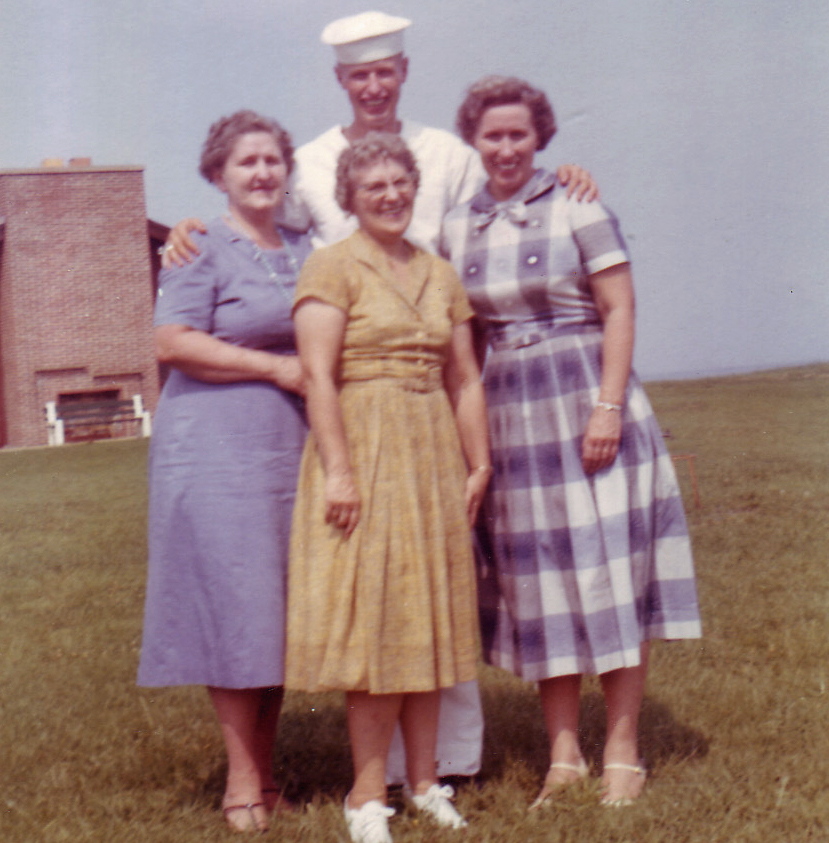
This was the only photo in my mother's collection of a fellow we couldn't identify for the longest time. It was labelled (thankfully!) but merely said "Dorothy, Ted, Mildred and Jeanette." No location, but we're supposed to know by context that this is near Joliet, Illinois where at least some of these folks lived. Mildred and Jeanette Glawe were regularly in touch with their West Coast relatives throughout their lives and presumably that's where this photo originated.
“Citation: Digital reproduction of a photograph, front side, collection of Lorraine Bruns MacLaughlan, Dorothy Maynard and her son Ted with her sisters Jeanette and Mildred Glawe, ca. 1962, Joliet, Illinois; original copy scanned in April 2018.
With the 1950 census so newly available I decided to try a search at the NARA archives. Glawe is a reasonably unusual name, short enough for the AI machine indexing to digest without too much confusion. And it worked: up popped John W. Glawe, his wife Anna [Gohr] Glawe, their two middle-aged unmarried daughters Jeanette and Mildred...and a grandson!
No sign of the other daughter, Dorothy, in this entry, but because Jeanette and Mildred never married, we have to assume that Theodore Zelies is the son of their missing daughter, who had married in 1949 a fellow called Andrew B. Maynard in Michigan.
Jeanette and Mildred were referred to often in the family but not Dorothy or her son Ted, who was clearly a Navy man based on his dress whites in this snapshot. Perhaps Dorothy and her new husband were busy with their own lives in Sparta, Michigan where they settled, eventually with Dorothy's son Ted, who assumed the name Maynard. We have no clue who Mr. Zelies was or what became of him, but a clue to his actual name remained with his son for a time courtesy of this new census record.
Alas, Ted recently passed on. A brief obituary is now online. It's clear he was very proud of his Navy career. We hope to connect with his family at some point to further honor his memory.
April 17, 2022 | Email your comment.
Missing in action
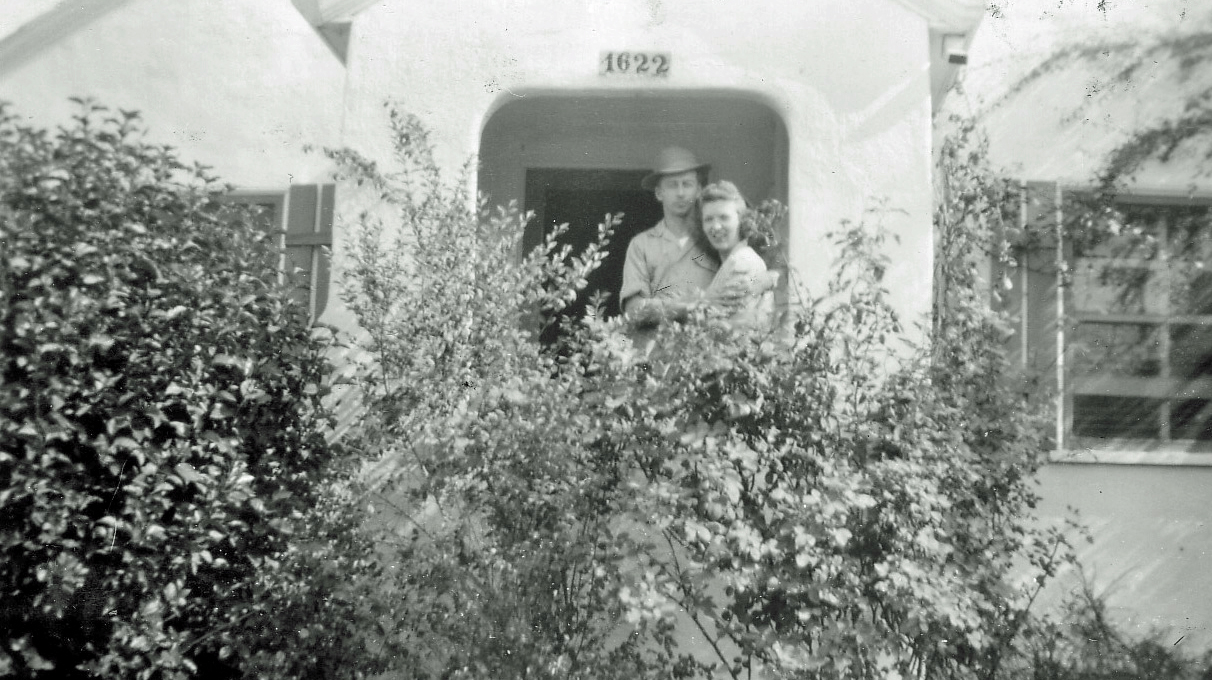
It's not even a week old and the new census is giving me fits.
Tom and Lorraine MacLaughlan were living in their new marital home in the Los Angeles suburb of Rosemead, California, pictured at left. We even have the address, courtesy of a couple of carefully-saved typewritten envelopes from family members in March 1949: 1622 S. Brookline Avenue, Rosemead, California. No zip codes back then!
“Citation: Digital reproduction of a photograph, front side, collection of Lorraine Bruns MacLaughlan, Thomas MacLaughlan and Lorraine Bruns MacLaughlan, ca. 1947, Rosemead, California; original copy scanned in April 2018 by D.L. MacLaughlan Dumes.
The house is still standing today in all its Spanish-architectural glory, although the address was changed in the early nineteen-fifties when the streets were renumbered in that neighborhood. It's now 3856 South Brookline, although either address works when you plug it into Ancestry's ED address finder tool online.
Tom, his parents and siblings were never located in the 1940 U.S. federal census in Chicago, where they were then living, so I had high hopes for finding them in the 1950 census, not just because I had the address but because of a hint that Tom's parents, Alva and Marie MacLaughlan, might have been living with them during the 1949-1950 time period.
But no luck! Going through all the images for this enumeration district merely revealed that while the odd-numbered addresses on Brookline Avenue were indeed included in the 1950 census, the even-numbered side was not, or apparently was not. Because this census has not yet been properly indexed by humans, but rather by an artificial intelligence machine indexer, any attempts at searching for the surname MacLaughlan turn up nothing substantive. If the even-numbered houses from the 1620-1630 addresses have been included in the 1950 census somwehere, they must be in hiding.
A look through surrounding ED pages also turns up nothing related to that address. We'll have to wait for summer 2022 (when it's rumored that a more accurate search feature will be available) to see whether we can find Tom and Lorraine and/or his parents. Otherwise they may get the award for the most elusive characters in two subsequent census decades!
April 9, 2022 | Email your comment.
New census!
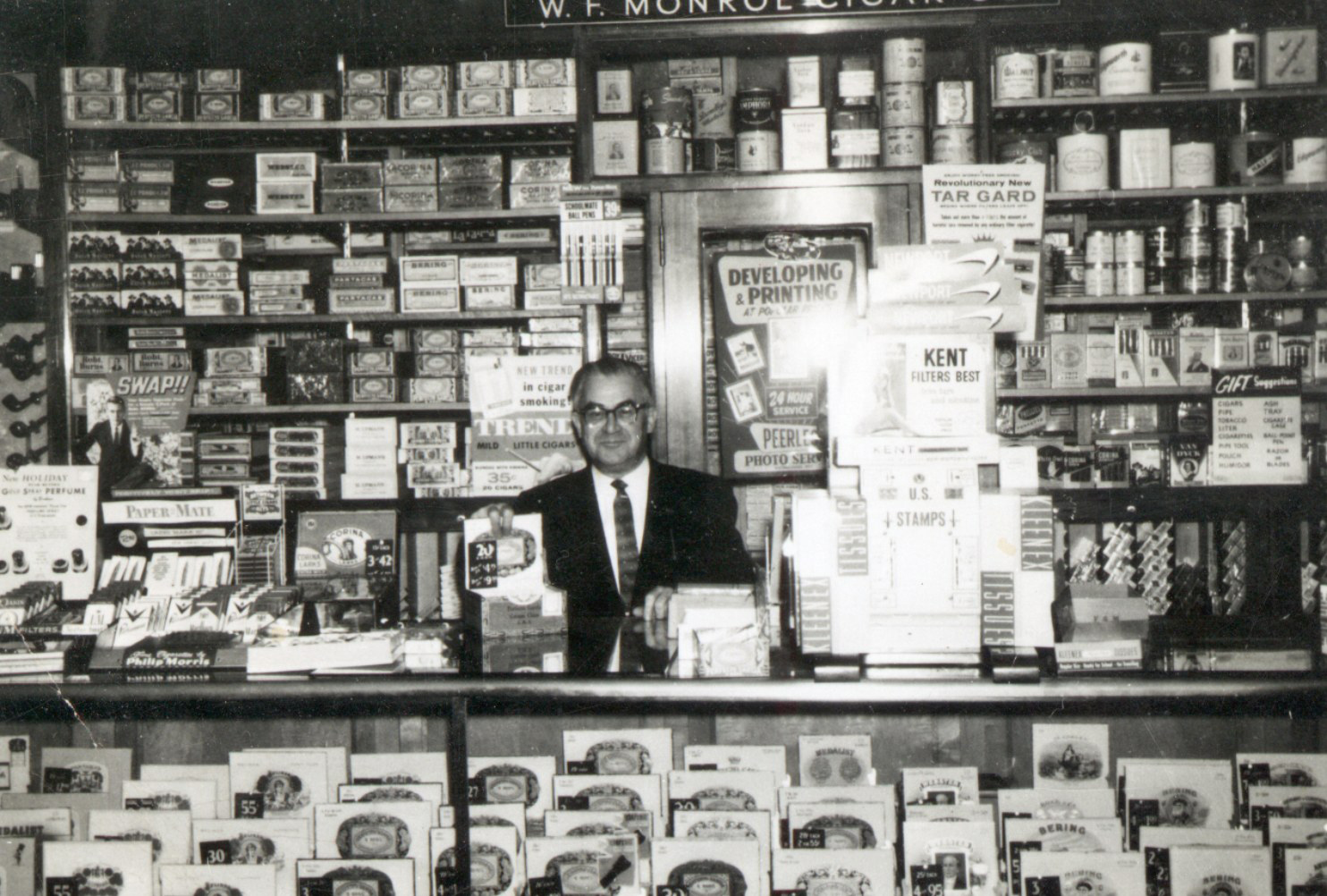
George Jatho, born in Charleston, South Carolina, moved to Chicago with his mother and siblings in 1910 when there were great upheavals in his family situation. His widowed mother taught music, the kids grew up, and by 1950 George was the proprietor of a cigar shop at Union Station, a busy place. We have a nice photo of George at his workplace, but with the arrival of the 1950 census we can see exactly how he was enumerated.
“Citation: 1950 U.S. census, Cook County, Illinois, population schedule, Chicago, enumeration district (ED) 103-1735, sheet 26, serial number of dwelling unit 288, George W. Jatho [indexed as "Vatho George w"]; database with images, National Archives and Records Administration (https://1950census.archives.gov/: accessed 1 April 2022).
Currently census pages are indexed by what's referred to as "Marchine Learning (AI) Extracted Names," hence the mispelling noted in the citation. We're lucky to find this record at all. Most of the indexing is far more hit-and-miss than this example and until summer 2022, when indexing is rumored to debut for the big sites like Ancestry and Familysearch, you'll have to search page by page using enumeration districts.
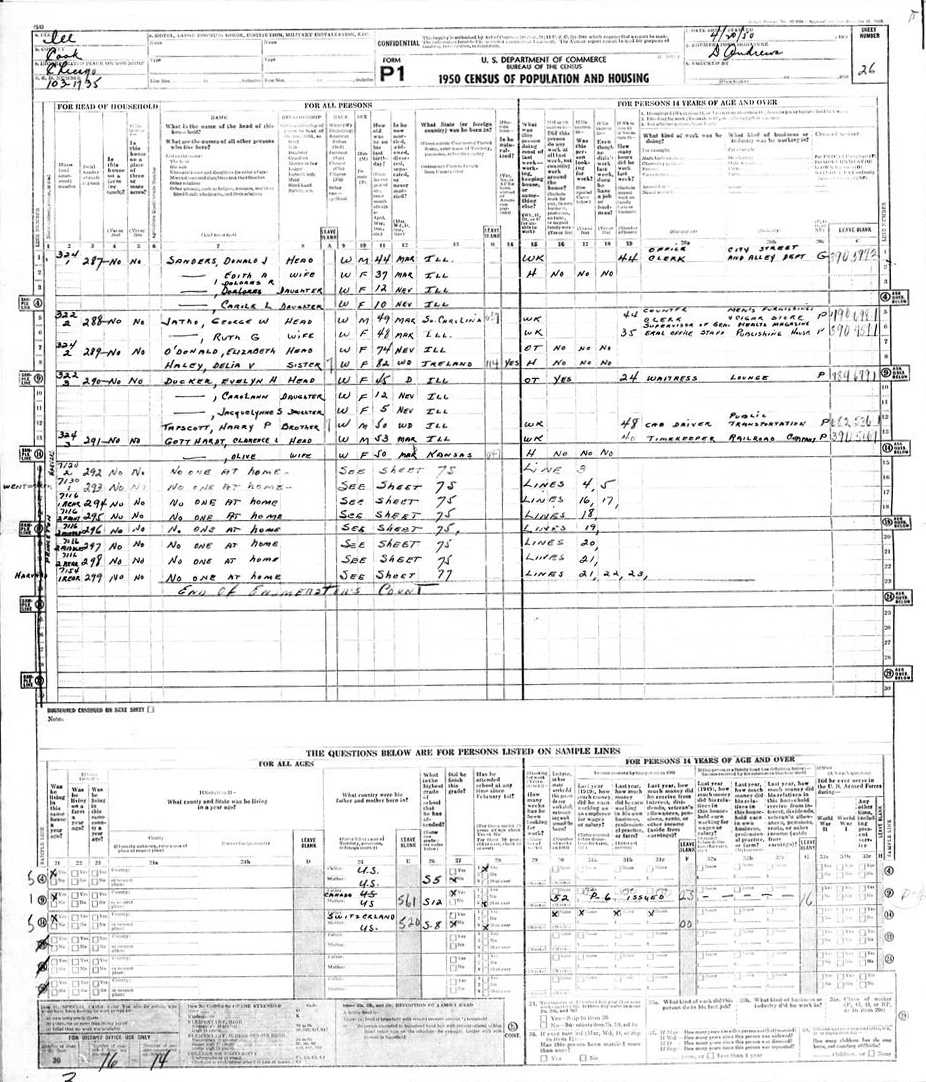
ED searches can be a pain. Enumerators didn't always (if ever!) enumerate neighborhoods in a predictable, contiguous manner. One street may appear in two or three different EDs and you have to peruse them all if you hope to get anywhere.
One handy tool is the Ancestry district map finder for locating enumeration districts by address. I've used it and find it pretty helpful, even in cases where street addresses were renumbered several years later. It won't necessarily help if the enumerator skipped some households, either by accident or design, and it won't do much in cases where people were not home to answer questions -- which seems like a lot of families in the 1950 census! Nevertheless you can get a jump-start on searches in 1950 while waiting for indexing to be more readily and reliably available.
April 2, 2022 | Email your comment.
The captivating little bride
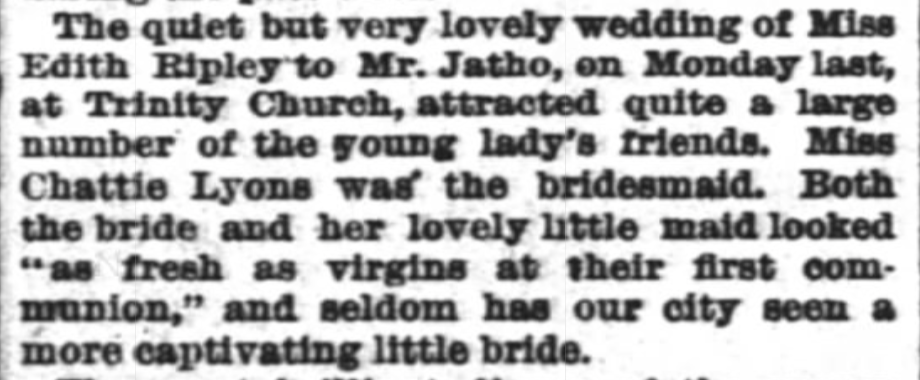
It was a quiet but lovely wedding, according to the New Orleans Times-Picayune of April 12, 1885. The bridegroom was Edmond Dantes Jatho, the penultimate son of the late G.W. Jatho and his wife, Elise Schuckmann Jatho, of Charleston. The bride was Edith Craven Ripley, daughter of Philip Ripley, a well-known journalist in New York, and his ex-wife Ella A. Browne Ripley Rodgers of New Orleans.
“Citation: Marriage notice of Edmond D. Jatho and Edith C. Ripley, The Times-Picayune (New Orleans, Louisiana), Sunday April 19, 1885, p. 12; image copy, Newspapers.com (https://www.newspapers.com : downloaded 5 April 2022).
Edmond's business connections clearly took him far afield to New Orleans. Edith's mother was a New Orleans native. The city seemed the right place for the nuptials, although it appears from a more detailed commentary in the April 12 edition of the paper that none of Edmond's Charleston family was able to attend.

Edith's father, Philip Ripley, was famous as an editor and journalist, born in Connecticut with roots as far back as the Pilgrims, although intriguingly he was disowned by his father Philip Senior.
Edmond's late father was a jeweler and watchmaker who emigrated from Hesse-Kassel, Germany in 1848 and established a business in Charleston SC.
Edmond and Edith were married long enough to have three daughters and a son, Norwood, who was born in 1887 in Charleston but spent most of his life in New Orleans. Two of the daughters, Annie Laurie and Penelope, died in infancy but Lorraine grew up with her family in New Orleans.
Curiously, Edmond and Edit separated around 1894 or so. There's no evidence of a divorce, which was an expensive proposition in those days even if the local laws allowed it to happen. Edith may have become a "grass widow," an unmarried woman who passed as a widow. She married Robert Macmurdo in 1895 in New Orleans and expanded her family, while Edmond returned to Charleston and ended up in Chicago, where he prospered as a procurement officer for the U.S. Army. He died in 1910 and was buried at Magnolia Cemetery in Charleston. Edith Macmurdo died in 1931 in New Orleans.
March 11, 2022 | Email your comment.
Turn it over
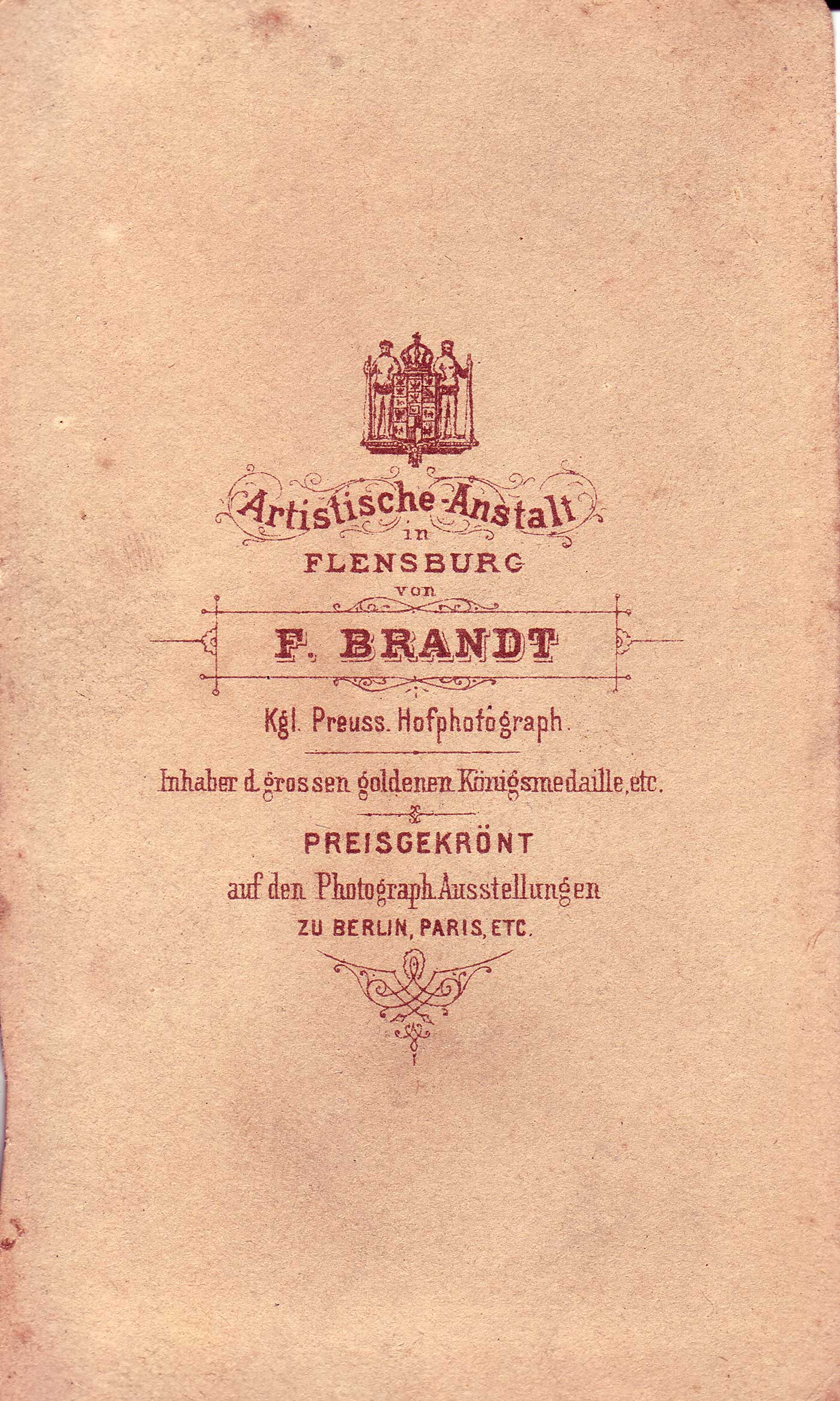
The photo's the thing, but if you have an original cabinet card from the nineteenth century it's worth looking at the reverse side to see where, and by whom, the photo was taken.
“Citation: Digital reproduction of a photograph, reverse and front side, collection of Catherine Meyer, Margarethe "Magretta" Jensen Petersen, ca. 1872, Flensburg, Schleswig-Holstein; original copy scanned in August 2006 by D.L. MacLaughlan Dumes, great-great-granddaughter of the portrait subject.
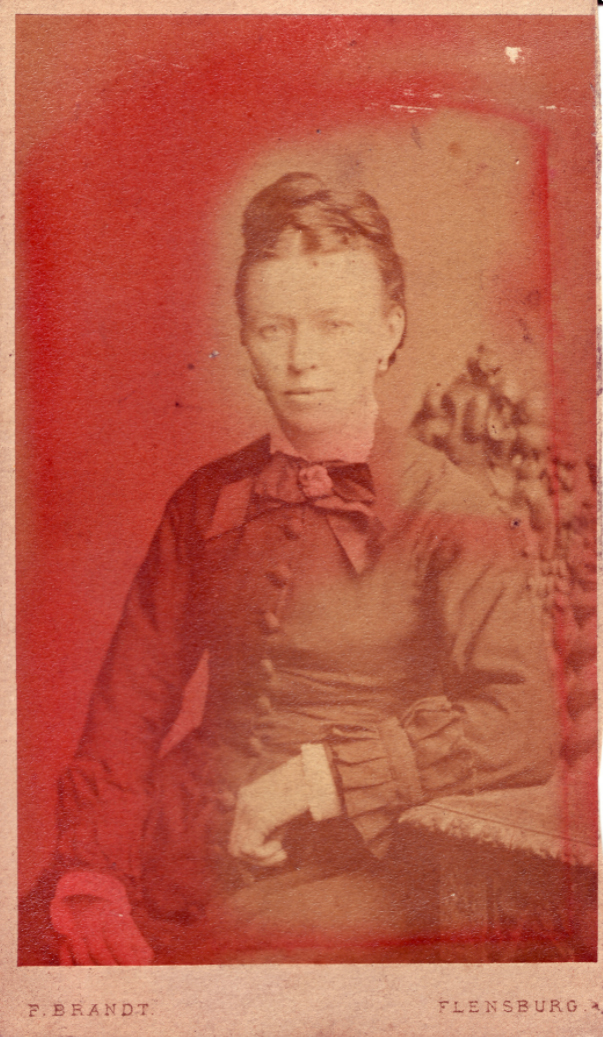
Although there's no inscription on the cabinet card (or carte de visite) we're fairly confident that the portrait can be identified as Magretta due to its inclusion in her daughter-in-law's collection, the apparent age of the lady (Magretta was born in 1816), and Magretta's remarkable resemblance to her grandson, who was born in 1916. We also know that Flensburg was the nearest large town in northern Schleswig, where Magretta and her family lived before emigrating to Nebraska in 1872.
The F. Brandt portrait studio was fairly well known in the area. Christian Friedrich Brandt's career is highlighted in this Danish-language website, where you'll see identical imprints on the reverse of some of the other images from the studio. Circumstantial evidence is sometimes all we have to identify a photo.
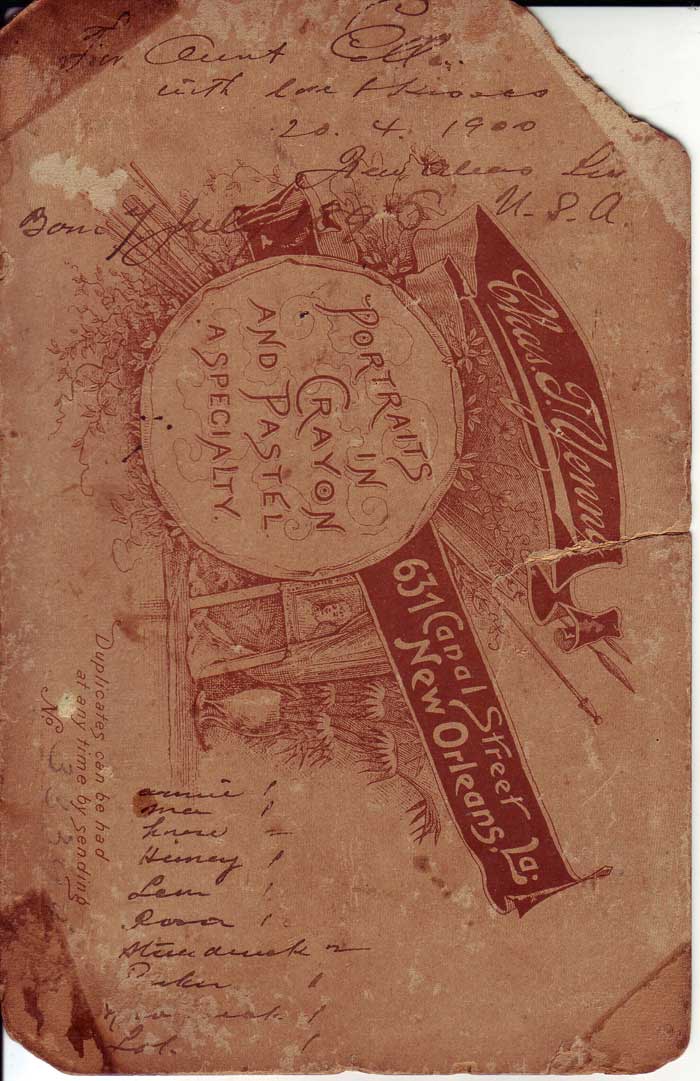
Another photo from our collection comes from New Orleans. The reverse is rich with information, including several inscriptions in various tones of ink, suggesting that the notes were made at different times. The photo comes from the studio of Charles T. Yenni at 631 Canal Street. The pre-printed information advertises that the Yenni Studio produced "portraits in crayon and pastel" (e.g. hand-tinted). The first handwritten notation says "July 7, 1896," which we know from other sources (personal verification from the Gadpaille/Jatho family plus WWI registration card) is correct for the birthdate of Edgar Courtney Gadpaille, the subject of this photo, who was almost four years old in this portrait.
“Citation: Digital reproduction of a photograph, reverse and front side, collection of Edgar Jatho, Edgar Courtney Gadpaille, ca. 1900, New Orleans, Louisiana; original copy scanned in February 2008 by D.L. MacLaughlan Dumes.
A more personal inscription: "For Aunt Ella with love and kisses, 20.4.1900, New Orleans LA, U.S.A." Aunt Ella was Edgar's aunt, Ella Garsia [Garcia], his mother Evadne Gadpaille's elder sister. The more peculiar note appears to be a list at the bottom of the reverse side of the photo, which appears to be names or places unrelated to the photo.
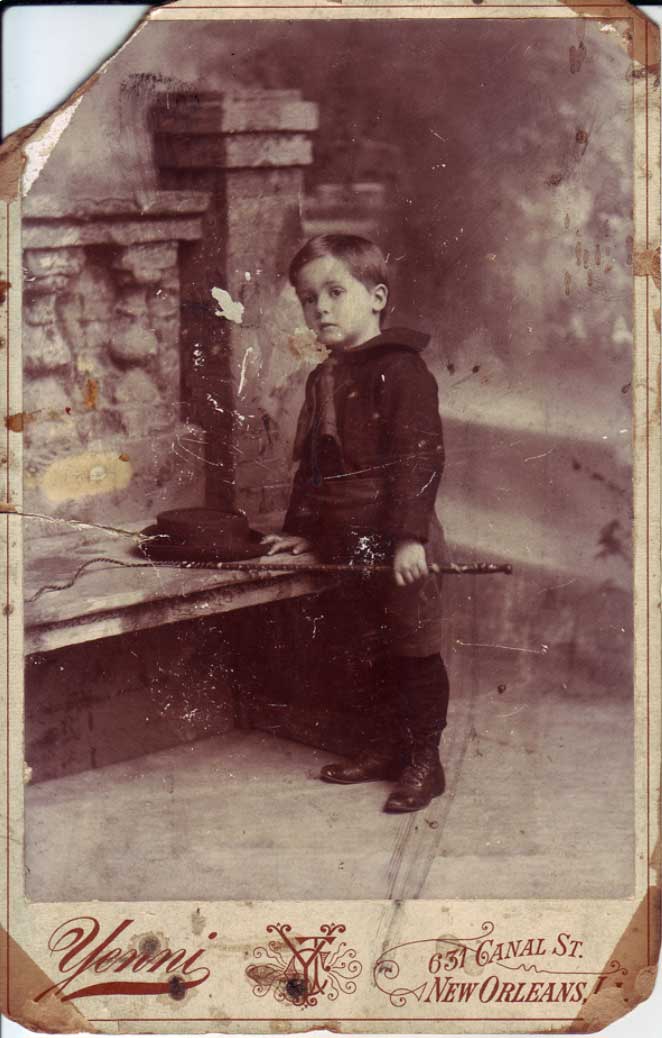
Edgar, left, was part of the Gadpaille/Jatho family of New Orleans, the youngest child of Joseph Charles Gadpaille of New York and Evadne Adelaide Garsia/Garcia of Jamaica. Joseph and Evadne lived in New Orleans and Edgar was born there in 1896. He and his wife Violet C. Gadpaille had at least one son, Warren Joseph Gadpaille. All are buried at Greenwood Cemetery in new Orleans.
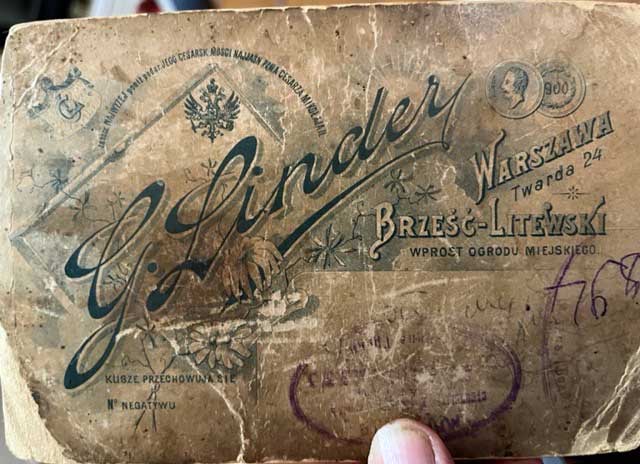
A photo further afield was taken at the G. Linder studio, which had two locations, one in Warsaw and one in Brześć Litewski "wprost ogrodu miejskiego," handy directions that translate as "straight to the city garden." The Linder studio was known for providing portraits on cabinet cards in the late nineteenth century, and this would appear to be an example of their work.
“Citation: Digital reproduction of a photograph, reverse and front side, collection of Daniel Levenson, unknown gentleman in a top hat and coat, ca. 1894, Poland; original copy scanned in 2022 by Daniel Levenson.
The trouble is: we don't know who the elegant man on the front of this photo might be!
The top-hatted gentleman, possibly in his early to mid-thirties, is elegantly dressed in a stylish coat. The reverse of the photo bears only one notation, "1894," which may (or may not) be the date of the photo. Men's fashions didn't change quite as dramatically as women's fashions at the time, making it challenging to accurately date the year it was taken, but his style is consistent with the era 1890-1905.
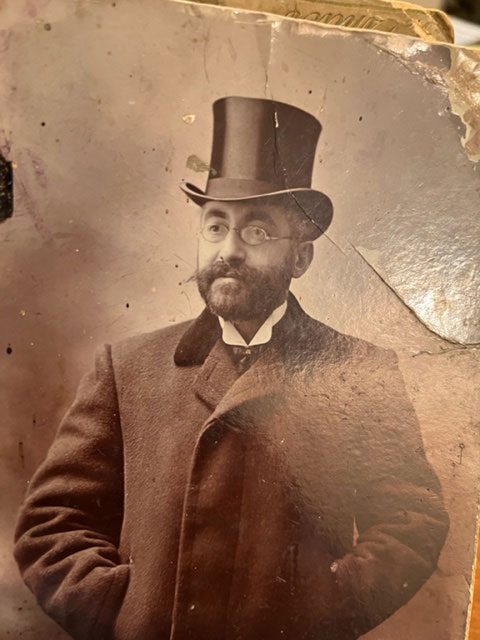
The location where the photo was taken is also puzzling. Family members don't have any known connection to these areas of Poland, although the photo's subject could have traveled there for business or pleasure from Kovno, Lithuania, where the family was based.
We may never be able to solve this mystery, but it's possible that other family members will provide information at some point in the future. In any case, it's certainly yet another photographic treasure!
March 4, 2022 | Email your comment.
The wedding party
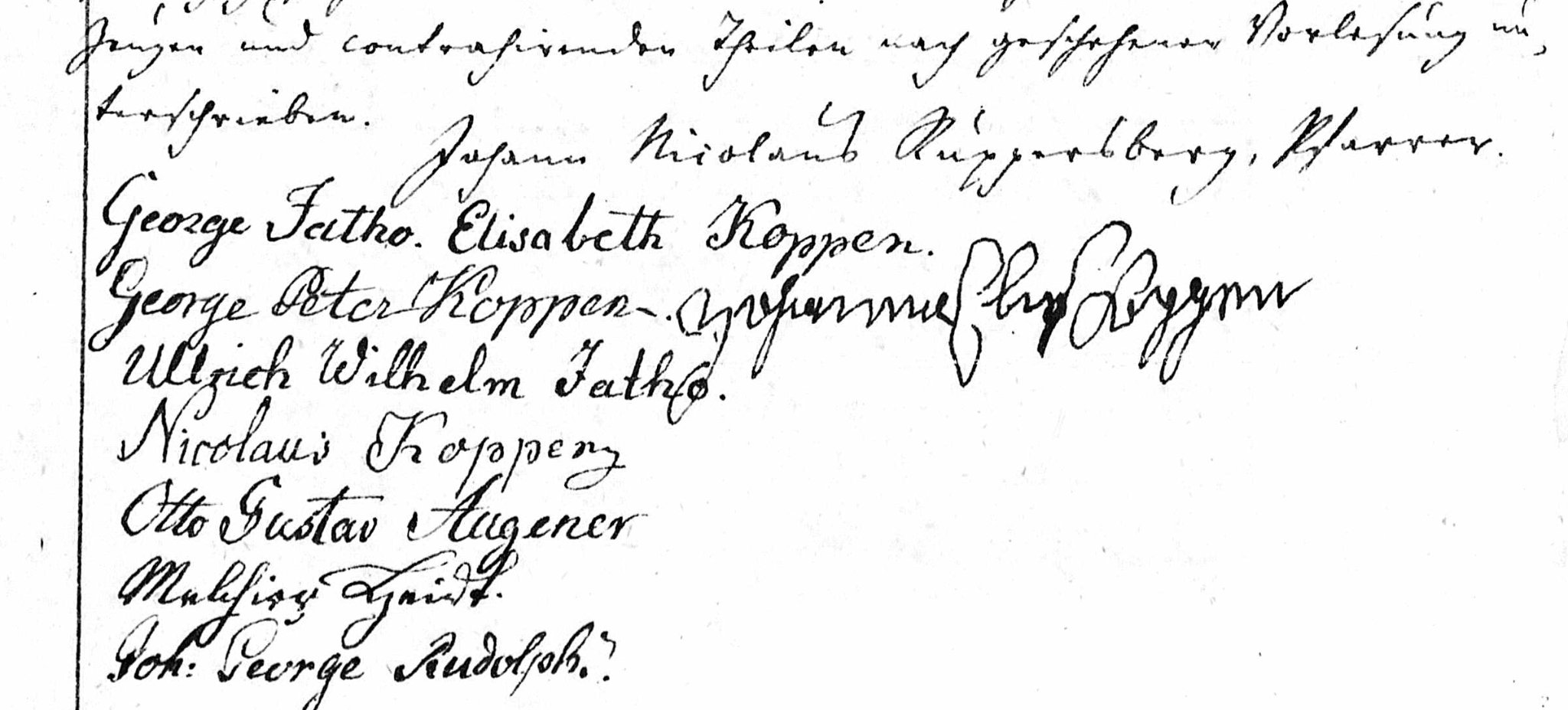
Here from 1808, a happy conglomeration of witnesses to a wedding: George Jatho and Elizabeth Koppen, the groom and bride; her parents (Johanne Elisabeth Koppen signs nervously, or perhaps she was unused to penmanship), and the groom's father Ulrich Wilhelm Jatho, my 4x-great-grandfather. Ulrich's late wife, Marie Magdalena Keppelin, died in 1795 and is represented in the text of the marriage record but was not around to sign the document.
“Citation: "Deutschland, ausgewählte evangelische Kirchenbücher 1500-1971," database, FamilySearch (https://familysearch.org/ark:/61903/1:1:QPJ6-7BTM : 16 February 2022), Ulrich Wilhelm Jatho in entry for Johann George Jatho, 18 Sep 1808; images digitized and records extracted by Ancestry; citing Marriage, Kassel, Kassel, Kassel, Hessen, Deutschland, Cassel u. Stkr, German Lutheran Collection, various parishes, Germany.
Nicolaus Koppen also signed the document: a brother or half-brother of the bride? August Gustav Augener and Melchior Heidt: the text suggests that they're associates of the bride's father. Johann Georg Rudolph is identified in the marriage document (if I'm reading this right) as a 59-year-old "father" of the bride. Could he actually be her grandfather? Or was he her true father and Georg Peter Koppen was her stepfather?
Georg the bridegroom was the older brother of Georg Heinrich Jatho (my 3rd-great-grandfather) who was eighteen at the time of this marriage and thus not of age to affix his name to a legal document like this one.
George and Elizabeth had a son who was a pastor, Jacob Ludwig Victor Otto Jatho (sometimes known as Ludwig Jacob Victor Otto, so look under both names). Ulrich's two grandsons, sons of Jacob etc., were also pastors, one particularly famous, Carl Wilhelm Jatho. Carl was something of a religious revolutionary and was eventually removed from office for suggesting that an individual could decide his/her own religious belief rather than have the state or church dictate it. Nevertheless there's a boulevard in Cologne named after him.
February 19, 2022 | Email your comment.
DNA doesn't lie (usually)
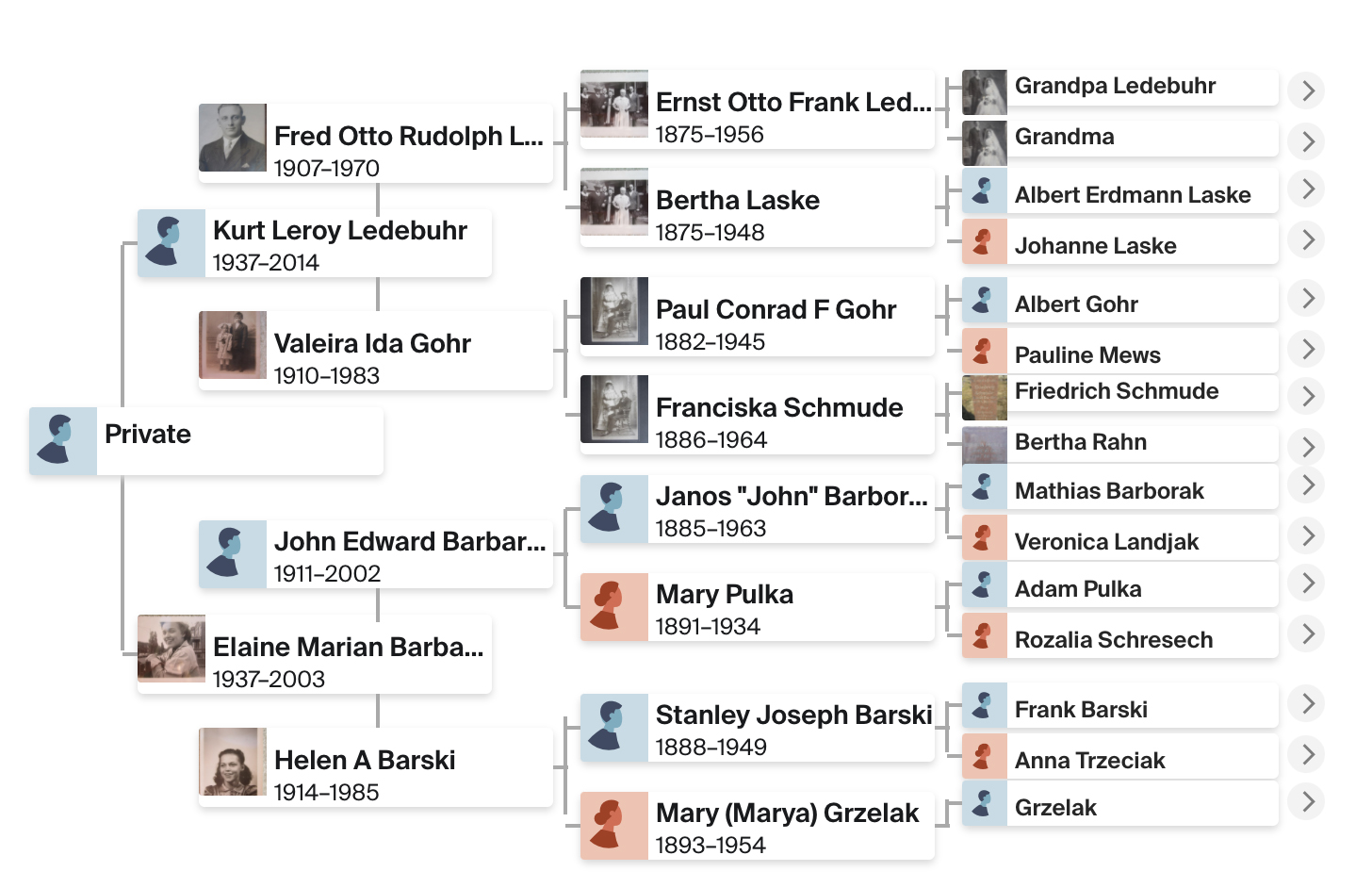
Autosomal DNA testing is a very different service from Y-DNA (male) or mt-DNA (female) DNA ancestry. It can be complicated but the simplest way to explain it is that it tests a different portion of the DNA strand and predicts how closely you may be related to cousins, close or distant.
I didn't think it would serve much purpose when I ordered a test through Ancestry.com. I had a good paper trail already. What was I likely to find out? But the test was on sale and I decided to take the plunge.
“Citation: “Public Member Trees,” database, Ancestry.com (http://www.ancestry.com : accessed 7 February 2022), “Albert Gohr,” family tree by Erich Ledebuhr, profile for Albert Gohr (1844-1895, d. Cook County, Illinois) undocumented data.
The thing about autosomal testing is that it's most likely to show you cousins in current chronology, not so much back in time unless a family tree is associated with their test. Even then, how accurate is their tree? We have to evaluate that using traditional documented information.
In this case we have some prior evidence. We know that Wilhelm Gohr, my great-grandfather, had an older brother Albert, who was born in 1844. For Wilhelm's 1881 marriage to Laura Kramp we know that an Albert Gohr was a witness to the marriage. He's recorded in the registry. We also know that Wilhelm and Albert lived right next door to each other in the Chicago voter registration rolls for 1892: Wilhelm at 3830 Wood Street, Albert at 3832 Wood Street.
Complicating this situation is the fact that Albert Gohr (who emigrated in 1872 and in married Wilhelmina Paulina Möwes or Mews in 1874) started using an alternate birth year, 1854 instead of 1844, on official records. This isn't surprising. My experience is that people who get creative about their birth years usually do so in increments of five to ten years. Albert's real birth year (1844) is exactly ten years off his later reported birth year.
That's enough to make a good researcher hesitate: did we have the right Albert Gohr after all? How could we prove a relationship between Albert and Wilhelm, other than circumstantial evidence?
That's where autosomal DNA helps. The match between Erich Ledebuhr's tree (which includes Albert Gohr and Paulina Mews) and mine is strongly suggested by a match at 1% shared DNA: 33 cM across 2 segments, strong enough for a fourth to sixth cousin, which is exactly what we would expect from descendants of these two men. So we know that Albert and Wilhelm were related and likely brothers.
Why the families didn't keep in closer touch (the lack of exchanged family photos suggest a certain distance) is a mystery to be solved another day!
February 7, 2022 | Email your comment.
Seeing double?
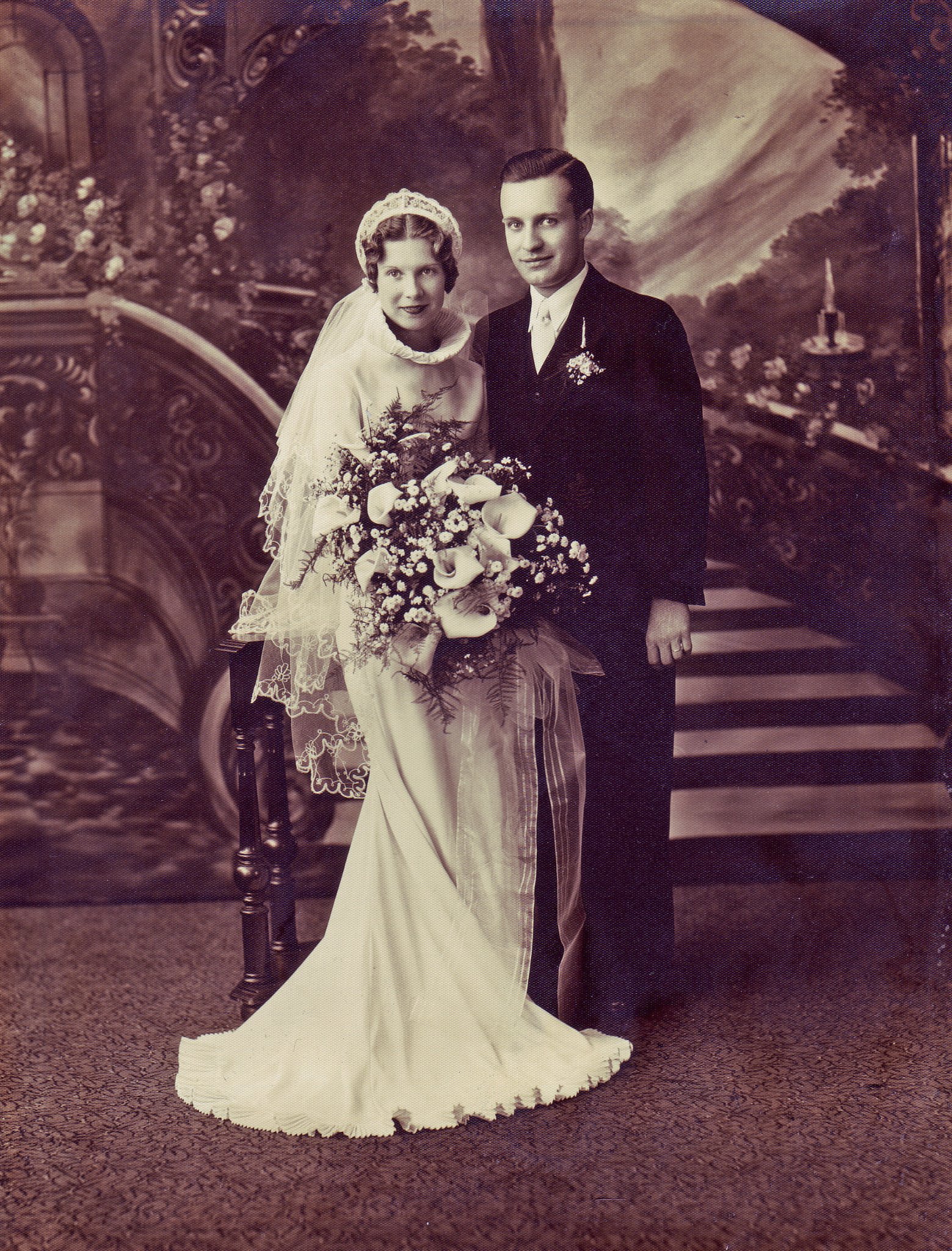

So am I and they're not even twins!
Myrtle Petersen at left is with her husband Harvey Doerr. At right is Evelyn Petersen with her husband Horton Leverenz, a double wedding in Milwaukee on June 15, 1935. Myrtle was the older sister by two years.
There were actually twins in this family. Peter Heinrich Petersen and his wife Martha Krohn Petersen had twin daughters Margaret and Myrtle in 1911. But Margaret, or Marge as she was known, married Arthur Lehrmann in 1930 in a single ceremony.
“Citation: Digital reproduction of two photographs, collection of Catherine Meyer, Myrtle H. Petersen and Evelyn Anna Maria Petersen, June 15, 1935, Milwaukee, Wisconsin; original copy scanned in August 2006 by D.L. MacLaughlan Dumes.
So that left Myrtle and Evelyn (born in 1913) to arrange their own double wedding. The details are meticulous. The wedding dresses, veils, and headpieces are identical. So is the studio background. The bouquets include the same types of flowers even if they're slightly differently arranged: calla lilies, roses, ferns, and gypsophila or baby's breath. Even the bridegrooms' boutonnières are the same.
By all accounts both ladies had long and happy marriages: Myrtle's 53 years, Evelyn's 54 years. Although their father Peter Petersen died in 1916 well before their marriages, their mother and stepfather Herbert Allen were a regular presence in their lives and the lives of their children, as you'll see from visiting pictures in our photo gallery.
January 19, 2022 | Email your comment.
Norwood Jatho: Hiding in plain sight
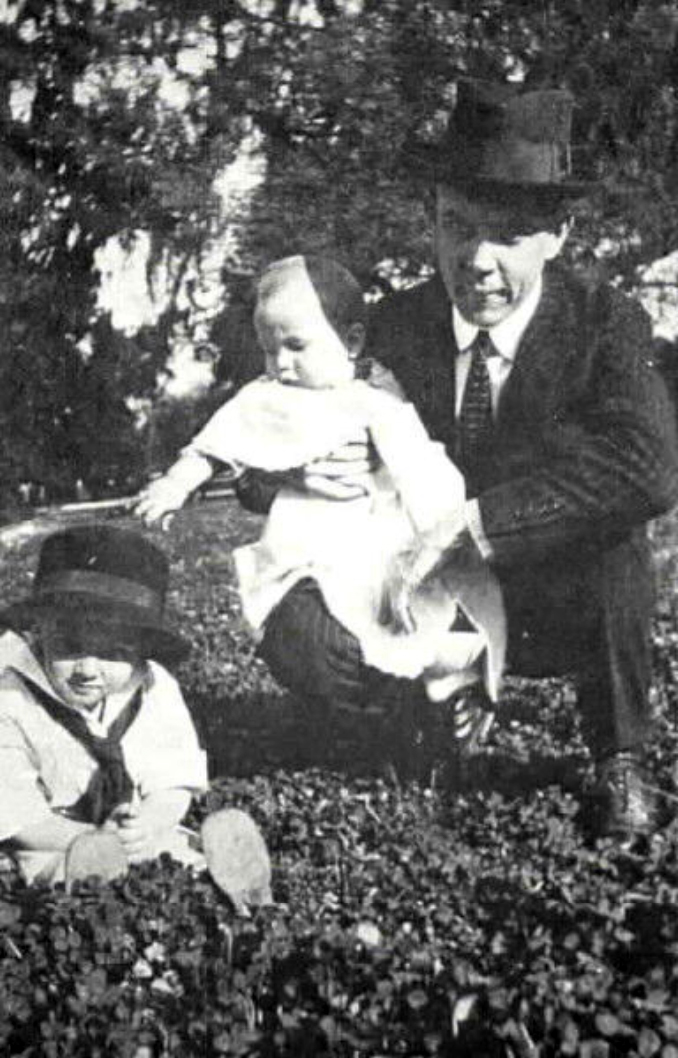
What surprised me about this photo was that not one of my Jatho relations have come across it before now. Not even his New Orleans relatives have any photos of Norwood Jatho Senior, who was born in Charleston, South Carolina in 1887 and spent most of his life in and around New Orleans, Louisiana and Biloxi, Mississippi. He's pictured here, about 1922, with two of his sons, Norwood Junior (born 1919) and Kenneth Hodges (born 1921). The photo looks to be a family snapshot, but we don't know the location where it was taken.
There were, in fact, other Jatho families in Victoria, Texas, where this image is housed. The big question is: how did they procure this photo? Did Norwood send it? Did they photograph him on a visit or did the family of Adam Jatho exchange photos through the mail?
We don't know, and unfortunately the Victoria Regional History Center doesn't record its provenance. Where it came from is anybody's guess.What it suggests is that the Jatho family of Victoria, Texas thought that there was some connection to the Jatho family of New Orleans, other than the obvious one of sharing a surname. It's a rare enough surname so that this theory makes sense, but with the facts we have access to it can't be proven.
“Citation: "Victoria College/University of Houston-Victoria Library," image in online database, Victoria Regional History Center (https://digitalcollections.uhv.edu/digital/collection/p16791coll2/id/2057/rec/4 : accessed 11 January 2022), digital copy of a photograph of Norwood Jatho Senior and his sons Norwood Junior and Kenneth Hodges, 1922, image 8399A.jpg.
We know that Adam Jatho and his parents, Johann and Elise Müller Jatho, came to the Texas port of Indianola, Calhoun County, in 1845. Adam was a cabinet maker and a musician. He married a Galveston lady, Ida Sophia Hensholdt, and they established a family presence in Victoria. The Victoria Regional History Center has a nice collection of photos from this family.
It would help us if we could find the connection, if there is one, between the two families. One is to trace the origins of Adam's parents in Germany. The most detailed suggestion of Adam's birthplace is Hesse-Kassel from his Texas death record...not precise enough for us to find out whether our Jathos and the Texas Jathos shared a birthplace. If we could find a male descendant of the Texas Jathos we could employ a Y-DNA test and compare it to a member of our family who was tested some time ago.
This photo, surprising though it may be, certainly opens up new avenues of exploration for us!
January 11, 2022 | Email your comment.
Four greats is pretty great

As it usually happens I was searching for something else and stumbled upon a few clues that led me to this death record. It's my great-great-great-great-grandfather, Claudius Franciscus Vuillemin, and it gives us an entirely new area to explore in the eastern region of France.
“Citation: "Deutschland Tote und Beerdigungen, 1582-1958", image in online database, FamilySearch (https://familysearch.org/ark:/61903/1:1:JQQY-2J5 : accessed 4 January 2022), death record for Claudius Franciscus Vuillemin, 1853, in Kirchenbuch, Tote 1812-1927, Film #008110031, image 224.
I had run across him as Franz Villmin or Willemin, the father of my great-great-great-grandmother Philippina Jungblut, sometimes spelled Jungblutin as was common in records of women's surnames. But I never found a marriage record between Philippina's parents, Franz and Magdalena Jungblut. In fact my notes from reading the microfilm many years ago specifically indicate that no father is mentioned in the record. Did I misread it? I've just ordered a copy so I can see whether I missed something the first time around. [Note: I did not misread it, no father is mentioned.]
I'd hesitated to list Franz as anything more than a stepfather to Philippina, but subsequent records suggest that there was, in fact, a marriage at some point. One such mention is in the 1873 marriage of Philippina's nephew, Karl Theodor Laurent, where you get not only the parents' of the bride and groom but the grandparent of both! Here Franz and Magdalena are mentioned with Magdalena labeled as Franz' "Ehefrau," his wife.
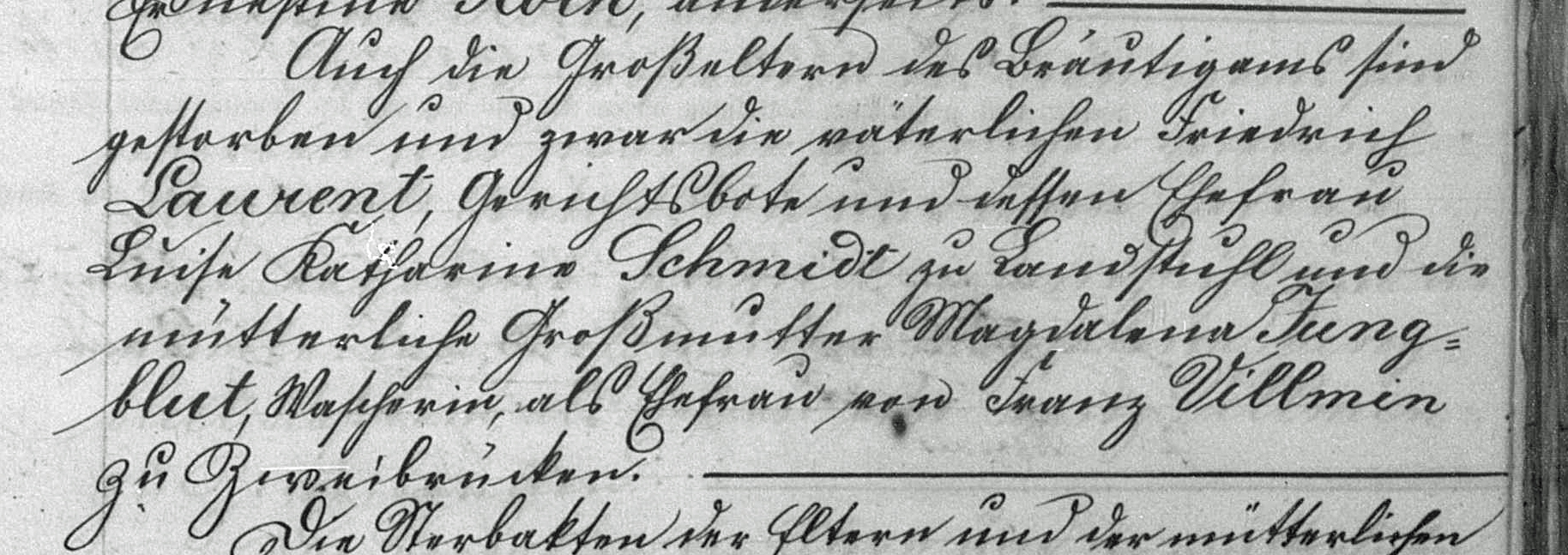
Another clue is in Philippina's daughter's baptism record from 1822 for Philippina Caroline Laurent, which includes the name of her mother as Philippina Willemin, not Philippina Jungblutin. Franz Willemin is even one of the godparents at the baptism.
In Franz' death record at the top, his status as a widower seems clear. The record presumes that there was a marriage, so it may just be that I misread Philippina's baptism record or the marriage between Franz and Magdalena is hiding somewhere.
These three records seem promising, so I added Franz with his full name into the database: Claudius Franciscus Vuillemin, born in Crançot, Jura, France, which is very near Switzerland and nearly three hundred miles from Zweibrücken, where Franz spent most of his life. We also have the full name of his wife, listed in Latinate form as Evae Magdalenae Jungblut, which should make her easier to find in the records.
Next task is to find some evidence of their marriage. It's got to be somewhere....
January 4, 2022 | Email your comment.
Finding Minnie
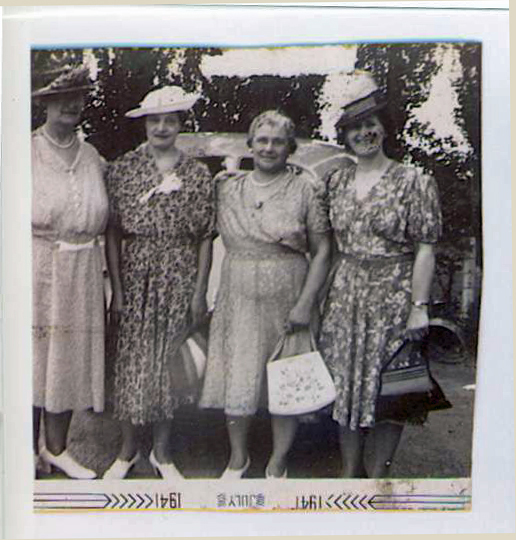
My maternal grandmother occasionally talked about her older sister Minnie, but not very often. Bertha Gohr had five sisters who lived, plus one brother. Four sisters married when they grew up, but not Minnie, and not their brother Rudolph.
“Citation: Digital reproduction of a photograph, collection of Bertha Gohr Bruns; Anna Glawe, Minnie Gohr, Bertha Bruns, Margaret (Alma) Meyers, July 1941, Chicago, Illinois; original copy scanned in 2007 by D.L. MacLaughlan Dumes, granddaughter of Bertha Bruns.
As I started to explore records for Minnie and her brother Rudolph I realized that, while Rudolph lived alternately with his sisters and worked as a printer, Minnie lived with her family only in the 1910 census, and from 1920 onward was an inmate at the Northern Illinois Hospital and Asylum for the Insane at Elgin, Illinois. She was occasionally in the company of her sisters when they organized an outing, and she's shown here, second from left, in this family snapshot from 1941.
Naturally if she had been mentally disturbed it was probably not a topic that my grandmother would have introduced, but I wasn't sure that this was the actual diagnosis. Minnie was born in 1882 and was a twin to her sister Anna, who went on to marry John Walter Glawe and produced a series of daughters. No one mentioned any mental issues with Minnie. So why was she institutionalized for most of her life?

Minnie was born Wilhelmina according to her Chicago birth certificate, so I searched for her under that name. Sure enough, the 1900 U.S. federal census has her listed under that name, this time in the town of Jacksonville, Morgan County, Illinois as an inmate at the Illinois Institution for the Education of the Deaf and Dumb. The institution housed educable hard-of-hearing students throughout the state at no cost to their families.
“Citation: Digital image, 1900 United States Federal Census [database on-line], Provo, UT, USA: Ancestrylibrary.com; Year: 1900; Census Place: Jacksonville, Morgan, Illinois; Page: 3; Enumeration District: 0141; FHL microfilm: 1240331.
The census record clearly states that Wilhelmina was born in June 1882, which matches the month and year we have for her, that she was 18 years old, could read and write English but could not speak, clearly because she could not hear.
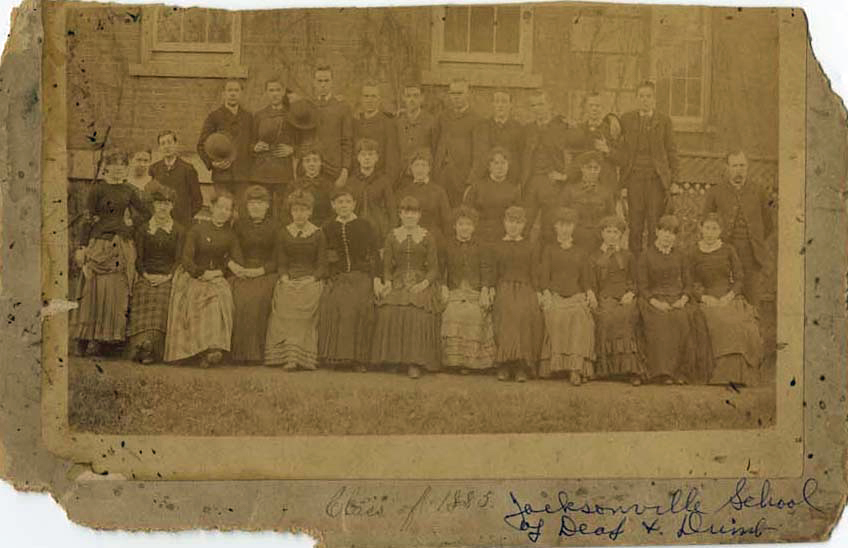
“Citation: Digital photograpph, "Illinois Institution for the Education of the Deaf and Dumb, Class of 1885," Chronicling Illinois, accessed December 28, 2021, http://alplm-cdi.com/chroniclingillinois/items/show/26831.
The institute documented photos of their graduating classes, as shown in the 1885 image shown below and online. It would be a wonderful discovery to find out whether Minnie's graduating class also documented her graduation. We have only one photo of Minnie from 1941 and it would be interesting to see her as a young woman, although the likelihood of a photograph surviving from 1900, when Minnie would have graduated, is slim.
She was able to work as a dressmaker in the early 1900s, the 1910 census suggests, while living with her mother's relatives, the Hasse/Murphy family, in Chicago. But perhaps they determined that it would be easier to have Minnie live at Elgin. At least we now have a better understanding of her circumstances as she transitioned to adulthood in Chicago.
December 28, 2021 | Email your comment.
Eyes wide shut
One of the things you learn as an archivist is how to cite a document or image under discussion. A number of concerns exist: is the document original or is it a copy? Is it in its original condition or has it been displayed in another medium, such as a website? Who owns it? And has it been altered or enhanced in any way?

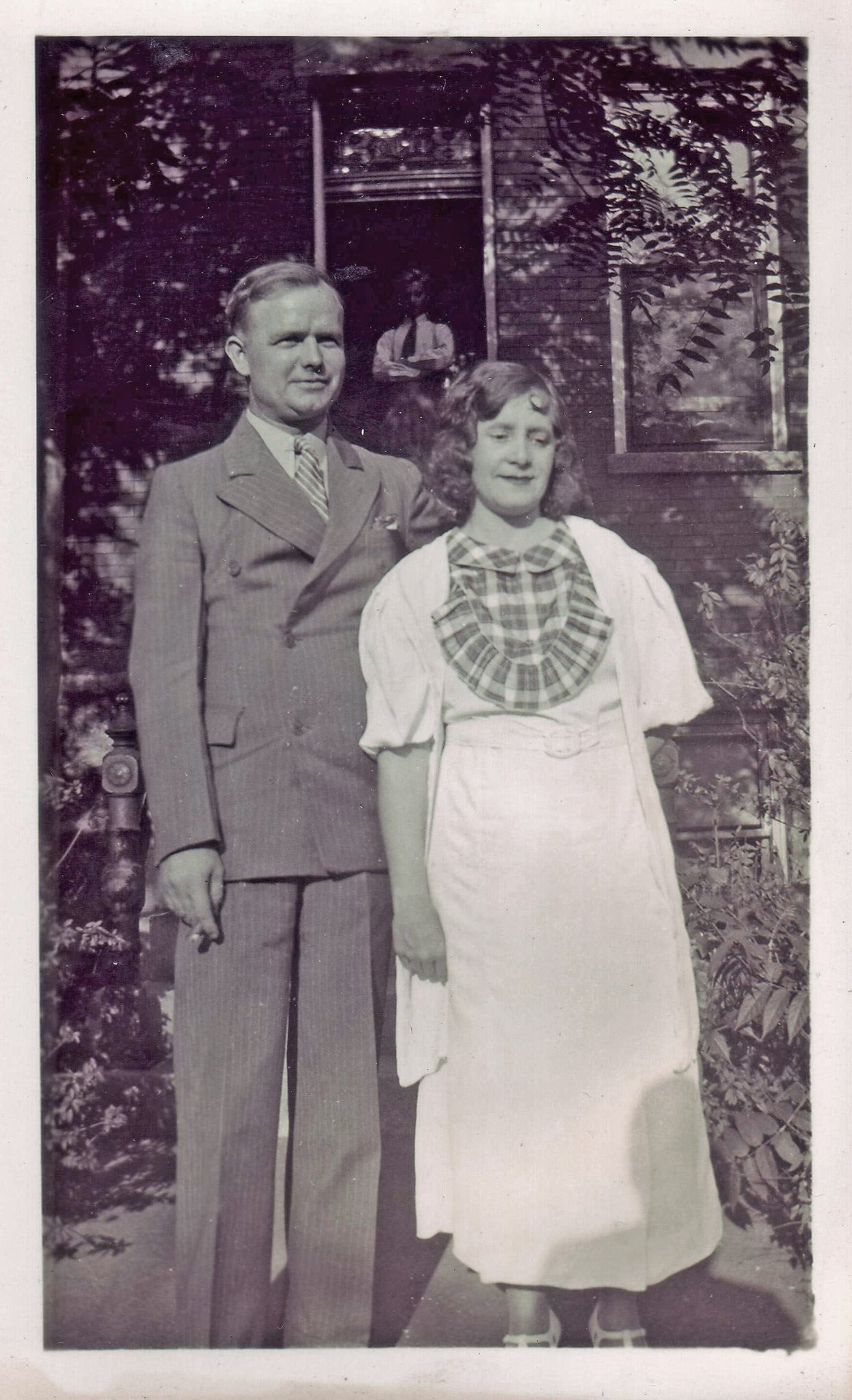
The last point may be one of the most important ones to consider. Modern software makes it easy to colorize a black-and-white photograph, or overlay a sepia tint, or take out a background image that detracts from the person in the foreground. You can even open someone's eyes if they're closed -- see the example above. Photoshop has a tool that will do just that.
“Citation: Digital reproduction of a photograph, collection of Catherine Meyer, Alva Elwood Maclaughlan and Marie Jatho MacLaughlan, ca. 1932, Chicago, Illinois; original copy scanned in August 2006 by D.L. MacLaughlan Dumes, granddaughter of Alva and Marie.
But should you do it? If you're preparing a photo for private use, maybe framed for your mantelpiece, it may be acceptable. But for an online archive or digital collection, don't do it unless you have a point to prove, e.g. if you want to contrast the difference between unaltered and altered photos for educational purposes.
“Citation: Digitally altered image of a photograph, collection of Catherine Meyer, Alva Elwood Maclaughlan and Marie Jatho MacLaughlan, ca. 1932, Chicago, Illinois; original copy scanned in August 2006 by D.L. MacLaughlan Dumes, granddaughter of Alva and Marie, and altered December 2021 for purposes of illustration.
As our cousin Albert Esser advises, there's nothing more honest than old photos. The photo of Alva and Marie on the left shows the photo in its original format. Marie's eyes are closed. Maybe there's a reason for it. Perhaps she was expressing an emotion, weariness, distress about something...maybe about the young man in the background striking a petulant pose. Perhaps she just blinked at an inopportune moment and the camera caught it. But this is the real picture, and your audience should know it.
In Photoshop Elements I've used the "Open Closed Eyes" tool to borrow Marie's eyes from another photo of Marie, where her eyes are open, and apply them to this image. It works from a technology standpoint but it's not the original photo, and your citation should express this clearly. The website for the MLA Handbook Style Center shows how to accomplish this and gives an example where you might expect to see it used.
Altered photographs are nothing new. In the former Soviet Union it was standard practice in the 1940s to doctor photos to remove the image of someone who had fallen out of favor with the regime. With modern tools it's become even easier to create fake images to promote one cause or another. But as a historian it's important to adhere to the truth that the photograph is telling. Technology is not always a blessing!
December 11, 2021 | Email your comment.
An elusive address
This is a snapshot I've had in the collection for some time: Tom MacLaughlan and his younger sister Dolores, posed somewhere in front of a house. You can see the house number above the door, but otherwise there's no clue about the location. Was this pre-World War II before Tom was drafted? If so it was in Chicago. Dolores, born in 1929, could be anywhere from thirteen to eighteen, so that doesn't help us narrow it down. in fact, her youthful visage makes it more difficult to pinpoint the date.
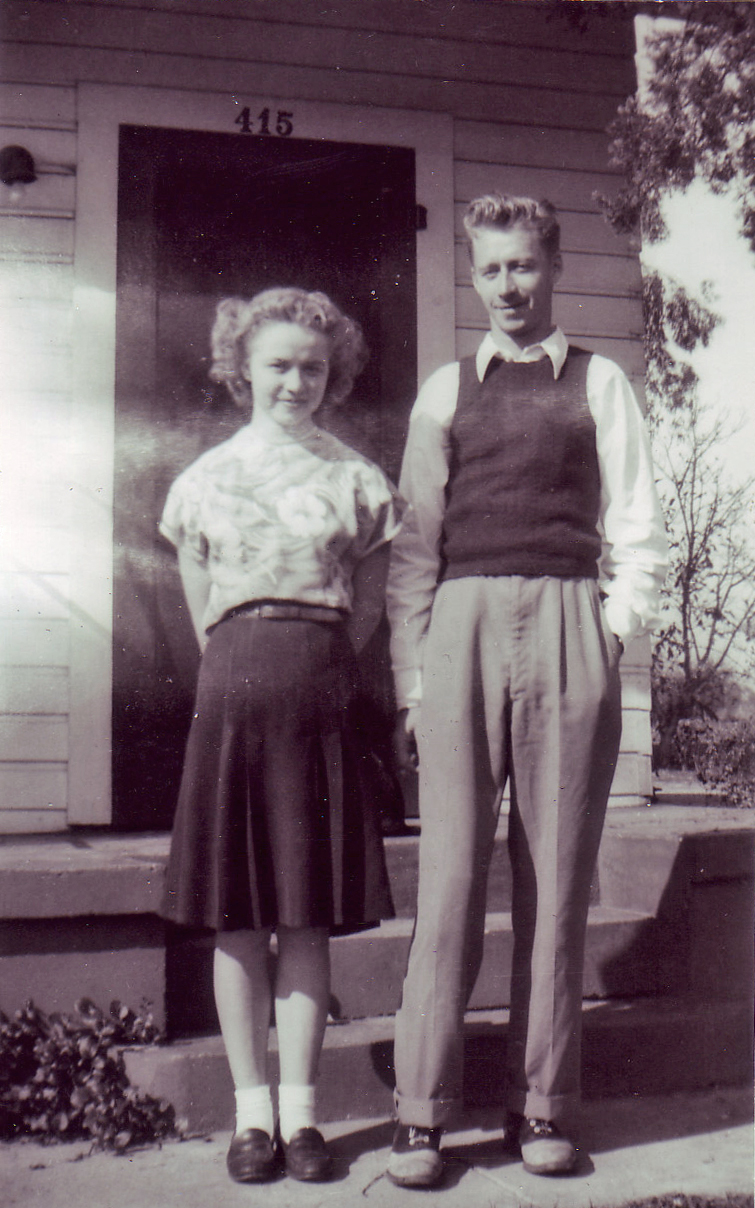
We know that after the war Tom, Dolores, and his parents relocated to Southern California. Older sister Marie was married in 1941 and stayed with her husband Walter Miller in Chicago for a time, then relocated to Omaha, Nebraska (where, if she'd only known it, a passel of her Petersen relatives lived). Alva MacLaughlan Jr., married to Doris Rohde, also remained in Chicago before venturing south to Florida later that decade. But what clue do we have to tell us whether this was after the MacLaughlans moved to the Los Angeles area, or before?
Alva MacLaughlan Senior had a propensity for moving around Chicago every few years, for reasons unknown. His voter registration record shows us all his addresses between 1936 through 1942. But none of them have the number 415. Same with his available directory entries in Southern California where he moved in 1946, when he lived in Alhambra, Glendora, and a handful of other communities -- lots of addresses but not the one we're looking for.
But I had a hunch: there was one more place to look. Tom married in 1947 in El Monte, a Los Angeles suburb. Didn't grown children often live with their parents until they married? What if the marriage license indicated a completely new address?
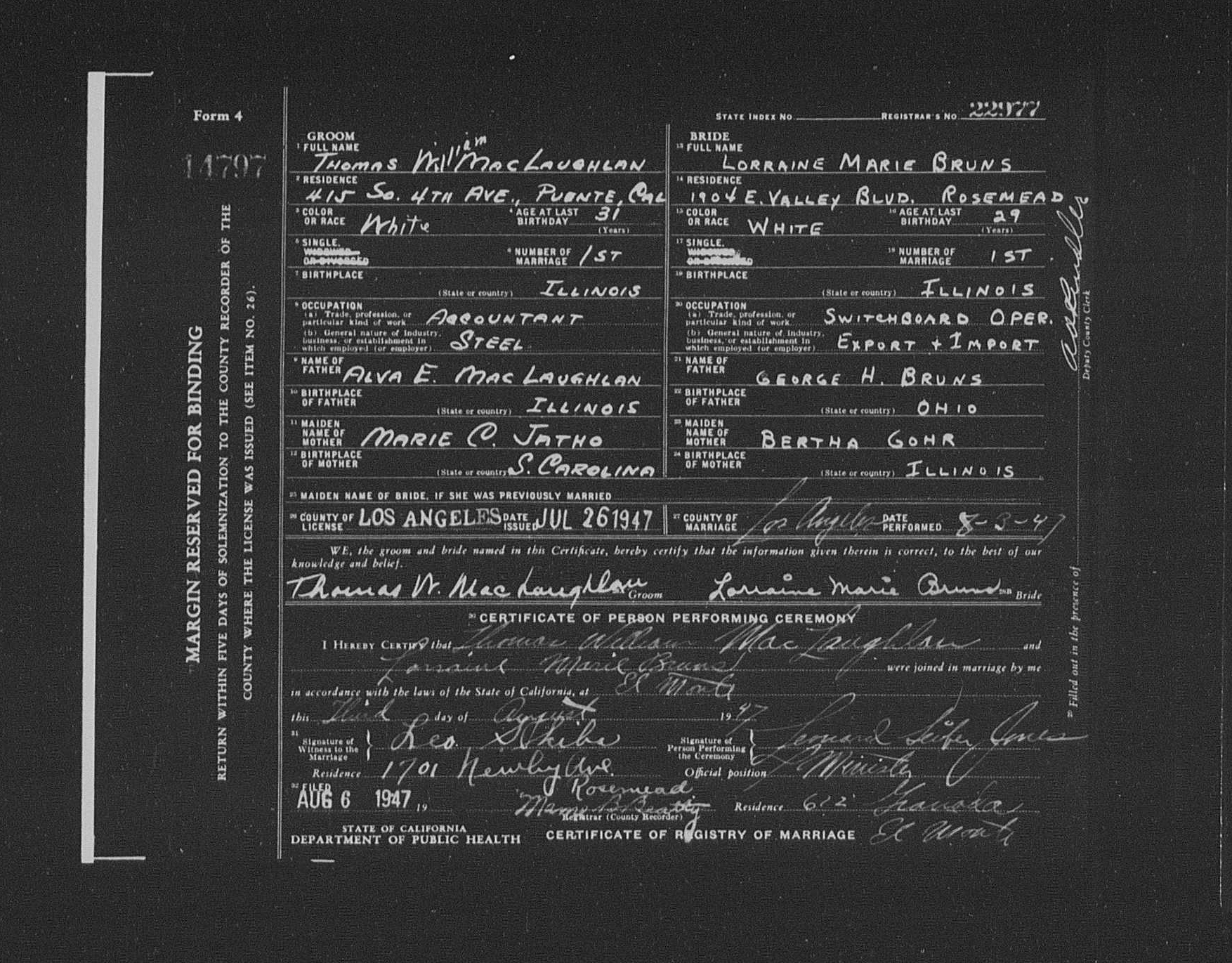
That worked! Tom's address at the time of his marriage was 415 South 4th Avenue in the small town of Puente,
about 20 miles east of Los Angeles in the bucolic San Gabriel Valley. So the tiny clapboard home where Tom
and Dolores posed was in California...and we have a verified location and approximate date for it, 1946-1947.
“Citation: "California, County Marriages, 1850-1952," database with images, FamilySearch (https://familysearch.org/ark:/61903/1:1:K8KN-BK1 : 6 December 2021), Thomas William Maclaughlan and Lorraine Marie Bruns, 03 Aug 1947; citing Los Angeles, California, United States, county courthouses, California; FHL microfilm 2,115,960.
True to form, Alva had moved to a different location a couple years later when daughter Dolores was married. She gave her parents' home address on her license as 816 Washington Ave., El Monte. It's true that just after WWII it was tough to find permanent housing in Southern California, but Alva was an old hand at trading spaces.
We often turn to census or directory entries to trace our ancestral addresses, but this is a reminder that other resources work nicely too: voter registrations, vital records, even newspaper social notes. It's worth tracking them down for a picture of our relatives' peregrinations.
December 6, 2021 | Email your comment.
An American Gretna Green
In England, Gretna Green was the go-to place to get married if you were under 21 years of age or if you didn't have your parents' consent, due to the Marriage Act of 1754. Just over the Scottish border, Greta Green welcomed couples looking to circumvent the policy.
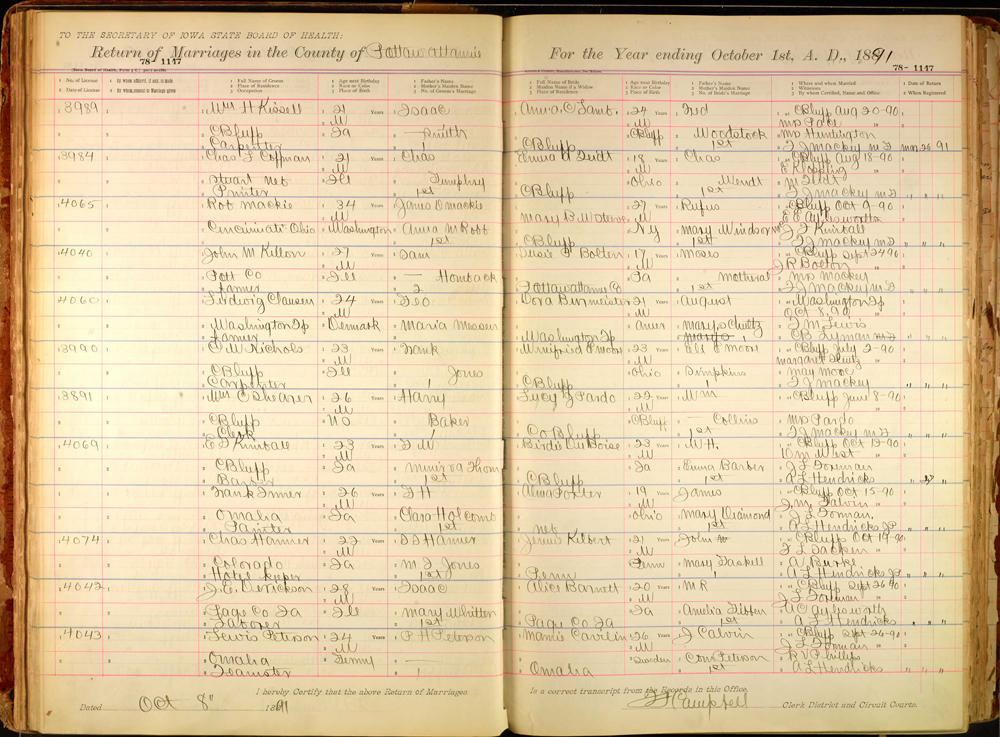
There were some American cities that acted as safe harbors in similar circumstances. Lake County, Indiana was one region where Chicago folks could go to get a quick marriage.
So, apparently, was Council Bluffs, just four and a half miles from Omaha, Nebraska. Here Omaha residents Louis Petersen and his bride Marie (Mamie) Cavilin could marry without parental displeasure, or whatever it was preventing them from marrying in peace at home.
“Citation: Iowa, U.S., Marriage Records, 1880-1951 for Lewis Peterson [Louis Petersen], 1891, 363 (Polk - Wright), database with images, Ancestry Library (https://www.ancestrylibrary.com: accessed 29 November 2021, Iowa Department of Public Health; Des Moines, Iowa; Series Title: Iowa Marriage Records, 1880–1922; Record Type: Marriage.

This is a good lesson for researchers too. No record could be found in Nebraska for Louis Petersen (correct spelling) and his wife Marie, who showed up regularly in census records but never in the annals of Nebraska marriages. Naturally, because as we know now, they weren't married in Nebraska, even if that was the logical marriage place. But open up the search to all states instead of focusing on Nebraska and Iowa pops up.
You have to be creative in your search too, such as recognizing that Lewis Peterson is an expected alternate spelling of Louis Petersen, and that Mamie was a nickname for Marie. But his father's name is right, and we also get a clue to Mamie's father's and mother's names, which will aid in future searches.
We also had a little help from clues left in a birth record in Omaha that gave us Marie's maiden name and made it far easier to find the marriage record. Louis and Marie had a daughter, Elizabeth, who was born in 1891. Searching for her rather than her parents (a father called Louis Petersen, a mother called Marie with no surname) brought up a record in the database for "Wilhelmina Elizabeth Peterson in the U.S., Evangelical Lutheran Church in America, Swedish American Church Records, 1800-1947." Marie was Swedish according to the available census records, so that's a likely tip. And looking at the birth record gives us more clues.

There were two births recorded together in this registry but one is out of sequence. Effie Evangelina Cavalin was born in September 1892 but Wilhelmina Elizabeth Petersen was born in April 1891 (those with their calculators handy will note that Elizabeth was born before her parents' marriage). But the two births are grouped together because each parental group acted as godparents to the other family: Carl J. Cavalin and his wife for Elizabeth, Louis Petersen and his wife for Effie.
The simplest reason for the reciprocal sponsorship was a relationship between the two families. That was typical for the time. So if we assume that Carl J. Cavalin was related somehow to Louis' wife Marie Petersen, we should find evidence of it somewhere. And we do! A quick search for a marriage somewhere in the U.S. between a Louis Petersen and a Marie Cavalin leads us to the Iowa marriage.
It's a convoluted path but this time it just happened to result in a great discovery...and a relief. We've been looking for Marie's original surname periodically over the past sixteen years. Now we know!
November 29, 2021 | Email your comment.
Find-A-Grave is your friend.
Well, maybe not your best friend, but it's an awfully useful tool. Thanks to Find-A-Grave participant Saratoga and Jim Ravencraft for this series of photos.
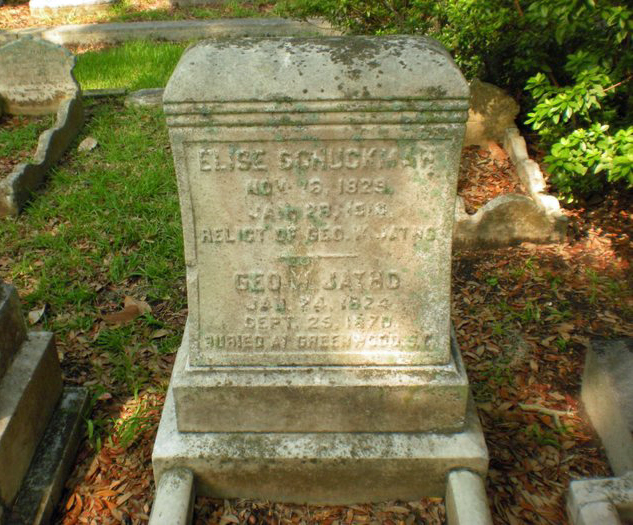
Some years ago when I was trying to unravel the story of All Our Jathos in Charleston, South Carolina I had to fly there and traipse around Magnolia Cemetery to find the Jatho plot. Now that diligent volunteers are stepping in, things are much more easily found.
Elise Jatho's headstone is fairly accurate and tells us that she was the "relict" (widow) of George W. Jatho, who was buried (for whatever reason) across the state in Greenwood, South Carolina. The family was living there at the time. Perhaps it was too expensive to bring the patriarch back to Charleston where the family had their primary residence.
It was also the first major death in the family, occurring in 1870, and it would have been expedient to plan for a local burial, which was arranged by G.W. Senior's Mason brethren.
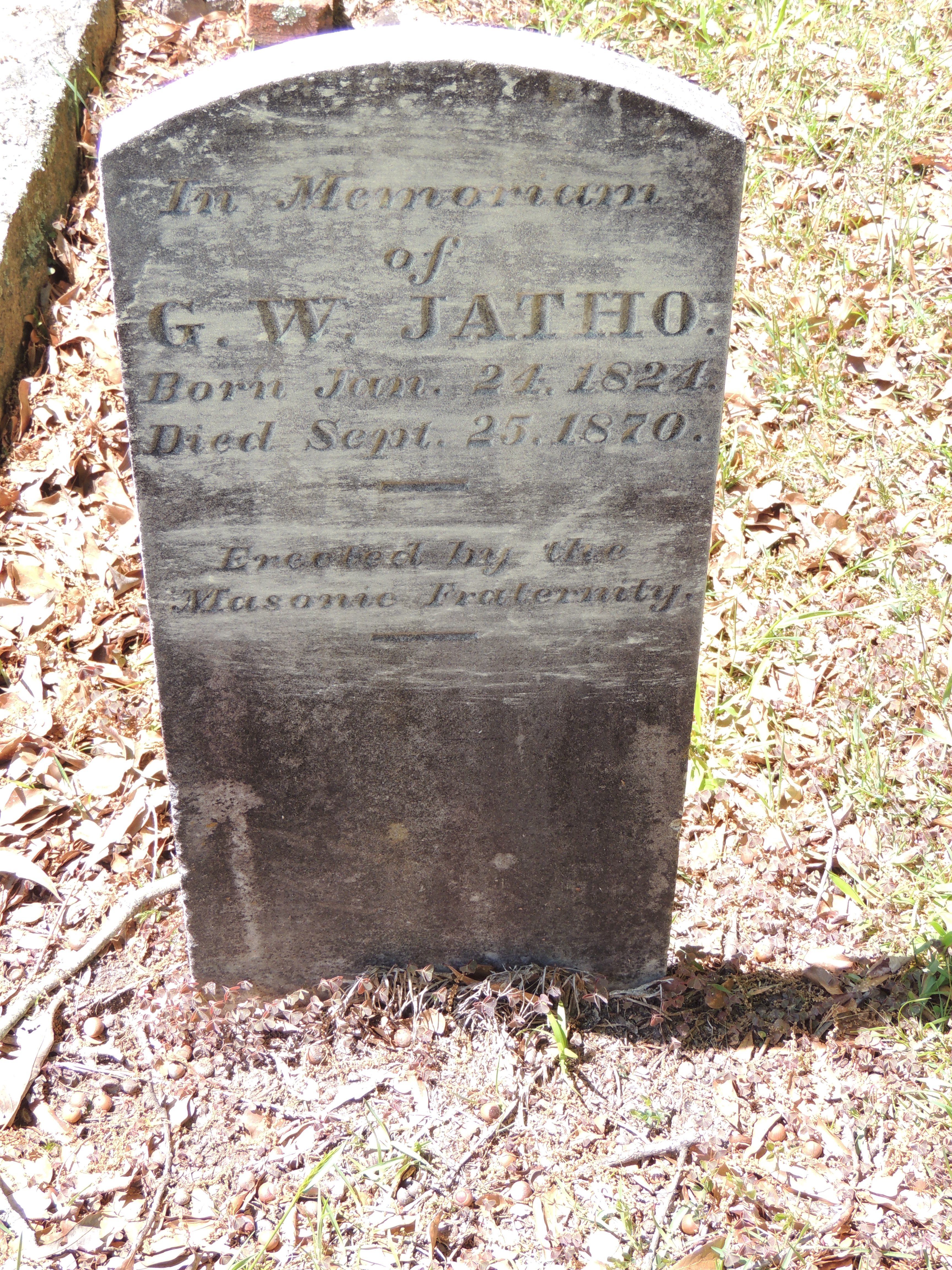
At some point, after the family moved back to Charleston, a "perpetual care" plot was established at Magnolia, one of the two cemeteries favored by the German Lutheran community in town. Perpetual care was a financial arrangement that allowed for future family burials in the same spacious plot, here located under a restful oak tree and surrounded by beautiful azaleas (you can see an image of the Jatho plot in the slide show that rotates on our home page).
Perpetual care was also an insurance program of sorts, allowing the cemetery to hire groundskeepers to keep things tidy for all patrons. It's a mandatory program today but was not required during the time of the Jatho burials.
“Citation: Find A Grave ("https://www.findagrave.com/memorial/120613606/g-w-jatho : accessed 12 November 2021), memorial page 120613606, Georg Wilhelm Jatho (1824-1870), created by Jim Ravencraft; citing Greenwood Cemetery, Greenwood, Greenwood County, South Carolina, USA.
Using information on a Find-A-Grave page is helpful for genealogists but must still be cross-checked with other sources of information. The volunteer Saratoga isn't a family member who's related to these Jathos, and as a result he or she doesn't have complete information on the burials. There are actually more children and even grandchildren of Elise Jatho buried here. One son, Carl Julius Jatho, died in 1929 in Bartow County, Florida and is not represented here (we're still looking for him!). Another son, William George Jatho, is buried across the street in Bethany Cemetery with his in-laws, the Rev. Louis Müller and wife Caroline Laurent Müller.
November 12, 2021 | Email your comment.
The traveling MacLaughlans
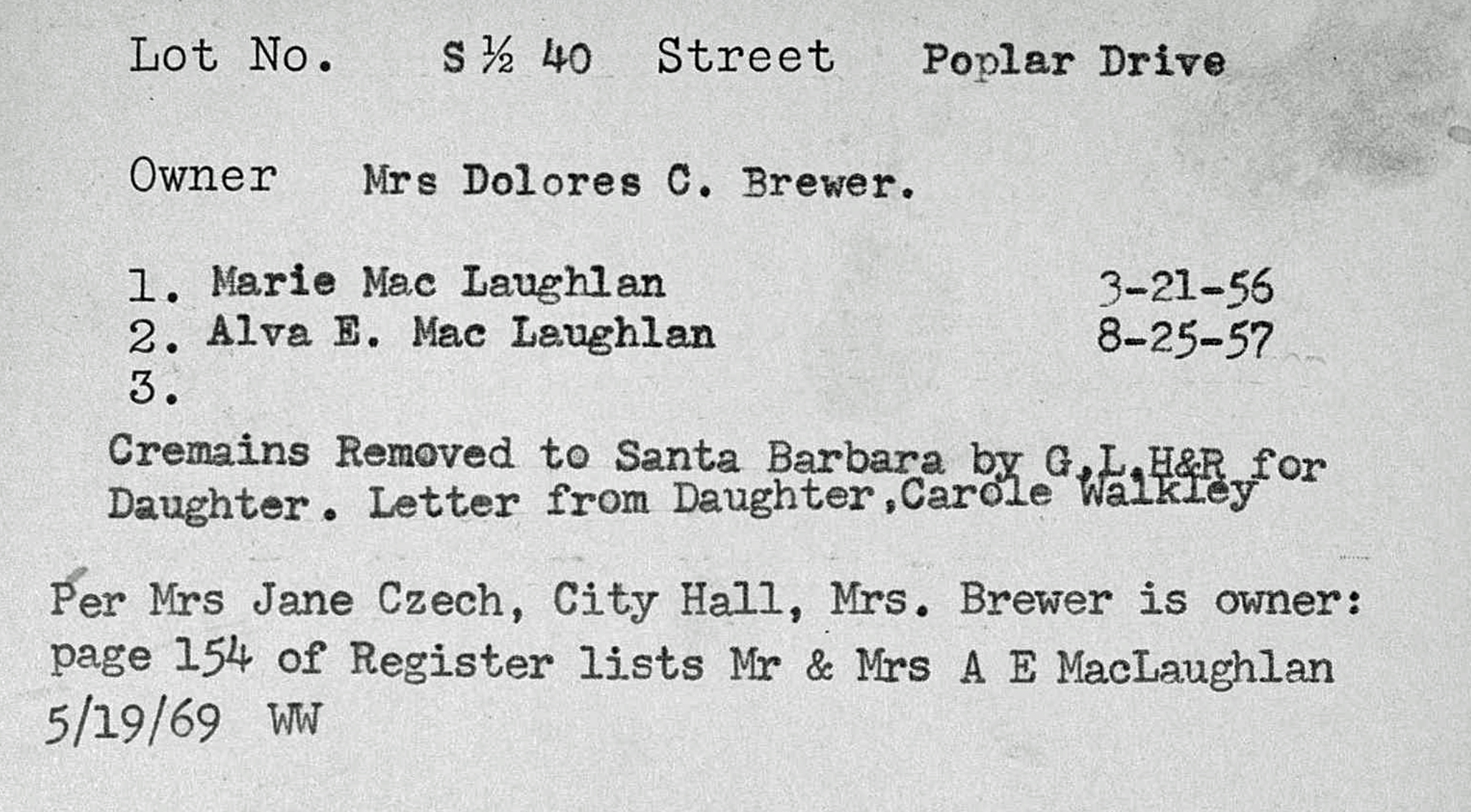
Thanks to a new online database, I found out that my grandparents moved around a bit...after they had both passed on.
Why did they spend their first years of eternal repose in Little Rock, Arkansas, a place where our family has no connections? One can only speculate. But the Familysearch.org database "Arkansas, Oakland and Fraternal Historic Cemetery Records, 1867-2013" gave me quite a surprise this week.
The index card shows that Alva and Marie MacLaughlan's "cremains" (as cremated remains are called in the industry) were removed from the Oakland and Fraternal Historic Cemetery Park in 1991, when their daughter requested that they be relocated to a cemetery in Santa Barbara. Except for the fact that none of us knew that Alva and Marie were in Arkansas in the first place, the request makes some sense. Their daughter was living in Santa Barbara at the time. The card noted that the plot owner was Mrs. Dolores C. Brewer but the daughter requesting the move was Carole Walkley. In reality they were the same person.
“Citation: "Arkansas, Oakland and Fraternal Historic Cemetery Records, 1867-2013," database with images, Ancestry Library (https://www.ancestrylibrary.com: accessed 1 November 2021) for Marie MacLaughlan and Alva E. MacLaughlan; Sexton´s daily record Oakland Cemetery, vol J, 1957-1984.
It wouldn't be clear to most folks why two different names for the same woman would be used on this record, but it was necessary for my aunt. Her partner, Reuben Walkley, had an aversion to her family and insisted that she change her name. Of course he could have done that by marrying her, but he was still married to his first wife. I digress. On with the tale!
In 1957, why was Little Rock, Arkansas the best place for Alva and Marie? They had no family there. Their children and grandchildren couldn't visit them there. Of their four children, one lived in Florida, one in Nebraska, and two in California. The only possible reason: Dolores' then-husband Jim Brewer had been born in Arkansas. Maybe these were left-over family plots and convenient to use. On the other hand, there's a timing issue that is a bit of a puzzle.

From the same collection are handwritten entries from the cemetery sexton's daily records, and above is the one for Marie, who died March 16, 1956 in Los Angeles. But the sexton's record says she arrived at Oakwood & Fraternal Cemetery in Little Rock on March 7, 1957, nearly a year later.
Where had she been during the previous year? On somebody's mantlepiece? In somebody's garage? Does this suggest a family rumpus over the burial location? Probably...but there's nobody around to tell us.
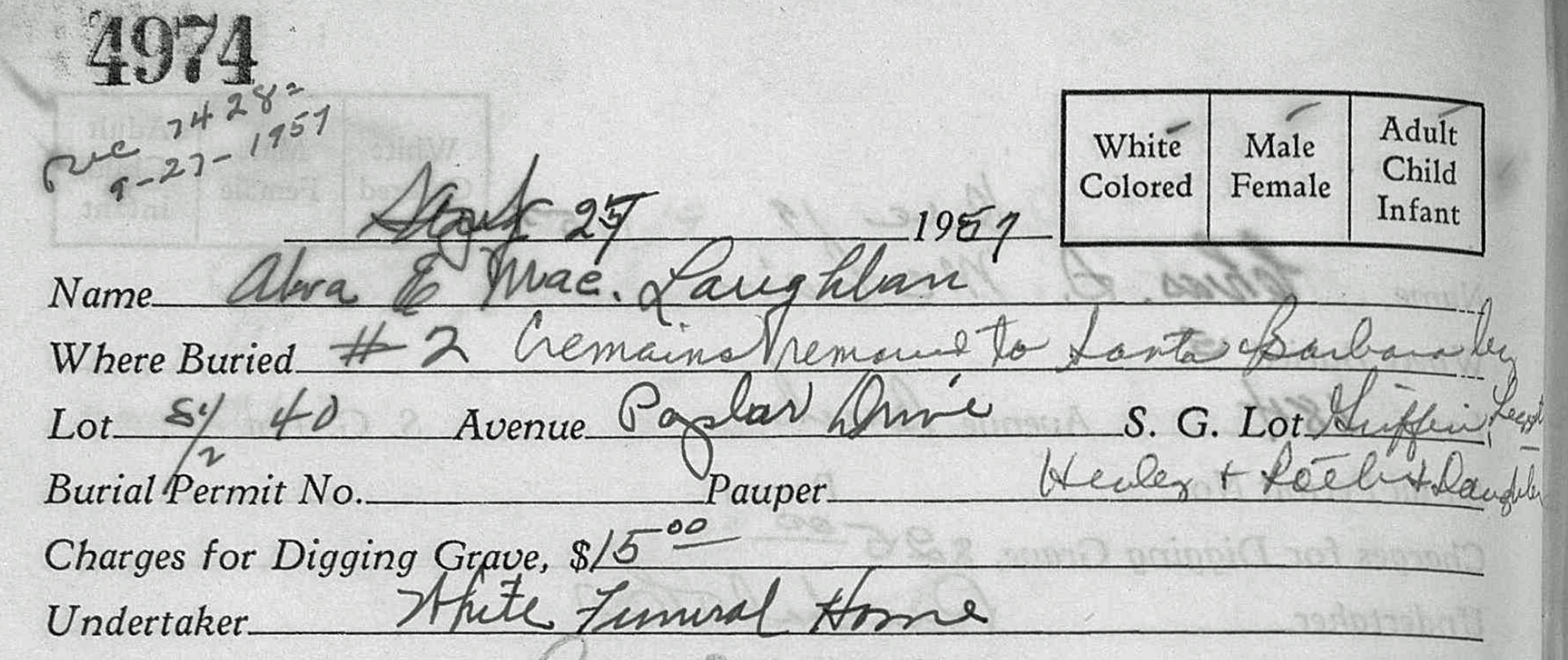
Alva died on August 18, 1957, also in Los Angeles, but his banishment to Little Rock was more punctual and he arrived a month after his death. There Alva and Marie resided together on Poplar Drive until 1991, thirty-four years later. Then it was off to Santa Barbara, California for them both.
Strangely, Dolores (or Carole, take your pick) told no one in the family that her parents' remains had gone a-wandering. It remained unknown to all of us until Find-A-Grave indexed them and revealed Alva and Marie to be Californians once again, this time in perpetuity...we hope!
November 1, 2021 | Email your comment.
A grim report
Regularly I'll search on an ancestor's name, say every few weeks, because I know that new databases are being brought online, and that means new results. One of the areas where records are hard to come by is Schleswig-Holstein, where records have traditionally only been available at the local archives, reachable by researchers in the area.
Thus it was a nice surprise to see a couple of names I recognized: Peter Hansen Petersen and Elise Christina Momsen, my great-great-grandparents. But the record where they are referenced wasn't so cheery. Click the image at left to enlarge it.
The Familysearch.org collection "Deutschland, Schleswig-Holstein, Schleswig-Flensburg, Zivilstandsregister, 1874-1983" has a death record for their oldest living son, Emil Jacob Petersen. Born in 1847 in the village of Tinningstedtfeld close to the Danish border, he was apparently living near Glückstadt, north of Hamburg, when he met his end. The record is in the form of a police report and is unusually detailed.
We don't know the exact cause of death in 1894: he may have stumbled into a canal and drowned, he may have been murdered (the police report doesn't speculate), or he may have committed suicide. But the translation (provided kindly by Mattias Steinke from the German Genealogy Facebook page) suggests a tragic end to his life.
“Citation: "Deutschland, Schleswig-Holstein, Schleswig-Flensburg, Zivilstandsregister, 1874-1983," database with images, FamilySearch (https://familysearch.org/ark:/61903/1:1:Q2WK-MXP8 : accessed 28 October 2021), Elise Christina Momsen in entry for Emil Jacob Petersen, 28 Mar 1894; citing Death, Glückstadt, Steinburg, Schleswig-Holstein, Germany Gemeinschaftsarchiv Schleswig-Flensburg, Schleswig-Holstein (Schleswig-Flensburg County Archives, Schleswig-Holstein).
The translation: "Glückstadt, the 21st of March 1894 - By official document of the police-administration here on the 21st of March 1894 -journal nr. 472 - is reported, that the ragman Emil Jacob Petersen, 47 years old, Lutheran religion, residing in Engelbrechtsche Wildnis, Herrendeich, born in Tinningstedtfeld, county of Tondern, been married to (name and residence of the wife unknown) son of the couple Peter Hansen Petersen and the Elise Christina nee Momsen, both residing in Tinningstedtfeld, profession of them unknown, in Glückstadt in the black water (Schwarzeswasser) at the 28 March of the year 1894 pre-midday at 8:30 was found dead. The death happened on the 25th February 1894 past midday at abt. 11:30. The registrar (signature) - correction: before certifying of this document it is corrected, that the deceased was found on the 20 March 1894. Glückstadt, 21st March 1894 - the registrar (signature)."
"Schwarzeswasser" is actually the name of a canal in Engelbrechtsche Wildnis, as shown currently on Google Maps. It must have been a place well known to the clerk, who wrote up this account.
It's not known how Emil Jacob ended up so far away from his town of origin, or why the name of his wife wasn't provided. But this does seem to have affected his relatives in Chicago, who had emigrated there in the early 1890s.
Emil's parents were no longer living, having died sometime between 1885-1890 in Nebraska, the state where they emigrated in 1878. But four of Emil's brothers were living in Nebraska and Wisconsin, and his sister Catherine Petersen was in Chicago, expecting a baby just as this news would have broken, perhaps by telegram. Catherine's son, Alfred Emil, was born 24 March 1894, just days after Emil was found. So baby Alfred carried the names of two of Catherine's brothers, one alive in Omaha, one sadly deceased in Glücksatdt.
October 28, 2021 | Email your comment.
New directions
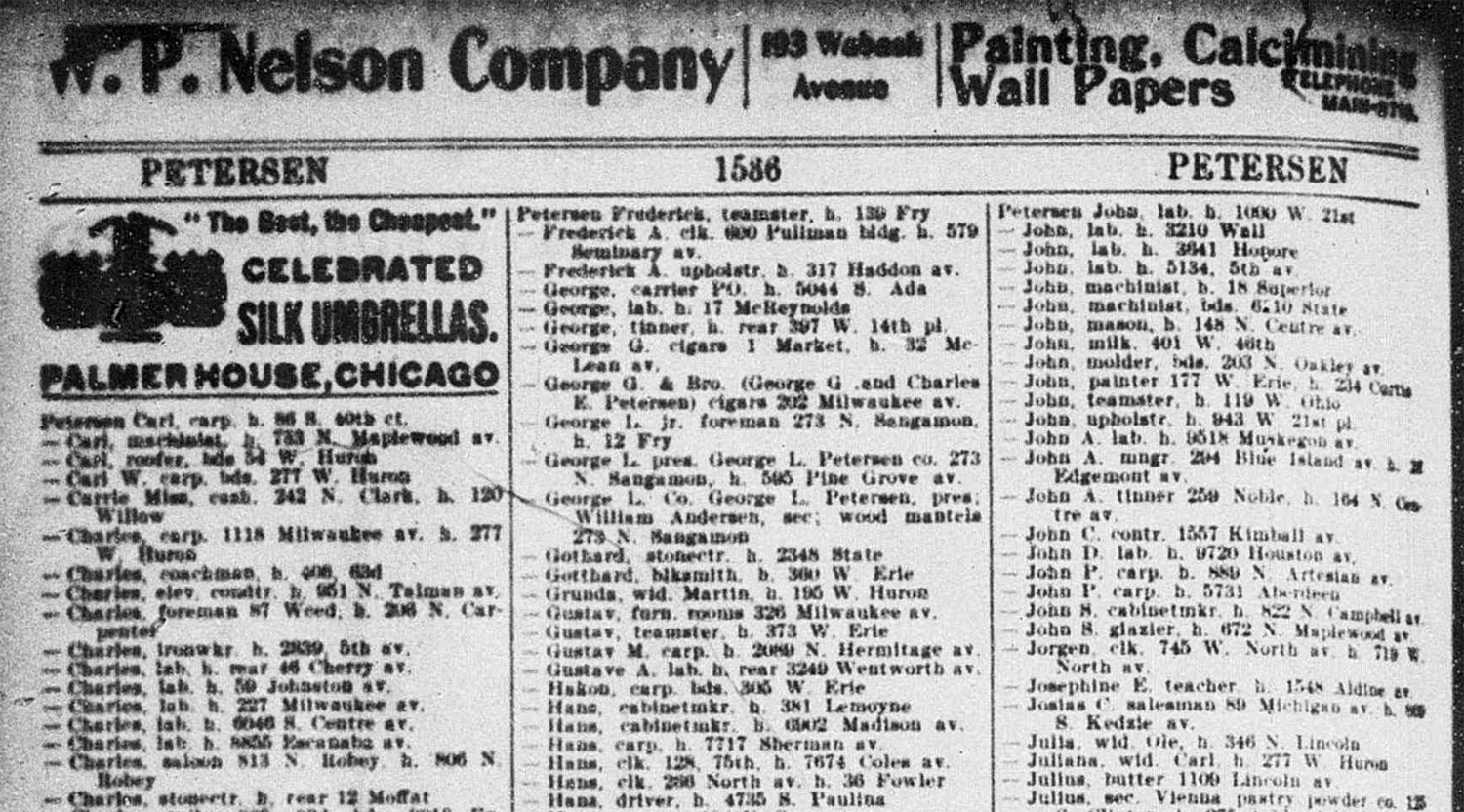
Familysearch.org has updated its online collection of Chicago directories, which is good news for anyone with ancestors in the city. There are fragmentary years from 1844-1869, but from 1870-1901 their more or less continuous. Quality of the scans are, like the winds, "light and variable," but it's good to have something to work with if you're hunting an elusive ancestor.
There are a number of Hans Petersens (and Petersons) sprinkled liberally through the directories during the 1890s, which is likely the decade that my great-grandfather Hans Petersen came to Chicago from Hebron, Nebraska. He and his father, Lorenz P. Petersen, had been farmers in Belle Prairie and Hebron, but something inspired their move to Chicago around that time. Perhaps they'd made decent money selling farmland in Hebron. Possibly there were better prospects for income in a big city like Chicago.
“Citation: "Chicago City Directories," database with images, FamilySearch (https://www.familysearch.org/ark:/61903/3:1:3QS7-99DX-D6J6?i=2161&cat=308691 : accessed 21 October 2021), entry for Hans Petersen, teamster; citing Chicago directories 1896-1897, film #007548769, image 2162 of 2724.

The first documents we've seen previously in Chicago were birth registry for Hans and Catherine's son Johann Christian (1890), a death certificate for Lorenz (1891), and another birth of Edward Andreas (1892). But until the 1900 U.S. federal census there's precious little trace of the Petersens.
It's a given that with the missing 1890 census, directories are the best evidence. And here Hans is, listed in 1896-1897 at 4735 S. Paulina Ave., the street where we know he and his family were living in 1900. Hans is listed as a driver, probably a cart driver. That occupation is going to help us track him through the city throughout the decade before the turn of the previous century.
And now we also know where to get the best and cheapest silk umbrellas in town!
October 21, 2021 | Email your comment.
A family portrait
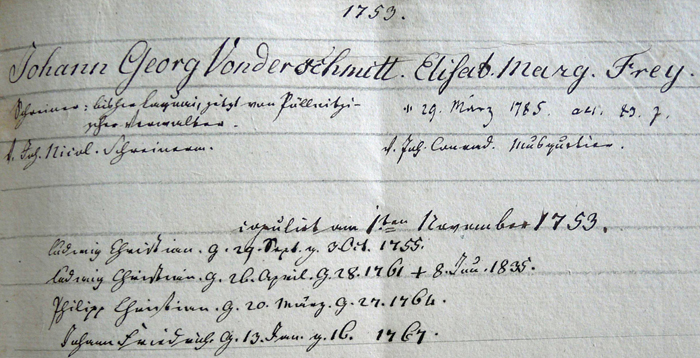
From a cousin Albert Esser in Germany comes this much appreciated excerpt from the local church books of Überau in Hesse-Darmstadt.
It appears to be a transcription from the main church book at the time, detailing the marriage date for Johann Georg Vonderschmitt and his wife Elisabetha Margarete Frey in 1753, plus births and deaths of their first four children: Ludwig Christian born in 1755 who presumably died young, because the next child is also called Ludwig Christian 1761-1835; Philipp Christian born in 1764; and Johann Friedrich birn 1766. How can we surmise that it's a transcription? Usually birth, marriage, and death records are kept separately in discreet sections of the volume. But here the records are all grouped together.
“Citation: "Uberau, Hesse-Darmstadt Church Registers," 2008 scan of original church record created by Wolfgang Bertrams from Überau via Albert Esser, entry for Johann Georg Vonderschmitt and Elisab. Marg. Frey, volume information unavailable, held by the church in Überau, Hesse-Darmstadt.
The even, clear handwriting, the uniform color of the ink (which would have been mixed by the clerk), and the minimal variation in script point to its production by one person during one part of the same day. He was likely copying out the information from the primary church book, for whatever reason.
The rest of this couple's children were registered in Reinheim nearby, so perhaps this record was meant to summarize their orthographic "portrait" in the parish of Überau before they left it for Reinheim.
Johann Georg Vonderschmitt and his wife Elisabethe Margarete Frey were likely married in 1753, presumably in Überau, and had their first four children there. Six more were born in Reinheim.
It gives us a bit more information about Elisabethe, who died 29 March 1785 at the relatively young age of 49. And for each bit of new information we're very grateful.
October 17, 2021 | Email your comment.
He made a mint
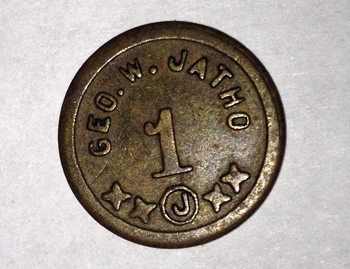
I received a nice email from a collector who ran across this interesting coin and wondered what it was all about.
So did I. First thought was that it had something to do with our George W. Jatho of Charleston, South Carolina. Maybe scrip of some kind for purchases of goods or supplies? George was, in fact, a merchant broker early in his career, and a reasonably successful one. He and his younger brother, William G. Jatho, were partners at one point. But I'd never run across an artifact like this.
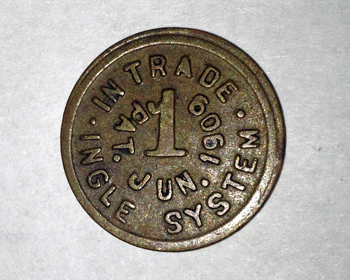
Other people had, it turns out.
“Citation: Ingle System Token for George W. Jatho, database with images, Token Catalog, http://tinyurl.com/2p8te5v9: accessed 13 October 2021, Defiance, Ohio; Ingle Customer Ledger: Geo. W. Jatho.
This coin is related to a different George W. Jatho entirely, one who lived in Defiance, Ohio. The system represented by this coin was manufactured by the Ingle Company of Dayton, Ohio. In the days before credit cards, these coins could be used like credit and were meant to relieve merchants from the tedium of bookkeeping with voluminous ledger entries. You can read more about the system here.
George Jatho in Defiance was a jeweler and a grocer, born in May 1860 to German immigrant parents in either Ohio or New York. He can be found in a number of census records in Ohio with his wife, Nancy Jane Good Jatho, and their daughter Minnie. The scrip was shipped to Defiance in 1913, and it's reasonable to assume that he used these tokens when he established himself as a grocer in town.
The inevitable question: Were the two George W. Jathos related? Possibly but available documentation doesn't confirm this. There's a cluster of Jatho families in and around Dransfeld, Hanover, Germany from the 1600s onward, and the few that emigrated to the USA went to scattered states, such as South Carolina, Maryland, Ohio, Illinois, and Missouri. A clan of Jathos also settled in the Bay Area of Northern California. Did they all come from around Dransfeld? Where more detailed origins are documented, usually they indicate an origin in Hanover, so it's possible.
One way to confirm it is through male line, or Y-chromosome, DNA tests. Only direct male descendants of an ancestral Jatho will carry the DNA pattern to confirm a match. Alas, that lets out George W. Jatho of Defiance. His only child was Minnie, and women don't carry the matching pattern to confirm the genetic haplogroup. We're left in the dark about any possible connection between the Jathos of Defiance and Charleston.
October 13, 2021 | Email your comment.
The Hamel mystery
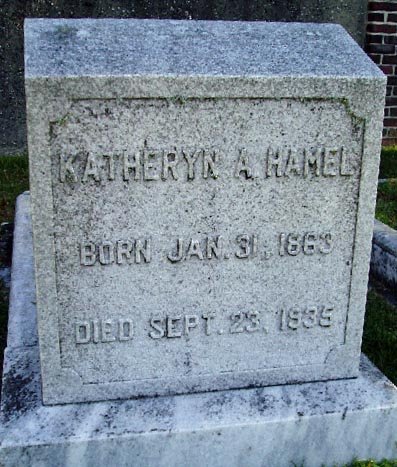
We've run into her before, with her headstone in the Louis Müller D.D. plot at Bethany Cemetery, Charleston, South Carolina. Thanks to a local death record we were even able to identify her friendly proximity to the Rev. Müller by identifying Katheryn as Adelina Catherina Frederike Müller, the ninth child of Rev. Müller and his wife Caroline Laurent.
“Citation: Bethany Cemetery, St. Matthew's German Evangelical Church (Charleston County, South Carolina), grave marker, Kathryn Hamel, read and photographed 2006 by Debra MacLaughlan Dumes.
But chasing down her husband, Herman Hamel, has proven to be more challenging. As Katherine, sometimes Adeline K. Hamel, Katheryn appears in a variety of Charleston city directories between 1923-1935, usually labeled as the widow of Herman. But Herman is nowhere to be found, neither in census records, vital records, or Charleston directories. I was beginning to fear that Katheryn had made him up.
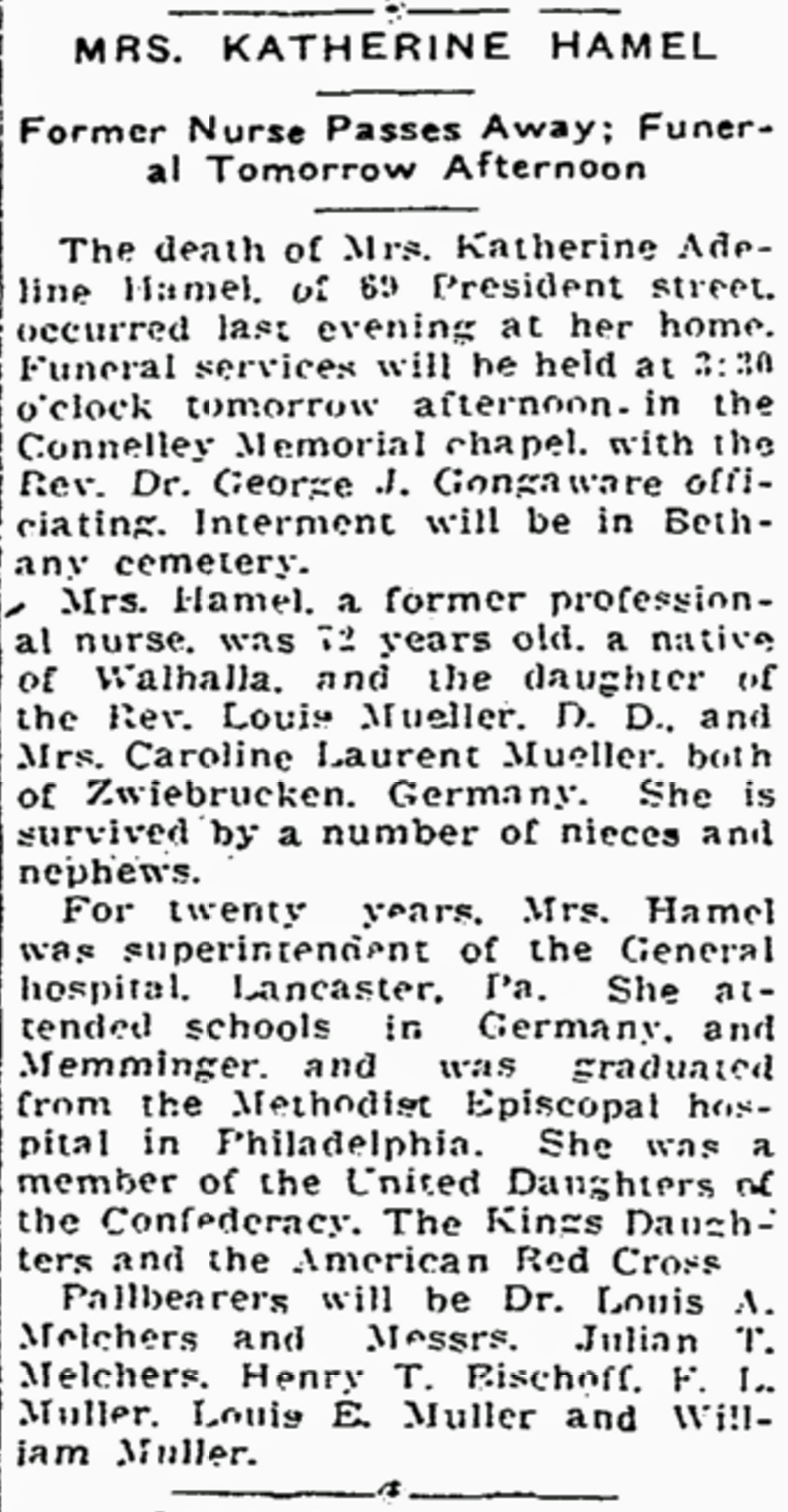
But she hadn't. There was a clue in an obituary for Katheryn (September 24, 1935 issue of the Charleston Evening Post) that recently became available in one of the online newspaper archives that's particularly rich in items from Charleston.
There's no mention of being the widow of a Herman Hamel, but the fact that she was a professional nurse and a superintendent of the General hospital of Lancaster, Pennsylvania gave some context for her whereabouts prior to the 1920s. Look at records for Pennsylvania, not South Carolina.
A search of Ancestrylibrary.com yielded no results, not even in Pennsylvania. But as if often the case, a search of the Familysearch.org resources did turn up an application for a marriage. Different databases, even with the same set of records, can turn up what you're looking for due to different search parameters. That's worth keeping in mind when one database comes up empty.
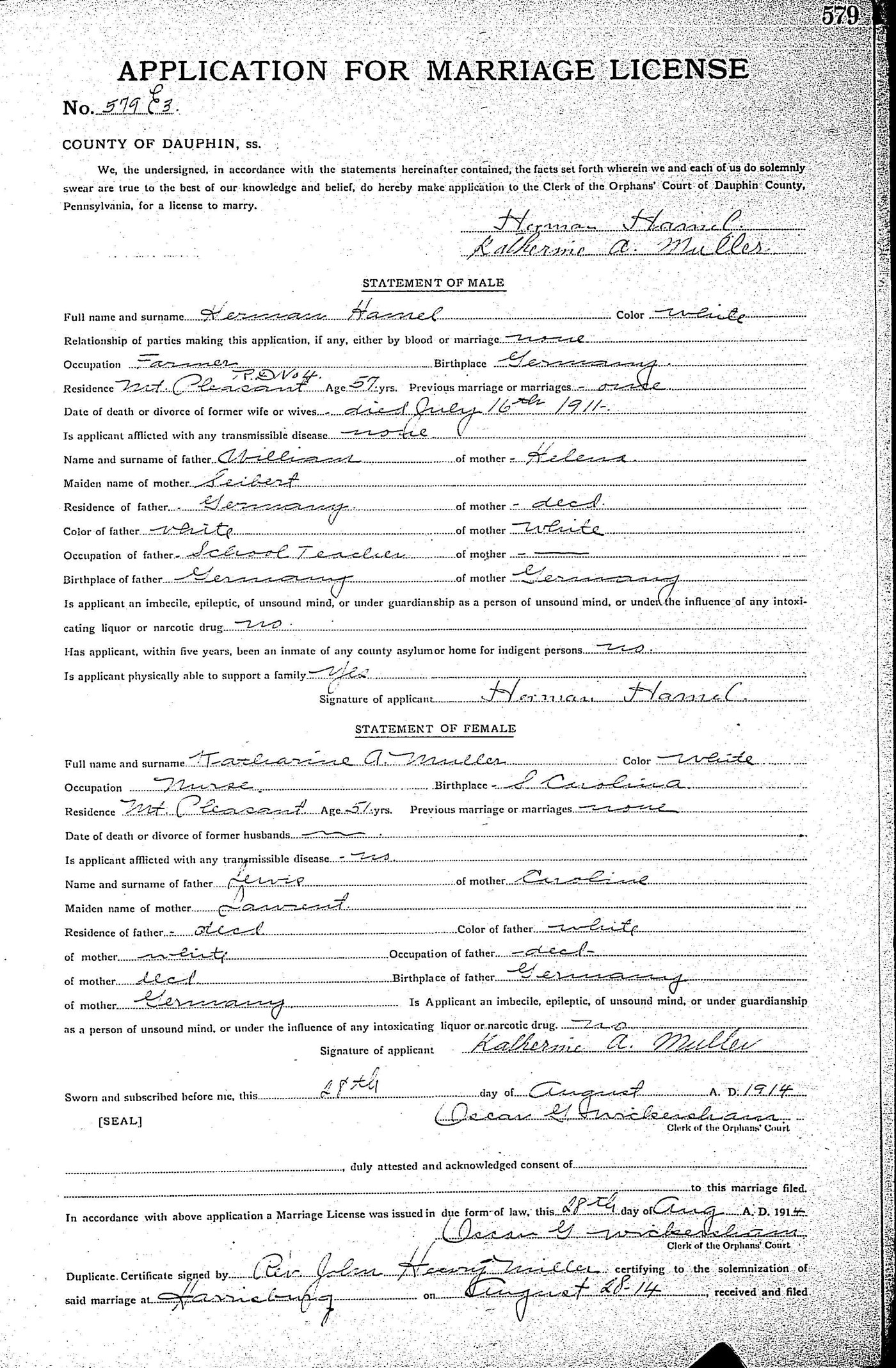
Their 1914 Dauphin County application for a marriage reveals a lot about this couple. Herman was 57, Katheryn 51, second marriage for him, with his previous wife dying on July 11, 1911. No previous marriage for Katheryn, and her parents' names match the ones we know. Looking for a Hamel who died in Westmoreland County in July 1911 brings up a solid match with Sophia Boomer Hamel, who was Herman's first wife and was buried in Mount Pleasant Cemetery. Pay dirt, so to speak.
More interestingly, Herman was buried with his first wife. That may have had something to do with the time frame of his marriage to Katheryn, which was only four years long. On Herman's death certificate the informant was his daughter Helen Irene Hamel, not Herman's wife Katheryn.
It's hard to draw a conclusion from this. Were he and Katheryn estranged? Did his children from his first marriage not approve of the second? Katheryn is not named explicitly in Herman's obituary from the Jeannette News ("He is survived by his widow and three children: William C Hamel, of Laurelville; Mrs. Elizabeth Hamel and Miss Helen Hamel"), but his children are named in full.
In any case the favor was returned in Katheryn's obituary, where there's no mention of Herman Hamel either. Perhaps Kartheryn's survivors were making a statement of their own!
October 5, 2021 | Email your comment.
Back home to Bethany
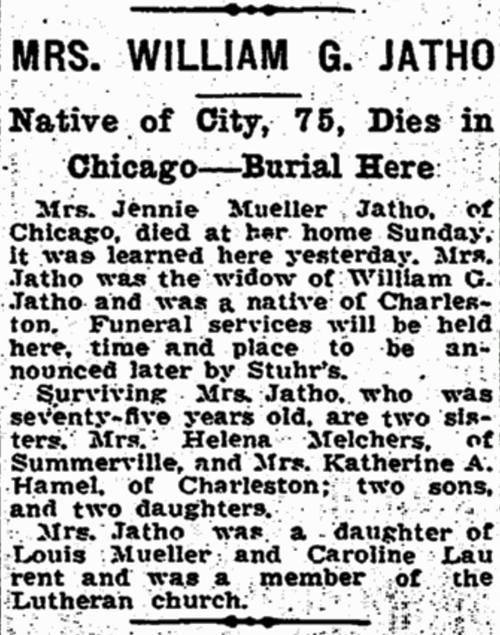
Despite living to a ripe old age in Chicago, Jennie Müller Jatho was still known fondly in her Charleston, South Carolina home town. You can bet her surviving sisters, Helena and Katherine, had a lot to do with making sure the local newspapers carried the proper note of Jennie's passing.
“Citation: Charleston News and Courier, 16 January 1934, death notice for Jennie Jatho; digital image, Post and Courier Archives, https://postandcourier.newsbank.com/, accessed 29 September 2021.
All a local paper had to do was reveal the deceased's ancestry for local folks to know who she was. Several obituaries in the Charleston papers mention the parents Louis Müller and Caroline Laurent. Memories were still fresh. Louis had been an esteemed pastor of St. Matthew's German Lutheran church for fifty years before his own death in 1898, and many still remembered Louis' formidable wife Caroline Laurent. Even today descendants can tell you how Caroline signalled her mood for the day, and if she came downstairs wearing the telltale Blouse of Doom, stay out of her way!
By all accounts Jennie was equally steely but suffused with sweetness and familial devotion. A musician throughout her life, she was renown in Charleston for her light operettas, sung in harmony with her husband William while he was alive, and then after his death in 1904 Jennie was a much sought-after singer and piano accompanist.
A family issue arose in 1910 that compelled Jennie and her children to relocate to Chicago, where her sister Margaret Rinck lived, but Jennie returned to her permanent home to join William Jatho in his plot at Bethany Cemetery. His headstone reminds us of his name. The family, for some reason, didn't order a headstone for Jennie. Luckily for us, online newspaper collections verify where she rests today.
September 29, 2021 | Email your comment.
Sometimes detours are worth it

I'm not sure whether there's a term for being related only by marriage, and several marriages distant, at that. A cousin emailed because he thought we had a common ancestral name. He's a Welling descendant and several of his Wellings married various Melchers in Charleston, South Carolina.
There were Melchers in our Charleston Müller clan, too, the most noted of whom was Theodore Melchers, married to Ludwig and Caroline Müller's eldest daughter, Helena. As a result I added several Wellings to my database without knowing much about them, just in the interest of being tidy.
“Citation: Find a Grave, database and images (https://www.findagrave.com/memorial/44607709/edwin-welling : accessed 21 September 2021), memorial page for Edwin Welling (1 Oct 1816–22 Nov 1900), Find a Grave Memorial ID 44607709, citing Magnolia Cemetery, Charleston, Charleston County, South Carolina, USA ; Maintained by Saratoga (contributor 46965279).
Now with a goal, I tried to look back at this Welling line for more information, as a courtesy. Not much luck though. The earliest one I can verify was Edwin Welling, buried at Magnolia Cemetery with his wife Susan Disher Welling (thanks to photographer Saratoga at Find-A-Grave for the photo above). Edwin died in 1900 with his well-worn headstone reporting that he was born October 1, 1816 in Charleston. It's the only verification of his birthdate besides his city death certificate, which states that his parents were born in South Carolina but does not name them. No birth records can be found for Edwin, and thus verifying his father's name isn't possible.
But for his wife, Susan Disher, the road is easier to travel. An 1850 U.S. federal census shows Edwin, Susan, and family plus an Elizabeth Disher, who was the right age to be Susan's mother. Also helpful is an 1859 probate record for Elizabeth where she names her heirs as Robert W. Disher, Margaret Disher, and Susan Welling. We have confirmation.
Who was Susan's father and Elizabeth's husband? Was it this fellow?
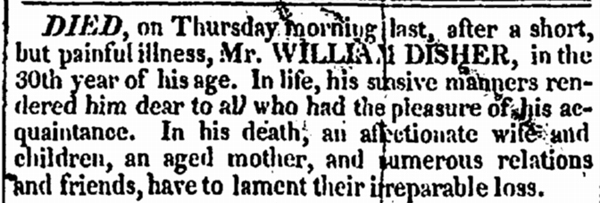
This death notice was from the Charleston Courier for July 1, 1822. From available death records in Charleston it appears that William died of "country fever," which we identify today as malaria.
William was one of two other Dishers I could find mentioned in local newspaper and census/vital records in Charleston. William was a little younger than Elizabeth. There was also a Louis Disher, a little older. A brother?
Louis appears in the unhelpful 1830 U.S. federal census (unhelpful because it only lists the head-of-household's name) and then dies in 1835. But a closer look at Elizabeth's son's records unveils the fact that his full name was Robert William Disher. A clue that he was named after William, perhaps?
Is there a probate record for William? There is...but, alas, William died intestate without a will. His executrix is listed as Susannah Disher, his widow. That's not looking very positive all of a sudden.

Without a will and apparently with financial encumbrances, William's widow had to deal with suits over his property, like the notice at left from the November 1824 Charleson Courier, where a lot on King Street was sold to Francis Joseph Cobia to settle a debt.
Cobia, in my experience, is an unusual name in Charleston, so I searched the web for any possible links. One popped up right away for a link between a Cobia and the "Disher Farm."
The Disher Farm was close to the site of a tavern usually referred to as the Four Mile House, which in turn had its own notoriety, as you may peruse for yourself. What's of interest is that the widow of a Nicholas Cobia "conveyed" (gave or sold?) some land to R.W. Disher, whom we know to be the son of Elizabeth Disher.
Could there have been some bad feeling between the families after the enforced sale of Disher land in 1824? Was this a peace offering? It's circumstantial, but it's another intriguing clue suggesting that Robert William Disher was the son of William Disher and that William's wife Susannah was actually born Susannah Elizabeth, surname unknown. It's worth noting that Elizabeth had a daughter called Susan, suggesting that there was another child in the family named after a parent.

There's another intriguing clue suggesting that William himself had ties to the Four Mile House and perhaps the land nearby. His probate record identifies him as a tavern keeper.
From the notice at left in the January 6, 1818 Charleston City Gazette, William had a plantation to sell or was acting as an agent for the owner, and was to be contacted by interested buyers at the Four Mile House itself.
One thing's pretty certain: William had no involvement the notorious case of John and Lavinia Fisher, though he would have known about the case. If you're curious to see what the tavern looked like, click here.
September 21, 2021 | Email your comment.
Make a joyous noise
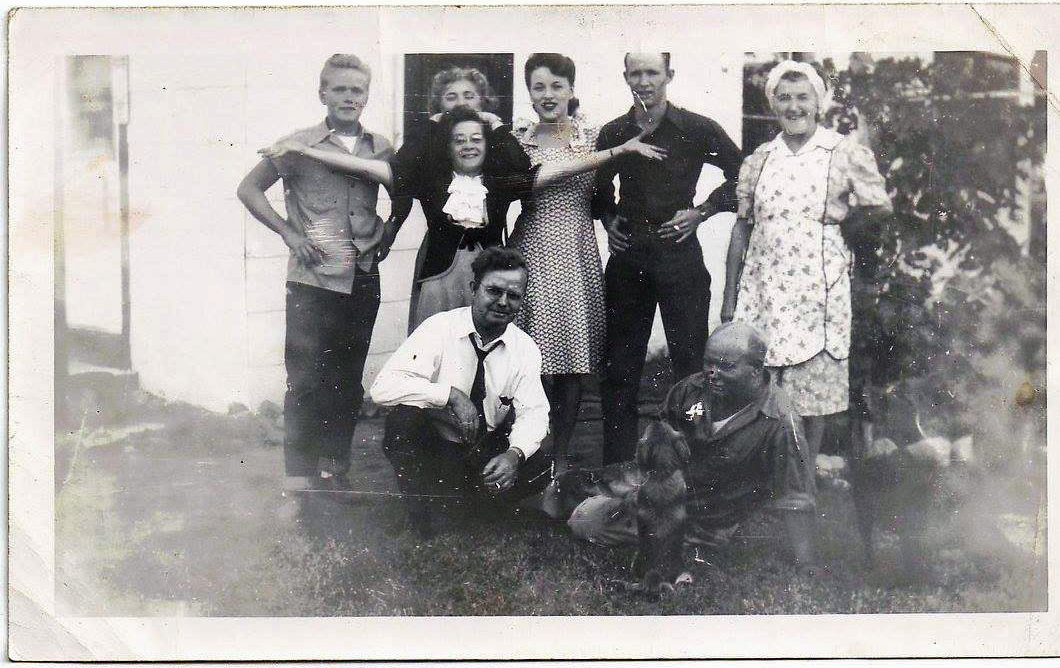
Cousins can come out of the blue, and sometimes they come bearing treasures. This photo was certainly a surprise to me, not the least for showing my grandmother Marie Jatho MacLaughlan in the happiest pose I've ever seen of her.
This photo was uncovered in an archive in Arizona by a cousin I don't know and have never had the chance to meet, but if I did I'd thank her profusely. Clarence Petersen is kneeling on the right and, as descendants of his, my cousins knew the immediate family. Behind Clarence is his wife Dora as well as Dora's dark-haired daughter Dorothy and her husband.
“Citation: Petersen and MacLaughlan cousins, 1946 Phoenix, Arizona; Kathy Petersen Beamis photograph collection, Buckeye, Arizona, 2016; photograph has been passed down from its original owner (Jan Petersen) to the current holder.
Kneeling on the left (did the man ever wear sports clothes?) was my grandfather Alva, Clarence's older brother, his rapturous wife Marie, and hiding behind Marie their youngest daughter Dolores. Next to Dolores is her cousin Fred Petersen, Clarence's and Dora's son.
The photo captures the moment in time when Alva and his family relocated from Chicago to the Los Angeles area, and since we know this happened in 1946, gives us the likely date for the photo.
There's a son missing, Tom, but he was exiting from the U.S. Army around this time and may have been left back in Chicago for a time. We have documented evidence that he was in the Southern California area by autumn of 1946, so we know he eventually made it to the Southland.
The moral of the story: seek out and be nice to your cousins!
August 25, 2021 | Email your comment.
Mind the gap
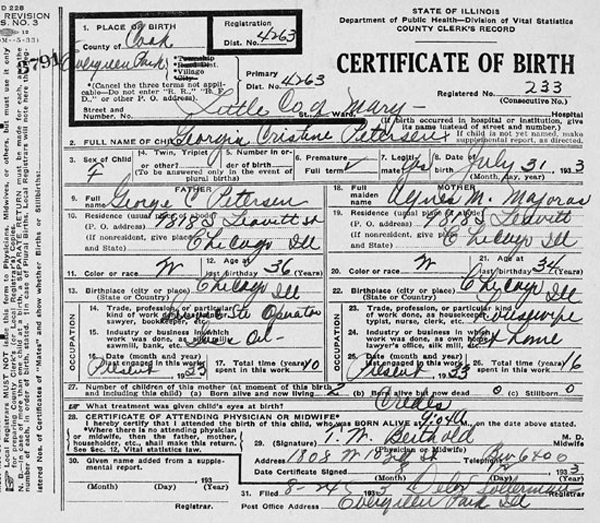
Proof that progress is being made in Cook County. Another happy find, as a result of the updated Familysearch.org database "Illinois, Cook County, Birth Certificates, 1871-1940," is this one for Georgia Petersen, second daughter of my great uncle George Petersen and his wife Anna Majoros.
There were two girls in this family, Violet, born in 1918, and then after fifteen years Georgia. The first name reflects her father's, the second has me stumped. There wre no Cristines or Christines in the family. Perhaps it was her mother Anna's whim.
“Citation: "Illinois, Cook County, Birth Certificates, 1871-1949," database, FamilySearch (https://familysearch.org/ark:/61903/1:1:QGCF-QTJW : 18 March 2018), Georgia Cristine Petersen, 31 Jul 1933; Evergreen Park, Cook, Illinois, United States, reference/certificate 233, Cook County Clerk, Cook County Courthouse, Chicago; FHL microfilm.
The Petersen brothers (George, older brother Alfred, later Alva, and younger brother Clarence) weren't close after the mid-1940s when they migrated from Chicago on to sunnier climes. George and Alfred/Alva eventually ended up in California at opposite ends of the state. Clarence spent some time in Arizona before also relocating to California, but nowhere near the other two.
Thus I have no idea what happened to my cousin Georgia Petersen. She appears in the U.S Social Security Applications and Claims Index as Georgia Christine Petersen and then as Georgia C. Covey, which led me to a record in "U.S. City Directories 1821-1989" from Ancestry.com. She and Charles Covey, presumably her husband, lived in Sacramento for a time in the early 1970s. Not surprisingly, that's where her parents lived too.
The trail goes cold until a mention in an obituary index, again courtesy of Ancestry, called "Web: Obituary Daily Times Index, 1995-Current." There her April 2003 death was reported in Florence, Oregon.
No mention of any survivors in these cryptic indexes, so unless one of her children does a web search and lands here, we may never hear of them.
Note: in December 2021 these images were taken offline for reasons unknown, although the index is still there.
August 15, 2021 | Email your comment.
New in Nebraska
For awhile now Familysearch.org has had a useful collection called "Nebraska Marriages, 1855-1995". I've found my great-grandparents Hans and Catharina Petersen there before, which is always a pleasure, but now Familysearch.org is partnered with the Nebraska State Historical Society, which is in the process of digitizing these records and making them available for a fee.
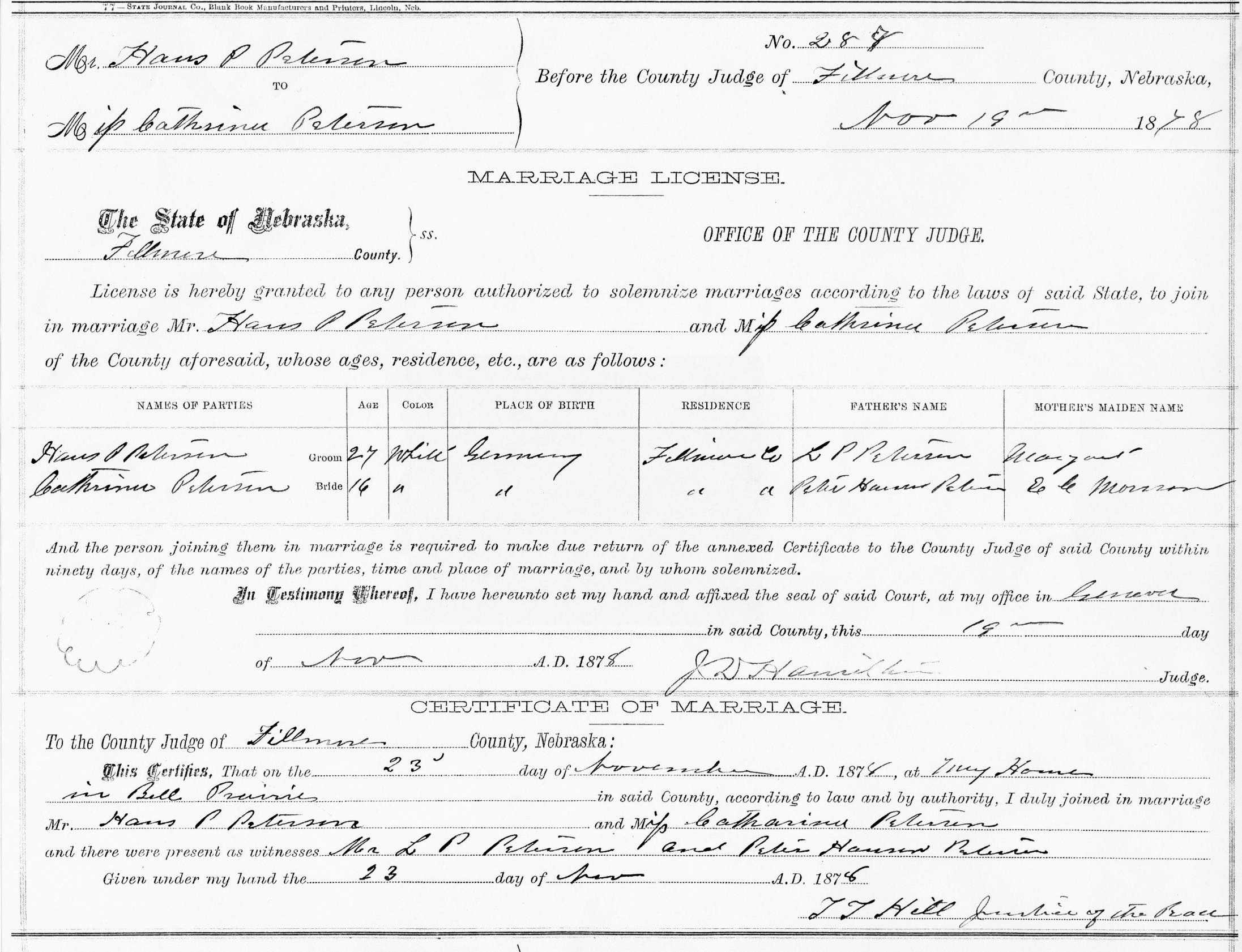
Luckily, at the start of my genealogical journey in 2004, I got this record the old-fashioned way: by calling the Fillmore County Courthouse and asking whether they had the certificate for this couple in their collection. Things were simpler (and non-digital) in those days. I could hear the clerk walk away from the phone to check; the sound of a file cabinet opening; a shuffling of papers; and then her return. Yes, they had a copy, and it was only two dollars to photocopy and mail via the U.S. postal service.
“Citation: Fillmore County, Nebraska, Marriage Certificate, 1878, no. 288, Petersen-Petersen; Belle Prairie, Nebraska, photocopy obtained from the Fillmore County court house in 2004.
Those who take advantage of the Nebraska State Historical Society's collection may want to note that there's a series of fees and regulations for Internet use of their images at five dollars for each use...and it must be approved by an NSHS representative. That regulation will likely prove hard to enforce, and it wouldn't apply to this image in any case due to the way it was obtained, but it's an important point to keep in mind.
I'd still recommend going for the actual document if you can rather than the Familysearch transcribed copy. Obtaining Hans and Catharina's marriage certificate shows a lot more information than the transcription provides, such as their parents' names (golden!) and the witnesses, who are also their fathers.
That information also led to the conclusion that the fathers must have been in Nebraska for the marriage, so they'd already emigrated from Schleswig-Holstein. Finding them in the 1880 census gave us both parental families as well as some siblings.
This was the first document that would lead back to finding the Petersen ancestors back to the year 1653. Slow and steady does it.
August 9, 2021 | Email your comment.
Bright as a new penny
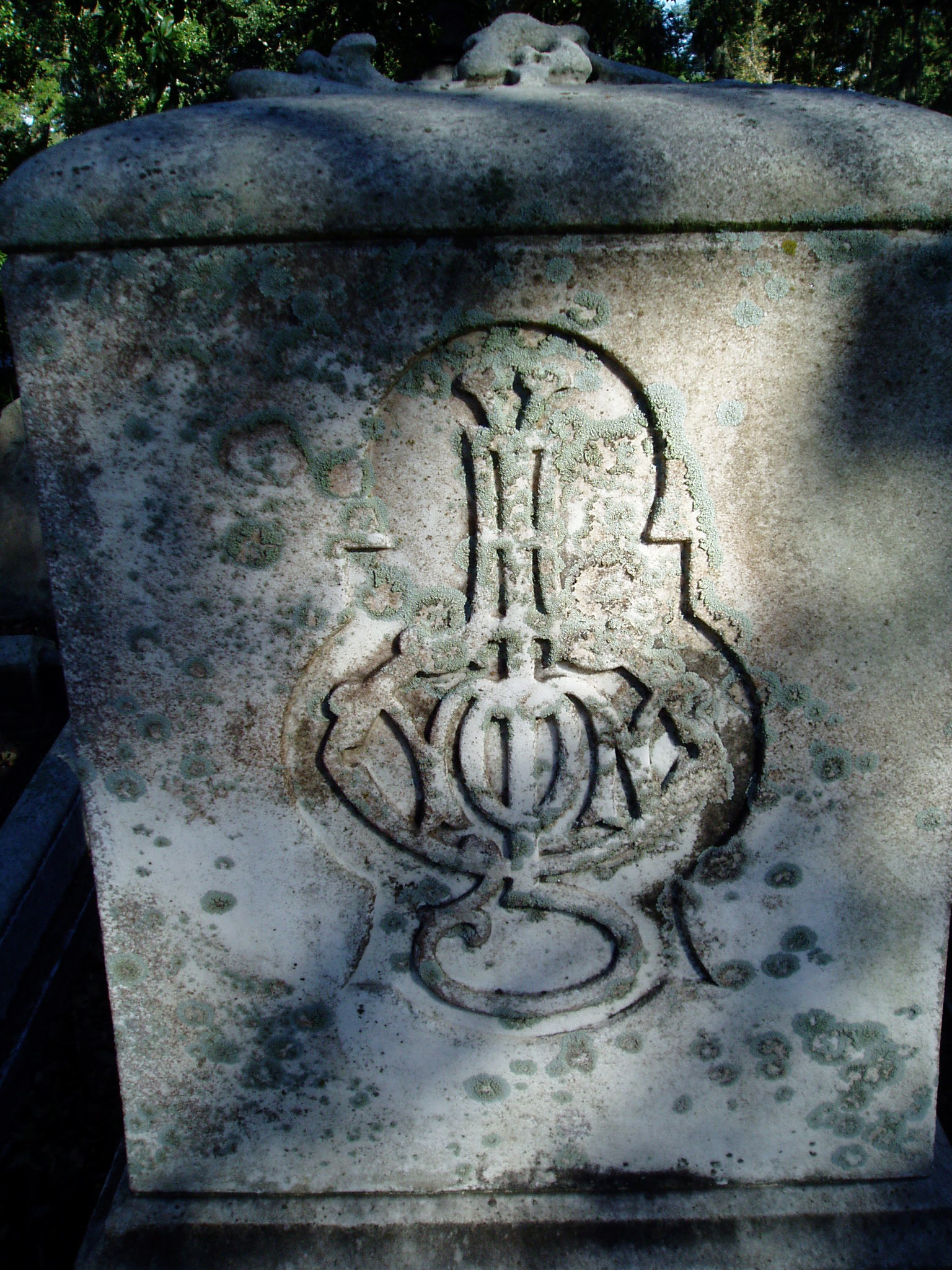
There are lots of good reasons for the debut of a new web design, not the least of which is offering a better platform to display images.
This new template helps a lot with that. Take a close look at this lovely, lichen-laden stonework (you can enlarge the image by clicking it with your computer mouse).
“Citation: Magnolia Cemetery (Charleston County, South Carolina), grave marker, monogram for Arnolda von Oven Jatho, read and photographed 2006 by Debra MacLaughlan Dumes.
The grave marker is for Arnolda Von Oven Jatho in Charleston, South Carolina. She was the wife of the merchant and Colgate (yes, the soap and toothpaste maker) salesman George William Jatho. Clearly a master craftsman was at work on this intertwined insignia representing her monogram. The predominant "A" dominates the design. It's a classy decoration for the back of the marker. The front (see below) is more conventional, although in keeping with German tradition, the marker reflects her "gebohren" or maiden name. She rests in the Jatho family plot at Magnolia Cemetery, where most of her children, her husband, and Jatho in-laws are buried.
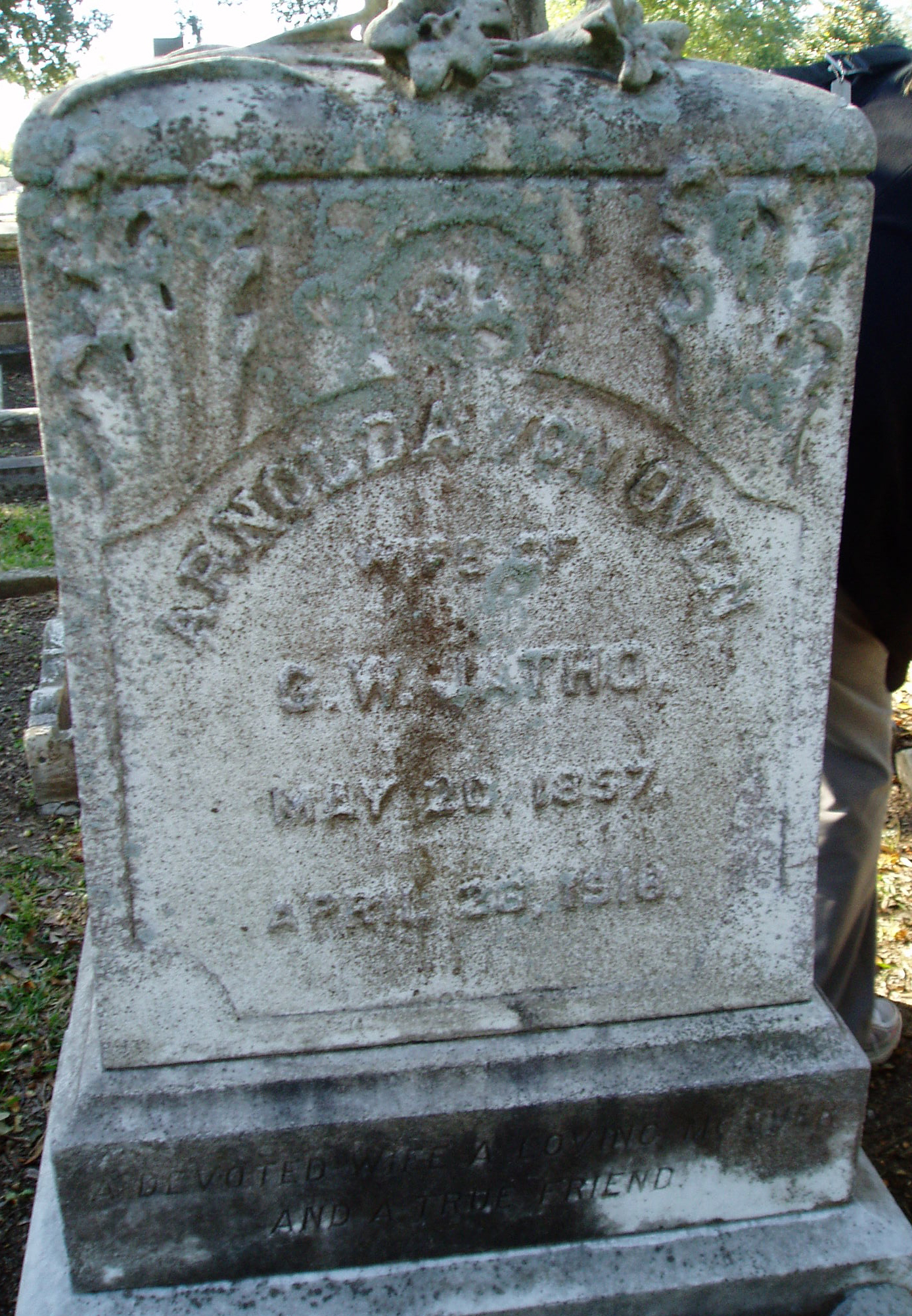
The Von Oven presence was strong in the German-American community in Charleston. Arnolda's three brothers John, Ferdinand, and Theodore came from Oldenburg to Charleston in the 1860s and made their living as grocers. On September 20, 1878 Arnolda Von Oven sailed into New York wth 77-year old Johanne Ulrichs, her grandmother. You have to be a bit creative to find their passenger manifest: her surname is written and thus indexed as Vonoven.
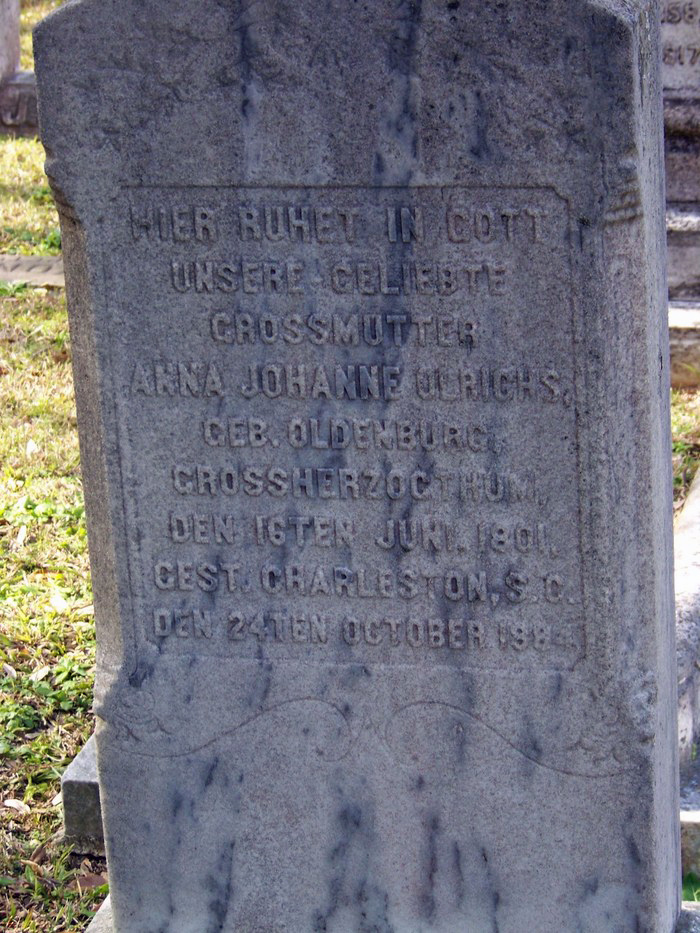
At least we know now how to find her in Charleston when we visit. If you're planning a visit, don't forget to walk across the street to Bethany Cemetery. Johanne is buried there, and while the view isn't as shady and grand as it is at Magnolia, it's nice to be able to find yet another of this expansive and venerable family when in town.
August 3, 2021 | Email your comment.
Württemburg for the win!
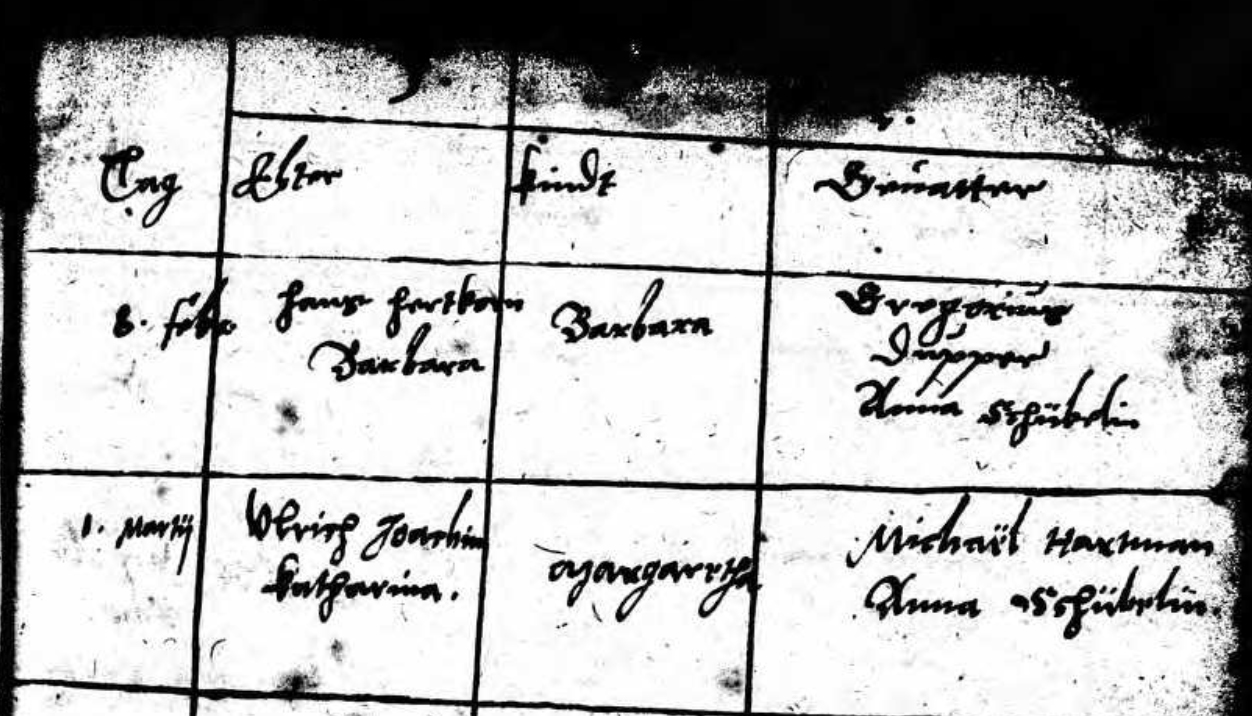
One of the earliest collections of German records currently online is "Württemberg, Germany, Lutheran Baptisms, Marriages, and Burials, 1500-1985," available both at Ancestry.com and Familysearch.org, the latter for free (although Ancestry.com is the one with images of the church book pages).
“Citation: "Deutschland, ausgewählte evangelische Kirchenbücher 1500-1971," database, FamilySearch (https://familysearch.org/ark:/61903/1:1:QPP5-6PPK : July 14, 2021), Barbara Hartkorn, 8 Feb 1562; images digitized and records extracted by Ancestry; citing Baptism, Remmingsheim, Remmingsheim, Rottenburg, Württemberg, Deutschland, Dörnach u Remmingsheim, German Lutheran Collection, various parishes, Germany.
But here's the real kicker. Baptism records go back as far as 1558, which isn't such a bad deal when you think of all the other German parishes whose records were burned, lost, or were never even initiated until much later.
This record of Barbara Hartkorn, daughter of Hans and Barbara Hartkorn, dates from 1562. She's the older sister of the Maria Hartkorn, wife of Martin Kientzle, one of our oldest ancestral lines.
It's hard to grasp the fact that this birth occurred two years before Shakespeare was born in England, and that Barbara is part of our family...a very remote part, but family just the same. The godparents are Gregorius Dupper and Anna Schübelin, very likely relatives of the family, whose names may (with further study) provide us with clues to other connections in the parish. Schübel was probably Anna's corrected surname, the "-in" suffix being used to indicate someone who was female.
The records are fragmentary. I wasn't able to find Maria Hartkorn, our direct ancestor, but did locate another child, a brother Johannes, who was born in 1563.
These records from Dörnach uber Remmingsheim in Württemberg also include some of the surrounding community where there were no parishes, so sometimes you find a bonus record from nearby. Thus the Hartkorn events, which took place in nearby Wolfenhausen, were actually recorded in Remmingsheim.
Wolfenhausen records exist from 1644 onward, but without the ruling of the The Council of Trent (1545-1547), which ordered local parish priests to begin recording all marriages, births, and deaths, we might not know about our sixteenth-century family. As it was, the Hartkorns were obliged to trek to Remmingsheim for that all-important registry.
A modern map shows what Remmingsheim (now Neustetten) looks like today, and just how close Wolfenhausen (where the Hartkorns were from) was to Nellingheim (where the Kientzles resided). You might say that the parish brought them together.
It takes a very determined society to keep track of folks like these who may have only recently begun to use surnames. The regulations involving record-keeping came about slowly and didn't always evolve evenly from one community to the next. The very earliest records for non-royal and non-noble individuals was in 1524 at the parish of St. Sebald in Nürnberg.
July 14, 2021 | Email your comment.
Long lived Laurent
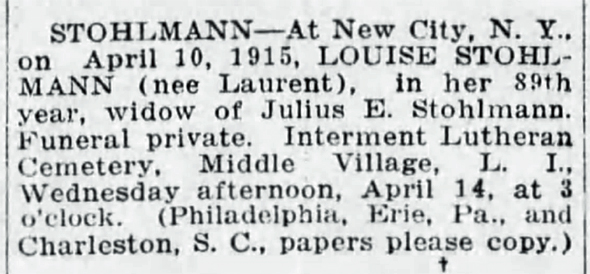
One of the positive outcomes of genealogy is finding out just how sturdy certain families were.
Louise Laurent was born in 1827 in Zweibrüchen, Rheinland-Pfalz, to a bookbinder, Philipp Heinrich Laurent, and his wife Philippina Jungblut, a former laundress.
Louisa's older siblings had been born before her parents' marriage, and oversight that was corrected in 1825 when the couple was finally free to marry. Situations such as this were common. A parent might object to the union and refuse to give permission, for instance, and there are plenty of examples where the baby comes first and the marriage afterward.
“Citation: Obituary of Louise Stohlmann neé Laurent (d. 10 April 1915), The Brooklyn Daily Eagle, Brooklyn, New York, 13 April 1915, p. 22, col. 2; image copy, Newspapers.com (https://www.newspapers.com : downloaded 3 July 2021).
Louisa had nine other siblings, several of whom came to America before her. An older sister, Caroline Laurent, married Lutheran pastor Ludwig Müller in 1942 and they settled in New York at first, Charleston, South Carolina later and permanently. An older brother, Friedrich Laurent, settled in Philadelphia and became a confectioneer.
Louisa spent a brief time in Charleston and then married Julius Eduard Stohlmann, a publisher of German-language religious books, in New York in 1851. Together they had eight children. Until running across this obituary in the online collection of the Brooklyn Daily Eagle I didn't know Louisa's death date.
The Brooklyn Daily Eagle has partnered with Newspapers.com and is searchable online. If you have family or ancestry in Brooklyn, give it a whirl and see what you can find.
July 3, 2021 | Email your comment.
The name game

Carrie Collins neé Gohr, head of her household in 1940, was the widowed wife of Edward, a man of Irish heritage. Oddly that was a rare choice for one of the Gohr girls of Chicago, all of whom spoke German as their first language at home.
Even odder is the presence of an 11-year-old granddaughter in the home. Carrie's two children, Harold and Evelyn, reached adulthood with relative ease, but who had the child Patricia? Her surname is listed as Collins but the only son in the household is 33-year-old Harold, who's single. How did Patricia's surname get to be Collins?
“Citation: "Illinois, Cook County Deaths, 1871-1998," database, FamilySearch (https://familysearch.org/ark:/61903/1:1:Q2M6-9J6R : 22 June 2021), Evelyn E C Justin-Dale, 31 May 1935; citing Chicago, Cook, Illinois, United States, digital folder number 101245478, image number 00079, Cook County Courthouse.
The clue was in Evelyn's death record index. Searching for any child of Edward Collins and Caroline/Carrie Gohr, a couple pop up in the collection "Illinois, Cook County Deaths, 1878-1994." One of my genealogy mail lists mentioned that this Familysearch.org collection had been extensively updated, to the point where you almost forgive them for not having images themselves to examine.
The transcriptions are very detailed. Evelyn E.C. Justin-Dale died on May 31, 1935. A music teacher, she was the daughter of Edward Collins and Carrie Gore (close enough for Gohr), the wife of Ray, and Harold Collins, her brother, was the informant.
No luck finding the name Justin-Dale in the 1930 census but shortening it to Justin we get a good hit. Evelyn, her husband Ray (an insurance agent), and their daughter Patricia live with Carrie Collins and Harold, Carrie's son and Evelyn's brother.
But in the 1940 census Ray isn't with this family...and Patricia is now a Collins, not a Justin or Justin-Dale. Where did Ray go?
Whatever happened to him -- a divorce from Evelyn, or his own death -- clearly Carrie has taken on the task of raising her own granddaughter, albeit with a name change. It could have been an enumeration error, of course, and it may be that the enumerator was confused. But Patricia, who died in 1989, is listed in the Ancestrylibrary.com collection "U.S., Social Security Applications and Claims Index, 1936-2007" with three name changes: originally in June 1943 as Patricia Mary Collins, then in 1977 as Patricia M. Justin Collins, then the final claim in 1989 as Patricia M.J. Collins.
The name change probably wasn't done through legal channels because of the cost involved. But it appears that Patricia was at least willing to leave some trace of her Justin legacy hidden within the depths of Social Security paperwork, and that makes it a little easier to find out a little about her life.
June 22, 2021 | Email your comment.
